1875 - 2025

Written and Compiled by the 15th Headmaster
Peter B. Hauser

1875 - 2025

Written and Compiled by the 15th Headmaster
Peter B. Hauser
In compiling this book I have used a variety of sources. Many books and their authors are listed below which provided useful information. Most interesting knowledge, and an illustration of key matters relevant to the School’s governing body, the Toowoomba Grammar School’s Board of Trustees, came from reading all Minutes of the Board of Trustees meetings from the late 1880s to 2020 The School’s seven-person Board of Trustees holds monthly meetings for both the full Board and for its various smaller sub-committees. Detailed Minutes of each meeting are recorded. Illustrated in the photographs at the end of the 1958-year entry is a book containing the Minutes of every Board of Trustee meeting over the period 1938 -1958. The Minutes of each meeting were typed and then attached to this large book. At the end of 1958 a new book was used to record the minutes and nowadays all records are computer based.
Other sources of information used in compiling this edition of the School’s history came from all School Magazines from 1904, other school publications such as Omnibus and Balliwanga, newspaper and magazine articles, family papers, audio recordings from Old Boys, wr itten correspondence to the School and more.
An early book referring to some aspects of the School’s history appeared through the authorship of T.Max Hawkins titled The Queensland Great Public Schools: A History published by the Jacaranda Press in 1965. The author of the first official history book of Toowoomba Grammar School was Dr Rupert Goodman, an employee of The University of Queensland. Dr Goodman was invited by the School to write Toowoomba Grammar School, 1875 – 1975: A Centenary History. In the preface of this book, published in 1976, the author, Rupert Goodman, wrote: ”To be invited to write a school history is a great honour, but it is also an exciting and challenging task. Tracing the records of a hundred years leads the researcher, far afield, even beyond the boundaries of Queensland. Trustees’ Minutes, school documents, newspaper records, family papers, school magazines provide abundant material. Th e historian’s task is to piece this mosaic together, to explain the sequence of events that has brought the school to its first centenary. Of course, in the space of educational time, measured by the establishment of the Great Public Schools of England, such as Winchester (1382) and Eton (1440), a century is but yesterday. Yet it is important that the records be gathered together now, before they are lost or destroyed.”
I wish to acknowledge the research and efforts of Dr Goodman in writing Toowoomba Grammar School, 1875-1975: A Centenary History. Dr Goodman’s authorship resulted from the foresight of the School’s then Chairman of the Board of Trustees, Dr Ian Gibson, fellow Trustees at that time, and the then Headmaster of the School, Mr W.M. Dent.
The author of the second official history book of Toowoomba Grammar School was Mr John Winn, a former teacher at the School for thirty -five years (1963-1997) and later part-time School Historian. A tribute to Mr John Keeble Winn is to be found in Appendix One. John Winn’s book on the history of the School from 1875 to 2000 represents an incredibly comprehensive and well-researched tome of 598 pages. John Winn’s book Still Playing the Game (A History of Toowoomba Grammar School, 18752000) is a vital historical record of the development of our wonderful school over its first 125 years. A significant part of this third history book on the School, Toowoomba Grammar School: A Celebration of its Sesquicentenary Years, 1875-2025, has been taken directly from John Winn’s research and often in his own written words, particularly the content relating to the biographies of those Old Boys profiled on the Toowoomba Grammar School Old Boys’ Wall of Achievement.
The authors of the first and second official school history books were invited to write the 100 years (centenary) and 125 years by the School’s Board of Trustees. My own work on the history of the School, 1875-2025, was not by invitation. Rather, I suggested the project to the School’s Board of Trustees in November 2016 requesting their permission to commence this undertaking. The project received the fullest support from the then Chairman of the School’s Board of Trustees, Mr Glen McCracken, and Deputy Chairman, Mr John Handley, and the other four Trustees of the School at the time, namely Mr Chris Wicks, Dr Russell Domrow, Dr Nicola Hulme-Peake and Mrs Kym Murray (the seventh member of the Board of Trustees, Mr Russ Johnson, had passed away earlier in this year but was also fully supportive of the initial concept). The Trustees of the School agreed that some of my forthcoming sabbatical leave (one term in 2017) be devoted to commencing such research. My retirement from the School in December 2020 has provided me with ample opportunity to continue, and complete, this task.
Over the 150 years of the School’s history there have been many other people contributing their knowledge and understanding of the life of the School. The School Magazine Volume XVI, November 1926, No.2, was the “Jubilee Number” and contained a worthwhile historical account of the School, compiled mainly by Mr Cameron of The Toowoomba Chronicle. Another most useful source of information was contained in the School Magazine of 1961 with a review of the history of various sports. A major historical undertaking was completed in 1995 by long-serving member of Staff, Mr Graeme Ainsbury. Mr Ainsbury was employed by the School from 1959 -1961 and then from 19631995. During this time he was the Senior Master (1975 -1992) and then School Registrar (1992 -1995). In the 1990’s Headmaster Hugh Rose deemed it important that the School begin to compile a Register of the boys who had attended Toowoomba Grammar School since 1877. Mr Ainsbury enthusiastically agreed to such a task and his book, Toowoomba Grammar School Register 1877-1995, was published in 1995. Not only did this book contain the names of all Toowoomba Grammarians and their years of schooling but also statistical information on the members of the School’s Board of Trustees, Staff, the Old Boys’ Association, Guest Speakers at Speech Day, War Honour Rolls, General Honour Rolls, House Captains, Sporting Captains and more.
Mr Ivan Board who attended the School from 1961 -1964 spent three years (2018 -2020) in his retirement to research, write and subsequently publish an exhaustive account of the history of Cricket played by Toowoomba Grammar School boys from 1877 -2020. His work was superbly researched and included details of every 1st XI cricket match played, scores and player details since 1877. Ivan Board’s book titled The History of Cricket at Toowoomba Grammar School (1877 -2020) is in two volumes. The first volume (1877-1979) contains 594 pages and the second volume (1980 -2020) has a further 609 pages of information. This research also allowed him to provide the Schoo l with a player number for every member of the 1 st XI cricket team since 1877. Ivan’s research also enabled him to share such information with other member schools of the Great Public Schools (GPS) Association of Queensland and a further six books have been published subsequently. These include books, all co -authored by Ivan Board, for Brisbane Grammar School, Anglican Church Grammar School (‘Churchie’), Brisbane Boys’ College, St Joseph’s Nudgee College, The Southport School and Ipswich Grammar School outlining their respective school’s involvement playing cricket against Toowoomba Grammar School over more than one century. I thank Mr Ivan Board for compiling the incredible detail he has obtained relating to the history of Cricket at Toowoomba Grammar School and for enabling me to include his research in my book.
Mrs Ann Hallam was an employee at the School from 2006 -2019 in her role as a Cadet Officer (and the parent of two TGS Old Boys). Her historical research into the School’s Cadet Corps and the military involvement of the School’s Old Boys has been particularly significant. Ann was responsible for
compiling the TGS Old Boys’ Commemorative website which can be accessed through the Old Boys’ Association portal of the School’s website. Ann’s research over many years has centred on identifying the names of all Old Boys who have served their country. This included rank, postings on discharge, status, date and cause of death where applicable, age, parents etc. Ann Hallam’s research on the Old Boys of the School and their military involvement is highly regarded and most valuable.
The School’s Museum was officially opened on 31 May 2009. This facility is housed in the Old Boys’ Building and originated via the conversion of the 1924 “Old Chem Lab” or, in more rec ent times, the Cadet Q store. A clear indication of the extent to which people value the School and what it stands for may be seen through the ongoing work of the Curator of the Museum and the team of Volunteers. The Curator, Mrs Denise Miller, from the commencement of the Museum to the time of writing (2024) was a former member of the administrative staff of the School for forty years (1967 -2006). Denise is the mother of a TGS Old Boy and has the title of Honorary Old Boy bestowed upon her by the TGS Old Boys’ Association. She has enthusiastically and most capably led her team of volunteers. These volunteers have amassed an amazing number of voluntary hours assisting with the archival records documenting the history of the School. One of these key volunteers, Mrs Judy Gillies, is the longestserving employee in the School’s history for 54 years (from 1958 -July 2012) and has continued her assistance in the Museum in a part-time volunteer capacity from 2013 to the time of writing (2024), amounting to a staggering 66 years of contribution to Toowoomba Grammar School. Judy is the mother of two TGS Old Boys. No one is better qualified than Judy Gillies, herself a TGS Honorary Old Boy, to assist in caring for the School’s history and the lives of all Old Boys and c urrent students.
One of the inaugural (and still in 2024) part -time volunteers in the Museum is Mr John Handley, a former Deputy Chairman of the School’s Board of Trustees, past President of the TGS Old Boys’ Association and the father of two Old Boys (see 1957). Another inaugural volunteer in the Museum from 2009-2016 was Mr Don Trenerry (1949 -1952) who is a former Trustee of the School, former President of the Old Boys’ Association (OBA), Honorary Life Member of the OBA and the father of two Old Boys (see 1952). All other inaugural volunteers working in the Museum are acknowledged in the 2009-year entry. A further part-time volunteer in the Museum from 2013 to the time of writing (2024) is Mrs Lin O’Sullivan who is a former member of the TGS Library and Administrative staff and the mother of a TGS Old Boy.
Also having a significant role in recording the life of the School is the School’s former (now retired) Director of Enrolments and Honorary TGS Old Boy, Mr Rob Mitchell. Rob spent countless hours researching the military involvement of past students and arranged for the initial scanning of all school magazines from 1904. Another former member of staff and also an Honorary TGS Old Boy, Mrs Ellen Morosini, who worked in the Enrolments and Old Boys’ Offi ce from 2003-2012, also made a major contribution to the School’s archival records. Another former member of staff from 1993 -2020, mother of two TGS Old Boys and also an Honorary TGS Old Boy, Mrs Jennifer Fordyce, also made a significant contribution to recording the history of the School. Well prior to the opening of the School Museum in 2009, Mrs Tessa Tamvakis (nee Dent), the daughter of the School’s 13 th Headmaster, Mr Bill Dent and Mrs Marion Dent, worked in the Library and Archives from 1983 -1990 and her work also made a highly worthwhile contribution to the quality of recording of the School’s archival storage.
The School Museum provides a superb resource for the current students, staff, Old Boys, parents and the wider community. Personally, I find it crucial that our boys appreciate the history and development of their School over a period of nearly 150 years. To do so will enable them to comprehend with greater clarity the School’s fundamental values and our future direction.
Many Old Boys have also assisted in providing me with information relating to their years at the School. I acknowledge the Old Boys’ Association and its Presidents over the years and particularly the assistance from Old Boys, Mr Glen McCracken (TGS 1970 -1974), Mr John Handley (19 54-1957), Mr Don Trenerry (1949-1952) and Mr Ian Dumigan (1962 -1965). In the early years of my Headmastership I welcomed the mentoring and friendship shown by some esteemed Old Boys including Sir Bruce Watson (see 1945), Dr George Fielding (see 1948) and Mr Jack Doyle (see 1934) before their passing. Throughout my years at the School I have also appreciated the valued input and thoughts of Mr Graham Hobbs (see 1952), Mr Ivan Board (see 1964) and many more Old Boys.
The support of Mr Hugh Rose, a forme r Headmaster of the School (1992 -2002), and the current Headmaster, Dr John Kinniburgh (2021 -present), are also acknowledged together with the interest shown by Mrs Marion Dent, the wife of the former Headmaster of the School, the late Mr Bill Dent (1970-1991).
I have compiled this book as an expression of my thanks to the School for enabling me to be its Headmaster for eighteen years (2003-2020), living on the school grounds for seventeen of these years, seeing the life of the School from a parent’s perspective (with son Mitchell attending the School from 2003-2005) and with the constant support of my wife Thérèse.
I wish all the Toowoomba Grammar School families, both current and former, all the very best and may we all join together in wishing the School continued success over the next century.
Peter B. Hauser
Headmaster, Toowoomba Grammar School, 2003 -2020
• As at June 2024 there have been 18,746 student names entered into the School’s hand-written Register of Admission. The original book contained the names of the 14,861 boys who studied at this School from February 1877 to 2007 (see photographs in the 1877-year entry). The second volume of this Admissions Register replicates the first volume in that it is a magnificent leatherbound book and continues the tradition of entering by hand the names of every student who has enrolled in this School. These two volumes are stored in the School’s Museum. On the Toowoomba Grammar School Old Boys’ Wall of Achievement, located on the School grounds, are over one hundred bronze plaques representing students who have advanced to have national recognition in their fields of endeavour. An alphabetical list of the names of all men whose success has been acknowledged on the Wall of Achievement is contained in the index of this book. Also featured on this Wall of Achievement is perhaps the most significant plaque of all, in that it acknowledges all Toowoomba Grammarians who have made commendable, yet perhaps somewhat anonymous, although productive contributions to society in all walks of life. These thousands of Old Boys have continued to live their lives demonstrating the qualities of integrity, loyalty, honesty, hard work, respect for others, service to others and kindness. A photograph of this bronze plaque on the Old Boys’ Wall of Achievement is included below.
• At the Sydney Branch of the Toowoomba Grammar School Old Boys’ annual dinner in October 1963, Old Boy Alexander McPhie (1914-1915), ex-Chief Inspector, Commonwealth Bank of Australia, proposed a Toast to the School. His words most appropriately express the thanks of all for the contributions made by so many Old Boys of Toowoomba Grammar School.
“Tonight, Your Excellency and Gentlemen, I do not intend to refer in detail to the atmosphere of tradition that is manifesting itself increasingly about the School, but I do ask you to remember the many great Old Boys of bygone days - those who have passed to the other side - those who have died in battle on the land, in the skies, and on the oceans of the world, those who have given and continue to give, in legacies of learning and achievement, outstanding public and professional service to Australia and to the world at large - eminent members of the Forces, doctors, dentists, engineers, scholars, journalists, captains of industry, commerce and finance, great men of the law, and not by any means least the pastoralists, farmers, and mining men who have forced our earth to yield her agricultural riches and her mineral wealth for the benefit of mankind throughout the world.
Please remember, too, those who have done their duty nobly and well in less conspicuous, and perhaps in less competent, but not in less worthy ways. At the same time, I ask you not to forget those, who, often through no faults of their own, have baulked at life's hurdles - those Old Boys who may be sick and ailing, on the brink of Eternity. I ask you to bring to mind the lengthening of illustrious Headmasters and other Masters, who have contributed so much to the development of the School, which, I feel, is most unique in character, and which continues to train not only good, true and brave Australians - men worthy in every way of their pioneering forbears, but also young people from other lands, who are attending the School because those responsible for their education believe that those boys will assimilate knowledge and scholarship that is worthwhile, receiving at the same time a training of character that is worth even more. ......”. (Source –Toowoomba Grammar School Annual Magazine 1963, pg.49).
• Similarly, another tribute to the quality of Toowoomba Grammar Old Boys over the years was superbly summarised by Old Boy, Brigadier J.E.G. Martin (1917-1921) when proposing the Toast to the School at the Old Boys’ Reunion Dinner in Brisbane in September 1958. Brigadier Martin referred to the School’s 82nd year existence and noted: “In this short span the world has moved from the era of the horse and buggy and the paraffin lamp and great social distinctions to a brave, exciting, and, incidentally, very dangerous new age of supersonic flight, nuclear energy, automation, anti-biotics and plastic surgery, t he mechanised home and the welfare state. … Not all who pass through the School can achieve great eminence in their chosen careers. I suggest that the prime function of the School is to produce men – men of goodwill with a sense of both private and public responsibility; men who are not automatons but are trained to think and to evaluate. If they have these qualities, it will not be long before they find their natural place in the stream of community life. The School can be proud that its Old Boys answer the roll call in all grades of leadership in every section of business and professional life in the community. A State Governor, University Professors, Headmasters of Great Public Schools, Members of Parliament, men who have attained eminence in the various branches of pure and applied science, technologists, leaders of social and philanthropic activities, men who serve with distinction in the Services, all of these add lustre to the history of the School. But TGS should be no less proud of all those who, though nameless to the general public, are carrying on the traditions of the School in their various vocations, and, though they do not get their names in the daily Press, are respected for the dignity of their labours and for their philanthropic and community service in their own suburbs and villages. Among all those who served their country in the wars, those who achieved no particular eminence or distinction, but always did a good job - not because it was an exciting or glamorous enterprise, but because the spirit of the old School urged, "There's a job to be done, you ought to be in it!" - these constituted the great majority on which the fate of battles ultimately depended.” (Source –Toowoomba Grammar School Annual M agazine 1958).
• In 1860 The Grammar Schools Act was decreed by the Queensland Colonial Government allowing for the establishment of Grammar Schools. The Act stated that if a sum of at least one thousand pounds was raised by donation or subscription in any district for the purpose of establishing a public grammar school then a corresponding sum of money not exceeding twice the amount that had been raised shall be provided by the colonial government to the erection of suitable buildings for the said school.
• In 1874 a local Toowoomba resident and businessman named Mr Samuel George Stephens sought government approval for the establishment of a Grammar School in Toowoomba. A copy of the handwritten request to the colonial government is now housed in the Toowoomba Grammar School’s Museum. In Mr Stephens’ letter to the Colonial Secretary’s Office he s tated that he was confident that the required sum of money would be raised and listed the names of twenty people together with the sum of money that they had agreed to donate. Mr Stephens had agreed to donate a sum of fifty pounds together with others. A most significant pledge of funds was made by the Hon. James Taylor, MLC to the extent of one hundred and five pounds.
• The reply to Mr Stephens letter to the Colonial Secretary regarding the proposed establishment of a Grammar School in Toowoomba was written on 16 January, 1874. The letter stated: To: Mr S.G. Stephens, Sir – “With reference to the requisition signed by the Hon. James Taylor and other gentlemen residing in the town and district in Toowoomba, forwarded under cover of your letter of 6 th inst,.relating to the establishment of a Grammar School in Toowoomba, I am directed to inform you that as soon as the sum of £1000 raised by donation or subscription has been lodged in some bank to the credit of the Building Fund, the Government will be prepared to advise the payment of £2000 in addition, to be applied in manner provided by the Grammar Schools Act of 1860, and I am to request that you will advise Mr Taylor and the other requisitionists accordingly. I have (etc) H.H. Massie”.
• Two Grammar Schools had already been established in the colony. The first was Ipswich Grammar School founded in 1863 followed by Brisbane Grammar School in 1867.
• The Grammar Schools Act required that seven people would be necessary to serve as Trustees of the School – four of whom nominated and appointed by the Governor with the advice of the Executive Council and three people elected by the majority of the people subscribing to the establishment of the proposed new school.
• In 1864, prior to the establishment of Toowoomba Grammar School, The Grammar Schools Act was amended to increase the initial sum of money to be raised by public subscription to be two thousand pounds, not one thousand pounds as initially stated.
• A public meeting was called for 8:00pm on Wednesday, 4 February 1874 at Hooper’s Commercial Hotel so that interested citizens could discuss plans for the establishment of a Grammar School in Toowoomba. The Acting Chairman was the Hon. James Taylor, MLC and he said that he hoped that every resident in the district would render assistance to the campaign. The Acting Secretary, Mr Samuel Stephens, was then requested to state the amount of subscriptions already collected. At the meeting it was unanimously agreed that the Hon. James Taylor be Treasurer and that Mr Samuel Stephens be Honorary Secretary.
• On the same evening, 4 February, Ashton’s British and American Circus supported the fundraising effort by staging a complementary benefit in aid of the Toowoomba Grammar School fund. “Grand fashionable entertainment” was advertised, along with a programme which included “the boneless boy in his puzzling contortions, daring feats on horseback, comicalities, witticisms and puns”. The circus also included acrobatic effects on the trapeze, trick performing ponies, and a splendid Brass Band. It was reported that “a very nice sum was realised”.
• In May a meeting was held to appoint the three people from the list of financial subscribers to form part of the required Board of Trustees. The Chairman declared that Messrs William Graham, George H. Davenport and Samuel G. Stephens were duly elected. At the meeting a motion was proposed and seconded to determine whether provision could be made for the education of girls in the proposed Grammar School. After discussion the motion was put and lost. Mr Stephens as Honorary Secretary of the provisional committee was formally thanked by the Hon. James Taylor for his determined efforts to establish the Grammar School.
• Later, the Government appointed its four nominees to the Foundation Board of Trustees of the Toowoomba Grammar School. The first official meeting of the newly constituted Board was subsequently held on Friday, 27 June 1874 at the office of Mr George Davenport. The Government nominees included the Chairman of the Board of Trustees, The Honourable James Taylor, MLC; The Honourable John F. McDo ugall, MLC, and Messrs Gilbert Elliot and Charles J. Anderson, MD. The Subscribers’ elected nominees were William Graham, MLA, George H. Davenport and the Secretary (as elected by the Trustees) was Samuel George Stephens.
• On Saturday, 28 June 1874 the Trustees inspected all of the sites the Provisional Committee had recommended as being the most eligible for the School. The eventual preferred site, although referred to by some as being “too far out of town”, was the heavily timbered Old Queen’s Park. Thirteen acres of portion 67 were granted by the Government, with the balance of 37 acres secured by the Trustees as part of the endowment.
• By early October 1874 a decision had been made as to where the school building was to b e erected.
A competition for the best building design was announced including specific conditions:
• The building was not to exceed 5,000 pounds in cost,
• There must be one large schoolroom for 160 pupils and dormitories for 30-40 pupils,
• Quarters must be provided for the Headmaster and his family,
• Servants quarters were to be included,
• Provision for lavatories and bathrooms,
• A terrace in front of the facade, and
• The provision for extensions at a later date.
Chairman of the Board of Trustees: The Hon. James Taylor, MLC (in his 2nd year).
• Mr James Taylor was Chairman to the end of 1882. Mr Taylor was a very successful businessman He had arrived on the Darling Downs in 1848 and by 1859 he was the sole owner of ‘Cecil Plains’ station. Although one of the pioneering squatters, he began to live permanently in Toowoomba from about 1861, purchasing 180 acres situated between West Street and the West Swamp, centring on Russell Street. In 1869 he donated some of this land to the Church of England on which St James’ Church was later built. In about 1870 he purchased Clifford House as his private dwelling, naming the residence after his hometown in England. Mr Taylor’s name was eventually perpetuated at the School in recognition of the contribution he had made to it with the naming of Taylor Boarding House in 1959 (see 1959).
• Mr Samuel G. Stephens was an original Trustee on the Board. He remained the Board’s Secretary for the first 27 years of the School’s existence (until 1901). It is clearly acknowledged that Mr Stephens was the founder of the School due to his initiative and efforts . Mr and Mrs Stephens raised a very large family comprising six sons and six daughters. All of his sons were educated at the School. The boys included Alfred (at TGS 1877-1880), Herbert (1878-1883), Samuel (18861887), Archibald (1887-1889), Ralph (1887-1889) and George (1896-1897). The eldest son, Alfred George Stephens, was the first boy enrolled when the School opened in 1877 (see 1877, 1932 and 1960). Mr Samuel Stephens was to have a boarding house named after him (which was built in 1986). A photograph of Mr Samuel Stephens is included in this year’s entry.
Trustees: The Hon. James Taylor, MLC, The Hon. John F. McDougall, MLC, Mr Gilbert Elliot, Dr Charles J. Anderson, Mr W. Graham, MLA, Mr George H. Davenport. The Secretary to the Board of Trustees (as elected by the Trustees) was Mr Samuel G. Stephens. Trustee Dr Charles Anderson passed away later this year and his position on the Board of Trustees was taken by the Hon. E.W. (William Graham) Pechey, MLA.
Headmaster: In September 1875, the Trustees called for applications for the Headmastership, advertising throughout Australia and Great Britain. The applicants within Australia totalled twenty-seven.
Buildings:
• Architects from three colonies contributed architectural designs for the School building. Mr Willoughby Powell, a Brisbane architect, was selected unanimously by the Trustees to prepare the plans for the Toowoomba Grammar School building. Upon moving to To owoomba to supervise the construction of the building, he practised in the town until 1877. Mr Powell also won the competition to design the Toowoomba Town Hall in 1899. Toowoomba Grammar School’s three-storeyed building in a domestic gothic design was constructed by Mr John W. Garget over a twelve-month period for 6,989 pounds. Mr Garget was later to build the Toowoomba Post Office (1877) and the Court House (1878) at the corner of Neil and Margaret Streets. The foundation stone of the School was laid by His Honour Judge Lilley on Thursday, 5 August, in the presence of about 500 spectators.
Events:
• On 5 August 1875, 500 of Toowoomba’s population of 3,000 gathered in Old Queen’s Park (the site of the soon to be constructed Toowoomba Grammar School) to watch his Honour, Mr Justice Lilley, lay the foundation stone of the School. The Chairman of the Board of Trustees, the Hon James Taylor, MLC presented Mr Lilley with a silver trowel (which is now located in the School Museum). (See ‘Events’, 1955).
• St Joseph’s College, Gregory Terrace, was also established in the same year as Toowoomba Grammar School, as was Brisbane Girls’ Grammar School.
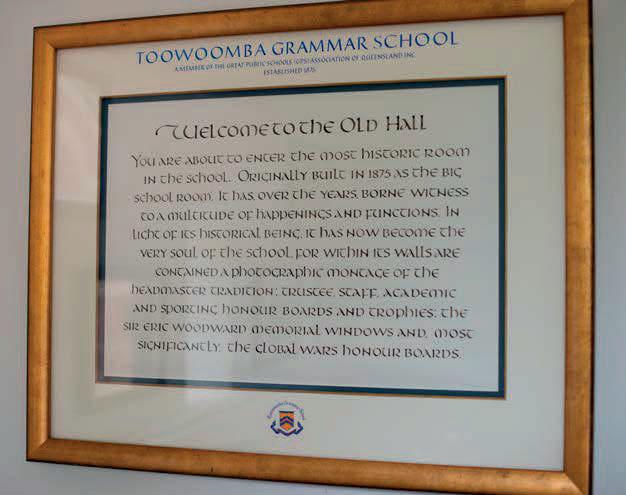

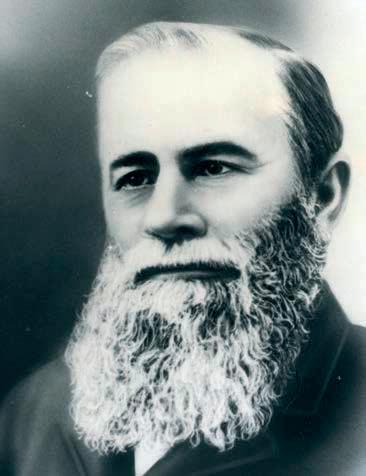
Chairman of the Board of Trustees: The Hon. James Taylor, MLC (in his 3rd year)
Headmaster: In July 1876, Mr John Mackintosh, MA (Edinburgh), the Headmaster of Camden College near Sydney, was appointed the School’s first Headmaster. He was aged 40 years. Mr Mackintosh sailed for Melbourne in 1861 from Scotland to take up a position as senior math ematics master at Scotch College. Interestingly, the second Headmaster of Toowoomba Grammar School, Mr Lawrence Stephenson, had also taught at Scotch College Melbourne as had the fifteenth Headmaster of the School (2003-2020), Mr Peter Hauser, (teaching at Scotch College from 1983 – 1996).
Staffing:
• The Trustees delegated authority to the Headmaster to select and appoint the Undermasters subject to their endorsement. Consequently, J.B. Thallon, BA (The University of Sydney) and G.M. Taylor (with teaching qualifications from the Battersea Training College, London) were appointed as the School’s foundation second and third masters.
• A Housekeeper and domestic staff (including a cook, housemaid, and an ‘outdoors’ man were also appointed).
Students: Enrolments were being accepted during the year so that all would be in readiness when the School officially opened on 1 February 1877.
The School Building:
• The Toowoomba Chronicle newspaper 1st April 1876 described the construction of the School as:
The Toowoomba Grammar School is now advancing towards completion, the roof being partially covered, and the turret (over a ton in weight) in the centre of the roof, is placed in position, and stands on an elevation of 81 feet from the ground. The basement and upper storeys are sufficiently advanced to afford an excellent idea of the admirable character of the design. The schoolroom will be a fine commodious room, 68 x 20, and there are two class rooms on the basement floor, and four on the second floor, of equally commodious dimensions, viz., four 15 x 18, and two 22 x 18. The boys dining-room is 32 x 10, and adjoining this room is the dining-room of the Head Master 18 x 23. On the second floor on the northern gable, is the Head Master's private apartments, comprising, a sitting room 23 x I5 and commanding a splendid view of the town and surrounding suburbs — his study 10 x 10, and bedroom 10 x 10 with dressing room 8 x 10. The third floor is devoted entirely to dormitories for the boarders, and these are large, lofty, (the w alls being 12 feet 8 inches in height) and well ventilated are capable of affording sleeping accommodation to at least from 40 to 60 boys, and for healthiness and comfort cannot be surpassed in any similar establishment in the colonies. The view from the dormitories is beautifully picturesque, overlooking the whole town, suburbs and Main Range. The kitchen, servants rooms,
and lavatories, are all large and roomy, and there cannot be differing opinions when the Toowoomba Grammar School is completed, it will be the finest educational institution in the colony. Mr. John Garget, the contractor, informs us that he will be in a position to hand the building over to the Trustees, completed according to the terms of his contract, early in July next, and the total cost will be very little short of £8000.
• The Gatekeeper’s Lodge was constructed in this year on the school grounds. It was situated near the corner of Mary and Herries Streets. Early in 1877 the Trustees advertised for a ‘married’ drill instructor who would also be the School’s messenger and lodgekeeper (gatekeeper) at a salary of 100 pounds per annum. On 16 July 1877, Sergeant Brady was appointed. By late 1900, due to a white ant infestation, the Gatekeeper’s Lodge was declared dangerous and in September 19 01 the Trustees decided to dispense with the lodgekeeper’s services. A few months later, during December 1901, the Lodge was destroyed by fire. The Gatekeeper’s Lodge plaque is located on the school grounds near the Herries and Mary Streets entrance by a brick pathway (a photograph of this plaque is included in the 1901-year entry).
• The main entrance to the School was, after much consideration of a plan prepared and submitted by a Mr T. Smith, established at the corner of Herries and Mary Streets. The carriage-road (driveway) leading to the main school building was 24 feet wide, flanked by walking paths each measuring 15 feet wide. This was despite the Toowoomba Chronicle’s plea of 26 December 1876 that “the Trustees make their lodge (the gatekeeper’s lodge) and principal entrance at the corner of Margaret and Mary Streets in preference to any other place” (see 193 8).
In the 1947 School Magazine (pg.51) a brief article was printed written by a Form IIIA student referred only as ‘D.D.M’. In the article the young boy reflected on his observations in 1947 looking at the School bell tower and it is interesting to note how much the archit ecture and its significance meant to him. The boy’s article is as follows:
“For seventy years this faithful servant of the school has continued to guard the old bell from all weather. Occupying a lofty position above the middle dormitory, the tower has great sentimental value, and proves to be one of the most outstanding characteristics of the main school building. Its distinctive architecture stands out against the sky on a fine day, forming a picturesque spectacle above the renowned school. On a broad cream band round the main tower are the eight sound outlets rimmed in brown. Above the roof is a lightning deflector and a circular Gothic ornament of steel construction that adds to its grandeur and eminence.
It is the custom of those who think their character fit to be remembered, to leave their names on the inside of the tower, a tradition upheld for many years. Of photos all over the Downs, this tower is perhaps one of the most distinguishing pieces of architecture; it gives Toowoomba Grammar main building that air of superiority which it possesses, and indeed deserves.” -D. D. M. (IIIA).
The first official Cadet Unit in Queensland was established in Toowoomba in 1876, although an unofficial Unit existed at Brisbane Grammar School from 1870 to 1873. It is reasonable to suppose, though it cannot be proven, that boys from TGS were members of this Toowoomba based Unit, especially since the son of its Commanding Officer, Lieutenant Benjamin, was one of the first boys enrolled at the School in 1877, and another of these boys, Frederick William Groom, is listed in the Government Gazette of May 1876 as one of the Unit’s two sergeants.
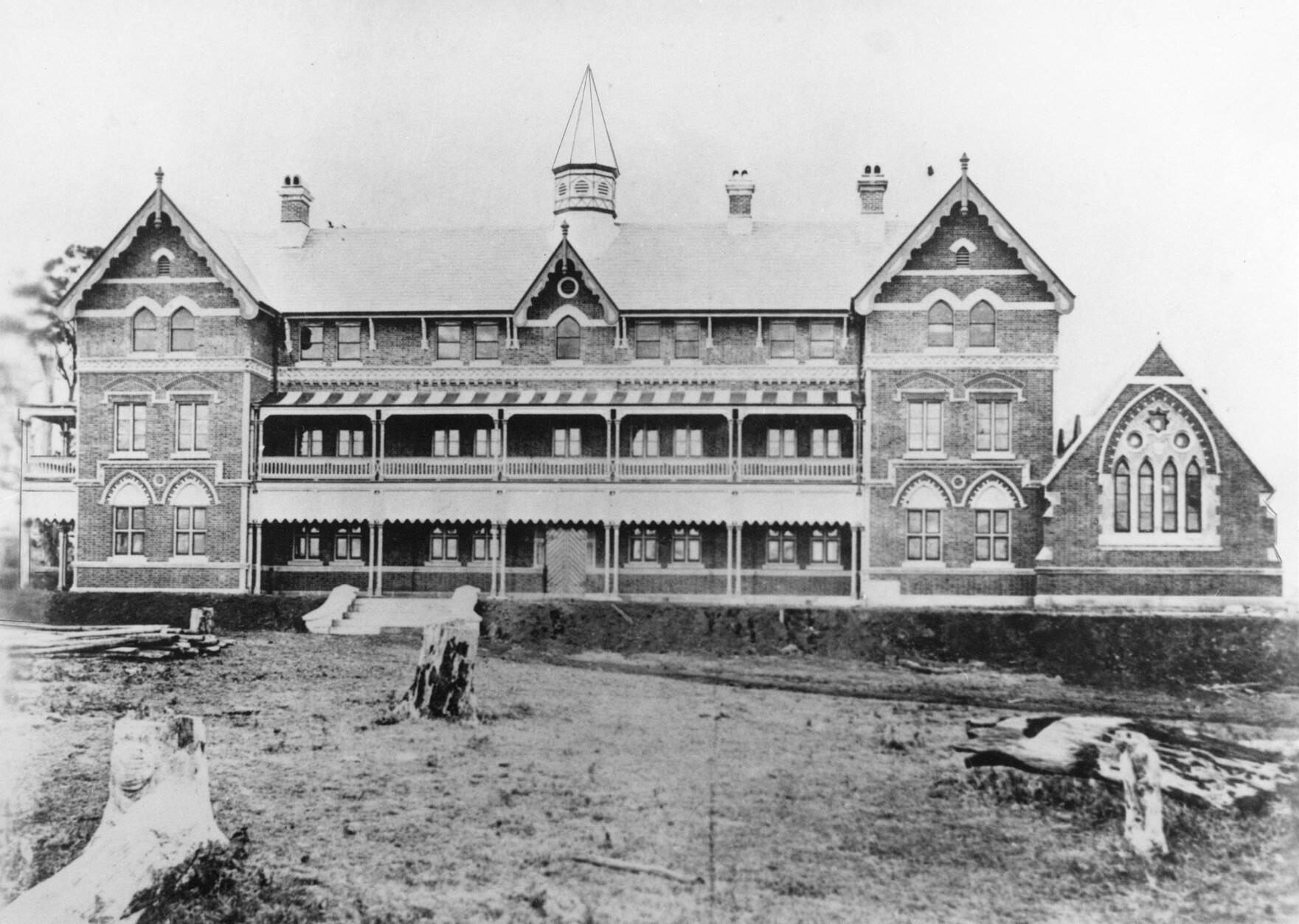


Chairman of the Board of Trustees: The Hon. James Taylor, MLC (in his 4th year)
Trustees: Messrs Samuel G. Stephens, William Graham, Hugh M. Nelson, Patrick Perkins, Robert Aland, the Hon. James Taylor, MLC and the Hon. John F. McDougall, MLC.
Headmaster: Mr John Mackintosh (in his 2 nd year, having been appointed in the previous year prior to the students commencing this year)
Second Master: Mr J. B. Thallon (in his 1st year)
Senior Prefect: Charles H. Hodgson (who was again the Senior Prefect in the following years and concluded his schooling in 1880). (see 2017 – Events)
Dux of Year: Charles H. Hodgson (and in the following year)
Total School Enrolment: 44:
Number of Dayboys: 24
Number of Boarders: 20
Staffing:
• The School commenced with the Headmaster, Mr Mackintosh, two Under -Masters (Mr J.B. Thallon and Mr G.M. Taylor), a music instructor and a drill instructor. Interestingly, a female teacher was on the first staff – Miss Lewis was employed on a part-time basis to instruct the boys in Music.
Students:
• Ten of the original 44 students were under 12 years of age. Of the 44 boys, there were 20 boarders and 24 dayboys. The School Magazine of 1905 (pg.41) listed the names of all boys and their hometown who had attended the School from the first admission of students in 1877 to 1905. Of the 20 boarders in 1877, three boys were from Jondaryan (the McDougall brothers) and two boys also came from the following cities or towns – Brisbane, Rockhampton, Inglewood, Killarney and Warwick. Individual boarders also came from Rockhampton, Cairns, Maryborough , Cunnamulla and other districts.
• All Old Boys of the School throughout the School’s history have had their names entered in two very special books held in the School Museum. Since 1877 the School Register has been painstakingly handwritten to record the name of every boy who has entered the School since the first day on 1 February 1877. There have been 14,861 names entered into the book from 1877 to 2007 filling 300 pages. As there were insufficient pages left in the Register to record the 2008 year’s intake, a new book was prepared. As at June 2024 this second volume of the School Admissions Register contained a further 3,885 student names, representing a total student enrolment from 1877-2024 of 18,746 boys. The original Register is 400mm high by 300mm wide
and 100mm thick, bound and covered in English calf leather which is embossed on the front. Both volumes of the School Register are housed in the School Museum. A photograph of the first volume of the School Register is included in this year’s entry together with the first page of its student admission records.
• The School’s first enrolled student was Alfred G. Stephens, the son of the Secretary to the Board of Trustees and Newspaper Manager, Mr Samuel G. Stephens. Mr S. Stephens was later to have the School Library and a House named after him. Alfred Stephens later achieved fame as editor of the Bulletin’s Red Page, noted for its enormous influence in the literary field . In 1940 his sculptured bust stood in the Public Library of New South Wales beside those of other great Australians. A photograph of the receipt of admission for Alfred Stephens is included in this year’s entry. In May 2022, TGS Old Boy Ian B. Morris (1957 -1960) donated to the School a Bible which belonged to first enrolled student, Alfred G. Stephens and a photograph of this Bible is included in this year’s entry.
• The second listed boy in the School’s attendance register was Jessop John Stanley, a boarder from Dalby.
• William D. Armstrong was later to become Speaker of the Legislative Assembly.
• Benjamin ‘Benny’ A. Benjamin was Captain of the School’s 1 st XI Cricket team for four years, 1877, 1878, 1879 and 1880 and also captain of the football (Australian/Victorian Rules) team. He was to later live in Los Angeles. Benny Benjamin is featured in the photograph of the 1st XI Cricket team in next year’s entry.
• The Hon. James Taylor, MLC was one of those who worked for the foundation of the School. In 1887 his son, also named James, attended the School. An obituary relating to James Taylor Jnr. appeared in the School Magazine of 1939 and his photograph is included in this year’s entry.
• Included in the School’s archival collection contained in the School Museum is a ‘Prize’ certificate awarded to Ronald McDougall “for eminent success in his studies in the First Form”, dated December 1877 and signed by the Headmaster, Mr Mackintosh. A copy of Ronald’s Prize Certificate is included in this year’s entry.
• A list of the names of all boys, and their home town, who attended Toowoomba Grammar School from 1877 to 1905 was published in the 1905 edition of the School Magazine (May, vol.2 edition) on pages 41-50.
Events:
• The School opened on Thursday,1 February, 1877, on its current site which was the “Old Queen’s Park”, a location considered by many at the time to be too far out of town. The Toowoomba Chronicle of 3 February “regretted that the opening of such an important institution was not made the occasion for a partial holiday, and some demonstration on the part of the public. The occasion was well worthy of such an honour.”
• In this year there was no electricity, telephones, sewerage, reticulated water, motor car and so on.
• The Curriculum included the Classics (Latin and Greek), modern languages (English, French and German), Mathematics (Pure and Mixed), History, Geography, Writing, Bookkeeping, Drawing, Elocution, Chemistry, Experimental Physics, Elementary Physiology and Geology, Vocal Music, Drill and Gymnastics.
• The basic organisational structure of the School was based on the model of the English public (private) schools. The boys were grouped into Forms (but the placement of boys in these Forms was based more on academic ability than age). The school year was divided into four quarters (terms) with six weeks’ vacation in mid-summer and two weeks in mid-winter. The first and
second quarters were split by a long weekend for Easter, whilst the Michaelmas holidays (Spring holidays: see 1942) were celebrated between the third and fourth quarters. Additional special holidays were granted for the birthdays of Queen Victoria, the Prince of Wales and for Separation Day.
• In May a piano was purchased “for the purpose of instructing in instrumental music”.
• The Receipt Book housed in the School’s Museum r ecords the tuition fees per quarter as four pounds and four shillings. The boarding fee was eleven pounds per quarter.
• An Aboriginal campsite and dance ground existed at or around the sit e of the School at this time. Former TGS Old Boy (1999-2003) and current teacher of History at the School, Douglas Michael, in 2023 wrote a scholarly paper titled ‘Campus of TGS in Bonye Dagun (Bunya Country) Cultural Landscape’. In his paper, Douglas Michael stated: “ In summary, it is logical to conclude that the Aboriginal campsite and dance ground at TGS was a permanent campsite, used seasonally, by local people of the Wakka-speaking Giabal (Gooneburra), Jarowair, and Jagera-speaking groups from the Lockyer Valley and Ipswich region. It possibly hosted larger numbers and groups from further afield following songlines to and from the Bunya Mountains every third year. People camped there would have made use of food and water resources from the Gowrie Creek catchment, traded, held corroborees, and recounted stories specific to the highly significant cultural landscape of the Toowoomba escarpment and Lockyer Valley, and wider cultural landscape of Bonye Dagun.” Douglas Michael’s research was part of the School’s Reconciliation Action Plan (see 2023). Dr Rupert Goodman, the author of the book Toowoomba Grammar School 1875-1975 A Centenary History, on page 14 referred to some evidence of an Aboriginal camp in the School grounds at this time in the vicinity of what is now the Junior School. Apparently, this camp was moved to the heavily timbered forest area near where Taylor Boarding House now stands when the noise emanating from it disturbed the boys at their studies.
Co-curricular Activities:
• In Cricket, the first recorded official game, which was a two -day match for the Toowoomba Grammar School Cricket Club, was played on successive Saturdays of 3 and 10 November 1877 against the 2nd XI of the Aubigny (Toowoomba) Cricket Club. In a remarkably close yet low-scoring game the School team was beaten by just five runs. The following weekend the School’s cricketers played a two-day match in Toowoomba (but not at the School due to lack of suitable facilities) against the Ipswich Grammar School (IGS) Cricket Club. It is thought that the game was held at Toowoomba’s main cricket ground which then was at the Aubigny Cricket Club’s ground in Russell Street, West Toowoomba (Aubigny is a small district just west of Toowoomba’s Wellcamp Airport). The Ipswich Grammar Scho ol side travelled to Toowoomba by train and the game commenced at 2:00pm. The Darling Downs Gazette’s Ipswich correspondent on Saturday 15 December 1877 reported: “Our Ipswich Grammar School boys are quite jubilant over the victory they achieved in Toowoomba, although gained, as it were, only by the skin of their teeth . They were highly delighted with the trip and are loud in their praise of the kind and hospitable manner in which they were received by Mr Mackintosh, the Headmaster, the teachers and scholar s of your school. I trust the visit will be reciprocated. If it is, I can promise you the Ipswich boys will not be behind their comrades over the range in their demonstration of welcome. I am decidedly in favour of these meetings. They tend to promote the best of feeling between rival institutions and I hope they will be continued and fostered. What tends more to soften the asperities of life in after years than a quiet ‘yarn’ over the events of our school days.”
• The next cricket match played between TGS and IGS was not until ten years later, 1887.
• Four more cricket matches against Ipswich Grammar School were played in the years 1888 (two matches, one early, the other late in the year), 1889 and 1891. They were all played in Toowoomba except the November 188 8 match which was played in Ipswich.
• In Swimming, in summer, the boys swam at Usher’s Pond (corner of Perth and Kitchener Streets).
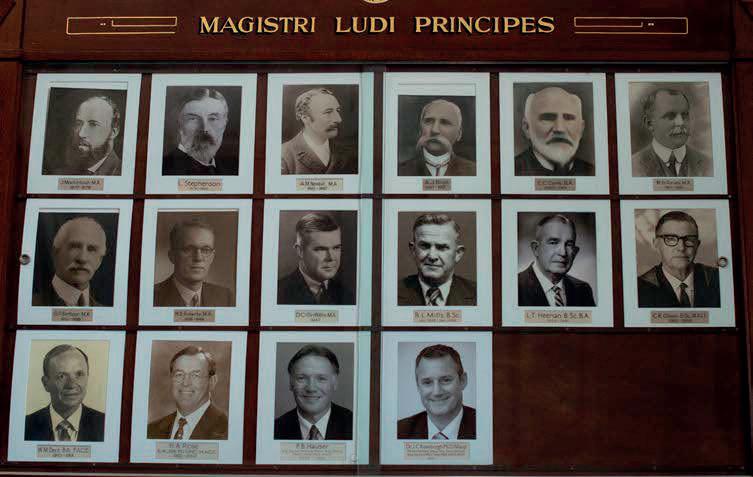
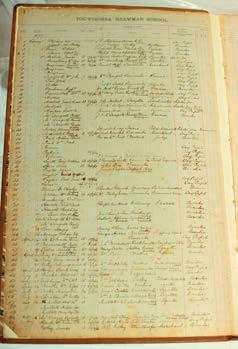

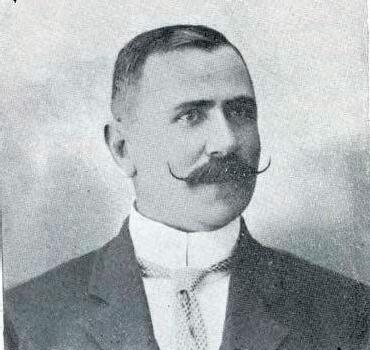
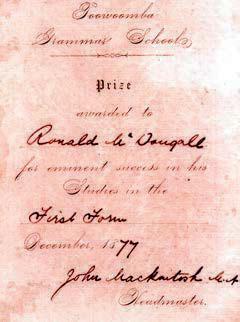
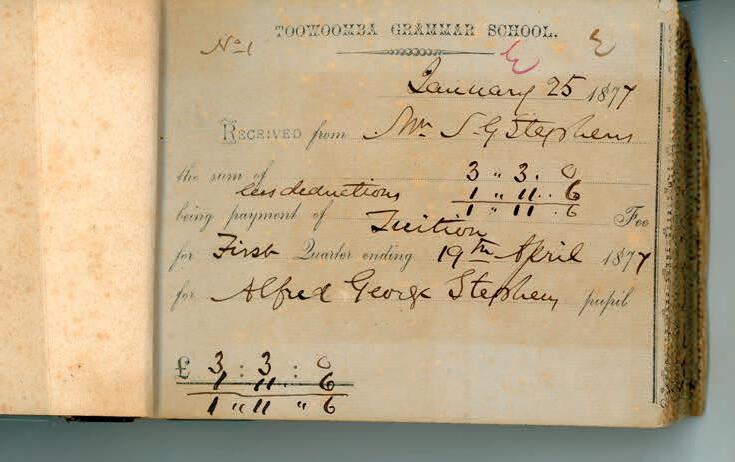

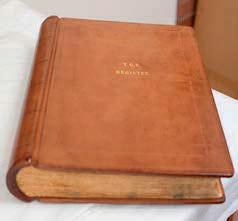
Chairman of the Board of Trustees: The Hon. James Taylor, MLC (in his 5th year)
Headmaster: Mr John Mackintosh (in his 3rd year)
Second Master: Mr J.B. Thallon (until his resignation in September)
Senior Prefect: Charles H. Hodgson (and Dux)
Dux of Year: Charles H. Hodgson (see 1983)
Total School Enrolment: 52
Number of Dayboys: 27
Number of Boarders: 25
Staffing:
• A fourth Master was appointed for the commencement of the year, Mr George G. Blaxland, who resigned at the end of the following year to command the Queensland Volunteer Force. Upon his departure from the School he was presented with a suitably engraved Officer’s Sword which was subsequently returned to the School well after his death. The sword is now in the School Museum.
• For the first twenty-five years of the School’s operation, student enrolments were quite small and so at no time was there more than four or five members of staff. Most lived at the School and boarded as guests in the Headmaster’s residence within the main school building (now known as School House).
• The Second Master, Mr Thallon, tendered his resignation to the Board of Trustees later in the year.
Students:
• Of the hundreds of candidates from the colonies who had contested the Sydney University’s Junior Public Examination, only four had succeeded in passing nine sections, which was the maximum attained. Toowoomba Grammar School’s Charles H. Hodgson (Senior Prefect and Dux) was one of them.
• Alfred G. Stephens topped the English grades in Form IV This was a strong indicator of Alfred Stephens’ future distinguished literary career (see 1880). Stephen’s English result surpassed that of Charles Hodgson who was not only Proxime Accessit for Form IV English but also Senior Prefect and Dux at this time.
• Charles ‘Chas.’ Stumm was enrolled in the School and he was to become Justice of the Supreme Court of Queensland. The School, to the current day, presents three academic awards named
after Mr Stumm – an Award for those boys gaining a Maxima Cum Laude in Ye ar 9 and the Stumm Memorial Prize for the boy receiving the highest result in Year 12 Japanese and Year 12 Mathematics B. In 1911 Mr Stumm made the generous gift of one -hundred pounds to fund an annual prize – one for Mathematics and one for Languages. Charles Stumm was also the inaugural President of the Toowoomba Grammar School Old Boys’ Association (Brisbane Branch) in 1925 and held this position at the time of his death On 6 February 1929 Charles Stumm was appointed a Judge of the Supreme Court of Queensland at the age of 63. Tragically, three weeks later, Justice Stumm died as a result of an accident in which he stepped off a tram in Brisbane and was struck by a motor vehicle.
Events:
• Tragically, one of the Headmaster and Mrs Mackintosh’s daughters, Florence Ethel, passed away in May from a childhood illness aged four years.
• The School Bell was rung to signify lesson changeover times and breaks. The bell is housed in the ‘bell tower’ which straddles the roofline of School House, the original building. The bell was activated by pulling a chain located at the main entrance to School House. This chain remains in place but the bell in the bell tower has been padlocked. The bell was still in use until the mid 1960’s. Mrs Judy Gillies (nee Magarry), the Schoo l’s longest-serving member of staff in its history (retiring in 2012 after working at the School for 54 years) recalls being required to ring the bell at lesson change-over times and, at times, feared forgetting to complete this task. Mrs Gillies was to ring the school bell once more at the time of her retirement day in front of the entire school (see 2012) in a very moving ceremony (see the ‘Staffing’ and ‘Events’ section in the 2012 entry). A photograph, taken in 2012, of Mrs Judy Gillies ringing the orig inal bell is included in this year’s entry.
• The daily routine in the School Dining Room under the Headmastership of Mr Mackintosh was as follows: the Housekeeper, Miss Smith, and her housemaid, both dressed in their white starched uniforms, would have previously lit the trimmed wicks of the hanging lanterns; the Headmaster, positioned at the head of his family’s table would have said the grace in Latin – Benedictus Benedicat, Per Jesum Christum, Dominum Nostrum – (May the Blessed One bless us, through Jesus Christ Our Lord, Amen) – and the boys would have waited for Mrs Mackintosh and her daughters to be properly seated before they took their places prior to positioning their linen napkins on their laps in readiness for their meal which had been prepared by their cook, Sarah Gibson.
• In this year’s entry is a photograph of the program of events for the School’s sports day. The event was held on 19 December and celebrated ‘breaking-up day’ followed by tea in the dining-room. The sports program was printed on white silk fabric and hemmed with a blue b order. In these days the School’s colours were blue and white.
• In Athletics, The Queensland Times favourably reported on the behaviour of the Toowoomba Grammar School boys in late June 1878. The newspaper stated: “About fifteen of the pupils of the Toowoomba Grammar School accompanied by Mr Blax land, one of the masters, passed through Ipswich yesterday, by the afternoon train, on their way to Brisbane to take part in the athlet ic sports to be carried out on the Hamilton grounds today. Between forty and fifty of the boys from
our local school were in waiting on the platform when the train arrived, and cheered the Toowoomba visitors most vociferously, the compliment being returned with equal vigour by the representatives of the metropolis of the downs. On leaving the station the same manifestation of good feeling was again indulged in, and the Toowoomba boys departed amidst the ringing hurrahs of their Athenian compeers.”
• In these earlier years of the School there were combined sports held for the boys of Brisbane Grammar School, Ipswich Grammar School and Toowoomba Grammar School. In this year the inaugural event took place. There were four such held in 1878, 1879, 1880 and 1881; o f these, the School won one. (see 1880)
• The aforementioned combined athletics sports fixture between boys attending the three Grammar Schools of the colony - Brisbane Grammar School, Ipswich Grammar School and Toowoomba Grammar School - was held on Saturday, 22 June of this year. The venue was the Hamilton Cricket Ground in Brisbane. The sixteen TGS boys involved in the competition, together with the School Master Mr George Blaxland, arrived by train on the Friday evening prior to the event. In a newspaper article reproduced by Trove it was reported – “The result has proved highly satisfactory. The entries for all the events were very numerous, the competition was of the keenest (rendered all the more so by the fact that a silver cup was to be given to the school winning the largest number of events), and – what was of far greater importance – the best spirit was shown by the boys of each school towards those of the others. Throughout the whole of the day not an envious or disparaging word was heard spoken by one lad concerning another, the victors taking their success without ostentatious boasting, and the vanquished accepting their defeat in excellent part.” Two events were listed as ‘kicking football’ and ‘throwing the cricket ball’ with C.H.Tully from TGS placing second in this latter event with a throw of 81 yards. Other more unusual events were a three-legged race, vaulting with pole and tug-of-war.
• In this combined athletics sports fixture, IGS scored by far the largest number of points during the day and was therefore winners of the cup. It was also reported that many gentlemen of civic importance took great interest in the sports day with the Chief Justice, the Speaker of the Assembly, the Attorney-General, the Post Master General and other politicians in attendance. The sixteen TGS athletes returned to Toowoomba on the following Monday.
• In Cricket, the School’s 1st XI Cricket team played Brisbane Grammar School (BGS) six times between 1878 and 1885. In this year, playing in Toowoomba at the Aubigny (Toowoomba) Club Ground in Russell Street on 16 November, TGS lost the game scoring only 13 runs in the first innings and 23 runs in the second innings (BGS scored 31 and 63 runs in the two innings). Further cricket games between the two schools occurred in 1879, 1881, 1883, 1884, and 1885. No further matches were recorded for some reason until 1911. Only the 1879 match was played in Brisbane at The Queen’s Park (bounded by Elizabeth, George and William Streets). Records from Brisbane Grammar School from that era include the following interesting observation: “the long and expensive journey is a great hindrance to keeping these matches up, for the visiting team will not undertake the journey unless there are reasonable hopes for success.” (see 1885). The exact location of the Aubigny Cricket Club Ground in Russell Street is somewhat unclear but a representative of the Toowoomba Historical Society said that records indicate d it was nearly opposite the Hon. James Taylor’s residence in Russell Street (i.e. Clifford House, now known as the location of Gip’s Restaurant). Mr Taylor was the Chairman of the School’s Board of Trustees at the time and reportedly he allowed the Aubigny Cricket Club use of his paddock in Russell Street adjoining what was previously the location of Vacy Hall.
• A photograph of the first TGS Cricket XI team to play BGS is included in this year’s entry: (Standing) - Ernest Baynes, George Baynes, ‘Cam’ Turner, Frank Little, John Hensler , (Second Row) - A.
Devine, Ben Benjamin (captain), Hector Perkins, (Front Row) - Roland Irby, Joe Benjamin, Percy Smith. The sporting tops worn by the boys in this photograph were in the School’s original colours of dark blue and white. These colours for the School were changed in 1901 to dark blue and gold for they were also the town of Toowoomba’s colours.
• The local newspaper quoted words from the Headmaster, Mr Mackintosh, spoken at the School’s first ‘Distribution of Prizes’ (nowadays the Speech Day and Prize Giving Ceremony). The Headmaster stated: “Cricket I regard as a part of the school work. Every boy in the first eleven is expected to take his place in the cricket field, and the discipline there is the same as in the School. They have played several matches, but they have not yet won one. Those, however, who have seen them play will bear testimony to the skill and patience with which they play an uphill game.”
• In Tennis, the game was played at the School this year and several years later and a rough tennis court was laid out
The Distribution of Prizes Day Guest Speaker: Mr John Mackintosh, Headmaster. This function, held at the School on 12 March 1878, was the School’s first distribution of prizes ceremony, later to be known as the annual Speech Day and Prize Giving Ceremony.
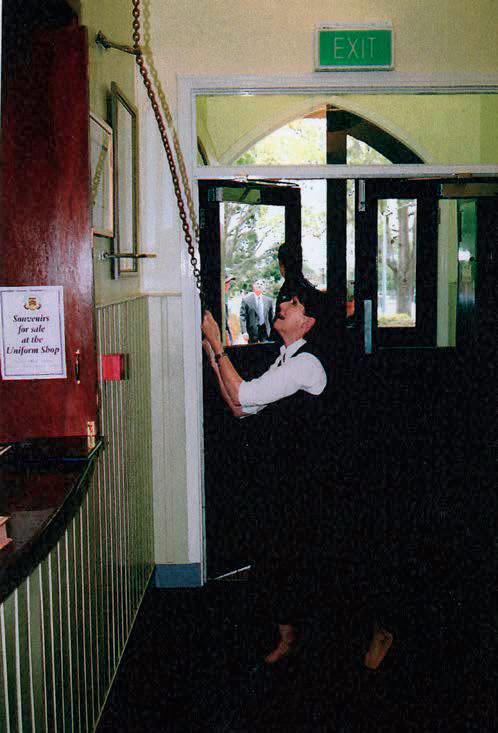
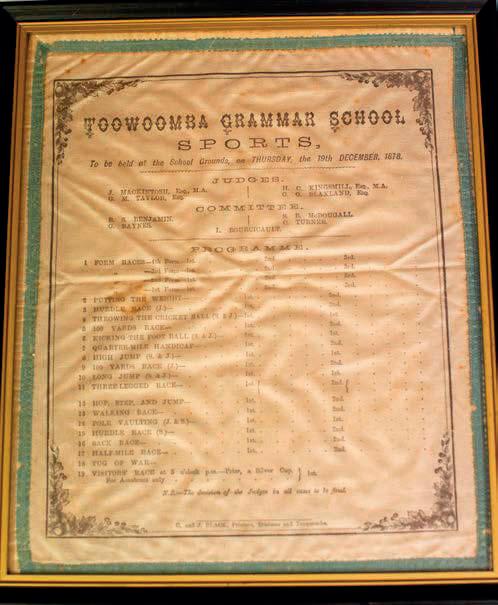
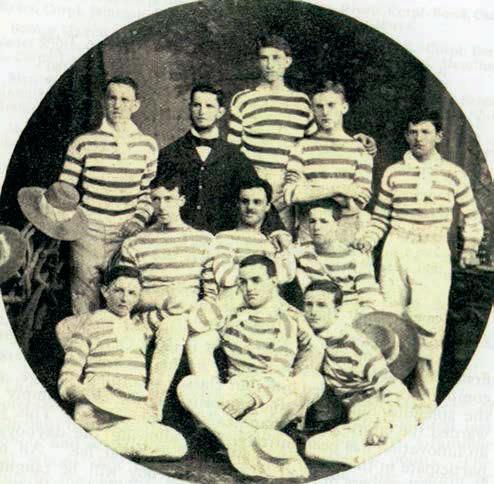
Chairman of the Board of Trustees: The Hon. James Taylor, MLC (in his 6th year)
Headmaster:
• Mr John Mackintosh (in his 4th year) until his death on 12 April (see below). The Senior Master, Mr C. Kingsmill, was promoted to the position of Acting Headmaster for the time before a new appointment was made. In June Mr W. R. Burkitt (from the King’s School, Parramatta) was offered the Headmastership but, shortly after, the School received correspondence casting certain insinuations against Mr Burkitt and his character. Mr Burkitt subsequently withdrew his application.
• In October, Mr Lawrence Stephenson of St John’s College, Cambridge, commenced as the School’s second Headmaster, at age 41 years. He was to be the Headmaster of the School for only three years and his contract of employment was terminated by the School’s Board of Trustees. Prior to his appointment Mr Stephenson was a teacher of Mathematics at Sydney Grammar School and had been recommended by the Headmaster of this school, Mr Albert Weigal l, to the Chairman of the Board of Trustees of Toowoomba Grammar School. Interestingly Mr Stephenson had a passion for rowing and, in conjunction with two of his colleagues, founded one of Sydney Grammar School’s great sporting traditions, namely the rowing club. Mr Stephenson had been introduced to the sport of rowing whilst at Cambridge University. In 1875 Mr Stephenson took part in a rowing expedition along the Murray River from Albury to Lake Alexandrina. He was also a very keen walker and on one occasi on walked from Brisbane to Melbourne. Mr Stephenson passed away in 1921, aged 83 years.
Second Master: Mr George M. Taylor until his resignation in May following Mr Mackintosh’s death . He was succeeded by Mr Henry C. Kingsmill.
Senior Prefect: The School has no listing of the name of any Senior Prefect.
Total School Enrolment: 60
Number of Dayboys: 41
Number of Boarders: 19
Staffing:
• Shortly after the tragic passing of Headmaster Mackintosh (see below in the ‘Events’ section), the Trustees felt it necessary to seek the resignation of the Second Master, Mr George Taylor. This was for “conducting himself in a most shameful manner on the platform of the railway station on the night when the body of Mr Mackintosh was brought to Toowoomba, and afterwards at the School”
• When the new Headmaster, Mr Stephenson, arrived, the three existing Undermasters had been given dismissal notices to be effective from the end of the year. There was the tradition at the time of the incoming Headmaster appointing his own staff.
• Prior to the arrival of the new Headmaster, the Senior Master, Mr Henry C. Kingsmill, was acting Head for a few months during the interregnum between the death of Mr Mackintosh and the appointment of his successor. An Old Boy wrote: “Billy was a walking encyclopaedia but he did not have the teaching capacity of Mr Thallon. ” Mr Kingsmill was known to ride on the “bone shaker” of the times, named because of the extremely uncomfortable ride caused by the stiff wrought-iron frame and wooden wheels surrounded by tyres made of iron. Mr Kingsmill left the School with the appointment of Mr Stephenson as the School’s second Headmaster and transferred to Sydney Grammar School. Of interest, Mr Stephenson also transferred to Sydney Grammar School after three years’ service as Headmaster of Toowoomba Grammar School.
Students:
• Students 7, 8 and 9 on the School Roll were the three Benjamin brothers, all enrolled when the School commenced in February 1877. As was to become the custom at the time for any boy enrolling with a brother or sharing the same surname as another boy, the Benjamin brothers became known as Benjamin I, Benjamin II and Benjamin III. In 1879 all three Benjamin brothers acted in a performance of Shakespeare’s Julius Caesar with Benjamin I playing Julius Caesar and his younger brother Benjamin II playing Decius Brutus and his youngest brother, Benjamin III, playing the servant. The performance was part of a number of events to boost the Mackintosh Memorial Testimonial Fund.
• Littleton E. Groom commenced in this year aged eleven years. After completing his education at TGS he attended the University of Melbourne where he gained degrees respectively of Master of Arts, Bachelor of Law and Master of Law. He was later to be knighted, became a member for t he seat of Darling Downs for a period of 36 years and subsequently he was appointed as the Speaker of the House of Representatives. He was to become the Federal Attorney -General in 1906. Writing in the School’s Jubilee History of 1926, Littleton Groom reca lled his school years from 1879: “In those days most of the boys rode (horses) to school. Many exciting races were witnessed around the School paddock. Buck-jumping exhibitions were not unknown and paper chases on horseback proved exciting events. Pocket money was scarce. All ground preparations for football and cricket and sports were made by the boys themselves. Sheep hurdles were borrowed from the Show Grounds. Prizes were collected from the townspeople.” Littleton Groom was Captain of the 1st XI Cricket team in 1884 and 1885, Captain of the 1st XVIII Australian Rules team for three years, 1883-1885, and Dux of the School in 1883. ‘Groom House’ was named after Sir Littleton Groom Also, the School presents the Sir Littleton Groom Memorial Prize each year at the Speech Day and Prize Giving Ceremony to the Dux of Year 11. This Prize was initially named the Sir Littleton Groom Memorial Prize for Best Senior Certificate 1941 -1993 and in 1994 took its current title A photograph of Littleton Groom is included in this year’s entry. Further information relating to Sir Littleton Groom and his father is to be found in the 1883 entry.
• Napier P. Robinson (1879) later became prominent in banking and commerce. In 1926 he contributed his reminiscences for the Special Jubilee of the TGS Magazine. In this he stated: “I made my bow to the Headmaster in June, 1879. Amongst the boys then at the School were C.H. Hodgson of the Bank of N.S.W., Charles Stumm, now a leader of the Queensland Bar, A.G. Stephens, one of Australia’s most prominent men of letters, and who first edited the Red Page of the Sydney Bulletin, and R.G. Wonderley, afterwards so prominent in the social and political life of your town, were stalwarts of the classrooms…. Cricket received a great fillip with the arrival of the new Head (A.M. Nesbitt) from England, whom I personally regarded as the best bat in the town, if not in the State. Those were the days of rough mud wickets and for a period we did not even have matting or concrete, much less turf.”
Events:
• On Saturday, 12 April, the Headmaster, Mr Mackintosh, then aged 43 years, went off on a trip by horseback to Helidon Creek accompanied by Mr Taylor, one of the masters of the School Apparently the horse took fright, throwing Mr Mackintosh against a tree, killing him instantly. Later, his eulogy confirmed that he would be remembered as one “… who was liked and respected by all with whom he came into contact. He had a kind, sympathetic heart, was generous almost to a fault and it may be safely said that he has died leaving behind him nothing but kindly recollections and profound regret at the loss of an accomplished scholar and perfect gentleman.” Mackintosh House is named after Mr Mackintosh and for a number of years there w as a Mackintosh classroom block (see 1980). A marble tablet recording the boys’ esteem and affection for Mr Mackintosh was placed in Old Hall above the fireplace and a photograph of this plaque is included in this year’s entry. For details of the School’s Interact Club restoring Mr Mackin tosh’s grave more than a century after his death, please refer to 1985 in the ‘Events’ section.
• On 22 May 1879, it was announced in The (Toowoomba) Chronicle that the Mackintosh Memorial Testimonial Fund was to be set up “to benefit the widowed Edith and the five children of the late Headmaster”. The Honorary Secretary for this fund was Mr Harry C. Kent, of Reiby House, Newtown, Sydney, who quickly organised meetings in Ipswich, Brisbane, Toowoomba and Sydney to launch the appeal. Eventually a credible amount was raised with the School contributing by conducting a number of benefits to boost the fund. One such function proved to be an outstanding cultural evening which involved the town community. Held in the Toowoomba School of the Arts building on the evening of Tuesday, 2 September, the program included “songs, readings, recitations, a pianoforte duet, and a performance of Shakespeare’s play Julius Caesar” (see 1887). The School’s Museum has a copy of the concert program and a photograph of this is included in this year’s entry. The concert program is printed in silk thus the quality of the print in the photograph is difficult to read. The program commenced with a chorus Men of Harloch, then a song was sung by Mr McDonald. The pianoforte duet was performed by Roland Irby and MacDougall followed by a reading by Mr Blaxland and others. Students involved in the performance of Julius Caesar included MacDougall, Archer, Ben and Joe Benjamin, Joseph Herbert, Charles Hodgson, Hector Perkins, Little, Frederick Taylor, A. Devine and others.
• When the new Headmaster commenced on 3 October, he accompanied the Trustees to “the large school room” (now Old Hall) where the boys and undermasters were assembled, whereupon he was formally installed by the Chairman as Headmaster. The boys were subsequently delighted for they were then granted an instant holiday by the Trustees to mark the occasion.
• In these days most boys rode to school. Horse racing occurred around the school paddock. The station owners’ sons brought stock horses to the School as they could take the corners better.
• In October, a field was fenced and this was later to become Barbour Oval (named after Mr Barbour in 1954 – the longest-serving Headmaster in the School’s history ).
• The School’s sporting colours of blue and white were introduced (see 1901).
• In Athletics, in June the “United Grammar School Sports” were held in Ipswich. In this athletic competition Ipswich Grammar won with 101 points, second was Toowoomba Grammar School with 51 points, followed by Brisbane Grammar School with 35 points.
• The last day of the school year, the “breaking up day” , was celebrated by an athletics sports programme which was then followed by tea in the dining-room for the boys, masters and visitors. At the Sports the program of events was printed on white silk fabric and hemmed wi th a blue border. This program is housed in the School Museum. At this time the School’s colours were blue and white. During the function in the dining-room, Benjamin (One) was considered “the most manly boy in the School”. Upon the result being announced by the Headmaster, three cheers were called for ‘Benny’ Benjamin.
• In the School Sports at this time, many of the boys ran in tights and coloured trunks like circus acrobats.
• In Cricket, the School’s 1 st XI cricket side played Brisbane Grammar School in November in Brisbane. This was the first time the TGS 1st XI cricket team ever visited another GPS school to play cricket. The game was played at Queen’s Park in Brisbane (bounded by Elizabeth, George and William Streets). Reporting in the Brisbane Courier Mail it was stated: “The Toowoomba boys, judging by their scores, had no heart at all in the second innings.” The Captain of the TGS side was ‘Benny’ Benjamin (and also in the previous year) and the School lost by an innings and five runs.
• In Music/Drama, see the ‘Events’ section above in this year’s entry.
The Distribution of Prizes Day Guest Speaker : His Excellency The Governor, Sir Arthur Kennedy (on Friday 14 March, 1879 at the School)
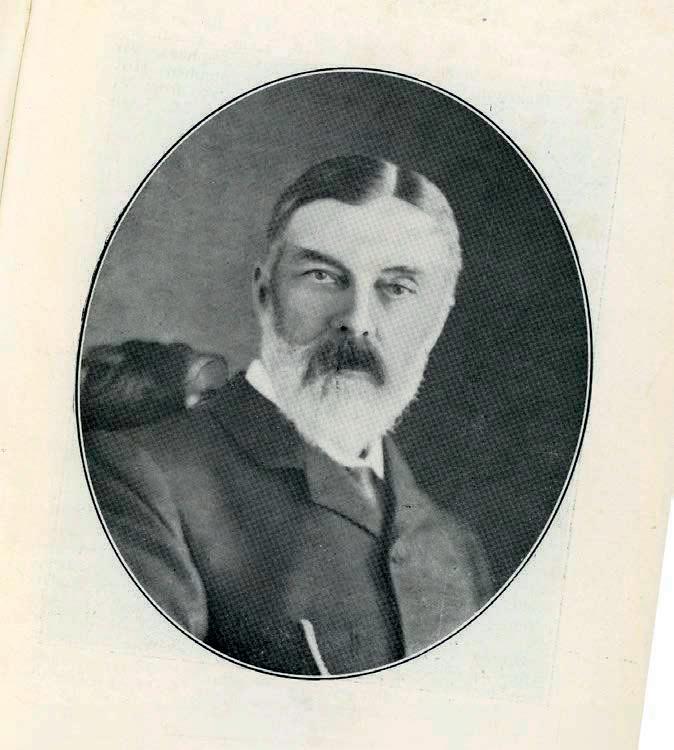
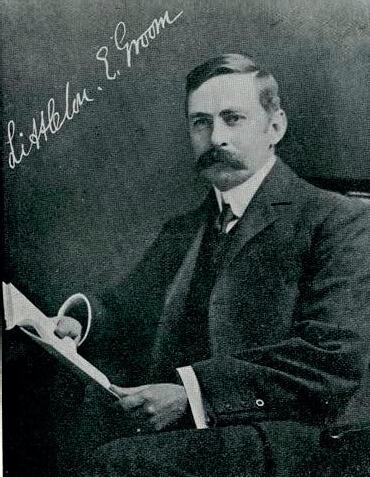

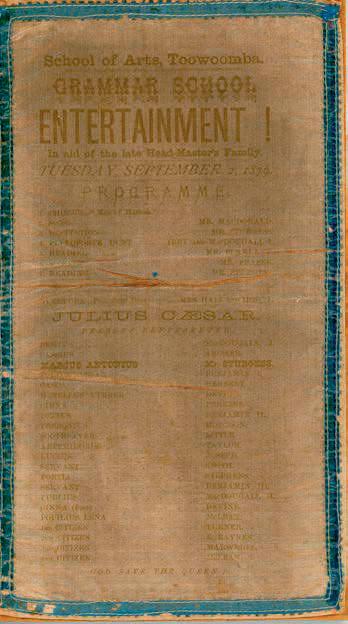
Chairman of the Board of Trustees: The Hon. James Taylor, MLC (in his 7th year)
Headmaster: Mr Lawrence Stephenson (in basically his first year having commenced in October of 1879)
Second Master: Mr M.B. MacDonald (Classics and English)
Total School Enrolment: 55
Number of Dayboys: 36
Number of Boarders: 19
Students:
• Alfred G. Stephens (1877-1880) was the first boy enrolled at the School. His father, Samuel George Stephens, is acknowledged as the Founder of Toowoomba Grammar School and he was the Secretary to the Board of Trustees from 1874 to 1900. Alfred Stephens wen t on to become an author, playwright, lecturer, art and literary critic, press correspondent and publisher. He was instrumental in the positive advancement of the early Australian poets such as Banjo Paterson and Henry Lawson, both of whom he promoted through the Bulletin’s Red Page. Alfred Stephens is acknowledged on the Toowoomba Grammar School Old Boys’ Wall of Achievement.
• Rowland Irby (1879-1880) died in an accident during one of the boarders’ excursions ‘down the range’. Rowland was killed by a falling branch of a tree. (see ‘Events’ below).
• Henry ‘Harry’ Chauvel (later Sir Henry Chauvel) was to become one of the greatest soldiers that Australia had produced. Whilst TGS rightly claims him as an Old Boy, so do three other schools. ‘Harry’ was only at TGS for several years (see below).
• The following is an excerpt from a speech delivered to the School by a TGS parent, BrigadierGeneral Lock C. Wilson in 191 9 on the occasion of the unveiling of the second and third bronze and copper military Honour Boards in what is now Old Hall:
“General Chauvel had been associated with the Light Horse during the war. He originally commanded the 1st Light Horse Brigade. On Gallipoli he commanded the 1st Infantry Division. After the evacuation he again commanded the 1st Light Horse Brigade and also some British and Indian cavalry. General Chauvel had the honour of commanding the largest cavalry forces in the world –the largest cavalry force known in modern warfare. General Chauvel had command of the Desert Mounted Corps, which also comprised one-third English and two-thirds Indian cavalry. This force was 30,000 strong.” (as quoted in the Toowoomba Grammar School Magazine , November 1919, pp 10-11).
Events:
• Henry ‘Harry’ Chauvel and his brother Allan were at the School in this year. ‘Harry’ Chauvel was known as ‘Big Shovel’ to his schoolmates and brother Allan was known as ‘Little Shovel’. They, together with other students, kept their horses at the School and some boys also had their own sporting dogs. ‘Harry’ Chauvel rode home to Tabulam on the Clarence River, New South Wales (150 miles/241 kilometres) for the long holidays. He described the ride as follows when he wrote in the Jubilee Number of the 1926 School Ma gazine. “… the ride was an undertaking thought nothing of in those days. It took a little longer than going by the train, which after all only took one as far as Warwick, and it kept one in good trim and saved paying agistment for the horse in Toowoomba.” The boarders often spent weekends “down the range” where they lived largely on what they could kill. ‘Harry’ Chauvel recounted in 1926 that during his time at the School in 1880 there was little settlement between Toowoomba and Helidon with the country being either virgin forest or scrub, and game, of sorts, was fairly plentiful. Writing in the 1926 Jubilee Number of the Toowoomba Grammar School Magazine, ‘Harry’ Chauvel recollected: “Although corporal punishment was not infrequent, the normal punishment w as “lines” – tens, twenties, fifties, hundreds – and, as it did not matter who wrote them, or what was written provided it was school work, they became regular currency and one put in one’s spare time and a good deal of prep. time in laying up a store either for disposal or in anticipation. Football (rugby) was our favourite game in those days and we used to play Brisbane and Ipswich Grammar Schools and Toowoomba Town. We used also to meet the two other schools annually in Combined Sports…. I had a great sc rap once with the gloves with Jim Tante in the room off the big School room, he representing the dayboys and I, the boarders.” (see 1882 and 1894)
• Whilst the Chauvel brothers were sometimes referred to as ‘Big Shovel’ and ‘Little Shovel” another set of brothers also carried a nickname. The Poole brothers from Cooktown were referred to as ‘Big Puddle’ and ‘Little Puddle’.
Co-curricular Activities:
• In Athletics, The Brisbane Courier on 1st June 1880 reported on the athletics sports arranged for the different Grammar Schools of Brisbane, Ipswich and Toowoomba. The newspaper reported: “On Friday, by both trains, over 70 representatives from Brisbane and Ipswich arrived in Toowoomba and were heartily welcomed. The boys deserve infinite credit for the unfailing good humour, whether successful or defeated; every face wore a smile. In the hurdle race, near the end of the sports, a sad accident occurred to F. Kilner from Ipswich. He and a Toowoomba boy, clearing one of the hurdles together, came into contact, and Kilner was violently thrown to the ground, breaking both bones of his left leg below the knee.” The results of the various events were then given. Interesting events included throwing the cricket ball; kicking the football; siamese race; pole vaulting; walking match; and others. Reporting on the tug -of-war event, the columnist reported: “The first contest was between Brisbane and Toowoomba. At first th e superior weight of the Brisbane boys told in their favour, and they were pulling gradually away, but the Toowoomba boys, by sheer pluck and pulling together, brought their opponents inch by inch over the scratch, and won amid loud applause. Later on the Toowoomba and Ipswich teams met, when the Toowoomba boys had little difficulty in defeating their opponents, and thus won the event.”
• A photograph of a program of events at the Grammar Schools Combined Sports (above) between Toowoomba Grammar School, Brisbane Grammar School and Ipswich Grammar School on Saturday, May 29 is included in this year’s entry. The Latin phrase on the program can be loosely
translated as ‘let whoever earns the palm bear it’ or ‘achievement should be rewarded’. The program for the Combined Athletics Sports of 1880 between the three Grammar Schools is displayed in the School Museum. The program was owned by Donald A. McLean (at TGS 18771881) and given to the School by his Grand-daughter Copland Schmidt. Donald McLean is Student Number 40 on the first page of the School Register of Admissions.
• In Australian (Victorian) Rules Football, the Queensland Grammar Schools played this game to 1887 as the Headmaster of Brisbane Grammar School, Mr R.H. Ro e, allegedly favoured it. It is recorded that at least four games (in 1880 and 1883-1885) were played between the Toowoomba and Brisbane Grammar Schools, all resulting in Brisbane victories. These games must have been marathon affairs, for the records refe r to one encounter which lasted for four hours with only brief intervals between play.
• ‘Aussie Rules Football’ was first known as Melbourne Rules Football, then Victorian Rules Football, then Australian Rules Football. A famous match between two Me lbourne independent boys’ schools, Melbourne Grammar School and Scotch College, occurred on 7 August 1858.
• In Cricket, there was no record of any cricket match played against BGS or IGS. It appears that TGS forfeited a game as it could not field a team to compete against BGS.
The ceremony was held in the ‘large school room’ (the Old Hall). In this year, Miss Kennedy, sister of the Governor, Sir Arthur Kennedy, accompanied him to the School’s Speech Day. She was so distressed at the clumsy efforts of our boys in making their bows to her brother that she gave a golden watch to be awarded to the boy whose bow was judged the best at the Speech Day of 1881. The very small attendance at the Distribution of Prizes was owing to the inclemency of the weather and the state of the roads.
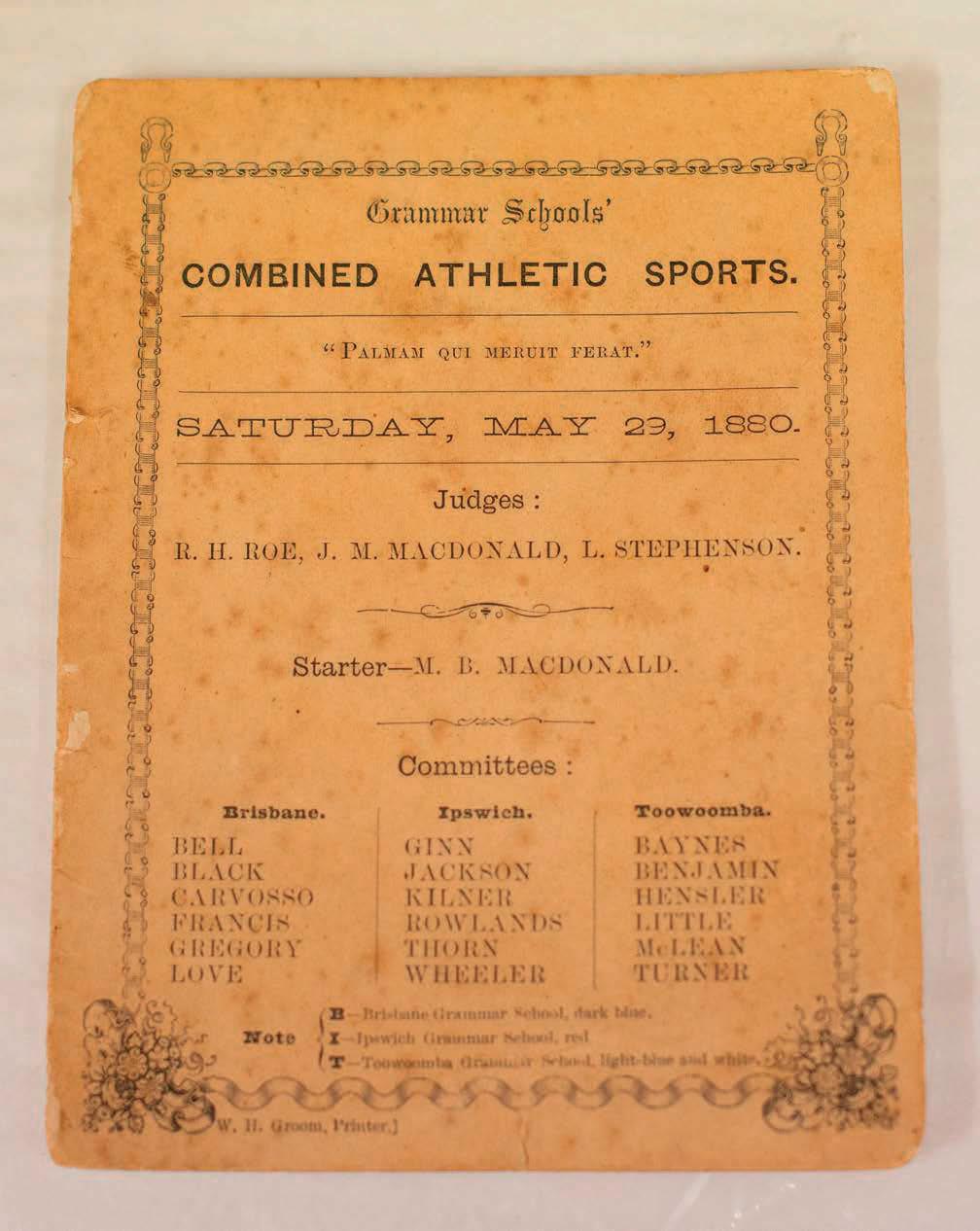
Chairman of the Board of Trustees: The Hon. James Taylor, MLC (in his 8th year)
Headmaster: Mr Lawrence Stephenson (in his 2nd year).
Second Master: Mr Sydney Fraser
Total School Enrolment: 50
Number of Dayboys: 34
Number of Boarders: 16
Staffing:
• In April the Trustees wrote to Mr Stephenson stating that the results in the School were unacceptable and the operation of the School was not to their satisfaction. He was informed that his services would conclude when his three-year contract term expired on 4 October 1882. The Trustees said that they would send to Great Britain for a Headmaster but that Mr Stephenson could have the option of remaining in charge of the School until the arrival of his successor.
Students:
• Walter A. Coxen (TGS 1881) received distinction as having commanded the greatest aggregation of artillery in the history of warfare at Ypres , Belgium, on 8 August 1918. Major-General Coxen was appointed Chief of Australia’s General Staff in 1930. He is acknowledged on the Old Boys’ Wall of Achievement.
• The occupations of the parents of the first 100 boys enrolled in the School w ere referred to by Dr Rupert Goodman in his book Toowoomba Grammar School 1875-1975, A Centenary History on page 19. He identified “thirty per cent of the parents classified themselves as ‘Squatters’, ‘Graziers’ and ‘Gentlemen’. The professionals, doctors, legal men, clergy and architects also constituted a large group. So too did the businessmen of the town, and the white collar public servants, teachers, postmasters, customs officers, civil servants of various government departments. Many saw the opportunities of their children if they could be given a grammar school education and they made sacrifices to ensure their sons were enrolled.”
• A photograph of an academic prize book presented to student William R. Hodgson (at TGS 18811884) for ‘eminent success in his studies in the III Form Classics’ is included in this year’s entry. The prize book is signed by Headmaster Stephenson. Further reference to academic prizes awarded to William Hodgson and other members of the Hodgson family is made in the ‘Students’ section of the 1883-year entry.
Events:
• School enrolments declined.
• The fifth and sixth Grammar Schools in Queensland were established, following Ipswich, Brisbane Boys, Brisbane Girls and Toowoomba Grammar Schools. This year Rockhampton Grammar School and Maryborough Grammar Schools were founded. The latter school, in 1936 to avoid closing, was taken over by the Queensland Education Department as the Maryborough State High Schools for boys and girls respectively.
Co-curricular Activities:
• In Cricket, the 1st XI Cricket team played Brisbane Grammar School in Toowoomba (at the Aubigny Cricket Ground) on 26 November and experienced their first win against this school in the three games played since 1878. TGS scored 39 and 34 defeating BGS 38 and 26 runs. The TGS side had the assistance of two Masters by agreement with BGS. BGS records noted: “The batting and fielding of our side (i.e. BGS) was monstrous, but it was expected to be so as very nearly the whole first XI were makeshifts, the regular eleven refusing to go to Toowoomba to play.”
The Distribution of Prizes Day Guest Speaker: His Excellency The Governor, Sir Arthur Kennedy
The gift of the gold watch was made on this occasion (see 1880) . The newspaper The Toowoomba Chronicle had continued to include unfavourable coverage of the School. On Tuesday, 22 February 1881 the newspaper included reference to the speeches which accompanied the annual distribution of prizes. It was written: “The Headmaster – whose speech, by the way was exceedingly inappropriate for such an occasion, it being nearly all about lavatories and other conveniences – might have devoted a little time to drilling his pupils in the art of common politeness”.
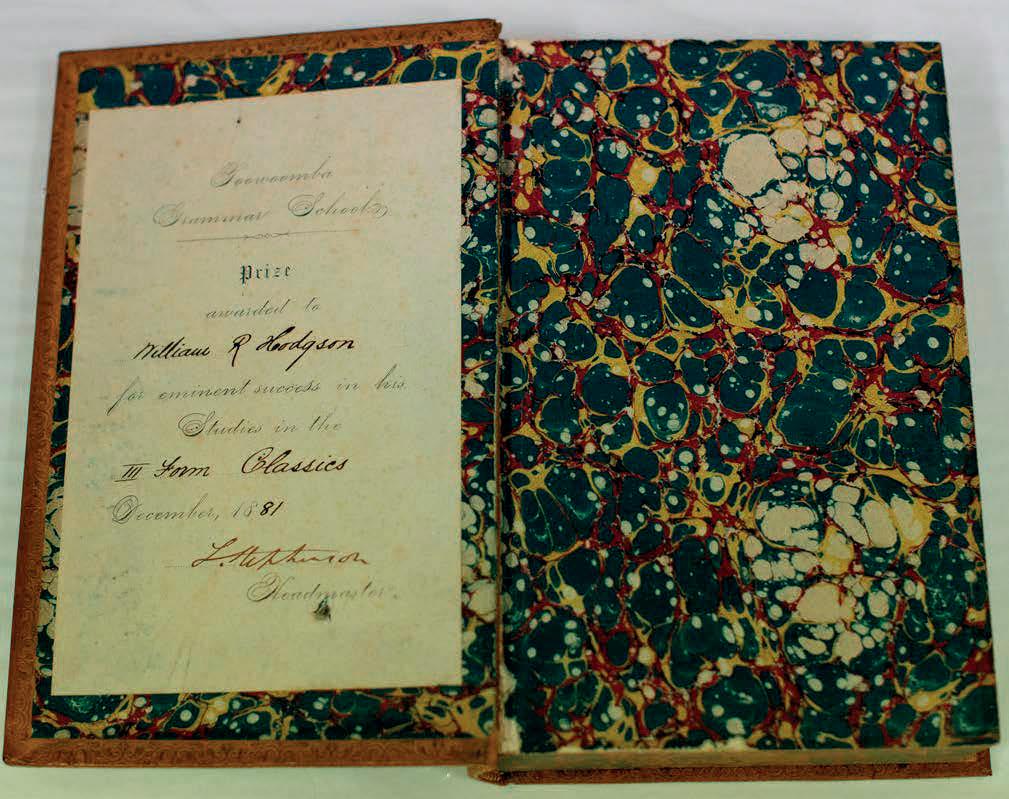
Chairman of the Board of Trustees: The Hon. James Taylor, MLC (in his 9th year) resigned as Chairman and was succeeded by the Hon. Francis T. Gregory, MLC.
Trustees: The Hon. Patrick Perkins’ position was declared vacant due to a lack of attendance. At the end of the year the composition of the Board of Trustees was: The Hon. Francis T. Gregory, MLC (Chairman); Hugh M. Nelson; Robert Aland, MLA; Caleb R. Woodward; Frederick H. Holberton and Edward D. Hodgson.
Headmaster: Mr Lawrence Stephenson was the Headmaster of the School until September. In October, a new Headmaster, new staff and a new Chairman of the Board of Trustees commenced. The third Headmaster of Toowoomba Grammar School who commenced in November was Mr Alfred Mortimer Nesbitt, from England. Mr Nes bitt had a Master of Arts from The University of Oxford and was later a Mathematical Master at Manchester Grammar School. In addition to being a scholar, Mr Nesbitt was known to be a musician and he excelled in cricket. He resigned from TGS after seven years and, in Easter of 1888, he moved to Melbourne. A photograph of Headmaster Nesbitt is included in this year’s entry.
Second Master: Mr Nesbitt’s Second Master was Mr Thomas Ledward Junior, from Owens College, Manchester, England and the Third Master was to be the Modern Languages Master, Mr Duncan Struan Robertson, Trinity College, Dublin. A Military Drill and Gymnastics Instructor, Sgt Walter Freeman, commenced some time later, towards the end of 1884. These appointments were for a three -year term.
Total School Enrolment: 34 (enrolments had fallen from 60 in 1879 to 34 this year) and in the final quarter (term) of the year enrolments had fallen to 25 (one boarder and 24 dayboys).
Number of Dayboys: 29
Number of Boarders: 5
Staffing:
• The School’s Undermaster, Mr Fraser, resigned and was not replaced.
• The outgoing Headmaster, Mr Stephenson, departed the School on 28 September which was days earlier than the Trustees had expected.
Students:
• Henry ‘Harry’ G. Chauvel (1880-82) became the famous leader of the First Australian Light Horse Brigade (Commanding General at the Battle of Beersheba in October 1917) and l ater Chief of the Australian General Staff. He was the first Australian to reach the rank of General. In a tribute to General Sir Henry ‘Harry’ Chauvel upon his death, the Prime Minister of Australia, Mr Curtin, said of him: “Sir ‘Harry’ Chauvel was one of the foremost military minds of his generation”. Sir Harry is acknowledged on the Old Boys’ Wall of Achievement. (see the 1880 entry and also below in this 1882 entry and 1955).
Events:
• In February the Board of Trustees decided to send to Great Britain for a Headmaster with instructions to engage two undermasters to come out with him.
• Chaos reigned when the Headmaster left prior to the conclusion of his official duties. Apparently he had sent the boarders home early.
• Mr Charles Chauvel, a squatter from Tabulam NSW, had previously had his sons attending Sydney Grammar School where Mr Lawrence Stephenson had taught. When Mr Stephenson took up his Headmastership at Toowoomba Grammar School, the Chauvel brothers followed so that they could be closer to home. Eventually in the middle of the last quarter of 1882 the two boys (Harry and Allan) were withdrawn by Mr Chauvel after the Headmaster had sent them home because he himself was departing the School. Apparently he had not adequately advised Mr Chauvel of his sending the boys home early.
Co-curricular Activities:
• In Cricket, there was no record of any match played against either BGS or IGS this year.
• At the Distribution of Prizes on 25th February, the Headmaster, Mr Stephenson, stated: “Last year I had to complain of the difficulty we had in getting boys to practise cricket after school. Those who wished to play were frequently unable to do so, as they could not persuade enough boys to stay to get up a game. It was no uncommon thing when I offered the alternative of detention-drill or cricket, for several to choose the former. I have been much pleased to see a marked change in this during the present season, there being often so many present that there was hardly time for all to have their inning. I am quite aware that parents do not send their boys to school to learn to play cricket or football; but at the same time, I am convinced that the boy who has been trained in a well-ordered eleven or fifteen has not only derived benefit from wholesome and regular bodily exercise, but has also learnt, on a small stage, to appreciate the power which exists in order and discipline, but this lesson will not be lost on him in after (school) life, but will tend to make him a better and more useful member of society.”
The Distribution of Prizes Day Guest Speaker : His Excellency The Governor, Sir Arthur Kennedy
The Distribution of Prizes ceremony took place on a Saturday afternoon in late February. The Headmaster, Mr Stephenson, read his Annual Report (reporting on the previous year) to the assembled audience in what is now known as Old Hall. Mr Stephenson commen ced his address with the following words: “Your Excellency, Ladies and Gentlemen – You are probably aware that this is the last distribution of prizes at which I shall have the opportunity of addressing you (as I have received notice to leave in October) and in so doing, I shall be compelled to allude to my dismissal by the Trustees of the School. Last April I received a letter from them stating that ‘the general results of the school were unsatisfactory and that I should have notice to leave at the end of the half-year’. This action of theirs appeared strangely inconsistent with the statement made by their spokesman at the last distribution when he said that ‘judging from the results of the last year’s labours, he thought the school had been pretty successf ul.’’. Mr Stephenson continued at length to indicate that the decision made by the Trustees to terminate his employment was unfair.
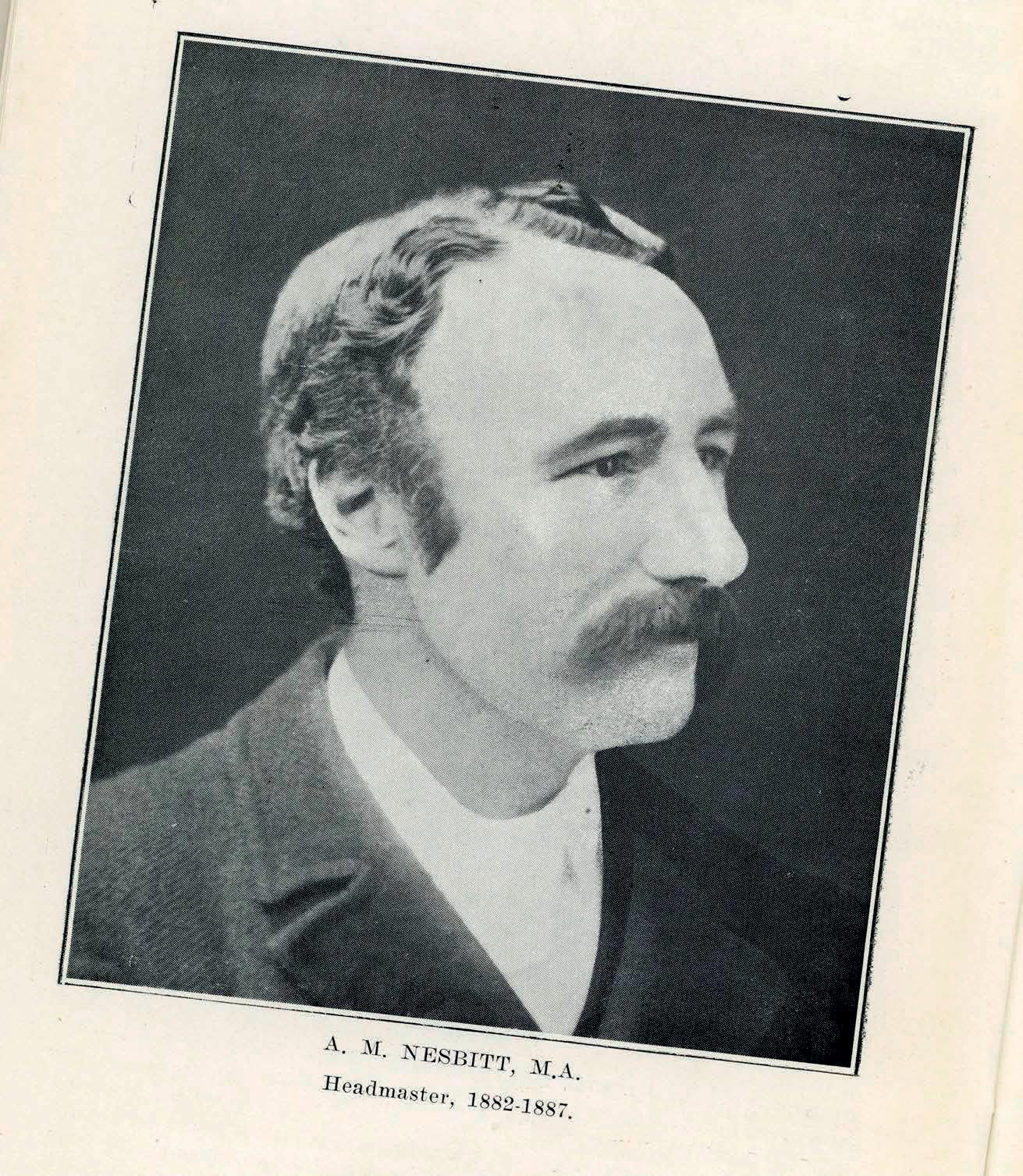
Chairman of the Board of Trustees: The Hon F.T. Gregory, MLC succeeded The Hon. James Taylor , MLC. Mr Gregory was Chairman for two years.
Headmaster: Mr Alfred M. Nesbitt (in virtually his 1st year)
Second Master: Mr Thomas Ledward Jnr (in his 1st year)
Total School Enrolment: 48
Number of Dayboys: 35
Number of Boarders: 13
Students:
• Littleton E. Groom (1879 -1883) was to become the first Federal Member for Darling Downs, the Commonwealth Attorney-General (1906), the Speaker of the House of Representatives (19261929) and the Chairman of the inaugural League of Nations Committee in 1924. The Honourable Sir Littleton Groom is acknowledged on the Old Boys’ Wall of Achievement. The Groom family name has been perpetuated at the School in the form of “Groom House”. Sir Littleton’s father was William Henry Groom, the member for the Darling Downs in the first Federal Parliament when he died almost immediately and his son Littleton won in a by-election At school Littleton Groom was captain of both the Cricket and the Football (Australian Rules) teams for th ree successive years - in 1883 whilst as a student and in 1884 and 1885 as an ‘Old Boy’. He also excelled in gymnastics and was an outstanding athlete. (See 1879, 1905 and 1936).
• Littleton Groom was one of eight children and his two brothers also attended the School. His father, William Henry Groom, was born in England and began his life in Australia as a convict. At the age of thirteen years and as an apprentice, William was convicted of stealing and sentenced to seven years’ penal servitude, which he began at Pentonville Gaol, London. In 1849 William was transported to New South Wales by the notorious ship Hashemy, the first convict vessel to reach Sydney after the revival of transportation which had been halted in 1840. Groom was conditionally pardoned in October. William Groom was later elected as Toowoomba’s first Mayor in January 1861 and a representative of Drayton and Toowoomba in the Legislative Assembly in 1862. In 1876 he used his influence in securing a substantial government loan for the establishment of the School, a sum of 2,000 pounds. Mr Groom later held the office of Mayor five times. To this day, the School presents the W.H. Groom Memorial Prize for Maxima Cum Laude in Year 9 at the annual Speech Day and Prize Giving Ceremony. This Prize is also named after Mr Charles Stumm (see 1878) and Dr Fred Trenerry (see 1952). Mr Groom’s three sons attended Toowoomba Grammar School –Frederick William (1877), Littleton Ernest (1879 -1885) and William Henry (1883 -1887) A more detailed reference to Littleton Groom is noted in the 1879 entry.
• In 1883 William Richard Hodgson won a Gold Medal for the highest position in the Junior Examination for Sydney University. This medal was presented to William Hodgson by Mrs Kent an d
it is now housed in the School Museum (also see 1885). Also in the School Museum is a Prize Book awarded to William for his studies in English in Form III. In the front page of this beautifully bound book, Sword and Pen (English Worthies in the Reign of Elizabeth), author W.H. Davenport Adams, are the hand-written words “Toowoomba Grammar School, Form III Prize for English, Awarded to William Hodgson, A.M. Nesbitt M.A., Headmaster, Christmas 1883”. Of interest, also housed in the School Museum are Prize Books awarded to successive generations of the Hodgson family – Russell William Hodgson (1915-1918) a general prize in Form III signed by Chairman Reginald Freshney and visitor Littleton E. Groom, dated December 10 1915; a Prize Book awarded to Christopher Russell Hodgson (1946-1950) for being a Prefect and signed by Headmaster R. Mills, Visitor J. Hill and Chairman Leslie Boyce in November 1950; and a Prize Book to William Richard Hodgson’s greatgrandson, Richard Hodgson (1979 -1983) for Best Senior Certificate (the Sir Littleton Groom Memorial Prize) dated 24 November 1983 signed by Headmaster Dent and the Chairman B. (Ian) Parkinson. A photograph of some of the TGS Prize Books awarded to members of the Hodgson family is included in the 1949-year entry.
Events:
• In this year the School requested the supply of some short Snider rifles for the formation of a Cadet Corps. The Cadet Corps was not established until later.
• A School Magazine was published in October. The Toowoomba Chronicle on 9 October considered the magazine as being disappointing on the whole, “disclosing evidence that the boys themselves did not take as much interest in its production as they ought” The magazine did not appear again until 1904.
Co-curricular Activities:
• In Australian Rules Football , a School sports team playing this game (nowadays ‘Aussie Rules’) visited Brisbane but was beaten seven goals to nil.
• In Cricket, on 15 December, Toowoomba Grammar School played cricket against a side representing Brisbane Grammar School at the Aubigny Cricket Club Ground in Toowoomba. The match was won by BGS by three wickets. In the second innings, the highest score for a Toowoomba Grammar School batsman was eight runs with six ‘ducks’ also being recorded by the TGS team. The TGS side was captained by William Hodgson.
• In Cadets, the earliest mention of Cadets at TGS was when, at the beginning of this year, the Secretary wrote to the Department of Public Instruction for some short Snider rifles for the formation of a Cadet Corps at the School. No records appear to exist of the outcome of that request of whether a Unit was formed (see 1892).
Distribution of Prizes Day Guest Speaker: Mr Alfred M. Nesbitt, Headmaster, substituting for His Excellency The Governor, Sir Anthony Musgrave
Chairman of the Board of Trustees: The Hon. Francis T. Gregory, MLC, in his second year, resigned and his place was taken by the Hon. George King, MLC.
Headmaster: Mr Alfred M. Nesbitt (in his 2nd year)
Second Master: Mr Thomas Ledward Jnr (in his 2nd year)
Total School Enrolment: 41
Number of Dayboys: 32
Number of Boarders: 9
Students:
• G. W. (William) Pechey (1883-1884) was later to join the School’s Board of Trustees in 1911.
• Frank A. Robinson (1879-1886) in the year 1884 performed admirably in his studies in the Sydne y University exams. These examinations for students at TGS were set by Sydney University as The University of Queensland was not founded until 1909. Frank’s performance in this examination prompted the Headmaster, Mr Nesbitt, to award a School Prize book to him. The book was titled The Old Red Sandstone written by Hugh Miller. Upon opening the front cover of the book, one can see a certificate stating, “Awarded to Toowoomba Grammarian, Frank A. Robinson for eminent success in his studies in the Sydney University exams” and is signed A.M. Nesbitt, Headmaster and is dated December 1884. Frank Robinson’s School Prize Book 1884 is in very good condition and is in the Headmaster’s bookshelf in his study. Frank Robinson became an Inspector with the Bank of New South Wales and he wrote a detailed account of his schooldays in the Jubilee edition of the Toowoomba Grammar School Magazine published in November 1926 , pp.18-22. In his account of his schooldays he wrote that up to the time he left the School in 1886, the football played was the Australian (Victorian) code and the Rugby Union game was only introduced into the State about that date. Frank referred to playing Ipswich and Brisbane Grammar Schools in cricket and football once a year. Back to Frank Robinson’s Prize Book outlining the geological features and discoveries in Great Britain, in Chapter One the author, although writing so long ago, gives advice that has immediate relevance to all of the current boys at Toowoomba Grammar School and its young Old Boys. The author, Hugh Miller, wrote: “My advice to young working men desirous of bettering their circumstances, and adding to the amount of their enjoyment, is a very simple one. Do not seek happiness in what is misnamed pleasure; seek it rather in what is termed study. Keep your consciences clear, your curiosity fresh, and embrace every opportunity of cultivating your minds.”
Events:
• 1884 was a drought year and water from the School’s well dried up.
• In a report on the NSW Football Association (Australian Rules) organising a tour to Queensland in 1884, reference was made to a visit to Toowoomba <NSW Football history.com.au>. Travel to Brisbane from Sydney was by steamer and the trip from Brisbane to Toowoomba for the team was by rail. The Government set aside a special carriage for the visiting team and the journey was reported to have taken six hours! The Australian football game was played on the Aubigny Cricket Club ground.
Co-curricular Activities:
• In Athletics, the 23 sporting events held on the Toowoomba Grammar School Sports Day were handicapped events. For example, in the one mile ‘walking match’, C. Boland was on ‘scratch’, L. Groom 40 yards, W. Marks 50 yards etc. J. Campbell and C. Woodward had the most generous handicap of 90 yards.
• In Cricket, the fifth ever cricket match between TGS and Brisbane Grammar School was played in Toowoomba at the Aubigny Cricket Club ground in December. The TGS side, captained by Littleton Groom (then an ‘Old Boy’ as he left the School in the previous year), was defeated by s even wickets. The visiting BGS side was entertained at a luncheon at the Royal Hotel and at dinner at the School. On the following day a lawn tennis match was played which was won by the local team.
• In Music, a concert, the Toy Symphony, was performed.
The Distribution of Prizes Day Guest Speaker : Mr E. Robert Aland, Prominent Toowoomba Businessman and Member of the TGS Board of Trustees (1877 – 1883)
Chairman of the Board of Trustees: The Hon. George King, MLC who remained as Chairman of the Board for five years.
Headmaster: Mr Alfred M. Nesbitt (in his 3rd year)
Second Master: Mr Thomas Ledward Jnr (in his 3rd year)
Total School Enrolment: 44
Number of Dayboys: 36
Number of Boarders: 8
Students:
• Cecil H. Foott (TGS 1885) was later to become Brigadier -General Cecil H. Foott, ADC (aide-decamp) to King George V from 1927 -1931. Previously he was the ADC to the Governor -General from 1921-1924. He was initially a mechanical engineer and was transferred to the Royal Australian Engineers. After the Armistice, Cecil Foote became the Deputy Director of the A.I.F. (Australian Imperial Force) Department of Repatriation and Demobilisation in London. Sir John Monash served as its Director General. The Brigadier -General was the Guest Speaker at the School’s Speech Day and Prize-Giving Ceremony in 1927 and is honoured on the Old Boys’ Wall of Achievement.
• Another student to be later honoured on the Old Boys’ Wall of Achievement was Leonard Avery Grimes (1880-1885). Leonard was later to use the surname Avery. Major Avery served with Sir ‘Harry’ Chauvel during World War I in the desert as the Medical Officer of an English Regiment. After the war he led the flamboyant life of an adventurer, medico, soldier, inventor ( he designed the World War I Rapid Transit Galloping Ambulance), big-game hunter, polo player, photographer and explorer. He was a member of the British Museum Expedition to the Belgian Congo in 1930. A copy of a speech delivered by Dr Avery to the Newcastle Businessmen’s Club was printed in the School Magazine of November 1940 (pp.3-4). Dr Avery spoke to the audience about joining a British Museum Expedition to the centre of Africa and to the wild and savage districts of the Belgian Congo. The trip involved travelling by train, car, canoe and on foot in a remarkable journey. Leonard Avery’s design of the ‘Rapid Transit Galloping Ambulance’ was featured in a painting of the Charge of the Light Horse at Beersheba during World War One. The artist of this painting was Tom McAulay and a photograph of this painting with Avery’s ‘Rapid Transit Galloping Ambulance’ in the background with the flag is included in this year’s entry. For more information on the Charge of the Light Horse at Beersheba and its link to Toowoomba Grammar School refer to the 1917-year entry.
• A third student is represented on the Old Boys’ Wall of Achievement from this year. Sidney W. Jackson (1885) became a professional naturalist of international standing, noted for his Jacksonian zoological collection.
• Finally, from the total school enrolment of 44 boys in this year, another boy was acknowledged on the Old Boys’ Wall of Achievement. Henry J. Marks (1883 -1885) became an inventor and his ingenious devices were used worldwide as components of railway rolling stock and building construction.
• The School Museum holds a beautiful gold medallion dated 1885. On it are inscribed the words “For Best Junior Exam, Sydney University, Presented by Mrs Kent” Inscribed on the reverse side of the medallion is an etching of Toowoomba Grammar School and the Latin words “qui non proficit deficit” (a Latin proverb translated as “He who does not go forward, loses ground”). Surrounding the medallion is the date 1885 and the Toowoomba Grammar School student’ s name, Thomas D. Fraser (Thomas Fraser commenced at the School in 1882). A photograph of Thomas Fraser’s medallion is included in this year’s entry. A similar medallion is also on display in the School Museum, dated 1883, awarded to Toowoomba Grammarian William R. Hodgson.
• Henry ‘Harry’ E. Barlow (1879-1885) was to later represent Queensland in cricket against New South Wales in 1890. On the opposing team was George Pitty Barbo ur who, in 1910, was to become Headmaster of Toowoomba Grammar School.
• Three TGS Old Boys fought in the Sudan War.
Co-curricular Activities:
• In Cricket, the sixth cricket game ever between TGS and Brisbane Grammar School took place in December and was played in Toowoomba. The Captain was a young ‘Old Boy’ Littleton Groom and the BGS side was successful, winning by 34 runs. A return cricket match was played two days later and it was agreed by BGS for the TGS Headmaster to also play.
• In Tennis, probably the first Tennis inter-school match played by Toowoomba Grammar School was in this year, against Brisbane Grammar School and won by TGS, 12 sets to 4. The tennis match was played in Toowoomba and followed the inter-school cricket match.
• In Music/Drama, the Grammar School Concert in the ‘Assembly Rooms’ (now referred to as Old Hall) held in December was a great success. Various performances were made by adults. The local newspaper on 19 December 1885 referred to the vocal performance of the boys: “In the Policeman’s Chorus from the ‘Pirates of Penzance’, the Grammar School boys one and all did admirably well. Dressed appropriately in uniform with head erect and arms at side, they performed their evolutions in a manner that drew forth loud and repeated bursts of applause. Not content with one encore, the audience demanded yet another, and this too was loudly applauded. Later, the boys sang the old Latin greeting to the holidays ‘Gandeamus Igitur ’ and God Save The Queen.”
The Distribution of Prizes Day Guest Speaker: The Honourable George King, MLC, Chairman of the Board of Trustees (1885-1889)
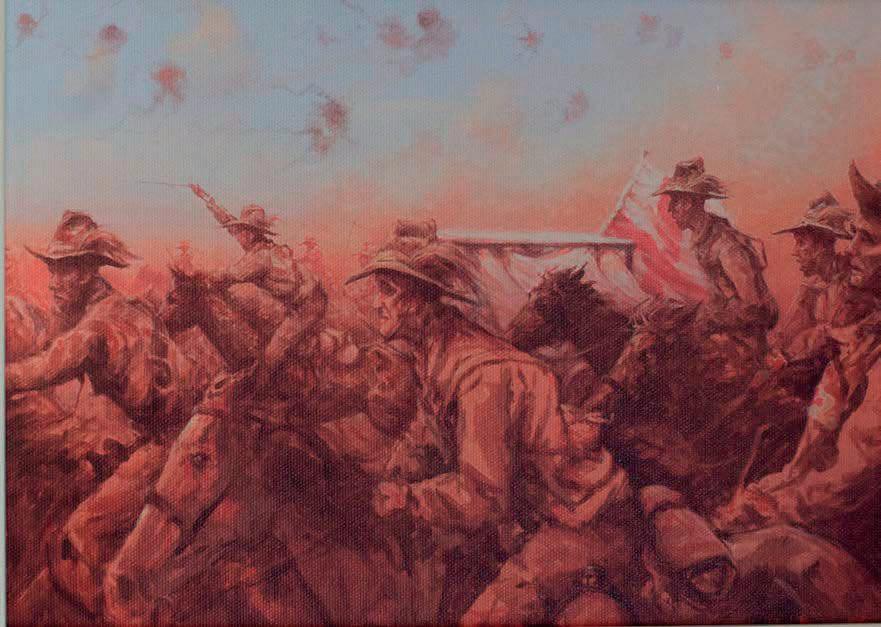
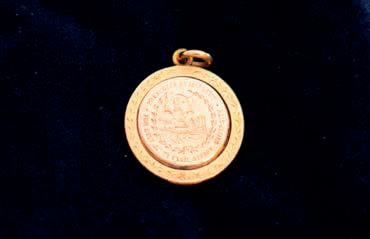

Chairman of the Board of Trustees: The Hon. George King, MLC (in his 2nd year)
Headmaster: Mr Alfred M. Nesbitt (in his 4th year)
Second Master: Mr Thomas Ledward (in his 4th year)
Total School Enrolment: 44
Number of Dayboys: 33
Number of Boarders: 11
Staffing:
Mr D.H. Beegling, as a Master of the School, was in 1906 a qualified Doctor. Dr Beegling was practising his profession in Sydney.
Students:
• Bertram C. Hume (1882 and then 1884-1888), whose father was Walter Hume (Land Commissioner in Toowoomba) after whom Hume Street in Toowoomba was named, recalled this year when writing to the Editor of the School Magazine in 1940. Bertram Hume referred to: “My most treasured trophy is a silver cup, won by me in the Hibernian Sports about the year 1886. The course was the whole length of Ruthven Street, the only macadamised street in those days, and the mount was a 54 inch bicycle, then a newly-invented machine.”
• Bertram Hume spent many years in Buenos Aires with his Contracting Engineering company. The firm executed a great deal of construction work in the Argentine, Uruguay and Chile having constructed more than 600 miles of railways as well as a number of factories, wharves etc.
Co-curricular Activities:
• In Athletics, a School Sports Meeting was held this year and the public had to pay one shilling to enter the grounds and sixpence for the programme. A rule in the programme stated: “Boys of the School not paying three shillings for entries will pay sixpence to come onto t he ground.”
• In Cricket, following the 1885 game, no further cricket games against Brisbane Grammar took place until 1911. There appears to be no explanation available as to why there was this gap of 25 years before cricket games recommenced between the two schools.
The Distribution of Prizes Day Guest Speaker : Mr William H. Groom , MLA – Speaker QLD Legislative Assembly
Chairman of the Board of Trustees: The Hon. George King, MLC (in his 3rd year)
Headmaster: Mr Alfred M. Nesbitt (in his 5th year) submitted his resignation at the end of the year.
Second Master: Mr Thomas Ledward resigned early this year to return to England.
Total School Enrolment: 40
Number of Dayboys: 31
Number of Boarders: 9
Staff:
• Regarding the resigning Headmaster Nesbitt, TGS Old Boy Sir Littleton Groom wrote in 1926 in his reminiscences that “after leaving the School, Mr Nesbitt moved to Melbourne where he became a noted Press critic, until his death a few years ago. Many of us owe much to his uplifting influence. He was a scholar, a musician and he excelled in Cricket.” (Source – TGS Magazine, Jubilee Number, Vol.XVI, November 1926, No.2, page 17)
Students:
• Acknowledged on the Old Boys’ Wall of Achievement is John (Gerard) R. Boyce (1880-1887). Gerard was to become an internationally acclaimed magician under the stage name of Jean Hugard. He was the School’s 125th pupil to be enrolled in the School (in 1880). Gerard died in New York in 1958. A great-great grandson of Gerard Boyce, Thomas Colin Boyce, commenced at the School in 2004 representing a fifth-generation association with TGS.
• John ‘Jack’ Blackstock (1884-1887) was to play cricket for Queensland in 1896-1897.
• Bernie J. Beirne (1887) had conferred upon him the honour of being appointed Mayor of Toowoomba in 1905. He continued his professional career as a solicitor.
Events:
• The Headmaster faced major financial constraints restricting the initiative he sought to display. The Trustees were faced with a demand from their bank to reduce the School’s overdraft. All employees were asked to accept a reduction in salary.
• On 31 October, the Trustees decided to advertise throughout the colonies for the School’s fourth Headmaster. Insertions were subsequently placed in the Sydney, Melbourne and Brisbane daily newspapers as well as the Queenslander, the Town and Country Journal and The Australian. By mid-December, 23 formal applications for the position had been received.
• In 2017 the School’s Board of Trustees decided to name an annex room by Corfe House in memory of Headmaster Nesbitt.
Co-curricular Activities:
• In Athletics, the Grammar School Sports were held in the Caledonian Sports Ground (on the site now known as Queens Park, Toowoomba) on a Saturday afternoon in May. More unusual events included the one-mile amateur bicycle race, pole vaulting, a manx race, a consolation race, and a ‘tug-of-war’. The local newspaper on 16 May, 1887, reported on the Sports Day and referred to the tug-of-war event as follows: “The tug-of-war afforded great amusement to the young contestants who from their remarks had evidently formed a high conception regarding the qualities of the cake given to the victors.”
• In Australian Rules Football, at least four games of Australian Rules Football were played against Brisbane Grammar School up to this time.
• In Cricket, the 1st XI side played IGS at the Toowoomba Cricket Club Ground on Saturday, 2nd April. This was only the second cricket match between the two schools in ten years, the first game being played in 1877. The Toowoomba Chronicle and Darling Downs General Advertiser gave a thorough written account of the match. In the first innings TGS scored 59 runs and IGS 29. The TGS bowler George Dight took six IGS wickets in the first innings and a further seven wickets in the second innings. His bowling figure for both innings was 13 wickets for 30 runs. According to the research conducted by the author of the two-volume set of the History of Toowoomba Grammar School Cricket, Mr Ivan Board, Dight’s bowling figures in this match represented the second greatest bowling match haul in the 144 years of TGS cricket history recorded in Ivan Board’s book.
• In Rugby Union, in 1887 the boys of Brisbane Grammar School voted for Rugby Union to be the football code and Toowoomba Grammar School followed this decision. The first recorded win by TGS in Rugby against BGS was in 1920.
• The first recorded Rugby Union match was against Brisbane Grammar School in this year. Toowoomba Grammar School lost by 21 points (0 – 21). Prior to this time the Queensland Grammar Schools were playing Australian Rules Football.
• In Music/Drama, a concert open to the public occurred this year and was promoted by the Headmaster. The concert included ‘Mr Wilson’s Experiment’ and Act IV of Sheridan’s ‘The Scheming Lieutenant’. The next public concert held by the School took place in June 1904 in aid of the School Library Fund.
The Distribution of Prizes Day Guest Speaker: Mr William H. Groom, MLA – Speaker QLD Legislative Assembly
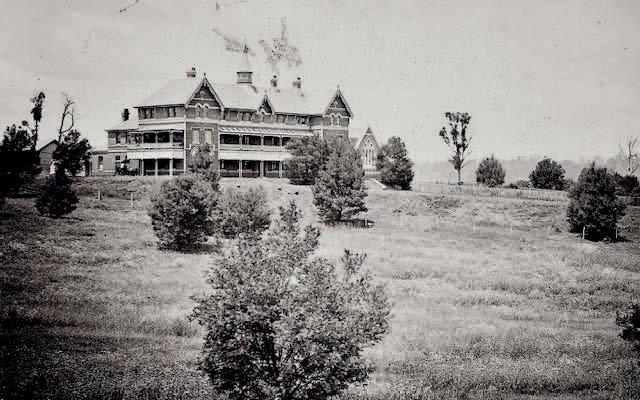
Chairman of the Board of Trustees: The Hon George King, MLC (in his 4th year)
Headmaster: Headmaster Nesbitt and one of his undermasters resigned in March. Mr William Alexander Jenyns Boyd (born in Paris, France) commenced duties as the School’s fourth Headmaster in April 1888. Mr Boyd was successful from a field of 23 formal applications being received. He was a flamboyant adventurer and had been educated in England, Germany, Switzerland and France at the Lycée de Versailles where he was the first prize -man in French Literature St Germain. Mr Boyd sailed the world before migrating to Queensland in 1862. He was appointed as the first Headmaster of the West Oxley State School in 1867, became the Occasional District Inspector and Promoter of New Schools, and later founded the Eton Preparatory School at Milton specifically to prepare boys for entrance into Brisbane Grammar School.
Total School Enrolment: 30
Number of Dayboys: 26
Number of Boarders: 4
Staffing:
Upon arrival to commence duties, the new Headmaster, Mr Boyd, confirmed with the Trustees the continuing services of undermasters Mr Yarker and Dr Schultze who were already teaching at the School. He also gained approval for the appointment of Mr Baxendell whom he had brought with him from his Eton School.
Students:
• Edwin J. Godsall (1886–1888) was elected as Mayor of Toowoomba in 1906. His predecessor was also an Old Boy (see 1887).
• Dugald M. Graham (1885–1888) was one of 62 TGS Old Boys who lost their life in World War One. His courage is typical of those Old Boys who fought for their country, many paying the ultimate sacrifice. One of Major Graham’s men wrote: “We had the misfortune to lose our Commanding Officer, Major Graham. He died a hero’s death and if ever a man earned the VC he did that awful night. He had carried in four of his men under a murderous fire and was going out again for a fifth when he was shot.” (Source – The Toowoomba Grammar School Magazine, November 1915, page 22). The Major Lockwood Graham Memorial Prize (together with the Dr Charles Richard Mills Woodward) for the subject Science in Practice is presented each year at the School’s Speech Day and Prize Giving Ceremony.
• The School Magazine of 1905 congratulated an Old Boy, Mr Walter Trevethan (1887 -1888), who had just turned out of his factory a 10HP motor car, this being the first manufactured in Queensland and one of the very few built to this date in Australia (see the ‘Events’ section in the 1902 entry).
Events:
• The new Headmaster, Mr Boyd, wrote to the Trustees asking whether the boarders should we ar mortar boards and an Eton suit.
• Mr Boyd approached the Trustees for the approval of a School Crest. During the year cricket fixtures were played against Ipswich Grammar School and there was the introduction of batteryoperated electric bells, the construction of a tennis court and the laying of an asphalt cricket pitch.
• In this year there was a custom of allowing members of the press to be present at Trustees’ meetings. This was rescinded in 1890 when the Trustees agreed not to allow the press to attend meetings; rather, only to give the press a report of proceedings as long as it was not detrimental to the interests of the School. This resulted in an immediate outcry from the press, with The Toowoomba Chronicle of 29 April 1890 accusing the Trustees of forming part of a “stiff-necked generation” assuming “a high and mighty tone”.
• Headmaster Boyd wrote to the Trustees requesting a new garden fence as “the cows and horses carry off the linen from the lines”.
• A small prospectus for the School was prepared and under a sub-heading Toowoomba By Railway it was written: “Is distant about 100 miles from Brisbane and can thence be reached in six hours. It also has railway communication with Sydney and the Western towns of Queensland.”
• On Saturday evening, 29 December, 25 Old Boys of the School met at Long’s Imperial Hotel to form a new society – the Toowoomba Grammar School Old Boys’ Association. The first President was Joseph Vincent Herbert who relinquished the role two years later. The Association appeared to cease for approximately a decade and then was reformed in March 1901.
• In this year Townsville Grammar School was established, initially as an all -boys’ school but becoming co-educational in 1893.
Co-curricular Activities:
• In Cricket, an invitation was extended to the 1 st XI cricket team of Ipswich Grammar School including overnight accommodation. The game was played in Toowoomba on 28 April and was won by IGS by eleven runs. A return cricket game between TGS and IGS was played on 17 November and was won by IGS by 50 runs.
• The Trustees were criticised for putting money into a cricket pitch instead of an urgently needed Chemistry laboratory.
• The Headmaster, Mr Boyd, was quoted in the Annual Prizes Distribution ceremony as stating: “As to cricket and football, the boys labour under the great disadvantage of having no proper grounds. A sum of money has, however, been voted by the Trustees to provide a suitable cricket ground. An excellent double court for lawn tennis has been made near the School, and it will be ready for play next season. Several cricket and football matches have been played during the year, unfortunately not often in favour of the School, notwithstanding the energy and determination of the boys. This result I attribute greatly to the want of properly laid out grounds. Two cricket matches were played against the Ipswich Grammar School, one at Toowoomba, the other at Ipswich. Both these were lost; but the loss is in a measure counterbalanced by the ‘entente cordiale’ existing between the two schools. A match against the Pittsworth Club was also lost, but this defeat was retrieved by a win against Toowoomba West. The second and third elevens have scored many successes against town clubs.”
• In Rugby Union, a Rugby team representing Brisbane Grammar School visited Toowoomba and defeated us by 32 points.
President of the Old Boys’ Association: Mr Joseph V. Herbert (for two years)
The Distribution of Prizes Day Guest Speaker : Mr William A.J. Boyd, Headmaster
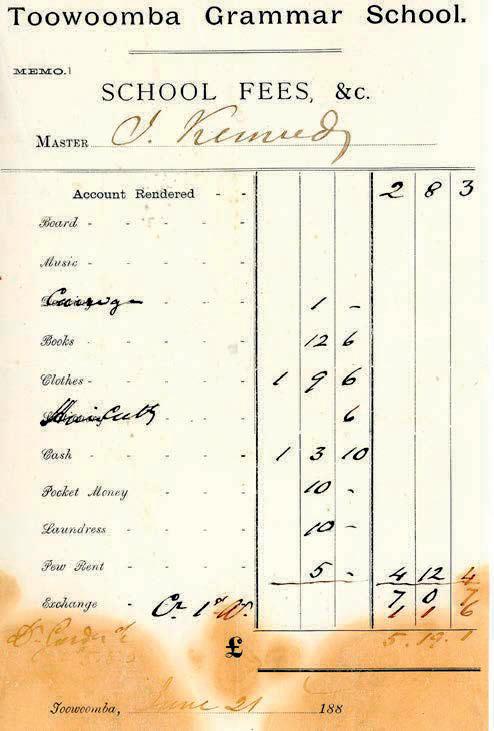
School Fees


Tuition & Boarding Fees
Chairman of the Board of Trustees: The Hon. George King, MLC (in his 5th year) resigned in July and was succeeded by Mr Robert Aland, MLA (who remained Chairman of the Board of Trustees for sixteen years, until 1904).
Trustees: Mr Robert Aland, MLA (Chairman); Mr John L. Graham; Mr Richard W. Scholefield; Mr Gilbert G. Cory; Mr John A. Boyce; the Hon. Frederick H. Holberton, MLC; Mr Henry V. King and Mr Samuel G. Stephens (as Board Secretary)
Headmaster: Mr William A.J. Boyd (in his 2nd year). During his Headmastership, Mr Boyd published a book The Earth’s History for Boys or Geology in Verse as a practical aid to boys trying to memorise geological lore. A copy of Mr Boyd’s book is housed in the School’s Museum.
Total School Enrolment: 70
Number of Dayboys: 39
Number of Boarders: 31
Students:
• Student Egerton Charles Mills enrolled in 1889, captained both the 1 st XI Cricket and the 1st XV Rugby. He served in the Boer War and World War One and later became a big game hunter and gold miner.
• Student Alexander Armstrong Campbell passed away at the School with his mother and father at his bedside at 11:00pm on Monday, 2nd September 1889 after contracting Typhoid Fever.
• Of the 12 Queensland schools who had prepared candidates for either the 1889 Junior and Senior (or both) Examinations of the Sydney University, Toowoomba Grammar School had recorded the third highest number of passes.
The following was written in a statement of curriculum offerings by the School dated January 1889.The original document is housed in the School’s Museum and a photograph of this document is included in this year’s entry. The document reads: “ The course of instruction shall be selected from the following subjects:
• The English, Latin, Greek, French and German Languages
• Pure and Mixed Mathematics
• History
• Geography – Political, Physical, and Commercial
• Drawing (Elementary)
• Elocution
• Writing and Book-keeping
• Chemistry and Experimental Physics
• Elementary Physiology
• Geology
• Drill and Gymnastics”
The document continued by stating: “When a boy has passed th e Second Form, he may join the ‘Modern School’ in which the Classics are omitted.”
Events:
• During the year Mr Boyd received some negative publicity from The Toowoomba Chronicle and some dissatisfaction simmered among some of the parents.
• In August the Headmaster reported to the Board that a boy had contracted Typhoid Fever. Six boarders decided to return home. Tragically one boy, Alexander Campbell died on 2 September. In August, prior to Alexander’s passing, following inspections at the School by doctors and health authorities, the Trustees acted promptly to implement all of the recommendations lis ted in their report. The pump at the well was locked so that the water from that source could not be used. New pipes, sinks, drains and closets were provided and everything was disinfected with chloride of lime and carbolic acid.
• The tuition fees, payable quarterly in advance, were four pounds and four shillings per quarter for each boy over 12 years and three pounds and three shillings per quarter for each boy under 12 years. Music tuition was an extra two pounds and two shillings and boarding fees were el even pounds and eleven shillings.
• In the local newspaper on 21 September, 1889 was an article describing the grounds of Toowoomba Grammar School. The article, in part, stated: “Since the advent of spring time with its genial warmth and refreshing showers, the grounds at our Grammar School present a most charming appearance, pleasing alike to the eye and to the olfactory sense. The first thing that strikes the visitor is the park -like appearance of the surroundings. The fresh green vista dotted here and there with clumps of fragrant wattle, amongst which the boys’ ponies may be seen grazing in lazy contentment, affords a pleasant landscape not often to be seen amidst the arid surroundings of the metropolis. A broad walkabout avenue winds its way from the pretty little lodging to the school building. Previously about half an acre of garden was devoted to an ill-cared for crop of lucerne and sorghum. In place of the sorghum field a tastefully laid out garden, intersected by numerous grass walks, presents its beauties to the eye. The summer house has been restored and creepers are gradually enclosing it. One of the main features of this structure is a magnificent orchid in profuse bloom…. The garden at the caretaker’s lodge is kept in excellent order as a vegetable, fruit and flower garden and, as a consequence, cabbages, cauliflowers and a variety of vegetables have abounded. Nectarines, almonds, walnuts and peaches are amongst the fruit-bearing trees. The whole of this work has been done by the lodgekeeper who deserves much praise for the order and neatness everywhere visible.”
• The Gatekeeper’s Lodge (1876-1901) referred to above was destroyed by fire in 1901.
• At this time, the proceedings of the School’s monthly meetings of the Board of Trustees w ere reported in the local newspaper. In The Toowoomba Chronicle and Queensland Advertiser on Monday, March 31 1890 a report of the monthly Board of Trustees meeting was included. The Board of Trustees meeting was held in the Court House on Saturday at 11:30am. A letter written
by the Headmaster, Mr Boyd, to the Trustees was read out at the meeting, with the letter complaining that pieces of the ceiling kept dropping down, several of t he rooms were drenched, and the staircase and walls dripping. Another matter discussed at the Board of Trustees meeting was the arrangement for the replacement of the lodge-keeper who was to leave at the same time as the Headmaster. Mr Scholefield, a Trustee, said that as it was necessary to economise, he thought the Trustees should make the lodge-keeper’s wages 75 pounds in the future.
• The Headmaster wrote to the Trustees advising of the extremely poor condition of the School’s piano, stating that it was impossible for the Music teacher to give instruction with it. The Trustees’ minutes recorded that they would take immediate steps with a view to placing the music teaching on a proper footing.
Co-curricular Activities:
• In Cricket, the 1st XI played IGS in March. The IGS boys arrived by train on Friday and were accommodated at TGS for the night. At 10:30 am on the Saturday morning (Saturday, 16 March), the game commenced on a local reserve (now known as the Toowoomba Athletic Oval). The cricket game was won by TGS by seven wickets.
• The Toowoomba Chronicle reported on the said game stating: “At one o’clock the match was adjourned and all the boys assembled at the Grammar School where an excellent luncheon was provided for them. After full justice had been done to the dinner, Mr Boyd (the TGS Headmaster) proposed the health of Mr Cameron (the IGS Headmaster), stating that it gave him great pleasure in seeing Mr Cameron and his boys there that day. The Ipswich Grammar School had visited them for a friendly game of cricket and they were playing for the honour and glory of the game and he hoped the best team would win. He believed in rivalry in all sports and thought the schools would do well if they joined together for annual sports. TGS was shortly to hold sports and he thought it would look well if they were joined by boys from other schools competing with their boys. There was some talk of reviving the combined sports and he ensured them that everything would be done by TGS to accomplish that end. Mr Cameron thanked them for the kind way they received the toast and he agreed with Mr Boyd as regards the annual sports and hoped they wo uld all assist to revive them. It was the first time he had met Mr Boyd. He congratulated Mr Boyd on his place and said he was quite sure that the Toowoomba boys should be congratulated in having such a kind Headmaster over them. He thanked both Mr and Mrs Boyd for the kind treatment they had received and concluded by proposing their health which was received with musical honours…. The toast of the ladies, the umpires, the scorers and the Press brought the banquet to a close. After the match was over the Masters and the boys accompanied the visitors to the station where they departed for Ipswich on the 5 o’clock train, amidst the cheers of their friends.”
President of the Old Boys’ Association: Mr. Joseph V. Herbert (for two years)
Distribution of Prizes Day Guest Speaker: His Excellency The Governor, General Sir Henry W. Norman
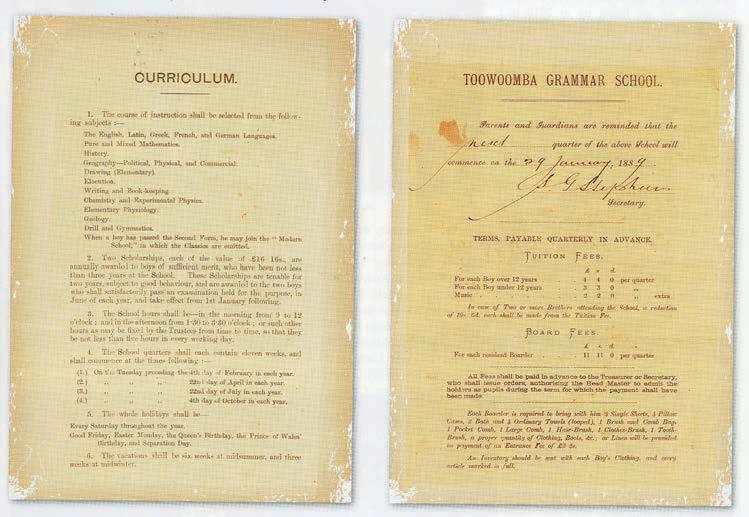
School Curriculum & School Fees
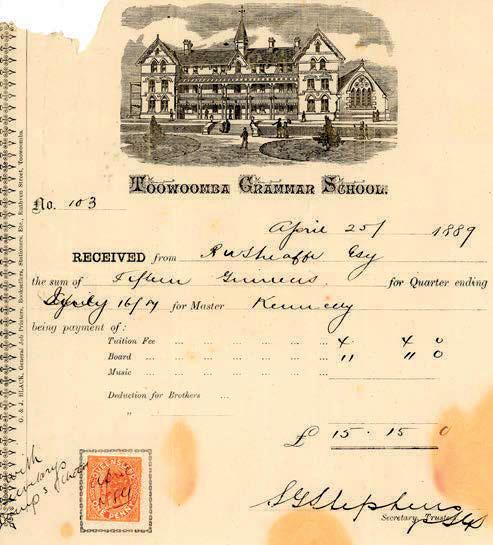
Chairman of the Board of Trustees: Mr Robert Aland, MLA (in his 2nd year)
Headmaster: In January, the Headmaster, Mr Boyd, and his Undermasters submitted their resignations. At the end of the first quarter of 1890, Mr Boyd went back to Brisbane where he re -opened his Eton High School in Nundah. Later this school became St Margaret’s Church of England High School for Girls. He became active in the Royal Geographical Society circles and in 1897 became the first Editor of the Queensland Agricultural Journal, a position he was to hold until April 1921. Interestingly, in 2006 the Brisbane City Council perpetuated his memory by naming a public park (Boyd Park – Nundah) after him. A photograph of a Latin Dictionary book signed by Mr Boyd in 1890 is included in this year’s entry.
Seventy applications were received by the Trustees in response to advertising the vacancy of the fifth Headmaster of Toowoomba Grammar School. Mr C harles Carteret Corfe was appointed from April. He had been a student at Cambridge and was a former Headmaster over a period of sixteen years of Christ’s College Grammar School, Christchurch, New Zealand. Mr Corfe created a then -record by retaining the Headmastership for ten years.
Total School Enrolment: 59
Number of Dayboys: 37
Number of Boarders: 22
Students:
• Mr Corfe had five sons all educated at Toowoomba Grammar School: Anstruther (Anstey) John; Charles Reginald; Arthur Cecil; Duncan Bertram; and Edgar Maniguy.
• One of Mr Corfe’s sons, Arthur Cecil Corfe, became the School’s first international sportsman when he was selected in the 1899 Australian Rugby XV.
• Henry ‘Harry’ E. Barlow (1879-1885) represented Queensland in cricket against New South Wales this year, when future TGS Headmaster Mr. George Pitty Barbour was on the opposing New South Wales team which won.
• Seven Old Boys fought in the Boxer Rebellion, 1900-1901.
Events:
• The period of the 1880s and 1890s were tough times for Queensland with a succession of droughts, floods and economic depression. The mood of the era was opposed to privilege, favouring equality. Consequently, the grammar schools were seen by some as symbols of upperclass privilege and periodic moves were made in the Colonial Parliament for their abolition.
• The Headmaster, Mr Boyd, must have signed a student prize book prior to his departure. This is known as, in 2020, a book arrived at the School sent from a person in Sydney who worked in an ‘op-shop’ and identified an old Latin dictionary book signed in 1890 by the former Headmaster, Mr Boyd. The Latin dictionary is housed in the School Museum.
• Old Boy James Wilson (1891-1893) wrote to the President of the Old Boys’ Association in 1968 enclosing a cheque for $15.00 in lieu of his attendance at the Annual Dinner. Mr Wilson recalled his time at the School in 1891 and referred to the Nuss’ baths where clean water flowed in from the East Swamp at one end and out to continue towards town at the other. He wrote that for 6d he came out cleaner than when he went in. He also remembered Mr Corfe’s horse with a New Zealand name and some of the dayboys also bringing their horses to school. Mr Wilson also referred to Mrs Warner’s little shop near the north-west corner, where the boys squandered as much as a h’penny on her “incomparable sticks of lolly”.
• The new Headmaster, Mr Corfe, had an outstanding achievement as a sportsman at university. Whilst at Cambridge University he was his college’s representative in intra -university sports in 1867-1869. At the Cambridge University sports he won the 100 yards, 440 yards, 120 yards hurdles, 100 yards hurdles, putting the weight, throwing the hammer and the long -jump. He stroked the winning four and played rugby and cricket. The Toowoomba Chronicle gave a flattering assessment of the Headmaster’s wife when the newspaper described her as “most favourably mentioned as a lady of education and refinement, possessing habits of order and such tact and kindness as are necessary for the domestic management and arrangements of the School.” (9 April, 1890).
• In 2023 Mr Phil Woodhouse (1959 -1960), the great grandson of former TGS Headmaster Charles Carteret Corfe and his wife, Jo, donated the Corfe Cup to the School. The Cup has the engraving ‘Hundred Yards Race, March 5, 6 & 8, 1869 won by C.C. Corfe (Jesus College, Cambridge University). A photograph of this Cup is included in this year’s entry.
• Also relevant to the Corfe family, in 2013 Mr Corfe’s great grand -daughter, Mrs Susan Goodwin, visited the School. Mrs Goodwin’s son, James, also attended the School from 1989-1993.
• The regular monthly meeting of the Trustees was held in the Court House on a Saturday in March.
Co-curricular Activities:
• It appeared that no inter-school cricket match was played this year.
Distribution of Prizes Day Guest Speaker: Mr Littleton E. Groom, Barrister and Politician (Old Boy 18791885) and His Worship The Mayor of Toowoomba, Alderman James Taylor
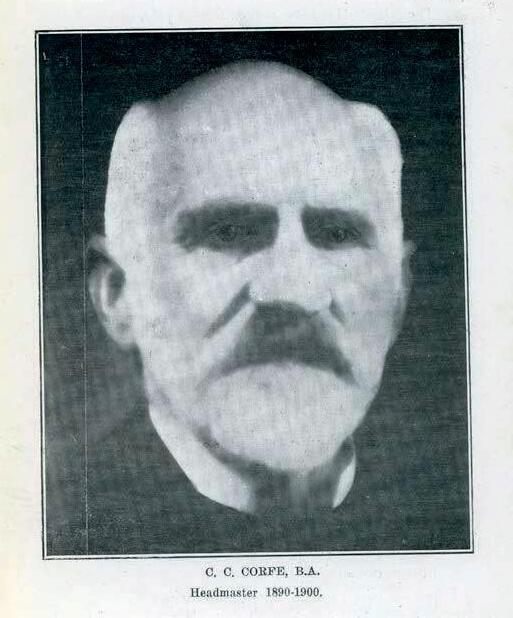
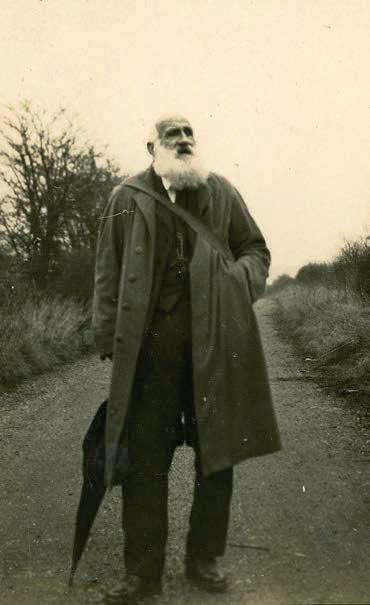
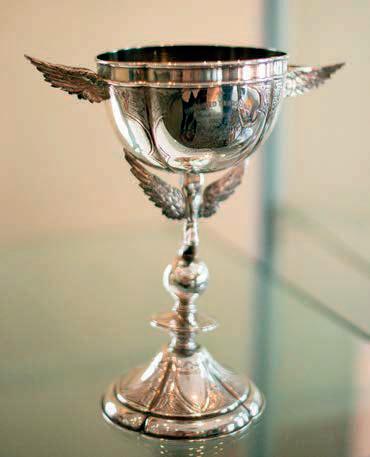


Chairman of the Board of Trustees: Mr Robert Aland (in his 3rd year)
Headmaster: Mr Charles C. Corfe (in his 2nd year)
Total School Enrolment: 47
Number of Dayboys: 34
Number of Boarders: 13
Events:
• Now in the School’s fifteenth year of operation, another school was founded and was later to become a co-member with Toowoomba Grammar School of the Grea t Public Schools (GPS) Association of Queensland - St Joseph’s Nudgee College.
• The first mention of the School’s Prefects appeared in 1891 when the then Headmaster, Mr Corfe, referred to them in the Distribution of Prizes Day (now Speech Day and Prize Giving Ceremony).
Co-curricular Activities:
• In Cricket, the 1st XI cricket team enjoyed a win against Ipswich Grammar School at home. The Board of Trustees sanctioned an appeal being made to the public in support of the school games and approved an admission charge of one shilling to the grounds. At the conclusion of the cricket match against Ipswich Grammar School in November, the Mayoress, Mrs G.G. Cory, made the presentation of a bat given by Mrs Roberts to the highest scorer, in this case Phil Thomas from TGS making 88 runs. (see ‘Students’ 1892).
Distribution of Prizes Day Guest Speaker: The Right Honourable Hugh M. Nelson, MLC
The function commencing at 4:00 pm was held in what is known today as Old Hall. In The Darling Downs Gazette of this year (Saturday, 12 December, page 4) an article reported on the School’ s Distribution of Prizes Ceremony. It was reported: ”Were it not for the happiness of the occasion, many would have felt decidedly uncomfortable; for the crush which prevailed did not tend to alleviate in the slightest the terribly oppressive heat of the day…Some of our most charming and fashionable ladies were present, looking their best and apparently experiencing no little pleasure in the proceedings.”
Chairman of the Board of Trustees: Mr Robert Aland (in his 4th year)
Headmaster: Mr Charles C. Corfe (in his 3rd year)
Trustees:
• The Hon. Hugh M. Nelson, MLA (Trustee from 1877 to 1883) was reappointed as a Trustee in June. He resigned in the following year but returned as Chairman of the Board of Trustees in 1904 (to 1906).
Senior Prefect: David Horn (was referred to by Mr Corfe as the ‘Head Boy’). No other records of ‘Head Boy’ or Senior Prefect are apparent until 1903.
Dux of Year: David Horn David proceeded to The University of Melbourne, winning an Ormond Colle ge Scholarship. He completed a Bachelor of Arts degree and returned to Toowoomba to establish his own school in competition to Toowoomba Grammar School. His school, Carlton High School for boys, was opened at Easter 1898 in a house at 5 Christmas Street. T his school adversely affected the enrolment numbers of Toowoomba Grammar School until it closed in about 1903. In 1894 David’s younger brother, William R. Horn, was to achieve the position of Dux of Toowoomba Grammar School.
Total School Enrolment: 78 (a then record)
Number of Dayboys: 53
Number of Boarders: 25
Junior School: A preparatory class for boys of primary school age was introduced.
Students:
• Philip L. Thomas (1889-1892) at the time was one of the most dashing batsmen Queensland ever produced. Playing for Toowoomba against Stoddart’s English XI in 1897 he scored 85 in an hour and in one over knocked T. Hearne three times out of the ground. During an interval Prince Ranjitsinghi, who was leading the team in the absence of Mr Stoddart, said to Phil: “Do you know, Mr Thomas, that Hearne is the greatest length bowler in England and is not used to such treatment?” (source: Toowoomba Grammar School Magazine, Vol XIV, November, 1923, pg 30).
Events:
• Captain Hutchison of the Defence Forces approached the Headmaster and Trustees seeking approval for the formation of a Cadet Corps to which it was agreed (see below).
• The Headmaster, Mr Corfe, spoke about the desirability of a Prefect system.
Co-curricular Activities:
• Cricket - No evidence can be found of any cricket matches played in the years 1892-1897 against Ipswich Grammar School or Brisbane Grammar School. A school cricket team played in the local Toowoomba cricket competition and included some of the School’s Masters to bolster the strength of the side and to mentor the boys.
• Cadets – On the 14 July at the request of Captain Hutchinson of the Defence Forces, a Cadet Corps was established under the command of Captain Lee, a member of staff. On the Distribution of Prizes Day of this year a Guard of Honour was formed by the Corps for the arrival of the Governor. This Unit, together with the Cadet Units of Ipswich Grammar School and Indooroopily State School, was disbanded in 1896 probably because of the financial difficulties besetting the Colonial Government at that time (see 1907).
General:
Student Duncan Nelson (1883 -1892) provided an outline of life at Toowoomba Grammar School at this time when contributing to an article in the School Magazine, November 1936. In part he wrote:
“In the early eighties, when I joined up, scholars remained much longer at school than they do nowadays. There were quite a lot of boys of 18 or 20 years old, and there were several of them who actually "wore upon their chins the beards of Hercules and frowning Mars" - a most awe-inspiring sight to a novice of nine years, as I then was. New boys had to undergo a few ceremonies of initiation none of which, however, was really cruel or even severe, if taken in a spirit of cheerfulness and good nature. The most amusing was perhaps being locked up in a cupboard or large box until such time as he should sing a song to the satisfaction of his tormentors. "Branding" was not as bad as it sounded. There was no hot iron. It merely consisted of being pushed about. Little fellows were let down easily, having only a few little blue marks to show afterwards…. If I were putting a son to school, I would advise him to get to know as many of his school-companions as he possibly could, to try and keep in touch with them all his life, especially the worthy ones, to take a large part, during the school days, and afterwards in the management of the school clubs and societies, to endeavour to get interested in at least one school subject and to think about that subject and try to really understand it…Friendships formed at school are hard to beat.”
Distribution of Prizes Day : His Excellency The Governor, General Sir Henry W. Norman. At this ceremony, the Cadet Corps formed a Guard of Honour for the arrival of the Governor.
Chairman of the Board of Trustees: Mr Robert Aland (in his 5th year)
Headmaster: Mr Charles C. Corfe (in his 4th year)
Total School Enrolment: 62
Number of Dayboys: 37
Number of Boarders: 25
Staffing:
• The Headmaster’s contract for a further three years was confirmed by the Board in “high appreciation of the excellent standards to which the School had been raised”
Students:
• James A.C. Wilson (1891-1893) was later to be appointed Principal of Toowoomba State High School and Technical College in 1935 and served in this role until 1947. The School was established in 1919 after the Department of Public Instruction took over the r unning of the Technical College. The School was situated at the corner of Margaret and Hume Streets and opposite this building was the town outdoor swimming pool.
• James Wilson (above) as quoted in the School’s Newsletter Blue and Gold in 1962 recalled: “the old days when the School boasted only three teachers… the Armstrong brothers from the Gulf country who went home only every second Christmas because riding home and back to school took up nearly all their vacation – three new boys about to be initiated jumping onto the rail of a fence, drawing their pig-stabbing sheath knives, and challenging the “oldsters” to come and take’em (initiation ceremonies were forthwith banned by Mr Corfe).”
• James Wilson also recalled the years 1891-1893: “The whole of the large paddock to the north of the school building was densely covered with wattle trees. The dayboys used to group into small parties, take a billy-can, and have their lunches picnic fashion among these trees. Their return to the School usually synchronised with the efflux of the boarders from the dining room. There was then a mad rush by the boarders for a drink of billy tea; evidently the flavour was nostalgic. The only bathing pool was privately owned by Mr Nuss – a smallish, bricked pool on the East Creek side, just a little way from the school; admission threepence. The water was always very clear and cool, continuously led in from fresh springs and skimmed out the other end. We occasionally had some excitement in the town itself. The fire-engine was horse-drawn, with only one or two permanent men. The rest were volunteers, who were roused by the booming of the fire bell.”
• Harold E. Youngman (1891-1893) was in 1903 to win the Tennis Singles Championship of Brisbane.
Co-curricular Activities:
• In Cricket, a school cricket team played in the local Toowoomba cricket competition and included some of the School’s Masters to bolster the strength of the side and to mentor the boys
Distribution of Prizes Day Guest Speaker: His Excellency The Governor, General Sir Henry W. Norman
Chairman of the Board of Trustees: Mr Robert Aland (in his 6th year)
Headmaster: Mr Charles C. Corfe (in his 5th year)
Senior Prefect: Arthur ‘Anstey’ Cecil Corfe (at school 1891-1896) and Senior Prefect from 1894-1896 (see 1896)
Dux of Year: William R. Horn, the brother of the Dux of the School in 1891 and 1892, David Horn.
Total School Enrolment: 59
Number of Dayboys: 45
Number of Boarders: 14
Students:
• John (Jack) S. Hutcheon (1894-1900) was one of the best batsmen to have a ttended the School and represented Queensland from 1905-1911 (in 1910-1911 he captained the Queensland XI). In the 1908-1909 Brisbane season he scored six centuries. John Hutcheon was also the Scho ol’s second Old Boy to represent Australia as an international sportsman; in this case in the sport of Lacrosse (1907). His younger brother, Ernest Hutcheon (1902 -1903), was also an outstanding cricketer (see 1902). After school, John went to London to study law and was later appointed King’s Counsel (K.C.) in Australia. At that time, in 1944, there was only one other King’s Counsel in Queensland. John Hutcheon became President of the Bar Association in 1952, a position he was to hold for many years. He was also President of the Queensland Cricket Association and an Australian Selector. As a leading cricket administrator, he is credited with getting Brisbane its first Test match. Relevant to Toowoomba Grammar School, John Hutcheon was President of the Brisbane Branch of the Old Boys’ Association from 1929 to 194 6 and for decades returned to play in Old Boys’ matches against the School’s 1 st XI. When the Woolloongabba Ground, the Gabba, became a Test venue in 1927 the major grandstand was named The J.S. Hutcheon Stand (see 1900). This (former) large grandstand occupied the main northern end of the ground and was the main stand.
• James C. Robertson (1893-1894) landed at Gallipoli where, although wounded, was mentioned in Dispatches seven times. He later served with distinction in France from 1916 to 1918 as Commander of the 12th Brigade AIF. After World War I, Brigadier-General Robertson served two periods as Chairman of the School’s Board of Trustees (1929 -1933 and 1943-1945) and on the Board from 1922-1948. He is acknowledged on the Old Boys’ Wall of Achievement. When the L.A. Boyce Boarding House was opened in 1969, one of the four dormitories was named after Brigadier-General Robertson (see 1969) The School, to this day, also presents the BrigadierGeneral Robertson Memorial Prize for Art at the annual Speech Day and Prize Giving Ceremony. From 1928-1994 the School also presented the Brigadier -General Robertson Prize for Junior Essay.
• Also on the Wall of Achievement from this year is William C.A. Vanneck (1893 -1894). In 1906 he joined the 13th Hussars which were stationed in India. In 1915 he succeeded his uncle as Baron Huntingfield, an Irish title. He was elected to the House of Commons i n 1923 as Conservative member for the Eye Division, East Suffolk. In December 1933 it was announced that Lord Huntingfield was to be the Governor of Victoria (1934 -1939) and he was the first Australian-born State Governor. A good shot and sportsman, fluent in French and German, articulate, worldly and agreeable in personality, Lord Huntingfield was a suitable choice for a State devastated by the Great Depression and perplexed by events in Europe and Asia. During the absence of the Governor General, Lord Gowrie, in 1938, Lord Huntingfield acted as Governor General for six months. He was the last British peer to act as Governor of the State. Lord Huntingfield visited his old school in July 1935 (see 1935). Later he was appointed Governor of Southern Rhodesia in 1941 but did not proceed because of ill health. Lord Huntingfield died in England in 1969.
Events:
• The Shearers’ Strike of 1894 -1895 took place. At that time, Old Boy ‘Harry’ Chauvel was a SubInspector of Police.
General:
Student John Hutcheon (see above) provided an outline of life at Toowoomba Grammar School at this time when contributing to an article in the School Magazine, November 1936. In part he wrote: “No doubt a class-room will always be a class-room; but in our time the "Oval" had not yet been levelled; No. 2 ground was in the hollow, where even now the remains of the asphalt wicket can be seen; no swimming pool had appeared - the tennis court (singular) was sometimes in good condition - the Gym. was not! Inter -School contests, with the trips "abroad," had not been evolved. Yet it was a happy time and the School standards were high. University Scholarships were won from time to time , when there were only three in each year for the whole of Queensland W. R. Horn is a name which comes especially to mind. Naturally, the roll-call did not compare with that of 1936. In the early days there was always a considerable Western "invasion”; but towards the end of the century drought nearly killed the School, and reliance had to be placed upon the dayboys and a few boarders who came from the coastal towns . Most of us boys rode our ponies regularly to school - Alice Street, if I am not mistaken in the name, was our special Clifford Park. But even if times have changed, with the autocar, the "movies," and what not, Old Boys of the T.G.S. are proud of the development that has taken place at the old School, proud of the records which year by year are secured, and confident as to the conquering of fresh fields in the years to come.”
Distribution of Prizes Day Guest Speaker: Sir Robert Philp, QLD Minister for Works. (A photograph of the front cover of the Prize and Honour List is included in this year’s entry.)
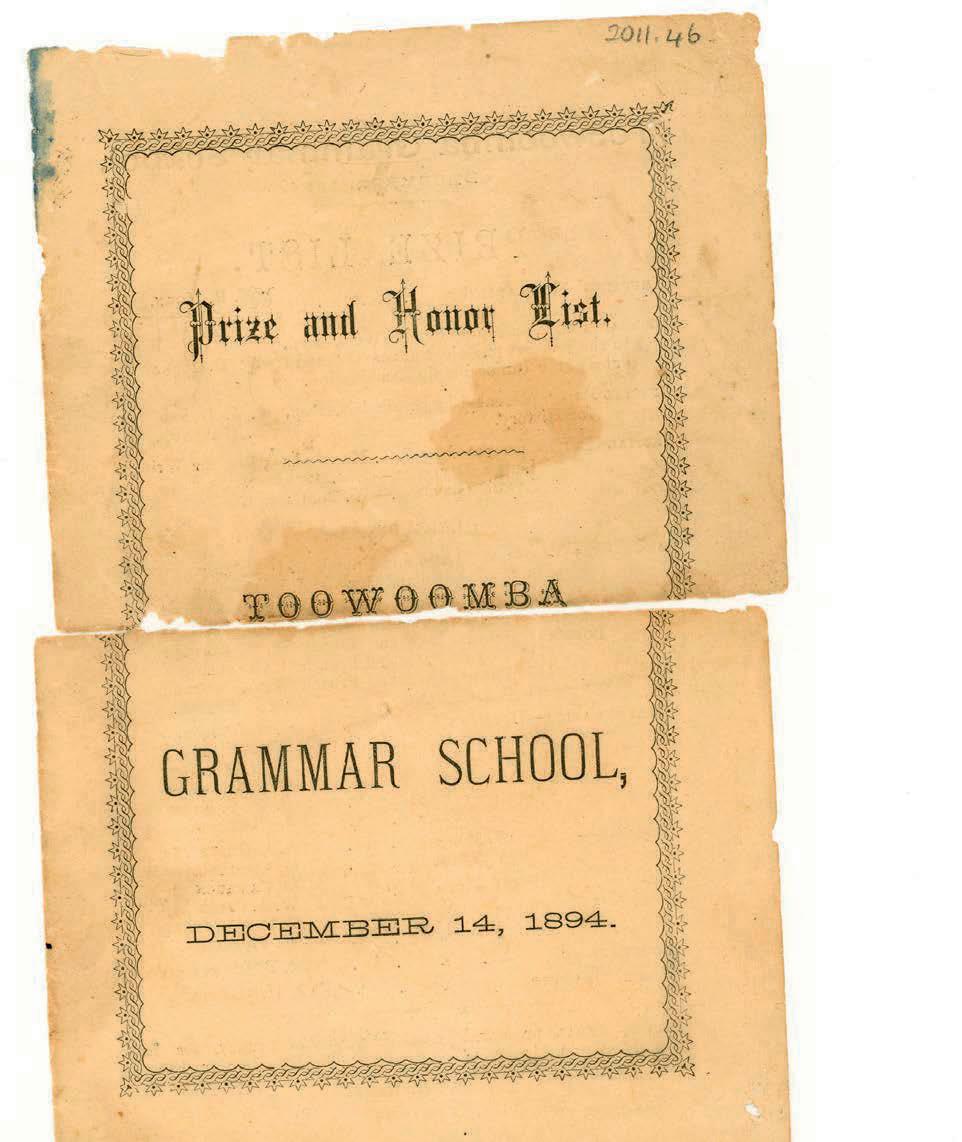
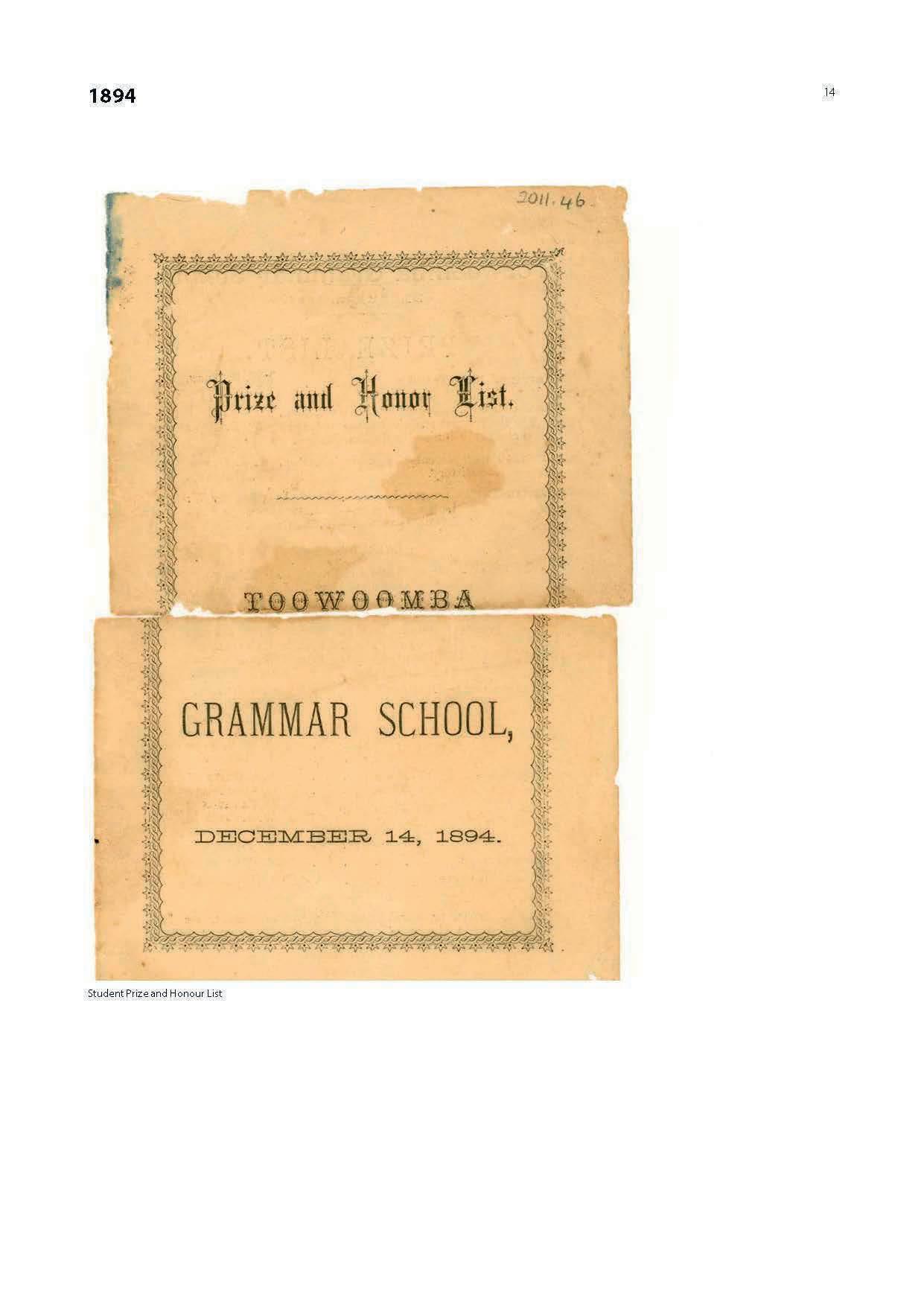
Chairman of the Board of Trustees: Mr Robert Aland (in his 7th year)
Headmaster: Mr Charles C. Corfe (in his 6th year)
Total School Enrolment: 43
Number of Dayboys: 27
Number of Boarders: 16
Staffing:
• Undermaster Mr Lee, and Captain of the Cadet Corps, resigned. The very next year the Cadet Unit was disbanded and a decade was to elapse before it was officially reformed at the School.
• In the book Toowoomba Grammar School 1875-1975, A Centenary History, the author, Dr Rupert Goodman, quoted a letter to the Headmaster written by a young man accepting the offer of appointment as the Junior Assistant Master. The acceptance letter illustrates the formality and gracious days of the 1890s: “I have the honour to acknowledge receipt of your letter of 2 nd inst. offering me the appointment of junior assistant master at the Grammar School, Toowoomba, at the salary of £150 per annum. I accept the offer and am prepared to commence work immediately my services are required, and I beg permission to express my sincere thanks for the honour you have done me in selecting me for the position. As regards the nature of the duties required of me – as explained in your letter – I simply leave myself entirely in your hands, considering that in accepting the position my time, when on duty, and whatever powers I possess are entirely at your disposal to use in any way you may consider most conducive to the best interests of the school.” (page 46).
Students:
• Donald C. Cameron (TGS 1892-1895) was later to become Lieutenant -Colonel Sir Donald Cameron. He commanded the 5 th Light Horse 1st AIF, was a Federal Member of the House of Representatives and represented Australia at the League of Nations Assembly in 1923. Sir Donald is honoured on the Old Boys’ Wall of Achievement. He was educated at both Toowoomba Grammar School and Brisbane Grammar School. In 1899 Donald Cameron went on a tour of Europe and Asia and was in China during the Boxer Rebellion. From May 1915 until the evacuation, his regiment fought as infantry at Gallipoli. He was appointed K.C.M.G. in 1932 and in World War II he served as Chairman of the NSW recruiting drive committee for the Royal Australian Airforce. Sir Donald represented Brisbane for the National Party in the House of Representatives from 1919-1931.
Events:
• Because the University of Queensland had yet to be established (in 1910), boys had been sitting for the Sydney examinations since the foundation of the School. If successful, the boys had to depart for Sydney to complete their university studies.
• The Trustees consented to the Headmaster’s proposed School Motto and Crest. The Latin Motto Fidelis in Omnibus which translated to “Faithful In All Things” has continued to this day.
Co-curricular Activities:
• Cricket – In the cricket team photograph in this year’s entry are three members of Headmaster Corfe’s family: the Headmaster Mr Charles Carteret Corfe (back row, centre) and his sons Arthur (back row, second from left next to his father) and Duncan (front row, right). A Master of the School wearing a blazer and cricket pads in the photograph is Mr Norman de Horne Rowland who later became a Judge of the NSW Supreme Court (see ‘Staffing’ in the 1902-year entry).
• Cultural performances were conducted which included Faust and The Merchant of Venice.
Distribution of Prizes Day Guest Speaker : Mr William A.J. Boyd, former Headmaster of the School (18881890)
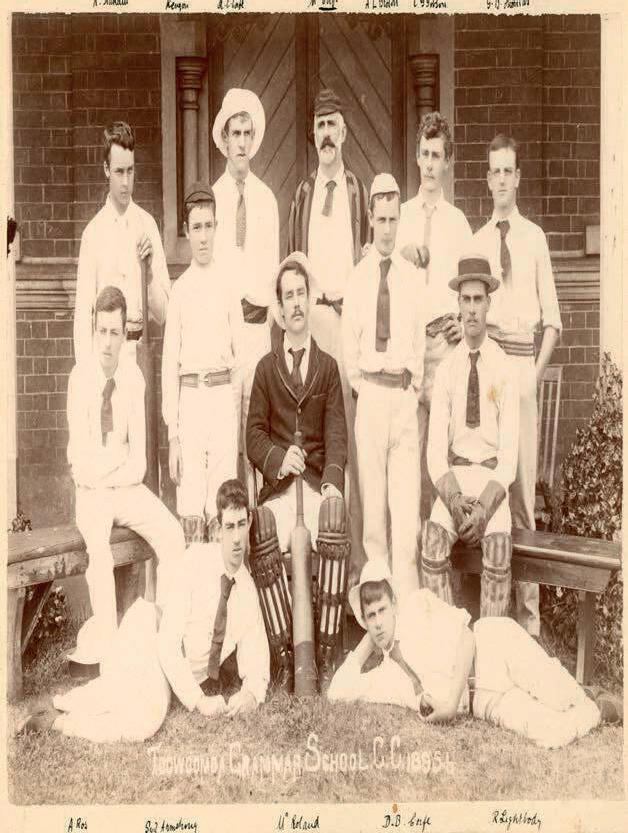

Chairman of the Board of Trustees: Mr Robert Aland (in his 8th year)
Headmaster: Mr Charles C. Corfe (in his 7th year)
Total School Enrolment: 48
Number of Dayboys: 34
Number of Boarders: 14
Students:
• William R. Horn was the first boy since the School’s foundation to win a Queensland Government University Exhibition. This consisted of a Scholarship of 100 pounds a year for three years to any University of his choosing in the Empire.
• One of the Headmaster’s sons, Arthur ‘Anstey’ Cecil Corfe (1891-1896), was later to be the School’s first international representative. He played a total of nine Rugby Union games for Queensland during the 1898 and 1899 seasons. He played in one Test for Australia against Great Britain in 1899 in the first-ever international series. Later he attained the rank of BrigadierGeneral in the British Army, joining five other Old Boys (‘Harry’ Chauvel, Walter A. Coxen, Cecil H. Foott, James C. Robertson and Charles G.N. Miles) who had all attended the School prior to 1900 and who had achieved the rank of General in the Australian Imperial Forces. Brigadier-General Arthur ‘Anstey’ Corfe was also a member of the League of Nations Commission and appears on the Old Boys’ Wall of Achievement.
Events:
• The Toowoomba Golf Club was formed in August. The School’s Headmaster, Mr Corfe, was elected the Club’s inaugural Captain (President). It was a position he was to hold until he departed Toowoomba in 1900. The first golf course in Toowoomba was at the eastern end of Herries Street on open land at or near the present site of St Vincent’s Hospital, running up towar ds the top of the Old Toll Bar Road. It consisted of five holes and there was little difference in the fairway and the rough.
Distribution of Prizes Day Guest Speaker: His Excellency The Governor, The Right Honourable Charles Wallace Alexander Napier Cochrane-Baille (Lord Lamington)
Chairman of the Board of Trustees: Mr Robert Aland (in his 9th year)
Headmaster: Mr Charles C. Corfe (in his 8th year)
Total School Enrolment: 43
Number of Dayboys: 35
Number of Boarders: 8
Trustees: His Excellency the Governor announced the appointment of Mr Robert G. Wonderley to be a Trustee of the School following the passing of Mr John T. MacMichael.
Staff: There were six staff at this time including the Headmaster, Secretary to the Board, the Lodgekeeper, and Messrs Rowlands and Allpass and an unnamed Music Teacher.
Students:
Samuel George Stephens Jnr. (1896-1897), one of the six sons of the founder of the School, Mr Samuel George Stephens Snr, displayed an incredible act of generosity in later life to the citizens of Toowoomba by donating his beautiful property known as Laurel Bank Park. The park contained, besides many of the choicest shrubs and plants that he could procure from all parts of the world, at least 25,000 bulbs, the result of 200 separate plantings. Samuel Stephens had designed and developed the garden himself over almost thirty years and, in 1932, he donated the land to the citizens of Toowoomba, making Toowoomba Council the official custodian. On handing the garden to the City Council, he made the stipulation that the park be named Laurel Bank as he did not want it to be named after him. An obituary for Samuel George Stephens was featured in the 1944 School Magazine (November edition) on page 46.
Distribution of Prizes Day Guest Speaker: His Worship The Mayor of Toowoomba, Alderman Edmund Boland
Chairman of the Board of Trustees: Mr Robert Aland (in his 10th year)
Trustees: Members of the Board of Trustees included Mr Robert Aland (Chairman); Mr John L. Graham; Mr Richard W. Scholefield; Mr Gilbert G. Cory; Mr Henry V. King; Dr Edgar A. Falkner; Mr Robert G. Wonderley and Acting Secretary to the Board of Trustees was Samuel George Stephens (Jnr) standing in for Samuel George Stephens (Snr) for one year whilst his father was away overseas.
Headmaster: Mr Charles C. Corfe (in his 9th year)
Total School Enrolment: 36
Number of Dayboys: 27
Number of Boarders: 9
Students:
• The first of the five von Stieglitz brothers (Edgar Walter) commenced in the School. All five brothers fought in World War One and all returned (see 1902 ‘Students’ section).
• George S. Knowles (1894-1898) passed the Public Service examination being placed 6th out of 180 candidates. He qualified with a Master of Arts and Master of Law from The University of Melbourne after leaving the School. He was to become the Commonwealth Solicitor Genera l from 1932 to 1946 and later the High Commissioner to South Africa. Sir George Knowles is acknowledged on the Old Boys’ Wall of Achievement.
• Also acknowledged on the Old Boys’ Wall of Achievement is Charles G.N. Miles (at school 18981899). He served with the Australian Imperial Force (AIF – first raised in 1914 for overseas war service) from 1914-1919 and was later ADC to King George VI of England. Lieutenant -General Miles was also the Commandant of the Royal Military College, Duntroon , from 1935-1939 (Duntroon was founded in 1911).
• Francis ‘Frank’ Lewis Reithmuller (1897 -1898) became renowned for his expertise in roses and gained international recognition for his significant contributions to the horticultural industry. His extensive publications, research and studies on rose varieties, cultivation techniques and hybridisation methods made a lasting impact globally. This recognition was further evidenced by the prestigious awards he received from renowned horticultural organisations and bo tanical societies.
• Ernest A. Walker (1897-1898) visited the School in 1936. He had served on the staff of Sydney Grammar School with a future TGS Headmaster, Mr Barbour, and also on that of Scots College, Sydney, with another future TGS Headmaster, Mr Robe rts. Mr Walker was on the staff of Scots College for 30 years.
• For the Sydney Junior Public examination, seven boys entered and six passed. For the Queensland Civil Service examinations there were 117 candidates in Queensland and TGS students Arthur R. Woolcock, George S. Knowles, and Francis W. Little were respectively 5 th, 6th and 9th on the list.
Co-curricular Activities:
• In Cricket, a game was played against Gatton College in November with the match won by TGS by ten wickets. In the game one of the Headmaster’s sons, Duncan Corfe, took six wickets for 34 runs.
• The Headmaster, Mr Corfe, was an Old Cambridge ‘blue’ and he loved sport. In his Headmaster’s Report at the Distribution of Prizes ceremony, he said: ”It is partly because I believe the character of a boy is often best developed through the games that I am a firm believer in a certain amount of compulsory games, and I am quite sure that most boys are physically the better if they take exercise and don’t loaf.”
Distribution of Prizes Day Guest Speaker: His Excellency The Governor, The Right Honourable Charles Wallace Alexander Napier Cochrane-Baille (Lord Lamington). At the Distribution of Prizes ceremony some Masters performed a scene from Richard III.
Chairman of the Board of Trustees: Mr Robert Aland (in his 11th year)
Headmaster: Mr Charles C. Corfe (in his 10th year)
Total School Enrolment: 37
Number of Dayboys: 29
Number of Boarders: 8
Students:
• At this time there were nine or ten former students from the School now attending Sydney University.
• Student J.T. Searle received a Prize Book for Form V English and this was donated to the School Archives in 2007.
• In the photograph (below) in this year’s entry ‘Prize and Honour List (Thursday, December 14, 1899) it is noted that the study of languages offered to the students in the curricu lum included English, Latin, Greek, German and French. The Prize and Honour List indicates that the student J.S. Hutcheon was the Dux of the School.
Events:
• The South African War, also known as the Boer War (1899-1902), was being fought in South Africa between the British Empire and the two Dutch Boer Republics – the Transvaal and the Orange Free State. War broke out when the Boers invaded British South Africa. The School had been well represented in the South African War, having sent three officers, seven non -commissioned officers and many men to the front. An Honour Board in Old Hall titled ‘The South African War’ records the names of 65 Old Boys who fought in this war, including two who lost their lives (H. Spiers and C. Stirling). The Honour Board was donated by the Brisbane Branch of the TGS O ld Boys’ Association in 2005.
• St Mary’s College in Toowoomba was founded.
• In The Toowoomba Chronicle and Darling Downs General Advertiser , Saturday, 30 September 1899 (page 3) a Letter to the Editor gave an unflattering assessment of the School. The letter, in part, read: “I had often thought of sending my boys when they leave the State Schools to a Grammar School for a time, and I naturally look to the institution in my own town before looking elsewhere. I had heard that there was something wrong with our Grammar School; t hat the attendance of pupils was very small for such a large town and district; and that there was a general disinclination on the part of parents to send their boys to the school for various reasons. I think all will regret this state of affairs, for the Grammar School should be, as the schools in England are, a sense of pride to every mother and father in this town.”
• In the School Magazine of 1905 (previous School Magazines are only available from 1904 to the present day) it was reported that the Old Boys’ Association was formed by the energy of Mr Theo Sampson who was a Master at the School in the late 1890’s. Mr Buckland Taylor was the first President of the Old Boys’ Association and Mr J. Provan the first Secretary. An article in the School Magazine of November 1926 (pp.59 -60) noted that: “Until 1907 the Association’s existence was mainly one of hibernation. Then it cast off its slough and moved, but even yet not very rapidly.”
Co-curricular Activities:
• In Cricket, there was no record of any inter-school games being played this year.
• In Australian Rules Football , prior to 1900 Toowoomba Grammar School played Brisbane Grammar School in eight matches and lost all eight games.
Distribution of Prizes Day Guest Speaker: His Excellency, The Lieut-Governor Sir Hugh M. Nelson (former Trustee of Toowoomba Grammar School and Chairman of the Board of Trustees, 1904 -1906). A photograph of the Prize and Honour List is included in this year’s entry.
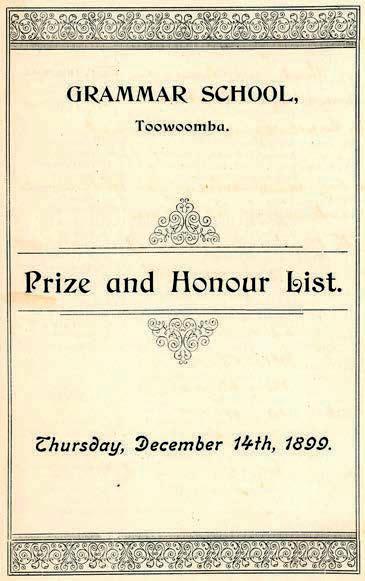
Student Prize and Honour List
Student Prize and Honour List

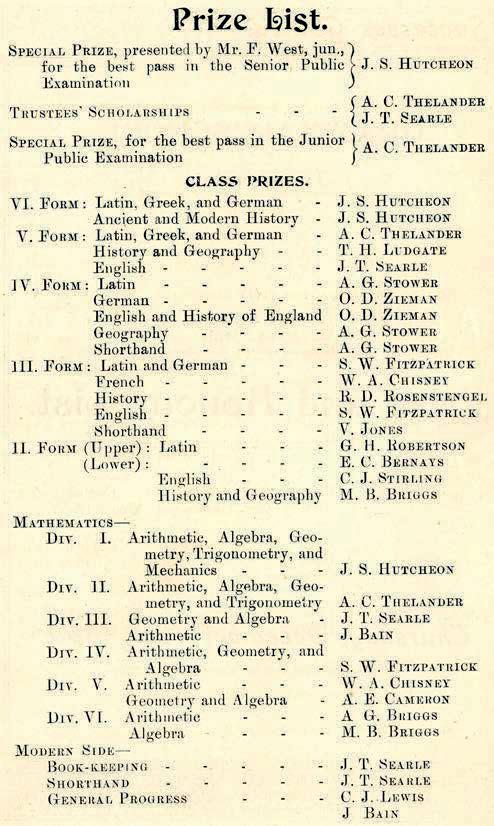
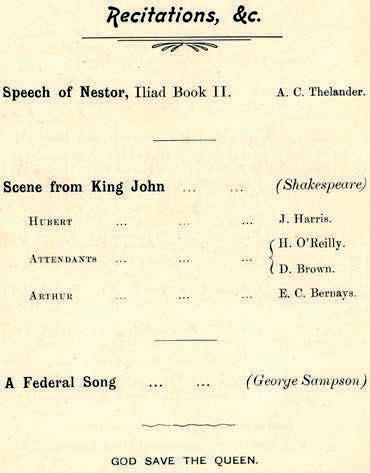
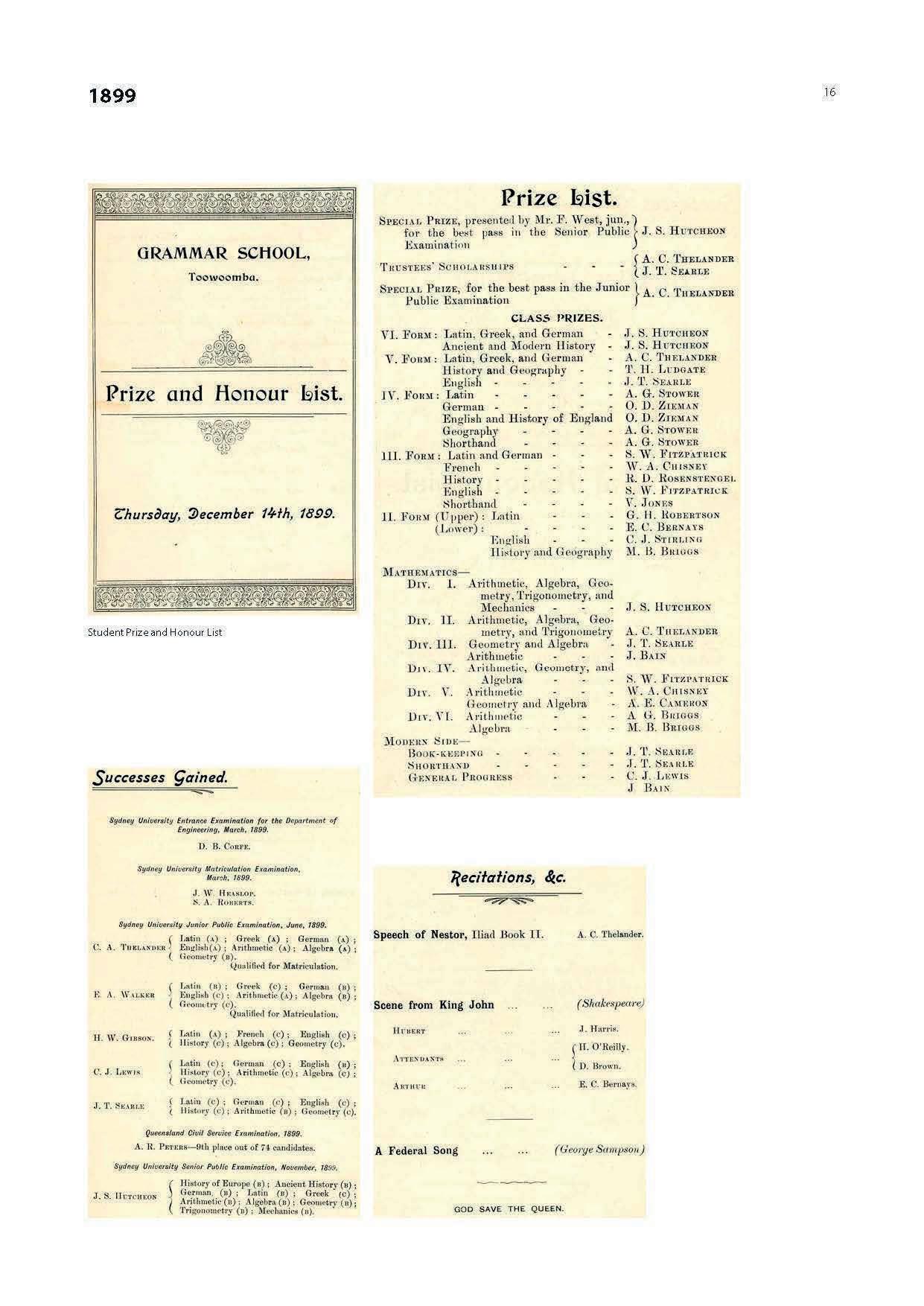
Chairman of the Board of Trustees: Mr Robert Aland (in his 12th year)
Headmaster: In August, Mr Charles C. Corfe (in his 11th year) resigned to be effective from the end of the year. Mr Corfe went to Sydney where he became Acting Headmaster for a time at the Church of England Grammar School. Upon their departure from the School, Mr and Mrs Corfe were afforded a farewell in keeping with their decade of dedicated service.
In 1916 it was reported that Mr Corfe, thought at the time to be in his seventies, returned to the classroom to take a schoolmaster’s place in Wanganui, New Zealand, to allow him to go to the war (as reported in the TGS School Magazine, May 1916, page 17).
Number of Dayboys: 18
Number of Boarders: 7
Staffing:
• The Secretary to the School’s Board of Trustees and the acknowledged Founder of the School, Mr Samuel George Stephens, concluded his service at the end of the year. He had been an honorary Secretary to the Trustees, then an elected Trustee and then a paid Secretary to the Board of Trustees over a period of 26 years. He had witnessed five Headmasters, three Chairmen of the Board and numerous Board members and undermasters.
Students:
• It is understood that the first Old Boy casualty of war was Colin Stirling, a pupil at the School in 1900. In 1901, at the age of 16 years and 8 months, Colin was killed in action as a member of the 5th Queensland Imperial Bushmen Regiment fighting for the British in the Boer War.
• John ‘Jack’ S. Hutcheon (1894-1900) was in the School’s 1 st XI in his final year. In this season he made over 1000 runs in all games at an average of 42. He made the Queensland team in 19051906 and during the 1910-1911 cricket season he captained Queensland for four games. He was subsequently invited to join the Australian team which was due to tour New Zealand but he rejected the offer because of career commitments. This involved travelling to London as a law student and he was to become President of the Queensland Bar Association. Jack Hutcheon not only represented Queensland in cricket but also in lacrosse and played against Canada in 1907. As a cricket administrator, he was President of the Queensland Cricket Association for nearly thirty years and was an Australian Selector in 1928 -1929 and again in 1930 -1931. He was also instrumental in founding the Wanderers XI and the Sheffield Shield Competition. Jack was an active Old Boy, being President of the Brisbane Branch of the Toowoomba Grammar School Old Boys’ Association from 1929 to 1946. He is acknowledged on the Old Boys’ Wall of Achievement due to his national achievements.
Events:
• Toowoomba in 1900 had a growing population of 13,000.
• Education was made compulsory for all Queensland children between 6 and 12 years of age.
• The only sporting oval in the school grounds was located in the north-western corner of the grounds towards the vicinity of the Margaret and Mary Streets intersection. Many years later , in 1954, it was to be named the Barbour Oval after the longest-serving Headmaster in the School’s history.
Co-curricular Activities:
• In cricket, there was no record of any inter-school games being played this year.
Distribution of Prizes Day Guest Speaker: Mr E. Robert Aland, Chairman of the Board of Trustees (18891904)

Chairman of the Board of Trustees: Mr Robert Aland (in his 13th year)
Trustees: The newly appointed Secretary to the School’s Board of Trustees was Mr R obert Sinclair who held this position for a lengthy period, 1901 – 1928. He succeeded the first Secretary to the Board of Trustees, Mr Samuel G. Stephens, who held this position from 1874 – 1901.
Headmaster: Mr William A. Purves was appointed as the sixth Headmaster of Toowoomba Grammar School. He held a Master of Arts from T he University of Oxford and had previously taugh t at Townsville Grammar School and at Melbourne Grammar School.
Total School Enrolment: 58
Number of Dayboys: 39
Number of Boarders: 19
Staffing:
• Under Headmaster Purves, a “preparatory class for juveniles” was opened in July. The Headmaster appointed Mr G.H. Cooke MA to teach the Preparatory class for he had been the Second-master of Melbourne Grammar Preparatory School and was well known to Mr Purves.
Buildings:
• The Gatekeeper’s Lodge (from 1876 -1901) situated near the corner of Mary and Herries Street (near the current residence of the Deputy Headmaster) was destroyed by fire. A plaque on the brick pathway in this area identifies the location of the gatehouse.
Events:
• On 1 January 1901, the union of the Commonwealth of Australia was created. The majority of Queenslanders voted yes to a referendum asking whether Queensland should join the Federation. The referendum was passed resulting in Queensland losing its colonial status and becoming a state.
• The Headmaster sought the Trustees’ approval to change the school colours from dark blue and white to dark blue and gold for they were also the town’s colours (see 1879).
• In this year The Southport Schoo l was established
• The telephone was first connected to the School in March.
• A flagstaff was erected and the new Australian flag, the Union Jack, was flown at the masthead.
• An armoury was built. It was later situated where the Centenary Hall (Boarders’ Dining Hall) now stands (built in 1975). Prior to the Centenary Hall there was a classroom, then a statione ry shop run by McDonald and Rosbrook. Then it was Mr Heenan’s room and then the Armoury. The Armoury housed .303 rifles, 410 rifles, and .22 rifles for use by the Cadets. It was sited near the eastern side of the current School Museum, formerly the Chemistry classroom.
• Regular players of golf around this time were Drs. Falkner and Freshney and Mr Purvis, the Headmaster. The then Governor of Queensland, Lord Lamington, spent some of his summers in Toowoomba and he was also a keen golfer.
President of the Old Boys’ Association: In 1901, after a somewhat intermittent existence, the Old Boys’ Association was re-formed under the Presidency of Mr Warwick Buckland Taylor (for nine years). Later, the Association offered financial assistance towards an Old Boys’ academic scholarship. Old Boys’ sporting teams in rugby and cricket provided regular competition of a high standard for the School’s first t eams.
Guest Speaker at the Speech Day & Prize -Giving Ceremony: This was the first reference to the Speech Day and Prize-Giving Ceremony. From 1878 – 1900 the occasion was referred to as the Distribution of Prizes Day. In 1901 the Guest Speaker was His Excellency The Lieut-Governor, The Right Honourable Sir Samuel W. Griffith. This was held in what is now referred to as Old Hall.
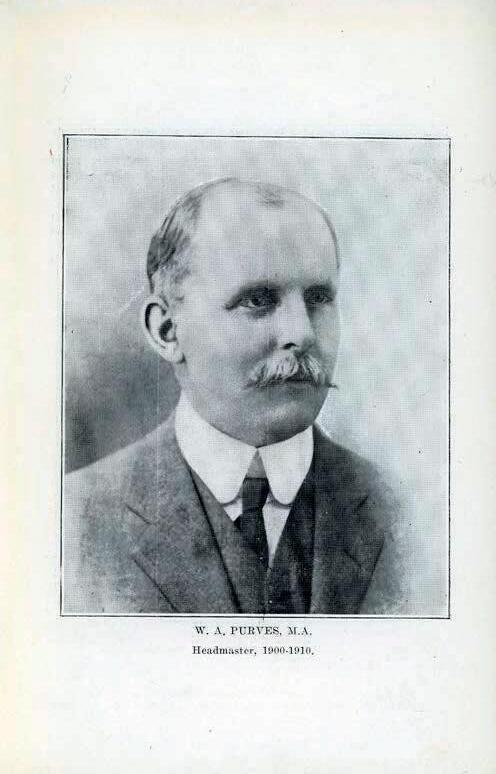
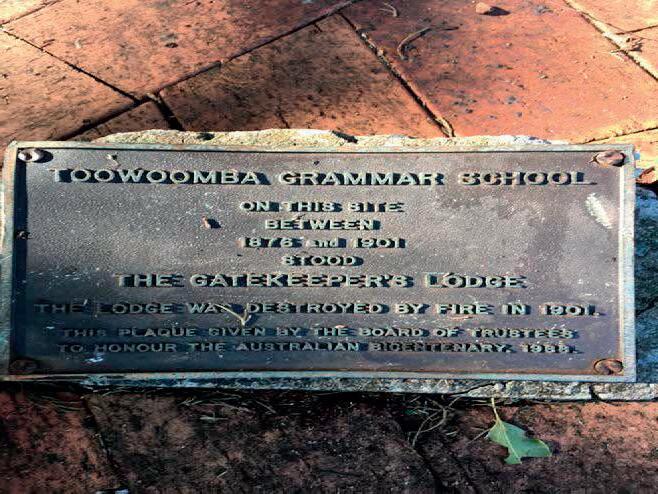
Chairman of the Board of Trustees: Mr Robert Aland (in his 14th year)
Trustees: Mr R.W. Scholefield died early in the year.
Headmaster: Mr William A. Purves (in his 2 nd year)
Total School Enrolment: 95
Number of Dayboys: 60
Number of Boarders: 35
Staffing:
• Mr Norman de Horne Rowlands was a member of staff from 1895 -1898 and later from 19011902. He then resigned to study law and eventually became a Judge of the New South Wales Supreme Court in 1929.
Students:
• Francis (Frank) von Stieglitz (1899 -1902) and his four brothers all attended the School and all fought in World War One on the Western Front and one (Aubrey, TGS 1902-1908) also at Gallipoli. Current students are encouraged to look at the World War One Honour Board in Old Hall acknowledging the five von Stieglitz brothers. Francis was later to become the grandfather of two TGS Old Boys, Rodney Metcalfe (1961-1964) and Andrew Metcalfe AO (1972 -1976: see 1976). An account of the five brothers and their military involvement was included in the School publication, Omnibus, Volume 24, No.1, April 2014, pg 2 -3 (reproduced in the photographs below in this year’s entry).
• In 2019 a TGS Prize Book awarded to A llan Stirling (1902–1903) was donated to the School Museum. Interestingly, the Prize Book was for achievement in Shorthand.
• A photograph of a Prize certificate awarded to boarder Robert F. Thallon (1902-1905) in the boarders’ writing competition is included in this year’s entry.
Events:
• Brisbane Boys’ College (BBC) was established in this year.
• The School’s boarders endured cold showers and institutionalised meals, bitter winters and strict discipline.
• A shed for the accommodation of buggies was approved and built on the School grounds.
• In this year ‘The Trevethan’, the first car made in Queensland, was built by Old Boy Walter Trevethan (1887-1888) and his brother Thomas. The Trevethan was a motor buggy based around a 1 ½ horsepower, single cylinder De Dion engine. It was made in their coach works in Neil Street, Toowoomba, in 1901-1902, largely of their own design. The vehicle’s first test run was a drive from Toowoomba to Crows Nest and the machine broke down only on its return home. In 1903 it was driven down the Toowoomba Range and on the coast at Redcliffe, north of Brisbane.
Co-curricular Activities:
• In Cricket, the School recommenced playing annual cricket matches against Ipswich Grammar School this year after a hiatus of ten years. Earlier, in 1877, the School played a two-day cricket match against the Ipswich Grammar School Cricket Club with subsequent games played in 1888, 1889 and1891.
• This year’s match was played in Ipswich at the IGS oval and the TGS boys arrived on the morning train, accompanied by the Headmaster, Mr Purves, and some Masters. This cricket match was won by IGS by an innings and 117 runs. The TGS team compiled only 22 runs in the first innings with an IGS bowler, Harold Hargreaves, taking 8 TGS wickets for six runs, including a hat -trick. A second game against IGS was played on 5 th December at TGS which was also won by IGS.
• A photograph of the School’s 1 st XI cricket team is included in this year’s entry.
• Of the nine cricket matches played against IGS in the decade from 1900 , TGS won only one, in 1904.
• In Rugby, a photograph of the School’s 1st XV team is included in this year’s entry. The photograph illustrates that the team was ‘Premiers’ but the nature of the competition is unknown. The Great Public Schools’ (GPS) Association was not formed until 1918 and the Chelmsford Cup competition against Ipswich Grammar School was not established until 1907.
Guest Speaker at the Speech Day & Prize-Giving Ceremony: His Excellency The Governor, Major General Sir Herbert Chermside

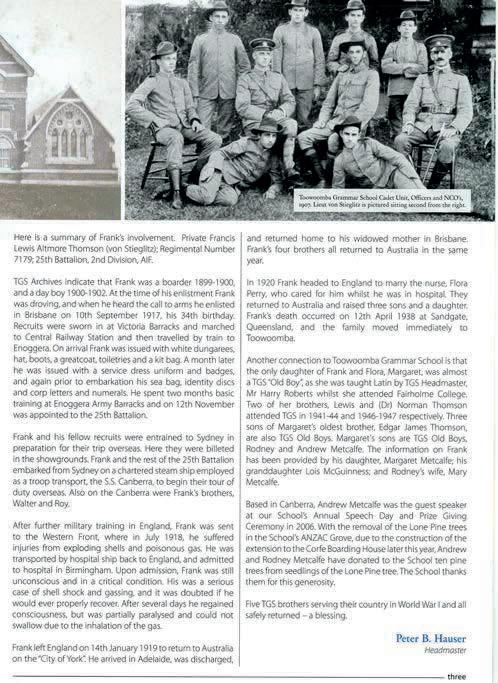
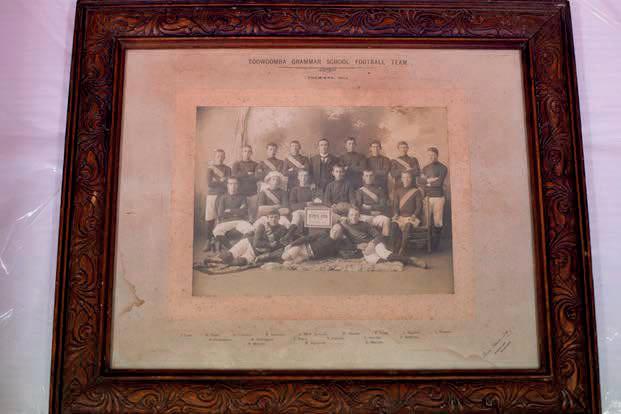
Chairman of the Board of Trustees: Mr Robert Aland (in his 15th year)
Trustees: Dr Edgar A. Falkner resigned from the Board in July.
Headmaster: Mr William A. Purves (in his 3 rd year)
Senior Prefect: The Prefect system was introduced in this year. Samuel W. Fitzpatrick (1899 -1903) was the first Senior Prefect.
Dux of Year: Arthur K. Lamb
Total School Enrolment: 92
Number of Dayboys: 66
Number of Boarders: 26
Staffing:
• In June, Mr J.G. Leadbeater (BA, LL.B) was appointed as a Master. He was a mathematician, a French scholar, choir-master, drum and fife band instructor, magazine editor and golfer and remained on staff for 34 years (until 1937) . Mr Leadbeater had graduated with degrees in Arts and Law from the University of Melbourne and, like the School’s first Headmaster (Mr John Mackintosh), second Headmaster (Mr Lawrence Stephenson) and the School’s 15 th Headmaster (Mr Peter Hauser), taught for some time at Scotch College in Melbourne (see 1876)
• William J. ‘King’ Renwick coached Toowoomba Grammar School Rugby teams from 1903 until 1951 He was coach of the 1 st XV team intermittently from 1903 -1952. ‘King’ was a non-teaching Resident Master and became a legend in Rugby circles both at the School and beyond it. He served as a State Rugby Union selector from 1931 to 1941.’King’ Renwick refereed a first -grade match at the age of 70 in 1950.
• Robert Louis Challoner was appointed to the teaching staff in January but resigned in May. He had played Test Rugby for Australia in 1899.
Students:
• Ernest (Ernie) Hutcheon (1902 -1903) later represented Queensland in Cricket on 12 occasions from 1919-1926. A book written by Ernest Hutcheon, A History of Queensland Cricket, was published in 1948 by Brisbane C.A. (see 1894 for details of his elder brother, John ‘Jack’).
• Keith H. Blaxland (1903–1905) was a great-grandson of the explorer.
• The Dux, Arthur Lamb (1902 -1903), borrowed the book Great Expectations this year from the School Library. In 2022 the book, now 120 years o verdue, was returned to the School Library by his grandson, Dr John Lamb. Family members found the book, in excellent condition, in a box of various possessions belonging to the late Mr Arthur Lamb.
Events:
• Under Headmaster Purves, the academic side of the School was given clear direction.
• The boarders were permitted to stable their horses and kennel their hunting dogs at the School during term time, enabling them to undertake approved camping and shooting expeditions into the surrounding bush on free weekends.
Co-curricular Activities:
• In Athletics, the first Athletics competition against Ipswich Grammar School was held which TGS won – 103 points to 34. Brisbane Grammar School was placed second in this competition.
• In Cricket, the 1st XI played a match against Ipswich Grammar School at IGS on 28 November. The TGS boys arrived in Ipswich on the mail train on Friday night so that they might be able to start the match at an early time on Saturday. TGS scored 55 runs in total and by lunch IGS had scored 94 runs for the loss of no wickets. IGS won by an innings and 71 runs and the TGS team caught the 6:45pm train home.
Guest Speaker at the Speech Day & Prize-Giving Ceremony: His Excellency The Lieut-Governor, Sir Hugh M. Nelson – Chairman of the School’s Board of Trustees (1904 -06).
The Prize Giving Ceremony was held in December in the Masonic Hall, Toowoomba (ground floor of the Masonic Temple in Neil Street, next to today’s Empire Theatre) . The programme was opened by the boys singing Gaudeamus Igitur. The boys, under Mr Leadbeater’s direction, then sang a carol followed by Mr Purves reading the Headmaster’s Report. The enacting of a scene from Sheridan’s Rivals was followed by the distribution of prizes by Sir Hugh Nelson.
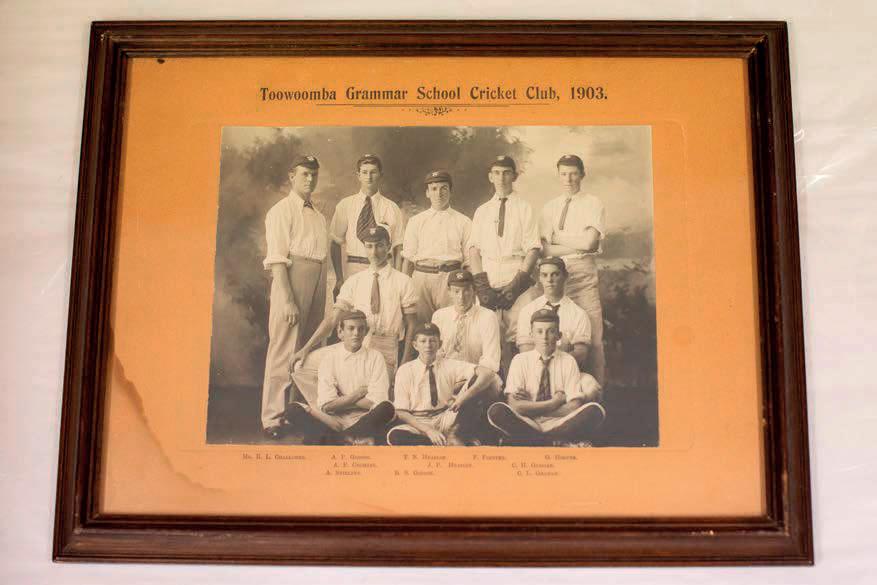

Chairman of the Board of Trustees: The Chairman, Mr Robert Aland, died in March (in his 16th year as Chairman) being succeeded by Sir Hugh Nelson (1904 -06) who had just completed a term as ActingGovernor of the State of Queensland.
Trustees: The Trustees at the beginning of the year comprised Messrs Robert Aland; Gilbert G. Cory; Stanley B. Kennard; Richard W. Frost; and Colonel R.A. Moore. The Secretary to the Board of Trustees was Mr. Robert Sinclair.
Headmaster: Mr William A. Purves (in his 4 th year)
Senior Prefect: Claude H. Glissan (1900-1904)
Dux of Year: Herbert Broadfoot (and in the following two years)
Total School Enrolment: 90
Number of Dayboys: 61
Number of Boarders: 29
Staffing:
• Latin, German, Greek and Shorthand were amongst the subjects studied in the curriculum. Gymnastics classes were programmed into the daily timetable as were swimming lessons which were held at Usher’s Bath Pond, situated on the East Creek swamp near James and Mackenzie Streets.
• Mr Ernest A. Gill, with academic qualifications from the University of Melbourne, joined the teaching staff. He was a natural and gifted all-round sportsman and excelled at cricket, tennis and golf. At a time when staff could join the boys in the School’s open teams, Mr Gill was Captain of the 1st XI Cricket team. Mr Gill also played representative tennis and cricket for Queensland as well as winning the Queensland Amateur Golf Championship in 1905 and 1906 and the Australian Championship in 1906. He transferred from Toowoomba Grammar School to Brisbane Grammar School to take advantage of the sporting opportunities which were available to him in the capital city. Two years later he returned to Toowoomba and worked as an Accountant and in 1910 he rejoined the staff of Toowoomba Grammar School. Several months later he opened his own school after purchasing the then defunct Girton College buildings and site at the eastern end of Campbell Street. This was to become The Toowoomba Grammar Preparatory School (see 1911).
Students:
• The School Prefects were Claude Glissan, Alfred Hart, Thomas Henderson, Frederick King and Ebenezer Simpson.
• Jack Lane advised the School in 1963 that the original Shield for the School Badge was drawn by Claude Glisson, a boarder and Prefect of this era, while the Scroll was added by the Headmaster, Mr W.A. Purves in 1907
• Seven boys sat for the Sydney University Junior examination.
Events:
• The boys of the School did not enjoy electricity or hot water in the School , nor a septic or sewerage system. The horse, the horse and buggy, the train and Cobb & Co coaches were the principal modes of transport in use.
• Problems relating to health and hygiene were ongoing due to the rather primitive drainage and sanitation arrangements. In early 1904 the Trustees authorised the erection of an infectious diseases ward. It comprised a tiled floor with corrugated iron walls. The Headmaster in his Speech Day Report of 1904 referred to the building as: “…a commodious building capable of containing half a dozen beds, and so arranged that after an infectious case, the hose can be turned on ceiling, walls and floor. So far, mumps is the most deadly disease for which it has been needed.” (There was one case of scarlet fever in the boarding house in February.)
• The School’s Trustees faced having to conduct the School with only one quarter of the usual Government endowment. It was hoped that by lowering the salaries considerably and raising the fees slightly it would be possible to carry on without any sacrifice of efficiency for the next twelve months. Later, the financial stress was eased somewhat with the partial restoration of the Government’s endowment that had been withdrawn and the extension of repayments of a loan over a number of years.
• The first official School Magazine was published in May 1904 under the initiative of Schoolmaster, Dr R. Hamlyn-Harris (who commenced in 1903). He left the School in 1910 to become the Curator of the Brisbane Museum. It had been reported that a Toowoomba Grammar School magazine was printed in 1883 during Mr Nesbitt’s Headmastership but no copy exists of such a publication. Copies of the School Magazine of 1904 are housed in the School Museum , the Headmaster’s study and also stored digitally in the School (a copy of the front cover of this first official School Magazine is included in this year’s entry). The Editorial of the vol.1, no.2 edition of the School Magazine illustrated an appreciation of a well -rounded education. The Editorial on page 2 of the magazine stated: “With this number we have much pleasure in presenting to our readers portraits of the School Dramatic Society and of the First Fifteen football team.”
• Toowoomba was proclaimed Queensland’s fifth city in this year. It was referred to in the rai lway excursion guide-book of the day as “The Queen of the Downs”,“The Mountain City” , “The Simla of Queensland” or “The Garden City”. A post card featuring ‘Grammar School, Toowoomba’ was produced.
• A framed portrait of the former Headmaster, Mr Mackintosh, was presented to the School by the Trustees and Old Boys.
• In Queensland the T.J. Byrnes Memorial Medal for the first place in the State’s Junior Examination was created. The first recipient of this Medal for Toowoomba Grammar School was in 1922 acknowledging the academic success of James A. Pollock. Further Medal winners up to 1940 were in 1925 (Lister G. Hopkins) and 1937 (J.C. ‘Bob’ Rivett) (see 1922).
• On some occasions, entertainment was provided for the boarders on Saturday evenings.
• The School Magazine of this year referred to donations being made to the Scho ol Museum. Reference was also made to a collection of minerals held by the School.
• The School Magazine also made reference to Colour Blazers for the first time. It was written: “Towards the end of the season, Blazers were obtained for those who had played two matches with the First XI in competition or inter -school matches and as this branch of sport has now progressed so much, it is distinctly an honour to earn a place in the 1st XI and to win a ‘blue’ “.
Co-curricular Activities:
• In Athletics, the annual athletics sports were held at School in September. The City Band was in attendance and added greatly to the pleasure of the outing. Some interesting events were included in the programme including – kicking football, sack race, throwing cricket ball at wi cket and blindfold race.
• In Cricket, in June the 1st XI Cricket team travelled to Ipswich Grammar School by train to compete (and won the game). The School continued to play cricket against IGS every year from 1904 –1910 but was successful only in this year (on two occasions).
• In the 1st XI return cricket game against IGS in November played in Toowoomba, the TGS bowler, Ray Gibson, took 8 wickets for 27 runs with another win to TGS.
• In the School’s 1st XI Cricket team was the Master, Mr Gill, who in a match against Railways scored 74 runs. It was an accepted practice in those days that the Masters could play in the School’s teams
• On the school grounds were two cricket match wickets and a half-pitch for practice.
• Towards the end of the year Blazers were obtained for those who had played two matches with the 1st XI cricket team in competition.
• On 14 December (the first half of the 1904/05 cricket season), the TGS team left by the Sydney mail train for Armidale, arriving at 1:00am and stayed at The Armidale School hospital. The next morning the 1st XI played The Armidale School cricket team and lost the game convincingly.
• In Gymnastics, in the mornings at 6:30 a.m. the boarders engaged in a course of dumb bell exercise conducted by Mr Gill. The May 1904 edition of the School Magazine stated: “Though it is not the object of the Powers that be to make modern Samsons of the boys, it is desired to give them a healthy body and as much muscular fibre as they can comfortably carry.”
• Two new pairs of Parallel Bars were substituted for the old ones and a pair of Roman Rings added to the outdoor Gymnasium.
• In Rugby, the School played Brisbane Grammar School in rugby in this year. TGS did not defeat this school in rugby until 1920. Similarly, the School’s 1st XV Rugby team did not defeat St Joseph’s Nudgee College until 1923.
• The 1st XV Rugby team travelled by train to Ipswich and competed against Ipswich Grammar School for the first time and lost the game, 32-4. After the game both teams were entertained at high tea by the wife of the Headmaster of IGS, Mrs Flint. At this time the TGS Headmaster, Mr Purves, and Mr Leadbeater arrived on their bicycles (Headmaster Purves’s bicycle experienced several blow-outs on the way accounting for their late arrival).
• In the School Magazine of this year Rugby (then referred to as Football) was described as follows: “The season just concluded, though not notable for the number of matches won, was however noteworthy for the amount of pluck and perseverance displayed by all members of the team against opponents vastly superior as regards that most necessary quality viz: weight.”
• In Swimming, a swimming club for Junior boys was formed in November. Many of the boys could not swim prior to joining the Club. At that time a pair of “water wings” was presented to the Club. The School Magazine of 1905 gave an assessment of some of the boys’ swimming a bility including : “Hamilton has not been at the Baths since Christmas but next season will soon learn to keep himself afloat in the water.”
• In Drama, a photograph of the School’s Dramatic Company comprising eight students is included in this year’s entry On Speech Day the Dramatic Society gave a performance from an Act from Much Ado About Nothing.
• On May 21st a concert was given by the boys only. Two evenings in July and August were devoted to the phonograph, Dr Hamlyn-Harris and Mr Wills providing the entertainment. Songs, instrumental numbers and readings were contributed by various teachers, Trustees and other adults.
• The School held a concert open to the public in a public hall in June. The Concert was in aid of the School Library Fund and was the first for 17 years given by the School in a Public Hall. The last concert open to the public was promoted by Mr. A. M. Nesbitt during his term of Headmastership in 1887. On the present occasion the programme was carried out in its entirety by the pupils and masters, with the valuable assistance of the Matron, Mrs. Eric Ward. As a musical performance the Concert was an agreeable surprise to the audience. Almost without exception the items were exceedingly well rendered and were of a far higher standard than is expected from a Boys' School Concert. There was general agreement that probably the best feature of the Concert was the splendid choral work done by the boys... Gaudeamus Igitur, Spanish Guitar, What Comes There From The Hill, The Crocodile, Trusty as Steel and Dulce Domum were the choruses given. Mr Leadbeater led the choristers. Variety was given to the programme by the production of the comedy Mr. Wilson's Experiment by Messrs. Gill, Leadbeater and Arthur Ward, Robert Thallon and Leonard Rosbrook; and Act 4 of Sheridan's popular play, "The Scheming Lieutenant" by Messrs. Gill and Leadbeater, and Ebenezer Simpson, Frank Mason and Arthur Ward.
Guest Speaker at the Speech Day & Prize -Giving Ceremony: Prizes were presented by His Excellency, the Right Hon. Sir Hugh M. Nelson, Acting Governor of the State of Queensland. The ceremony was held in the Alexandra Hall, the first floor of the Alexandra Building at 451 -455 Ruthven Street. A photograph of the Speech Day and Prize-Giving Ceremony is included in this year’s entry.

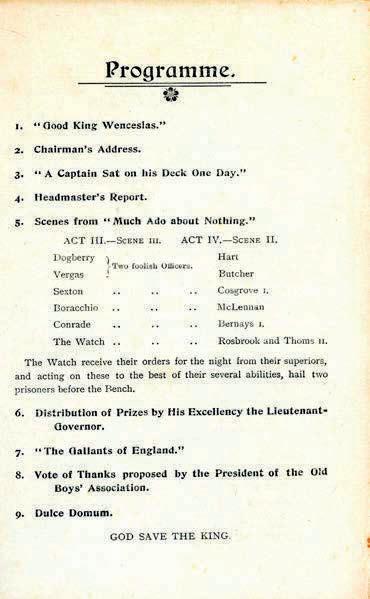
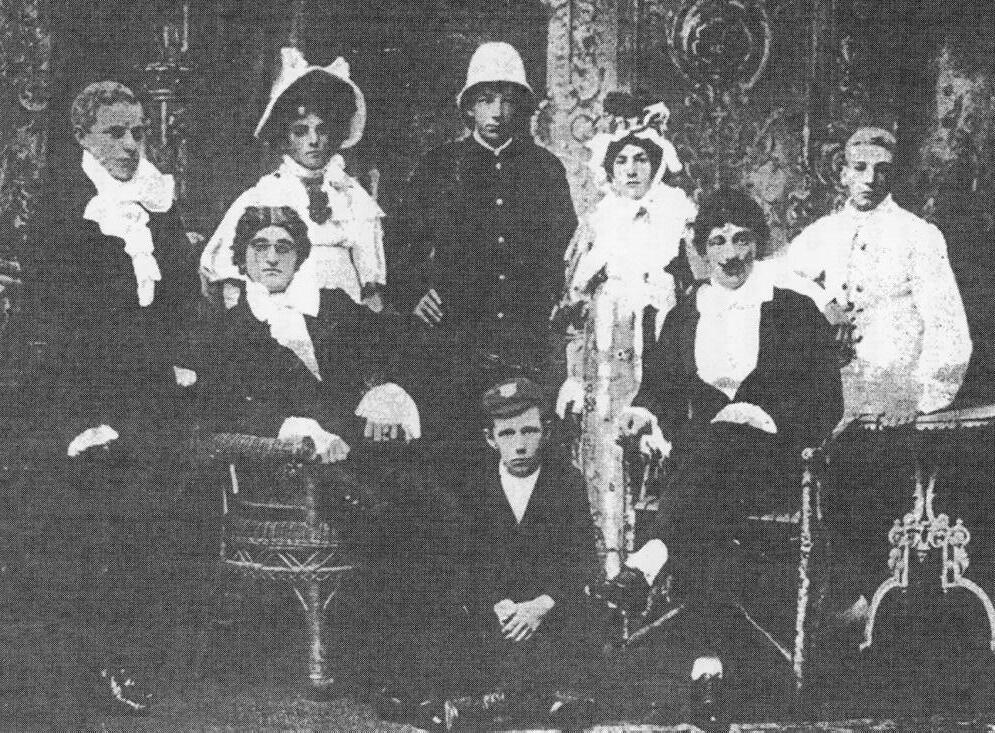
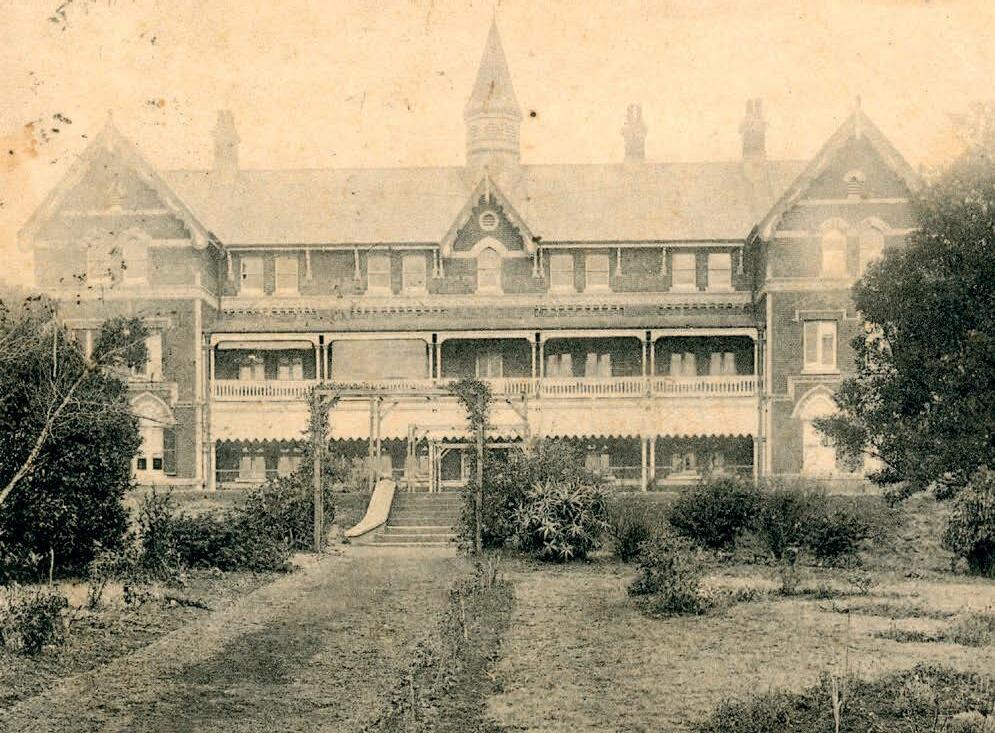
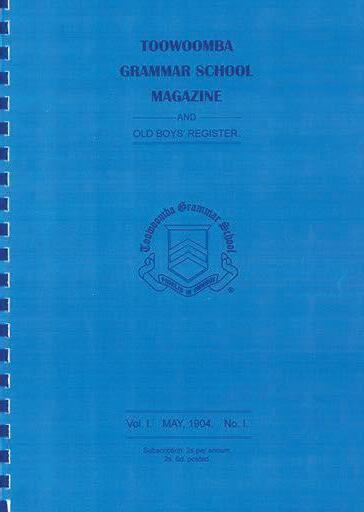
Chairman of the Board of Trustees: Sir Hugh M. Nelson (in his 2 nd year) then later, Mr Stanley Bruce Kennard (Sir Hugh Nelson died on New Year’s Day, 1906)
Trustees: Captain Brooke, Messrs Stanley B. Kennard, Richard W. Frost, Leopold F. Bernays, Colonel R.A. Moore
Headmaster: Mr. William A. Purves (in his 5th year)
Senior Prefect: Herbert Broadfoot and also in the following year. Five Prefects were appointed in this year.
Dux of Year: Herbert Broadfoot (for the second year)
Total School Enrolment: 89
Number of Dayboys: 56
Number of Boarders: 33
Staffing:
• In addition to the Headmaster (who also taught) were four other staff – Dr Ronald Hamlyn-Harris and Messrs James Leadbeater, A.A. Poole and Ernest Albert Gill.
Students:
• The School Prefects were Herbert Broadfoot, Alfred Hart, Thomas Henderson, Edward Steele, Ebenezer Simpson and Charles Thoms.
• Two students were successful in passing with honours in the Senior Public Examinations of the University of Sydney – Herbert Broadfoot (dux) and Alfred Hart.
• Allan ‘Copper’ Kent (1904-1905) was regarded as one of the best wicketkeepers in the School’s history (see 1932).
• Bob Meibusch (1905-1908) was quoted in the School’s Newsletter Blue and Gold in 1962 as recalling the famous occasion in 1905 when the TGS choir, under the direction of Mr Leadbeater, won the choral section of the Toowoomba Eisteddfod – and how their hopes of an undefeated record were rudely shattered when, a week or two later at the Warwick Eisteddfod, they came last. Mr Meibusch also recalled Mr Po ole, the Sportsmaster, introducing Australian Rules to the School, Rugby being played at weekends and “Rules” being played mid-week.
• School Prefect, Edward Steele, with the consent of his guardian, sold his horse and saddle and donated the proceeding five guineas to the School’s Laboratory Fund.
• A list of the names of boys, and their home town, who attended Toowoomba Grammar School from 1877 to 1905, was published in the 1905 edition of the School Magazine (May, vol.2 edition) on pages 41-50.
Buildings:
A ‘hospital’ was constructed during the year containing six beds. The Headmaster, Mr Purves, wrote in his annual report: The building is so arranged that after an infectious case the hose can be turned on ceiling, walls and floor. So far, mumps is the most deadly disease for which it has been needed. Mr Purves also referred to a case of scarlet fever during the year.
Events:
• Electricity was supplied in Toowoomba this year
• Sir Littleton Ernest Groom (1879-1883) contributed his reminiscences for a special Jubilee Number of the TGS Magazine in 1926. He recalled the Hon. Alfred Deakin when Prime Minister of Australia visiting the School. In 1905 Littleton Groom was a Cabinet Minister (Home Affairs) when Mr Alfred Deakin was in his second term as Prime Minister of Australia (he was Australia’s second, fifth and seventh Prime Minister). Presumably the visit to the School by Mr Deakin as Prime Minister of Australia was around 1905-1908.
• The Headmaster and Mrs Purves, together with some Trustees, entertained Lord and Lady Chelmsford at lunch at the School on 14 th December prior to the Speech Day and Prize Giving Ceremony.
• School Master, Mr Ernest Albert Gill, won the Golf Championship of Queensland.
• The Old Boys’ dance was held on 25 September in Alexandra Hall, the first floor of the Alexandra Building at 451-455 Ruthven Street.
• The School Magazine of 1905 congratulated an Old Boy, Mr Walter Trevethan, (1887 -1888) who had just turned out of his factory a 10HP motor car, this being the first manufactured in Queensland and one of the very few built to this date in Australia.
• His Excellency, the Lieutenant-Governor, Sir Hugh Nelson, especially procured from England an edition of Captain Cook’s voyages which was now out of print. He donated the book as a Prize for the best pass in the Senior Examination.
• On Wednesday evening, October 4 th, the boarders held their “breaking-up dance”. Dancing took place in the large school-room (now known as Old Hall) which was brightly decorated with flags and pot plants.
Co-curricular Activities:
• In Cricket, in November and being played in Ipswich, the 1 st XI cricket team was defeated by IGS by 14 runs – IGS 98 d TGS 84. A TGS bowler, Robert Robinson, took 5 wickets for 28 runs. A named photograph of the team is included in this year’s entry.
• In Rugby, the School’s football (Rugby) team beat Ipswich Grammar School 21 points to nil. A named photograph of the 1st XV team is included in this year’s entry.
• In September, the 1 st XV played a team representing The Armidale School on the R.A. Society’s ground. TGS was convincingly beaten, 23 points to nil.
• In football (rugby) the boys not only played IGS and The Armidale School but local teams including – the Rangers, the Gordons and the Australs. Staff Master, Mr W. Renwick, spent two or three afternoons a week in coaching the team.
• In August, in the presence of a large number of spectators at the Toowoomba Show Grounds (now the TAFE College and Cobb and Co. Museum in Lindsay Street, Toowoomba), a rugby match was played between the current boys and the Old Boys. The Old Boy Captain, H arold W. Gibson, won the toss and elected to defend at the Campbell Street end. The current boys won the match, 10-8.
• In Swimming, three of the School’s students participated in the Darling Downs Amateur Swimming Club Grand Championship Carnival held at the City Baths in February. A novelty event included ‘the worst dive’.
• In the School swimming carnival, “although late in the season, the day was fine and bright and the water quite warm enough for bathing.” One event was “diving for objects”. A photograph of the Swimming Club is included in this year’s entry.
• In Tennis, the first recorded game of tennis against Ipswich Grammar School was held. The IGS team arrived on the Friday and the following morning the tennis matches were held. IGS won on sets but TGS on games.
• In Music/Drama, a School Concert and Dramatic Performance was held in the Town Hall in June – ‘Satirical Musical Sketch’, ‘Bardell v Pickwick’.
• The School Choir won the School Choir Contest of the Austral Association Festival of 1905 from four schools in the competition. The points awarded were based on the following criteria: intonation and correctness; intensity of expression; qual ity of voice and production; attack, pronunciation and enunciation; and tempo and phrasing.
General:
• Dr Allan J. Gillison (1904 -1905) returned to the School in 1951 and some of his reminiscences were recorded in the School Magazine of 1951. They included : “ . . . it was always a matter of eager speculation whether "Doc" Harris, the chem. master, was going to give another public lecture in the Town Hall on the new discovery called bacteria (and so relieve us of homework to go and hear him and see his lantern slides!). . . . Whether Gill, the gym. master, would win the golf `champ.' the third time in succession and bring back the silver bowl for good and whether he would give it to the School; and whether 'Bump' Purves, the Headmaster - so dubbed for his gait - would get another wolf hound. . . . What a tremendous sense of duty, and what humanity was this man Purves. . . . Mr. Leadbeater might say that 'he would rather break stones than teach a boy like this,' but when he wandered in solitary state after school with his golf bag, and used to give me a chance to try my hand - what a great moment that was! . . . Gill drew a great circle of admirers every fine day after school when he teed several golf balls on the brow of the hill overlooking the dip to the sports pavilion and the distant gate at the tuck shop. I often did my Latin home -work better, not for the patient, scholarly "Bump," but to escape being kept in when Gill would be driving off! . . . At dinner-time and at every break we played left-handed cricket outside the School hall. . .”
Dr Gillison continued: “The "gym" was an open barn with a foot of tan bark to soften falls. We could use it freely, without supervision, whenever we were out of school, and some "day" boys used it to eat their mid-day sandwiches, and then spent the rest of the dinner -hour on the rings, the bars or the ladders, so that, with all this practice, they became the show gymnasts. A fair number of boys used to ride to school, and just let their horses free at the school door. A boy might spend two hours after school catching his recalcitrant nag. Yes, those were the days! “
The 1905 School Magazine, May, Vol.II, contained various advertisements. One such advertisement was for products retailed by Mr J. Wilkinson, a Chemist operating in Ruthven Street in Toowoomba. Amongst the ointments promoted in the advertisement was one labelled ‘Eclectric Ointment’ with the claim: “Cures chapped hands, boils, abscesses, rust nails or barbed wire wounds, dog, spider and insect bites. Just about the best ointment in the world for Psoriasis, dry and itchy eczema, all old eruptions, itches and ulcers. The ointment was advertised at a price of 1s.6d. per tin”.
President of the Old Boys’ Association
The President of the Old Boys’ Association continued to be Mr W. Buckland Taylor.
Guest Speaker at the Speech Day & Prize -Giving Ceremony: His Excellency The Governor, The Right Honourable Frederic John Napier Thesiger, Baron Chelmsford, distributed the Prizes to the boys. The ceremony was held in Alexandra Hall in the Alexandra Building in Ruthven Street in December. At the Speech Day and Prize Giving Ceremony, the Governor of Queensland included the following in his address to the boys: “I am trying to think what boy it was I had most respect for in the School when I went there as a small boy, and my recollections are these: I remember the feeling we had for the boy wh o was a scholar, but who would not make any attempt to join in the School games, and I felt also that though we admired him because he took the prizes, at the same time we felt he was not doing what he ought to do for the School. It did not matter very much whether the boy played games so well or not; the feeling was that the boy should do his best to play School games and take part in the School life. The boys we admired were the boys who were well up in work and well up also in play; these were the boys t hat the little boys worshipped. No boy is ever so big to his fellow as the boy at the top of the public school is to the small boy just joining the school, therefore we used to worship these boys…”
The Governor also said in his speech: “ Ánd then it is rather a pleasure to me when I come to a school to find a man (the Headmaster, Mr Purves) who has been at the same university as myself, and who has friends who are my friends also, and when Mr Purves and I were talking over things after lunch we found there were many men whom he knew that I knew also, though he left Oxford just as I was going to that University. It is pleasant when coming over the seas to find that there are here men who have come from England who are doing their best for Australia.” (applause).
In the Speech Day programme was a performance scene from Wildenbruch’s ‘Harold’ (i n German); a scene from ‘Through the Looking Glass’; and a scene from ‘School for Scandal’.

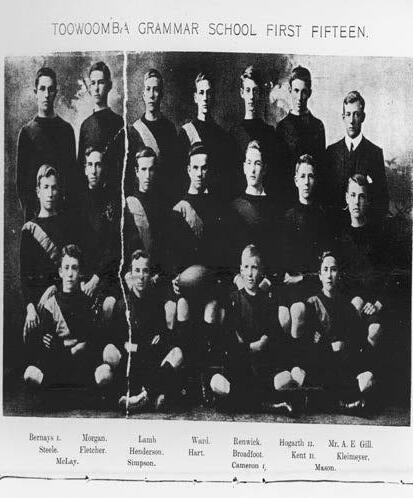

Chairman of the Board of Trustees: Mr Stanley B. Kennard (in his 2nd year) . A photograph of Mr Kennard is included in this year’s entry.
Trustees: The Trustees included Messrs Leopold F. Bernays, Richard W. Frost, Gilbert G. Cory, James Taylor, Angus A. McPhie, Colin Wardrop (and attending was the Board Secretary, Mr Robert Sinclair, but not a Trustee)
Headmaster: Mr William A. Purves (in his 6 th year)
Senior Prefect: Herbert Broadfoot (and Dux) and Edwin C. Bernays
Dux of Year: Herbert Broadfoot (for the third successive year)
Total School Enrolment: 100
Number of Dayboys: 57
Number of Boarders: 43
Students:
• The School Prefects were Herbert Broadfoot, Gerald Bernays, Ebenezer Simpson, Edward Steele and Arthur Ward.
• Herbert Broadfoot was Dux in 1904 -1906, Senior Prefect in 1905 -06, and Captain of Rugby in 1906.
• Allan ‘Copper’ W. Kent (1905 -1906) advanced to represent Australia in Rugby Union in one test match in 1912 which was played at Berkeley, California. He also played for Queensland in 16 games between 1909 and 1912. Due to ‘Copper’ Kent’s selection to represent Australia in his chosen sport, he is acknowledged on the Old Boys’ Wall of Achievement. Allan ‘Copper’ Kent’s younger brother, Henry Ronald ‘Roy’, was also known as ‘Copper’ (see 191 8).
• An extract of a letter written by Frank R. Mason (1904-1906) about his World War One experience is included in the ‘Events’ section of the 1916 year entry.
• A photograph of the students of the School is included in this year’s entry.
Buildings:
• One may compare the earliest photographs of the School (see photographs in the 1876 and 1887 entries) with that taken this year. The 1906 photographs illustrate two new wings added to the main building – an eastern wing and a southern wing. The southern wing extension included a
classroom, a boys’ common room and dormitory, a recreation room and new lavatories. The new eastern wing contained, in part, a large drawing room on the first (ground) floor which in later years was to be used as the little dining room, then the Staff Common Room, then the Board of Trustees’ Board Room (2002), and the Deputy Headmaster’s office (2023). On the first floor of the new extension were two bedrooms and a bathroom and on the second floor were two spare rooms which were open to any visitors who had to stay overnight. The School Magazine of 1906 quoted: “When these additions are completed, the institution will undoubtedly be the finest of its kind in the State.” In the photograph in this year’s entry of the new southern wing and the new water tanks one can identify the ‘Dog Box’ which was also constructed this year (see below).
• Despite this, the boarders’ living conditions continued to be spartan. There was no electricity or hot water at the School, nor a septic or sewerage system. Above the new southern wing was a new boarders’ common room, of the same size as the classroom. The room was lit by four incandescent burners and heated by a slow-combustion stove.
• Science Master (and School Librarian), Dr Hamlyn -Harris, assisted with the fund-raising from parents, staff and Old Boys (over 170 subscribers) to finance the construction of a new Chemical Laboratory room accommodating a class of 35 pupils. The building, a wooden construction, was officially opened on 25 April, 1906. It was located in the main building quad (see photograph in this year’s entry) and was later relocated nearer to the location of the current Hugh Rose Centre buildings. It was a small and somewhat ugly building and, over the School’s history, had a number of names and uses over its time – the ‘Lead-shed’ (in Mr Leadbeater’s time) and later The Dog Box or The Book Shop. In the 1950’s for some time it was the venue for the visiting barber to the School. The building was still standing in 1975 but its service as a specialist Geography classroom at that time had ceased. The Dog Box was the first classroom as a separate building away from the Main Building. The building had tiered seating to assist with its original use as a Chemical Laboratory. Later, in 2000, it was removed off-site to Dalby by Old Boy Robert Smiley (1976-1980) who has used it as an office at his real estate and house relocation business (see photograph in the 2000-year entry).
Events:
• The windmill fell down.
• In November, TGS Old Boy the Hon. L.E. Groom, Federal Attorney -General, visited the School. He spoke to the boys in the big school-room (now known as Old Hall). At the kind request of Mr Groom, a holiday was granted for the remainder of the afternoon.
• The Trustees were compelled to borrow two thousand, five hundred pounds from the Government for carrying out improvements and additions to the School as , at that time, they were very much overcrowded.
• An end of rugby season dinner was held in the Alexandra Pavilion involving sixty boys and several guests including the Headmaster. After dinner, a social evening included songs and various toasts.
• An Old Boys’ dance took place in the Alexandra Hall.
Co-curricular Activities:
• Swimming, football, cricket, boxing, athletics and tennis were offered to the boys.
• In Athletics, the annual Sports Meeting was held at the School in September. A report of the competition was included in the School Magazine which included the following: ”The School environments are most attractive. The bounteous rain had produced an emerald green, and the springy turf was decorated with flags of various hues. Additional charm and grace were given the spectacle by the attendance of many daintily-gowned ladies.”
• In Cricket, the School’s 1st XI Cricket team entered the Toowoomba Senior competition and in November the 1st XI lost in a match played at TGS against Ipswich Grammar School . The visiting IGS team arrived on Friday evening and the game started at 9:00am on Saturday. IGS won the game by 59 runs in the first innings. Gordon Renwick for TGS took 7 for 97.
• A named photograph of the 1 st XI team is included in this year’s entry.
• A cricket game, ‘Past v Present’, took place on 27 November and 1 December. The Old Boys were defeated by the current boys, 78 -145.
• In Rugby, the School’s 1st XV played in the Toowoomba Rugby Junior-Minor competition (5 clubs).
• A rugby match against the TGS Old Boys was keenly contested. It might have ended in a win for the current XV boys but in thick mist some of the Old Boys got ‘lost’ and then somehow succeeded in getting a try, thus making the match a draw.
• In a rugby match against Ipswich Grammar School played at Ipswich, the boys were successful by beating the Ipswich boys 45 points to nil – a winning margin not experienced previously. The Captain, Herbert Broadfoot, scored 28 of these points himself.
• In Swimming, sixty boys joined the School’s Swimming club. This year was the inception of the annual swimming carnival. A photograph of the members of the School’s Swimming Club is included in this year’s entry.
• A School camera club was in operation. The School Magazine of this year reported that not many boys were fortunate enough to possess a camera and therefore the Club had not a very large number of members.
• In Debating, the School Debating Society was formed.
• In Drama, performances of scene iii of ‘Wilhelm Tell’ (in German) and a scene from ‘The Rivals’ were held.
• In Music, a choir of twenty-one, conducted by Mr Leadbeater, represented the School in the Juvenile Choirs’ item of the Warwick competitions.
Guest Speaker at the Speech Day & Prize -Giving Ceremony : Mr Stanley B. Kennard – Chairman of the Board of Trustees (1906-09) in the absence of The Governor, Lord Chelmsford. The Ceremony was held in the Alexandra Hall, Ruthven Street.

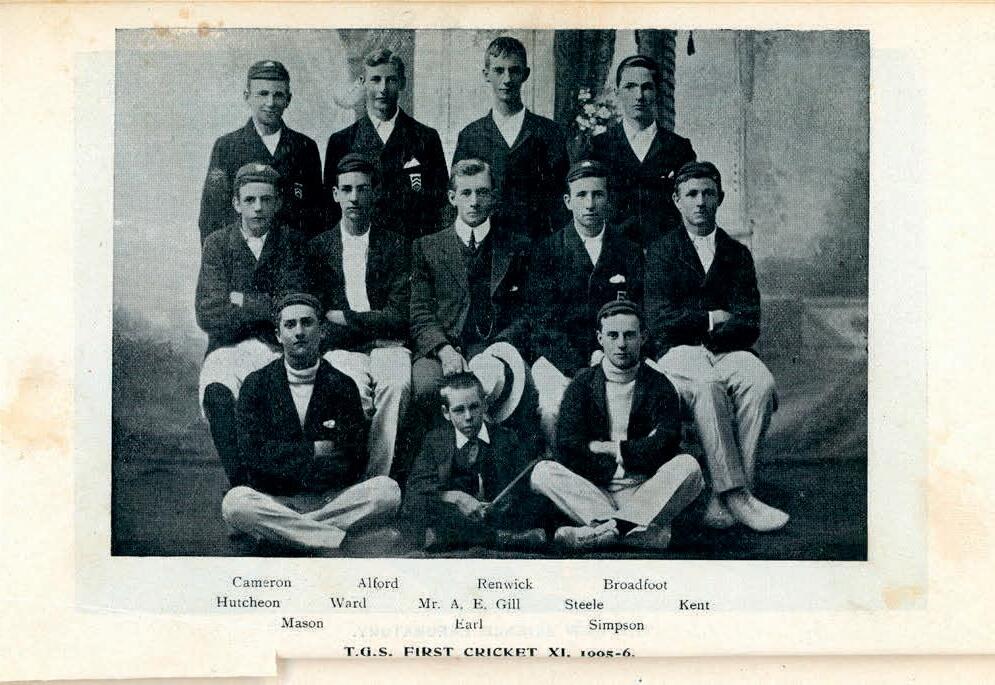
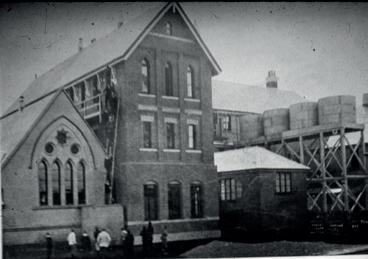



Chairman of the Board of Trustees: Mr Stanley B. Kennard (in his 3rd year)
Trustees: Stanley B. Kennard (Chairman), Gilbert G. Cory; James Taylor; Colin Wardrop; Leopold Ber nays; Richard W. Frost and Alexander McPhie.
Headmaster: Mr William A. Purves (in his 7 th year)
Senior Prefect: Ernest H. Hutcheon
Dux of Year: Ewen B. Cameron (1902-1907)
Total School Enrolment: 109
Number of Dayboys: 51
Number of Boarders: 58 (in this year the School saw more boarders than dayboys for the first time since 1878)
Staffing:
• The teaching staff administered examinations to the boys at intervals of about five weeks duri ng the year.
• Undermaster Mr A.A. Poole, who had been in charge of the Lower School for over three and a half years, suffered a nervous breakdown and resigned so that he could set out on an oceanic liner voyage to recuperate. His place was taken by Mr Tom C. Hewitt, a teacher of Science particularly Physics, who was an Old Boy of The King’s School, Parramatta. Mr Hewitt enlisted for active service in World War One in 1914 and was killed in action in France in 1916. A plaque acknowledging Mr Hewitt’s service is located in the School’s Old Hall. Mr Hewitt had been the Commanding Officer of the School’s Cadet Corps when it was reformed in 1907.
• Mr Gill resigned at the end of the year and transferred to Brisbane Grammar School. He was to return to Toowoomba Grammar School in 1909 but resigned again during the year.
Students:
• The School Prefects were Ernest Hutcheon and Ewen Cameron and ‘Junior Prefects’ were William Armstrong and Malcolm McDougall.
• Gordon Renwick and Arthur Ward were successful in the Matriculation Examination of Sydney University.
• Ewen B. Cameron was acknowledged for his performance in the Sydney Senior University Examination.
• Ernest H. Hutcheon (1902-1907) was the Senior Prefect in this year and also a talented athlete. Ernest competed for Australia in the Standing High Jump at the 1908 Olympic Games.
• William L. Stirling attended the School for only this one year and he was a boarder. At the end of the year he was presented with a leather bound and embossed TGS Prize Book (for his success in the study of Shorthand) signed by the Chairman, R. Frost, and dated December 12 th, 1907. This well-preserved book has the words Toowoomba Grammar School and its crest and motto Fidelis in Omnibus embossed on its front cover. The book is titled Half-Hours with the Telescope: A Popular Guide to the Use of the Telescope as a Means of Amusement and Instruction, written by R.A. Proctor (Longmans, Green & Co. London, 1907). William Stirling’s Prize Book was donated to the School and its Museum in 2023 by his son, TGS Old Boy (1943-1944) Roderick P. Stirling (see 1944).
Buildings:
• The Headmaster commented that this year will long be marked in the School’s history as the year which saw the completion of the new buildings. In the photograph in this year’s entry of the new southern wing extension to School House, one can also see the fire escape (with boys on the ladder), the new water tanks and the ‘Dog Box’ which was later moved away from this location in an easterly direction. The ‘Dog Box’ was the first classroom as a separate building away from the main School House building.
• A plaque given by the Dent family to honour the Australian bicentenary in 1988 is located on the exterior brickwork of School House where the doorway to the former Trustees’ Board Room is situated (now the Deputy Headmaster’s Office since 2023). The plaque reads: “Toowoomba Grammar School: From 1907 to 1946 this room was the Headmaster’s Parlour.” A photograph of this room is included in this year’s entry.
Events:
• A School Concert was held in the Town Hall in June to raise money for repairs to the tennis court (an asphalt court). The one tennis court in the School was deemed to be inadequate and they sought to raise funds for a second court and to erect a ball-proof fence around the courts.
• Colonel Lyster addressed the boys in the large hall (now Old Hall) on the Cadet system. The Colonel’s remarks were received with loud applause; three cheers for His Majesty the King, and the singing of God Save the King brought the meeting to a close.
• The boarders held their annual dance in November. A pianola provided the dance music and the girls in dainty frocks made a gay scene.
• An annual prize, donated by Old Boy, Mr F enton Robinson (1884-1888), was presented to the “manliest boy in the School” as voted by the boys.
• The first annual ‘smoke concert’ of the Toowoomba Past Grammar School Football Club was held in the Alexandra Hall with approximately one hundred people in attendance. There were various toasts made and trophies and medals presented. The concert included songs, recitations, boxing bouts, violin and banjo solos, and gramophone selections.
• The Past Grammar Rugby Football Club was founded this year.
• A new windmill was erected and the School had two new tanks, each of 2,000 gallons capacity, so there should be no lack of water.
• In the May edition of the School Magazine an advertisement titled ‘ Motor Cars For Hire’ was featured. The advertisement was for the Queensland Motor Importing Co. Ltd. and stated the company was the sole agents for all British Talbots, Singers and Star s. Three years later, in 1910, the Toowoomba Taxi-Cab Company Ltd. was established (see the ‘Events’ section in the 1910 entry).
• The Chelmsford Cup - The Governor of Queensland, Lord Chelmsford, later Governor General of Australia, offered a solid silver cup to stimulate sporting contests between Ipswich and Toowoomba Grammar Schools. A photograph of this magnificent cup is included in this year’s entry. In this the first year, Ipswich Grammar School won cricket (defeating TGS by an innings and 23 runs) and tennis and Toowoomba Grammar School won the football (rugby) and athletics competitions. With two wins each, the result for the Cup was a tie and the matter was refe rred to the Governor for adjudication. Lord Chelmsford awarded the Governor’s Challenge Cup to Toowoomba Grammar School because the School had a Cadet Corps and could have entered rifle shooting competitions. The last inscription on the Governor’s Challenge Cup (the Chelmsford Cup) was in 1969. As the Cup was won by TGS in this final year, the School held the Cup in perpetuity and it is on display in the School’s Museum (see 1964)
• During the years 1907-1930, TGS had won the competition for the Chelmsford Cup on fifteen occasions with IGS winning in four years (1909, 1918, 1920 and 1930). There had been five ties during this time. The Cup was not presented from 1941-1963 and the competition for the Cup between the two schools ceased after 1969. The Chelmsford Cup results between 1907 -1930 were recorded in the School Magazine, November 1930, on page 4.
• The first award of School Colours for excellence in sport was made.
• In Athletics, in the school athletics carnival held at the School, the Toowoomba Concert Ba nd played during the afternoon. Some excitement was caused by a novelty event, for which a large number of competitors entered with arms tied behind their backs. Racing to a small tub of water, the boys had to secure a piece of apple and return to the starting point. The School Magazine reported: “The spectacle of a score of heads butting each other for a place at the tub was decidedly exhilarating, though some parents looked apprehensive.”
• In Cricket, a local newspaper said of our 1 st XI cricket team that it was “the weakest that had represented the School for many, many years.” In the 1st XI cricket game against IGS on 15 -16 November in Ipswich as part of the Chelmsford Cup Competition, the TGS team wa s humbled by an innings and 23 runs. Only one TGS batsman scored more than 6 runs.
• In Rugby, the ‘past v present’ rugby match saw an easy win for the Old Boys.
• In Swimming, the annual swimming carnival of the School was held in March at the City Baths. The 1907 School Magazine referred to the strong appearance of the swimmers. On page 17 it stated: “Evidently that part of the School life which goes to improve boys physically and to make fine men of them is not neglected, for one was struck with the fine physique of many of them and all the events were very closely contested… Among the spectators were a large number of ladies who took a keen interest in the proceedings.”
• In Tennis, fundraising enabled asphalt tennis courts to be laid.
• In Cadets, see the ‘Events’ section of this year’s entry. The Toowoomba Grammar School Cadet Unit, as we know it today, was formed in May of this year. The initial strength was ‘a company of 60 boys, Commanding Officer up to rank of Captain, two Acting Subalterns, four Sergeants , four Corporals, six Buglers and two Drummers’. The command was given to Mr. R.L. Mason of the School, formerly of HMS Vivid.
• Also in May, Sergeant-Major Breydon, a drill instructor, drilled the prospective Officers and NCO’s. It was decided to have parades on Friday afternoons. In due course, sixty Martini-Enfield rifles arrived for the Cadet Corps, the rifles having seen service in the South African War. Twenty Francotte rifles were also issued to the School for the younger cadets (see 1908).
• A Drum and Fife Band was being formed.
• In Golf, Mr Leadbeater founded a Golf Club at the School.
• In Music, in October, a singing competition was held in the Schoolroom (Old Hall). There was a large attendance of boys and visitors.
• In Music/Drama, a concert was held in the Town Hall. The programme included musical items; a humorous and original sketch ‘Cure While You Wait’; a one -act drawing room play ‘Trust’; and a comic sketch ‘The Two Thompsons’.
Guest Speaker at the Speech Day & Prize-Giving Ceremony: Mr Richard W. Frost – Senior Trustee of the Board of Trustees (1890-1922) in the absence of Mr S.B. Kennard, Chairman of the Board of Trustees. The function was held in the Walhalla Hall. This Hall was situated between 131 and 133 Margaret Street on the northern side, near today’s Quest Apartments. In this year the Hall was part of ‘Misses Olsen Refreshment Rooms’. The Hall’s main use prior to 1914 was as a roller skating rink.
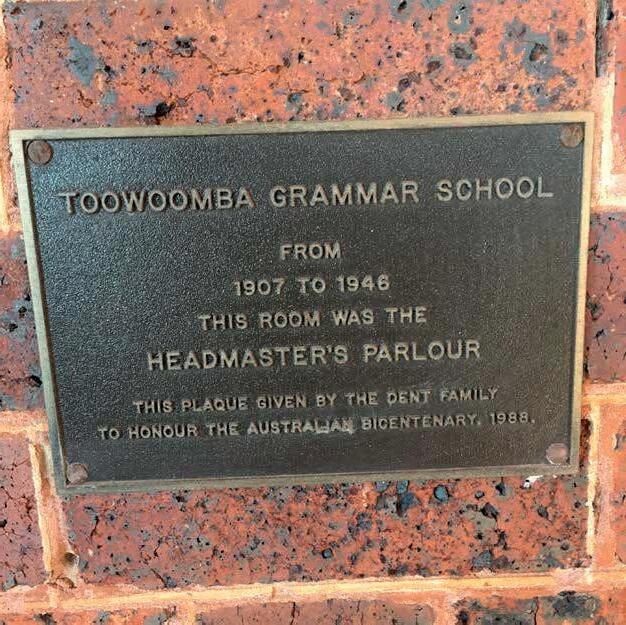
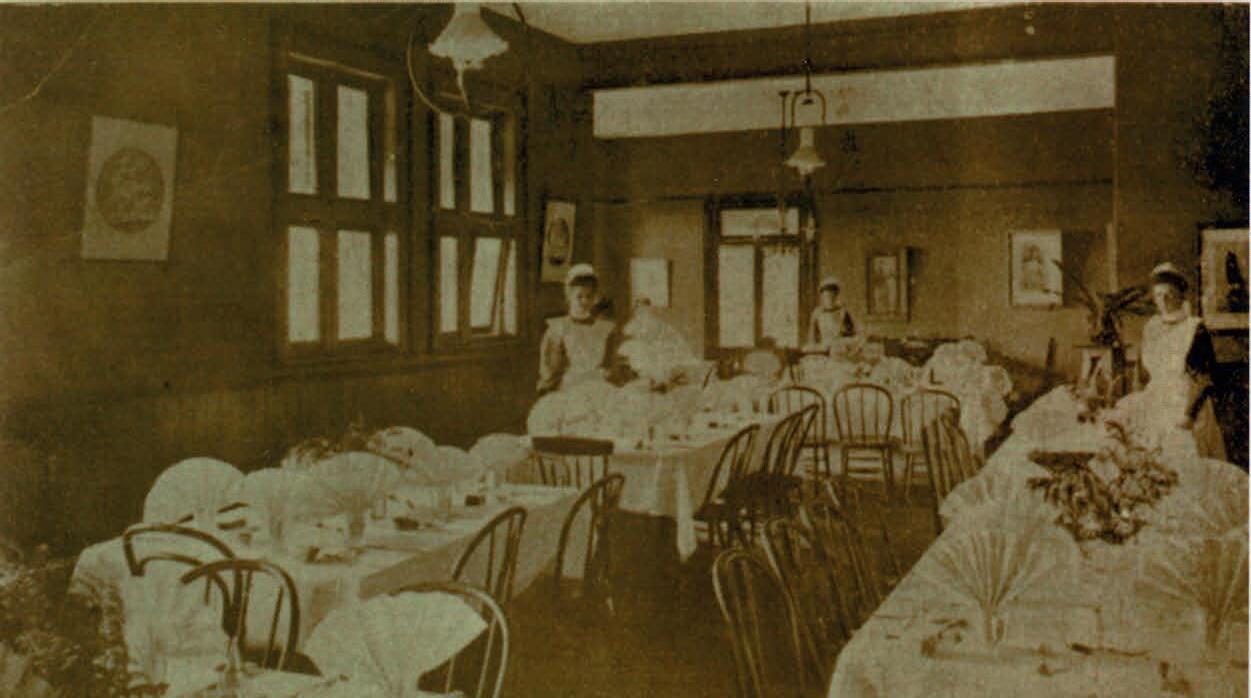
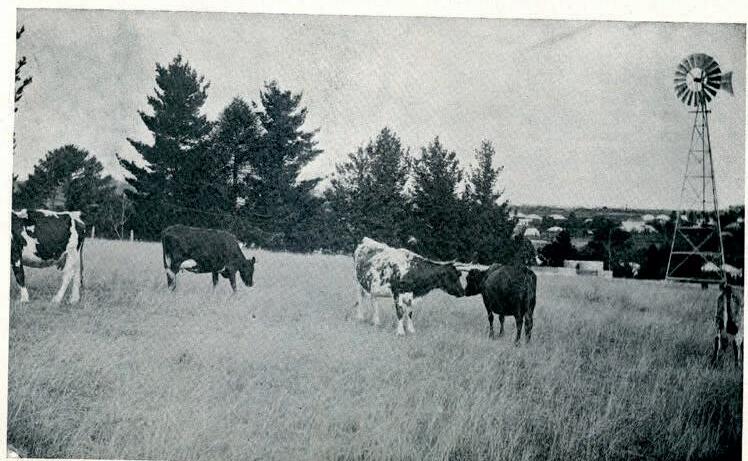
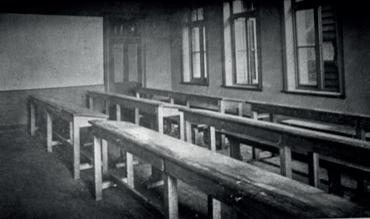
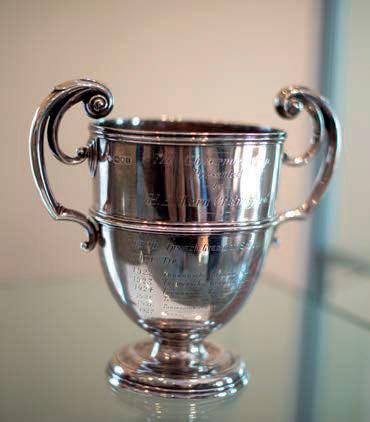
Chairman of the Board of Trustees: Mr Stanley B. Kennard (in his 4th year)
Headmaster: Mr William A. Purves (in his 8 th year)
Senior Prefect: Cecil C. Morton (1904-1908) (and Dux)
Dux of Year: Cecil C. Morton
Total School Enrolment: 129 (from 29 students in 1900)
Number of Dayboys: 60
Number of Boarders: 69
Staffing:
• The teaching staff increased to six, in addition to the Headmaster. The Staff comprised Mr J.G. Leadbeater, Mr R. Hamlyn-Harris, Mr T.C. Hewitt, Mr R. Gill (not E.A. Gill), Mr G.L. Challands and Mr F.H. Florance. At this time, teaching staff were not required to resign when the Headmaster resigned, unlike before the turn of the century.
Students:
• The School Prefects were Cecil Morton, Edgar Mansfield, Aubrey von Stieglitz and ‘Junior Prefects’ Albert Denniss, Clarence McDougall, Bernard O’Reilly and Arthur Steele.
• Frederick S. Cotton (TGS 1908), known more commonly as Sidney Cotton, was a Wing Commander during World War II and pioneered photographic reconnaissance. Earlier he had invented the World War I “Sidcot Flying Suit” used by the British Flying Corps in the open cockpit days of World War I. He also built Australia’s first light car in 1914. Wing Commander Cotton is acknowledged on the Old Boys’ Wall of Achievement.
• In 2012 a hallmarked sterling silver cup was donated to the School’s Museum. The cup was won by Cyril Richard Webb (TGS 1908 -1910) in 1908 for winning the School’s under 15 freestyle swimming championship.
• Cecil Morton, Senior Prefect and Dux, was acknowledged for his success in the Sydney Senior University Examination. In 2022 a silver cup presented to Cecil Morton in 1908 was donated to the School by his granddaughter. The cup was inscribed with the words “The Headmaster’s Championship Cup – Athletics – Sports – 1908”; the cup is now housed in the School Museum.
• Clarence ‘Clarry’ F. Mc Dougall (1905-1908) enlisted in August 1914 and landed in Gallipoli on May 9, 1915. ‘Clarry’ wrote letters to his parents about his wartime experience and these were published in The Chronicle newspaper at the time and reprinted in The Chronicle on 25 April, 2020. He was awarded the Military Cross for his gallantry . ‘Clarry’ also re-enlisted to serve with the Imperial Army in Brisbane during World War II from August 1942 until his death in 1945. A silver cup awarded to Clarence McDougall in 1908 is housed in the School Museum and a photograph of this cup is included in this year’s entry.
Events:
• The annual sports meeting was held on the school grounds in September. Over 300 people visited the grounds. One event was a tug-of-war contest between boarders and dayboys. The senior event was won by the boarders and the junior tug-of-war was won by the dayboys. A 50-yard egg and spoon race was also held as a novelty event.
• Alan J. Campbell (1908-1910) in his memories of the School written in the TGS Centenary Magazine 1975 (February 1976, Volume 68, page 85) recalled his experiences with the cane. He wrote: “Experiences of contact with the cane remain most vivid in my memo ry, but, contrary to modern opinion, we never seemed to harbour resentment as a result of such punishment. Once Mr Florance accused me of being the aggressor in a fight in the passageway. He told me to bring him a stick with which to punish me. In the backyard I found a 6 x 1 flooring board, six feet long, which I dragged (not carried) upstairs and along the passages to his room. When I presented him with this ‘stick’ he could not help but laugh! However, he cleared his room, leaving one chair over which I was instructed to bend. With six strokes with the board he shattered it and I had to return it to the rubbish heap, and with a well-bruised backside.” Alan Campbell also recalled the boys throwing the new boarders under the icy cold (never any hot water) s howers. By doing this on one occasion Alan was delivered six strokes by Mr Hewitt, not by a cane but with the long handle of his golf driver.
• The TGS Old Boys’ Association formed a ‘Past Grammar School Cricket Club’ to be affiliated with the Toowoomba Cricket Union. The President was Mr R.G Wonderley The first match was in the 1911-1912 summer season and the Club was later known as the Past Grammars Cricket Club. There was no requirement upon members or players to be TGS Old Boys. The Club folded into the (SWQ) University Club around 1975.
• Boarders, in groups of around six, spent long weekends camping in nearby scrubs , such as near Helidon. Observing wildlife was a major interest.
Co-curricular Activities:
• In Athletics, three hundred people visited the School grounds for the annual sports meeting.
• As part of the competition for the Chelmsford Cup, the School’s athletics team was successful against IGS
• In Cricket, the 1st XI was defeated by IGS when playing in Ipswich in November.
• A past students’ versus current students’ cricket match was played and a photograph of the teams is incluced in this year’s entry.
• In Lacrosse, a Lacrosse Club was formed in April and attracted a membership of 30 boys. It was the first Lacrosse Club in Toowoomba. A photograph of members of the Lacrosse team is included in this year’s entry. Pictured are: (Front) - Gall, Thomson (Middle) - Mansfield, Clark, O’Reilly, Hornbrook, Nisbet, Paterson and (Back) - Tate, Barton, Morton, Mansfield and Mr Florance.
• In Rugby, as part of the competition for the Chelmsford Cup , the TGS 1st XV team was defeated by IGS, 9-13. One of the TGS front row players missed the train to Ipswich!
• In Shooting, a shooting team was organised from within the ranks of the Cadet Corps and won two cups and a considerable number of trophies in ensuing years.
• In Swimming, in the annual swimming carnival held in March at the City Ba ths a new event was included in the programme – the Royal Humane Society (RHS) Life Saving Championship. It was included in the programme at the instigation of the Hon. L.E. Groom, Federal Attorney -General (and Old Boy).
• In Tennis, competing against Ipswich Grammar School as part of the Chelmsford Cup, the School’s tennis team had a win with the final result being TGS 4 rubbers, 10 sets, 88 games defeat ing IGS 4 rubbers, 9 sets and 87 games.
• In Cadets, this was the first formal year of the Cadet Unit. The command was given to the Physics Master, Mr T.C. Hewitt, who already held a commission in the 11 th Regiment, AIF. Mr Hewitt was later killed in action during World War One. The Cadets were supplied with uniforms and twenty new Wesley-Richards rifles. A drum and fife band was formed by Mr Leadbeater and a photograph of the band is included in this year’s entry.
• The Cadet Unit’s first Ceremonial Parade in public took place in Queens Park on 20 March. The first uniforms were issued to the cadets in this year.
• The School’s Cadet Light Horse unit trucked their horses at Toowoomba Railway Yards on Thursday, 16 April for Brisbane. After travelling all night they reached the suburb of Mooraree (now Murarrie) and marched into camp six miles distant. During the afternoon the Governor came into camp and attended a parade. On Monday the cadets had to strike camp and that night the mosquitos were “bad beyond decree” for the boys slept in the open, their tents and kits having been packed away. The Cadets had to water, groom and feed the horses over the expedition which included a journey to Sandgate and to Enoggera. At Enoggera the horses were dipped as a precaution against ticks. At 6:30pm Friday evening the boys and horses went to Normanby Station and returned to Toowoomba at 5:00am Saturday morning.
• A photograph of the School’s Light Horse unit is included in next year’s entry.
• In Music and Drama, the Headmaster and Staff encouraged choirs, concerts and dramatic functions. Visiting speakers were also popular. During the years 1908-1916 mention is made of ‘Minstrel Concerts’ at the School.
Guest Speaker at the Speech Day & Prize -Giving Ceremony: His Excellency The Governor, The Right Honourable Frederic John Napier Thesiger, Baron Chelmsford. A photograph of the Speech Day and PrizeGiving Ceremony program is included in this year’s entry.
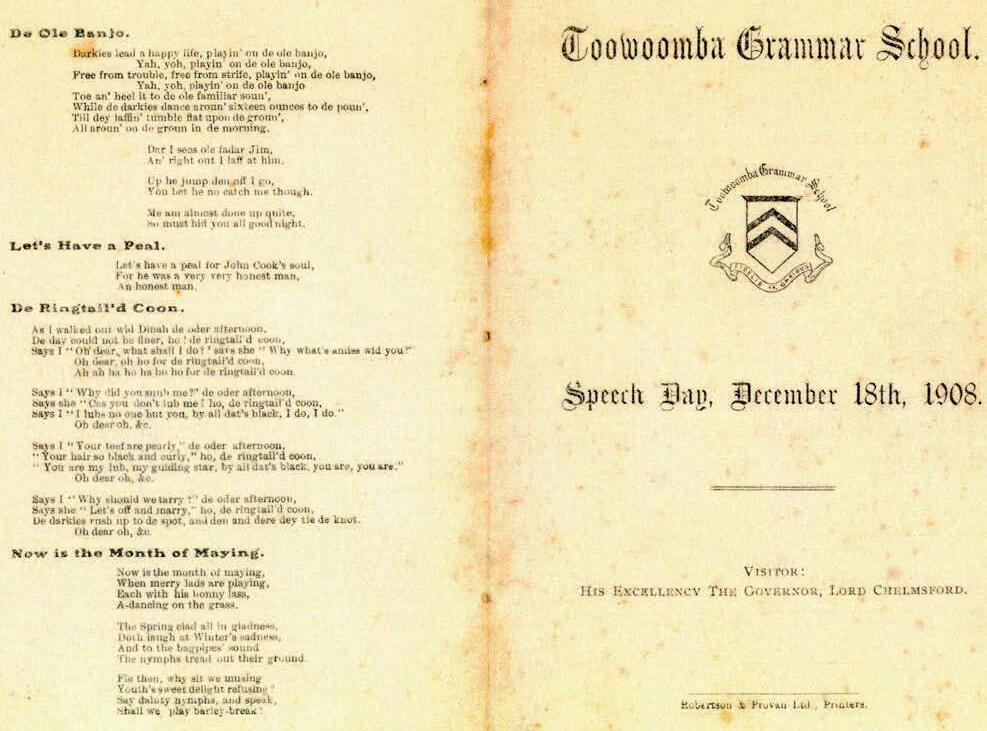


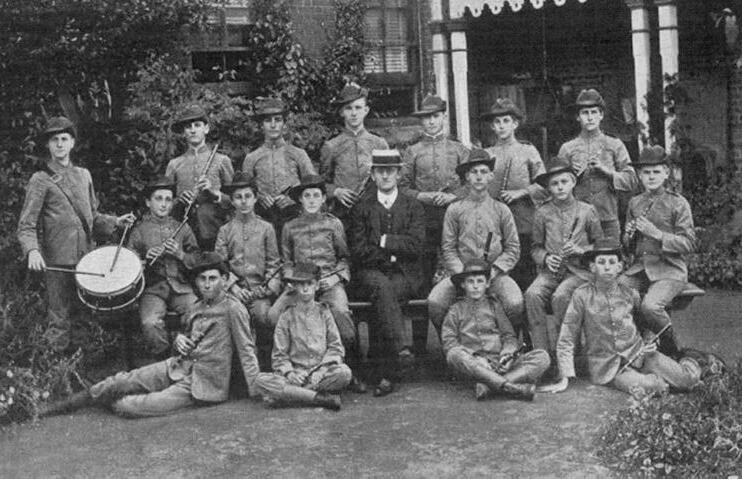
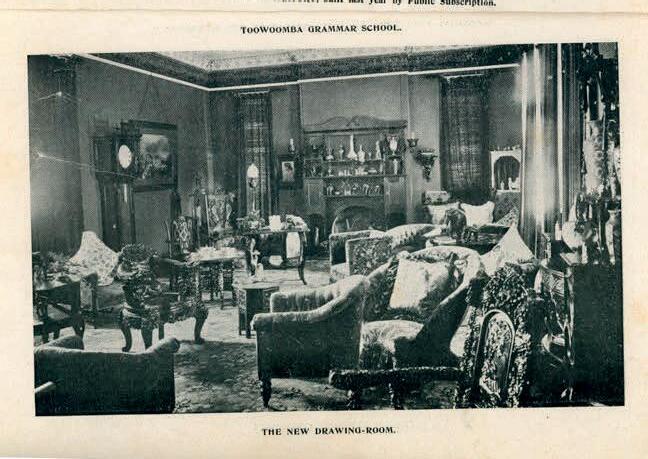
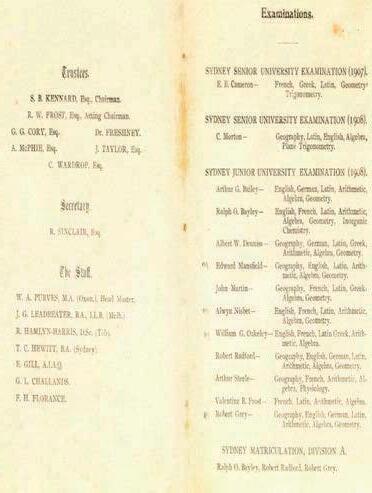

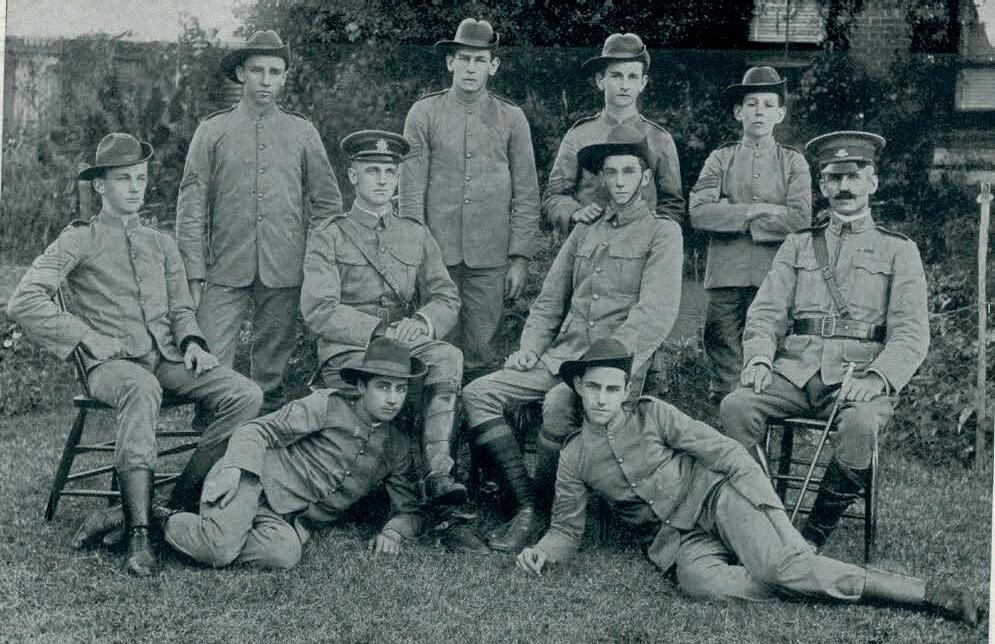
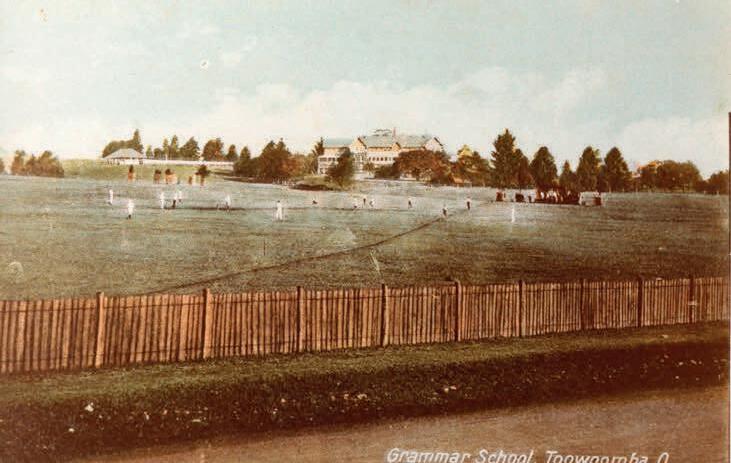

Chairman of the Board of Trustees: Mr Stanley B. Kennard (in 5th year) concluded his service as Chairman.
Deputy Chairman: Dr R. Freshney
Headmaster: Mr William A. Purves (in his 9 th year)
Senior Prefect: Edgar H.R. Mansfield
Dux of Year: John Martin
Total School Enrolment: 165
Number of Dayboys: 89
Number of Boarders: 76
Staffing:
• A photograph of the staff is included in this year’s entry.
• Mr Ernest A. Gill (Sportsmaster) resigned from the School , having returned to the School earlier this year following two years at Brisbane Grammar School. Mr Harvey, an Oxford graduate and Rhodes Scholar, replaced him.
Students:
• The School Prefects were Edgar Mansfield, Richard Barton, Cyril Clowes, John Martin, Alwyn Nisbet and William Oakeley.
• Charles Fortescue (1907-1909) was reported in the School Magazine of November 1915 as having won a Military Cross. Almost the first Gallipoli Honour fell to Charles after he left Australia as an Officer of the famous 9 th under Major (later Lieutenant-Colonel) Campbell Robertson, another TGS Old Boy. Shortly after landing, the superior officer of his platoon and the larger part of the platoon itself were shot down. Lieutenant Fortescue found himself in command of the remnant which held onto the front trench for over three days without sleep or rest. He was slightly wounded then but more seriously on another occasion. After a brief period in England, where he was presented to the King, he returned to duty.
• Charles Fortescue was quoted in the School’s Newsletter Blue and Gold in 1962 as recalling: “the mounted division of the Cadet Corps, consisting of all those boys who rode to school – a pretty irregular-looking lot, whose steeds ranged from midget ponies to giant stallions, but whose pride was high nonetheless.” In later years Charles Fortescue was to have a distinguished war record. On 25 April 1915 he landed at Gallipoli commanding the right flank of the unit’s covering party.
He was Commanding Officer, 25 th Battalion CMF, later the 11th Light Horse Regiment CMG and the 1st Australian Garrison Battalion. Colonel Fortescue was a member of the School’s Board of Trustees from 1922 to 1934 and between 1922 and 1939 he was four times President of the TGS Old Boys’ Association. With the opening of the L.A. Boyce Boarding House in 1969, one of the four dormitories was named in Colonel Fortescue’s honour (see 1969). Colonel Fortescue is acknowledged on the Old Boys’ Wall of Achievement. Colonel Fortescue passed away in 1971 and in 1995 his family presented to the School his numerous medals and citations in a magnificent, framed display now housed in the School Museum. A photograph of this display is included in this year’s entry. In the following year the Fortescue family presented Colonel Fortescue’s ceremonial sword where it is currently on display in the School Museum. The School was delighted to welcome Colonel Fortescue at the 1964 annual dinner of the Old Boys’ Association (and a comment was made that the Colonel did not look a day over forty years old).
• In this year student Thomas M. Lloyd won a Speech Day and Prize Giving Ceremony book acknowledging his academic achievement in his study of History and Geography. This prize book was located in Tokyo in a second-hand bookshop in 2007 and kindly returned to the School.
• Pictured in this year’s entry are the ‘Scholarship Boys’ – (Standing) - George Newton, Roy Alexander, Norman Coote and Walter Wippell; (Sitting) - Joseph Hogg. Note the boys are wearing the TGS straw boater hat as also seen in one of the student photographs in the 1905-year entry. Even in the mid to late 1920s the boys were still required to wear the boater hats to Church on Sundays.
Events:
• Saturday evening entertainment concerts were held in the large schoolroom (now Old Hall).
• This year it was decided to give blazers to the members of the 1st XI and 1st XV. The 2nd XI could also obtain them, but with the difference that they were not allowed the School badge on the pocket. The blazers were dark blue, hemmed with gold braid.
• One hundred of the School’s Cadets formed a Guard of Honour to his Excellency, Lord Dudley, when he visited Toowoomba in August. The next day, fifty TGS Cadets, together with cadets from other schools, marched to the Showgrounds in order to form a guard to the Governor General who was to open the Show. Photographs of the Cadets are included in this year’s entry.
• During the Michaelmas holidays some energetic people started making a miniature shooting range. Later in the term it was finished but Cadets were not allowed to use it until it had bee n officially inspected and approved.
• In the annual Old Boys versus current 1st XI cricket game, the Old Boys were successful in winning by 67 runs.
Co-curricular Activities:
• The boys could participate in a range of co-curricular activities including Cadets, the Camera Club, the Choir, Dances, Boxing, the Debating Society, the Black and White Club (an art group specialising in pencil and/or charcoal sketching), the School Magazine Committee and the Science Museum Club.
• The annual School Dance was held in the Alexandra Hall in the Alexandra Building in Ruthven Street. The School Magazine reported: “…the many dainty frocks made a gay scene.”
• In the Chelmsford Cup competition , Ipswich Grammar School was victorious. Toowoomba Grammar School lost the football (rugby), cricket and athletics competitions but won tennis, shooting and swimming.
• In Athletics, at the School’s annual sports day held in September on the School grounds, some interesting events included kicking football (junior and senior), special drop kick, throwing cricket ball (senior and junior), a Siamese race etc.
• In Cricket, in the Chelmsford Cup competition, the 1st XI played IGS at Ipswich on Saturday, 27 November. IGS won the game by 71 runs on the first innings.
• In Rugby, in the Chelmsford Cup competition, the IGS rugby (then called football) team arrived in Toowoomba by the mail train at mid-day on a Saturday and they won the game, 9 -6. A photograph of the TGS team is included in this year’s entry.
The School was saddened to hear of the passing of the inaugural President of the Old Boys’ Association, Mr W. Buckland Taylor, in the Christmas holidays. Mr Taylor had been the President from 1901–1909.
Guest Speaker at the Speech Day & Priz e-Giving Ceremony: Professor T.W. Edgeworth David, Professor of Geology, The University of Queensland, and Antarctic Explorer.
The Ceremony was held at the Town Hall and this venue continued to be used for the School’s annual Speech Day and Prize Giving Ceremony until 1924. At this time the School House front lawn was used and this practice continued up to the final construction of the School’s Assembly Hall in 1964.

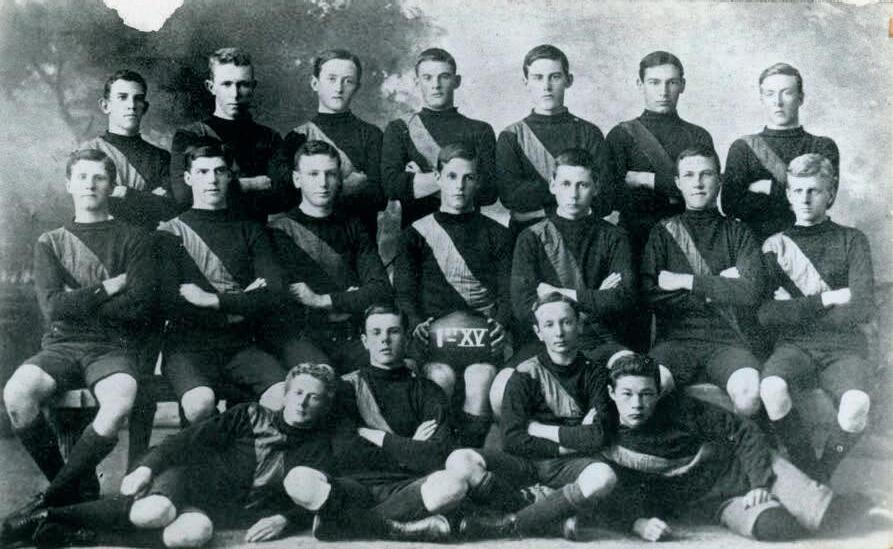
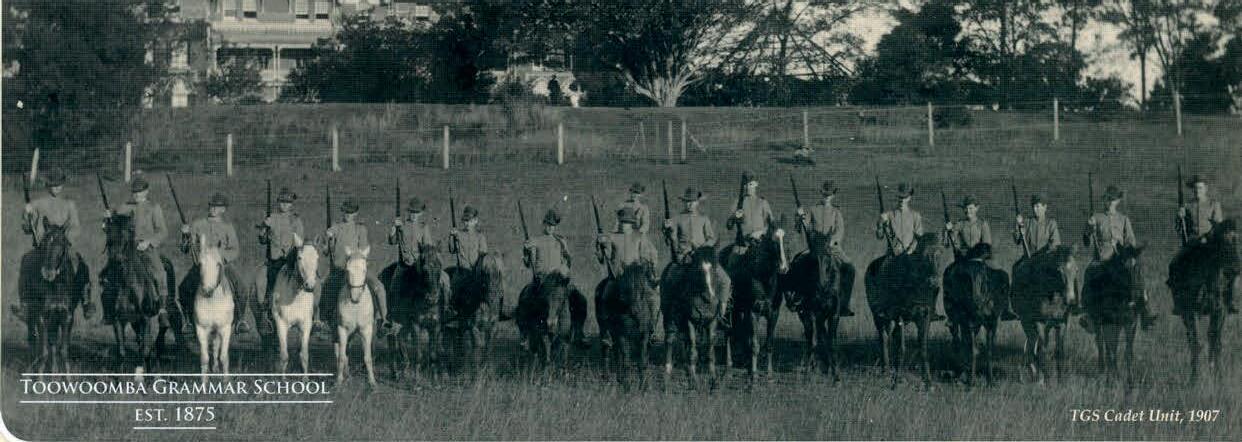
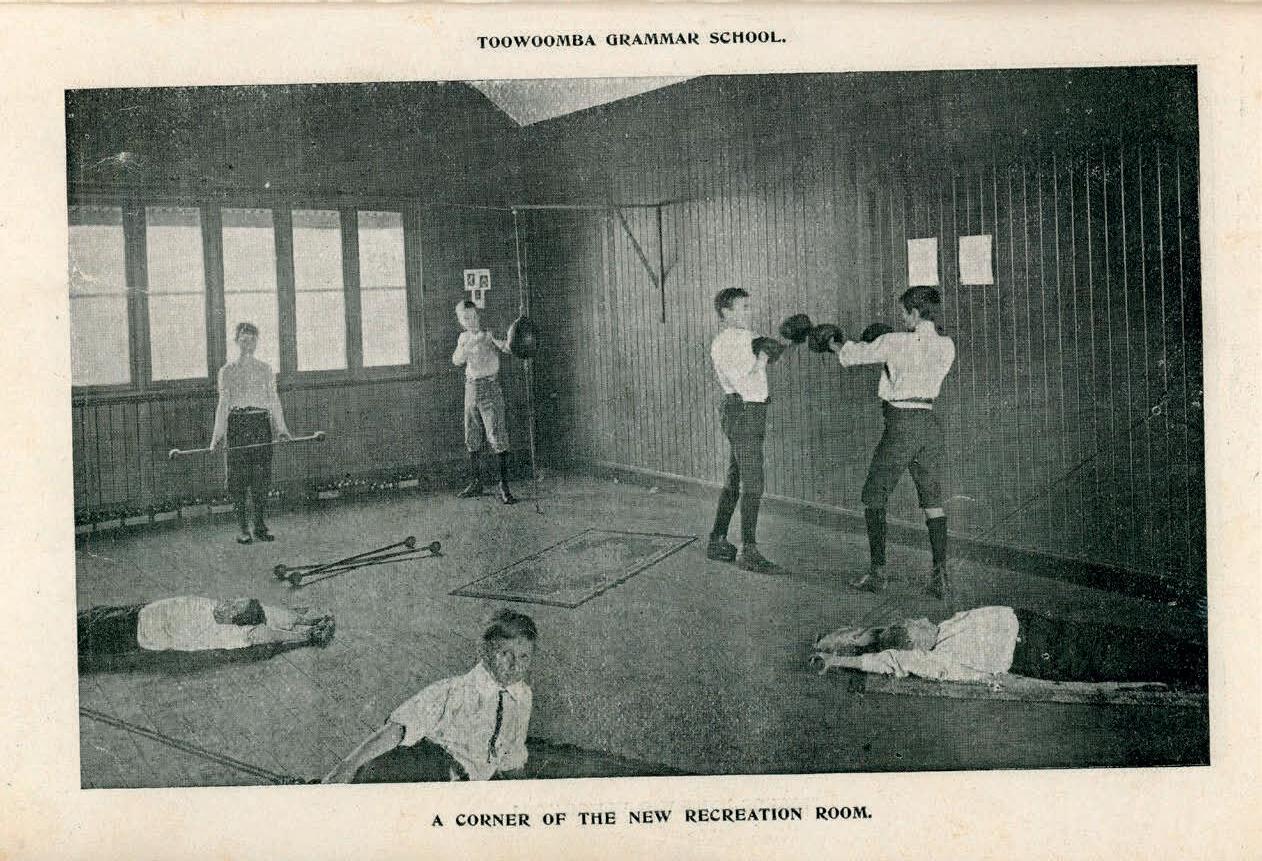



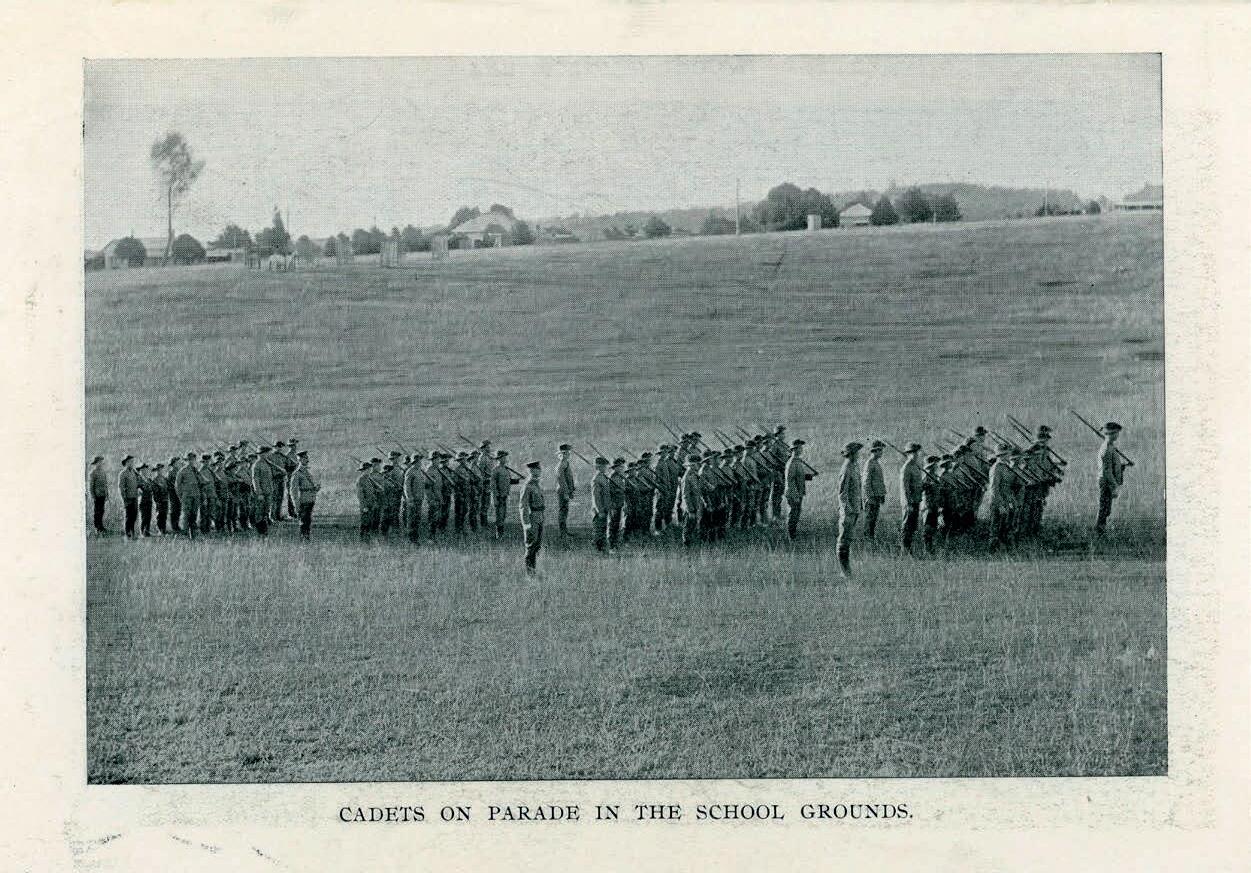
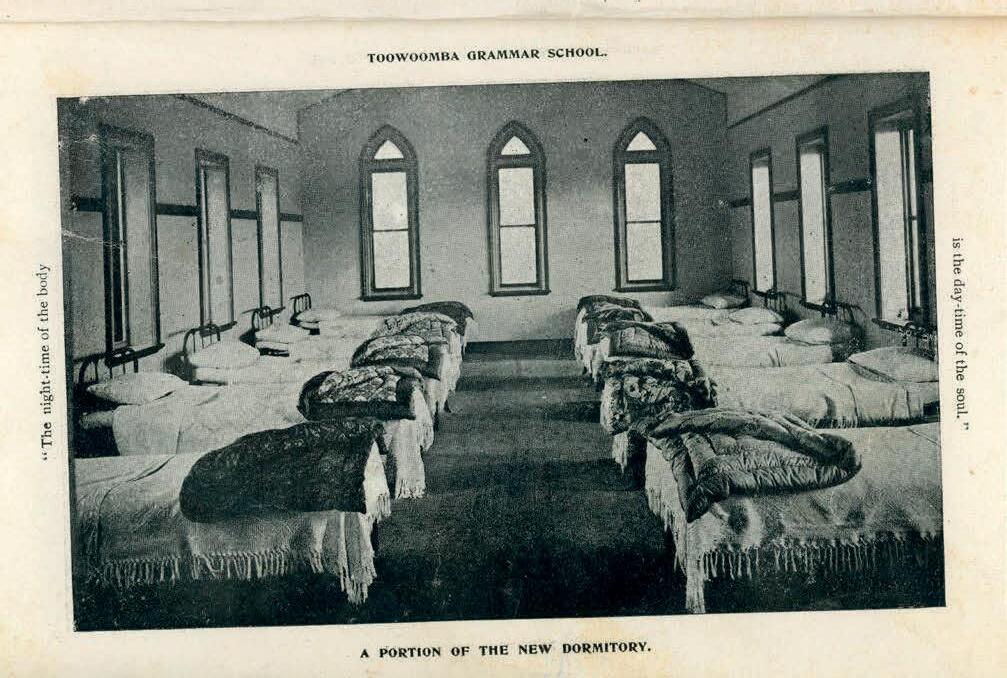


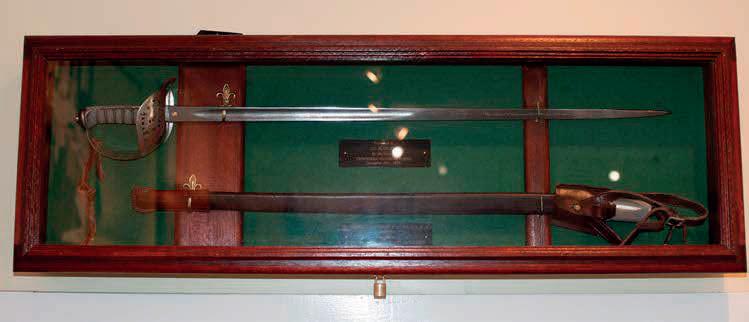

Chairman of the Board of Trustees: Mr Richard W. Frost (for one year)
Trustees: Mr Richard Frost (Chairman); Mr Reginald Freshney, Mr Alexander McPhie, Mr Leopold Bernays, Mr Gilbert Cory, Mr James Taylor, and Mr Colin Wardrop. Mr Robert Sinclair was the paid Secretary.
Headmaster: Mr William A. Purves resigned in Marc h of this year and went to the Sydney Church of England Grammar School (‘Shore’) as their third Headmaster. Mr Purves retired as Headmaster of ‘Shore’ in 1922. It was said that Mr Purves “uplifted the School from less than mediocrity to be one of the foremost public schools of the Commonwealth”.
In May, Mr George Pitty Barbour commenced his Headship, to become the longest -serving Headmaster in the School’s history for 26 years (1910–35). (see below)
Second Master: Mr James G. Leadbeater who held this position from 1910 to his retirement in 1937.
Senior Prefect: John Martin (and Dux)
Dux of Year: John Martin
Total School Enrolment: 161
Number of Dayboys: 74
Number of Boarders: 87
Staffing:
• The School’s seventh Headmaster, Mr George Barbour, had been a Classics Master at Sydney Grammar School for 22 years (including being Deputy Headmaster) and a Classical tutor at St John’s College in The University of Sydney. Mr Barbour was a fine scholar with a Master of Arts degree from Sydney University, gained the Sir Daniel Cooper scholarship in Classics and founded and edited the Sydney University magazine Hermes for two years. Mr Barbour was also an extremely talented sportsman. He was a member of t he first Australian Cricket Board of Control 1906-1909, (Chairman 1907-1908) and a selector for the NSW team. In addition, he represented NSW in two sports: in Rugby Union against Queensland in 1888 and in Tennis (also against Queensland in 1891). Mr Barbo ur was also an exceptional golfer. Mr Barbour retired from the School in June 1935 after 26 years as Headmaster (the longest-serving Headmaster in the School’s history). Mr and Mrs Barbour then returned to Sydney to lead an active life in retirement. Mr Barbour passed away at the age of 84 on 17 September 1951. Current students would be aware that Barbour Oval was named after Mr Barbour as was the Barbour Classroom Block (built in 1980-1981). Each year a subject prize is presented at the School’s Speech Day and Prize Giving Ceremony, the G.P. Barbour Memorial Prize for English (since 1963) and initially awarded in 1948 as the G.P. Barbour Prize for Senior Prefect.
• With the Headmaster’s encouragement, six members of his teaching staff were ardent weekend players of golf. Three of them also served terms as Honorary Secretaries of the Toowoomba Golf Club.
• Within three months of taking duty, Mr Barbour convened a meeting of Old Boys to start a fund to improve the School’s cricket ground. In April 1913 the new ova l was opened.
• Dr Hamlyn-Harris (on staff 1903-1910) was appointed as Curator of the Brisbane Museum.
• In this year there was a total of eight full-time members of staff.
• Mr Henry L. Harvey commenced teaching in February and was on staff for 2 years and 7 months. As a teacher of Mathematics and Science and Sportsmaster, he had been a Queensland Rhodes Scholar in 1906 graduating with a B.A. from Oxford.
• A photograph of the Staff in 1910 is included in this year’s entry. (Standing) G.L. Challands, H.L. Harvey, T.C. Hewitt, (Seated) J.G. Leadbeater, He admaster W.A. Purves, Dr. R. Hamlyn-Harris, (Front) F.H. Florance, E.A. Gill.
Students:
• The School Prefects were John Martin, Cyril C lowes and ‘Junior Prefects’ Albert Thelander and John Arthur Thomson.
• John Hornbrook (1907-1913) was an extremely talented sportsman. In this year he captained Athletics, as he did for the next two years. He was also the School’s Senior Prefect in 1911 and 1912. In 1912 he scored a century (126 runs) in a 1 st XI cricket game against Newington College, Sydney.
• At this time, it was a commonplace and accepted practice for the School Staff to join the students in school sporting competition. In this year Cyril Clowes was Captain of the 1 st XI Cricket team and the 1st XV. With the new Headmaster, Mr Barbour, he made a record partnership of 234 runs for the 2nd wicket in ‘A’ Grade Toowoomba Cricket. Mr Barbour w rote of Cyril Clowes: ‘a thoroughbred amongst batsmen’. Cyril (1908-1910) was later to be Lieutenant -General Cyril Clowes, the Commander of the 1 st Australian division “Milne Force” in its defeat of the Japanese at Milne Bay in 1942. After leaving school he joined the inaugural intake at Royal Military College, Duntroon, Canberra, together with his brother Norman. When the L.A. Boyce Boarding House was opened in 1969, one of the four dormitories was named after Lieutenant -General Clowes. Cyril Clowes features in the 1st XV Rugby photograph in this year’s entry, middle row holding the ball.
• Norman Clowes (1909-1911), together with his brother Cyril, are acknowledged on the Old Boys’ Wall of Achievement. After Duntroon, Norman gave distinguished service in two World Wars and was appointed ADC to King George VI from 1946 – 1949. Norman Clowes, with his brother Cyril, also features in the 1st XV Rugby photograph in this year’s entry
• Neville G. Hatton (1909-1910) served at Gallipoli and in France during World War I. He later was a member of the Officer Guard of Honour to King George VI at the opening of Australia House in London. In 1940-1942 Brigadier Hatton was Commander of the 8 th Military District of Papua New Guinea and is also acknowledged on the Old Boys’ W all of Achievement. His son, LieutenantColonel William ‘Bill’ Neville Hatton (1940-1944) was, for many years, the Commanding Officer of I Cadet Brigade (Queensland).
• Also acknowledged on the Old Boys’ Wall of Achievement is Eric H. Partridge (1908 -1910) who became an author (of over some 60 books), publisher and an acknowledged world authority on the English language. He was a Lecturer in English at Manchester University, England. In the
1970’s the University of Queensland awarded him an Honorary Doctorate of Letters (D.Litt) and the Australian Academy of the Humanities elected him an Honorary Fellow. In 1918 the School received a copy of a Battalion Magazine sent from France by its Chief Editor, Eric Partridge. The School claimed it was quite the best of its kind. Each year a subject prize is presented at the School’s Speech Day and Prize Giving Ceremony, the Eric Partridge Prize for English Communication. Eric Partridge lived in England for over 40 years.
• One of Eric Partridge’s (above) books , in part, refers to the horror of warfare and the death of former TGS Science Master, Mr Tom Hewitt . The article was titled The Somme - 1916 (Refer to the 1916 year entry).
• Alan J. Campbell (1908-1910) was President of the Australian Country Party in Queensland from 1943-1951 and for sixteen years was a State and Federal Trustee for that Party
• Randle C. “Rah” Houston (1909-1910), a boarder from Mackay, wrote a war-cry which was quickly adapted as the official war-cry for the boys of this School. He later served in World War One and lost his life in World War Two. This war-cry is still being chanted by Toowoomba Grammarians over one hundred years later. The war-cry was initiated through the School’s involvement in a sporting competition, The Chelmsford Cup. Randle “Rah” Houston’s original version of the warcry was:
Hey A, Hey A, Hi Balliwanga
Hey A, Hey A, Hi Ompra, Ompera, Ompilliago
Poor Crew Guy Ric, Ric, Ricketty Rick
Austi Austi I
Perry Werry Winkle
Ting Tong Tiger
Hey A, Hey A. Hi (see ‘Students’ 1923). The School Museum holds Randle’s silver serviette ring from his school days with his initials ‘RH’ engraved on it. This was donated to the School by his granddaughter in 2021.
• In the School Museum is an audio recording of an interview between Dr Rupert Goodman (University of Queensland) and Mr Hunter Poon (1908 -1912). The recording was made at TGS when Mr Poon was aged 81 years. Dr Goodman commented that Mr Hunter Poon was a student under two Headmasters. Mr Poon recalled that Mr Purves was affectionately called “bump” on account of his heavy tread; when he walked the boys heard bump, bump, bump. Mr Poon also said that Mr Purves was very highly respected amongst the students. He was a Classics man. The next Headmaster was Mr Barbour. Mr Poon said that Mr Barbour was known as “Boss”. “He was more loved than respected by his pupils” said Mr Poon. Mr Poon also recalled that discipline was not severe at the time. “It was reasonable but in one or two cases it was a bit rigid or overbearing. Every teacher had a cane. Some of my class became doctors and specialists; the list was imposing. After school I joined the Education Department in 1914 and e nlisted in 1916. We went across on the SS Ayrshire and on board, amongst other units, were six or seven ex -TGS boys including Ron Rivett and Bill Guard. It was rather strange to meet some school mates there.” Mr Poon is featured in the 1 st XV photograph in this year’s entry below (front row, second from left). (Also see more on Hunter Poon in the ‘Students’ section of the 1912-year entry).
• At the Old Boys’ Reunion Dinner in 1961 was the ‘oldest Old Boy’ in attendance – Bryan Lynn Sr. (1908-1910).
• Some of the School’s top academics studied two languages. In the Queensland Junior Public Examination R. J. Jackson studied three languages in his six subjects studied – Latin, German and
Greek. Two other students, Charles R. Wonderley and Eric A. Woodward, also studied three languages – Latin, French and Greek (see 1912, Students). At the School there were four languages offered at the time – Latin, French, German and Greek.
Greek. Two other students, Charles R. Wonderley and Eric A. Woodward, also studied three languages – Latin, French and Greek (see 1912, Students). At the School there were four languages offered at the time – Latin, French, German and Greek.
– 1912, languages –up –
• Students could face up to seven examinations depending on their aspirations – the Queensland Junior, the Law Entrance, the Pharmacy Entrance, the Dental Entrance, the Civil Service, the Military College and the Commonwealth Service.
• Students could face up to seven examinations depending on their aspirations – the Queensland Junior, the Law Entrance, the Pharmacy Entrance, the Dental Entrance, the Civil Service, the Military College and the Commonwealth Service.
Entrance, Service.
• Arthur Moore attended the School in this year. The A.W.B. Moore Memorial Prize is presented at the School’s annual Speech Day and Prize Giving Ceremony and was first awarded in 1965 for Senior Bookkeeping and then for Senior Accounting.
• Arthur Moore attended the School in this year. The A.W.B. Moore Memorial Prize is presented at the School’s annual Speech Day and Prize Giving Ceremony and was first awarded in 1965 for Senior Bookkeeping and then for Senior Accounting.
• A hallmarked sterling silver cup presented to Cyril Richard Webb (1908 -1910) for winning the 25 metres under 15 years’ freestyle swimming championships in 1908 was donated to the School over 100 years later, in 2012.
• The School Magazine of November 1918 (pg.4) described Alwyn ‘Bull’ Brierty (1909-1910) later returning from the War with “one sleeve empty”. The Sydney Sunday Times published a graphic account of Alwyn’s experience in being awarded the Military Cross (MC) and the death of his troop and horses in their gallop towards machine-gun and rifle fire from the Turkish soldiers. The newspaper article was titled ‘How heroic Australians rode to death at Sheria”. Alwyn Brierty MC returned to the School in late 1918 but would say nothing about his war experiences.
• A hallmarked sterling silver cup presented to Cyril Richard Webb (1908 -1910) for winning the 25 metres under 15 years’ freestyle swimming championships in 1908 was donated to the School over 100 years later, in 2012.
• The School Magazine of November 1918 (pg.4) described Alwyn ‘Bull’ Brierty (1909-1910) later returning from the War with “one sleeve empty”. The Sydney Sunday Times published a graphic account of Alwyn’s experience in being awarded the Military Cross (MC) and the death of his troop and horses in their gallop towards machine-gun and rifle fire from the Turkish soldiers. The newspaper article was titled ‘How heroic Australians rode to death at Sheria”. Alwyn Brierty MC returned to the School in late 1918 but would say nothing about his war experiences.
Events:
Events:
• The front page of the School Magazine of this year recorded the death of His Majesty, King Edward VII/ A photograph of this page is included in this year’s entry.
• The front page of the School Magazine of this year recorded the death of His Majesty, King Edward VII/ A photograph of this page is included in this year’s entry.
Moore in year. Moore Prize the Giving was first Bookkeeping cup Cyril metres years’ freestyle championships to School later, 1918 from War “one awarded death to death Alwyn MC late would entry.
• The University of Queensland was established in this year and the Senior and Junior examinations were conducted by the new university in December (with Toowoomba as one of its many local centres). Previously the examination was the Sydney Seni or examination. In its first decade of operation, The University of Queensland offered only three Faculties – Arts, Science and Engineering. A number of students were still compelled to study at the southern universities for courses such as medicine and law which were not yet provided by The University of Queensland. Teaching at the University commenced in 1911 in Old Government House in George Street, Brisbane. In this first year there were 83 students (60 men and 23 women). Old Boy R.J. Jackson writing to the School in 1913 referred to the University of Queensland , where he was studying, to be in a splendid location, that of Old Government House but proving far too small. Student numbers were, at that time, too small to have Inter-College competition. In 1922 an additional site for the University was secured in Victoria Park (now occupied by the Medical School). Construction on the current St Lucia site commenced in 1937.
• The School Song was introduced, reportedly written by Mrs Barbour. The words sung toda y are nearly the same as the original version; however, the second verse with the words commencing “Loyal to our England’s King, To the Empire let us bring, Loyal service as she may well demand….” is no longer sung.
• The University of Queensland was established in this year and the Senior and Junior examinations were conducted by the new university in December (with Toowoomba as one of its many local centres). Previously the examination was the Sydney Seni or examination. In its first decade of operation, The University of Queensland offered only three Faculties – Arts, Science and Engineering. A number of students were still compelled to study at the southern universities for courses such as medicine and law which were not yet provided by The University of Queensland. Teaching at the University commenced in 1911 in Old Government House in George Street, Brisbane. In this first year there were 83 students (60 men and 23 women). Old Boy R.J. Jackson writing to the School in 1913 referred to the University of Queensland , where he was studying, to be in a splendid location, that of Old Government House but proving far too small. Student numbers were, at that time, too small to have Inter-College competition. In 1922 an additional site for the University was secured in Victoria Park (now occupied by the Medical School). Construction on the current St Lucia site commenced in 1937.
• The School Song was introduced, reportedly written by Mrs Barbour. The words sung toda y are nearly the same as the original version; however, the second verse with the words commencing “Loyal to our England’s King, To the Empire let us bring, Loyal service as she may well demand….” is no longer sung.
• The 1910 season of school sport opened with a new feature of seeing the boys of the 1st XI, 1st XV and Tennis IV donning the new honour caps.
• – Arts, A Street, R.J. referred splendid Student were, too Inter-College current today are “Loyal to our England’s King, To the Empire let us bring, Loyal service as she may well demand….” season opened 1 1
• The 1910 season of school sport opened with a new feature of seeing the boys of the 1st XI, 1st XV and Tennis IV donning the new honour caps.
• Due to the overcrowding in boarding, eight boys were accommodated at Mr Leadbeater’s private residence.
• Due to the overcrowding in boarding, eight boys were accommodated at Mr Leadbeater’s private residence.
•
• The boarders’ recreation room was converted to a temporary classroom and the School was using two of the Headmaster’s bedrooms!
• The boarders’ recreation room was converted to a temporary classroom and the School was using two of the Headmaster’s bedrooms!
• In August the School was honoured by a visit from the Governor, His Excellency Sir William MacGregor and Lady MacGregor. The Governor later in the year was to be Guest Speaker at the School’s Prize Giving Ceremony. At the Governor’s visit in both August and November he was escorted by the School’s mounted troops from the Cadet Unit.
• The School’s 130 rifles required an armoury.
• Student Alan J. Campbell (1908 -1910) reminisced about his camping expedit ions whilst at the School when writing in the 1975 Centenary Magazine: “We were keen on forming parties of about half a dozen mates to spend long weekends camping in the nearby scrubs. The Three Mile Scrub and the Picnic Scrub, on the way to Helidon, were most popular. Observing wild life was a main interest. Contacting stinging trees sharpened our powers of observing local flora.”
• Illustrative of the boys’ freedom in enjoying the bush is a letter written by a parent of two boys in March 1910 which is today housed in the School’s archives. In a beautifully written script, the mother of J. Harold and Martin Penhallurick wrote to the boys: “Dear Sons, I see by your letter that school is braking (sic) up on the 24 for the Easter Holidays but it is rather far for you to come home as we would be glad to see you but midwinter will soon be hear (sic) and we see by your letter that you would like to go out camping with some of your school mates. Your father and I are quite agreeable but you must be careful and look after yourselves. If you take your rifles with you and you will want a rug and a tent and some food. Look out you don’t loos (sic) yourselves and I hope you will enjoy yourselves.” (Martin Penhallurick died on the battlefields of France on 11 June 1917 at the age of 22 years.)
• From around this time, all Prefects appointed by the Headmaster had to sign a Prefect’s Oath, a practice still being continued to the present day.
• ‘Prince William the Bull’, after knocking down innumerable fences at the School, was himself knocked down for the princely sum of twenty-four shillings.
• The School Magazine of this year (May edition, pg.34) commented that Mr George A. Godsall (at school 1883-1887) who had been to Europe had just returned to Toowoomba. While in England he purchased a motor car, utilising it for much of his travelling and bringing it back to Queensland with him. George Godsall at the time was the Proprietor of the Club Hotel in Toowoomba and an advertisement for the hotel in the 1906 School Magazine proudly stated that “the hotel porter meets every train”.
• In the early 1910’s decade, a store on the corner of Margaret and Mary Streets , opposite the School, commenced operation with Mrs Fleming as the proprietor. Mrs Fleming served the boys of Toowoomba Grammar School for over thirty years and she became a big part of the TGS family over this time (refer to the Index ‘Fleming Corner Store’ to see evidence of this statement being made).
Co-curricular Activities:
• In the Chelmsford Cup competition , the School regained the Cup from Ipswich Grammar School. TGS won the cricket, football (rugby), swimming and athletics but lost in tennis and shooting.
• In Cricket, in the annual cricket match against Ipswich Grammar School (contributing to the Chelmsford Cup) the TGS 1st XI travelled to Ipswich involving an evening train trip on Friday, 27 November. The boys stayed in Ipswich hotels and went to Ipswich Grammar School for breakfast on the following morning prior to the commencement of the match.
• The 1st XI also played IGS in Toowoomba in December on a new ant -bed pitch. A TGS bowler, Harold Campbell, took 5 for 19 and the game was won by TGS.
• The annual cricket game between the ‘past versus present' took place.
• The 1st XI Cricket team photograph is included in this year’s entry. The Clowes brothers (Cyril and Norman) are included in the photograph and their distinguished military record s (both Generals in World War Two) are included in the ‘Students’ section of this year’s entry. Cyril Clowes was the Captain of both the 1st XI Cricket team and the 1st XV Rugby team.
• In Rugby, the 1st XV travelled to Armidale this year to play The Armidale School and had a win, 16-8. Also, the 1st XV played Brisbane Grammar School at the Royal Agricultural Society grounds in Toowoomba in September. Toowoomba Grammar School lost this encounter, 0 -30. The School’s 1st XV also played IGS as part of the Chelmsford Cup competition and won this game, 193.
• The annual rugby match against the Old Boys was played in August and resulted in a win for the current XV, 29-6.
• The 1st XV Rugby team photograph is included in this year’s entry. The Clowes brothers (Cyril and Norman) are included in the photograph and their distinguished military records (both Generals in World War Two) are included in the ‘Students’ section of this year’s entry.
• Shooting was a very popular sport around this time. A shooting competition took place this year in Toowoomba between the School and Sydney Grammar School, the latter winning by 13 points. The Toowoomba team had secured a slight lead in the longer and more difficult range. The distances negotiated were the 500 and 600 yards range, ten to shoot and eight to count.
• In Soccer, in the School Magazine of 1910 it was reported that a soccer team had been started for the younger boys and proved very successful. During the year, eight matches were played with the East, Range and Harlaxton State Schools. It was said that the game may increase in interest and prove very acceptable to those boys who were not yet old enough for Rugby.
• In Swimming, the Trustees accepted an offer of the lessee of the local baths to take all the boys swimming at any time during the year for a fee of twenty pounds.
• In the School Magazine of this year (and many others) a number of the School’s sportsmen were given various critiques – viz. “As Captain, needs to cultivate a more aggressive air of authority” For another boy, “promises well, but has not quite arrived.” For another, “as a batsman he is too tied up, must swing the bat more”.
• In Music, the School Choir commenced the Speech Day and Prize-Giving Ceremony at the Town Hall by the singing of " Hail ! Smiling Morn," whose rendering, under Mr. Leadbeater, of this and other part songs was regarded as the most enjoyable feature of the gathering. The School Choir then rendered "Long ago in Alcala" after which His Excellency distributed the Prizes. The School Choir also sang “Three Crows” and the School Song.
President of the Old Boys’ Association: Mr R.G. Wonderley (for two years)
Guest Speaker at the Speech Day & Prize-Giving Ceremony: His Excellency The Governor, Sir William MacGregor (escorted by a detachment of the School’s mounted cadets at the Town Hall).
The photograph of the Speech Day and Prize-Giving Ceremony Dignitaries include (Back Row, Left to Right)
- James Taylor (Trustee), Mrs Robert Sinclair, Mrs Gill, Dr Reginald Freshney (Chairman of Trustees), Alex McPhie (Treasurer), R. Frost (Secretary), E.A. Gill (Master), Mrs (later Lady) Li ttleton-Groom, F. H. Florance (Master), G.P. Barbour (Headmaster), G.C. Cory (Trustee) (Front Row, Left to Right): Mrs E.A. Falkner, Mrs Freshney, Mrs Cecil Roberts, Mrs Alex McPhie, Sir William Mac Gregor (Governor of Queensland), Lady MacGregor, Mrs Barbour, Miss Nellie Cory, Mrs Frost, Miss Annie McPhie (holding Alison McPhie) and (Sitting) Miss Clara Carpendale.



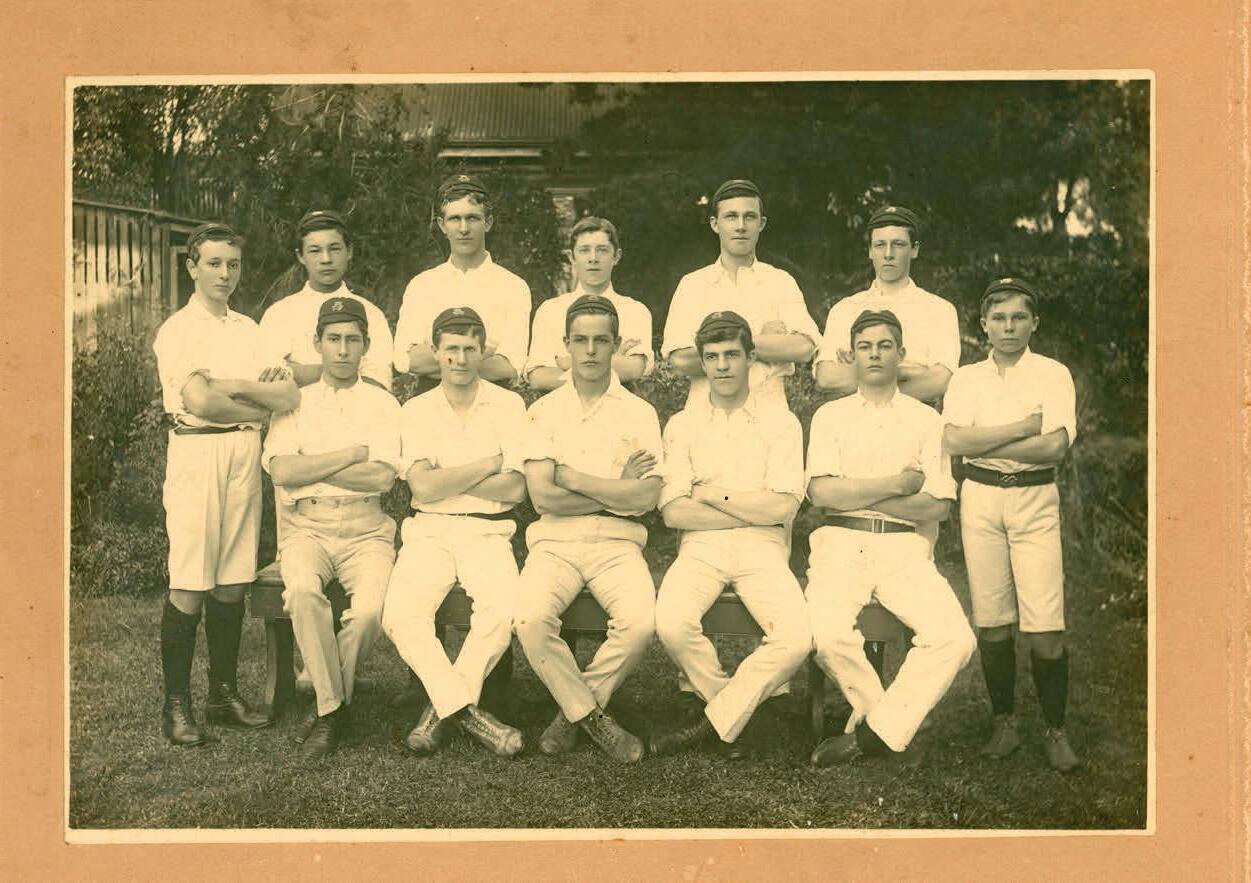
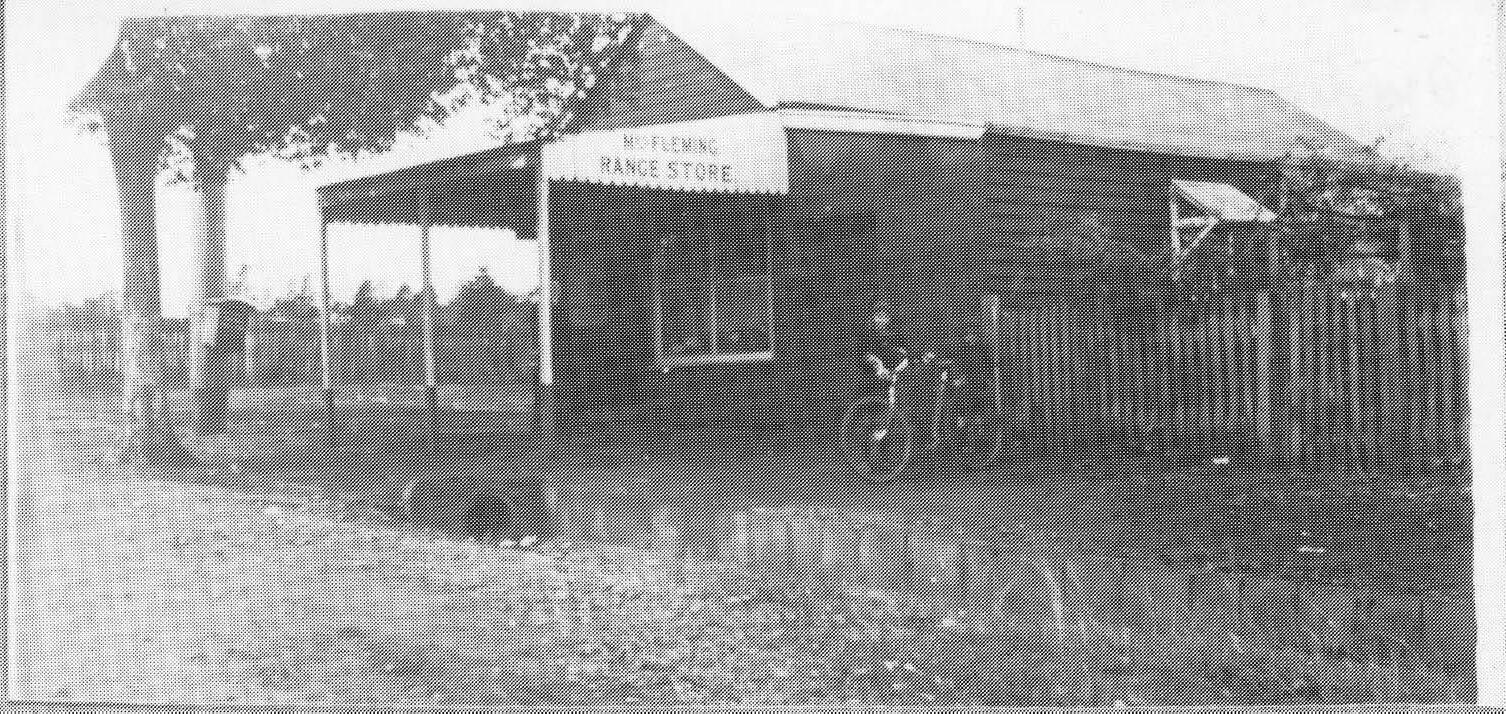
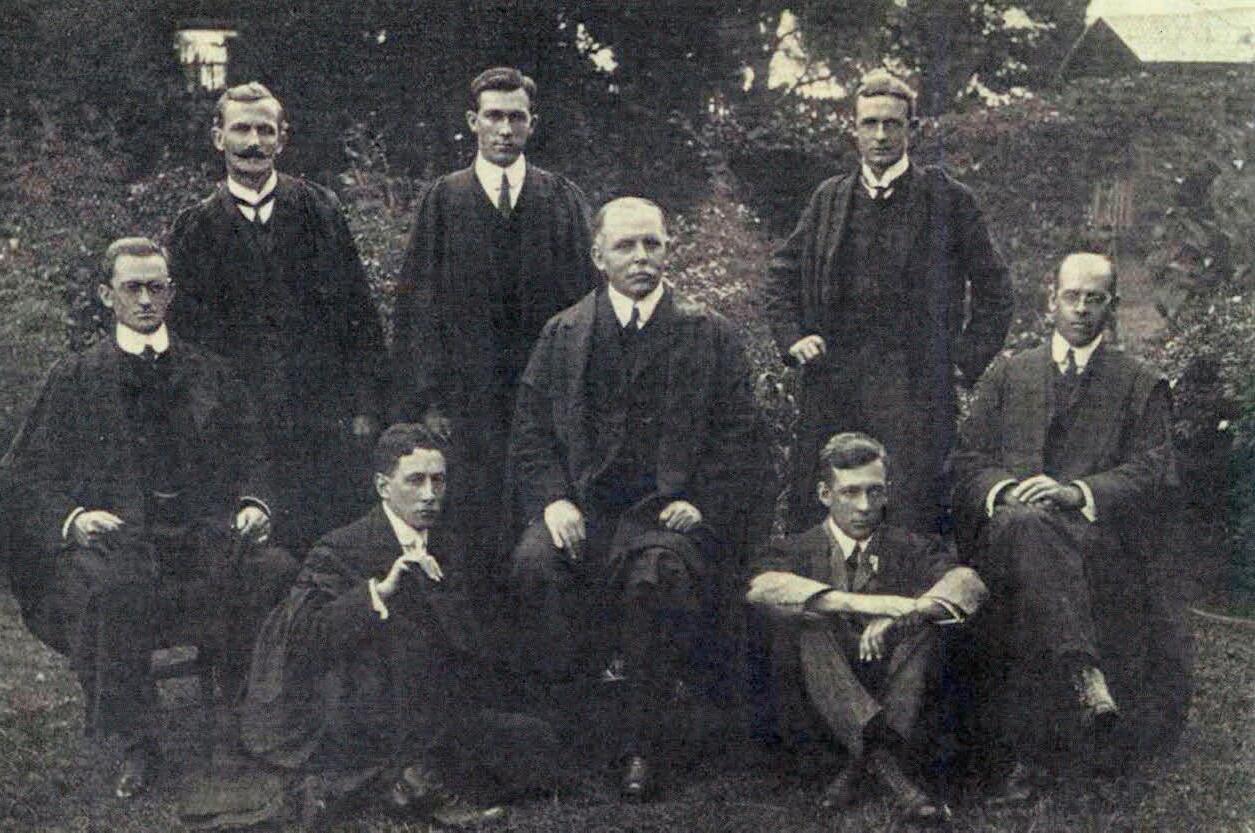
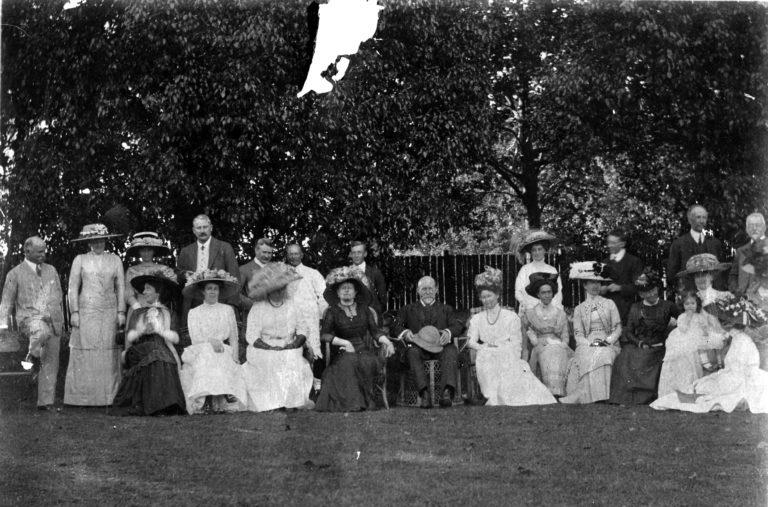
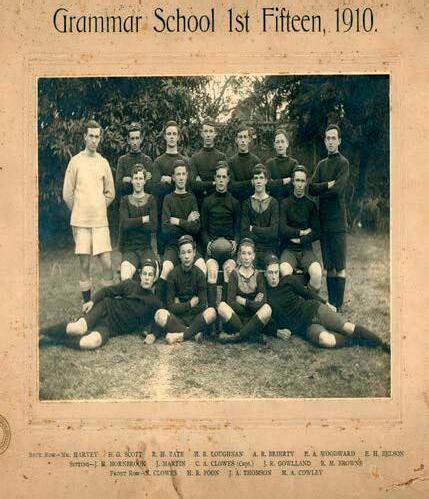

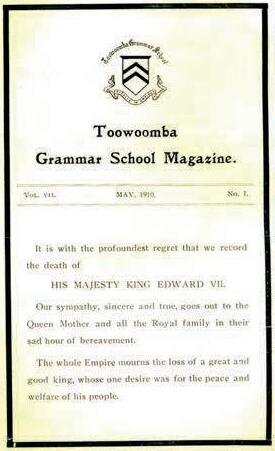
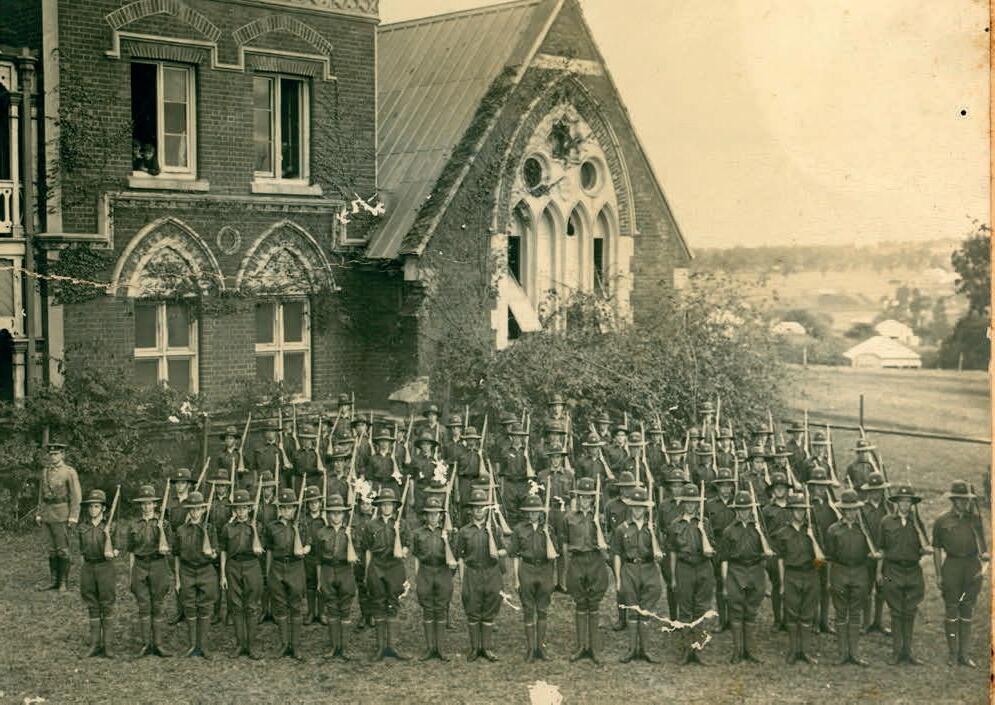
Chairman of the Board of Trustees: Dr Reginald Freshney (in 1st year) (Chairman:1911-1929).
Trustees: Two Trustees retired during the year: - Mr Alexander McPhie and Mr Colin Wardrop. Messrs William W. Pechey (an Old Boy 1883 -1884) and Mr Edward King were appointed as the new incoming Trustees.
Headmaster: Mr George P. Barbour (in his 2nd year)
Second Master: Mr James G. Leadbeater (in his 2nd year)
Senior Prefect: John H. Hornbrook (and again in 1912). There were seven Prefects.
Dux of Year: Charles R. Wonderley (and in 1912; see 1912)
Total School Enrolment: 149
Number of Dayboys: 74
Number of Boarders: 75
Staffing:
There were seven Masters on the teaching staff plus the Headmaster.
Students:
• The School Prefects are featured in the photograph below in this year’s entry - (Back Row) Charles Wonderley (Dux and also in the following year), Norman Clowes, Harold Campbell, John Lendrum (Middle Row) John Hornbrook (Senior Prefect and also in the following year), G.P, Barbour Esq. (Headmaster), John ‘Arthur’ Thomson (Front Row) Robert Jackson. As an illustration of the horror of war it is noted that both Arthur ‘Nibby’ Thomson and ‘Charlie’ Wonderley were killed in action during the war. Prefect Norman Clowes’ distinguished military career is described in the previous year’s entry.
• In this year seven young Old Boys were studying Medicine at Sydney University.
• Ian ‘Roy’ Alexander (1909-1911) was later awarded an Honorary Life Member of the Toowoomba Grammar School Old Boys’ Association in 1979 and was presented this award by His Excellency the Governor, Sir James Ramsay. Mr Alexander was a foundation member of the TGS OBA Brisbane Branch and Honorary Secretary from 1926-1937. In 1983 Mr Alexander attended the Old Boys’ Brisbane Branch Dinner and was acknowledged as the oldest ‘Old Boy’ present. This honour was also extended at the 1984 re union dinner. Mr Alexander worked with the Commonwealth Public Service, serving in several departments. In 1946 he wa s appointed to administer the Hospital Benefits Scheme in Canberra, a task he carried out until his retirement in 1956.
• Ronald R. Rivett (1909-1911) later enrolled his son into the School. J.C. ‘Bob’ Rivett was Dux of his year in 1939 and won the best pass in Queensland in the Junior examinations (see ‘Students’ in the 1939-year entry).
Events:
• The Defence Act 1911 required compulsory military training for all boys once they turned fourteen. They were set a minimum of eight parades of one and a half hours, three half days of three hours and one full day of six hours per term.
• A small private school, Girton College, owned by Miss Hunt, was purchased by Mr Ernest A. Gill who had been a Master at Toowoomba Grammar School from 1904-1906, returning in 1909 and resigning several months later. Girton College (named after one of Cambridge University’s women’s colleges) was then defunct and its buildings and site were located at the eastern end of Campbell Street, East Toowoomba. The Trustees accorded him the right to use the title “Toowoomba Grammar Preparatory School” and he recommended parents to send their boys on to Toowoomba Grammar School. The Preparatory School, opened by Mr Gill in January 1911, was under the supervision of the Trustees and the Headmaster of Toowoomba Grammar School. A photograph of the students attending the Toowoomba Grammar Preparatory School is included in the 1914-year entry. When Mr Gill’s school was taken over by the Church of England in 1920, it was named “The Church of England Preparatory School” but still referred to as ‘Prep’. Not only was ‘Prep’s’ first Headmaster, Mr Gill, from the Toowoomba Grammar School staff, so too was its fourth (Mr Edgar White), in 1958 (see 1939). Mr Gill remained as Headmaster of ‘Prep’ until his retirement from teaching which occurred in 1926. Today the school is known as Toowoomba Anglican School (with its newly adopted name commencing in January 2019) and was formerly the Toowoomba Anglican College and Preparatory School (TACAPS) from 2013-2018 and prior to this the Toowoomba Preparatory School. It became co-educational in 1972. A photograph of an original Toowoomba Grammar Preparatory School badge is included in this year’s entry.
• Acetylene gas lighting was connected to the School this year. Several years later, electricity was connected progressively around the School (see 1914).
• The ‘Ground Fund’ to finance the preparation of the new oval was reported to have benefited quite appreciably by the accumulation of petty fines for boarder dormitory untidiness.
• The population of the Darling Downs grew from 55,000 in 1901 to 85,000 in 1911.
• The annual dance organised by the Old Boys’ Association was held in the Masonic Hall.
• The boarders walked to St Luke’s Church each Sunday.
• The Empire Theatre in Toowoomba opened.
• A small booklet titled ‘Toowoomba in Picture’ was published around this time promoting Toowoomba and a photograph of the front cover of this booklet is i ncluded in this year’s entry. Also included are copies of several photographs included in this publication featuring scenes of Ruthven and Margaret Streets in Toowoomba. The photograph of the horse and buggy outside School House is also of interest.
Co-curricular Activities:
• In the Chelmsford Cup Competition against Ipswich Grammar School, Toowoomba Grammar School held the Cup, representing four times in five years.
• In Athletics, Brisbane Grammar School, Ipswich Grammar School and Toowoomba Grammar School competed in five events at the Brisbane Exhibition Ground in September. The TGS athletes were defeated on this occasion.
• In Cricket, the 1st XI cricket team defeated Brisbane Grammar School for only the second time in the School’s history. This match, played in Toowoomba (likely to have been at Queen’s Park), was the first 1st XI cricket match between the two schools since 1885, 27 years ago. TGS won the match scoring 141 runs to BGS, 82 (see 1881 and 1885).
• In the cricket match against IGS the score was TGS 205 d IGS 32 in the first innings and Harold Campbell for TGS took 5 wickets for 7 runs in the first innings.
• The School’s 1st XI of 1910-1911 was regarded as a very good one, if not the best in the history of the School to date. Even so, the Headmaster, Mr Barbour, was not all that complimentary about the quality of batting in cricket when he stated in the Annual Magazine – ”…the batting was too feeble for words, and perhaps the worst feature of it was that it got worse as the season proceeded, or at least did not get appreciably better.” Mr Barbour, playing in the School 1 st XI side, scored 91 runs in the TGS first innings against the local club Harlaxton when the entire TGS side only made 135. In the second innings of this game the Headmaster scored 102 runs.
• The annual cricket match ‘Past v Present’ was played on the School wicket in November. The current boys won the game, 123 – 78.
• A photograph of the 1911 1 st XI Cricket team is included in this year’s entry: (Back Row) A.W. Stark, S. Andrews, R.J. Jackson (Middle Row) W.M. Forbes, T.M. Lloyd, J.R. Lendrum, D .Lang, F.G. Barbour, (Front Row) E.C. Knowles, H.J. Campbell, Headmaster G.P. Barbour Esq., H.L. Harvey Esq., J.H. Hornbrook (Scorer) R. Barbour.
• In Rugby, the School’s 1st XV team played a number of games this year – against The King’s School (Parramatta) played at the Royal Agricultural Showgrounds in Toowoomba (Kings 26 – 0); Gatton Agricultural College (TGS 8 – 3); Ipswich Grammar School (TGS 27 – 3); Southport (TGS 28 – 5); Brisbane Grammar School (at the Union Grounds, Brisbane, with a narrow loss , BGS 11 d TGS 8) and an Old Boys’ match (current boys 20 d Old Boys 9).
• This year saw the second rugby match against Brisbane Grammar School since 1887.
• This year saw the first time a TGS 1 st XV competed against The Southport School. TGS won the first two games in 1911 and 1912 and then there were no games against them until 1922.
• A photograph of the 1 st XV Rugby team is included in this year’s entry: (Back Row) Scott, Robertson, Campbell, H. Harvey Esq., Forbes, Barton, Lendrum, (Middle Row) Andrews, Wonderley, Thomson (Captain), Hornbrook, Bond, Saunders, (Front Row) McIntyre, Thomson, Penhallurick.
• In Tennis, the first recorded Tennis fixture against The Southport School was played.
• In Swimming, the annual Swimming Carnival took place in March in the City Baths. Swimming lessons were compulsory for all students unless under exceptional circumstances.
• In Cadets, in the Cadet section of the School Magazine (1911, May edition, pg 28) it was written: ”The Compulsory Military Training Scheme is now well on the way to give us satisfactory future defence for our country, and as a nation we are entitled to a feeling of gratification.” The legislation for Compulsory Military Training was introduced in 1909 by Prime Minister Alfred Deakin and passed into law this year (1911) under the succeeding Fisher Labor Government. The legislation provided for three levels of training: Junior Cadets for 12 –14 year-old boys; Senior Cadets for 14–18 year-old males; and Home Defence Militia, officially known as Commonwealth Military Forces, for 18-26 year-old men. Boys were required to enrol in Cadets. This national scheme was abolished in October 1929.
• The Headmaster, Mr Barbour, in his Speech Day and Distribution of Prizes speech, referred to the Compulsory Military Training Scheme. Mr Barbour said: “Compulsory training has now been in operation six months, a period sufficiently long to allow one to draw deliberate deductions… I unhesitatingly say that the calls upon the physique of boys under sixteen are far too stringent.”
• The School’s Cadet Unit won the March Past, Austral Festival and a photograph of this achievement is included in this year’s entry.
• The School Magazine (November edition, pp.2 6-27) contained an article titled “Life at the Royal Military College of Australia”. The article was written by ‘CAC’, presumably Cyril Albert Clowes
(1908-1910). A similar article but with more detail summarising “Life at the Royal Military College, Duntroon”, appeared in the 1912 School Magazine (May edition, pp.28-31). In the School Magazine of 1919 (May edition, pp.6-7) an Old Boy had submitted an article on the Royal Military College of Australia.
• In Music, the School Choir sang at intervals during the Speech Day proceedings. The choir, which had been trained and was conducted by Mr Leadbeater, sang the following choruses: "Goodnight," "Lebewohl" and "La Marseillaise”.
General:
In the School Museum is an audio recording of an interview conducted by Dr Rupert Goodman ( The University of Queensland) and Mr James Duncan. This interview was conducted in August 1974 when Mr Duncan was aged 97 years. Mr Duncan was responsible for the levelling and preparation of the bottom oval that was later to be named Barbour Oval on the corner of Margaret and Mary Streets. The background to this development was that at this time the existing cricket ground at the School was very rough indeed. The existing playing field was to be extended to a level area at least 140 yards by 100 yards which meant reducing the drop between the top side by four feet. In all, 11,000 yards were removed by Mr James Duncan by his horse, plough and scoop. The top soil which had been carefully removed was restored and good couch grass was re-sown. Three new turf wickets were built, one in the centre and one at either end for practice. A new fence was also erected. The sum of 569 pounds was contributed by Old Boys, parents and local businessmen. On April 2, 1913, the oval was opened.
Guest Speaker at the Speech Day & Prize -Giving Ceremony: Colonel Henry Venn King, Cmdr WLD Contingent Queen Victoria’s Diamond Jubilee Celebrations, 1897 . The annual Prize-Giving Ceremony took place in the Town Hall on Friday, 15 December.



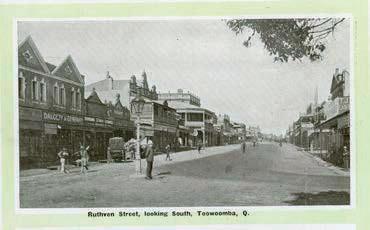

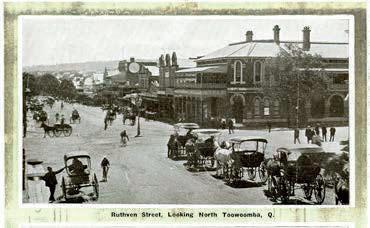

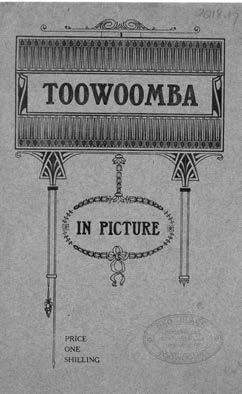
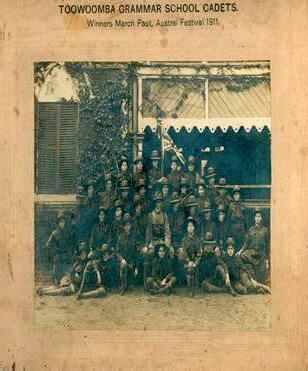

Chairman of the Board of Trustees: Dr Reginald Freshney (in his 2nd year)
Headmaster: Mr George P. Barbour (in his 3rd year)
Second Master: Mr James G. Leadbeater (in his 3rd year)
Senior Prefect: John H. Hornbrook (and in the previous year) (see below)
Dux of Year: Charles R. Wonderley and Robert J. Jackson (aeq) Charles Wonderley was awarded the Military Medal and was killed in action in France. His mother, Mrs Wonderley, presented an Honour Board to the School in memory of her son (see 1919). In 2011, during a TGS language and cultural tour to France, the TGS boys paid their respect at the grave of Charles Wonderley and other TGS Old Boys.
Total School Enrolment: 147
Number of Dayboys: 77
Number of Boarders: 70
Students:
• The School Prefects were John Hornbrook, Sydney Bond, William Forbes, Robert Jackson, John Lendrum, Thomas Lloyd, and Charles Wonderley. A photograph of the Prefects is included in this year’s entry.
• The Senior Prefect, John H. Hornbrook (1907-1912), had impressive sporting achievements as Captain of two Firsts teams – cricket and athletics. He was Captain of the 1 st XI Cricket team in both 1911 and 1912. He was also the Captain of Athletics for three consecutive years – 1910, 1911 and 1912. John Hornbrook graduated in medicine in March 1918 and he lost no time in enlisting with the Royal Army Medical Corps (RAMC) in the British Army for service in World War One. He later practised medicine in Sydney.
• The Dux of the School, Charles Wonderley, was an Open Scholarship Winner to the University of Queensland, 1912. Charles won the highest place for Queensland boys in the Senior Public Examination. He received Distinctions in Latin, Greek. Algebra, Geometry, Trigonometry and Mechanics; and Passes in Ancient History, English and French.
• Ranked third in Queensland in the Senior Public Examination was Robert J. Jackson (1906 – 1912) who was also an Open Scholarship Winner to the University of Queensland.
• Cecil J. Broadfoot (1910-12), went on to play League for Queensland and later was selected to play Rugby League for Australia in 1924 but unfortunately missed playing due to injury. For many years Cecil assisted with the coaching of the School’s 1st XV, his most memorable successes in this
dimension involving the 1929 GPS runners -up team and the 1930 Premiership XV. His younger brother, William Neville (‘Nev’) Broadfoot (1912-1913) also had the same honour of representing Australia in Rugby League from 1920 to 1922. In 1921 he toured England with the Kangaroos. Both Broadfoot brothers are recorded on the Old Boys’ Wall of Achievement.
• One of the 1st XI Cricket team was Hunter Poon (1908-1912). During World War One whilst serving in France, Hunter received an horrific injury to his right hand. Returning to civilian life he promptly learnt to use his other hand and later captained the Queensland Country cricket teams in the 1923-24 and 1924-25 seasons. He was also selected to play for Queensland’s Sheffield Shield team in the 1924-1925 season (he also excelled in tennis, billiards and golf, at some time playing off a handicap of 3). (See 1910). Mr Poon was the oldest Old Boy in attendance at the TGS OBA centenary dinner in 1975. At some stage in his career, Hunter was a teacher at Toowoomba State High School. An obituary for Hunter Poon was included in the 1980 School Magazine on page 90.
• Another 1st XI Cricket team player, John Lendrum (1908 -1912), threw a cricket ball 119 yards, 1 foot and 4 inches in the School’s sports carnival – a school record for at least fifty years.
• Alan Campbell (1909-1912), who later served at Gallipoli, returned to the School over fifty years later (1965) to talk to the boys about his travels overseas, more recently to the Himalayas.
• Sidney E. Reilly (1910-1912) was awarded an MBE in the New Year’s Honours List in the 1970’s for his contributions to surveying.
Events:
• Brisbane Church of England Grammar School (‘Churchie’) was established.
• The school leaving age in Queensland was raised to 14 years.
• The first State High Schools were established.
• The new sports oval (now known as Barbour Oval) was being levelled and ready later in the year.
• Old Boy Mr Charles Stumm K.C. presented an Honour Board to the School to acknowledge the Dux of the School. Years later, Mrs L.M. Bond donated a ‘twin’ Honour Board to recognise the names of the Senior Prefects in memory of her son, Old Boy Sydney S. Bond (1906-1913) who was killed in action in 1917 during World War I. These two Honour Boards are to this day proudly displayed in Old Hall.
• The School’s seventh annual swimming carnival was held at the City Baths in March. In the School Magazine of this year it was written: “A lovely afternoon and a friendly feeling for the amphibians to be seen at play coaxed a record crowd to the baths, and some six -hundred people, including very many ladies, saw Campbell (One) win the Headmaster’s Cup to the music of Smith’s orchestra.”
• A Technical College was opened in Toowoomba.
• One evening the boarders looked at a “series of magnificent lantern views’ in a dream down the Rhine into Monte Carlo. These were presented by Dr A.E. Vonn of Heidelberg who had joined the teaching staff in the previous year as Mode rn Language Master. Dr Vonn spoke fluent German, French and English.
• A detailed report on ‘Life at the Royal Military College’ was included in the School Magazine (May 1912, pp.28-31) written by Old Boy ‘C.A.C.’.
• The following regulations with regard to ‘Colours’ were outlined this year:
(a) Boarders at all times and Dayboys in all School relations to wear the metal badge; the Prefects a distinctive hat ribbon; (b)Any TGS boy may wear for the purposes of sport the dark bl ue cord-edged blazer;
(c) First XI – gold striped blazer with monogram;
(d) First XV – cord-edged blazers with blue and gold badge on pocket;
(e) Tennis IV, Athletics, Swimming and Shooting representatives – the same as for Football (Rugby);
(f)Caps – Cricket XI to match blazer; other representatives the School honour cap;
(g) It is part of a Prefect’s duty to see that no boy wears colours to which he is not entitled and to see the School Badge is regularly worn.
Co-curricular Activities:
• The Chelmsford Cup was retained against Ipswich Grammar School. TGS had wins in cricket, football and swimming but lost in tennis, athletics and shooting.
• In Athletics, in an Athletics sports competition involving the three Grammar Schools, TGS was placed 1st, IGS 2nd and BGS 3rd. A photograph of the athletes is included in this year’s entry.
• In Cricket, a photograph of the 1st XI is included in this year’s entry. In the 1st XI cricket game against IGS, TGS was 3 for 234 (see below) and also had an outright victory by ten wickets in the 1st XI game against BGS played in Brisbane,
• In the School’s 1st XI cricket game against Ipswich Grammar School played on 4 December on the Toowoomba Cricket Association grounds, Eric C. Knowles (to be Captain of the TGS 1 st XI in the following year) scored 126 not out. This was the first recorded century in a GPS matc h by a TGS 1st XI cricketer. The TGS-IGS match was won by TGS, 3/234 d IGS, 116. In the following year Eric Knowles took 7 wickets for 13 runs against IGS. He was later to represent the State in cricket (see 1913).
• In the 1st XI cricket game against BGS played in Brisbane, BGS scored 74 in the first innings and 82 in the second innings. The TGS opening bowlers, John Lendrum (5 for 56) and Harold Campbell (5 for 35), contributed to TGS winning an outright victory by ten wickets.
• Just prior to Easter the boys played a visiting cricket team representing Newington College, Sydney (Newington 193 d TGS 94).
• In December of 1912, the School’s cricket team had its second interstate tour (the first was playing The Armidale School in Armidale in December 1904). The boys left on Monday, 9 December and reached Sydney at noon on Tuesday. The cricketers lost matches against The King’s School (Parramatta) and Newington College but won by ten runs against Sydney Grammar School (played at the Sydney Cricket Ground). The boys also visited museums, art galleries, theatres, went on a trip to Manly, swam and shopped. A highlight was a cruise on Sydney Harbour on a launch. The next cricket tour to Sydney by a TGS 1 st XI side occurred in 1926.
• The Headmaster, Mr Barbour, frequently played in the 1st XI cricket side which was permissible at the time. Interestingly, his average runs made totalled 35 which was the highest of all players. The fourth highest batting average (26 runs) was achieved by his first son, Frederick, and the fifth highest batting average was achieved by his second son, Robert (22 runs).
• Hunter Poon’s cricket experience is referred to in the ‘Students’ section above.
• In Lacrosse, a Lacrosse team was formed. The Headmaster expressed his views on Lacrosse and the team by stating in the Headmaster’s Annual Report – Á lacrosse team has been formed and exists on sufferance. Boys must recognise that the School winter game is football (rugby) and if they have the proper school spirit they will always put football (rugby) first. That lacrosse is an excellent game no one will deny, and boys who for any reason cannot play football or tennis would do well to take it up.”
• In Rugby, the School’s rugby team played The Southport School and won this game. A photograph of the team is included in this year’s entry.
• In Soccer, the sport ‘Soccer’ was referred to in the School Magazine of this year. In the magazine was written: “The ‘soccer’ season has come once again and the boys are eagerly getting into their blue and gold guernseys. Two dayboy versus boarder matches have already been played; in the first the boarders scored a goal, while in the second match neither side scored.”
• In Swimming, see the report on the seventh annual Swimming Carnival described in the ‘Events’ section of this year’s entry.
• In Tennis, the School’s Tennis IV won the local A-grade competition and the Cricket XI had been second in first-grade cricket
• In Debating, the Debating Society started and was flourishing.
• In Music, a bugle band, twelve strong, was formed during the year. It was reported in the School Magazine: “They include some excellent buglers and much enthusiasm is displayed by every member of the squad, sometimes to the dismay of neighbours.”
• During the end of year Speech Day and Prize Giving Ceremony, the School Choir, under the baton of Mr Leadbeater, rendered the following choruses : "I can't think of nothin' else but you, Lulu" (arranged by Mr. R. S. Boys), " Die Lorelei," and the "Russian Anthem". Proceedings terminated with the singing of "God Save the King " by the Choir.
Guest Speaker at the Speech Day & Prize -Giving Ceremony: His Excellency The Governor, Sir William MacGregor (at the Town Hall)
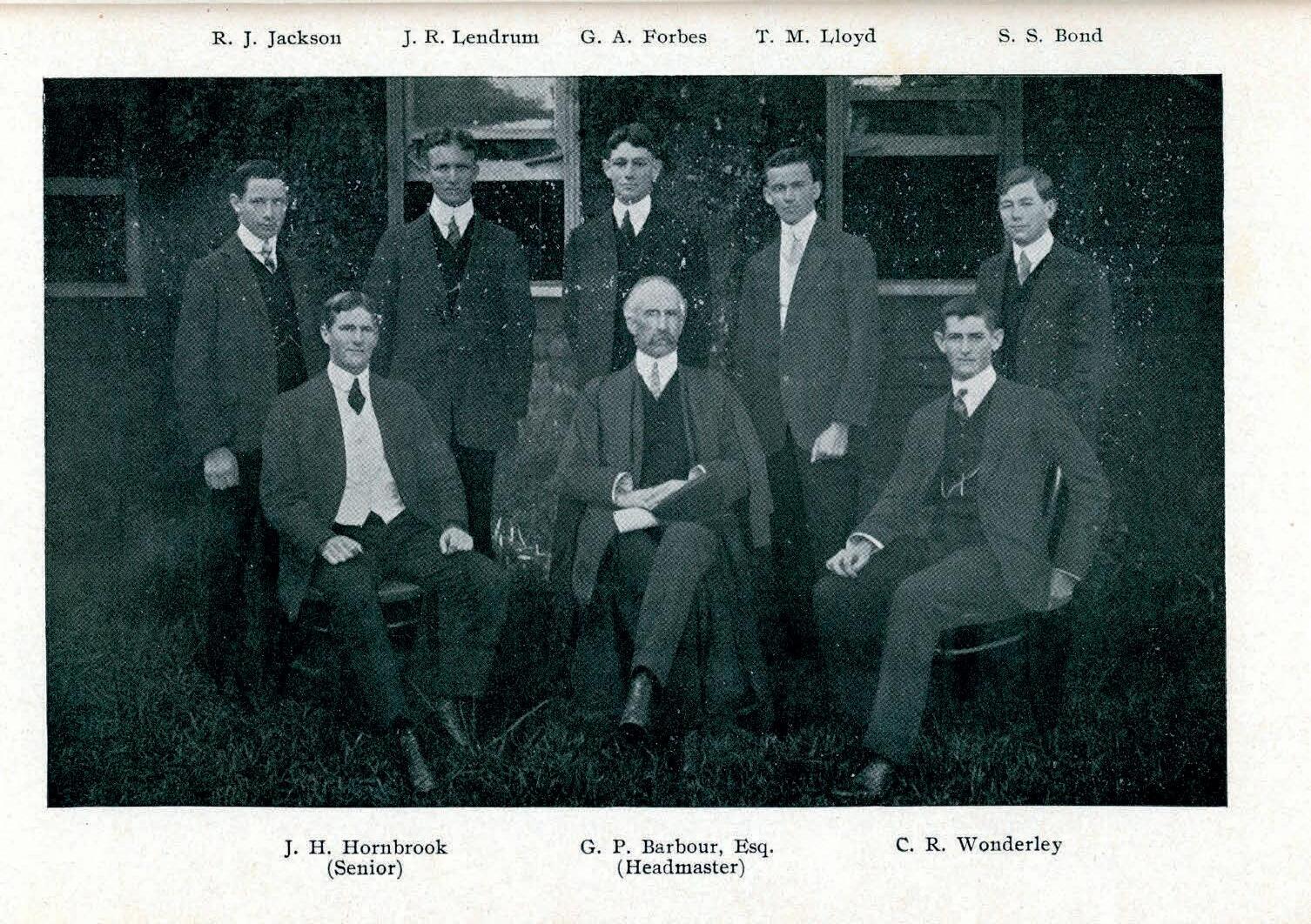
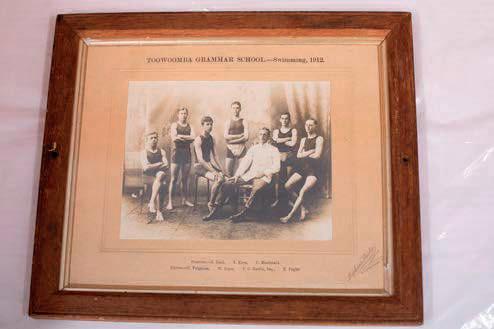

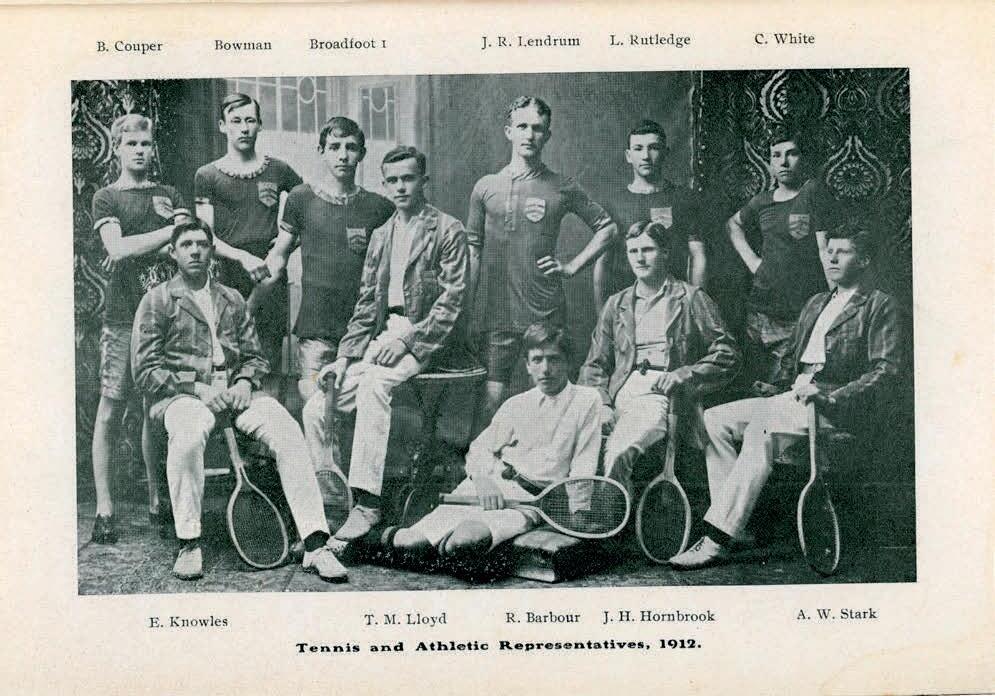

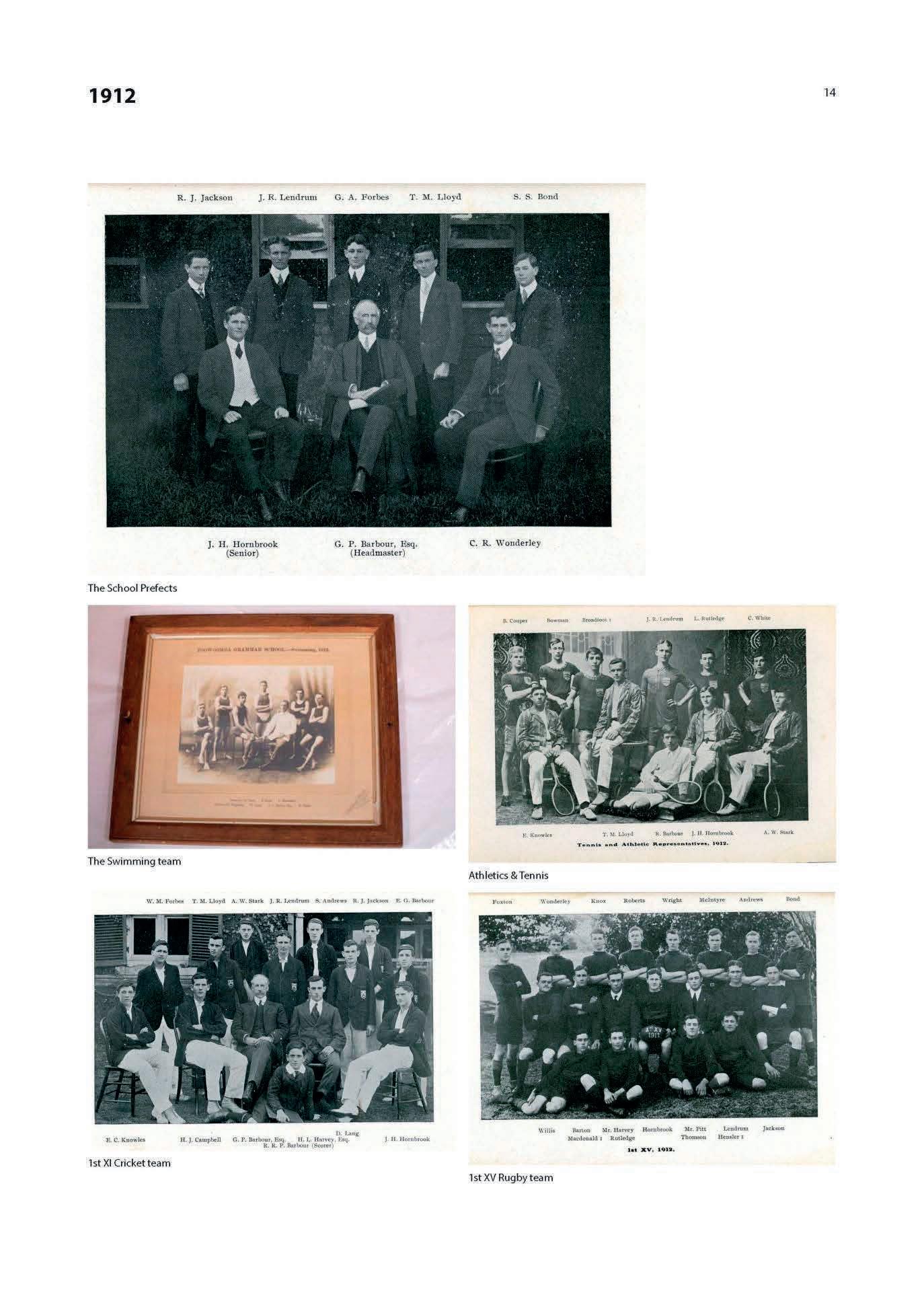
Chairman of the Board of Trustees: Dr Reginald Freshney (in his 3rd year)
Headmaster: Mr George P. Barbour (in his 4th year)
Second Master: Mr James G. Leadbeater (in his 4th year)
Senior Prefect: Thomas M. Lloyd
Dux of Year: Frederick G.P. Barbour (the son of the Headmaster) – and also in 1914
Total School Enrolment: 122
Number of Dayboys: 61
Number of Boarders: 61
Staffing:
• Mr Walter James (‘Jerry’) Meyer was appointed to the teaching staff, an Old Boy of Ipswich Grammar School and a foundation scholar of the University of Queensland (honours in classics). Mr Meyer impressed both the Headmaster (with his mastery of Latin, Gre ek, German and Mathematics and his coaching ability in cricket and football) and the Headmaster’s eldest daughter, Helen, whom he married in 1916. Mr Meyer joined the staff of The King’s School, Parramatta, in 1922 and in 1942 he was appointed Headmaster of Tudor House, a preparatory school at Moss Vale controlled by the Council of The King’s School.
Students:
• The School Prefects were Thomas Lloyd, Frederick Barbour, Thomas Knox, Colin Macdonald, Joseph Hogg, Felix Brazier and Henry Stark.
• Thomas Lloyd, (1909-1913) this year’s Senior Prefect , graduated in medicine from the University of Sydney and practised medicine in Sydney.
• Eric H. Partridge and George O. Newton were Open Scholarship winners to the University of Queensland based on their performance in t he Senior Public Examination.
• Eric C. Knowles (1910-1913) was to play cricket for Queensland. On 4 December 1912 playing on Association Grounds, he made the first GPS century for the School, 126 runs against Ipswich Grammar School in ninety minutes. In twe nty-one innings during the 1912-1913 cricket season, Eric scored 858 runs with an average of 45.15 runs. In one game in the local competition in season 1912-1913 playing against Peak and Co at Association Grounds, he scored 178 runs. Of interest, Eric Knowles transferred to IGS sometime this year.
• Eric Knowles’ elder brother, Sir George Knowles, is acknowledged in the 1898 entry.
• Boarder Jim Atkinson at the age of 12 faced a two -week journey to TGS from his home property ‘Greenvale Station’ situated north of Charters Towers. The first leg of the journey involved Jim setting out on his bicycle for a ride of four days to Charters Towers. He left home equipped with his bike, a rifle (to shoot what food he could along the way), a bed roll and a small knapsack. After arriving at Charters Towers, Jim left his bike and rifle with the local Stock and Station agent before catching a train to Townsville. From there it was on a passenger schooner for a sea voyage to Brisbane, followed by another train trip to Toowoomba. The entire trip to get to the school lasted two weeks. Jim Atkinson’s travels to Toowoomba Grammar School were described in the book On Eagles Wings – the Atkinsons of North Queensland – written by Marjorie Gilmore.
• Around this time many boarders would go on weekend camping trips over the Toowoomba Range. A photograph of some boarders preparing for their expedition is included in this year’s entry: (Back) - Wright, McDonald (New Guinea), Jack Walmsley (S.W. Qld.), McDonald (New Guinea) and (Front) - Willis (Sydney), Gerry, Fujames, Hensler (Goondiwindi) and the dog that always accompanied them.
• ‘Nev’ Broadfoot (1912-1913) advanced to represent Australia in Rugby League in 1920.
• The winner of Mr F.N. Robinson’s Prize for the boy who had done most towards winning the Chelmsford Cup was Frederick Barbour.
• Walter H. Wippell (1909-1913) was later to be appointed as a member of the School’s Board of Trustees from 1958-1960. Mr Wippell passed away in 1960 whilst still a Trustee. The bluestone steps to Mills Oval were organised by his wife as a memorial to Mr Wippell and a plaque in this location recognises his name.
• Frederick C. Robinson (1911-1913) was to be elected as the inaugural President of the newly formed Sydney Branch of the Old Boys’ Association in 1931.
• The number of young Old Boys now attending Universities was significantly increasing – nine at Sydney University, six at the University of Queensland, two at Aberdeen (Scotland) and two in California.
• The tuition fees in 1913, per term, were four pounds and four shillings; boarding, twelve pounds and twelve shillings; books, one pound and seven shillings to nine pounds and three shillings; games, five shillings; and ‘sub’, one to four pounds.
Events:
• Brisbane State High School, then known as the Central Technical College, was established.
• On April 2 nd, a large gathering of several hundred celebrated the opening of the Sports Oval (now known as Barbour Oval). The levelling had been completed by September 1912 and the grass sown in October. An Old Boys’ Cricket match was held on the day. In this game the Headmaster’s son, Frederick Barbour, made a century (106) in this the first competition game to be played on the new school oval.
• Three cricket wickets were built on the new oval – one in the centre and the others towards either end. These latter two were to serve as practice wickets. An old shed served as a pavilion.
• At the annual sports meeting held on the new oval on Friday, 5 September , a disagreeable westerly blew clouds of dust onto the ground.
• The three Grammar Schools, Toowoomba, Brisbane and Ipswich, united with the University to provide an afternoon’s sporting competition. This was held in September at the Exhibition Grounds in the afternoon and the long jump event was held on the BGS ground in the morning.
• The 1913 School Magazine (May, page 18) commented on the rivalry between the dayboys and the boarders. It was written: “The rivalry between dayboys and boarders, once so stimulating to sport, is unfortunately becoming less keen. The dayboys make a fair fight in cricket, but most of our representatives in other branches come from the boarders - soccer and marbles excepted.”
Co-curricular Activities:
• In Athletics, as part of the Chelmsford Cup competition, an Athletics sports competition involved the three Grammar Schools. IGS was placed 1st, BGS 2nd and TGS 3rd Photographed in the Athletics and Tennis photograph in this year’s entry are some well-known individuals. Two of Headmaster Barbour’s sons are featured, Frederick (Dux of the year and in the following year) front row, second from left and Robert ‘Bob’ R.P. Barbour (front row, seated at right); Thomas Lloyd (Senior Prefect, back row, third from left); Joseph S. Handley (back row, far right, father of S.’John’ Handley, see 1957);
• In Cricket, the 1st XI Cricket team had an easy victory over Brisbane Grammar School (winning by 163 runs) In the match against BGS played in Toowoomba on Monday, 18 March, the TGS bowler John Lendrum took 5 for 14 from their total of 80 runs. TGS responded with 243 runs.
• Against IGS in December, the 1 st XI experienced little success scoring only 60 runs in the first innings. The former captain of the TGS 1 st XI, Eric Knowles, transferred to IGS sometime in 1913. Eric, now representing IGS, took 7 TGS wickets for a mere 13 runs and top scored with 57 runs.
• In Rugby, the boys in the 1 st XV Rugby team travelled to Brisbane Grammar School and were defeated 38 to nil. One excuse offered was our boys were suffering from “vaccination arms”.
• St Joseph’s Nudgee College defeated TGS 1st XV in a game at Nudgee (6-0) From 1913 to 1930 TGS playing against Nudgee College 1st XV won only three games (1923: 9-0; 1929: 17-8; and 1930: 12-3) and drew two times (in 1914 and 1924).
• Competing in the Chelmsford Cup competition, the School’s 1 st XV played IGS in Toowoomba in June on the new oval (today known as Barbour Oval) and TGS won 14-0. Rain had converted the already broken surface of the new ground into a sea of red mud.
• In Swimming, a swimming event against Brisbane Grammar School was held in November at the Toowong Baths.
• In Tennis, the 1st IV Tennis team won the senior competition and w as unbeaten. Two of the boys, Thomas Lloyd (Senior Prefect) and William Stark competed for the Hard-Court Doubles Championship of Queensland but were defeated in the final, two sets to one Both boys are featured in the Athletics and Tennis photograph of this year – Thomas Lloyd (back row, third from left) and William Stark (front row, fourth from left).
Guest Speaker at the Speech Day & Prize-Giving Ceremony: The Right Honourable Sir George Reid, High Commissioner for Australia, Surgeon General, 1st AIF, Politician, Diplomat
The programme of the Speech Day comprised – Chairman’s Address; Chorus (School Choir); the Headmaster’s Report; Distribution of Prizes by Sir George Reid; Selection (School Choir); Address by Sir George Reid; and Vote of Thanks to Sir George Reid.

Chairman of the Board of Trustees: Dr Reginald Freshney (in his 4th year)
A new Trustee was appointed, Mr W. Meyer, after the resignation of Mr Clark.
Headmaster: Mr George P. Barbour (in his 5th year)
Second Master: Mr James G. Leadbeater (in his 5th year)
Senior Prefect: Felix H. Brazier (and in the following year)
Dux of Year: Frederick G.P. Barbour (and also in the previous year). ‘Fred’ was the son of the Headmaster and a brilliant scholar. He won first place in the State in the Senior Examination for T he University of Queensland (the open scholarship) and entered Emmanuel College in 1915. Fred left Brisbane as Sergeant of Reinforcements in December 1915 In Egypt he transferred to the 9 th Battalion and was actively engaged in conflict in France for ten months. Tragically Fred Barbour was killed by a bullet at Flers, south of Bapaume, France, on 25 February, 1917, aged 21 years (see the ‘Students’ section below and the photograph of Fred’s headstone in the 1917 entry ). In 2011, during a TGS language and cultural tour to France, the TGS boys paid their respect at the grave of Frederick Barbour and other TGS Old Boys.
One of Fred’s brothers, Robert ‘Rob’ R.P. Barbour (TGS 1910-1917), later also won an Open Scholarship to the University of Queensland and later still a Rhodes Scholarship in 1920 (see 1917).
Total School Enrolment: 133
Number of Dayboys: 64
Number of Boarders: 69
Staffing:
• Members of staff went off to the war.
Students:
• The School Prefects were Felix Brazier, Thomas Lloyd, Frederick Barbour, George Davids, William Forbes and William Stark.
• One of the Headmaster’s sons, Frederick G.P. Barbour, won an Open Scholarship to attend the University of Queensland based on his performance in the Senior Public Examination. At School ‘Fred’ was a Prefect and played a variety of sports including being a member of the 1st XI cricket
team. A prize was endowed by Mr Tom Lloyd in 1918 (he was the Senior Prefect in 1913) in memory of Fred – the Fred Barbour Memorial Prize for Year 11 Biology which is presented annually at the School’s Speech Day and Prize Giving Ceremony. The Fred Barbour Memorial Prize was first awarded in 1918 as a subject prize for Science and in 1997 was changed to the subject prize for Biology in Year 11.
• Leslie A.G. Boyce (1911-1914) was later appointed a Trustee in 1943 and subsequently as Chairman of the School’s Board of Trustees from 1945 - 1957. He was quoted in the School’s Newsletter Blue and Gold in 1962 as recalling someone telling him: “ Mr (‘Joe’) Scott catching some boys smoking in the main drive; when he threatened to march th em up to the Headmaster Mr Barbour, they replied smartly, “We’ve just enlisted, Sir!” Not daunted, ‘Joe’ Scott went straight down town and did the same (and he was to enlist twice more – once after he recovered from wounds, and once again in World War II). Dr Boyce was also the guest speaker at the School’s Speech Day and Prize Giving Ceremony in 1979.
• William A. Stark (1910-1914), Captain of the School’s 1 st IV Tennis team, together with playing partner Ratten, won the Hard-Court Doubles Championship of Queensland in September in the following year.
• A photograph of the Toowoomba Grammar Preparatory School students is included in this year’s entry. Although located away from the main School campus, this school was still administered by the TGS Board of Trustees and the TGS Headmaster (see the Events section of 1911 for further detail).
Buildings:
• A specialist Physics laboratory was constructed. The driving force behind this new laboratory had been staff member Mr Thomas ‘Tom’ Hewitt who had been appointed by Headmaster Purves in 1907. No sooner had Mr Hewitt equipped the laboratory and begun to use it than he was called out for active military service at the Front. He was killed in action in France in 1916 (see 1916).
Events:
• The Great War (World War One) 1914-1918. Australia’s involvement in the First World War commenced when Britain and Germany went to war on 4 August 1914. When Britain declared war against Germany in August, Australia as a dominion of the British Empire was automatically also at war. The war concluded on 11 November 1918.
• Overall, 324,000 members served overseas with the Australian Imperial Force (AIF). Of these, over 60,000 were killed and 156,000 wounded, gassed or taken prisoner.
• An estimated 80 per cent of eligible TGS Old Boys served in the armed forces; it is believed that the School had the greatest percentage of eligible Old Boy volunteers in the country.
• 388 TGS Old Boys enlisted in World War One of whom 65 paid the ultimate sacrifice with loss of life (see 2015, ‘Battlefields Tour’). Statistics relating to the involvement of the Old Boys in World War One are documented in the 1918-year entry in the ‘Events’ section.
• Four Old Boys were Generals – Sir Harry Chauvel (TGS 1880-1882), Cecil Foote (TGS 1885), Walter A. Coxen (TGS 1881) and James Campbell Robertson (TGS 1893-1894). Another Old Boy, Colonel Charles Fortescue (TGS 1907-1909) was the first Queenslander to be decorated for gallantry in World War One.
• Old Boy Dr Alwyn (‘Tom’) Nisbet (1907-1908) wrote to the editors of the School Magazine about a visit he took with fellow Old Boy, Cyril Clowes (1908-1910), to see over the troopship Argyllshire in this year (1914) Cyril Clowes had the responsibility of loading up the vessel. Tom Nisbet saw the long rows of horse boxes which took up most of the space. The boxes were very solid structures, made so narrow that it was almost impossible for a horse to fall in rough weather. Nisbet was informed that the troopship Argyllshire had on board altogether 487 horses and he thought that there may be about 700 men on the vessel.
Cyril Clowes departed on the troopship three days later and at the front was wounded. Cyril’s younger brother, Nim, was also at the Gallipoli landing and was severely wounded. A sniper’s bullet entered his chest and passed out above the hip. He recovered in England. A month or so after graduating in Medicine, Tom Nisbet went to war in Egypt.
• An electric light was installed in the Physics Laboratory at a cost of twenty pounds (see 1916 for the connection of electricity throughout the School).
• A rifle range was erected at the School but the cadets were unable to shoot as experts deemed that there was not sufficient protection for the markers.
• A group of three students participated in a bicycle trip around the district below the Toowoomba range during the Easter break. The boys were interested in seeing the country south -east of Toowoomba which was little known owing to its remoteness from railways. An interesting article in the School Magazine (May 1914, pp.24-25) outlined their trip with stops at Grantham, Gatto n, Laidley, Lake Clarendon and a return trip described as “on the morrow a stiff push up the Toll Bar Road finished the journey”.
Co-curricular Activities:
• In the Chelmsford Cup competition against Ipswich Grammar School, the School won in football (rugby) and tennis but lost in athletics and cricket. The overall result for the Cup was a draw.
• The only schools which Toowoomba Grammar School played regularly prior to 1915 were Brisbane Grammar School, Ipswich Grammar School and St Joseph’s Nudgee College.
• In Athletics, the Combined Athletic Meeting involving TGS, BGS and IGS was held at the Schoo l in September. Brisbane Grammar School won most of the senior events, TGS won all the junior contests and IGS defeated TGS in those events that counted for the Chelmsford Cup.
• The School Museum has a TGS Sports Meeting programme for Wednesday, 9 September 1914.
• In Cricket , against IGS, TGS made only 47 runs in total and lost the game.
• Promoted to the School’s 1st XI cricket team was a student aged 13 years and 9 months. He was Roy Kent (Henry Ronald Roy ‘Copper’ Kent) – see 1917 and 1918. In November of this year Roy Kent opened the batting and top scored in the match against Past Grammars.
• The TGS 1st XI played BGS in April and TGS won the match by 26 runs, scoring 138.
• A photograph of the 1st XI cricket team is included in this year’s entry. Pic tured are (Standing) R. Barbour, W. Stark, W. Forbes, E. Smart, F. Brazier, C. Seaton (Sitting) W. Browne, T. Lloyd, J. King, Headmaster Barbour, H. Ritchie, F. Barbour, S. Andrews (Front) R. Kent (scorer).
• The School Magazine of this year acknowledged this team as winning the local competition but was fairly harsh in its assessment of the performance of some of its members, stating: “Several members of the team were monotonously invisible even on fine days”.
• In Rugby, the School’s 1st XV rugby (then called football) team played nine matches in this year’s season. Of these, five were won, one drawn and three lost. In the inter-school matches the School
was beaten by Brisbane Grammar School (5 -0), was successful against Ipswich Grammar School (9-3) and drew with Nudgee College (no score recorded).
• Due to heavy rain, the School’s new oval was a quagmire and the 1 st XV match against IGS was played at the Toowoomba Show Ground (TGS 9 d IGS 3).
• One of the very first Rugby games against St Joseph’s Nudgee College was played in June 1914 in Toowoomba and resulted in a scoreless draw. It was not until 1923 that the School recorded a win against Nudgee College in Rugby.
• In Swimming, the School’s swimming squad lost to Brisbane Grammar School.
• In Tennis, the School had its first win in tennis (on grass) against Brisbane Grammar School and also secured victories against Ipswich Grammar School and the Southport School on their own courts.
• In Cadets, the School’s Cadet Unit had the honour to farewell a number of troops departing for the front, including many Old Boys.
President of the Old Boys’ Association: No President is listed until 1920.
Guest Speaker at the Speech Day & Prize -Giving Ceremony: Dr Reginald Freshney, Chairman of the Board of Trustees (1911-1929) (substitute for the Hon Littleton Groom)
At the Speech Day the Headmaster concluded his address with the words: “In spite of the alarms and turmoil of war, the School had had a year of steady progress.”
Chairman of the Board of Trustees: Dr Reginald Freshney (in his 5th year)
Headmaster: Mr George P. Barbour (in his 6th year)
Second Master: Mr James G. Leadbeater (in his 6th year)
Senior Prefect: Felix H. Brazier (and Dux) (see 1986)
Dux of Year: Felix H. Brazier
Total School Enrolment: 143
Number of Dayboys: 80
Number of Boarders: 63
Students:
• The School Prefects were Felix Brazier, Frederick Barbour, George Boulton, Frank Dunstan and Geoffrey Marshall.
• Two students were the recipients of Open Scholarships to attend the University of Queensland based on their performance in the Senior Public Examination. They were Felix Brazier and Frank W. Dunstan.
• At this time the subjects taught were generally the classics. Physics and Chemistry were the main sciences and were taught in a small laboratory. The study of Latin was compulsory, and Greek, French and German were also popular.
• The Senior Prefect of 1914 and 1915, Felix ‘Phil’ Brazier, (at the School in 1910 -15), returned to the School in 1982. After walking around the School, he commented on what a wonderful place had developed from the rather primitive surroundings he knew in 1910 -1915 (also see 1986). Recounting his final years at the School, Mr Brazier said: “ I can quite distinctly remember the first sports field that was ever graded was the Oval which you still have today as Barbour Oval. In those days, they didn’t know much about making ovals and all they did was to scrape away the dirt from the top side and put it on the bottom and when they left the top side, it was as hard as a rock and to play football on that oval you had to be pretty tough. I think everybody had skinned knees and elbows.” Mr Brazier’s interest in the School continued throughout his life. In 1985 and 1986 he attended the North Queensland Branch of the TGS Old Boys’ Association reunion held in Townsville.
• This year, Robert R.P. Barbour (1910 -1917), the Headmaster’s son, scored 100 runs against Brisbane Grammar School. Robert was to captain the School’s Tennis team for three consecutive years. Later he was to represent Queensland in Tennis and whilst studying at The University of Oxford he was a doubles champion.
• In the School Museum is a general Prize Book for Form III awarded to Russell William Hodgson (1915-1918) signed by Chairman Reginald Freshney and visitor Littleton E. Groom, dated December 10 1915. Russell’s father won a Gold Medal for the highest position in the Junior Examination for Sydney University in 1883. This medal was presented to William Hodgson by Mrs Kent and it is now housed in the School Museum (see 1883, 1950 and 1983).
• Two of Headmaster Barbour’s sons were among those who volunteered to serve in the Great War; Sergeant Frederick Barbour and his older brother, Dr Eric Barbour, Fred paid the supreme sacrifice when he was killed at the Front by a shell in February 1917, aged 21 years. Fred Barbour was buried in the AIF Burial Ground (no 73) near Gueudecourt. At the base of his headstone are the words in Latin ‘Fidelis in Omnibus’, taken from the School Motto. The passing of Fred Barbour was not the only period of extreme grief for the Barbour family. Another of the Headmaster and Mrs Barbour’s sons, Ian, died suddenly in January 1925 as a result of tetanus following a broken limb.
• The School Magazine, May 1915, reported: “The Sixth Form has given one of its number, Eric Gordon, to the war. His departure from Toowoomba was so sudden that we were unab le to give him a farewell that fitted the occasion, but take this opportunity to wish him every success.”
• William H. Hilless (1911-1915) proceeded to graduate from the Royal Military College, Duntroon.
• Kenneth R. Townley (1915) was later appointed as a Jud ge of the Supreme Court of Queensland (1950-1962). The Honourable Kenneth Townley attended Toowoomba Grammar School for only one year and then transferred to St. Joseph’s Nudgee College, due to family reasons. He initially worked as a teacher (at Toowoomba Grammar Preparatory School) then undertook studies for admission to the bar.
• Alexander D.C. McPhie (1914-1915) as ex-Chief Inspector, Commonwealth Bank of Australia, gave the Toast to the School at the TGS Old Boys’ Association, Sydney Branch, reunion dinner in 1963. His speech is printed in the School Magazine of 1963, pg.49 and an extract of this is featured in the Introduction to this book in the section ‘With Thanks to all Old Boys of Toowoomba Grammar School’.
• The School Museum holds copies of the examination results in each quarter of 1915 relating to Archie E.V. Stirling’s studies. In beautiful cursive handwritten script, Archie’s answers to the demanding questions revealed sound and advanced understanding. Questions included: The area of a rhombus is a 990 square and one of its diagonals is 55 feet. Find the length of the other diagonal. In ‘Conjugation’ Archie was required to provide the plural to 1 st, 2nd and 3rd person Present Tense, Past Tense and Future Tense. The 1915 examination questions and answers were donated to the School by Mr Stirling’s daughter in Sydney in 2023.
• A photograph of an extract of a student’s work in English Grammar on the topic of conjugations is included in this year’s entry.
• The 1915 School Magazine (November edition) contained a list of the names of over 150 Old Boys now on active service. The article acknowledged that there were probably a number of others unnamed and suggested that some fifty per cent of eligibles had volunteered (see next year’s ‘Events’ section for updated numbers). The School Magazine of November 1915 (pp.21 -22) contained an interesting article titled ‘Old Aarav KansagaraBoys at the Front’ with extracts from letters written by Old Boys from Egypt or ‘from the firing line’.
• Student Kenneth G. Chambers sadly passed away at the School in March 1915, aged 16 years. The cause of his death was a heart condition.
Events:
• On the 25th of April this year, Australian and New Zealand soldiers formed part of the allied expedition that set out to capture the Gallipoli peninsula. The 25th of April was officially named ANZAC Day in the following year.
• The School has a wonderful photograph of 27 Old Boy soldiers all gathered together at a TGS reunion at Heliopolis, Egypt, in August 1915. This photograph is included in this year’s entry.
• The Labor Party came to power in Queensland from 1915 until 1929.
• The customary New Boys’ Night of Entertainment took place in February.
• For the first time in the history of the School the boarders lost both tugs-of-war against the dayboys at the School Sports.
• The Fourth Form was at this time the largest Form in the School. In the School Magazine it was written that their regret was that they were not four years older and could then have enlisted for the War. The Fourth Form this year had their classroom in the ‘big schoolroom’ (now known as Old Hall).
Co-curricular Activities:
• In the Chelmsford Cup competition , the School won the Cup against IGS winning football (rugby), cricket and swimming and lost in athletics and tennis.
• In Athletics, the Combined Athletics Meeting was held in September on the Exhibition Ground in Brisbane. TGS competed against BGS and IGS. Toowoomba won all the junior events, Ipswich beat the School by four points to two for the events contributing to the Chelmsford Cup competition, while Brisbane easily secured the honours all round.
• In Cricket, this year was the first time the School played (and defeated) The Southport School in Cricket (TGS 75 d TSS 21). Five of the TGS batsmen scored a ‘duck’ and seven of the TSS batsmen did the same. The TGS bowler W ‘Billie’ Browne took 6 wickets for 6 runs. This inaugural cricket match against TSS on 29 October 1915 involved the TSS players initially travelling by train to Brisbane and then a seven-hour train trip to Toowoomba. They would have been met at the Toowoomba Railway station and brought to the School possibly via one or two parents who may have had an automobile. Otherwise, it would have been horse drawn sulky or carriage.
• In Cricket against BGS, TGS bowler Charles ‘Ralph’ Seaton took 7 for 11 and the game was won –TGS 127 d BGS 30.
• The 1st XI defeated IGS in the cricket match played at the Toowoomba Athletic Ground on 8 December. TGS won by 25 runs on the first innings (TGS 90, IGS 65). TGS bowlers Ralph Seaton took 5 for 21 and ‘Billie’ Browne, 5 for 43.
• In Rugby, from 1915-1923 inter-school Rugby was not well organised. Only Brisbane Grammar School, Ipswich Grammar School and Nudgee College were regular opponents. From 1915 to 1919 the School won only two Rugby Union games and lost twelve. Rugby Union was played until 1919 and from 1920 to 1927 the code of Football played at the School was Rugby League.
• In Football (Rugby) the School’s 1st XV won against IGS (8-3) but were beaten by BGS (3 -9) and Nudgee College (0-35)
• In Swimming, the School Museum has a copy of the program for the TGS 10 th Annual Swimming Carnival held at the City Baths on Friday, 12 March, 1915.
• In Tennis, the School’s 1 st IV lost to IGS for the first time in four years.
• In Cadets, in April, the School Cadet Corps provided a Guard of Honour for the Governor. Three Cadet squads competed at the Show and were successful in gaining the three first places.
• In Debating, the first debate for the Debating Society was held on the evening of Saturday, 10 April. The topic was “ That America would be justified in openly joining the Allies". At the second meeting the subject put forward for debate was that “Battleships are of more importance in maritime warfare than submarines”. Another later debating topic was “Sport should be abandoned during the War”
Guest Speaker at the Speech Day & Prize -Giving Ceremony: The Honourable Littleton E. Groom, Barrister and Politician (Old Boy 1879)
The Speech Day was said to be unique in that the speeches were made but not heard. Three -hundred people had gathered at 3:00pm and at the commencement of the ceremony a storm burst and some two inches of rain fell during the next two hours. The Chairman’s Address and the Headmaster’s Report were “drowned in the thunderous applause of the heavens”. It was said that those in the audience who wanted to hear the content spoken had to wait until the newspaper the next morning. The Official Visitor, the Hon. L.E. Groom, was more fortunate, but even his eloquence was severely tested.
Chairman of the Board of Trustees: Dr Reginald Freshney (in his 6th year)
Headmaster: Mr George P. Barbour (in his 7th year)
Second Master: Mr James G. Leadbeater (in his 7th year)
Senior Prefect: Geoffrey E.L. Marshall
Dux of Year: George O. Boulton
Total School Enrolment: 138
Number of Dayboys: 80
Number of Boarders: 58
Staffing:
• Mr Leslie W.A. Scott joined the staff in August and, with the exception of a small break from 192025, served the School until 1957. Mr Scott became one of the longest -serving members of the teaching staff in the history of the School (see 1957).
• Mr Thomas C. Hewitt, the Science Master (1909 -1915), was killed in France in July (aged 35 years) whilst leading a charge of his men. After service in Gallipoli and Egypt, he went to France with the rest of the troops in 1916. At the TGS OBA Sydney Branch reunion dinner in 1963, Old Boy Alex McPhie, ex-Chief Inspector, Commonwealth Bank of Australia, in his Toast to the Schoo l, outlined the writings of Old Boy Eric Partridge (1908 -1910) and the death of former TGS Science Master, Mr Tom Hewitt, during the War. Mr McPhie explained to the audience that one of Eric Partridge’s books was ‘English - A Course For Human Beings’ and in a chapter entitled ‘Appreciation and Lecture Expliquee’ Partridge quotes one of his articles under the heading ‘The Somme – 1916 – an Incident’. In this article Eric Partridge wrote about the horror of war and the death of former TGS Science Master, Mr Thomas ‘Tom’ Hewitt. Eric Partridge wrote the following: "On reaching their objective they found to their horror and fury that the barbed -wire entanglements were impassable, the bombardment having killed but few of the enemy and left his protection almost intact. They made for the openings, exposed all the time to machine gun and rifle fire; in scattered groups and rapidly lessening numbers they reached the trench. Nearly everyone who reached so far then perished; the survivors managed to crawl away, if they were not made prisoners. Amongst those who died at the final assault was Captain Tom Hewitt. Through one of the gaps in the wire he had led a party; he shot several of the enemy before, himself shot in the very act of waving on his men, he fell on the parapet . . . ." (Source, Toowoomba Grammar School, annual School Magazine, 1963, pg.49). A summary of Thomas Hewitt’s life and distinguished WWI service appeared in the Omnibus school publication, vol.28, no.1, April 2018, on page 31. Mr Hewitt is featured in the photograph of the School Staff in the 1910-entry. In the School’s Old Hall is a metal plaque in memory of T.C. Hewitt and a photograph of t his plaque appears in this year’s entry below.
• Mr Tom Hewitt (above) was an Old Boy of The King’s School, Parramatta, finishing in 1897. In 1905 he moved to Western Australia and became a Mathematics and Science Master at Guildford Grammar Schol. Tom Hewitt was not the only former member of the TGS teaching staff who lost his life during World War One. Mr Kenneth T. Stephen was a staff member at the School during 1907. After Mr Stephen’s year of teaching at Toowoomba Grammar School he taught at Haileybury College in Melbourne (his school during his secondary educ ation). He then attended the University of Melbourne where he studied Law and qualified as a solicitor and later became a barrister. During the war Mr Stephen rose to the rank of Captain and served with distinction in Belgium and France and was awarded the Military Cross. He died of wounds on 22 April, 1918.
• Another former teacher at TGS (in 1916), Mr Charles R. Windeyer, also lost his life during the War. In total there were eight TGS former or current staff who enlisted in World War One – Messrs. Frank Chandos (on staff 1890), Thomas Hewitt (1909-1915), Albert Jones (1917-1919), Leslie Scott (1916-1957), Kenneth Stephen (1907), Ernest Willott (1914), Robert Wilson (1910) and Charles Windeyer (1916).
Students:
• The School Prefects were Geoffrey Marshall, Robert Barbour, William Browne, Eric Holloway, Edmund Philp and Eric Woodward.
• George O. Boulton, Dux of the year, won an Open Scholarship to attend the University of Queensland based on his performance in the Senior Public Examination. Since he graduated in 1923 he became one of Queensland’s top engineers. During his career he was associated with major works including the William Jolly Bridge and the Story Bridge in Brisbane.
• Eric Woodward (1911-1916) was a Prefect, Swimming champion of the School, member of the 1 st XV, keen Cadet and this year played the part of a lord in a production of Macbeth in the Toowoomba City Hall. Later he was top of his final year at Duntroon and present at the surrender of the Japanese in World War II. He later became Lieutenant -General Sir Eric Woodward, Governor of New South Wales. In 1917 he commenced study at the Royal Military College, Duntroon. He had a distinguished military career and after the war served as Director of Staff Duties before being selected to attend the Imperial Defence College in London. He completed that course in 1948 and in 1949 was Australian Army Representative in England. After various appointments, in 1953 he was promoted to Lieutenant -General as General Officer Commanding Eastern Command (New South Wales) – then the second highest position the Army had to offer. While still in that position, in 1957 he was offered and accepted the role of 31 st Governor of New South Wales. He was only the second Australian to hold the position, and the first to have been born in NSW. He was the Governor of NSW from 1957 to 1965 but declined a further extension.
When the L.A. Boyce Boarding House was opened in 1969, one of the four dormitories was named after Sir Eric. He was also the Guest Speaker at the School’s Speech Day and Prize Giving Ceremony in 1960. Today, Sir Eric’s memory is perpetuated at the School i n the form of a series of stained-glass windows which occupy the south-eastern end of Old Hall and which were donated by Sir Edward Woodward in 1999 in memory of his father. Eric Woodward appears in the 1916 1st XV Rugby team photograph included in this year’s entry (centre row, second from left).
• Mads Peter (Mick) Madsen (1914 -1916) went on to represent Australia in Rugby League. He toured England with the Kangaroos in 1929 and 1933, playing nine tests in all against Great Britain, including Tests against them in Australia in 1932 and 1936. He captained Australia in the Second Test at Leeds in 1933. Mick Madsen’s name is listed on the Old Boys’ Wall of Achievement and he is featured in the photograph of the 1st XV Rugby team in this year’s entry (back row, third from left). His son, also known as Mick, played in the School’s 1 st XV GPS Premiership winning rugby team in 1948 and he captained the 1 st XV in 1949.
• Frank C. Swinburne (1915-1916) sent a post card in 1917 (now in the School’s Museum and Archives) to his brother, Trooper C.J.F. Swinburne, 11 th Australian Light Horse, Egypt. It read: “Dear Chas, I was home at Easter and had a good time. Your chestnut mare is all right. Thanks for the last lot of photos. This is one of the Cricket XI last year, the only ones you know are (from left to right) marked with X. Kent, Rob Barbour and Bill Browne. Fred Barbour was killed in France about a month ago. They have cut up pretty rough but are gradually getting over it. Syd wishes to be remembered to you. I hope you and Charley Evans are still well. The School Honour Board is going to be erected soon. Mr Hewitt was killed during February and there is a memorial in the physics lab to him. I am getting on fairly well at school and may be able to go in for the Junior Exam at Christmas. I think I will leave school then and go in for an electrical engineer. Dad thinks a chemist would be better, though I don’t fancy it as much….”
• Frederick V. Nothdurft (1915-1916) later became Regional Director of Education for North Queensland. He had been the Principal of Toowoomba East State School in the 1950s.
• By November 1916, the total number of voluntary enlistments of Toowoomba Grammar School Old Boys in the Great War was 255. (see the ‘Events’ section in next year’s entry for updated statistics). These included two brigadier-generals, three lieutenant-colonels, four majors, 11 captains, and 16 lieutenants. These statistics were significantly updated and increased in later years.
• The School Magazine of November 1916 gave an account of the loss of life of a number of Old Boys.
• The Editorial contained in the School Magazine, May 1916, in part stated: “It is now deemed time to take definite steps in the matter of a War Honour Board for the School. It is proposed to erect a board worthy of the School and, above all, worthy of the noble sacrifice that it will commemorate. As the deeds done will remain for all time, the School’s most priceless and imperishable tradition, so the memorial should be made as imperishable as human art can make it. Hundreds of boys year after year will gaze upon this board and get inspiration from it, and thus it will not only bring due honour to our heroes, but will become increasingly valuable as an educative agent.”
• Before the end of term prior to the Easter holidays, the Headmaster addressed the boys on the significance of ANZAC Day. On their return after the holidays each boy, except the VI, wrote an essay in school without notes or other aid with a time limit of one hour. The essays were then judged and the winning essay was written by Frederick Felgenhauer in the Fifth Form. This essay was reproduced in the School Magazine, May 1916, pp 2-4.
• Frank Mason (1904-1906) wrote of one of his experiences in World War One. His account was written in the annual School Magazine of May 1916, page 26 but is, in part, edited here to remove the name of the Old Boy mentioned…. “Am still going strong and so far have escaped with a scratch in the leg. This life is as a rule monotony itself, but today every gun in the place is joining in, kicking up a terrible noise. Another TGS Old Boy, looking very fit, has a gun about 100 yards from my dug-out, and when one of his big shells lands in a Turk’s trench you see arms, legs and other bits racing each other towards the sky – yet we still smile sometimes. Best wishes for a rattling good Christmas and a more peaceful New Year.”
• The School’s Trustees accepted the offer of the Electric Light Company of Toowoomba to install electric light throughout the School for one -hundred pounds. The changeover from gas to electricity marked the end of an era.
Co-curricular Activities:
• In the Chelmsford Cup competition , the School won the Cup against Ipswich Grammar School.
• In Chess, the School Magazine reported on an initial increase in student interest in Chess – “The Chess Club that spurted in the winter is showing signs of exhaustion.”
• In Cricket, in the cricket competition as part of the Chelmsford Cup, TGS won the game against IGS on a rain-affected pitch with Charles ‘Ralph’ Seaton taking 6 wickets for 7 runs. Played at Ipswich in December, the 1 st XI defeated IGS by 90 runs on the first innings. The 1st XI cricket team defeated BGS by bowling them all out for 30 runs. TGS bowler ‘Ralph’ Seaton took 7 for 11.
• In Gymnastics, the sport of Gymnastics was introduced into the inter -school sporting program this year. Toowoomba Grammar School won its first GPS G ymnastics Premiership in 1993 and ceased its participation in this sport in 1999 together with many other schools in the GPS Association.
• In Rugby (football) there were a number of boys in the middle of the School who did not register their interest in playing this sport. In the School Magazine of May 1916 (page 11) it was written that: “… these boys seem to be afraid or who are prevented by their parents from taking part. We take the liberty to urge upon parents the advantages of allowing their boys to pla y football (rugby)… The boy who can take knocks on the football (rugby) field without losing his temper will be the man who can endure hardships and bear up with equanimity under any adversity which may happen to come his way. The healthy exercise too will prevent boys from imagining that they have all sorts of ills and pains, from which nobody ever died.”
• The 1st XV lost the match against Brisbane Grammar School only after the final bell. The School won against IGS (22-0) and The Armidale School. The boys travelled on “the midday express” on Friday, arriving in Armidale about midnight and playing on the following afternoon. TGS won the game 31-3 and Robert ‘Bob’ Barbour scored six tries (see 1917)
• Mick Madsen’s later international success in rugby league is outlined in the ‘Students’ section of this year’s entry.
• Those featured in the 1916 1st XV Rugby team photograph included in this year’s entry are: (Back row) - E.H.Philp, A.Langmore, M.Madsen, G.Leichney, F.A.Taylor (Centre row) - R.P.Barbour, E.W.Woodward, G.Boulton, J.H.Berry, W.MccCarrol, V.Reithmuller, S.H.Hunter (Sitting)H.R.Kent, G.A.Marshall, W.J.Meyer Esq., W.C.Browne, J.S.Handley (Front) M.Penhallurick, G.S.Bailey
• There was no local club competition in football (rugby), cricket or tennis this year due to the War.
• In Swimming, the School’s eleventh annual swimming carnival was held at the City Baths in March.
• In Tennis, the School’s 1 st IV Tennis team played TSS, BGS and IGS, winning only against TSS.
• In Cadets, owing to dengue and measles, full Cadet parades were limited. The majority of Cadets were without uniforms due to the large demand for clothing during the war effort. Orders were issued for the suspension of Senior Cadet training and the cancellation of all parades. The Cadet Unit was also required to return all rifles to stores.
• In Drama, an act from Macbeth (the Banquet Scene) was performed by the boys in the local Shakespeare Festival held in the Town Hall. A photograph of the actors is included in this year’s entry.
Guest Speaker at the Speech Day & Prize -Giving Ceremony: The Honourable James Tolmie , MLC, Speaker QLD Legislative Council. The Speech Day was held at the Town Hall.
Chairman of the Board of Trustees: Dr Reginald Freshney (in his 7th year)
Headmaster: Mr George P. Barbour (in his 8th year)
Second Master: Mr James G. Leadbeater (in his 8th year)
Senior Prefect: Robert R.P. Barbour (the Headmaster’s son – and Captain of Cricket, Football (Rugby) and Tennis, Dux of the School and achieving second place in the Queensland Open Scholarship list to attend the University of Queensland. (see below)
Dux of Year: Robert R.P. Barbour (to be awarded a Rhodes Scholarship in 1920). In the School Magazine and Old Boys’ Register dated November 1923 is an article written by Robert Barbour titled Australians and Oxford.
Total School Enrolment: 138
Number of Dayboys: 80
Number of Boarders: 58
Students:
• A photograph of the five School Prefects is included in this year’s entry. Standing from left are George Bailey, Jack Thoms and Henry ‘Roy’ Kent. Seated are Robert R.P. Barbour, the Headmaster, G.P. Barbour Esq. and E.M. Holloway.
• A younger son of the Headmaster, Robert R.P. Barbour, entered the School in 1910 at the age of eleven. In 1917 he was the Senior Prefect and Dux and later Rhodes Scholar . In this year ‘Bob’ Barbour won an Open Scholarship to attend the University of Queensland based on his performance in the Senior Public Examination.
• ‘Bob’ (or ‘Rob’) Barbour was also an extremely good tennis player and later represented Queensland in 1919. He was the School’s Captain of Tennis in both 1916 and 1917. ‘Bob’ was also a fine cricketer (Captain of the School’s 1 st XI) and scored a century against Brisbane Grammar School this year. He was also Senior Lieutenant of Cadets. Later he was a State representative in tennis and cricket. At Oxford Rob won the doubles tennis championship and later went on a threeweek tour of the USA with a tennis team representing Oxford and Cambridge. In the School Magazine of November 1923 Rob Barbour, as an Old Boy, wrote an article titled Australians and Oxford (pp 9 - 11). Rob Barbour, on graduating at Oxford, secured the Mackinnon Mastership at Geelong Grammar School, and in 1928 was appointed Master (the University term for Princip al) of St. Andrew's College within the University of Adelaide. Rob Barbour is featured in the photograph of the five School Prefects in this year’s entry (seated at left ) and in the photograph of the 1st XI Cricket team in the 1918-year entry (seated next to his father, Headmaster Barbour).
• One of the sons of the Headmaster, Frederick Barbour (1910 -1914), died on a battlefield in France in February, aged 21 years (see 1915). A photograph of his headstone is included in this year’s entry. Frederick was buried at the A.I.F. Burial Ground, near Gueudecourt, France. Note the inscription at the base of the headstone ‘Fidelis in Omnibus’.
• Henry Ronald (Roy, ‘Copper’) Kent as an opening bowler took 8 for 42 and 5 for 36 against Ipswich Grammar School in December. He also took 8 wickets against Brisbane Grammar School in the following year and was selected as Captain of Cricket in 1918. He was later to be appointed to the School’s Board of Trustees and have Kent Oval named in his honour (see 1918). ‘Roy’ Kent was also elected as an Honorary Life Member of the Toowoomba Grammar School Old Boys’ Association in 1972.
• Thomas Vincent (‘Tibby’) Martin had his early secondary education at the School (1914 -1917) but then attended Ipswich Grammar School on the transfer of his father. Later ‘Tibby’ was to teach at Barker College, Hornsby, for several years before joining the teaching staff of Toowoomba Grammar School in 1928. Sadly ‘Tibby’ passed away whilst still an employee of the School in May 1948.
• Roy Phillip Parkinson (1915-1917) began his career as an artist in 1922. His work comprised mainly watercolours and he was interested chiefly in landscape coastal scenery and still life. He is represented in the National Galleries of Brisbane, Melbourne and Adelaide and private collections abroad. Ray also exhibited in London, USA and New Zealand.
• In this year’s entry is an extract from the School Magazine of May 1917 which included four photographs of young TGS Old Boys killed in active service during the War. This was only a sample of the many similar photographs in subsequent School Magazines depicting the tragic loss of young lives.
Events:
• The official unveiling of the initial Honour Boards took place. The magnificent bronze and copper Honour Board listing all Old Boys who had voluntarily enlisted (there was no conscription due to two unsuccessful referenda) was regarded as the largest Honour Board in the Commonwealth and was embellished in most artistic fashion. It was officially unveiled on 22 May 1917 by Old Boy, the Honourable Littleton E. Groom, who was the Assistant Minister for Defence. It was fixed on the wall of the large schoolroom (now referred to as Old Hall) and remains in this location today. The Chronicle reported part of Mr Groom’s speech on the occasion: “This evening, as we turn to this handsome memorial we have mingled feelings of sorrow, of sympathy, of admiration, of pride. Some of the names whom we recollect as our companions in studies and in games have written their names in imperishable letters of gold on the page of history, and have brought honour and distinction to their old School, their Commonwealth, their Empire. The 312 boys’ names on the board have passed through this School. They owe much to the School, but by their deeds of selfsacrifice, they have even more than repaid their obligation.”
• The full text of Mr Groom’s speech is reproduced in the School Magazine May 1917, page 5.
• Photographs of these Honour Boards in Old Hall are included in next year’s entry. The largest of the three WW1 Honour Boards includes the names of Old Boys of the School, some of whom gave their lives, others their blood, but all of whom went beyond the call of duty so that both we and our country might be free. One of the smaller WW1 Honour Boards was given to the School by the Headmaster, Mr Barbour, and his wife in memory of their son, Frederick G.P. Barbour, who died in the war. The Board contains the names of the Old Boys who willingly sacrificed themselves fighting in defence of freedom. The other smaller WW1 Honour Board was donated to the School by the mother of C.R. Wonderley. This board contains the names of those Old Boys decorated for bravery in battle.
• The School Magazine of November 1917 provided details of the passing of various Old Boys, many aged between 20 and 28 years of age.
• In February of the following year, Old Boy Brigadier -General J. Campbell Robertson visited the School and observed the Honour Board. He told the boys that Old Boys in the War were aware of the Board and proud that their old school had quickly placed on record their service to their country. The Brigadier said to the boys: “The horrors they (the Old Boys in warfare) have to undergo are indescribable and the thought of the Honour Board has brought gladness to many a war-sick heart.” The Brigadier also told the boys: “The soldier was often buoyed up with excitement from day-to-day, but the mothers, wives and sisters suffered agonies of anxiety, and to these the Honour Board could bring some measure of consolation.”
• The School Magazine (May edition, pg.2) reported that the School was “proud that 319 Old Boys of so small a school have taken their lives in their hands and gone forth to fight under no compulsion but noblesse oblige”. The School Magazine contained photographs of some of the Old Boys killed in action and listing their ages including young men aged 19, 21, 22 and 23.
• In Term One, a dozen cases of chickenpox only made way for more cases of mumps. Some boys suffered both.
• World War One’s Battle of Beersheba on 31 October of this year was part of the first phase of the third Battle of Gaza in the Palestine Campaign. It was later acknowledged as “the last great cavalry charge in the history of modern warfare”. The Charge of the Light Horse on this day had special significance to Toowoomba Grammar School in that Old Boy General Harry Chauvel (1880 -1882) was the Commanding General and Old Boy Lieutenant Colonel Charles Cameron (1892) commanded the regiment which led the attack. Also significant is that Old Boy Major Leonard Avery (see the 1885 entry) designed what was known as the Rapid Transit Galloping Ambulance used in the Light Horse offensive.
Co-curricular Activities:
• In the Chelmsford Cup competition , the School retained the Cup against IGS and this meant that it had remained at the School for seven years, though there had been three ties in this period.
• In Athletics in the Combined Sports Meeting (BGS, IGS and TGS) in Brisbane it was reported: “Brisbane first, the rest nowhere”.
• In Cricket, the 1st XI played Gatton Agricultural College, the Armidale School (at TGS) , Brisbane Grammar School (at TGS) and Ipswich Grammar School with all games being won. Against IGS, the School’s 1st XI scored 241 runs.
• Henry Ronald Kent (known as ‘Roy’ or ‘Copper’) was an outstanding cricketer. In the 1 st XI cricket match against IGS, Roy ‘Copper’ Kent in Year 11 top scored with 64 runs and took 8 wickets for 42 (and a further 5 for 36 in the second innings). ‘Roy’ Kent was the first TGS bowler to take eight wickets in a GPS cricket match (see the ‘Students’ section in this year’s entry and also 1918).
• In the cricket game against BGS played at the School in March , TGS won by 95 runs with ‘Bob’ Barbour and ‘Roy’ Kent batting together for nearly two hours, putting on 128 runs. ‘Roy’ Kent’s defence was described as impregnable. ‘Bob’ Barbour made a century in this game adjudged leg before wicket (LBW) on 100. His century was only the second century scored by a TGS boy in matches against GPS schools to this date (he also made a century in 1915 against BGS). TGS bowler Matthew Heuschele, in his first match for the 1 st XI aged fourteen years, took 5 wickets for 53 runs.
• In Rugby against IGS, the Captain of the TGS team and Senior Prefect, ‘Bob’ Barbour, scored very early and moments later dislocated his arm. IGS won the game (25 -6) and this result represented the School’s first defeat by Ipswich Grammar School since 1909.
• A Nudgee XV visited the School and the game looked likely to result in a draw but a late try was converted and Nudgee College won 8 to 3. A rugby game against Brisbane Grammar School in Brisbane saw BGS scoring two tries to TGS one try.
• In Soccer, as local club games of Rugby were impossible due to the War, four teams were entered in the British Association Football competitions. To provide a means of practising in school, soccer matches were played on Thursday afternoons. It was reported that it seemed unlikely that the majority of the boys would ever lose their enthusiasm for rugby.
• In Swimming, the twelfth Annual Swimming Carnival was held at City Baths in March.
• In Tennis, the School’s Tennis teams had limited games this year because of a shortage of tennis balls. These were deemed luxuries and no longer exported from England as the rubber was required to supply the defence forces with tyres for vehicles and other purposes. In March, a Tennis IV from The Southport School visited Toowoomba and the game was won by TGS winning three of the four singles contests. The other inter-school tennis match was between TGS and BGS with the School losing narrowly to BGS.
Chairman of the Board of Trustees: Dr Reginald Freshney (in his 8th year)
Headmaster: Mr George P. Barbour (in his 9th year)
Second Master: Mr J.G. Leadbeater (in his 9th year)
Senior Prefect: George S. Bailey
Dux of Year: James ‘Eric’ Morwood (in future years his son, Alan, was also to be Dux of the School in 1953). This was the first time in the School’s history that a son had equalled his father’s record as Dux of the School. To this day the School presents ‘the Morwood Prize for English’ at the annual Speech Day and Prize Giving Ceremony.
Total School Enrolment: 156
Number of Dayboys: 101
Number of Boarders: 55
Staffing:
• Mr Hans Hassler was a Chemistry Master from 1918 to July 1939. Old Boy Ken Carmichael (TGS 1920-1925) writing in the School Magazine of 1951 recalled: “Hans Hassler, affectionately known as ‘Mo’, was the most effective teacher under whom one could ever hope to study. He was complete master of his subjects and was recognised as one of three outstanding science masters in Queensland – that is recognised as such by the Dean of the Faculty of Science at Queensland University at that time.” Mr Hassler authored a book titled Text Book in Junior Chemistry. In addition to Chemistry, he was in charge of German and Junior French; he was well informed in the literature of three languages. Mr Hassler passed away during the mid-winter holidays of 1940. At the commencement of the third term a Memorial Service was conducted in the School Hall by the Rev. R. Shand who paid a fitting tribute to his memory. The Chemistry laboratory in which Mr Hassler taught is now the School Museum.
Students:
• The School Prefects were George Bailey, Henry ‘Roy’ Kent, John Ballantine, Donald Brodie, W. McCarroll and Victor Riethmuller.
• The Dux of the School, James ‘Eric’ Morwood, won an Open University Scholarship (see 1953).
• By the end of World War One there had been some 400 Old Boys voluntarily enlist and, of these, 65 had paid the ultimate sacrifice. In all, an estimated 80% of all eligible Old Boys had volunteered for one of the services during World War I.
• Henry Ronald (Roy) (Copper) Kent (at TGS 1910 -1918) would later become the Deputy Chairman of the School’s Board of Trustees (1958-June 1971). He was the Captain of the 1st XI Cricket team, 1st XV Rugby team and the Tennis team. Later he was a Queensland representative in Rugby Union. In 1964 the Trustees of the School decided to name the top oval by Mackenzie Street the Kent Oval after Mr Kent. In 1972 he was honoured with his election as an Honorary Life Member of the Toowoomba Grammar School Old Boys’ Association. Roy ‘Copper’ Kent’s nickname ‘Copper’ presumably came from his elder brother with the same nickname (see 1906).
• Roy ‘Copper’ Kent has been identified by Old Boy Mr Ivan Board, the author of the two-volume book The History of Cricket at TGS , as the finest All-Rounder in the School’s cricket history. He is believed to be the youngest boy to represent the School in GPS First XI cricket in the School’s history, being selected when he was just 13 years and 9 months. ‘Copper’ Kent was also one of the very few players who was a member of the School’s First XI cricket team across five years (1914-1918). In his final year he scored a century against Brisbane Grammar School; only the third century ever scored at the time by a First XI member against a G PS school. In his final match for the School this year (against The Armidale School) H.R. Kent took 7 wickets for 39 runs and scored 111 not out.
• Henry Ronald Kent was generally known as ‘Copper’ Kent but in the Quilpie district he was also known as ‘Roy’. He is remembered as being one of the School’s sporting greats, Deputy Chairman of the School’s Board of Trustees (over thirteen years), having his name honoured by the School with the naming of Kent Oval and at one time in his career managing the world’s biggest sheep station ‘Thylungra’ in the Quilpie district. Thylungra Station comprised 1, 416,000 acres (566,400 ha). The property ran a staff of 56 and sheep numbers totalled 126,500 with three shearing sheds (This factual information about Thylungra was provided by Old Boy Lew Jenkin (1931) in correspondence to the School). ‘Copper’ Kent relinquished his management of the station at the end of World War II and sometime later relocated to Toowoomba. H.R. Kent passed away in June 1973 and a Tribute to him appeared in the 1974 School Magazine, pg.69.
• Charles Luke Cheng (1915-1918) was known at school as Charles Luke Coy. He was later a Diplomat in the Chinese Consular Service, first Vice -Consul for China appointed to Fiji (19301937), awarded an Order of the British Empire (OBE) and acknowledged on the Toowoomba Grammar School Wall of Achievement.
• William Crowther (1916-1918) became Manager of the Western Section of Qantas with territory extending from Sydney to London and from Singapore to Tokyo. He received congratulations from the School on being awarded an OBE in 1961.
• Henry M. Clarke (1915-1918) received an OBE in 1971 for community service.
Events:
• Germany and the Allies both signed the Armistice at the 11 th hour on the 11th day of the 11th month (11 November,1918) and the Great War was over. The Armistice was an agreement in which both sides agreed to stop fighting. In 1997 the then Governor -General of Australia, Sir William Deane, issued a proclamation formally declaring the 11 th of November to be Remembrance Day, urging all Australians to observe one minute’s silence at 11:00am on 11 th November each year to remember those who died or suffered for Australia’s cause in all wars and armed conflicts.
• Old Boy Brigadier-General J. Campbell Robertson visited the School in February. He was met by the Headmaster and taken to the big schoolroom (now ca lled Old Hall) where all boys stood to welcome him. A description of his speech to the boys was provided in the 1918 School Magazine (May edition, pg.3). Brigadier-General Robertson asked the Headmaster and secured a half-day holiday for the boys in honour of the good work done by the Old Boys at the Front.
• Of the 386 Old Boys who enlisted in World War One, 65 lost their lives. Of those enlisted, 197 (51%) were in the Infantry 1, Australian Imperial Force (AIF); 67 served in the Light Horse (17%);
63 served in Artillery (16%); 25 served in Medical (6.5%); 15 in the Australian Flying Corp (3.8%); and others as Engineers, Signals, Royal Navy, British Army, New Zealand Army and Rhodesian Army.
• Of the Old Boys who served in World War One, 59 received Military Decorations and 96 were Officers upon their discharge.
• Of the 65 Old Boys who lost their life during the War, 40 were killed in action; 16 died from wounds; 8 died through illness; and one Old Boy died in a flying accident.
• The Great Public Schools (GPS) Association was established on 20 September. It had its foundation at the Brisbane Exhibition Ground when Mr Stephenson, the then Headmaster of Brisbane Grammar School, organised a full-day athletics meet for Queensland secon dary schools. It was envisaged that only “state grammar schools and such other schools as can show an enrolment of at least one hundred secondary pupils” should attend and be considered for membership of the new Association. These schools were Ipswich Grammar School (founded 1863), Brisbane Grammar School (1868), Toowoomba Grammar School (1875), St Joseph’s College, Gregory Terrace (1875), St Joseph’s Nudgee College (1891), The Southport School (1901), Brisbane Boys’ College (1902), Brisbane Church of England Grammar School (1912 – now Anglican Church Grammar School ‘Churchie’), and The Central Technical College (1913, now Brisbane State High School). Interestingly, St Laurence’s College (founded 1914) qualified for membership of the GPS Association at this time but withdrew during the mid-1920s because it could not provide the mandatory facilities required to host their share of the Association’s sporting competition fixtures.
• The Dux of the School, James Eric Morwood , won an Open Scholarship as did his brot her Robin B. Morwood in 1920. History would record the academic achievements of the Morwood family. Colin ‘Col’ H. Morwood (1947), David L. Morwood (1949), Peter L. Morwood (1952) and Alan D. Morwood (1953) all won Open Scholarships.
• The world faced a H1N1 influenza pandemic, the ‘Spanish flu’. This emerged in the final months of World War One and in a little over one year the pandemic swept the world, killing between 50100 million people. The pandemic was to reach Australia in early 1919 (see 1919 and 2020).
• In January, the Toowoomba IV tennis players who won the Country Championship in Sydney were all connected with the School. The players were Mr Gill ( former staff) and the Headmaster (Mr Barbour), and his son ‘Bob’ Barbour and ‘Bill’ Stark (TGS Tennis Captain of three years ago).
• In this year the Dux of Brisbane Grammar School was Henry ‘Harry’ Emmanuel Roberts who was also a School Prefect and a member of four Open Firsts teams. Mr (later Dr.) ‘Harry’ Roberts was later, in 1935, to be appointed as Headmaster of Toowoomba Grammar School.
Co-curricular Activities:
• Up until 1918 inter-school sporting contests for Toowoomba Grammar School were , by arrangement, mostly with Ipswich and Brisbane Grammar Schools.
• In the Chelmsford Cup competition against Ipswich Grammar School, TGS lost in all six sports being competed – swimming, tennis, cricket, football (rugby), shooting and athletics. This was the first time the School had been defeated in this competition for nine years (see 1907). The School had never before had a blank in the score for the Chelmsford Cup. Including the 1918 result, there had been eight wins for TGS in the Chelmsford Cup, two losses and three ties. The Chelmsford Cup was created in 1907 and competition for the Cup ceased in 1968. The Chelmsford Cup is held in the TGS Museum.
• In Athletics, the first GPS Track and Field Championships were held in this year. The Athletics Carnival was held at the Brisbane Exhibition Grounds (later to be transferred to the Brisbane Cricket Ground, then later to Lang Park before moving to Mt Gravatt, QE2 Oval). At this first GPS Athletics Carnival TGS student ‘Copper’ Kent won the Open long-jump (18ft, 10in.) and came third in the Open shot put. September 20, 1918, was a memorable day in school ath letics in Queensland. Nine secondary schools met on the Exhibition Ground s, Brisbane, in contests that occupied the entire day. William E. Taylor of TGS won both the 100 and 220 yards under 14 events. It was written: “No one seemed to know much about the system of points and nothing on the ground or in the programme helped them to a knowledge.” The Southport School won the competition with Brisbane Grammar School second.
• In Cricket, an unofficial GPS 1 st XI Cricket Premiership could be claimed (unofficial because Toowoomba Grammar School did not formally enter the GPS Association until 1924 and because many of the schools were yet to be established). The Captain of the 1st XI Cricket team was H (Roy – ‘Copper’) Kent. ‘Copper’ Kent scored almost half the runs made by the team in this season and took more than half the wickets. In the match against Brisbane Grammar School played in Brisbane (TGS 169 d BGS 147) he took eight wickets for 72 runs and scored 113 runs (see earlier entry this year – ‘Students’). ‘Copper’ Kent features in the photograph of the 1 st XI Cricket team in this year’s entry (sitting fifth from left) and is also acknowledged in the ‘Students’ section above.
• A photograph of the 1918 1 st XI Cricket team is included in this year’s entry. Feat ured are: (Standing) - E.W.Kann, M.Brodie, J.Ballantine, J.C.Thoms, M.Heuschele, M.Forster, A.D.Mayes, D.Ryland (scorer). (Sitting) - S.Hunter, R.R.Barbour, G.P.Barbour Esq., W.J.Meyer Esq., H.R.Kent, V.Reithmuller.
• The 1st XI cricket team played against The Southport School in March at TSS, with TGS scoring 127 and winning by 54 runs. The TGS bowler, Matthew Heuschele, took 6 for 21 in only his third GPS match.
• In the 1st XI cricket game against Ipswich Grammar School, played on the Brisbane Exhibition Grounds in November, IGS 118 d TGS 72. In this match TGS bowler ‘Copper’ Kent took 6 for 64. Playing against The Armidale School in December, ‘Copper’ Kent took 7 for 39.
• The School Magazine of May 1918 was very direct in summarising the 1 st XI cricket team. “We had two exceptionally good bats but the rest of the team were weak at the beginning and equally as weak at the end of the season.” The main cause of the stagnation in the batting was the fact that the team practised on turf wickets twice a week and played competition games on matting on the Saturday.
• In Rugby, the 1st XV did not win a single serious game during the season. Losses included to IGS (5-12) and to BGS (3-9).
• In Swimming, Brisbane Grammar School joined with Ipswich Grammar School and Toowoomba Grammar School in the annual swimming competition. BGS won every event, with second place IGS.
• In Tennis, the 1st IV defeated TSS but lost rather badly to IGS and BGS.
• In Cadets, in common with most of the other schools, the Cadet Unit still had no uniforms issued. The School’s Cadet Unit was inspected on three occasions. In Term Three a visit by Major Steele, Staff Officer for Cadets, said that the TGS Corps was the best he had seen so far Guest Speaker at the Speech Day & Prize-Giving Ceremony: Sir David Hardie, Co-Founder, QLD Chapter, Royal Flying Doctor Service
Chairman of the Board of Trustees: Dr Reginald Freshney (in his 9th year)
Trustees: Two Trustees retired in August of this year. Mr James Taylor was on the Board of Trustees from May 1906 - August 1919. Mr Edward King was on the Board of Trustees from July 1911 – August 1919. The replacements of both gentlemen were Dr David Horn (on the Board from August 1919 to March 1935) and Mr Duncan Nelson (on the Board from August 1919 to October 1934).
Headmaster: Mr George P. Barbour (in his 10th year)
Second Master: Mr James G. Leadbeater (in his 10th year)
Senior Prefect: Malcolm M. Brodie
Dux of Year: Dudley F. Ryland
Total School Enrolment: 162
Number of Dayboys: 105
Number of Boarders: 57
Students:
• The School Prefects were Malcolm Brodie, John Ballantine, Leslie Forster, Alexander Mayes and W. McCarroll.
• Leslie A. Jacobs (1915-1919) won an Open Scholarship to the University based on his results in the Senior Public Examination. Later he commenced teaching at Brisbane Grammar School in 1923 following his study of Science (Honours in Physics) at the University of Queensland. Later still, Leslie Jacobs became the inaugural Principal of Harristown State High School which was founded in 1955. Mr Jacobs commenced his leadership of this school in 1955 and concluded his Principalship during 1968.
• Mervyn Baynes (1915-1919) would later become the Chairman of the School’s Board of Trustees (from 1957-1973) and a Trustee for 32 years and past President of the Toowoomba Grammar School Old Boys’ Association (OBA) in 1936-1938 and also in 1945. He was also awarded Honorary Life Membership of the OBA in 1974. An interview with Mr Baynes was conducted in the early 1970s and was subsequently reported in the School Magazine of 1976 (page 45). Mr Baynes spoke affectionately of his school days during the First World War period from 1915 -1919. He remembered especially his Headmaster, Mr G.P. Barbour, and the French Master, Mr Leadbeater (“Leady”). Mr Baynes remembered when Latin was an important subject and expressed some regret at its passing, believing that its study provided a good grounding in English app reciation. In this reminiscent mood, he also recalled the ‘Black Hole of Calcutta’, in which boys were placed for an hour or so, below what is now Old Hall, in the form of an initiation ceremony. He also
referred to the changes in the study of Physics since his school days, where it was taught that the atom was indivisible. Mr Baynes is honoured by the School with the naming of the Baynes Library, later converted to the Baynes Music Rooms, and a Memorial Prize for Maxima Cum Laude in Year 10 presented at the School’s annual Speech Day and Prize Giving Ceremony (see the ‘Buildings’ section in the 1971 entry).
• Francis E. (‘Frank’) Bischof (1918-1919) was later appointed Queensland’s Commissioner of Police (in 1958 and for eleven years before his retirement ). In an interview held at the School in 1976 Frank Bischof said he was one of nine children who lived on a dairy farm at Gowrie Junction. He remembered milking cows each morning before walking to school. He attended TGS to Junior standard.
• ‘Lou’ Rogers (1917-1919) was promoted to the position of Chief Forester in the Department of Forestry in 1963. He was largely responsible for the planning of the School’s pine plantation along Herries Street.
• The subjects offered in the School’s curriculum in this year included: English, History, Geography, Arithmetic, Algebra, Geometry, Mensuration, Physics, Chemistry, Physiology, Latin, French, German, Mechanics, Trigonometry, Bookkeeping, Business Practice, Shorthand, Typing, Writing and Geometrical Drawing. In E.C. Riethmuller’s Form IV quarter report for this year (a photograph of which is included in this year’s entry) it indicates that he studied nine of these subjects –English, Geography, Arithmetic, Algebra, Geometry, Physics, Chemistry, Latin and French. The one-page Report included the boy’s Form Group, subjects studied, the number of students studying the subject and the boy’s rank order position in the class.
Events:
• The Minister for Education visited the School and complimented the boys and staff. He had read the most recent report on the performance of TGS written by the Inspector -General of Schools (Mr Rae) in his annual assessment. The Minister said that it was a revelation to him as regards the standard of scholarship, the organisation and the work generally.
• The names on the War Honour Board were removed and sent to Brisbane. This was to add a further forty names. All names were made of medal and the portion of the lower margin of each was trimmed away. This allowed five more names on each of the nine columns.
• In September, a second unveiling ceremony was conducted in what is now regarded as Old Hall with the large WWI copper and bronze Honour Board being updated and two new bronze Military Honour Boards erected. A photograph of the program for the unveiling ceremony is included in this year’s entry.
• The two new metal Honour Boards were placed on either side of the larger original War Honour Board unveiled two years’ ago. One board lists those Old Boys who had won military distinct ions. The other board records and names those who died in the War. The inscription in Latin on this board is Qui in libertate vindicanda haud frustra procubuerunt (translated: “Those who, in securing liberty, fell and not in vain”). The Headmaster and Mrs Barbour donated this Honour Board of Fallen Heroes to the School and it was unveiled by Mrs Barbour at the ceremony. The School Museum holds a copy of the program for the Unveiling of Honour Boards ceremony, Tuesday, 30 September 1919.
• The other metal board, the Military Distinctions’ Honour Board, was donated by Mrs R. Wonderley as a memorial of her only son ‘Charley’ who was Dux of the School in 1911 and 1912. After securing the Classical Medal at university graduation, he went to France where he was wounded and awarded the Military Medal for bravery in the field. After recovering from wounds
he returned to France and lost his life. The Latin inscription on the Military Distinctions Board reads: Qui ex acie praecipuos rettulerunt honores (translated: “Those who brought back special distinctions from the field of battle”).
• At the unveiling of these two additional Honour Boards, the Chairman of the School’s Board of Trustees, Mr Reginald Freshney, stated: “Now we have peace and victory again. Peace has given the world justice, right and liberty to pursue its course of forward civilisation.”
• On ANZAC Day school work was suspended for two periods of the morning to allow all to attend church services.
• In August, the Trustees agreed that a septic system be installed. This was completed in 1920.
• A reticulated water system was installed.
• At least two-thirds of the School’s population were stricken with influenza during a pandemic known as the ‘Spanish Flu’. The epidemic claimed one fatality at the School; the student Leslie Kennedy (1918-1919) who died after contracting influenza in May and pneumonia supervened after he transferred to a private hospital. Another boy passed away this year and it is uncertain whether this was related to the influenza pandemic. He was a new boy to the School this year, Alfred Pillinger, who died in October aged 15 years. He had had attacks of rheumatism and later showed signs of heart trouble and was transferred to a private hospital.
• As a precautionary measure with the international influenza outbreak, the School was closed down for three weeks under direction from the Board of Trustees (see 1918 and 2020). Staff and students were urged to practise personal preventative measures such as cough etiquette, handwashing, ventilation and disinfection. At the end of January authorities made the drastic decision to suddenly close the QLD and NSW border to stop the spread of the pandemic. The Queenslanders had to be quarantined before they were allowed to re -enter their home state under police escort.
• Toowoomba State High School was established in this year.
• The Guest Speaker at this year’s Speech Day was distinguished Old Boy, Lieut. -General Sir Harry Chauvel (see the final section of this year’s entry below).
Co-curricular Activities:
• In the Chelmsford Cup competition , the students continued to compete in the Chelmsford Cup against Ipswich Grammar School in five sports. The School won the swimming and athletics but lost the cricket, football (rugby) and tennis (4 rubbers each, 10 sets to 8). Accordingly, the Chelmsford Cup was awarded to IGS.
• Owing to the outbreak of influenza, all of the School’s inter -school sporting fixtures had to be crowded into the short space of about two months.
• In Athletics, the second Combined Sports (now known as the GPS Track and Field Competition) was held on the Exhibition Ground, Brisbane, in September. Geoffrey Hayes won the open broad (long) jump for the School with a jump of 18 foot and 6 inches. In the overall competition Southport and Nudgee were placed equal first.
• In Cricket, in inter-school cricket matches the boys were beaten by The Southport School (TSS 73 d TGS 54) and Ipswich Grammar School (IGS 118 d TGS 72) but won against The Armidale School and Brisbane Grammar School The Headmaster, Mr Barbour, played in these matches this year (as he was permitted to do so) and over twelve innings scored 285 runs with his highest score being 103 not out and his batting average for the season being 26.0 (only surpassed by Roy (‘Copper’) Kent with 28.1 average runs).
• In Cricket against Brisbane Grammar School and played in Toowoomba in March, TGS 198 d BGS 109. In this game TGS bowler Matthew Heuschele took 7 for 39. In the 1 st XI cricket game against IGS, Heuschele had similar impressive bowling figures, 7 for 51.
• Playing against The Southport School at TSS in April, TGS (54 runs) was defeated by TSS (73). In this game only two of the TGS batsmen scored in excess of ten runs with the highest score being 14 runs to Kann.
• In Rugby, this was the first year the School’s 1st XV rugby team played against St Joseph’s College, Gregory Terrace. The TGS team won this first encounter (11-3).
• In the other three rugby games this year, the School was defeated narrowly by BGS (9 -10) and also lost to Nudgee College (3-11) and to IGS (0-20).
• A photograph of the 1st XV team is included in this year’s entry.
• In Swimming, the fourteenth annual swimming carnival was held in March at the City Baths.
• In Cadets, owing to the outbreak of influenza and subsequent restrictions, there were no Cadet parades between May and September. There were still no uniforms issued (since 1914).
• In Debating, one of the topics presented was: ‘That the policy of the Federal Government in prohibiting the introduction into Australia of coloured nations is justifiable’.
• The School’s Camera Club continued to attract large numbers. A competition was held during the year and the subject matter was anything that was taken over the Christmas vacation.
• At the school sports it was note d that students from some of the Ladies Colleges formed parties and were interested spectators of the various events.
Guest Speaker at the Speech Day & Prize -Giving Ceremony: Lieut.-General Sir Harry G. Chauvel, Inspector General, Australian Military Forces (Old Boy 1880). At this time it was commonplace for the local media to comment on the fashions of guests attending the School’s Speech Day and Distribution of Prizes ceremony. It was reported that the official Guests “…were resplendent: Sir ‘Harry’ in full dress uniform; his wife, Lady Chauvel, wearing a frock of mastic blue georgette and a broad leafed hat set with ostrich feathers.”
In addition to Sir Harry Chauvel there were other distinguished soldiers present at the Speech Day and Prize-Giving ceremony, including Brigadier-Generals Cecil Foott (1885), R.Irving and W.Grant. An article describing the Speech Day was included in the School Magazine of the following year (May 1920, pg 3) and included the words: “Never have we had so large a distinguished gathering and the hall was quite full when the Chairman delivered his opening address. He warmly welcomed the most distinguished of Australian soldiers, who had commanded the largest cavalry brigade of modern times.”

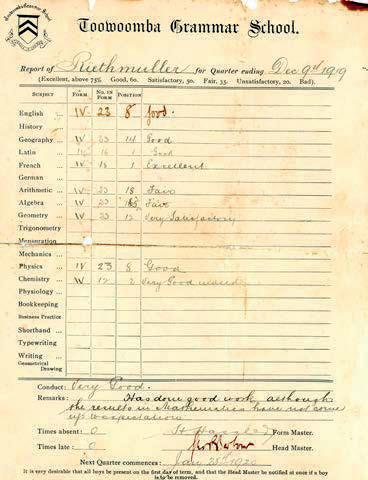


Chairman of the Board of Trustees: Dr Reginald Freshney (in his 10 th year). A photograph of the members of the School’s Board of Trustees is included in this year’s entry.
Headmaster: Mr George P. Barbour (in his 11th year)
Second Master: Mr James G. Leadbeater (in his 11th year)
Senior Prefect: Leslie A. Forster (whose younger brother, Neil, was to be Senior Prefect in 1923)
Dux of Year: Alexander F. Clappison (and also in 1921)
Total School Enrolment: 178
Senior School Total: Between 1920 and 1950 the School remained predominantly secondary oriented, although some composite ‘primary levels’ were operational from time to time in an informal arrangement.
Number of Dayboys: 111
Number of Boarders: 67
Students:
• The School Prefects were Leslie Forster, Albert Brinkworth, Daniel Brodie, Robert Challands, Matthew Heuschele and Eddie Kann.
• Roy B. Morwood was awarded an Open Scholarship to the University of Queensland based on his performance in the Senior Public Examination.
• The Headmaster’s son, Robert R.P. Barbour (1910-17 and Senior Prefect and Dux in 1917), was awarded a Rhodes Scholarship in this year. In the following year ‘Bob’ went on a three-week tour of the USA with a tennis team representing Oxford and Cambridge Universities.
• Eight years ago there were only four or five Old Boys studying at universities; now there are 32.
• Alexander D.A. Mayes (1915-1920) became a state cricketer and a highly respected member of the medical profession, including becoming Chairman of the Board of Governors o f St Andrew’s War Memorial Hospital in Brisbane.
• Alan C. McLeod (1918 -1920) made an enduring name for himself during World War II at the RAF hospital, East Grinstead, England, where he worked to surgically repair facial wounds which had been inflicted on people due to the War. Later, whilst working from his surgery which was situated at his Wimpole Street home in London, he was appointed Dental Surgeon to the Royal Family. In 1966, after being Dental Surgeon to the Queen since the death of King George VI, h e had the honour of Knight Commander of the Royal Victorian Order bestowed upon him. This was the first time that this exceptional distinction, which is the personal gift of the Sovereign, had been accorded to a dentist. Sir Alan McLeod is acknowledged on the Old Boys’ Wall of Achievement.
• Alan ‘Gordon’ Grant (1918-1920), later Group Captain Dr Alan Gordon Grant, received an OBE for services in New Guinea during World War II. Dr Grant was invited to be the Reviewing Officer at the School’s Cadet Unit annual ceremonial parade in 1969 He was also awarded an Honorary Life Membership of the Toowoomba Grammar School Old Boys’ Association in 1976.
• This year Derick M. Yeates (1920 -1924) commenced his schooling at TGS. He was the eldest of the five Yeates brothers who all attended the School. Derick was followed by Herbert ‘Bert’ N.M. Yeates (1921-1926) and later James ‘Jim’ M. (1923 -1926), Sidney ‘Fergus’ M. (1926-1930) and Neil T.M. (1929-1935). All five Yeates brothers were School Prefects, received Colours for at least two sports and played in the 1 st XI cricket team (two as Captains). Later, three of the five brothers would graduate in Medicine from Sydney University (Derick, James ‘Jim’ and Fergus), one would be a barrister/solicitor (‘Bert’) and one would be a distinguished academic at professorial level (Neil). All five brothers served in World War Two.
• Victor ‘Vic’ C. Schaefer (1918 -1920) was mentioned in the 1965 New Year Honours List as a Member of the Order of the British Empire (MBE) for his services to cricket. Vic was a former Chairman of the Queensland Cricket Association (QCA – now Cricket Queensland) and served on the Australian Cricket Board of Control.
• All boarders of this era were required to supply their own personalised s erviette ring, as listed in the School’s prospectus. The serviette ring photographed in this year’s entry carries the initials AFC i.e. Alexander Foster Clappison (1917-1921). This ring is part of the Alexander Foster Clappison collection donated to the School by his son, Mr Paul Clappison.
• Around this time, sadly and regrettably, a culture of bullying, euphemistically termed ‘squirt bashing’, was entrenched at the School, ‘squirts’ being a name for the younger boarders.
Events:
• At the start of this new decade, the population of Toowoomba was approximately 20,000 persons.
• During this time cold showers only were available to the boarders. There were no heating systems and the boys showered before breakfast on the top floor of the old original building (School House) in one room. There were three showers at each end of the room which had a cement floor.
• The School’s Cadets assisted in supplying a very imposing Guard of Honour on the occasion of the Prince of Wales’ visit to Toowoomba.
• Toowoomba Grammar Preparatory School (see 1911), the school of former member of the TGS Staff, Mr Ernest Gill, was taken over by the Church of England. It was renamed The Church of England Preparatory School but was still referred to as ‘Prep’.
• The TGS Old Boys held a Reunion Ball in May with some 240 being present.
• The School Museum holds two Glennie/TGS 1920’s dance card programs.
• The Queensland Government established the Main Roads Board this year. Most roads were constructed to feed into the rail network.
Co-curricular Activities:
• In the Chelmsford Cup competition , the School only won two of the six competitions against Ipswich Grammar School for the Chelmsford Cup – tennis and shooting. Accordingly, the Cup was presented to IGS. The School Magazine of May 1921 eloquently expressed the 192 0 Chelmsford Cup competition against Ipswich Grammar School: “ The competition for 1920 ended rather disastrously for us. The nemesis that pursues the over - confident made her presence very rudely felt at the cricket match. Up till then we had lost three of the four contests decided and were behind by six points. However, with an improved rifle team and with a warrantable expectation of success in cricket, we were still sanguine of making another draw of the whole competition. The shooting we won comfortably, but the cricket match held little glory for a team that had up till then achieved things as great as any team of recent years. The poor wicket provided may account for, but does not excuse the difference between our meagre 25 and their 91.”
• In Cricket, this year was the first time the School played St Joseph’s Nudgee College in Cricket. The match was played in Toowoomba Park in November (on matting). TGS (203) defeated NC (182).
• In the 1st XI Cricket, Eddie W. Kann and Alex Mayes each scored a century in a record opening partnership against Brisbane Grammar School (Kann 105 and Mayes 102, both retired). Playing at BGS, the TGS 1st XI side convincingly won this game (TGS 7 for 255 and BGS 95). Also in this game TGS bowler Matthew Heuschele took 5 for 42. Matthew took over as Captain of the side when Alex Mayes left the School before Christmas.
• A photograph of the 1 st XI Cricket team is included in this year’s entry. This team photograph includes three of the greatest cricketers in the School’s history, namely Eddie Kann, Alex Mayes and Matthew Heuschele, The three boys all had their final game for TGS mid-season in the 192021 season when they departed the School before Christmas.
• In this year Eddie Kann played in four GPS matches making three centuries (105 against Brisbane Grammar School, 143 against The Southport School and 103 against Nudgee College) and a 31 not out for a total of 389 runs for an average of 130 an innings. The next time a Toowoomba Grammar School cricket player scored three centuries was Kenneth J. Boag – see 1932-33).
• Eddie Kann has been acknowledged by Mr Ivan Board, the author of the two -volume set The History of Cricket at Toowoomba Grammar School (1877 -2020), as the second greatest batsman for TGS in its history, second to Martin Love (Vol.1, page 245). Eddie Kann scored 389 runs for the 1920-1921 season in four GPS matches averaging 130, a school record that stands today and may never be bettered. Eddie was also the School’s tennis champion and an outstanding athlete. For over 30 years Eddie was a sporting writer on The Sun.
• Alex Mayes was to go on and represent New South Wales and later Queensland in Shield Cricket.
• The TGS 1st XI cricket side defeated TSS with a sound win (TGS 263 d TSS 38) but the team had a ‘shocker’ against IGS when the boys scored only 25 runs (IGS 91) . This batting total for TGS represented the lowest GPS innings score for TGS in the decade of the 1920’s .
• In Rugby, the School first played Brisbane Grammar Schoo l in Rugby in 1887. It was not until this year (1920) that TGS defeated this school in Rugby with a score of 9 -3. The TGS 1st XV also won against Gregory Terrace and TSS (it was Southport’s first season of Rugby).
• In Rugby TGS was defeated by IGS (3-6) and by Nudgee (0-19).
• Rugby League became the dominant sport in Queensland between 1920 and 1928 and Toowoomba Grammar School and other schools followed suit. Rugby Union was played until 1919 and from 1920 to 1927 the code of Football played at the School was Rugby League.
President of the Old Boys’ Association: Mr George A. Godsall (one year)
Guest Speaker at the Speech Day & Prize -Giving Ceremony: Major General Sir Thomas W. Glasgow, Soldier, Politician, Diplomat, Grazier





Chairman of the Board of Trustees: Dr Reginald Freshney (in his 11th year)
Headmaster: Mr George P. Barbour (in his 12th year)
Second Master: Mr James G. Leadbeater (in his 12th year)
Senior Prefect: Robert R. Challands
Dux of Year: Alexander F. Clappison (and also in 1920) (see below)
Total School Enrolment: 179
Number of Dayboys: 113
Number of Boarders: 66
Students:
• The School Prefects were Robert Challands, Alexander Clappison, Neil Forster, James Martin, Bruce Mayes, George Nutt, William Rankin, Neville Raymond and Henry R Thomas.
• Never before in the School’s history had three TGS students been awarded an Open University Scholarship based on their academic performance (top eighteen in Queensland) on the Senior Public Examination. The scholarship recipients were: Alexander F. Clappison, James E. Martin and Leslie H. Rye.
• Ian Gillies was at the School at this time (1920-1921). Later he was to be the father of the longest serving Academic Staff member in the School’s history, Mr Russell (Russ) R. Gillies, from 19591998.
• The Dux of the School in both this year and in the previous year, Alexander F. Clappison, was later to teach at the School but only for a period of four months (August to December 1931).
• James ‘Eric’ G. Martin (1917-1921) became one of Queensland’s highest-ranking soldiers of World War II and a former Chairman and Chief Executive of the Queensland Southern Electricity Authority. Brigadier Martin was Commander of the 29 th battalion in North Africa, the 19th Brigade in Africa and New Guinea and the 7th Brigade from 1950 to 1954. He is acknowledged on the Old Boys’ Wall of Achievement. Brigadier Martin proposed the toast to the School at the Old Boys’ Dinner in Brisbane in September 1958 (see 1958). In his address, the Brigadier stated: “Very appropriately, this toast is coupled with the name of the Headmaster, for the Headmaster is inseparable from the School. For my part, when the Head of TGS is mentioned, I can never fail to remember the fine old man who presided over the School when I attended – G.P. Barbour – “Boss” Barbour as we affectionately, and respectfully, knew him. For me he set the tone of the School, ably assisted by such men as W.J. Meyer and J.A. Leadbeater and a few others, for the staff was never very large. I remember many assemblies in the Great Hall. I recall the mounting of the Honour Roll for World War I, and several occasions when senior boys were farewelled on enlistment in the A.I.F. And if we who were present did not realise that we were witnessing history in the making, we saw it in its fulfilment as K.A. or D.W. appeared after the names of a really appalling proportion of the promising Old Boys who had gone off to answer the supreme call to public service. Among those names was that of Fred Barbour, one of the Headmaster’s sons. The quiet dignity with which the old man bore his private sorrow when he received the news while an
inter-school cricket match was in progress was one of the abiding impressions of my school life.” (J.K. Winn – Still Playing The Game, pg. 177). Brigadier Martin was Guest of Honour at the annual reunion dinner of the Old Boys’ Association in 1963 and the Guest Speaker at the School’s Speech Day and Prize Giving Ceremony in 1968.
• James E.G. Martin (above) was the first Old Boy to be decorated in the Second World War. Then Lieutenant-Colonel Martin, he received the order of the British Empire (Military Division). He was the Commander of an Australian Imperial Force (AIF) Battalion which took part in the attack on Bardia. Bardia was the site of the first battle fought by the Australian troops during World War Two. (see 1941).
• Another boy from this year group, Bruce T. Mayes (1917 -1921), is also acknowledged on the Old Boys’ Wall of Achievement. He wrote a number of classic text books on obstetrics and later became Emeritus Professor of Obstetrics and Gynaecology and Dean of the Faculty of Medicine at The University of Sydney. Professor Mayes was the first Australian to hold the Sims -Black Professorship of the Royal College of Obstetricians and Gynaecologists in London in 1953. Professor Mayes was the Guest of Honour at the Sydney Branch of the TGS OBA reunion dinner in 1953 and the Guest Speaker at the School’s Speech Day and Prize Giving Ceremony in 1969.
• Neville E.M. Raymond (1917-1921) became a particularly well-known author for he wrote the very popular Smiley series of books. From this series a number of feature films were made. He was also a journalist and war correspondent and is acknowledged on the Old Boys’ Wall of Achievement.
• Thomas ‘Alan’ Foott (1919-1921) was a Duntroon alumnus, graduating in 1925 as Head Cadet (receiving the Sword of Honour and the King’s Medal). He further graduated Bachelor of Civil Engineering (Sydney University) in 1927. Brigadier Foott saw service with various military units.
• Robert K.M. Mackay was a boarder from 1920 -1921 and recounted in 1988 that as a boarder “affluence was unknown, pocket money was one shilling per week if your parents could afford that amount – some received half of that – threepence was the issue for church on Sundays. The boundary around the School was a complete upright paling fence to enclose the milking cows and the phaeton horse drawn pony or ponies, the Headmaster’s conveyance. The one (main) sports oval of the period was just north of the main entrance and road in the south-west corner just north of Herries Street and which had a small grandstand at the southern end. The message soon conveyed by the School’s influences was austerity, integrity, loyalty, sportsmanship. There were four terms yearly. Xmas holidays six weeks – midwinter two – Easter and Michaelmas (see 1942) only four days each and consequently boarders at distance stayed at the School. We all walked to various churches in town. After the service it was straight back to school. Boater hats and stiff separate collars were regulation dress for church. All upstairs on the top floor of the main building was where the Headmaster’s family had their private quarters on the eastern end. Sunday afternoons after attending to home mail we had a general talk by the Headmaster on observations of performance and our standards during the week. Later a walk to the edge of the Range was another regular. In that era there were mostly farmlets in the area. St. Vincent’s Hospital was in the planning stage only – it did not exist then. Every Sunday evening all juniors gathered with the Headmaster and his family in the sitting room, students seated on the floor. After reading selected passages from the Bible, then a few chapters from a book, it was followed by hymns.” (Source ‘Toowoomba Grammar School – The Gillies Connection’ written by J.K. Winn, published by Toowoomba Grammar School, 2013, pp 9-11).
• Albert E. Brinkworth (1919-1921) was to become President of the Toowoomba Grammar School Old Boys’ Association from 1946-1947 and also 1949-1951.
• Robert ‘Bob’ Lawton (1920-1921) was celebrated at the TGS Old Boys’ Association reunion dinner in 1992 as being the oldest Old Boy present.
• Old Boy Jack Thoms (TGS 1912) wrote to the Headmaster informing him of the sixteen TGS Old Boys studying at the University of Sydney in 1921 – three in dentistry, one in law and the rest studying medicine.
• Old Boy Eric Morwood (1914-1918) wrote to the Headmaster informing him of the ten TGS Old Boys studying at the University of Queensland in 1921. Out of the ten University students, nine were studying Engineering and one Science.
Events:
• The School’s second Headmaster, Mr Lawrence Stephenson, passed away in December aged 83 years.
• The biggest ongoing expense for the School was the payment of teaching salaries and this compounded when the first award for assistant masters in independent schools was determined by the Arbitration Court in this year. Salaries virtually doubled overnight.
• Since the visit of Sir William McGregor in 1910, the School had not been honoured by a Vice-Regal visit until His Excellency, Sir Matthew Nathan, visited in April of this year. His Excellency in addressing the boys said: “Boys, your war record is a wonderful one, and a great incentive to the present scholars to follow in the footsteps of their predecessors and to do their duty.” His Excellency continued by referring to education at school being “ the scaffolding from which is built the future residence of a man’s thoughts. Behind it, there should grow up the high building of a well-ordered culture. Take, for instance, the scaffolding of history - the long lines of names and dates. They are dull enough until they have been built up from them scenes of the world's life in the different ages, and under the influence of great men and great movements. From the grammar, which is the scaffolding of language, we build the power of clear expression and lucid writing, the art of good speaking, and the love of fine literature. From the scaffolding of arithmetic and algebra, are constructed the elements of business capacity, the surveyor's art, the engineer's science; and from the scaffolding of natural science are built not only the skill to observe the structure of the inanimate and animate worlds, but also the faculty to enjoy the beauties of Nature; from physical drill are built up health and strength, without which there is little happiness in life. I hope you understand now the need of learning dull things at school.”
• A politician, the Member for Toowoomba West, was reported to have said that Toowoomba Grammar School was a disgrace and was only fit to be burnt down. It appeared that the comment related only to the state of the building and was made following a brief visit to the School over a year ago when the interior of the building was in an unsatisfactory state. Since that time a sum of over seven-hundred pounds had been spent on its renovation.
• The School Magazine noted that “the scheme for providing a swimming bath in the school grounds is making very little headway. The gravel pit provides an excellent site with the excavation ready-made, but the difficulty is concerned with the water supply”.
• The Trustees spoke of their intention to improve the exterior of the School by converting the area in front of the main building into lawns and ornamental beds. Boys would be excluded except on special occasions from all that area adjoining the stone steps and the fig tree. The two main difficulties noted were the absence of water and the impossibility of excluding stray cattle.
• Many years later, in 1987, Mrs Challands donated honour boards in Old Hall for captains of the 1st XI and 1st XV in memory of her husband Robert. Robert Challands was the Senior Prefect in 1921 and Captain of the 1 st XI.
• In the School Magazine of 1921 on page 24 reference was made to the past Headmasters of the School. It was written: “The interesting scheme – so long dear to the heart of the Hon. L.E. Groom – for providing enlarged photos of past Headmasters, is seriously claiming the attention of the Old Boys’ Association.”
Co-curricular Activities:
• In the Chelmsford Cup competition against IGS, the final result was a tie. The School lost cricket, athletics and tennis but won football (rugby), swimming and shooting.
• In Athletics, reporting on the GPS Athletics competition the School Magazine wrote: “In the final order of competing schools we filled rather an ignominious position. Nudgee won comfortably from Southport.”
• In Cricket, the School Magazine writers were extremely direct in their assessment of some of the TGS 1st XI bowlers, viz: “As a fast bowler Row is only half fast; as a swerver Gregory needs a wind and is apt to waste the new ball by bad length; as a slow bowler Forster turns the ball only half far enough to be difficult.”
• In cricket, TGS (84) was defeated by BGS (6/222) and by IGS (161-219) The School Magazine reported that: “The overall standard of school cricket generally is a good deal below the standard of a few years back.” A photograph of the cricket side is included in this year’s entry.
• In Rugby the 1st XIII rugby league team defeated IGS (8-0), the School’s first win against IGS in rugby since 1916. A photograph of the 1st XIII is included in this year’s entry.
• The 1st rugby team was defeated narrowly by NC (3-9) and the team also lost to BGS (0-21). Owing to an outbreak of influenza in Southport, TSS was unable to invite our team to play.
• In Cadets, Major Pain DSO, MC visited the School and after seeing the boys put through their various drill movements and physical training exercises, expressed the opinion that the work would be very hard to beat in any part of the Commonwealth. He said the steadiness on parade and immediate obedience to their various drill orders were carried out more like permanent troops than cadets. The Cadets were also issued with a new uniform this year.
General:
The following address delivered to the boys on Friday, April 22nd 1921 has been selected as it refers to the importance of education in providing a scaffolding for one’s future. It also stresses to the boys that there is a reason even for learning dull content in the classroom. The address was delivered by Sir Matthew Nathan, Governor of the State when he visited Toowoomba Grammar School. It had been reproduced in the School Magazine of 1951.
Sir Matthew stated: "Boys, your war record is a wonderful one, and a great incentive to the present scholars to follow in the footsteps of their predecessors, and to do their duty. 1 have been asked to say a few words to you. I expect you sometimes wonder, when you are doing your lessons, what good will come of them; that you say to yourselves: "Of what advantage is it to us to know the date on which Magna Carta was signed, or even that of Captain Cook's discovery of the Queensland coast? You think that you will probably be able to speak readily enough without the study of grammar. You wonder what can be the earthly good of learning that (A plus B) squared is equal to A squared plus 2AB plus B squared, and what particular advantage is gained from the classification which forms such a large part of the elements of natural science. You probably have a greater conviction of the advantage of games, though I expect you have not much to say in favour of physical drill.
Have you ever thought when you have passed a big building being e rected, what an important part is played in that erection by the scaffolding? The scaffolding itself is not attractive, and no one but a fool would desire to have a scaffolding for his permanent residence, but without it, it would be impossible to erect the building, to provide the residence which is both useful and beautiful. School education is the scaffolding from which is built the future residence of man's thought. Behind it, there should grow up the high building of a well-ordered culture. Take, for instance, the scaffolding of history - the long lines of names and dates. They are dull enough, until they have built up from them scenes of the world's life in the different ages, and under the influence of great men and great movements. From the grammar, which is
the scaffolding of language, we build the power of clear expression and lucid writing, the art of good speaking and the love of good literature. From the scaffolding of arithmetic and algebra, are constructed the elements of business capacity, the surveyor's arts, the engineer's science; and from the scaffolding of natural science are built not only the skill to observe the structure of the inanimate and animate worlds, but also the faculty to enjoy the beauties of nature; from physical drill are built up health and strength, without which there is little happiness in life. I hope you understand now the need of learning dull things at school. Think of yourselves as labourers helping your teachers, who are the skilled artisans in erecting the poles of fact, and in fastening to them with the tightening cords of your memory, and the iron days of your reason, the beams and planks of ordered arrangement; then, presently, the time will come when you will be master builders yourselves, the architects of your own futures, building with your own efforts the high mental outlook from which you will, I hope, through long and happy lives, o'ersee a better growing world."
President of the Old Boys’ Association: Brig.-Gen. James C. Robertson (one year) and also in 1928
Guest Speaker at the Speech Day & Prize -Giving Ceremony: The Hon. John Huxham, QLD Minister for Public Instruction
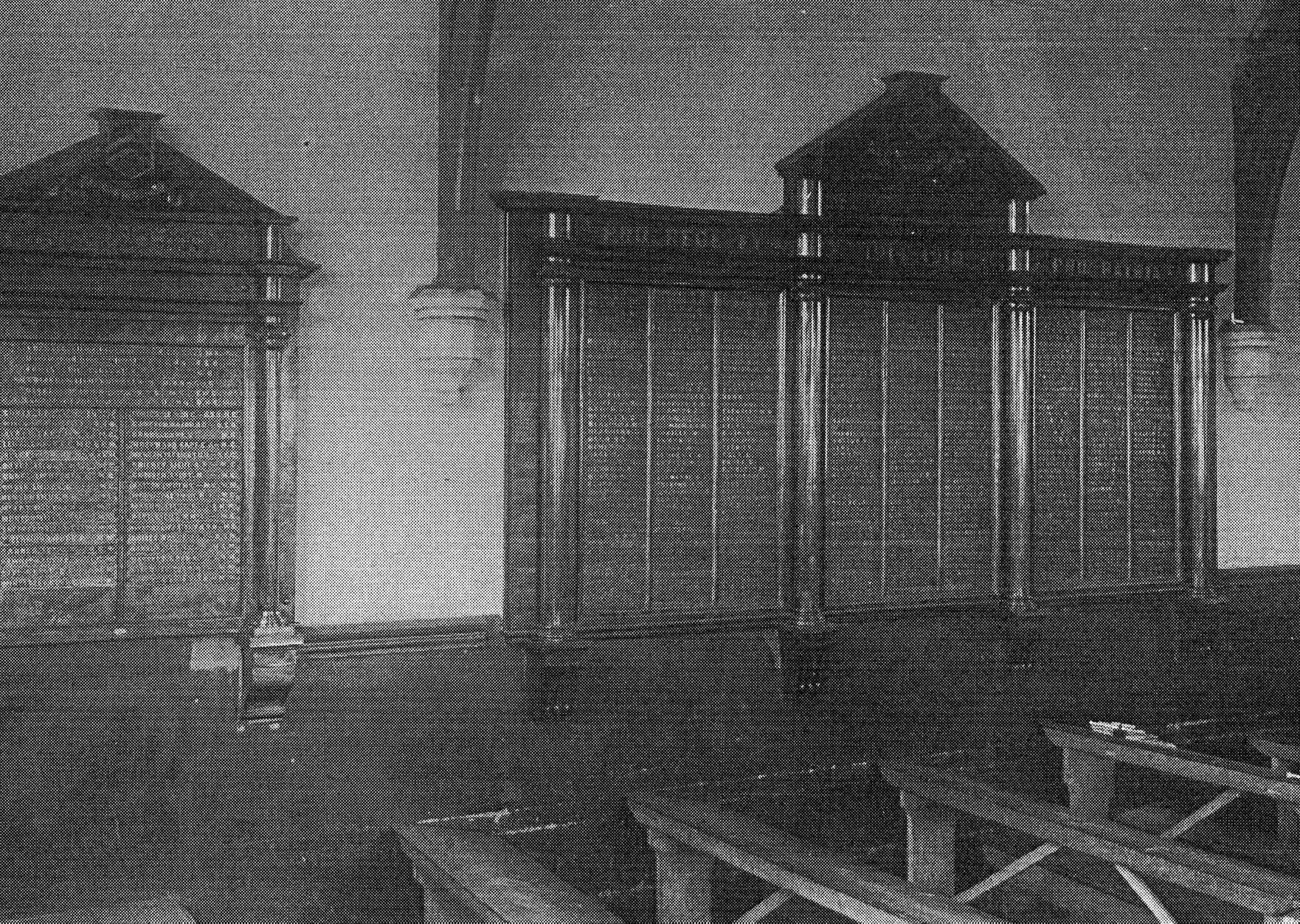
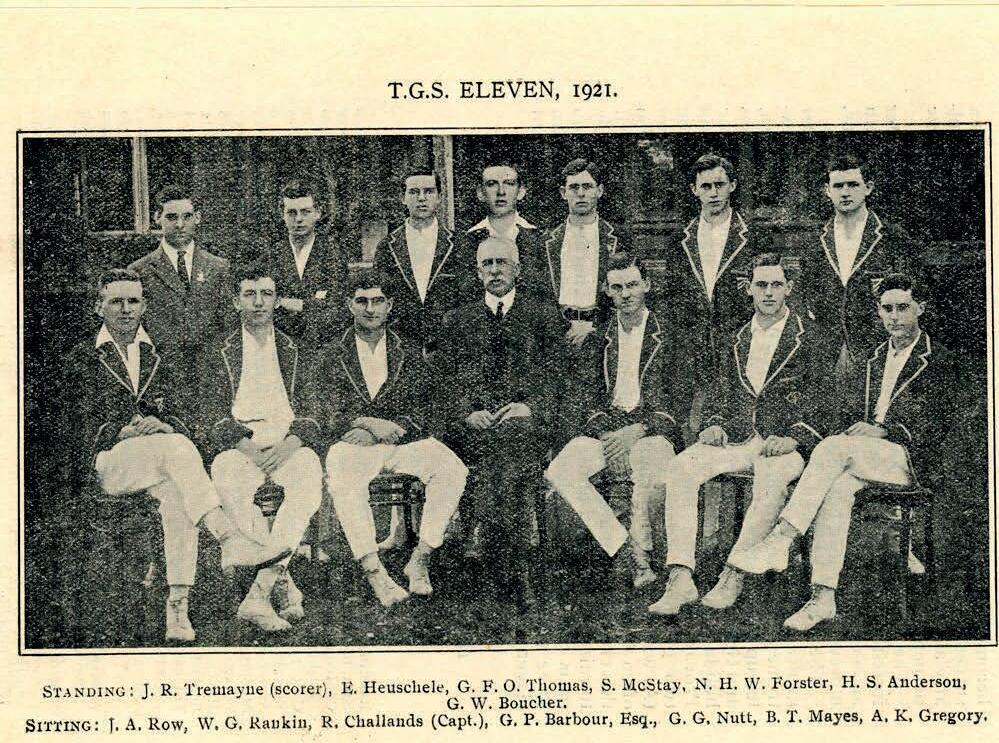
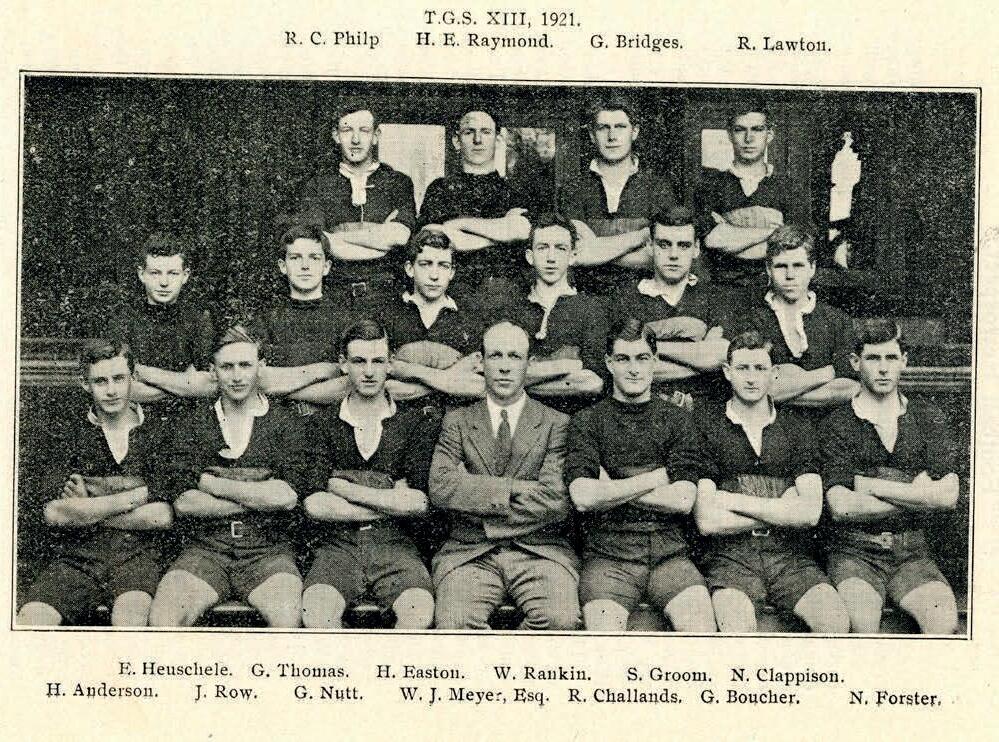
Chairman of the Board of Trustees: Dr Reginald Freshney (in his 12th year)
Trustees: Following the resignation of long-serving Trustees, Messrs Bernays and Frost, two new Trustees were appointed. The new Trustees were both former Presidents of the Old Boys’ Association – BrigadierGeneral J.C. Robertson and Lieutenant-Colonel C. Fortescue.
Headmaster: Mr George P. Barbour (in his 13th year)
Second Master: Mr James G. Leadbeater (in his 13th year)
Senior Prefect: William G. Rankin (and Dux, who later became a member of the Mathematics teaching staff from 1926 to 1933: see 1933). Also, in an interesting aspect of our School’s history, ‘Bill’ Rankin was appointed as Deputy Headmaster of the Scots College, Sydney, when the then -incumbent, Mr David Griffiths, was invited to become the Headmaster of Toowoomba Grammar School in 1947.
Dux of Year: William G. Rankin
Total School Enrolment: 165
Number of Dayboys: 113
Number of Boarders: 52
Students:
• The School Prefects were William Rankin, Harold Anderson, Neil Forster, Herbert Johnston, John Row, Geoffrey Thomas and William Williamson. A photograph of the School Prefects is included in this year’s entry: (Standing from left) G.Thomas, W.Williamson, H.Johnston, H.Anderson, J.Row (Sitting) W.Rankin, Headmaster Barbour, N.Forster.
• James ‘Jim’ A. Pollock (1920-1922) topped the State for the first Byrnes Medal to the School (awarded to those placed first in Queensland in the Junior Public Examination between the years 1912 and 1971) (see 1924 and 1937). In the previous year of 1921 , Edward A. McDonald was placed second for the Byrnes Medal. The Byrnes Medal was named after a former Premier of Queensland, Thomas Joseph Byrnes, who died in office at the age of 38 in September 1898. Thomas Byrnes was born in rural North Queensland, the son of a farm labourer and the eighth of eleven children. Later he was educated at Brisbane Grammar School and the University of Melbourne. James ‘Jim’ Pollock, in 1931, was awarded the highest engineering award available from the University of Queensland – the Walter and Eliza Hall Engineering Fellowship, which enabled him to further his engineering studies overseas.
• William ‘Bill’ G. Rankin (1918-1922) won an Open Scholarship to the University of Queensland based on his performance as one of the top eighteen students in the State in the Senior Public Examination. He joined the teaching staff of Toowoomba Grammar School in 1926 -1933. Later in his career he was to be appointed Vice-Principal of Scots College, Sydney, following the resignation of the former Vice -Principal of Scots, Mr David Griffiths, when he was appoi nted as the new Headmaster of TGS in 1947 (see 1947).
• Francis J. Hopkins (1919-1922) was to join the School’s Board of Trustees in 1950.
• William H.H. (‘Bill’) Wright (1919-1922) was later to be appointed as a Master -in-Charge of the Primary Division of the School in 1951 (see 1951). He taught at the School for 13 years.
• The success of Old Boys in their University years was as conspicuous as in the previous year, and of those who graduated in Engineering at the University of Queensland, not only were forty -five per cent TGS Old Boys, but practically all the merits secured had gone to them.
Events:
• It had been told that the Headmaster, Mr Barbour (Headmaster from 1910 -1935), had a habit of arriving at cricket practice with a hoe; he would bat for a while and then chip out weeds from around the pitch.
• There was no New Boys’ Concert in the boarding house this year due to the poor behaviour in previous years where it was the practice to ‘rag’ the new boys considerably. The common forms of ragging included ducking in the horse trough, spending a period of time in the ‘black hole’ and singing a compulsory song.
• The School published a Prospectus and, in a section titled ‘Athletics’, the booklet referred to the boys receiving twenty minutes of physical drills given daily under specially instructed squadcommanders. The chest and other measurements of the boys were also periodically registered. The Prospectus also referred to the School’s two grounds for cricket and football, two tennis courts, a gymnasium in the school grounds and a recreation room for boarders.
Co-curricular Activities:
• In the Chelmsford Cup competition against IGS, the Cup had again been won by TGS. In the Chelmsford Cup competition, tennis was below par, but the shooting team made a record score, and Thomas' 48 out of 50 was an individual record. The School lost swimming, tennis and athletics.
• The School resumed playing rugby and cricket against The Southport School after a break from 1912-1921
• In Cricket, playing in Brisbane on 30 March, BGS won by 9 wickets after TGS scoring 128 and BGS 82 in the first innings but with TGS scoring only 42 runs in the second innings . TGS opening bowler, John Row, took 5 wickets for 31 runs (see below and the ‘Students’ section in next year’s entry). The day after the BGS game, TGS played The Southport School for the first time since 1911. This game was a draw.
• John Row scored 141 runs in a game against Sydney Grammar School when its 2 nd XI toured Queensland in December. TGS scored 320 and Sydney Grammar School replied with 8 for 200.
• The 1st XI cricket game against IGS on 9 November 1922 at Ipswich was won by TGS by 26 runs on the first innings
• In Rugby League, the Football (rugby) team had achieved what no previous TGS team had done - the defeat of Ipswich, Brisbane and Southport - in one season.
• The School’s 1st XIII lost only one match this year. TGS defeated the team representing Brisbane Grammar School for only the second time since 1887 with a winning score of 23 -5. In Rugby League the School defeated Ipswich (6-0), TSS and BGS but lost to NC.
• In Swimming, the 17th annual Swimming Carnival was held at the City Baths in March.
• In Tennis, the School Magazine reported that “The tennis of the School seems to have fallen upon bad times”.
• In Cadets, the Unit competed in the Queensland Cadet Championships held in Brisbane. Events included swimming, athletics and shooting.
President of the Old Boys’ Association: Lt.Col. Charles Fortescue (1907 -1909) was President of the Association for this year and also in 1930, 1934, and 1939 (see 1909).
Guest Speaker at the Speech Day & Prize -Giving Ceremony: His Excellency The Governor, Sir Matthew Nathan
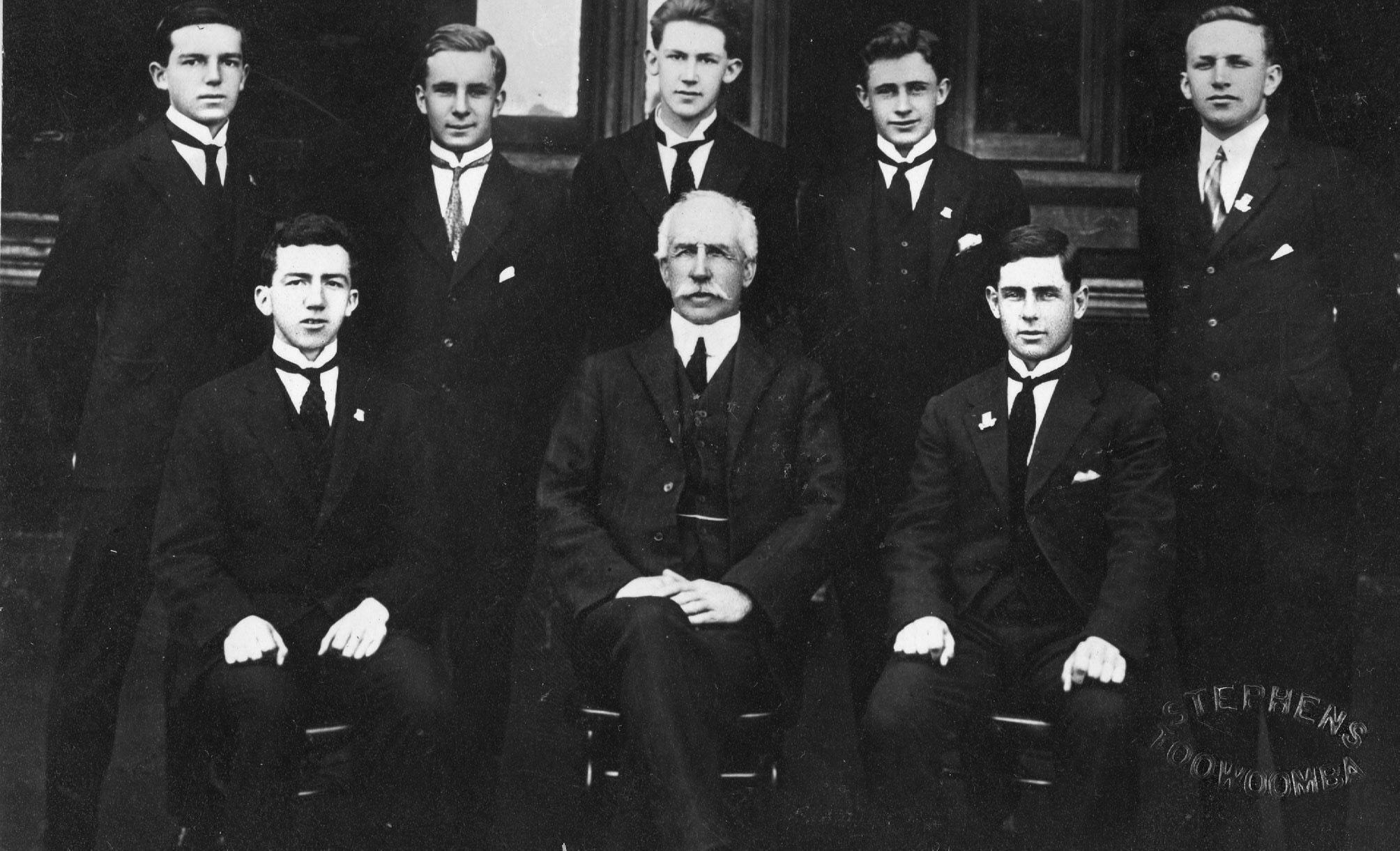
Chairman of the Board of Trustees: Dr Reginald Freshney (in his 13th year)
Headmaster: Mr George P. Barbour (in his 14th year)
Second Master: Mr James G. Leadbeater (in his 14th year)
Senior Prefect: Neil H.W. Forster (in later years his son, Richard W. Forster, was to be appointed Senior Prefect in 1959)
Dux of Year: Edward A.F. McDonald
Total School Enrolment: 161
Number of Dayboys: 100
Number of Boarders: 61
Students:
• The School Prefects were Neil Forster, Edward ‘Ted’ Belford, Kenneth Carmichael, Edward McDonald, Ken Paterson, John Row and Thomas Trevethan. A photograph of the School Prefects is included in this year’s entry.
• The Senior Prefect, Neil H.W. Forster (1919 -1923), was elected as an Honorary Life Member of the TGS Old Boys’ Association in 1981.
• John A. Row (1919-1923) was an outstanding athlete and was Captain of the 1st XV Rugby, the 1st XI Cricket and the Athletics team. In 1963 he was elevated to Cabinet as the Minister for Agriculture and Forestry and shortly after was appointed Minister to the new portfolio of Primary Industries. The Honourable Sir John Row was the School’s Speech Day Guest Speaker in 1965 and is acknowledged on the Old Boys’ Wall of Achievement .
• Edward G. Thompson (1922-1923) was also acknowledged on the Old Boys’ Wall of Achievement as a Rugby Union International. ‘Eddie’ Thompson came to the School when ‘King’ Renwick was the rugby coach. Later he was made vice-captain of the Queensland team in 1929 and played four tests for Australia – three against New Zealand who were defeated in all three games by Australia and one test with the Australian team which defeated the British Lions (6-5) in 1930.
• John McCahon (1922-1923) was born in Ohio, USA, of Irish descent. He left TGS in 1923 to live in Ireland with his family. At his new school, the Coleraine Academical Institution, he introduced the TGS war-cry. The background to this initiative was that in 1925 the New Zealand All-Blacks toured the British Isles and were undefeated in all their matches. The All-Blacks team, at the start of each match, performed their famous war-cry and dance, now known as the ‘Haka’. When the Coleraine Academical Institution boys reached the final of the Schools’ Cup in 1926, someone thought that they, too, should have a war cry and it was John McCahon, fresh from Australia, who supplied it. John told his schoolmates in his new Irish school that his old school in Australia, Toowoomba
Grammar School, had a war cry and suggested this, with only a few alterations. Eighty years later, this School was still using a version of the TGS war-cry. In 2015 the Coleraine Academical Institution school went co -educational and is now known as the Coleraine Grammar School. The war-cry of this Northern Ireland school goes as follows:
He Ta He Ta He Ballywanga
He Tah He Tah Ha
Hunc a Hunc a Hunc
Ballywanga
Cra Cru Cra
Rick Rick Rickety Rick
Iski Iski I
He Ballywanga
Ting Tong Tanga
CAI
Coleraine! (See ‘Students’ 1910)
• Frank G. Broadfoot (1922-1923), the brother of Cecil and William, played as half-back for Queensland from 1930 to 1933.
• Ken Carmichael (1920-1923) was quoted in the School’s Newsletter Blue and Gold in 1962 as recalling: “…the great skill of Hans (‘Mo”) Hassler in the classroom, and the quiet dignity with which he discouraged the many practical jokers who tried to bait him.”
• Edward (Ted) Belford (1922-1923) was a Prefect and later became Secretary of the Brisbane Branch of the TGS Old Boys’ Association in 1925 to 1927. He was a staunch member of the Old Boys’ Association. A prize known as the Belford Prize was first awarded by E.J. Belford to a Year 12 (Form VI) student in 1934 until 1968. In 1969 the Prize became known as the Belford Prize for Scholarship, Leadership and Sport and was awarded to a student in every form. In 1983 it was awarded to students in Forms IV, V and VI and in 1984 (to the current day) the Prize is awarded to a student in Year 11 and one in Year 12. The Prize is awarded at the annual Speech Day and Prize Giving Ceremony.
• H.A. ‘Alan’ Dunn (1922-1923) was to become the Chief of Staff of Toowoomba Newspaper Pty.Ltd. (The Toowoomba Chronicle) but sadly died very early at the age of 32 years. He worked tirelessly for the School and the Old Boys’ Association and the School introduced a Speech Day Prize, the Alan Dunn Memorial Prize in 1943 in his honour. The subject prize was initially for the study of English (1943-2002) and from 2003 for the study of Ancient History. In addition to his work at The Toowoomba Chronicle, Alan had been the President of the Past Grammar Cricket Club, the Past Grammar Rugby Union Football Club and the Past Grammar Swimming Club.
• Archibald ‘Arch’ Black (1921-1923) attended the 1993 TGS Old Boys’ Association reunion dinner and could witness four generations of the family attending the School.
Events:
• The tuition fees for each quarter were four pounds and four shillings. The fees for boarders were thirteen pounds and thirteen shillings per quarter in addition to the tuition fees.
Co-curricular Activities:
• Toowoomba Grammar School’s nomination to enter the GPS Association had not formally been recognised until the following year. The following entries are “unofficial” GPS Premierships due to this fact.
• In the Chelmsford Cup competition, success in all competitions except tennis against IGS saw TGS win the Cup. Victories against IGS this year were in football, swimming, athletics, cricket and shooting.
• In Athletics, the School was placed third in the GPS Athletics competition out of the six sc hools competing. TSS could not compete due to an epidemic. C laude Saunders for TGS won the senior 120 yards hurdles. The next year in which a TGS hurdler won the Open GPS 120 yards hurdles event was in 1945.
• In Cricket, the 1st XI was undefeated in the 1923 -1924 season. The 1st XI achieved an unofficial GPS Cricket Premiership in the 1922/23 cricket season.
• On October 15 for the first time the School played cricket against (and defeated) Church of England Grammar School (now Anglican Church Grammar School, ‘Churchie’). The game was played in East Brisbane and the score was TGS 5/220 defeating CEGS (Churchie) 74. In this match the TGS Captain of Cricket, John Row, took 6 for 26. Playing against Brisbane Grammar School, the 1st XI won this game, TGS (224) d BGS (168). The School’s 1 st XI secured another win against IGS with TGS (210) defeating IGS (95). In this game, TGS bowler Percival ‘Phil’ Staines took 5 for 13 in a fine debut.
• On 29 November TGS played Nudgee College on the Nudgee oval. This was only the second match ever played between the two schools. TGS bowler Bert Yeates took 5 wickets for 27 runs, his first 5 wicket haul at just 15 years of age. TGS won this match on the first innings by 21 runs.
• In Rugby League, the School’s 1st XIII Rugby League team was (unofficial) Premiers, being undefeated during the season and winning matches against BGS, Nudgee (9-0), IGS (19-8), and TSS (19-18) The season included a win against St.Joseph’s Nudgee College 9-0, the first time the School had defeated NC in rugby (league) who were the ‘official’ Premiers (see 1914). Many would rate this TGS rugby team as one of the most successful in the School’s history. A photograph of the 1923 Rugby League team is included in this year’s entry - (Back Row) - A. Provan, R. Philp, E. Thompson, J.Tremayne (Middle Row) - C. Sachse, S. Taylor, N. Clappison, K. Paterson, K. Carmichael (Sitting) - N. Forster, J. Row, Mr W. ‘King’ Renwick, Mr R. Percy, T. Trevethan, E. Heuschele and (Front Row) - H. Forster, A. Hilless.
• Five Rugby players – John Row, Thomas Trevethan, Eric Heuschele, Ken Carmichael and Ken Paterson - were all chosen to play for the combined country schools in the match against the metropolitan schools and helped considerably to win the match.
• In the following year the Open Firsts TGS rugby league team was undefeated once again but also played one draw. The 1926 50 -year Jubilee Review selected the 1923 team (with 1924) as the best teams in the School’s first 50 years.
• In Tennis, of the four school games played, the 1 st IV had one victory (against Nudgee College). In this tennis match the final score was TGS 8 rubbers, 16 sets and 102 games defeated NC 0 rubbers, 1 set and 44 games.
• In Cadets, in 1923 the School’s Cadet Unit mounted the Guard on the Mothers’ Memorial, a tradition the School has undertaken every year since this time (with the exception of 1943).
President of the Old Boys’ Association: Mr Atherton A. Griffiths (for one year)
Guest Speaker at the Speech Day & Prize -Giving Ceremony: His Excellency The Governor, Sir Matthew Nathan

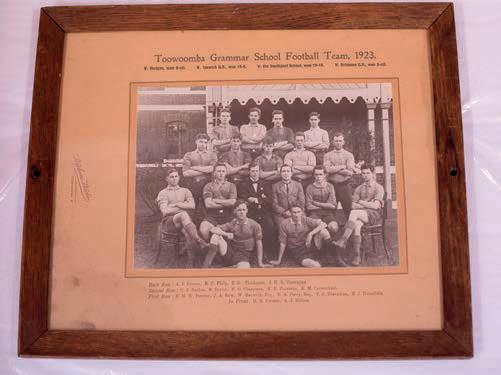
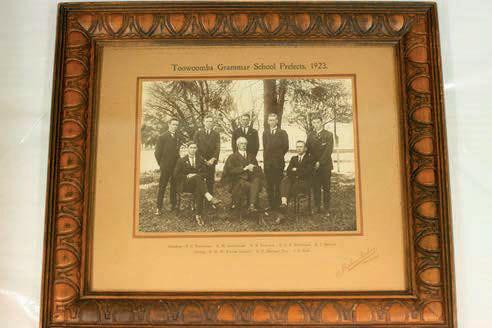

Chairman of the Board of Trustees: Dr Reginald Freshney (in his 14th year)
Headmaster: Mr George P. Barbour (in his 15th year)
Second Master: Mr James G. Leadbeater (in his 15th year)
Senior Prefect: Kenneth M. Carmichael (and also in 1925; see 1925)
Dux of Year: James ‘Jim’ A.A. Pollock (who also achieved 1st in the State in the Open Scholarship to the University of Queensland in 1927), a position not achieved again by a Toowoomba Grammarian until 1939 and then again in 1946 and 1954. James had also won the Byrnes Medal in 1922 for being placed 1st in the State in the Junior Public Examination. Another Toowoomba Grammarian was to be awarded the Byrnes Medal in 1925 (see 1925).
Total School Enrolment: 174
Number of Dayboys: 121
Number of Boarders: 53
Staffing:
• Mr William ‘Bill’ Hatherell commenced his employment at the School and served from 1924-1952 He came to the School as a Master from Sydney Grammar School and Sydney University. Soon after coming to the School he took over coaching the 1st and 2nd XV for a period of more than 25 years.
Students:
• The School Prefects were Kenneth Carmichael , Archibald Hilless, Gerard ‘Gerry’ Noble, James Pollock, James Tremayne, Tom Trevethan and Derick Yeates.
• The Dux of the year, James ‘Jim’ A. Pollock, topped the State for an Open Scholarship to the University of Queensland and his pass of six merits and two passes was the best ever achieved by a student at the School to date. Jim Pollock’s first place in the State was only the second thus far achieved by a student at the School. The School had several times been second, but had not occupied first place since Charlie Wonderley did so in 1912. Second place has been secured by Bob Jackson, Syd. Bond, Eric Morwood and Rob Barbour. The latter had the best Senior pass, with five merits and three passes, until ‘Jim’ Pollock surpassed this with six merits and two passes.
• James ‘Jim’ Pollock (above) graduated Master of Engineering at the University of Queensland. At the university and Emmanuel College he met with considerable success in a field not available to him at Toowoomba – rowing. Jim represented the University of Queensland in the Inter -Varsity Boat Race in 1928. In 1929 Jim was a candidate for the Rhodes Scholarship and the selection
committee departed from previous practice to the extent of declaring him ‘proxime accessit’. I n 1931 Jim furthered his engineering studies overseas and later spent his professional life as a partner in his engineering firm Pollock and Barton at Mackay.
• Graham ‘Singy’ Myles ran a 10.1 seconds for the Under 16 -100 yards in the GPS Track and Field Competition. It was a GPS record for approximately 40 years (see 1925 , 1926 and 1927).
• Reginald Swartz (at school 1924) had a distinguished military career and, in federal politics, he held a number of significant posts and ministries. These included Leader of the House of Representatives (1971-72), Minister for National Development (1969 -72), Minister for Civil Aviation (1966-69), Minister for Social Services (1965), Minister for Health (1964 -66) and Minister for Repatriation (1961-64). The Honourable Sir Reginald Swartz was Guest Speaker at the School’s Speech Day and Prize Giving Ceremony in 1953 and he is acknowledged on the Old Boys’ Wall of Achievement.
• Godfrey J. Black (1920-1924) later studied Law at the University of Queensland and became a distinguished educator, being appointed as Queensland’s Director General of Secondary Education in 1958
• The Rugby, Cricket and Athletics teams were all captained by Tom Trevethan (1919-1924) who in later years represented Queensland in Rugby Union. He also was the GPS 440 yards champion in this year. In 1957 Tom Trevethan’s son, Ross, also captained the 1 st XI Cricket team. A photograph of Tom Trevethan is included in this year’s entry below.
• Derick M. Yeates (1920 -1924) later graduated in Medicine with honours from Sydney University and was subsequently admitted for a Fellowship of the Royal College of Surgeons of England (see 1928).
• Cecil F. Sachse, a member of the 1sts Premiership Rugby League team and Open Shot Put Champion, was later a Queensland wrestling champion.
• The School Magazine of this year recorded a rather uncomplimentary comment about the Juniors this year. On page 7 it was written: “ The twelve Senior candidates ar e expected to give a good account of themselves, but the Juniors are weak in both numbers (34) and in quality.”
Buildings:
A new Chemical Laboratory was erected to commemorate the Jubilee of the School. The Foundation Stone was laid by His Excellency Sir Matthew Nathan, G.C.M.G., Governor of Queensland, on December 4th 1924 and a photograph of this event is included in this year’s entry. In the early 2000s the building was used as a Cadet Q Store. In 2009 the building was converted to the School Museum (see 2009).
Events:
• Toowoomba Grammar School formally joined the Great Public Schools’ (GPS) Association in this year. The School had been playing in the GPS Cricket competition since its inception in 1918.
• The Headmaster wrote to the Trustees requesting that they provide an electric iron for the laundry for the cost of about two pounds.
• Even at this time, cold showers were the order of the day. The young ‘squirts’ had to present themselves at the pantry at 6:00am each morning to collect two 7lb syrup tins of hot water for the senior boys!
• The School’s 1st XIII Rugby League team played Ipswich Grammar School in a curtain-raiser to the famous Toowoomba v. England 1924 League game (TGS won 3-2).
Co-curricular Activities:
• In Athletics, the School’s Athletics team was placed 3 rd in the GPS championships.
• In athletics, see ‘Singy’ Myles in the ‘Students’ section of this year’s entry. Also, Tom Trevethan won the Open 440 yards event at the GPS Athletics Championships.
• In Cricket, this year saw a 1st XI Cricket GPS Premiership (captained by Tom Trevethan). In school matches the 1st XI maintained its undefeated state and it was now three years since the School had lost an inter-school 1st XI cricket game.
• This year on 29 February was the first time the School played cricket against (and defeated) Brisbane Boys’ College (BBC). The game was played on the TGS oval and TGS declared its innings at 6 for 237. Bert Yeates took 5 for 45 and John Row, 5 for 50. The game was won by TGS by 68 runs.
• In the game against Brisbane Grammar School played in March at TGS, TGS scored 126 runs and with John Row taking 5 wickets for 23 runs, BGS scored 64 in the first innings. This was another win for TGS, outright by 68.
• Against The Southport School in a game on 1 April 1924, TSS scored 62 with TGS bowler John Row taking 6 for 34. TGS replied with 188 runs. TGS won by an innings and 12 runs.
• Against CEGS played at Toowoomba on 25 October, TGS declared at 7 for 210 with CEGS all out for 106. Ken Padget for TGS took 6 wickets for 69.
• ‘Bert’ Yeates took 5 for 28 in the game against Nudgee College with NC scoring only 57 runs with TGS scoring 122.
• The writers in the School Magazine appeared pessimistic with the following forecast – “…to be candid, the prospect for next year's 1st XI cricket team is dismal”.
• In Rugby, the School formally entered the GPS Rugby competition in this year. The 1 st XIII players were GPS Rugby Co-Premiers (shared with Nudgee College and captained by Tom Trevethan and coached by Mr W. ‘King’ Renwick) and undefeated during the season (but with one drawn game, against Nudgee College). The same winning score line of 24-2 was experienced in the TGS matches against BGS and TSS. The 1924 1st XIII team had only one team score a try against them (Nudgee College). A photograph of this GPS Premiership team is included in this year’s entry below. The next GPS Rugby Premiership won by the School was in 1930 (outright). The 1927 50-year Jubilee Review selected the 1924 team (with 1923) as the best teams in the School’s first 50 years.
• In Tennis, the School Magazine noted: “Notwithstanding the ruggedness of the courts and the high price of balls, the condition of the school tennis is very promising.”
• In Drama, the School’s Dramatic Society returned as a co -curricular activity with two public performances in October and December at the Town Hall. The October production involved two one-act comedies by Gertrude Jennings, Elegant Edward and The Bathroom Door. In December, The Dear Departed was performed with a repeat performance of The Bathroom Door.
President of the Old Boys’ Association: Mr William I. Garde (one year)
Guest Speaker at the Speech Day & Prize -Giving Ceremony: His Excellency The Governor, Sir Matthew Nathan. This was the first time in many years that the Speech Day was held on the school grounds. Several hundred people were present when, in beautiful weather, the Governor arrived at 2.30pm and took his seat with the Trustees and Masters on a platform erected on the lawn.
SomewhZZat remarkably, the Speech Day and Prize Giving Ceremonies being held outdoors on the school campus throughout the years 1924-1963 were generally in fine weather (perhaps with the odd exception such as 1960). In 1964 and beyond, the Speech Day and Prize Giving Ceremonies were held away from their traditional location on the front lawn of School House to the newly constructed Assembly Hall.



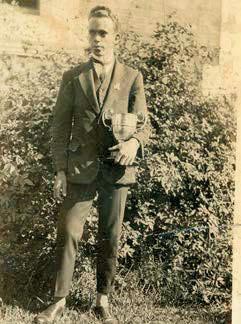
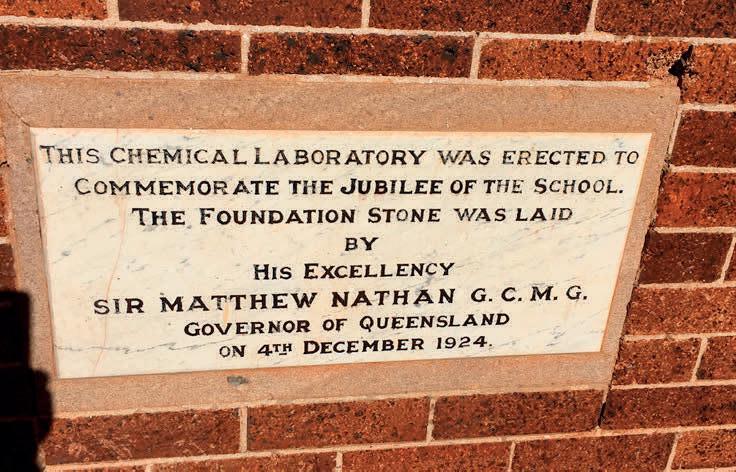

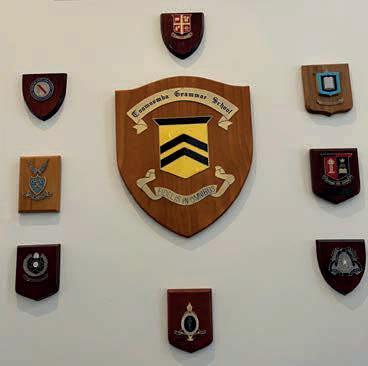
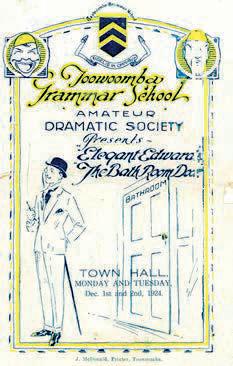
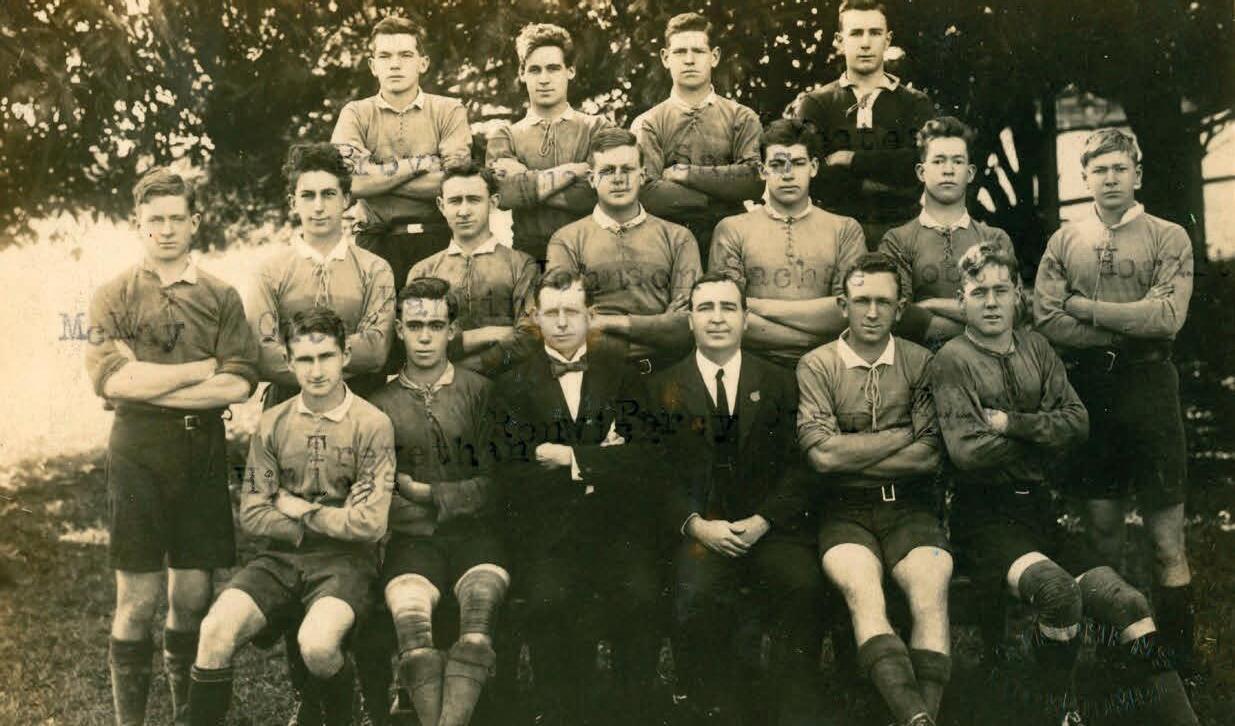
Chairman of the Board of Trustees: Dr Reginald Freshney (in his 15th year)
Headmaster: Mr George P. Barbour (in his 16th year)
Second Master: Mr James G. Leadbeater (in his 16th year)
Senior Prefect: Kenneth McF. Carmichael (and Dux)
Dux of Year: Kenneth McF. Carmichael (see below)
Total School Enrolment: 169
Number of Dayboys: 101
Number of Boarders: 68
Staffing
• Mr L.W.A. Scott returned to the Staff in July.
Students:
• The School Prefects were Kenneth Carmichael, Gerard ‘Gerry’ Noble, Archie McIntyre, Alexander Provan and James Yeates.
• Lister Hopkins (1923-1927) won the Byrnes Medal, with the highest average yet obtained in the Junior Public Examination. This medal was awarded to the student who was placed first in Queensland for that examination. Two years later he was to secure first place in Queensland in the Senior Public Examination and in 1932 he was named as Queen sland’s Rhodes Scholarship winner (see 1927). The next time a TGS student was to be awarded the T.J. Byrne s Memorial Medal for top of the State was J.C. Rivett in 1937.
• Two students won Open University Scholarships to the University of Queensland based on their performance in the Senior Public Examination. The two successful scholarship recipients were Ken M. Carmichael and Gerard ‘Gerry’ Noble.
• Jack Stegall (1923-1925) played three years in the 1st XIII Rugby League team. Later he was a permanent member of the Aust ralian Rugby Union team for four years (including 1931 touring New Zealand aged 21 years), played three tests again against New Zealand in 1932, and later played against the Springboks in South Africa. Steggall was with the first Australian team to challenge the Springboks at home and played in all five tests. His first -class career ended by the time he was 23 after having played a total of 10 tests. Jack Steggall was later to be the Secretary of the Sydney Branch of the Old Boys’ Association and attended the Old Boys’ Reunion Dinn er, held at the School, in 1962 (also see 1948). Many would claim that Jack Stegall was one of the best backs to have ever attended the School.
• The School’s Senior Prefect and Dux, Ken Carmichael (1920-1925), was to be selected as a Queensland Rugby Union representative in 1930. He also went on to marry one of Headmaster Barbour’s daughters (Freda) in January 1934 as well as being very heavily involv ed in various branches of the Old Boys’ Association. These included being its President in 1938, President of the TGS Sydney Branch in 1939, and President of the TGS Brisbane Branch in 1957. For many years Ken Carmichael was a regular and valued contributor to the School Magazine with his various letters to the School focussing on the activities of TGS Old Boys. In 1955 Ken as a member of the Sydney Branch of the TGS OBA, together with his wife, were guests of the Acting Headmaster of Scots College, Sydney, at a ceremonial parade by the College cadets. The Acting Headmaster was a contemporary of Ken Carmichael at TGS, Mr W.G. Rankin (1918-1919). The Salute was taken by another TGS Old Boy, Lieut.General E.W. Woodward (1911-1916) Ken Carmichael was elected as an Honorary Life Member of the Toowoomba Grammar School Old Boys’ Association in 1976. He showed great and continuing devotion to his old school for more than half a century.
• Rowland J. Dunn (1924-1925) was to become a member of the School’s Board of Tru stees in the late 1940s.
• D.L. ‘Lloyd’ Skerman commencing at TGS in 1925 was one of six brothers to attend the School. Percy (1924-1926) gained a Doctor of Agricultural Science; Douglas (1925 -1926) became a Doctor of Veterinary Science; Reginald ‘Graham’ a Master of Arts and a Presbyterian Minister and a teacher at TGS (1927-1928); Ian (1929-1931) and Lloyd returned to the land; and Victor (19351936) became the first Professor of Microbiology at the University of Queensland.
• The travels of Gerald Manley (1924 -1925) made interesting reading in the School Magazine of 1944. It read: “A globe-trotting Old Boy of the twenties' period is Gerald Manley. Whaling near the Antarctic, five years' frontier service with the Irish Lancers in India, a paratrooper with the British regiment, are only few of his exploits. He saw the Battle of Britain and arrived for the second time in India at the height of the riots. Was recently married in Toowoomba and is away again, this time with the A.I.F.”
Buildings:
• The new Jubilee Chemistry laboratory building was completed, having had its foundation stone laid by His Excellency, Sir Matthew Nathan GCMG, Governor of Queensland on 4 December last year. The building’s interior, complete with tiered desks, was essentially designed by the then School’s Chemistry Master, Mr Hans Hassler. A photograph of Mr Hassler with students in the Chemistry laboratory building is included in this year’s entry. In the mid 1970s the building was still used for science classes, before being decommissioned a few years later. It was then progressively used as the School’s sports equipment room, the seamstress’s sewing quarters, an office for the Property Manager, and a storage space for the kitchen and office stationery supplies. Prior to its conversion in 2009 into the School Museum, the building was in use as the Headquarters of the School’s Army Cadet Unit.
Events:
• In this year two new Branches of the Toowoomba Grammar School Old Boys’ Association (OBA) were formed – one in Brisbane and one in Townsville.
• The Brisbane Branch of the TGS Old Boys’ Association was formed on 26 October. The meeting was held at the YMCA and forty Old Boys were in attendance. The President was Justice Charles
Stumm with Vice Presidents Dr A. Mayes and Mr J. Hutcheon (see 1980). The Secretary of the Brisbane Branch was Mr E. Belford. An Old Boys’ Reunion Dinner was held in Brisbane in December, attended by 45 Old Boys. The venue was Finney’s Roof Garden Café. A record of the history of the formation of the Brisbane Branch of the TGS OBA is to be found in the School Magazine, November (Jubilee) 1926 edition o n pages 61-62.
• The TGS Old Boys beat the current students this year in cricket, football and tennis.
• A Jubilee Fete was held in April, the first of its kind. Approximately 250 -300 people attended. The fete commenced at 2:30pm and after an hour’s concert from 7:00 – 8:00pm the grounds were lit up with electricity and several side-shows added to receipts. A dance from 8:00 – 11:00pm concluded the event which raised two-hundred and forty pounds on the day.
• Early in 1924 the Trustees, with Dr. Falkner the prim e mover, decided to endeavour to celebrate the School Jubilee by raising a sum of £3000 to equip the school in several needed particulars. The money, as it came in, was to be used to build the following: A Chemical Laboratory, another Tennis Court, a Swimming Bath, conversion of the old Chemistry Room into a Reading Room, and lastly, an Oval Pavilion.
• A third tennis court was prepared on the School’s grounds.
Co-curricular Activities:
• In the Chelmsford Cup competition for this year, TGS lost the first two contests – swimming and football (rugby) 3-9 against Ipswich Grammar School. The School then won the remaining four events – tennis, athletics, cricket and shooting. Including this year’s winning result, TGS had now won the Chelmsford Cup ten times, Ipswich Grammar School three times, while the schools tied for four years.
• In Athletics, Graham ‘Singy’ Myles (1924-27) won the Under 16 220 yards heat in 22.6 seconds, a time not bettered until 1961. At the same competition he won the Open 220 yards in 22.2 seconds. Graham was called ‘Singy’ because he came from Singapore. It has been recalled that during the running of a 220 yards Open event at the School, Singy hurdled a straying dog and still won the race by ten yards from his nearest rival. These were the days when the 220 was not run in lanes and one can only speculate what his times may have been in lanes under modern training methods, with starting blocks and advanced running spikes The School now recognises his name with the award of the ‘Singy’ Graham Myles Memorial Trophy awarded to the Most Outstanding Sportsman of the Year. This Trophy was first presented to the School by Mrs Graham Myles and daughter Annette in 1969. Graham ‘Singy’ Miles was Captain of the School’s Athletics team for two years, 1926-1927 (see 1926 and 1927) The annual Sports Meeting was held at the Athletic Grounds in September as the School oval was under repair.
• In Cricket, ‘Bob’ or ‘Bert’ M. Yeates was Captain of the 1 st XI Cricket team in 1925 and 1926. He took 5 wickets for 6 runs against Brisbane Grammar School in this year. Five Yeates brothers played in the School XI at various times from 1920 -1935: Derick (1923-1924), Herbert ‘Bert’ (19231926), James (1927-1928), Fergus (1927-1930), and Neil (1934 -1935). Both Bert and Neil captained a TGS 1st XI team – Bert in 1925 and 1926 and Neil in 1935. In later years Bert and Fergus Yeates (1926-28) represented Queensland in Cricket.
• TGS won the 1st XI cricket game against Ipswich Grammar School: TGS (4/185) d IGS, 86. The Captain of the TGS 1st XI, ‘Bob’ Yeates, had a wonderful game scoring a century not out and taking five wickets in three overs. In IGS’s second innings they were 7 for 23 runs with Fred Jerrard taking 6 for 20.
• The 1st XI cricket team travelled to Southport in the rain but returned without bowling a ball. Another school game was forfeited by the Brisbane Boys' College. This left the side only Brisbane Grammar School to play and on the first day it appeared as if rain would again prevent any play. However, the next morning was fine and although TGS lost the toss we had the better of the wicket and scored 78 and 7 for 93 to Brisbane's 18 (the BGS score of 18 runs represented the second lowest score made by a GPS 1st XI team against TGS in the School’s history to 2020 ).
• From March 1922 until October 1925 the TGS 1 st XI cricket team did not lose a game. In October of this year the side suffered losses in two successive matches. Playing cricket at Nudgee College the TGS 1st XI was defeated 127 runs to NC, 234. Against CEGS (now ‘Churchie’) TGS scored 91 runs and was defeated by CEGS, 231 runs. The School Magazine stated that the explanation for the losses was simple viz: “…the team is a comparatively poor one”.
• Ken Carmichael, this year’s Senior Prefect (above), in the School Magazine of 1964 (pg.46) described his experience as a member of the 4 th XI cricket team. He wrote: “Not for us the turf wickets prepared by volunteers on Saturday morning and the smooth, green sward. Co ncrete wickets with hair matting, in the middle of a paddock, surrounded by grass two feet high were our battleground. It would be impossible to find such an arena in TGS grounds as they are kept today. But in those days cover drives and leg glances weren’t a bit of use. The ball had to be lifted high and far to score.”
• In Rugby, of the six inter-school games played TGS won only two – Scots College, Warwick (13-2) and Gatton College (16-3). Losses were to IGS (3-9), NC (0-6), TSS (6-13) and BGS.
• In Tennis, our 1st IV was beaten by both TSS (10 sets to 3) and BGS (12 sets to 2) but won the match against IGS.
• In Cadets, in the mid-1920s the School’s Cadet Corps merged with the city’s battalion for a number of years until it was once again re -formed at the School as a separate identity on 26 February 1930.
• In Debating, the Debating Society continued to have meetings.
• In Drama, the Dramatic Club performed two pieces Elegant Edward and The Bathroom Door, two one-act plays by Gertrude Jennings. A feature of the evening was the si nging of the School Choir and the playing of the School Orchestra. Two further performances were held in June: Dear Departed and Uncle Dick’s Mistake. This was held in the Town Hall in October.
President of the Old Boys’ Association: Mr Duncan J. Nelson (for one year)
Guest Speaker at the Speech Day & Prize -Giving Ceremony: The Honourable T. Wilson – QLD Minister for Public Instruction
For the second successive time, the Ceremony was held on the lawn in front of the School (a photograph of this event is included in this year’s entry). After the Minister for Public Instruction (Education) had distributed the Prizes, guests went to the back of the School where the ceremony of turning the first sod of the Swimming Bath took place.
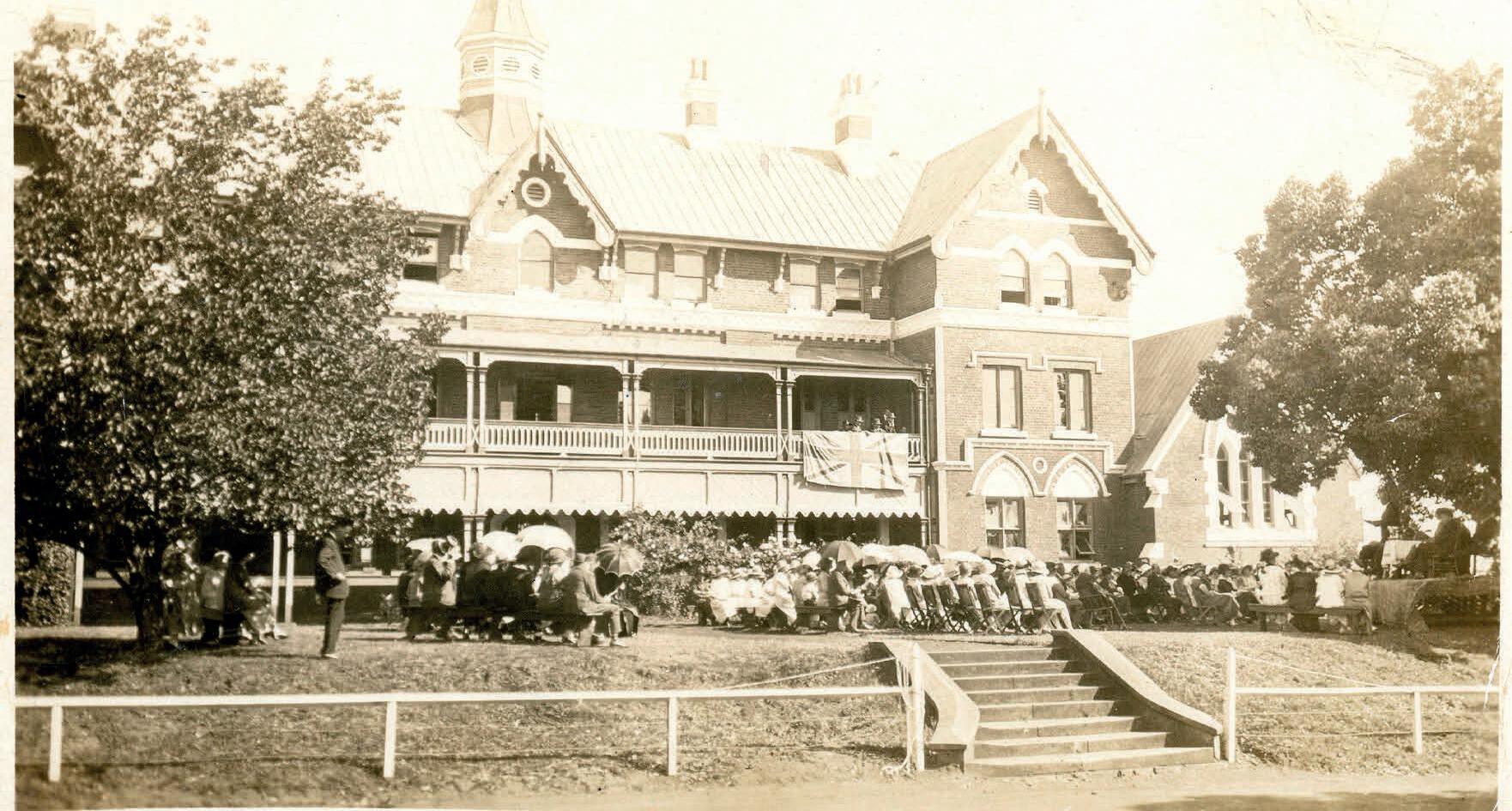
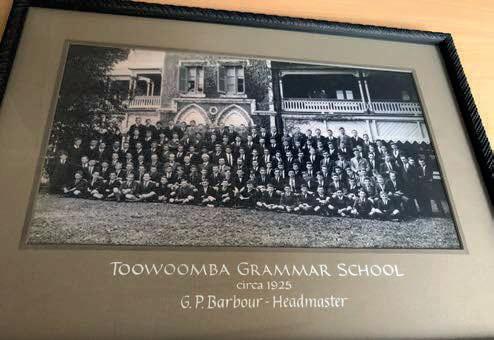
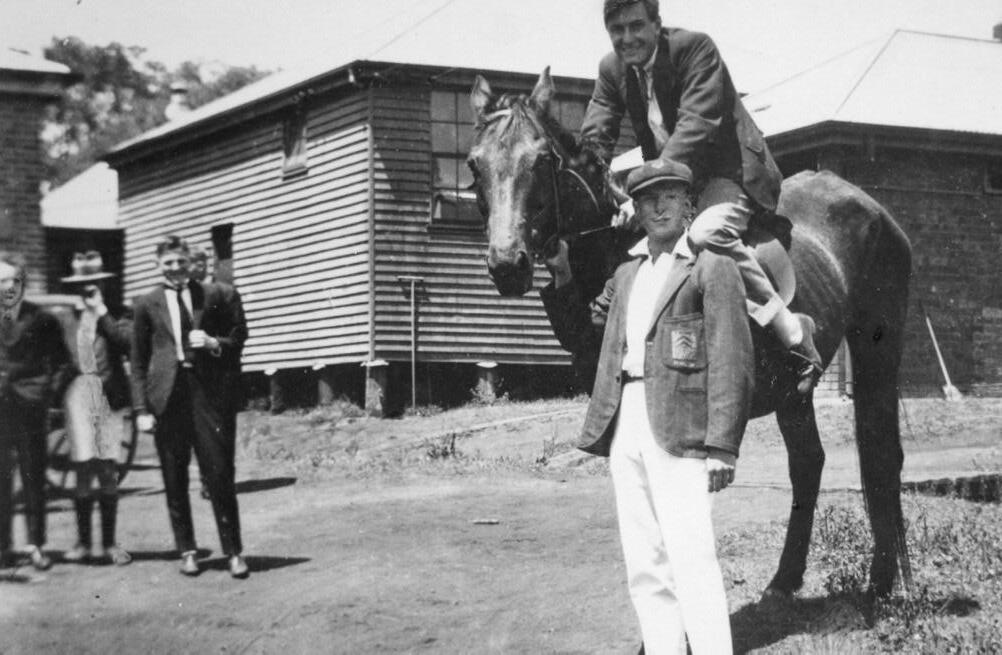
Chairman of the Board of Trustees: Dr Reginald Freshney (in his 16th year)
Headmaster: Mr George P. Barbour (in his 17th year)
Second Master: Mr James G. Leadbeater (in his 17th year)
Senior Prefect: Archie N. McIntyre (and Dux)
Dux of Year: Archie N. McIntyre
Total School Enrolment: 177
Number of Dayboys: 116
Number of Boarders: 61
Staffing:
• In this year there were seven Masters including Mr Barbour. Five of these were amongst the longest-serving members of staff in the School’s history – Mr George P. Barbour, Mr James G. Leadbeater, Mr William Hatherell, Mr Leslie W.A. Scott and Mr Hans Hassler. A photograph of the Staff is included in this year’s entry.
• Mr William Rankin joined the academic staff. He was the Senior Prefect and Dux in 1922.
• Mr Len T. Heenan began as a visiting Physics Master and gave continuous service until he re signed as Headmaster in 1961.
Students:
• The School Prefects were Archie McIntyre, Norman Caldwell, Malcolm ‘Charles’ Mayes, Alexander Provan, Alfred Purdy, Thomas Watson and Herbert Yeates.
• An Open Scholarship to the University was secured by Archie McIntyre (Dux).
• Several young Old Boys were displaying the highest academic achievement in their tertiary studies such as Bruce Mayes (1917-1921) in the University of Sydney, E. ‘Alan’ MacDonald (19191921) in the University of Melbourne, James ‘Jim’ Pollock (1920-1921) in the University of Queensland, and Tom ‘Alan’ Foott (1919-1921) at Duntroon. Not only were they top of their years, but each got the most distinguished pass of all the years. Ken Carmichael (1920-1925), too, was top of the 'first year' engineering in the University of Queensland.
• Edwin S. (‘Dooney’) Hayes (1925-1926) in later years captained an Australian side in Rugby – to New Zealand in 1936. He played 25 games for Queen sland and a total of five Test matches for Australia from 1934-1938. He was killed in action with the RAAF during World War Two.
• Herbert ‘Bert’ Yeates (1921-1926) was one of the five Yeates brothers attending the School. A detailed obituary for Herbert ‘Bert’ Yeates was printed in the annual School Magazine of 1987, page 197.
• James ‘Jim’ Yeates (1923 -1926) later graduated in Medicine with honours from Sydney University and was subsequently admitted for a Fellowship of the Royal College of Surgeons of England (like his elder brother Derick – see 1924). In World War Two ‘Jim’ Yeates was a surgeon in the New Guinea campaign against the Empire of Japan. After the battle of Buna Jim gave a graphic description of conditions: “…This is about the first breathing space I have had since my hurried journey to this forward area with my own surgical team… Altogether I operated on 80 cases –nearly all very serious wounds. My team is quite a small show and we have only the bare skeleton of equipment. From December (1942) to 6 January (1943) I have been operating all day and often (for very urgent cases) far into the night. The conditions were pretty woeful – rain, mud, blackout, even water leaking on to my operating table sometimes…. The post-operative conditions were even worse. Instead of trained sisters, warm beds, electric lights, my patients’ needs must go into tiny tents with army stretchers lying on the wet ground and often rain dripping through the roof.”
• Mr Peter McDig, Chaplain in the Australian Imperial Force (AIF) described Lieutenant-Colonel James ‘Jim’ Macrae Yeates as follows: “In every theatre of war graced by the labours of this magnificent surgeon, with his strong, shapely sure hands, his grave, kindly heart and gifted mind, he absolutely gave himself to the task of helping and healing. At Buna, New Guinea in December 1942, shod with a pair of rubber boots, water in kerosene tins, a hurricane lantern for a luminant, he performed delicate brain surgery and toiled on and on until utter exhaustion intervened.”
• On return to civilian life, Dr Yeates went into practice as a surgeon in Sydney. Tragically, in September 1960, lengthy police investigations and a coroner’s enquiry fully report ed in the newspapers of the time, established that Dr Yeates (aged 50) had been murdered in the garage of his residence in Sydney by a person or persons unknown. A book (2003) and podcast (2021) later resulted from the extent of public interest in his tragic passing.
• Thomas C (‘Tom’) Watson (1925-1926) was to become the Moderator of the Presbyterian Church in Queensland (1958).
• G.B.(‘Singy’) Myles won the GPS Open 220 yards event at the GPS Track and Field Championships (and also in the following year).
• Ian M. Suter (1923-1926) was awarded an OBE in the New Year’s Honours for his services to the community. Ian was Chief Manager, Bank of NSW (Qld) for many years.
• Alexander Provan scored a century (106) in the 1 st XI cricket game against Nudgee College.
• Hans ‘Pete’ Hassler Jnr (1925 -1926) filled a short-term teaching contract at the School in 1940 following the sudden death of his father, Mr Hans Hassler, a long-serving teacher and Senior Chemistry Master at the School (since 1918). Hans ‘Pete’ Hassler Jnr was a Science graduate from the University of Queensland and was awarded the DFC during World War Two as a Pilot-Officer.
Events:
• The boys wore a straw boater hat on Sundays and also a stiff collar to church. GPS matches were played mid-week and on Saturdays the boys played in the town competition.
• The Old Boys’ Association petitioned the Trustees for a special blazer. The resultant garmen t is essentially that which is still worn today, namely the striped colour blazer.
• The first annual Conference of the TGS Old Boys’ Association was held in the Café Alexandra (the ground floor of the Alexandra Building at 451 -455 Ruthven Street). The Chair was occupied by Sir
Littleton Groom (Speaker of the House of Representatives and President of the TGS Old Boys’ Association). The theme of the conference was ‘citizenship’ and guest speakers included Sir Littleton Groom, Mr W. Garde, Brigadier -General Robertson, Colonel Fortescue reading an address by Sir Harry Chauvel, Dr N. Gutteridge (Commonwealth Health Laboratory), Headmaster Barbour, Mr Herbert Yeates and others.
• The November edition of the School Magazine was the Jubilee number, Vol. XVI, November 1926, No.2. This year’s School Magazine contained a number of very interesting historical reviews of various aspects of the School. These included a 50 yea r History of Cricket (pp. 38-44), 50 year History of Football (Rugby) (pp. 44-46), and shorter articles on the History of Athletics and Tennis (pp. 46-47).
• Though the School was not opened until January 1877, it was built in 1876, and the corner stone carries that date. This seemed justification enough for concluding the year 1926 with the Jubilee ceremony. The first three days of December were set down for it. The programme read: Wednesday, December 1st, Old-Boys - tennis in the day and Dance at night. Thursday, cricket matches, reception by the President and Lady Groom, dinner at night. Friday, prize -giving in the afternoon, and re-union at the School at night.
• Regarding the scheduled cricket match on Th ursday during the Jubilee Ceremony, rain in the morning left the wicket soft. Against the Old Boys, the current students’ wickets fell early with five out for twenty. Then Headmaster Barbour joined Alfred Purdy and they remained together to put on seventy for the sixth wicket prior to lunch. The Headmaster had a rule of no speeches at cricket lunches. After lunch only ten minutes of cricket could take place due to the rain; nearly an inch of rain fell in half-an-hour and any further cricket was out of the question.
• In the School Magazine of this year, the ‘Jubilee number’ on page 86, an acrostic poem was printed relevant to Toowoomba Grammar School. Its author is unknown but it may inspire others to create their own verse. The acrostic poem is included in the photographs in this year’s entry.
• The Toowoomba Golf Club course at Middle Ridge was opened in December by the Premier of Queensland, the Hon. W. McCormack, before a large gathering of enthusiastic members, friends and visitors.
Co-curricular Activities:
• In sport, the School came very near to being first in the three main sports – cricket, football (rugby) and tennis. A defeat by one point by Southport placed TGS second in Football. In Cricket, TGS had an equal number of victories with the winners but, by a peculiar system of points, was placed second. In Tennis, Southport alone beat the School’s 1 st IV.
• The Chelmsford Cup (against Ipswich Grammar School) was won by Toowoomba Grammar School having won it for five successive years. Swimming was a tie, and wins to TGS were recorded in football (rugby), tennis, cricket and athletics all by fairly large margins. Shooting had temporarily been excluded from the competition.
• In Athletics, refer to ‘Singy’ Myles in the ‘Students’ section of this year’s entry.
• In Cricket, the School’s 1st XI cricket team defeated the 1st XI team representing Brisbane Boys’ College in February in Brisbane – TGS, 7/202 d BBC, 126 and also defeated CEGS (now ‘Churchie’) by 51 runs. In March, the TGS 1st XI defeated Brisbane Grammar School (125-100) with the BGS opener, Johnson, scoring more than one-half of his side’s total. The 1st XI also beat Scots’ College Warwick (4/198 d Scots, 87) but was defeated by The Southport School playing in Toowoomba (TSS 195 d TGS, 119). In the cricket game against IGS, TGS bowler Kenneth Padget took 6 for 42 , and the game was won by TGS.
• This year, playing against NC in November, the TGS 1st XI team scored the highest battings innings (5 for 334) in the 1920s decade. In this match played in Toowoomba, Alex ander Provan scored a century (106) in his final GPS match.
• In the local competition, the School’s 1st XI cricket team came second to “The Diggers”. In the 1st XI’s last two games in the local competition they scored 664 runs for the loss of eight wickets. Edwin ‘Eddie’ Kann’s performance was exceptional, batting through two successive afternoons, scoring 319 not out and giving only one chance in eight hours of play. Kann made centuries in both matches. Herbert Yeates also scored centuries and Mr Barbour and Alfred Purdy once.
• The School’s 1st XI cricket team travelled to Sydney to play some GPS teams there (but did not win a game). The last interstate cricket trip to Sydney was fourteen years ago (see 1912) . In the December trip the schools played and the results were: Newington College (231) d TGS (183); The King’s School (361) d TGS (6/172); Sydney Grammar School (4/201) d TGS (132).
• In the GPS Football (Rugby) competition the School finished second to TSS. Of the six competition matches played, the School’s 1 st XV won four (IGS, CEGS, BBC, and BGS), and lost two (Southport defeating TGS by one point and Nudgee by two).
• In Swimming, the annual Swimming Carnival took place in early March.
• In Tennis, the School’s 1st IV was placed second in the GPS competition (to TSS) having easy wins over BBC, IGS and Nudgee and the narrowest of victories over BGS.
• Interest in the Camera Club continued and the boys had the use of a darkroom in the Chemistry Laboratory.
• In Debating, the Debating Society began its winter meeting with the debate topic “The desirableness of a White Australia”. A later topic of debate was “Are roads or railways of greater benefit to the State of Queensland?”.
President of the Old Boys’ Association: Sir Littleton E. Groom (for 2 years)
Guest Speaker at the Speech Day & Prize-Giving Ceremony: Major General Sir Thomas William Glasgow – Federal Minister for Internal Affairs
The Speech Day ceremony was held o n a beautiful afternoon on 3 December. A large assemblage gathered on the lawns in front of the School. On the platform, besides the Trustees, Masters and officials, were Sir Littleton Groom, his Worship the Mayor of Toowoomba, Mr Charles ‘Chas.’ Stumm K.C., and three of the original students of the School, Messrs. Devine, Morey, and Hodgson. Mr. Devin e was a grazier of Dalby, Mr. Morey an official in the Income Tax Department, and Mr. Hodgson a Bank Manager at Ipswich.
In Sir William’s address at the Speech Day he congratulated the School on its first fifty years. In part he said: “The institution had already made its mark on the public life of Australia and was evidently at present a nursery of such scholarship, stamina and character that it would leave an even deeper impression on the future character of the nation.”

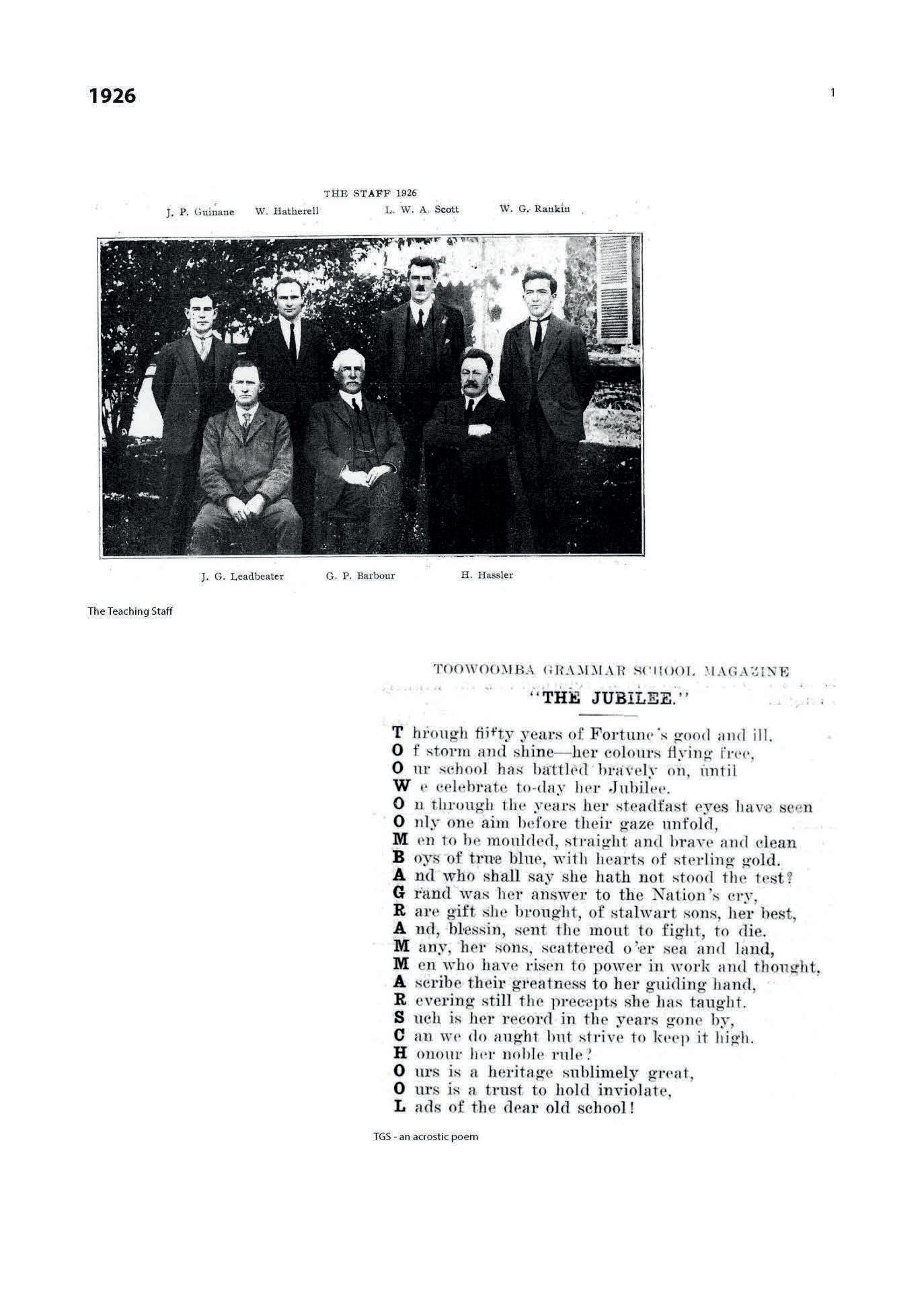
Chairman of the Board of Trustees: Dr Reginald Freshney (in his 17th year)
Headmaster: Mr George P. Barbour (in his 18th year)
Second Master: Mr James G. Leadbeater (in his 18th year)
Senior Prefect: Norman E.H. Caldwell
Dux of Year: Lister G. Hopkins (Lister Hopkins won the 1 st Open Scholarship to The University of Queensland and later was to be awarded a Rhodes Scholarship,1932). The School recognises this achievement by presenting the “L.G. Hopkins Medal for Dux of Year 12” annually at the Speech Day and Prize-Giving Ceremony. Mr Hopkins OBE later became an active member of the Canberra Branch of the Old Boys’ Association (see 1962 and his photograph below and in the 2006-year entry).
Total School Enrolment: 188
Number of Dayboys: 122
Number of Boarders: 66
Staffing:
• The Headmaster, Mr Barbour, was now sixty years of age. On the morning of his 60th birthday he captained a Toowoomba Grammar School team which played the Toowoomba Cricket Club team. As an opening batsman with his son, Bob, they scored 202 without the fall of a wicket. The team subsequently declared at 0-202, one Barbour making 100 and the other 102. Later in the day Headmaster Barbour played golf and took off the trophy. In the evening he played billiards and won the Toowoomba Championship!
• Mr Leonard Heenan joined the staff in a permanent capacity (he was a visiting Master in the previous year). Mr Heenan served from 1927 -1961.
• The teaching staff numbered eight and comprised Messrs G.P. Barbour (Headmaster), J. Leadbeater (Second Master), H. Hassler, J. Guinane, L. Heenan, W. Hatherell, L. Scott and W. Rankin.
Students:
• The School Prefects were Norman Caldwell, Graham Boys, Herbert Dunn, James McAdam, James Robertson and James Yeates.
• Four students were awarded University Scholarships – Lister Hopkins, on being first University scholar and Norman Caldwell, Norman Fisher, and Aylmer Campbell ‘Cam’ Robertson.
• Norman H. Fisher (1923-1927) completed his Doctorate at the University of Queensland and became an eminent geologist working both in Australia and overseas. He was the Director of the Commonwealth Bureau of Mineral Resources from 1969 to 1974 . Dr Fisher is acknowledged on
the Old Boys’ Wall of Achievement. In 1960 Dr Fisher was the Secretary/Treasurer of the Canberra Branch of the TGS Old Boys’ Association. At an Old Boys’ Reunion in Sydney in 2005 Dr Fisher told Headmaster Hauser that in the 1920s at Toowoomba Grammar School there was only a small number of teaching staff and that many of the Masters enjoyed playing golf. Dr Fisher recounted that should a student in those days be awarded a Saturday detention then he would be required to caddy for the Master during the Saturday morning round of golf (see 2005).
• Bernard P.C. Fletcher (1926-1927) was an inventor and was instrumental in the design and development of the Eveready torch.
• Alan C. ‘Tiny’ Cameron (1926 -1927) was in later life awarded an MBE (Member of the Order of the British Empire) and a DFM (Distinguished Flying Medal) . He was a fighter pilot of exceptional experience in World War Two and was later President of the RSL (Returned and Services League of Australia) Queensland. A tribute to the life of Alan Cameron appeared in the School Magazine 1987, page 198.
• Ian Horn captained the 1st XIII Rugby League team this year and the 1st XV Rugby Union team next year.
• Jeff Jordan (1927-1928) was the guest speaker at the TGS Old Boys’ Association annual reunion dinner in 1968. Mr Jordan provided some interesting reminiscences of boarding school life in the 1920s.
• Graham B. (‘Singy’) Myles won the GPS Open 220 yards event at the GPS Track and Field Championships for the third successive year. He also won the Open 100 yards sprint. In later years the School’s eleventh Headmaster, Mr Heenan (1956 -1961), is allegedly to have said that Graham (‘Singy’) Miles was the School’s best athlete ever. A photograph of ‘Singy’ Myles is included in this year’s entry.
• Relevant to ‘Singy’ Myles (above) a major new trophy was presented in 1969 – the ‘Singy’ Myles trophy for the Most Outstanding Sportsman of the Year (see 1969).
• Douglas Gibson was at the School from 1926 -1928. He was in the School’s 1 st XV for two years, 1927 when no games were won, and 1928 when only one game was lost. Writing in 1987 to the Editor of the Toowoomba Grammar School magazine, Mr Gibson recalled his years at TGS from 1926-1928. He wrote: “Despite the fact that conditions at the School were very spartan by any standards, it was a very happy School, and there existed a great sense of camaraderie, public spirit and sportsmanship, which were engendered by that great headmaster, G.P. Barbour, who knew the secret of getting the best out of his pupils.... In those days we wore straw boater hats on Sunday, and also a stiff collar to church. The only good thing about Sunday was that Sunday dinner was usually a bit better than other days. GPS matches were played mid-week and on Saturdays we played in the town competition. This was very good for training purposes and mostly enjoyable. Our teacher-coach was Mr Bill Hatherell – a great personality who looked for the best from h is boys – and was usually successful in this. Few could equal his dedication. The School was fortunate in having Cecil Broadfoot, an Old Boy with a very successful career in top -level football, as the official coach. His patience and skill did much to bring the 1928 team up to the height that was reached. A teacher who was well liked was Mr Hans Hassler, “Mo” as he was affectionately known. He was able to instill an understanding and a liking for Chemistry. A lover of music, he was good enough to bring his gramophone across from Herries Street on some Saturday nights and play and explain Gilbert and Sullivan records to us.” Mr Doug Gibson had a long and continuing record over many years in supporting the School. He became President of the Brisbane Branch o f the Old Boys’ Association.
Buildings:
• The School Swimming Pool was built as a ‘Jubilee’ project. Originally called the ‘New Swimming Baths’ the pool was completed by the end of the year to mark the 50 th anniversary of the founding of the School. The swimming baths cost nearly double the amount originally forecasted.
Events:
• This year represented the School’s Jubilee anniversary, recognising 50 years from the founding of the School although the Jubilee celebrations occurred late in the previous year.
• The School was honoured to receive a visit from the Governor, His Excellency Sir John Goodwin and Lady Goodwin on Tuesday, 27 September. The boys formed a guard of honour for His Excellency. The Governor addressed the boys and then visited the New Swimming Baths at the rear of School House where he met the Senior Prefect, Norman Caldwell, and Graham Myles (whose running had been witnessed by Sir John in Brisbane on the previous Saturday). The Governor then, to the delight of the boys, awarded the boys a half holiday
• In the School Magazine it was written: “ Though the bath cost so much more than was originally forecasted, it was, when handed over, still innocent of anything in the shape of a protecting fence. The bull and his consorts might be seen any morning complacently admiring their reflections in the limpid pool, and as the summer advances they would no doubt be tempted to compete in the senior plunge. The need of a high fence became at once apparent .” It was decided to have a Carnival and Dance to fundraise for the new fence.
• A Wireless Club was formed during the year and the boys were looking forward to obtaining a four-valve set at a later date for the amusement of the boarders during the weekends.
• The Brisbane Branch of the Old Boys’ Association held a dance in August at All Saints’ Hall and was attended by 150 guests. The venue was decorated with a canopy of blue and gold streamers.
• The annual re-union dinner of the Townsville Branch of the Old Boys’ Association was held in August.
Co-curricular Activities:
• In the Chelmsford Cup competition against Ipswich Grammar School, the School lost swimming and football (rugby) but won athletics, tennis and cricket. The Cup now showed by its inscriptions that out of 21 years Toowoomba has won 13 times and Ipswich 3, the remaining 5 being ties.
• In Athletics, Graham ‘Singy’ Myles continued to dominate GPS sprint events. (see ‘Students’ section in this year’s entry).
• In Cricket, this year the 1 st XI gained wins against IGS, BBC (by 82 runs on the first innings) and NC.
• The TGS 1st XI was defeated by Brisbane Grammar School (BGS 305) d TGS (185). In the 1st XI match against CEGS (‘Churchie’), Fergus Yeates (1926-1930) bowling spin took 7 wickets for 69 runs. He also took 7 wickets against IGS (7 -50) in 1928. Fergus Yeates gained a place in the 1 st XI cricket team when he was only 14 years old and later was to play in three Sheffield Shield matches for Queensland. It is understood that Fergus also took pride in having once bowled a maiden over to Donald Bradman.
• 1st XI cricketer, Ezra R.H. ‘Boxer’ Wyeth (in both the 1927 and 1928 sides) went on to play 25 matches for Queensland from 1933 until 1938.
• In Rugby, the School played seven GPS Rugby matches, losing all seven (with the season’s tally of 7 points for and 210 points scored against). The largest loss was to Brisbane Grammar School (051). The team was led by Ian Horn who also led the 1928 team, one of th e all-time great teams in the School’s history.
• The Open 1st XV team travelled by steam train down the Toowoomba Range to play the team representing Gatton College.
• In Tennis, the School’s 1st IV team won the GPS Tennis Premiership, the first time in the h istory of the School that a Tennis Premiership had been won. The boys won a close game with Southport, then a still closer one with Brisbane Boys' College. Rain stopped the game against Brisbane Grammar when another close finish seemed probable and wins we re also secured against Nudgee and IGS. The Premiership winning team’s captain was Douglas ‘Fish’ Davies and the other players were Graham Myles, Fergus Yeates and Norman Caldwell.
• In Cadets, on a cold and gloomy April morning, a contingent of boys from TGS mounted Mothers’ Memorial, a practice which commenced in 1923 and has continued ever since. At this time the Mothers’ Memorial was situated in the middle of Margaret Street on the western side of Ruthven Street.
Guest Speaker at the Speech Day & Prize -Giving Ceremony: Brigadier-General Cecil H. Foott, ADC to King George V (Old Boy 1885). The ceremony was held at the School.
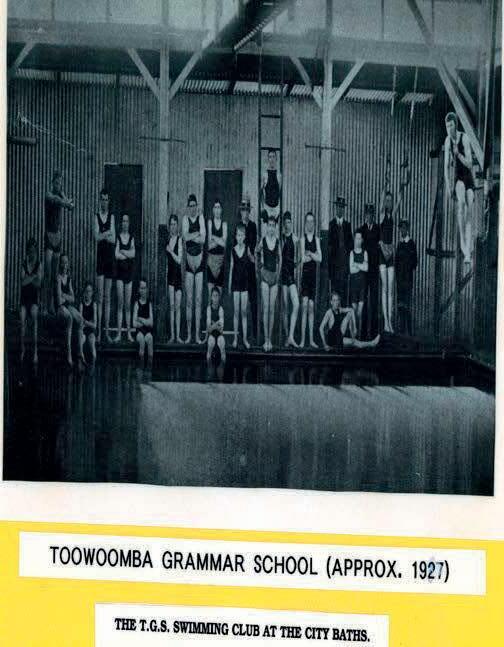
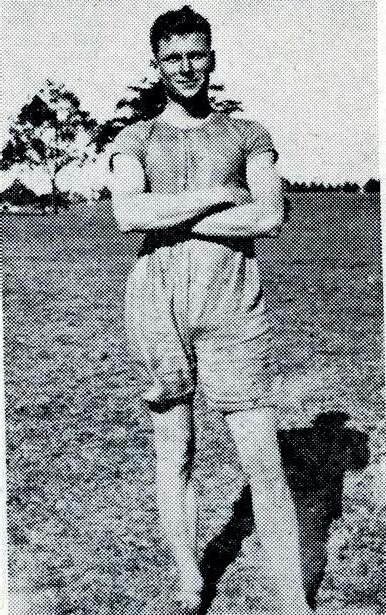
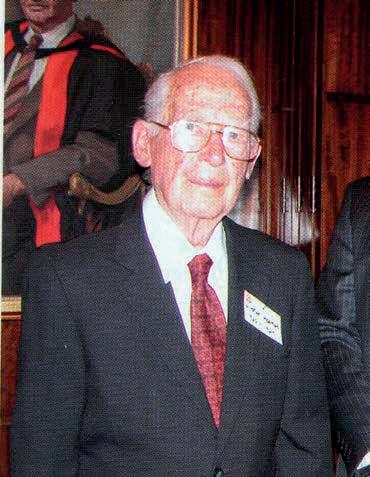

Chairman of the Board of Trustees: Dr Reginald Freshney (in his 18th year)
Headmaster: Mr George P. Barbour (in his 19th year)
Second Master: Mr James G. Leadbeater (in his 19th year)
Senior Prefect: James B. McAdam (see below)
Dux of Year: Brian R. Butler
Total School Enrolment: 209
Number of Dayboys: 130
Number of Boarders: 79
Staffing:
• Mr Thomas V. Martin, who was in the School’s cricket and football teams some twelve years ago, commenced his service. He remained on staff from 1928 - 1952.
• In October, the Board of Trustees’ long-serving and highly regarded Secretary, Mr Robert Sinclair, died. He had been the Board Secretary for 27 years. Mr. Sinclair had been a prominent citizen for over 40 years. He had been Alderman, Mayor and President of the Chamber of Commerce, and was at his death Vice-President of the Downs Club. Twenty years ago he was the most prominent figure in the administration of cricket, being for many years President of the Toowoomba Cricket Union. The School’s first Secretary to the School’s Board of Trustees was Mr. Stephens who occupied the position for a quarter of a century, and in 1901 was succeeded by Mr. Sinclair.
Students:
• The School Prefects were James McAdam, Graham Boys, Reginald Clappison, Ian Horn, Ezra Wyeth and James ‘Jim’ Yeates.
• A record number of five boys were to win Open Scholarships to the Un iversity of Queensland. They were: Brian R. Butler, William G. Draper, Clyde A. Knight, Charles J. Leadbeater (the son of the Second Master, Mr James G. Leadbeater) and James B. McAdam.
• The Headmaster, Mr Barbour, announced that 91 per cent of Senior students had passed, compared with the State average of 56 per cent, while 94 per cent in Junior passed as against 61 per cent for other schools.
• James (‘John’) McAdam (1924 -1928) later became an army officer, forester and public servant. After school James jo ined the Queensland Forest Service as a cadet and proceeded to the University of Queensland and the Australian Forestry School. In 1938 he was appointed a Forest Officer in the public service of the Mandated Territory of New Guinea. He was awarded the Military Medal for his outstanding service at Salamaua during the invasion by the Japanese in World War Two. Later, James was appointed Director of the Department of Forests, Territory of Papua-New Guinea. The McAdam National Park, the largest national park in PNG (Bulolo Gorge, near Wau) was named after him. In addition to Tom Allen in the 1 st XI Cricket team was Fergus Yeates (1926-1930) one of the five Yeates brothers who all played 1st XI for the School (see 1925). Fergus later represented Queensland in Cricket (in 1933-1934).
• Edwin S. ‘Dooney’ Hayes (1925-1928) later was appointed Captain of an Australian Rugby Union side which toured New Zealand in 1936. He played five Rugby tests for Australia and twenty -five games for Queensland. His achievements are recorded on the Old Boys’ Wall of Achievement in the School grounds. ’Dooney’ Hayes was killed in action with the RAAF in World War II in 1943. In the School Magazine of 1961 an article documenting the history of TGS Rugby from 1900-1961 listed ‘Dooney’ Hayes as the School’s greatest footballer to this time. His photograph appears in this year’s entry.
• Ezra R. ‘Boxer’ Wyeth (1923 -1928) played cricket for Queensland for four seasons in the early 1940s. He was also chosen in an Australian side to tour New Zealand but the trip did not eventuate. His best bowling performance for Queensland was against South Australia when he secured six wickets for 33 runs as an unorthodox left -hand spin bowler. He later became Professor of Educational Psychology at San Fernando Valley State College in California and he continued his interest in sport by playing hockey and bowls. In 1964 he was the World Bowls Singles Champion. He visited Sydney in 1966 as a member of the American team. Dr Wyeth is acknowledged on the Old Boys’ Wall of Achievement.
• Reginald (‘Graham’) Skerman (1927 -1928) later joined the teaching staff of the School, commencing in 1959.
• John Cooke (1926-1928) had the new oval at Fairfield named for him. He had been a Life Member of the Brisbane District Cricket Club and a Foundation Member and Trustee of the Queensland Cricketers’ Club.
• Douglas Gibson (1926-1928) wrote to the editor of the School Magazine in 1987, recalling his days at the School. Mr Gibson’s letter was reprinted in the School Magazine of 1987, page 186. In his letter he stated: “Despite the fact that conditions at school were very spartan by any standards, it was a very happy school and there existed a great sense of camaraderie, public spirit and sportsmanship, which were engendered by that great Headmaster G.P. Barbour , who knew the secret of getting the best out of his pupils.”
Buildings:
• The Main (now Barbour) Oval Pavilion/Grandstand was opened. The grandstand backed onto Mary Street and was demolished around 1955 due to white-ant infestation A photograph of the grandstand appears in this year’s entry. The grandstand was officially opened by the President of the Old Boys’ Association, Dr David Horn, on Monday 5 March, at 4:00pm on the Nud gee College vs TGS cricket day (with TGS winning the match by two runs).
Events:
• The School’s fourth Headmaster, Mr William Alexander Jenyns Boyd, died in Sydney on 19 May, aged 86 years.
• A new sports oval was discussed. It was agreed to level the surface of the area lying between the swimming bath and the Mackenzie Street fence. The Trustees preferred to face the initial expense rather than resort to other means of raising funds. Mr. Will Fett was contracted to plough and replough, harrow and level an area of 150 by 110 yards at a very moderate price. Squads of boys were to plant couch roots freely whenever the weather was favourable to growth.
• It was encouraging to note that the boys donated to various charities, in particular the Cancer Campaign and the Ambulance Brigade (£5/15/- to each fund).
• The third annual dance of the Brisbane Branch of the TGS Old Boys’ Association was held at All Saints' Hall on July 31st.
• The School Museum has a letter written to the School (19 May) by a Director of Toowoomba Foundry Co.Ltd. The opening paragraph stated: “Dear Sirs, In response to Mr Barbour’s request by telephone yesterday morning, I have gone into the cost of making alter ations to the bottom of the Grammar School swimming pool so that the sludge will drain off more easily than at present.”
• In the Chelmsford Cup , the School won the Cup this year against Ipswich Grammar School including wins in all events - swimming, football (rugby), cricket, tennis and athletics. This was only the second time in the history of the Chelmsford Cup that TGS had won all events. The other occasion was in 1912 and IGS achieved wins in all events against TGS in 1918.
• In Cricket, the 1st XI Cricket team shared the GPS Cricket Premiership with TSS (captained by Graham Boys), winning all three GPS games played (and with two drawn games). In February 1999, Mr Boys was invited to open the white picket fence and the R ussell R. Gillies cricket scoreboard on Mills Oval (see below and 1999). A photograph of the 1st XI is included in this year’s entry.
• This year was the first time the School played Cricket against St Joseph’s Gregory Terrace with a drawn result. The TGS cricket victories were against Nudgee College (TGS 114 d NC, 112), Brisbane Grammar School (TGS 182 d BGS 117) , and CEGS (TGS 5/192 d CEGS, 146). In this latter game against CEGS (‘Churchie’), Fergus Yeates got a five-wicket haul for 48 runs.
• Captain of Cricket in both 1927 and 1928 and occasional member of the GPS Premiership winning 1st Tennis IV in 1927, Graham Boys recalled sporting involvement when visiting the School in 1999. He said: “Interschool matches when played in Brisbane involved a ten-hour train trip overnight on the ‘Midnight Horror’ and stopped at stations and sidings along the way in a combined goods and passenger train. We then played the match and returned that night by the same train. On the occasions when we played The Southport School or two Brisbane schools on the same trip, we stayed overnight at the Orient Hotel in Brisbane. A highlight for the First XI was a train trip to Sydney (via Stanthorpe, Wallangarra and Armidale) for matches against North Shore, The King’s School and Newington College. Our accommodation was at Newington College.”
• In Rugby, in the football match, played according to Rugby Union rules, TGS defeated IGS by 30 points. This was the second highest winning margin in rugby against IGS since 1906 where TGS won 45-0 (in 1904 we lost, 4-32).
• The School had been playing Rugby League from 1920 –1927. This year the code returned to Rugby Union and the 1st XV was regarded as one of the great teams in the School’s history. In this year the side lost only one game to Nudgee College (see 1927) and was placed 2 nd in the GPS competition. The results were as follows – wins against The Southport School (15 -6), Brisbane Boys’ College (24-0), Church of England Grammar School (‘Churchie’) (15 -10), Ipswich Grammar School (30-0) and a draw against Brisbane Grammar School (nil all). The loss to Nudgee College was 6-25. A photograph of the 1st XV team is included in this year’s entry.
• In the 1st XV match against IGS, the School won by 30 points. This was the highest winning margin in Rugby against IGS since 1906 (45-0).
• In Tennis, the School’s 1st IV defeated Brisbane Boys’ College (8 rubbers to nil) and Nudgee (six rubbers to nil). Despite this success the 1st IV suffered a decisive defeat by BGS (six rubbers to two). The School achieved second place in the GPS tennis championships to Brisbane Grammar School.
President of the Old Boys’ Association: Brig-Gen. James C. Robertson (for one year and also in 1921)
Guest Speaker at the Speech Day & Prize -Giving Ceremony: The Honourable James Taylor MLC, Distinguished Politician and Businessman. (Mr. Justice Woolcock, who was to be the official visitor, was too ill to attend.)
The gathering assembled on the lawns in front of the School.
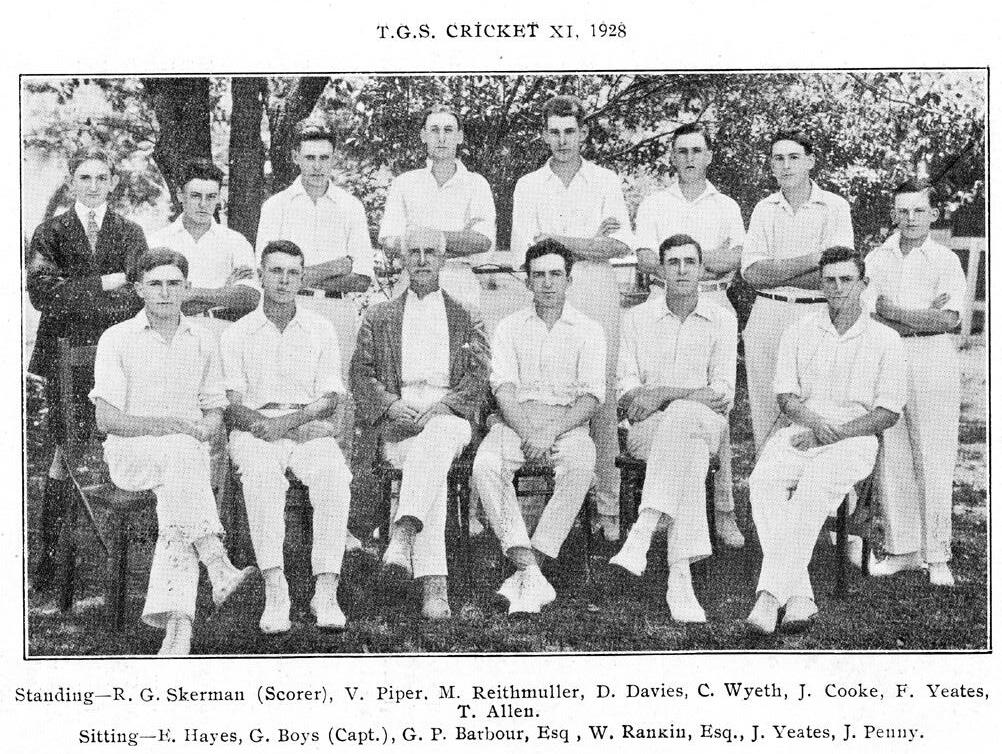
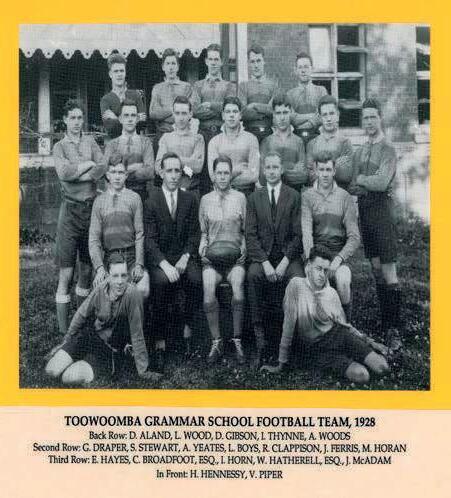

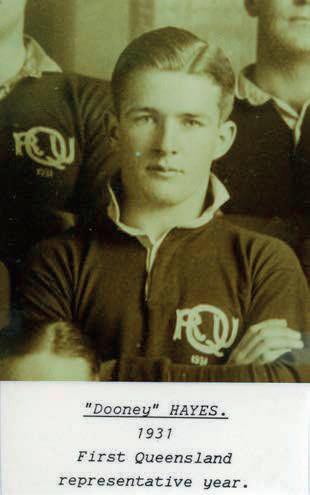
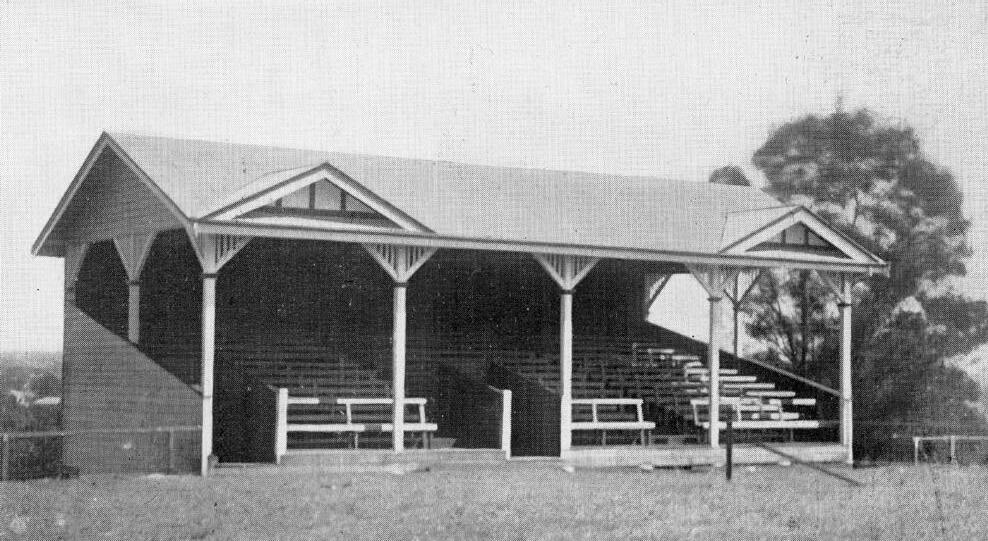
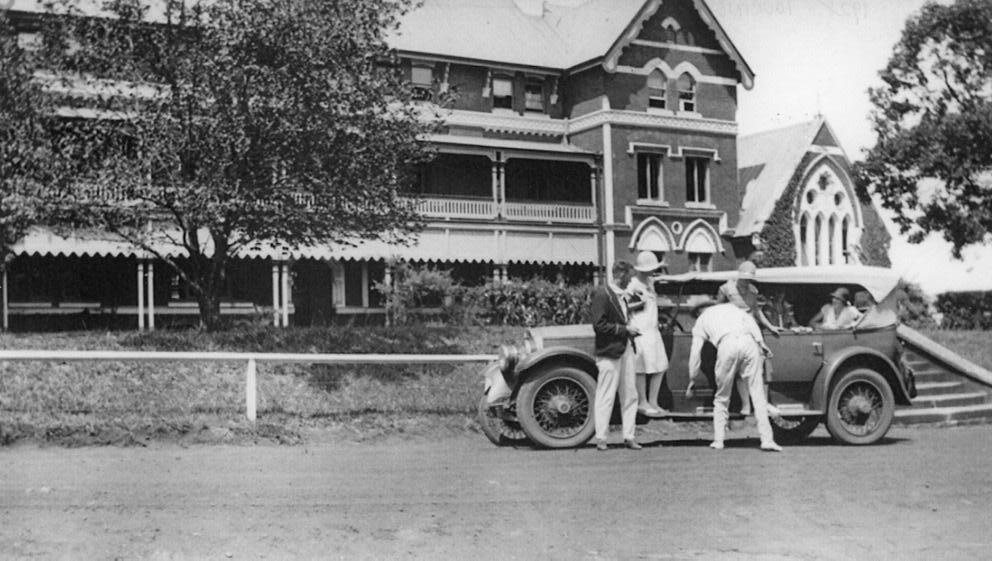
Chairman of the Board of Trustees: Dr Reginald Freshney (Chairman in his 19 th year) died at the end of 1929. He had been on the Board of Trustees for 21 years. The Trustees recorded in the Minutes of their Meeting: “…. It was due to Dr Freshney’s tact, kindly guidance and genial disposition that the affairs of the Board always ran so smoothly. No one who came in touch with him could fail to appreciate his extremely sympathetic and charming character. His death would be a distinct loss to the School and the Trustees would always cherish his memory with the deepest feeling of appreciation.” A Tribute to Dr Freshney was printed in the School Magazine, 1929 edition, pp 3-4. In 1996 Headmaster Rose created an additional dayboy House, Freshney House, named for Dr Freshney. This House was amalgamated with Groom House in 2004 and later, in 2009, reverted to Groom House. A photograph of Dr Freshney is included in this year’s entry.
Old Boy (1883-1884) Brigadier-General J.C. Robertson was appointed as Chairman (1929 -1933) and later (1943-1945). He was also a former President of the Toowoomba Grammar School Old Boys’ Association in 1928 (see 1894).
Trustees: Mr Alfred A. Griffiths was elected in Dr Freshney’s place on the Board.
Headmaster: Mr George P. Barbour (in his 20th year)
Second Master: Mr James G. Leadbeater (in his 20th year)
Senior Prefect: Reginald J.S. Clappison
Dux of Year: Jephson ‘Jeph’ B. Cameron (his son, Peter, was also to be Dux of the School in 1963 and later a Rhodes Scholar, 1968) This year ‘Jeph’ was ranked second in the Senior Examination in Queensland. Since the examination was initiated some twenty years ago , the School had been first three times (Wonderley, Pollock and Hopkins) and second three times (Jackson, Barbour and Cameron).
Total School Enrolment: 211
Number of Dayboys: 132
Number of Boarders: 79
Students:
• The School Prefects were Reginald Clappison, James Ferris, John Penny, Malcolm Wright and Alexander Yeates. A photograph of the School Prefects is included in this year’s entry.
• Jephson Cameron (Dux) was awarded an Open Scholarship to the University of Queensland based on his performance in the Senior Public Examination.
• Lyn H. Wood (1927-1931) was regarded by an anonymous author in an extremely detailed summary of the history of Rugby Union at the School up to 1961 (appearing in the 1961 Toowoomba Grammar School Annual Magazine) as “our greatest schoolboy footballer”. He was playing in the 1st XV as a Junior (see entry 1930 -31).
• John C. (‘Jack’) McDonald (1928 -1929) went on to play as a forward for Australia in two Tests against New Zealand in 1938. He was also a member of the 1939 Wallabies who reached England soon after war was declared but returned to Australia without having played a match. His son, Old Boy John N. McDonald (see 1960), was also to represent Australia – in rugby league.
• In the 1st XI Cricket team was Tom Allen (1927 -1929) who later made his name as a Queensland State player (playing 40 Sheffield Shield games, making 1793 runs with four centuries) and subsequently a State Selector. Tom Allen died in 1954 at the relatively young age of 41. His name is honoured by the Tom Allen Memorial Trophy for the annual cricket co mpetition between Toowoomba Grammar School and Downlands College (see 1954). Tom Allen’s son, Ross Allen (1954-1955) later played for Queensland (in 1962). Tom Allen’s grandson, Jon Hall, was a parttime resident Boarding Master at the School from 2001 -2007. He later returned in a full-time capacity in 2018 as a Resident Master at the School. Another grandson, Michael Hall, joined the School as a Boarding Housemaster and secondary school teacher in 2020. A Tribute to Tom Allen appeared in the School Magazine of 1954 on page 63 and his photograph is included in this year’s entry.
• A photograph of Tom Carty, Captain of the School’s 2013 1 st XI Cricket team, holding the Tom Allen Memorial Trophy, appears in this year’s entry.
• Edward Freshney (1928-1929) was the son of Dr Reginald Freshney who was Chairman of the School’s Board of Trustees for nineteen years, from 1911 to 1929. In later years Edward Freshney became an ophthalmic surgeon in Sydney.
• Alexander Barr Yeates (1927-1929) was to become a member of the School’s Board of Trustees (1960-1965). Between 1966 and 1975 he was the Surveyor General of Queensland. He was elected in 1980 as an Honorary Life Member of the TGS Old Boys’ Association. Alex Yeates was also President of the Toowoomba Grammar School Old Boys’ Association (Brisbane Branch) from 1977-1981.
• The son of Alexander Barr Yeates (1927 -1929) donated his father’s Colour Blazer to t he School Museum collection in 2011. The presentation was made by Old Boy Rod Yeates (1960-1963).
• Arthur I. Myers (1928 -1929) is recognised by the School with the award of the Arthur Ingham Myers Prize for Geography at the School’s annual Speech Day and Prize Giving Ceremony.
• The captain of the School’s 1 st XI cricket team, James Rud Penny (1925-1929) later wrote a book titled ‘Guests of the Nazis’ which was printed by Downs Printing Co.Pty.Ltd. in 1982. A copy of this book is held in the School’s Museum
• In the School Museum is a handwritten note by a student (unnamed) describing the routines for a boarder at TGS in 1929. It is reprinted here in its entirety. “After breakfast a boarder would don his suit and wearing his ‘straw boater’ line up in the Quadrangle behind ‘D’ Room about 10:00am where all were given 3d to put in the plate at our respective churches. There was no supervision, all just went their respective ways there and back. After lunch, we were all expected to write a letter home – some were very sketchy – and having done that there was a general exodus from the school grounds towards the range – ie Webb Park to Picnic Point and points in-between. There was scarcely a house east of Tourist Rd. Below Mary Street was out of bounds. On Sunday nights, probably about 7pm the School Bell would toll and all boarders would assemble in the Headmaster’s Lounge – and there Mrs Barbour would thump out on her piano the tunes for all the popular hymns – ‘Rock of Ages’, ‘Onward Christian Soldiers’ etc and we all sang or tried to.
Everyone just sprawled on the floor and after about ½ hour of this, the Head would read a chapter or two of a novel for us – and so would end another Sunday for a boarder at TGS in 1929.”
• At an Old Boys’ Reunion in Sydney in 2005, Old Boy Ralph (Taffy) Evans (TGS 1925-1929), aged 93 years, proudly wore his School Colours Blazer. He told Headmaster Hauser that he was not the oldest person present at the reunion. He said: “I am younger than that old bloke over there!” He was pointing to Dr Norman Fisher AO (at the School from 1923 -1927).
• ‘Taffy’ Evans (above) supplied some notes to the School about his schooldays in the 1920’s. He recalled that when walking across Margaret Street to school, an oldish chap walking to work told him that he was Number 2 on the school roll. Taffy forgot his name. He also recalled rec eiving school cufflinks for winning the School mile handicap. He added: “ I used to shoot currawongs for which the Council paid 3 pence each. Taking the rifle to school one morning, B ill Hatherell – a Master – asked me why I had it. I told him that since there were a lot of currawongs in the trees around school, I intended to ask the Head – G.P. Barbour – if he minded if I shot a few at lunch time. ‘Bill’ said “Oh, the Head is very deaf, it might be wise not to ask.” Taffy said that he often thought that the best advice he had was if in doubt, don’t ask. He said that he supposed some things had changed at the School but “we had an awful lot of fun”.
Events:
• The Great Depression of 1929 -32. Fortunately, the Depression appeared to be less dramatic in Toowoomba than elsewhere although recovery was slower.
• The State Labor Party was in opposition in Queensland for three years during the Depression and was then returned for a further 25 years until its defeat in 1957 by the Country-Liberal Coalition.
• A good deal of progress was made with the preparation of the new (second) sports oval on the School grounds. In terms of access of water for the oval, the School Magazine in May reported: “The simplest and most economical form of water supply seems to be to run a light pipe from the stand pipe already in the milking shed.” In the November edition of the School Magazine it was written: “From the time that the levelling was done in February until October there was not one week's rainfall that totalled an inch, and much of the dusty surface was blown towards Brisbane by the winter westerlies. Notwithstanding its bareness and soft surface the Cricket Association was willing to use the ground as a regular B Grade ground.”
• The probable overflow of boarders for July was causing some concern. The Trustees deemed it inadvisable to use the hospital even temporarily. The idea of accommodating several boarders on the front verandah of School House did not meet with favour. At the May meeting the question of limiting the number to 83, or of devising some extraordinary means of providing beds, was to be further considered.
• The fourth annual meeting of the Brisbane Branch of the TGS Old Boys’ Association was held at the Constitutional Club on November 25th when 33 Old Boys were present under the chairmanship of the President (Mr John S. Hutcheon: TGS,1894-1900). The annual report recorded that there were 85 financial members.
• The Past Grammar Swimming Club was founded this year.
• ‘Talkie’ movies replaced silent movies in this year.
• The School Magazine of this year on page 23 recorded the results of all TGS versus Brisbane Grammar School sporting competitions in cricket, football (rugby) and tennis from 1878 to 1929.
Co-curricular Activities:
• In the Chelmsford Cup Competition against IGS the School lost in athletics and tennis but had victories in cricket, swimming and football (rugby) to win the Cup. Since 1922 TGS has held the Cup, which means eight successive wins. Altogether the contests have been going on since 1907. TGS has won fifteen times, Ipswich three, and there have been five ties.
• In Athletics, at the All-Schools’ Athletics Sports, the School sent eight representatives.
• The School’s annual Sports Meeting was held in September.
• In Cricket, in December of the previous year, a number of the School’s top players departed at Christmas. These included Graham Boys, ‘Dooney’ Hayes, Ezra Wyeth, Douglas Davies, Frank Woods and John Cook.
• The GPS Association announced that in the following year (1930) the GPS cricket season would change from the current Term 3 of one year and Term 2 of the next year to a calendar year basis.
• In the School Magazine in May it was written: “It is many years since we last received such a trouncing as in March when we played Brisbane Grammar School.” In this game TGS scored 209 but was defeated by BGS (1/240). The BGS batsmen Hansen (116 not out) and Hubbard (101 not out) did the damage. Against Brisbane Boys’ College, a last wicket stand saw the School defeat BBC by 17 runs and the School also defeated CEGS (‘Churchie’) by 48 runs.
• TGS bowler, Fergus Yeates, took 24 GPS wickets this year.
• Two games were washed out – NC and TSS.
• In Rugby, the School’s 1st XV team looked promising from the start with seven of last year's team in the fifteen. The 1st XV Rugby team was only the second team in the School’s history to this point to beat Nudgee College (quite convincingly, 17 -8). It won all games in the season except one, a loss to Gregory Terrace, the eventual Premiers, by five poi nts (3-8). Owing to confusion in the competition table TGS played the GT game in Brisbane, instead of at home. This may have cost the School the Premiership. The team drew against BGS (6 all), and won against NC (17 -8), IGS (13-6) and BBC (25-3). In a report on the history of Rugby Union at the School until 1961 (published in the School Magazine of 1961) it was noted that this team was the only school team to beat Nudgee in Rugby up to this time and not win the Premiership. The aforementioned article rated this 1929 team, together with those of 1928 and 1932, as all worthy of a second -line ranking in terms of ability to that of the 1924, 1930 and 1948 teams. The November edition of the School Magazine of this year stated: “The standard of the team this year was perhaps not so high as that of the 1928 XV. The team, however, played sound football.” A photograph of the 1st XV is included in this year’s entry.
• The Gregory Terrace (GT) 1st XV did not have a win against a TGS 1st XV at Toowoomba until 1960.
• In Swimming, the competition as part of the Chelmsford Cup competition against IGS, the advantage of the School having baths of its own was at once apparent when the School won all events. The swimming bath was emptied and lime-washed twice during the winter. It was recognised that in a dry winter the dust from the westerlies soon accumulated.
President of the Old Boys’ Association: Dr David H. Horn (for one year) and also in 1935
Guest Speaker at the Speech Day & Prize-Giving Ceremony: The Honourable Arthur E. Moore – Premier of Queensland

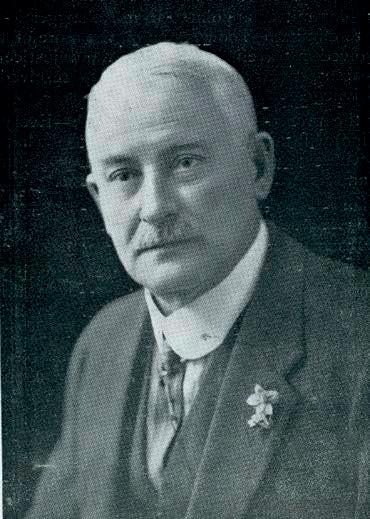
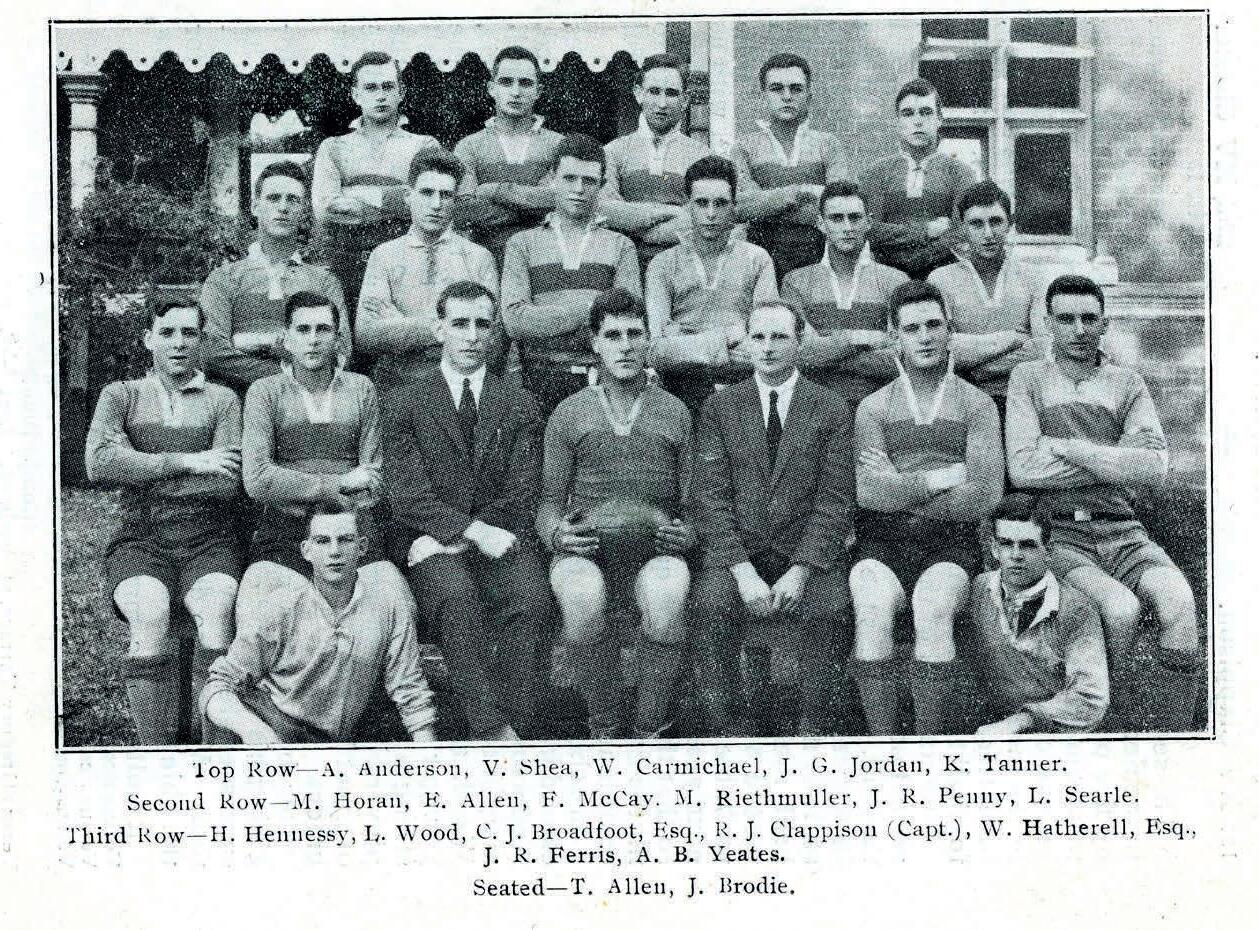
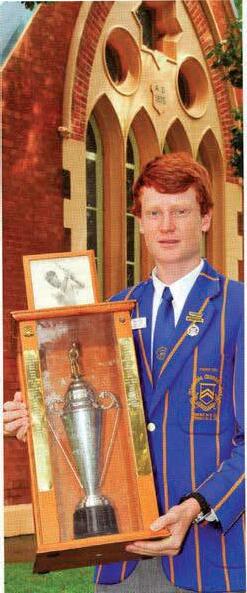
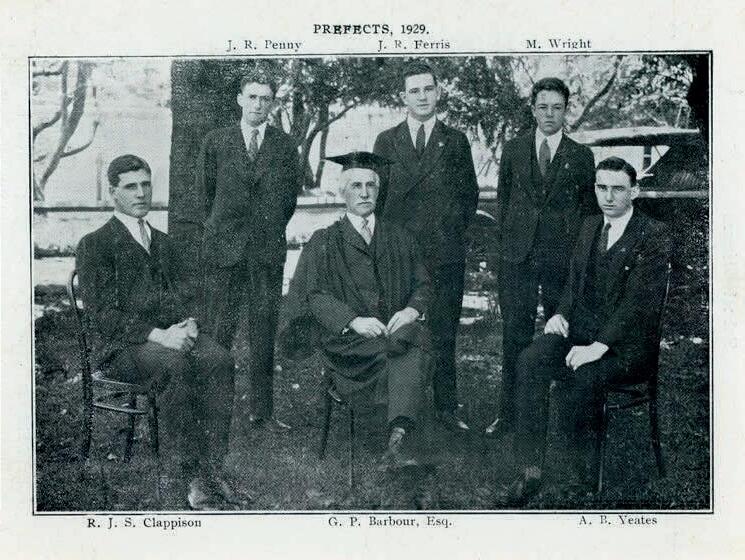
Chairman of the Board of Trustees: Brigadier-General J.C. Robertson (in his 1st year)
Headmaster: Mr George P. Barbour (in his 21st year)
Second Master: Mr James G. Leadbeater (in his 21st year)
Senior Prefect: Malcolm H. Wright (see below)
Dux of Year: Clement L. Knight
Total School Enrolment: 252 (a record at the time)
Number of Dayboys: 164
Number of Boarders: 88
Students:
• The School Prefects were Malcolm Wright, Evan Baird, Herbert Coleman, James Ferris, Eric Johnson, Jeffrey Jordan, Lyn Wood and Sidney ‘Fergus’ Yeates. A photograph of the School Prefects is included in this year’s entry.
• The Dux of the School, Clement Knight, obtained a University Open Scholarship.
• Three of the 1st XV team later also played Rugby for Queensland after leaving school : Lyn Wood, Lloyd Ingram and ‘Bob’ Chester. Another member of the team, John ‘Jack’ McDonald (1927 -1931), represented Australia as a Rugby Union International (see ‘Students’ 1931).
• Malcolm H. Wright (1925-1930), Senior Prefect and a champion swimmer (Captain of Swimming in both 1929 and 1930), was a navy officer who transferred to the Coast -Watching organisation in 1942. He then formed a guerrilla band of tribesmen to attack Japanese forces behind the lines on New Britain, the largest of the outlying islands of Papua New Guinea. His heroic band – Tiger Force – killed 256 enemy troops in less than two months for the loss of a single spearman. He wrote of his experiences in two books , If I Die (1965) and The Gentle Savage (1966) Prior to his retirement in 1972 he served in Rome, Cologne and Belgrade attached to the Australian Embassy. Lieutenant Wright is acknowledged on the Old Boys’ Wall of Achievement. Malcolm recalled one day in 1945 when he was in a RAAF Mess in Townsville. Of the fifteen in the Mess, twelve were TGS Old Boys. In 1980 Malcolm was guest speaker at the TGS Old Boys’ Association, Brisbane Branch, reunion dinner. Malcolm Wright is included in the photograph of the School Prefects in this year’s entry.
• Ralph K. Dowse (1929-1930) was a member of the RAAF as a Sergeant Observer during World War Two. Just before he left for the Front he expressed the wish to his mother that, if he did not return, a gift should be made to the School on his behalf. He was killed in action in Egypt and his parents, Mr. and Mrs. A. L. Dowse, honoured his request and created the "The Ralph Dowse Memorial Prize." This subject prize for Agricultural Science is still presented annually at the School’s Speech Day and Prize Giving Ceremony. Initially this Memorial Prize was for Year 10
Mathematics (1941-1994) and had also been used to acknowledge students’ success in Earth Science and Multi-Strand Science. The family also donated to the School a sum of money and this was to be later used to fund a Memorial Honour Board (see 1946). Ralph was only 25 at the time of his death and had been an involved member of the TGS Old Boys’ Brisbane Branch.
• Robert L. Ryder (1929-1933) was killed in action as a pilot in Holland in 1941. From 1955 -1994 the School presented the R.L.O. Ryder Memorial Prize for Science and this Subject Prize (now for Chemistry since1995) is still presented annually at the School’s Speech Day and Prize Giving Ceremony.
• Guy B. Black (1929-1930) writing to the School in 1992 recalled there was no entrance to the school grounds from Margaret Streeet in his time. As with other boarders, Guy used to walk down to town (Ruthven Street) to buy extras such as sauces, pickles, tins of preserved fruit, jam, honey and other items, even sardines or herrings in tomato sauce. There was no school ban on this practice and the extras were brought to the boarders’ dining tables as quite normal behaviour. At the end of the meals the boarders would take the bottles of sauces and jams back to their lockers to await the next meal. Mr Black also recalled being evacuated from Greece to Crete in April 1941 and in early May he was hailed by a young Sergeant. “I heard your name called” , he said. “Do you remember me? I’m Ray Morgan.” In 1930 Ray and Guy Black and two other boys shared a small dormitory at the School.
• Arthur Myers (1928-1930) was awarded the MBE in later years.
• A.J. ‘Dick’ Anderson (1926-1930) went to teach at Townsville Grammar School in 1938.
• A.Noel Grayson (1929-1930) later in life recalled the following: “While a schoolboy I went on a Young Australia League Tour and visited Federal Parliament House. While there the tour participants were presented to, and addressed by, the then Speaker of the Ho use of Representatives. How proud I and two of my fellows were when Sir Littleton Groom (TGS Old Boy) asked were there any boys from his old school present – and we as Toowoomba Grammar School boys were able to step forward.”
Events:
• The Cadet Corps was 200 strong. The School’s Cadet Unit once again re-formed at the School as a separate identity on 26 February 1930 (see 1925). At this time membership of the Cadet Unit was compulsory for all boys unless physically unfit as decreed by the Board of Trustees. The School’s Cadet Corps took part in the ANZAC ceremonies at the Mothers' Memorial in the morning and at the Athletic Ground in the afternoon. The drill of the Corps on that day was regarded as very pleasing.
• Another Old Boy, soldier and Trustee, Lt -Col. Charles Fortescue, presented a cup for competition among the platoons in the Cadet Unit.
• The first annual dinner of Old Boys in New South Wales was held on the evening of 12 December 1930. The dinner was presided over by Mr Frank N. Robinson who was duly elected President of the new Sydney Branch of the Old Boys’ Association.
• Owing to a substantial increase in the price of imported flannel the School sports blazers now cost two guineas with half a guinea extra for the decorated pocket.
• What is now Old Boys’ Memorial Oval was at this time scrub and paddocks.
• The School Magazine of May 1930 noted: “ New grills and mats to be placed at once at each of the entrances will do something, but probably not a great deal, towards keeping red mud out of the class-rooms.”
• The Headmaster, Mr Barbour, wrote to a number of Old Boys resident in Sydney suggesting a reunion in the form of a dinner during the Christmas holidays. In December about thirty Old Boys sat down to the first annual dinner held in Sydney (see 1931).
Co-curricular Activities:
• In the Chelmsford Cup Competition, Ipswich Grammar School defeated TGS. This was IGS’s first win since 1920 (and in 1918 and 1909). TGS won swimming and football (rugby) but was defeated in cricket, tennis and in athletics.
• In Cricket, the Captain of the 1 st XI Cricket team in both 1930 and 1931 was Eric Johnson. He was also the School’s Senior Prefect in 1931. As a fast bowler he took 3 for 8 (first innings) and 5 for 13 (second innings) in the match against Brisbane Boys’ Colleg e.
• In the 1st XI match against The Southport School, although TGS bowler ‘Harry’ Thomsett had taken five wickets for thirty runs, TSS reached 174 and won the game.
• In the inaugural cricket match against Brisbane State High School in November at TGS, BSHS made 35 runs. TGS spin bowler Harry Thomsett took 6 wickets for only 7 runs. TGS responded with 120 runs.
• Harold ‘Harry’ K. Thomsett took 37 wickets in 1930 and 34 wickets in 1931 for the 1 st XI (and with a batting average of 57 in the 1 st XI in 1932). Harry was the School’s Senior Prefect and Dux in 1932.
• Fergus Yeates (1926-1930) was one of the finest spin bowlers to have attended TGS to date. He represented the State in 1933-1934. His four brothers also all represented the School in the 1st XI cricket team (two as Captain) – see ‘Students’ 1920.
• In the School Magazine disappointment was expressed about the 1 st XI cricket team, viz.: “It would be idle to deny that the first team's work has been increasingly disappointing. Its standard is good, but its performances have been worse than mediocre…The team is undoubtedly strong in bowling and it is not here that failure appears. It is in ba tting that the team has crashed.” It had been many years since the School lost five of the first six games played.
• The 1st XI Cricket team photograph is included in this year’s entry. The team comprised: (Back Row) - W. Cooke, R. Morgan, L. Wood, L. Searle, K. Boag, G. Neill, Scorer, (Sitting) - F. Yeates, Captain Eric Johnson, W. Rankin, R. Chester, K. Crouch, (In Front) - H. Thomsett, J. Watts.
• The decade of the 1930s was to record that the School won 58.6% of 1 st XI GPS Cricket games played (see 1940, 1950 and 1960).
• In Rugby, the School’s 1st XV Rugby team won the GPS Rugby Premiership (captain, Lyn Wood; coach Mr Cecil Broadfoot). (Refer to the ‘Students’ section in this year’s entry and also 1931 .)
• Three of the 1st XV team later also played Rugby for Queensland after leaving school: Lyn Wood, Lloyd Ingram and ‘Bob’ Chester. Another member of the team, John ‘Jack’ McDonald (19271931), represented Australia as a Rugby Union International. Lyn Wood was Captain of the 1 st XV in both 1930 and 1931 (see ‘Students’ 1931).
• A photograph of the 1 st XV Rugby GPS Premiership team is included in this year’s entry. The team comprised: (Back Row) - J. Brodie, R. Chester, A. Anderson, L. Ingram, G. Jekyll, J. Jordan, L. Searle, (Centre Row) - E. Allen, R. Beirne, H. Coleman, G. Allen, C. Lavers, J. McDonald, C. Atkinson, (Sitting) - Coach Mr Cecil Broadfoot, Captain L. Wood, Headmaster G.P. Barbour, J. Ferris, Mr W. Hatherell.
• The 1st XV won seven out of eight matches (and drew one with Gregory Terrace) and scored 182 points to 27 against. Only one school, The Southport School, scored a try against them. Only the 1948 team broke the record of seven wins in the season with the 1948 team winning all eight games played. Lyn Wood won School Colours five seasons in a row and was one of the few schoolboys to have represented Queensland while still at school (in 1931). The 1951 75Year School’s Jubilee Review selected the 1930 1 st XV team as the best of the 25-year period to
1951, with 1948 an extremely close second. The School Magazine of 1961 in a detailed account of the history of Rugby Union at TGS identified the three best Rugby teams ever (up to 1961) as being 1924, 1930 and 1948. The 1932 side was also a GPS C o-Premiership winning team, displaying much ability as did the Co-Premiership teams in 1954 and 1956 In 1962 the School’s 1st XV team was placed 3 rd in the GPS competition; the 1987 team captained by Jason Little (1983-1987) came equal 2nd; and a 3rd place was achieved in 2000. More recently the School saw highly successful Rugby teams in 2012 (6 wins from 9), 2015 (equal 3rd tying with BGS in the GPS competition) and 2023 (finishing equal 2nd in the GPS competition).
• The winning results of the 1st XV for this year were: BBC (38-0); BGS (11-6); BSHS (49-3); NC (123); IGS (25-4); CEGS, ‘Churchie’ (33-0); TSS (11-8) and a draw against GT (3 -3). The total points scored in this GPS season (182) represented the fifth highest points score d by a TGS 1st XV in the School’s history (see 2015, 1940, 1945 and 1956) with only 27 points scored against.
• The 1st XV win was the first time ever a TGS 1st XV team had defeated St Joseph’s Nudgee College on the NC oval. Putting this victory in greater perspective is the fact that, up until this time, this win against Nudgee had been accomplished only twice by any school 1 st XV – on both occasions by GT.
• A study of the TGS rugby competition against St Joseph’s Nudgee College from 1913 to this date reveals that a TGS 1st XV won only three games (1923: 9 -0; 1929: 17-8; and 1930: 12 -3) and drew two times (in 1914 and 1924).
• The 1st XV toured Sydney in the mid-summer vacation. This trip was enabled through the generosity of the Brisbane and Toowoomba branches of the Old Boys' Association, of individual Old Boys and of Mr. W. Rankin. In spite of heavy rain the trip was a most enjoyable one. The first match, against Newington College, had to be abandoned as the ground was under water. The team then experienced three consecutive losses to St Joseph’s College (3-23), Scots College (3-13) and The King’s School (6-11). These three schools played finished first, second and third in the Sydney GPS competition. Of interest, two of the TGS players missed the return train home - John (‘Jack’) McDonald and Louis (‘Lou’) Searle. More interesting is the fact that these two students managed to overtake the train and the team at Wallangarra! The next 1st XV interstate tour was in 1948.
• For the first time in the School’s history, the TGS Old Boys’ Association fielded two rugby teams to play against the current students. The Old Boys won both games.
• In Swimming, the School’s Swimming team was placed equal 2nd in the GPS Swimming Championships. The School had a strong team led by M alcolm Wright and succeeded in tying with BGS for second place.
• The Old Boys’ Association formally recognised an Old Boys’ Swimming Club and it won the Perrins’ Cup.
• In Tennis, the Old Boys organised a tennis match against the current students.
• In Cadets, see the ‘Events’ section in this year’s entry.
President of the Old Boys’ Association: Lt-Col. Charles Fortescue (for one year but also in 1922, 1934, and 1939)
Guest Speaker at the Speech Day & Prize -Giving Ceremony: Colonel Professor Jack K. Murray, Chair of Agriculture, University of Queensland


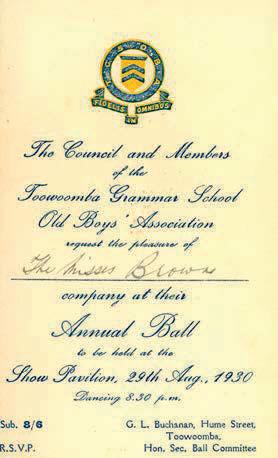

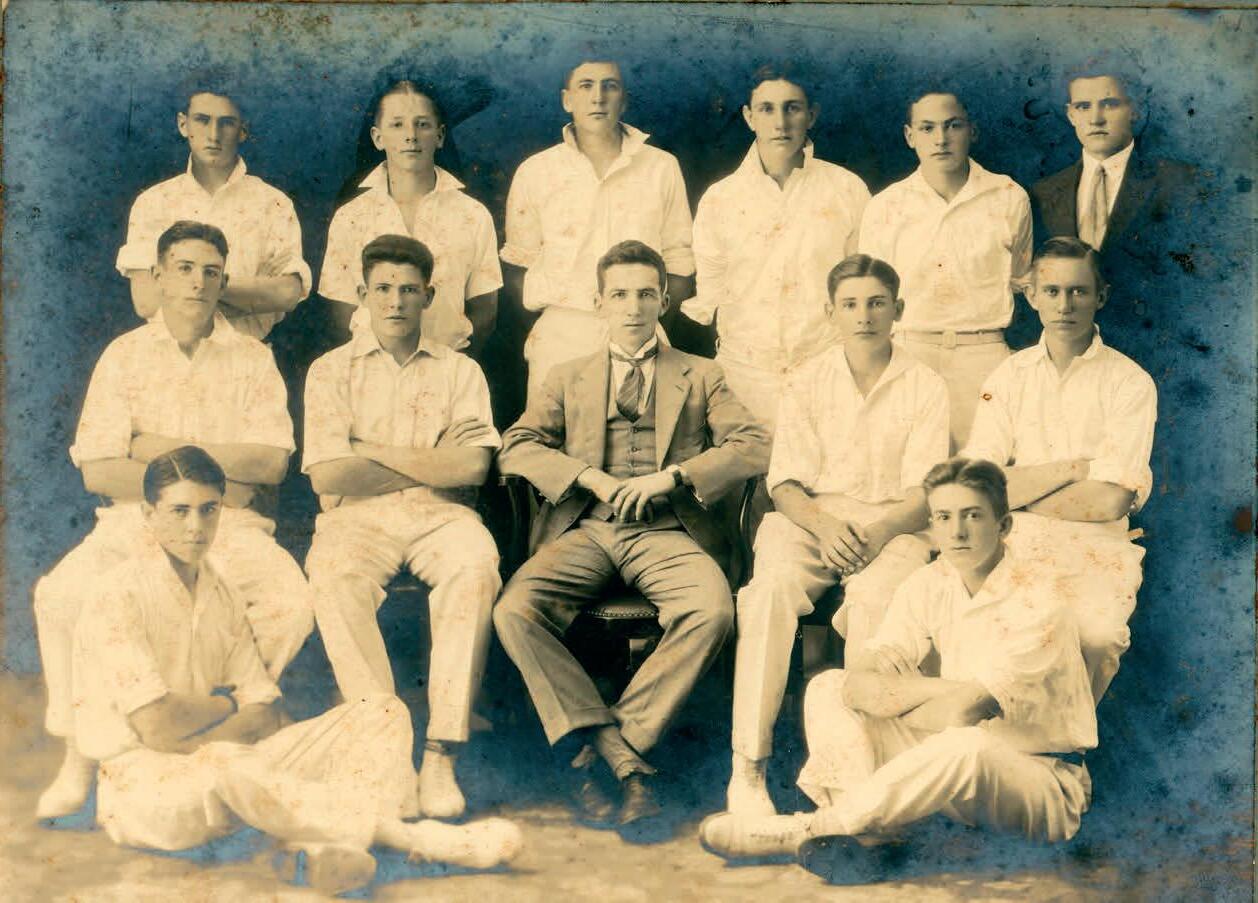
Chairman of the Board of Trustees: Brig-Gen. James C. Robertson (in his 2nd year)
Trustees: (September): Brig-Gen. James Robertson (Chairman until he relinquished it in January 1934, but he then remained on as a Board member); Lieutenant -Colonel Charles Fortescue; Alfred W. Hale; Dr David Horn; Mr Duncan Nelson; Mr Alfred Griffiths; and Mr Arnold E. Lavers
Headmaster: Mr George P. Barbour (in his 22nd year)
Second Master: Mr James G. Leadbeater (in his 22nd year)
Senior Prefect: Eric J. Johnson (see below)
Dux of Year: Harold K. Thomsett (and Senior Prefect and Dux in 1932)
Total School Enrolment: 201
Number of Dayboys: 147
Number of Boarders: 54
Staffing:
• The Secretary to the School’s Board of Trustees, Mr J. Gilder Nolan, was dismissed by the Board. Mr T.H. Ludgate was subsequently appointed. Mr Nolan’s father resigned from the Board which was accepted with deep regret.
Students:
• The School Prefects were Eric Johnson, Herbert Coleman, Jeffrey Jordan, Harold Thomsett and Lyn Wood. A photograph of the School Prefects is included in this year’s entry. Pictured are (Back) - J. Jordan, H. Coleman, H. Thomsett (Front) - E. Johnson, Headmaster Barbour, L. Wood.
• The School’s Senior Prefect, Eric Johnson, died suddenly at the breakfast -table when he was 21 years old. He was apparently in good health right up to the time of his death. He was C aptain of the 1st XI cricket team, in the tennis four and this year won the half mile at the Combined Schools’ Sports (in today’s language he won the Open 800 metres event at the GPS Track and Field Championships). The next time this was to occur was in 1944 and 1945.
• Lyn H. Wood (1927 -1931) was Captain of Rugby in both 1930 and 1931. He represented Queensland in Rugby in this year whilst still at school (and was Captain of the Queensland team competing in Sydney in 1932 and later also represented Queensland in Rugby League). Lyn Wood is featured in the photographs of the School Prefects (front row, right) and in the 1st XV photograph in this year’s entry.
• John ‘Jack’ C. McDonald (1928-1931) is acknowledged on the Old Boys’ Wall of Achievement as a Rugby Union International. He was in the Australian rugby team whose tour of Britain had to be abandoned in 1939 because of World War II. ‘Jack’ was later selected for the Australian team for the second and third tests against New Zealand in 1938. After the war he coached rugby at the School. One of Jack’s sons, John ‘Cracker’, (see 1960 entry) played rugby league for Queensland and NSW and 13 tests for Australia. ‘Jack’ McDonald reported in the School Magazine (November 1939, pp.39-40) that when touring England with the Australian Rugby team he, and all othe rs, was issued with a gas mask in preparation for any potential air raids. The team was also invited to Buckingham Palace in London and met King George VI and Queen Elizabeth who spoke to them. The playing tour of the Australian Wallabies was cancelled due to the war.
• Ken Macalpine won the GPS Swimming Open 100 yards freestyle. He captained the School’s Swimming team for three years (1931-1933).
• Graham R. Skerman (1927-1931) was later to teach very briefly at the School (January 1960 – July 1961).
• Llew W. Jenkin (1931) was elected as an Honorary Life Member of the Toowoomba Grammar School Old Boys’ Association in 1994.
• Duncan Macdonald (1927-1931) was a member of the 1 st XV and 1st XI. Later, Duncan was one of the famous “Rats of Tobruk” and was severely injured in June 1941 by shrapnel from a German mortar. This injury put an end to his nick-name “Bullet proof Mac”; a little earlier that year he had stood on an Italian mine which failed to explode. In May of 2002 Mr Macdonald returned to the School for the first time in 59 years. His last visit was in 1943 as guest of honour of Headmaster, Mr Harry Roberts, in recognition of his distinguished war service in the North African desert, just one year earlier.
• Graeme Pace (1930-1931), University Scholar and Barrister at Law, was to become a keen supporter of the Brisbane Branch of the Old Boys’ Association. He was a Flying Officer with the RAAF 3 Squadron and was killed in action in the Middle East during World War Two. A subject prize for the annual Speech Day and Prize Giving Ceremony, the Graeme Pace Memorial Prize for Mathematics in Year 11, was introduced in 1942.
• Don Stevens (1930 -1931) was, in 1956, the Australian representative on the United Nation s’ Committee of Inquiry into the effects of atomic radiation, which met in Geneva, Switzerland. In 1957 Mr Stevens was appointed Director of the Commonwealth X-Ray and Radium Laboratory in Melbourne.
Events:
• The Missionaries of the Sacred Heart (MSC) opened Downlands College, a boys’ boarding school in north Toowoomba. In its first year of operation there was an enrolment of 67 boys. (see ‘Cricket’ in next year’s entry).
• The Old Boys’ Football (Rugby) Club did exceptionally well in the Toowoomba Rugby Union Senior Fixtures and contested in all the finals. An Old Boys’ B-Grade Union team also played.
• The Old Boys’ 1st XV defeated the School’s 1st XV and the current students defeated the Old Boys’ 2nd XV.
• At the second re-union dinner of the Old Boys residing in Sydney it was decided to form a Sydney Branch of the Old Boys’ Association. Mr Fred Robinson (1911-1913) was elected President and the Secretary was Mr Ken Carmichael.
Co-curricular Activities:
• In The Chelmsford Cup (against Ipswich Grammar School) the Cup returned to the School following last year’s defeat. IGS won the athletics and football (rugby) competitions contri buting to the Cup but TGS won cricket, swimming and tennis to secure a narrow victory.
• In Athletics, the All Schools' Athletics Sports were held at the Brisbane Exhibition Grounds in September. The School sent four representatives and was placed eighth of the nine GPS schools in the competition.
• In Athletics, see Eric Johnson in the ‘Students’ section of this year’s entry.
• In Cricket, the School achieved second place in the GPS Cricket competition this year. In the first cricket game of the new school year TGS played St. Joseph’s Gregory Terrace on the Athletic Oval in February and enjoyed a fine win, TGS, 275 d GT, 72. Harold (‘Harry’) Thomsett for TGS had a remarkable game batting soundly for two hours for 98 runs and then took seven wickets for 16 runs. In the second game the team had another win against IGS (164 – 95) and Harry Thomsett again took seven wickets for 38 runs.
• In the third game TGS defeated BBC with Donald Gundry taking 5 for 22 but experienced a major loss to Brisbane Grammar School (61 – 196). In the second innings of the TGS/BGS game, TGS scored only 23 runs. This represented the sixth lowest score of a TGS 1 st XI in the School’s history. The TGS School Magazine stated: “To report on this game is to publish abroad our own shame.”
• Against The Southport School the TGS 1 st XI had a massive win, 7/322 (including a century, 169 runs, by Robert ‘Bob’ Chester) defeating TSS, 74 runs. Bob Chester’s century of 169 runs was t he sixth highest in the 144 years of TGS cricket in the GPS competition to 2020.
• In Rugby, the School’s 1st XV won six matches – BBC (51-3); BSHS (33-6); BGS (26-3); CEGS (‘Churchie’: 15-3); GT (16-3); and TSS (29-0) and lost two matches – IGS (6-7) and NC (0-6). The team achieved second place in the GPS Football (Rugby) competition and acknowledged the efforts of coach, Mr W.J. Renwick.
• Refer to the rugby sporting achievements of the Captain of this team, Lyn Wood, and John ‘Jack’ McDonald in the ‘Students’ section of this year’s entry.
• A photograph of this team is included in this year’s entry: (Back, Standing) - A. Tanner, I. Ingram, R. Ford, E. Muller, H. Coleman, D. MacDonald, R. Searle, B. Ingr am (Middle Row) - W. Renwick Esq., J. Jordan, L. Wood (Captain), J. McDonald, W. Hatherall, Esq. (Inset – N. Wright) (Front Row) - P. Patrick, E. Allen, R. Chester, R. Banks, J. Brodie.
• In Swimming, the School’s Swimming team was placed 3 rd in the GPS competition, being beaten for second place by half a point. The venue was the Booroodabin Baths. The Captain of Swimming for the third successive year, Ken Macalpine, won an Open event.
• In Tennis, last year’s Australian Tennis Champion, Mr Edgar ‘Gar’ Moon, visited the School’s tennis players with Mr Duncan Thompson, the Queensland re presentative player, during the year. The 1st IV tennis team was one of the best for some years, winning three games and losing three.
• In Cadets, rifles and bayonets were issued to the Cadets and shooting became a prominent and popular component of the cadet training. Firing took place on a temporary miniature rifle range which was situated in an old disused quarry just beyond the back of the School boundary.
President of the Old Boys’ Association: Mr Alexander J. Provan (for one year)
Guest Speaker at the Speech Day & Prize -Giving Ceremony: The Honourable R.M. King – QLD Minister for Public Instruction

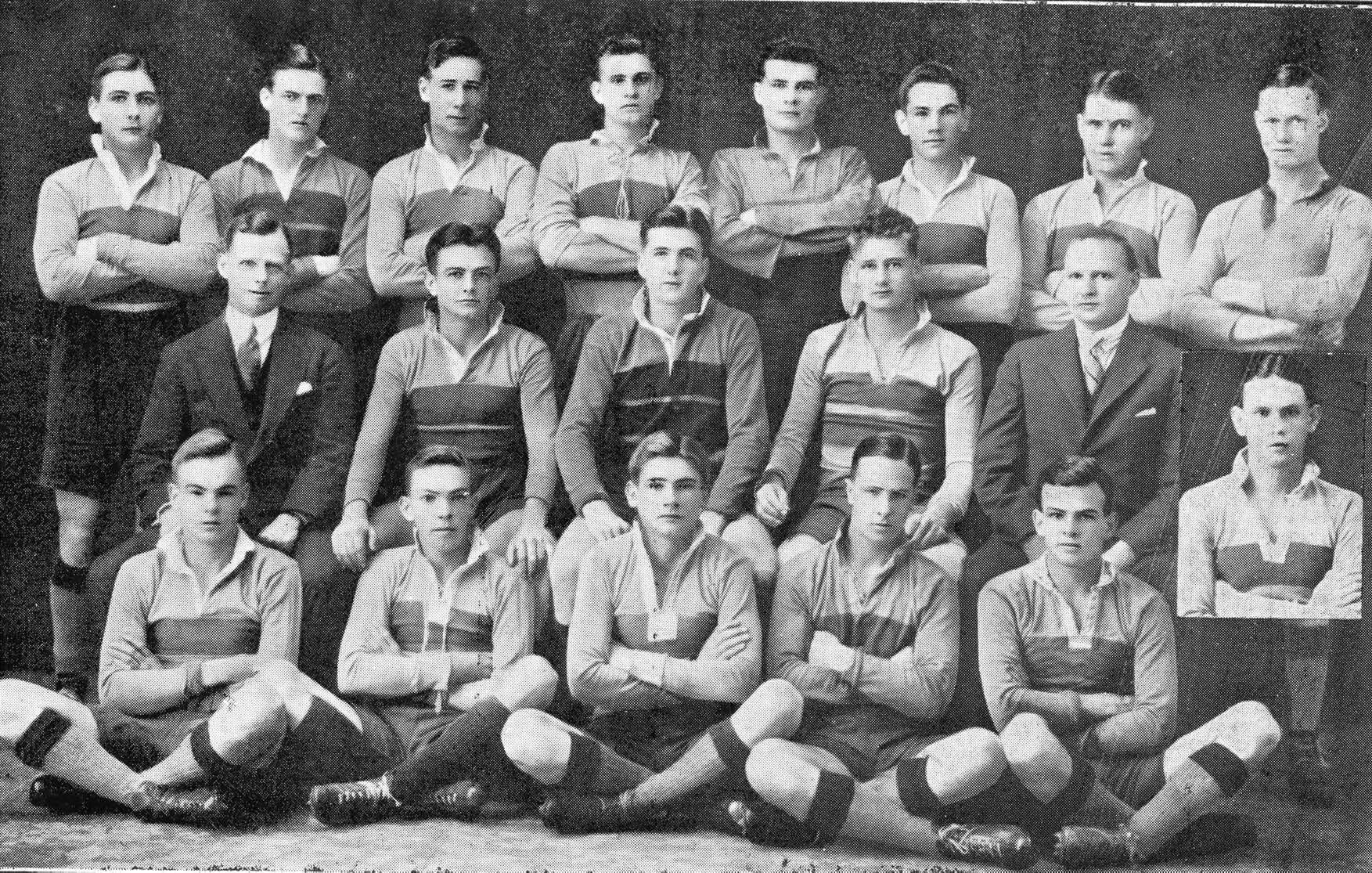
Chairman of the Board of Trustees: Brig-Gen J.C. Robertson (in his 3rd year)
Headmaster: Mr George P. Barbour (in his 23rd year)
Second Master: Mr James G. Leadbeater (in his 23rd year)
Senior Prefect: Harold K. Thomsett (and Dux) (see below)
Dux of Year: Harold K. Thomsett
Total School Enrolment: 166
Number of Dayboys: 123
Number of Boarders: 43 - The largely reduced number of State Scholars and the continued depression brought the number of boarders down to a point that had not been reached for many years.
Students:
• The School Prefects were Harold Thomsett, Ken Macalpine, Preston Patrick, John Brodie and Robert Chester.
• Lister G. Hopkins (1923-1927) was awarded a Rhodes Scholarship in this year.
• The Senior Prefect and Dux, Harold ‘Harry’ Thomsett, secured a University Scholarship. ‘Harry’ was to later teach at the School for two years (1936 -1937). He commenced teaching at Brisbane Grammar School later in 1937 and remained at BGS until 1953 except for four years in the Armed Forces. In 1954 he entered the State teaching service and retired in 1977 from his position as Principal of Nambour High School.
• In the 1st XI Cricket premiership winning team, three players were later to represent Queensland: Ken Boag, Jim Maddern and Harry Thomsett.
• ‘Bob’ Chester had the honour of being the Captain of two of the three GPS Premiership winning teams this year – cricket and football (rugby).
• James E. Macdonnell (1931-1932) became a prolific and extremely popular author of over 200 soft-covered naval novels relating to World War II. His writing was published in Australia, the USA and in nine European countries. He also wrote some 20 hard-covered crime thrillers and is acknowledged on the Old Boys’ Wall of Achievement.
• The School was to receive memorabilia belonging to student Stuart E. Armstrong (1931 -1932) from his daughter, Mrs Sue Morgan, 86 years later in 2018. The items included a school embroidered crest Athletics Club (AC) badge and the 1932 Athletics Carnival program and several photographs. Stuart Armstrong was the youngest of three boys in the Armstrong family, all of whom attended TGS – John H. (1928-1929), Euan R. (1929-1937) and Stuart Elliott (1931 -1932).
• There was one case of serious illness; a dayboy contracted typhoid but recovered.
Events:
• Three GPS Premierships were won in a remarkable display of sporting achievement – cricket, tennis and football (rugby).
• By December, the School had been connected to the Council’s sewerage network.
• The School was honoured with two Vice -Regal visits within a few weeks: in August by the Governor-General, Sir Isaac Isaacs, and in October by the State Governor, Sir Leslie Orme Wilson
• Old Boy Mr Samuel George Stephens Jnr, one of the six sons of the founder of the School, Mr Samuel George Stephens Snr, gifted the ten-acre ‘Laurel Bank Gardens’ bounded by West, Herries and Hill Streets, to the City of Toowoomba. Samuel Stephens had designed and developed the park over nearly thirty years (see 1897).
• Another of the sons of the founder of the School, Mr Samuel Stephens Snr, was Alfred G. Stephens, one of the original 44 students who first enrolled in the School in 1877 (see 1877) . At the meeting and reunion dinner of the Sydney Branch of the Old Boys’ Association in this year held at the University Club, Mr Alfred G. Stephens was the Guest of Hon our. Mr Stephens was student number one on the School Roll in 1877. At the time Mr Stephens was one of the most distinguished literary men in the Commonwealth. Also present at this Old Boys’ reunion dinner was the former Headmaster of the School (1901-1910) Mr W.A. Purves and the current Headmaster, Mr Barbour. The average attendance at the Sydney Branch dinners at this time was around thirty Old Boys.
• A nationwide infantile paralysis (‘polio’) epidemic caused major alarm for all boarding schools. In this year Queensland suffered its highest number of infantile paralysis polio cases in thirty years.
• On the Friday preceding ANZAC Day, Old Boy Lieutenant-Colonel Fortescue addressed the School. Having taken a very prominent part at the actual landing on Gallipoli the Lieutenant-Colonel was able to hold the attention by a continuous and graphic narrative.
• The presence of Mr. W. A. Purves, Headmaster 1901-1910, at the December Dinner of the Sydney Branch of the Old Boys Association lent the gathering interest and distinction.
Co-curricular Activities:
• In the Chelmsford Cup , Toowoomba Grammar School won the Competition (against Ipswich Grammar School) with wins in cricket, tennis and football (there was no swimming competition this year due to the national epidemic). IGS won the athletics competition as part of the challenge for the Cup. It was now 26 years since Lord Chelmsford introduced the Cup. During five of these years the contests resulted in a tie. Of the 21 years in which a decision had been reached, IGS won it 4 times and TGS 17.
• In Athletics, in the November intra-School Athletics Competition held on School Oval (now Barbour Oval) events included a Day Boys versus Boarders’ Relay, a ‘Siamese Race’’, a Forms’ Relay, throwing the cricket ball, kicking the football etc. A photograph of the program of events for the Sports Carnival is included in this year’s entry. What is now known as Old Boys’ Memorial Oval was, in these years, scrub and paddocks.
• At the All Schools’ Sports held at the Brisbane Exhibition Grounds in September, the School sent nine representatives. The School congratulated Brisbane Grammar School on winning the Sir John Goodwin Cup; TGS came last in this competition.
• In Cricket, the 1 st XI Cricket team won the GPS Cricket Premiership (captained by Bob Chester in the first half of the season and Harry Thomsett in the second half), with only one loss (CEGS). Bob Chester scored 659 runs for the School’s 1 st XI in four years from 1929 -1932. The School was to
follow up the 1932 Cricket Premiership with another Cricket Premiership in the next year and also in 1936. Included in the 1st XI Cricket team photograph in this year’s entry are: (Back) - I. Sinclair, L. Ingram, G. Maddern, H. Searl, V. Ford, D. Grundy, D. Greenhow (scorer), K. Boag (Middle) - R .Chester, Mr J. Rankin, Headmaster Barbour, K. Thomsett, J. Maddern (Front) - R. Harpham, D. Allen, F. Waterson.
• Playing cricket, James ‘Jim’ Maddern scored 219 not out against The Southport School, the first, and only (1877-2025) 1st XI GPS double century ever secured for the School (he made 364 runs in this year). Jim Maddern’s batting score of 219 not out represents the highest score ever in the School’s history for a 1st XI player. He was regarded by Headmaster Barbour to be the best wicket keeper in the School’s history since Allan Kent in 1904-1905. The highest second wicket partnership in the School’s history occurred in this 1 st XI match against the Southport School, played at the Brisbane Exhibition Ground. Ken Boag and James (Jim) Maddern had a partnership of 362 runs (see 1933, 1938, 1948, 2005 and 2008). In this second wicket, triple century partnership the 1st XI declared at one wicket down for 365 and defeated TSS, 76. Not only did James (‘Jim’) Maddern score an unbeaten 219 runs in this cricket match but his younger broth er, George, took three TSS wickets in his first over in the same match. Ken Boag finished with 130 not out in this TSS match.
• The TGS score of 363 runs against TSS was the second highest total ever recorded by a TGS 1 st XI side.
• Harry Thomsett scored 456 GPS runs in the 1st XI during this season with a batting average of 57.00 including a century (128) against BBC and two 50’s – (81 against BSHS and 74 against NC). He also took 7 wickets for 16 runs in the 1 st XI game against GT. (See the ‘Cricket’ section in the 1930 entry.)
• In the game against BBC, Harry Thomsett scored 128 in the total TGS batting score of 341. This figure of 341 represented the fifth highest score for a TGS 1 st XI in the School’s history.
• Against IGS, Ken Boag took 5 wickets for 44 runs.
• The strength of the GPS Premiership winning 1st XI was illustrated by some of their scores (against TSS, TGS (1/365) d TSS (76); TGS (341) d BBC (125); TGS (210) d BGS (202); beating NC by 134 runs etc.).
• In Football (Rugby), the 1st XV Rugby team won the GPS Rugby Premiership (shared with Nudgee College and captained by Bob Chester). It had a very good record of seven wins and one loss, by Nudgee College at Nudgee. A photograph of the TGS 1st XV premiership winning team is included in this year’s entry.
• The annual Rugby match against Downlands College (which opened in the previous year) commenced but was not named the O’Callaghan Cup until 1950. Relatively early in the year the School’s 2nd XV was defeated by Downlands 1st XV (0-3).
• The School Magazine of this year considered the 1 st XV as “perhaps not up to the standard of the 1928, 1929 and 1930 teams but had two distinct assets; it was evenly balanced and well led” . The 1st XV defeated BBC (37 -3), BSHS (33-0), and CEGS (‘Churchie’) 35-0 somewhat easily but were only victorious against BGS after a terrific struggle. In this game BGS led 9-nil with only a quarter of an hour left to play. In the final fifteen minutes the TGS team played inspired football scoring 18 points in the final fifteen minutes to win the game (18 -9). Very hard games were also played (and won) against GT (16-0), IGS (14-5), and TSS (17-3). Against Nudgee College, the team was decisively defeated, 3-21. NC had been beaten by IGS earlier in the season so both TGS and NC shared the GPS Premiership. The GPS Premiership football (rugby) team for TGS was captained by Bob Chester and coached by Mr Renwick.
• In Swimming, the cancellation of the Combined Swimming Carnival owing to the nationwide infantile paralysis scare was a great disappointment to the whole School. In the intra -school swimming competition held early in the year, the Captain of Swimming, Ken Macalpine, won the Headmaster’s Cup for the second time. He won all his freestyle races comfortably, came first in the dive and second in the backstroke.
• This was the first cancellation of the GPS Swimming Championships since the inception of the competition in 1918. The next cancellation of the event was in 1938 (see 1938).
• In Tennis, the 1st IV won the GPS Tennis Premiership (captained by R.’Mick’ McDonald). It was alleged that the IGS tennis players blamed their loss on the copious lunch they enjoyed.
• In Tennis, the 1st IV finished the competition as undefeated Premiers. The players had comfortable wins against Nudgee College (7 rubbers to nil) and Brisbane State High School (6-2) but only narrow ones over Brisbane Grammar School (5-3) and Brisbane Boys' College (also 5- 3). In the latter two matches it was the capacity of the team to play its best tennis in critical stages that gave victory to TGS. Mick McDonald (Captain) and Harry Thomsett as first and second "strings" respectively and as a doubles pair were the mainstay of the team during the year. Mick McDonald won five singles rubbers of the six played and Harry Thomsett four. As a doubles pair they were beaten only once. The Maddern brothers improved wonderfully during the season and at its close were quite as good a doubles pair as McDonald and Thomsett.
• The Captain of Tennis, R. ‘Mick’ McDonald, reached the final of the open singles in the Queensland Secondary Schools’ Tennis Championship conducted by the Qld. Lawn Tennis Association in July but was defeated by Davies (BBC).
Downlands Competition:
• The first recorded cricket match against Downlands College (founded in 1931) was in this year and won by DC. TGS won a cricket match against DC in 1933 and no games were recorded from 1934-1936. In 1937-1939, DC won three successive games.
President of the Old Boys’ Association: Mr Atherton A. Griffiths (for one year but also in 1923)
Guest Speaker at the Speech Day & Prize-Giving Ceremony: Professor Thomas A. Parnell – Tutor, Trinity College, Melbourne; Professor of Physics, University of Queensland

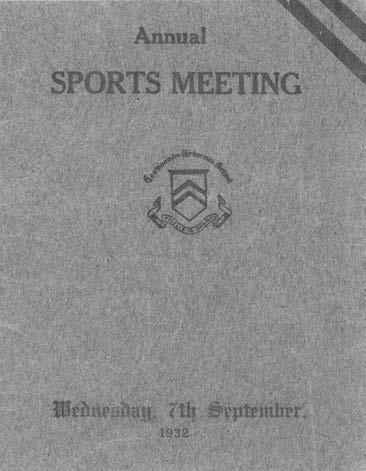

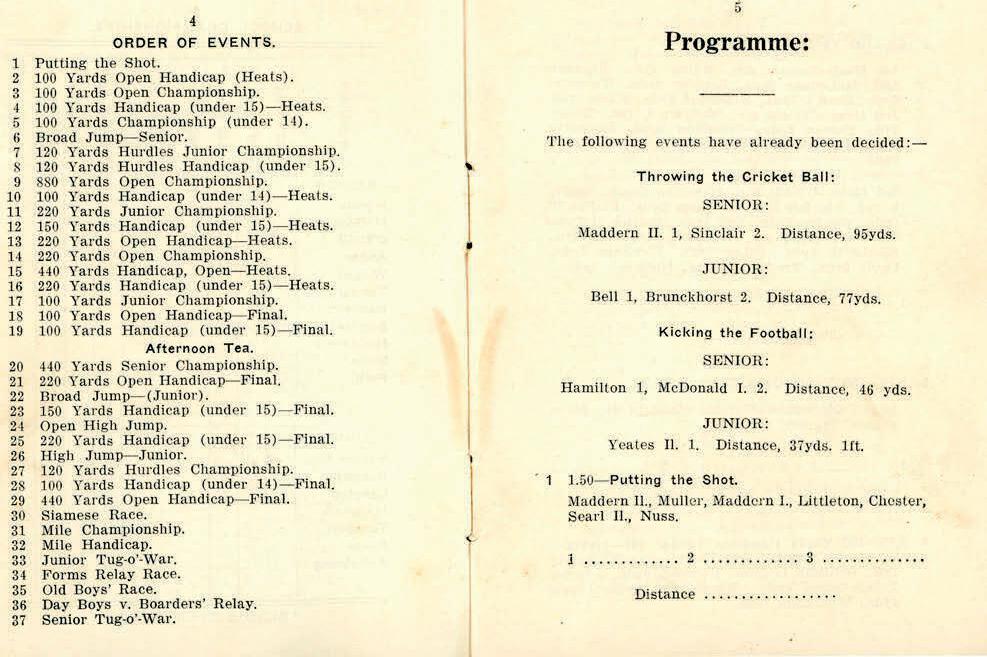
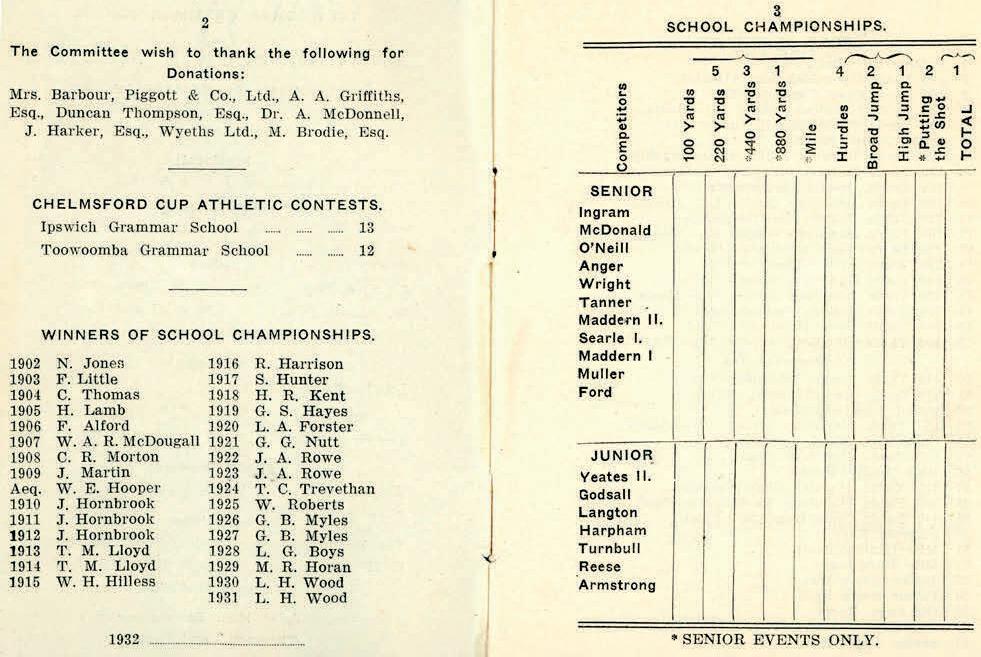
Chairman of the Board of Trustees: Brig-General J.C. Robertson (in his 4th year) followed by Mr Alfred Hale in his first year as Chairman (appointed in February) and then Mr Arnold Lavers (1934 -1943). Mr Lavers son, Roland J. Lavers, was a student at the School from 1936 -1939 and his three grandsons also attended the School – John Lavers (1969-1973), Kenneth (1974 -1978) and David (1976 -1980). Kenneth ‘Ken’ Lavers was later a teacher at the School (from 1990–2020) with roles such as Boarding Housemaster and Head of Science (see the ‘Students’ section in the 1978-year entry).
Headmaster: Mr George P. Barbour (in his 24 th year)
Second Master: Mr James G. Leadbeater (in his 24th year)
Senior Prefect: Preston R. Patrick and Ken Macalpine
Dux of Year: Edmund Muller
Total School Enrolment: 153
Number of Dayboys: 120
Number of Boarders: 33
Staffing:
• There were eight Masters on the teaching staff, including the Headmaster (and also including Mr L.T. Heenan, later to become the 11th Headmaster of Toowoomba Grammar School)
• Old Boy (1918-1922) and member of staff since July 1926, Mr William G. Rankin, was President of the Old Boys’ Association in this year. In December he resigned and, later in his career, in 1947 he was appointed as Deputy Headmaster of Scots College in Sydney to replace Mr Gr iffiths who had been appointed as Headmaster of TGS.
• As a result of the Depression and the Government’s reduction in the number of Scholarships available state-wide (State Scholarship holders at the School dropped from 152 to 100 between 1929 and 1933) three members of staff were retrenched. The remainder, including the Headmaster, were obliged to accept reduced salaries and to contribute to unemployment tax relief to meet the costs of those who were forced to go on the “dole”.
Students:
• The School Prefects were Preston Patrick, Ken Macalpine, Kenneth Boag, Lloyd Ingram, Edmund Muller, Henry Searle and Percy Searle. In the photograph of the 1933 School Prefects included in this year’s entry are (standing) - P. Searle, E. Muller, H. Searle, K. Boag and (seated) - K. Macalpine, Headmaster Barbour and L. Ingram.
• In the Senior, three students attained Open Scholarships: Harold ‘Graham’ Pace, Edmund Muller and Ken Macalpine.
• Ian F. B. Common (1929 -1933) was later acknowledged on the Old Boys’ Wall of Achievement after his career as an internationally acclaimed entomologist and specialist author.
• Charles D. Sheahan (1932-1933) took a dual degree in Arts and Law from the University of Queensland before launching on a distinguished legal career which was interrupted by War service from March 1941 to September 1945. He became a Queen’s Counsel in 1966 and a Supreme Court Judge from 1977 and is acknowledged on the Old Boys’ Wall of Achievement.
• At school was George H. Barbour (1932 -1933) who was the son of D r Eric Barbour, the son of George P. Barbour, the former Headmaster of Toowoomba Grammar School (the longest -serving Headmaster in the School’s history). George H. Barbour returned to the School in 1997 to address a large gathering at a special Barbour Era Dinner which was hosted by the then Headmaster, Mr Hugh Rose. George H. Barbour recalled his years at TGS: “The time I spent at Toowoomba Grammar School was during a particularly traumatic period of my life by virtue of the death of my mother, and my grandparents cared for me here, giving me great comfort. My grandmother would spoil me by allowing me to invite a friend for a weekly hot bath. A wonderful relief from a week of cold showers during a Toowoomba winter! I have very fond memories of my time at TGS, much as hundreds of other boys who have passed this way but none of them could say as I can, that while carrying out a dorm raid they were warned of the Headmaster’s approach by his wife, my Grandmother, banging on her ceiling below us with a broom handle!”
• Senior Prefect, Preston ‘Ross’ Patrick (1928-1933), was later to be appointed Director General of Health and Medical Services for Queensland, 1969 -1978. Dr Patrick wrote Horsewhip the Doctor (1985) and A History of Health and Medicine in Queensland, 1824-1960 launched by the then Minister for Health and Environment, The Hon. M. Ahern in 1987. During World War II, Dr Patrick was a Medical Officer for the 2nd Australian Imperial Force (AIF) in New Guinea. He was appointed a Member of the Order of Australia (AM) in 1992 in the Australia Day Honours for his ‘contribution to the community as a medical historian’. In later years Dr Patrick recalled to the School how he got ‘six of the best’ from Headmaster Barbour. ‘Ross’ was in the second big dormitory and Mr Tibby Martin was on duty. As Mr Martin turned the lights out, Ross gave him a ‘raspberry’ so next morning at assembly ‘Boss’ Barbour called him to his office. Mr Barbour said to Ross that this hurts me more than it’s going to hurt you and he got six whacks.
• Raymond ‘Ray’ L. O’Neill (1929 -1933) was honoured in the 1982 Australia Day Awards by being appointed as a Member of the Order of Australia (AM) for services to Local Government and community.
• David Harpham (1930-1933) was awarded a Commander of the Order of the British Empire (CBE) Medal and in 1980 was appointed State President of the United Graziers’ Association.
• Eric Evans (1928-1933), the younger brother of Ralph (‘Taffy’) Evans (see 1929), was one of three Old Boys who addressed the School Assembly in 2005, talking about their years at the School . Pictured in the photograph of the three gentlemen in this year’s entry are from left – Mr Jack Doyle (1932-1934), Mr Eric Evans (1928-1933) and Mr John Handley (1954-1957).
Events:
• 1933 was a notable year for two Old Boys of Toowoomba Grammar School. In this year, TGS Old Boy Edwin S. (‘Dooney’) Hayes (1925-1926) captained the Australian Rugby Union side on a successful tour of New Zealand. In this the same year another TGS Old Boy, Mick Madsen (19141916) captained the Australian Rugby League side against England at Leeds.
• The Empire Theatre (in Neil Street from 1911) burned down in February this year but was quickly rebuilt. Television forced the closure of the theatre in the early 1970s and, although used as a warehouse and TAFE facility, increasing dilapidation risked demolition until acquired by Council in 1995 and opened in June 1997.
Co-curricular Activities:
• In Cricket, the 1st XI Cricket team won the GPS Cricket Premiership for the second successive year; the next was to be in 1936. The team was captained by Ken Boag and the team suffered only one loss (BSHS) and drew a match (against TSS). The quality of this side was clearly illustrated by the following statistics: TGS (397) d BBC (84); TGS (194) d BSHS (72); TGS (298) d IGS (155); TGS (120) d BGS (116); TGS (255) drew TSS (7/143); TGS (161) d GT (53) with Boag and Gundry both taking five wickets each. In the second innings of the GT game, GT was all out for 14 runs.
• In 1st XI cricket, batting at the Brisbane Exhibition Ground, Captain Ken Boag made 191 not out (of the 255 runs innings total) against The Southport School. In this, he batted through the innings but the final result was a draw. Boag’s score of 191 not out represents the third highest score ever made by a TGS 1 st XI member in GPS cricket history (see 1932 and 1937). Ken Boag was welcomed at the annual reunion dinner of the TGS OBA Sydney Branch in 1964. A photograph of Ken Boag appears in this year’s entry in the Prefects and 1 st XI Cricket photographs (standing, far right) and in the 1st XV.
• In another 1st XI game against Ipswich Grammar School, Ken Boag’s performance was superb. In bowling against IGS, Boag took eight wickets for 52 and, in the next 90 minutes, he made 102 runs and retired in order to help the Past Grammarians team who were in difficulties. In this latter senior game, Ken Boag made a further century (117) in about two hours. In the aforementioned TGS v IGS 1st XI game, the TGS opening partners Ken Boag and Doug Allen put on an opening partnership of 196 runs This represented the second-best opening partnership the School had seen since Alex Mayes and Eddie Kann put on 220 in 1920 (it remains as the fourth highest partnership in TGS 1st XI cricket history). In the opening partnership against IGS, Ken Boag was 102 retired and Doug Allen scored 94 runs. In more recent times in the School’s history, Ben Turner and Fraser Donaldson in 2008 batted through the innings as openers (see 2008). Many would claim that Ken Boag was one of the best batsman and all-rounder Toowoomba Grammar School has ever had. The next time a TGS batsman scored three centuries was in 1948 (Charlie Moore).
• In addition to Ken Boag’s bowling figures of 8 for 52 against IGS, he took 5 for 24 in the first innings of the GT match and a further 5 for 8 in the second innings.
• The total batting score for TGS in the game against BBC (397 runs) represents the second highest total by a TGS 1st XI in GPS cricket (363 runs total in the previous year).
• In Rugby, the School’s 1st XV Rugby team was argued by some to be one of the best in the School’s history. The School Magazine of this year seemed to contradict such an assessment: “The football season was only moderately successful with the firsts finishing half-way down the Brisbane competition table.” Captained by Lloyd Ingram, the side recorded a 74 -0 win against Brisbane Boys’ College in this year. Another decisive victory by this team this year was a 49 -0 result against Brisbane State High School. Other victories were: TGS (11) d CEGS (‘Churchie’) 6; TGS (18) d GT (9); and TGS and BGS (draw, 3 -3). The losses included: TGS (0) lost to NC (26); TGS (4) lost to TSS (6) and TGS (0) lost to IGS (29).
• A photograph of the 1933 1st XV team is included in this year’s entry. Pictured are (back) W. Hatherell Esq, D. Gold, G. Godsall, N. Yeates, L. Bosworth, K. Renwick Esq (middle) W. Hamilton, E. Muller, L. Ingram, Headmaster Barbour, P. Searl, K. Boag, H. Searl and (front) H. Bullock, R. O’Neill, J. Spalding, M. Yeates, D. Lane and R. Meibusch.
• In Swimming, the School’s Swimming team was placed 3rd in the GPS Swimming competition with the Open Relay team breaking the record (Raymond O’Neill, Lloyd Ingram, Edward W. Freshney and Derrick Scanlan).
• In Cadets, the School was successful in winning the shooting competition (the Defence Department's Cup) with higher scores achieved over BGS, CEGS, TSS and BSHS.
President of the Old Boys’ Association: A then current member of the teaching staff, Mr William G. Rankin (for one year)
Guest Speaker at the Speech Day & Prize -Giving Ceremony: The Honourable Frank A. Cooper – QLD Minister for Public Instruction
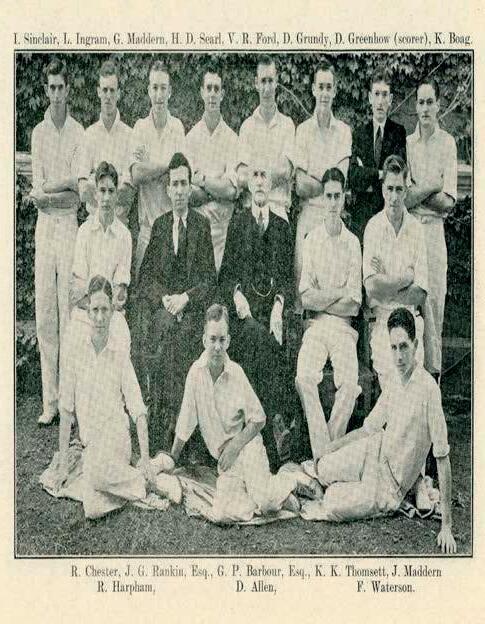
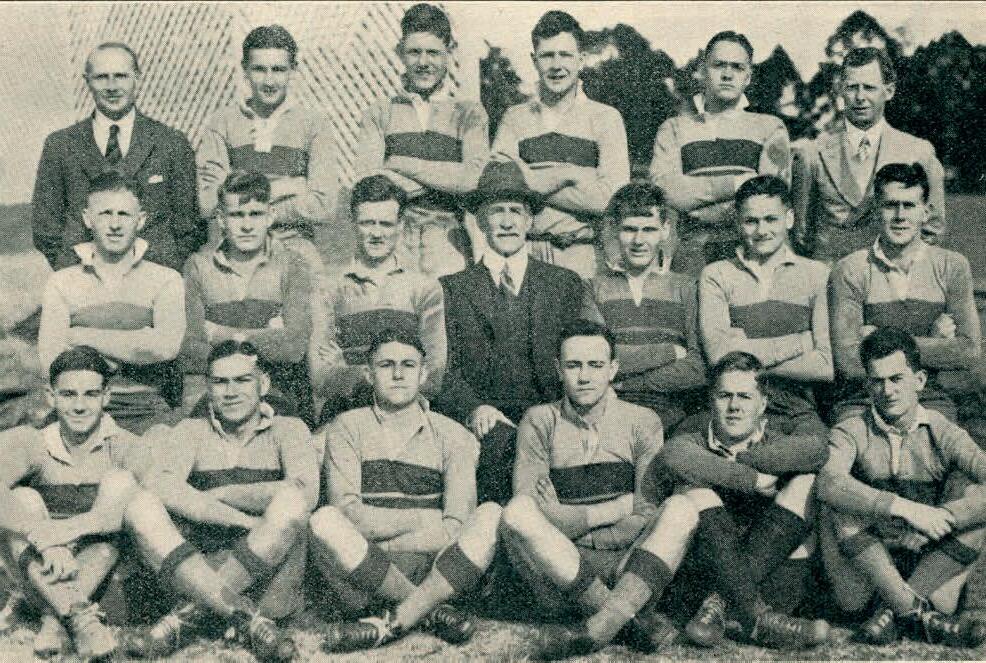

Chairman of the Board of Trustees: Brig.-Gen. James Robertson relinquished the Chairmanship on 31 January, followed by Mr Alfred W. Hale in February, followed by Mr Arnold Lavers’ appointment as Chairman from 9 October.
Trustees: The Government nominees on the School’s Board of Trustees, four in number, retire every three years but are eligible for reappointment. The four Government nominees at the time were Dr Horn, Lieutenant-Colonel Fortescue, and Messrs A.W. Hale and Duncan J. Nelson. In September it was announced that the new Government nominated Trustees for the next three years would be Dr Horn and Messrs Costin, Lenihan and Schmidt. The current Subscribers’ representatives remained on the Board. They were Brigadier-General J.C. Robertson and Messrs A.E. Lavers and E.C. Bernays.
Headmaster: Mr George P. Barbour (in his 25th year)
Second Master: Mr James G. Leadbeater (in his 25th year)
Senior Prefect: Henry D. Searl
Dux of Year: Edwin F. Warren
Total School Enrolment: 174
Number of Dayboys: 126
Number of Boarders: 48
Students:
• The School Prefects were Henry Searl, Harold Bullock, Keith Cohoe, Howard Lavers and Neil Yeates.
• Jack C. Doyle (1932 -1934) was born in 1918 at Kamilaroi station, about 200 kilometres north of Cloncurry, with no medical practitioner in attendance, no telephone and the nearest neighbours 40 kilometres away. During World War II he was a Squadron Leader flying Kittyhawk Fighter Bombers. He flew 255 operational sorties during World War II, clocking up a total of 403 hours and 25 minutes operational hours. After the war, Jack Doyle pioneered underwater photography and filmed the main anchor of HMS Sirius at Norfolk Island in 1965. He also became a triple medallist at the Australian Masters’ Games in cycling in 1995. Mr Doyle was a highly respected and active member of the Management Committee of the Old Boys’ Association until his death in December 2009. He was also an Honorary Life Member of the OBA (awarded in 2007) and acknowledged on the Old Boys’ Wall of Achievement. At the School’s Cadet Passing Out Parade, a distinguished Prize is awarded each year named in Mr Doyle’s honour – the “SQNLDR Jack Doyle, DSO, DFC and Bar Commemoration Propeller” which was first presented in 2011. This is awarded to a cadet who has shown an outstanding commitment to the TGS Cadet traditions and is presented by members of the Old Boys’ Association. In 2003 Mr Doyle was one of 27 Australian veterans and war widows invited to the dedication of the Australian War Memorial in London on
Remembrance Day. Another Old Boy of the School, Herbert Copeman RAAF (1937 -1941), was also invited to join the official commemorative ceremony. Various photographs of Jack Doyle are included in this year’s entry. One photograph of Mr Doyle, taken in 2007, is him showing the youngest boy in the School in this year (Elijah McRae) the School Students’ Admissions Register.
• Tom Vallis (1930-1934) was later to be elected as an Honorary Life Member of the Old Boys’ Association (in 1997) Over many years Tom served the Brisbane Branch of the OBA as President, Vice-President and Secretary.
• Frank H. Waterson (1928-1934) wrote to the School over seventy years later stating: “I have been ever grateful for the lessons learned in the classroom and on the field by Headmaster Barbour and his dedicated Assistant Masters…. The words of the School Song and the chant of the war -cry remain with me, so I guess the link is still intact.” Frank Waterson was a very capable all-round cricketer in the 1st XI. In the match against IGS he took 8 wickets for 33 runs.
• Geoffrey Godsall (1931-1934) was, in 1934, the only Queenslander to be selected to enter the Royal Military College, Duntroon. As a Lieutenant -Colonel and having served in the Middle East, he was seconded, in1944, to the HQ Staff of General Douglas MacArthur and was with him when he landed in the Philippines. He joined the Australian Diplomatic Corps in Canberra in 1961. At the Australian National University he qualified in Malayan and Indonesian languages and was attached to the Civil Intelligence Section of the Australian Foreign Affairs Department.
• Vyvian Roessler Pascoe (1930-1934) later taught at the School for five months in a relief teaching role (August to December, 1940). Mr Pascoe was called up for service in the RAAF and lost his life in May 1942.
• Edward G. Hopkins (1933-1934), after studies in the USA and the degree of Doctor of Philosophy (Ph.D.) at the NSW University of Technology, was later a lec turer in the School of Electrical Engineering at this university.
• Ron Leahy (1933-1934), was later to be appointed Director of Sp ort for the Queensland Government and was a President of the Queensland Lawn Tennis Association. Ron was the guest speaker at the 1973 Old Boys’ Association reunion dinner.
Events:
• One of Headmaster Barbour’s daughters, Freda, was married in January to a TGS Old Boy –Kenneth Carmichael (1920-1925 and Senior Prefect in 1925). The wedding reception was held in the Big School Room (now called Old Hall). The local newspaper went to some lengths to report the wedding of the Headmaster’s daughter. As an illustration, the columnist described in detail the bride’s wedding dress: “The bride, who was given away by her father, wore magnolia satin cut on classic lines, with wrist-length cowled sleeves. Her veil of old Limerick lace, previously worn by the bride’s grandmother, and sisters, was held with a half circlet of orange buds, a nd her bouquet was of hoya and yellow gladioli. … the bridesmaids, frocked alike in lily green duchess satin, with looped bustle bows and wide-leaved hats of cellophane and wheat-straw, with green and cream organdie flowers. They carried garlands of Shasta daisies and green leaves…. The wedding reception was held at the Grammar School, where Mrs Barbour greeted her guests wearing Alice blue mariette with godets of Chantilly lace and a wide brimmed hat to match…” Mr and Mrs Barbour had eight children. Ian died as a result of tetanus aged around 6 or 7 (see 1915); Fred died in the war; and Eric, a doctor, also died young.
• With the Headmaster’s impending retirement, by November members of the Board of Trustees had reduced a total of over 50 hopeful applicants to a short-list of six. Mr Henry ‘Harry’ Emmanuel Roberts was offered the position in December.
• An article in the School Magazine of November 1934 summarised Mr Barbour: “ He (Mr Barbour) will leave behind him an imperishable memory as scholar, sportsman, l eader, friend and man. He has been all of these in their highest and best sense.”
• The tuition fees for each quarter term were four pounds and four shillings. The fees for boarders, in addition to the tuition fees, were thirteen pounds and thirteen shillings per quarter.
• The question of whether the cost of the School Magazine should be reduced by admitting advertisements arose again. In the current (1934) School Magazine it was stated: “ We shall be very sorry to see what little dignity the publication has commercialised and cheapened in this way”. (Advertisements did appear on the beginning pages of the School Magazine, May 1936.)
• Various faculties at the University of Queensland had certain prerequisite subjects for matriculation. As an example, in the Faculty of Engineering at the University, a language other than English was a prerequisite for matriculation.
• A Prize known as the Belford Prize was first awarded this year by Old Boy E.(‘Ted’) Belford (see 1923) to a Year 12 student. This Prize continued until 1968 and in 1969 it became known as the Belford Prize for Scholarship, Leadership and Sport and was awarded to a student in every form. In 1983 the Prize was awarded to students in Forms IV, V and VI and in 1984 was awarded to students in Forms V and VI. The Prize, to the current time, is awarded to the student of the School in Year 11 and the one in Year 12 who, in the opinion of the Headmaster, has shown the greatest all round proficiency in his work and sport and shown outstanding character.
• The tenth annual reunion dinner of the Townsville Branch of the TGS Old Boys’ Association was held.
Co-curricular Activities:
• In the Chelmsford Cup competition, the victory went to Ipswich Grammar School for the fifth time; TGS has enjoyed eighteen victories. In the annual competition for the Cup against TGS, IGS won the cricket, football (rugby) and athletics whilst TGS won the swimming and tennis competitions.
• In Athletics, at the All Schools’ Sports held in Brisbane at the Exhibition Grounds in September, the School sent only four representatives. No TGS athlete gained a place. After an exciting finish, Gregory Terrace was victorious, beating Brisbane State High School by one point.
• In Cricket, the School Magazine bluntly assessed the 1 st Cricket XI as follows: “We have nine fair bats but no one outstanding. We have three or four bowlers, with the best certainly well below our best of recent years. The fielding reaches about the same level of mediocrity.” Furthermore, “it is doubtful if for a dozen years a poorer batting side has represented us, and what was worse, those who were capable of getting runs, persistently failed to moderate bowling”.
• In Cricket, see Frank Waterson in the ‘Students’ section of this year’s entry. He was one of only ten TGS boys in the history of the School who took eight wickets in a 1 st XI cricket innings in a GPS match. The next time this was achieved was in 1945.
• The 1st XI team achieved two wins in the year, with 4 losses and a match washed out.
• In Rugby, the 1st XV team finished 3rd in the GPS Rugby competition. The School’s XV suffered two defeats, one at the hands of Ipswich, the premiers (3-19) and the other by CEGS (‘Churchie’ – 38). The 1st XV was, perhaps, somewhat lucky to draw with Nudgee (nil all) on a water-logged field. TGS victories included: BBC (36-0), TSS (22-11), BSHS (12-3), GT (14-0) and BGS (11-0).
• The School Magazine of this year used direct words to describe the 1st XV Rugby team: “The School is endeavouring to make up for a lack of talent by practising keenly. Speaking generally, we have this year a fair number of promising forwards, but there is a marked scarcity of talent among the backs.”
• In Swimming, the School’s team was placed 2nd in the GPS Championships, losing by the narrow margin of one point to Brisbane Grammar School. At the competition, TGS Captain of Swimming (for this year and next year), Thomas ‘Tommy’ Muller, won the Open 50 metres freestyle event.
• In Tennis, the School Magazine reported: “Results of the Secondary Schools' tennis matches played after mid-Winter show that the anticipation of weakness in our team was justified .” The season showed only one victory, that against Ipswich Grammar School.
• In Cadets, in the first-half of the year, the Corps took part in two public functions. On April 21st it assisted the 11th Light Horse in a Cavalry Tattoo on the Show Grounds. The Corps gave a display of physical training and reproduced the defence of Rorke's Drift. Both these items were well received by the audience and the Press notices were extremely flattering. On A NZAC Day the Corps marched to the Monument in the morning where the Headmaster laid a wreath "In memory of the TGS Old Boys who fell" In the afternoon the Corps took part in the parade and service on the Show Grounds
General:
Edwin ‘Ted’ T. Bousen was a student at TGS in 1933 and 1934. In May 2015 Mr Bousen drove to Toowoomba with his friend Bart and met the Headmaster, Mr Peter Hauser, and various memb ers of the school community. Mr Bousen outlined to the Headmaster that Toowoomba Grammar School boys had some quite cruel initiations in those days. Boys would be put on the Roman rings and swung from side to side and were then hit with a stick on each swing. Mr Boulsen remembered that they retaliated by putting the perpetrator’s bicycle on top of the bicycle shed. His memories of the school pool were no t pleasant; on the first day he was at School he went to the swimming pool to “learn to swim”. The pool’s water was pumped from a bore by a windmill and the bottom of the pool was quite slimy. Nobody official turned up so some of the older boys said to jump in. Ted couldn’t stand up and panicked and had to be rescued by the older boys. Mr Bousen recalled: “Bossy Barbour was Headmaster; my Physics master was ‘Pud’ Heenan; I also had ‘Beery’ Hatherall for English and ‘Hoho’ Leadbetter for Mathematics. The Headmaster wielded the cane if boys accumulated two Saturday morning detentions. To ease the pain some boys used to put leather tubes inside their pants to protect them from the cane.”
The school uniform worn by Ted Bousen was a blue shirt, shorts, hat and band and long socks. For sports there was the footy jumper. Barbour Oval, (then known as the School Oval), had a grandstand and there was a minor field on Mackenzie Street. From Chemistry lessons Ted still has some mercur y. He said that the boys used to dip pennies into it to make them turn silver, then they would pass them off as a two shilling coin at the corner shop in Margaret Street. Ted earned his pocket money by being a ‘lolly boy’ at the Empire Theatre. His job was to go around with trays of lollies to sell before the film and at intervals.
In 1942 Mr Bousen enlisted and was posted to Milne Bay in New Guinea. At the time of his visit to the School in 2015 he said that he still had difficulty talking about his experiences at Milne Bay. For the 70 th anniversary of Milne Bay in August 2012, Mr Bousen was selected as one of only six from throughout Australia to attend the commemorations in New Guinea. In 2015 Mr Bousen still belonged to the Gailes Golf Club and had the honour of being the oldest playing member.
Mr Bousen celebrated his 100th birthday in September 2019.
President of the Old Boys’ Association: Lt-Col. Charles Fortescue (for one year) and also in 1922, 1930 and 1939
Guest Speaker at the Speech Day & Prize -Giving Ceremony: The Honourable G.W. Bulcock – QLD Minister for Agriculture and Stock
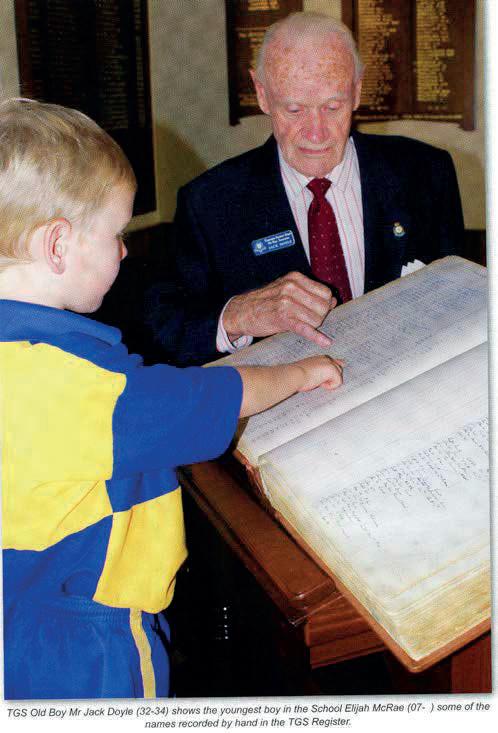
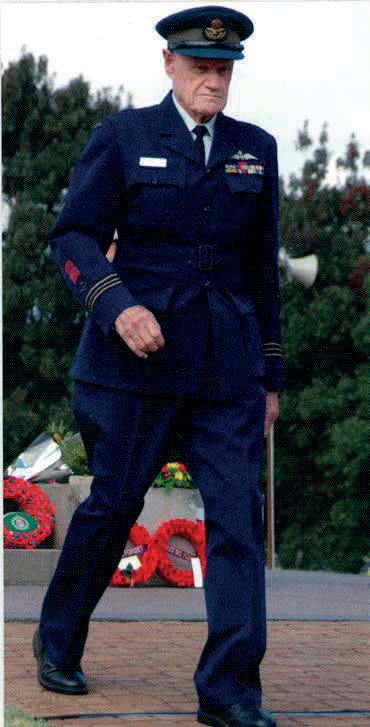
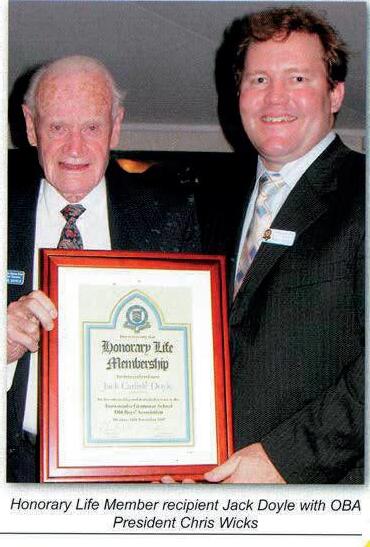
Chairman of the Board of Trustees: Mr Arnold E. Lavers (in his 2nd year)
Trustees: Messrs Arnold E. Lavers; Edwin C. Bernays; H.A. Schmidt; B.G. Cootin; F.E. Lenihan; BrigadierGeneral James Robertson; Dr David Horn
Headmaster: Mr Barbour (in his 26 th year as the School’s Headmaster) retired in June. He had become known throughout Australia as one of the great Headmasters of his time (see 1951 and 1954). Mr Barbour’s record years of service as Headmaster of Toowoomba Grammar School of 26 years (1910 -1935) will arguably never be surpassed. The second longest-serving Headmaster in the School’s history was Mr ‘Bill’ Dent with 21 years (1970-1991) and the third longest-serving Headmaster was Mr Peter Hauser with 18 years (2003-2020).
• In July Mr Henry (‘Harry’) Roberts was appointed the 9 th Headmaster of Toowoomba Grammar School from a field of over fifty applicants. He was the Dux of Brisbane Grammar School in 1918 and a member of four First teams. He was a young man to be appointed as a Headmaster, aged only 35 years. Prior to transferring to Toowoomba Grammar School Mr Roberts held the position of First Assistant Master (Deputy Headmaster) at Scots College, Bellevue Hill, Sydney. Interestingly in the history of Toowoomba Grammar School, Mr Roberts’ successor as Headmaster in 1947 (Mr David C. Griffiths) also came from the position of De puty Headmaster of Scots College and his successor at Scots was a TGS Old Boy, W. ‘Bill’ Rankin, a student at TGS from 1918-1922.
• As with previous TGS Headmasters, Mr Roberts was the last of the Headmasters to have been financially responsible for the running of the School’s Boarding House. The School’s Board of Trustees passed on to the Headmaster the boarding fees paid by parents and he and his wife were responsible for the entire domestic management of the School. This included the catering, laundry, cleaning and everything else to do with the Boarding House. Interestingly, as the crockery and other household items were the property of the Headmaster at the time, it wa s frequent practice for the Headmaster to arrange all items to be identified as School property to avoid misplacement. All of the dining room crockery was permanently stamped with the School badge and tastefully decorated in blue and gold bonding. Included in this year’s entry are some photographs of china and other items with such marking. The practice of having the Headmaster being financially responsible for the Boarding House ceased at the end of 1946 before the appointment of the new Headmaster, Mr Robert Mills, in 1948.
Second Master: Mr James G. Leadbeater (in his 26th year)
Senior Prefect: Neil T.M. Yeates (and also Captain of the 1st XI Cricket team and 1st XV): (see below). In 1957 the then Professor Neil Yeates was the Guest Speaker at the School’s Speech Day and Prize Giving Ceremony.
Dux of Year: William M. Jones (see below)
Total School Enrolment: 188
Number of Dayboys: 136
Number of Boarders: 52
Students:
• The School Prefects were Neil Yeates, Alfred ‘Bill’ Brunckhorst, Neville Ferris, Geoffrey Godsall, Edwin Warren, William Jones and Donald Stevens.
• This year there were approximately 600 students in Queensland who sat for ‘the senior’, yet only 18 Open Scholarships to the University were given. On the result of the Examination a University Scholarship was awarded to John William Henderson. It was declined, however, as he decided to remain another year at school. A Scholarship thus vacant was later offered to William ‘Bill’ Jones but having already commenced a Dentistry course at Sydney University he also declined.
• William ‘Bill’ Jones (1931-1935) kept the TGS cufflinks he was awarded by the School when he was Dux this year. He graduated B.DSc (1st Hons) and University Medal in 1939 from the University of Sydney and then served in the 51st Australian Dental Unit in World War II. He then returned to Toowoomba and took over his father’s dental practice when Hector retired. Bill was later to be on the School’s Board of Trustees (1959 -1960) and President of the Old Boys’ Association from 1965 to 1968. His father, Dr Hector G. Jones, was not an Old Boy but was a member of th e School’s Board of Trustees for 20 years, from 1938 to 1958 (see 1968). Bill Jones was the only member of the 1935-year group to attend the ‘Year of the Fives’ Old Boys’ Association reunion dinner in 2005.
• Ian Gibson (1928-1935) was later to be appointed as a member of the School’s Board of Trustees (1960-1983) and was the Chairman of the Board from 1973-1979.
• The School’s Senior Prefect and Captain of the 1 st XI Cricket team was Neil Yeates (1929 -1935) whose older brother, Bert, was also Captain of the 1 st XI in 1925 and 1926 (and represented Queensland in Cricket). Neil Yeates was also the winner of the Belford Prize in this year. Another Yeates brother, Fergus (1926-1930), also represented Queensland in Cricket. After gaining a Ph.D. from the University of Cambridge in 1948 and a Doctorate in Agricultural Science at the University of Queensland in 1957, Neil Yeates was later appointed Foundation Professor of Livestock Husbandry at the University of New England in 1964. Professor Yeates was a noted authority on Australian animal production and a specialist author and is acknowledged on the Old Boys’ Wall of Achievement. He was the Guest Speaker at the School’s Speech Day and Prize Giving Ceremony in 1957.
• Donald J. Stevens (1930-1935) is included on the Old Boys’ Wall of Achievement after he became a pioneer expert in radiation. He was the Director of the Commonwealth X -Ray and Radium Laboratory.
• Kelvin Boys (1934-1935) was killed in action in New Guinea in August 1945. Each year the School awards the Kelvin Reginald Boys Memorial Prize for Chemistry and Physics at the Speech Day and Prize Giving Ceremony. The ‘Kelvin Boys Memorial Trophy’ is also awarded to the Captain of Rugby.
• Henry ‘Roy’ Gundry (1935-1936) was in Japan as an Intelligence Officer at the time of the signing of the Japanese surrender in the Pacific.
• Frederick T. Barrell (1932-1935) was later to be appointed Principal of Yeronga State High School and received the 1963 award of the Australian Industrial Development Association for Outstanding Contribution to Science Teaching. Fred Barrell’s Science teacher at TGS was Mr Len Heenan (later the School’s eleventh Headmaster, 1956 -1961) who won the same award years earlier.
• All boarders at this time had to endure cold showers every morning.
• In this year the School Curriculum consisted of the following subjects being offered – English, French, Latin, Modern History, Ancient History, Geography, Economics, Chemistry, Physics, Maths I, Maths II and Logic. In Forms III and IV the following subjects were also offered – Book-keeping, Arithmetic, Algebra, Geometry and Geometric Drawing.
Events:
• The School’s 5th Headmaster, Mr Charles Carteret Corfe (1890 -1900), passed away in England at the age of 88 years.
• The tenth annual ball of the Brisbane Branch of the TGS Old Boys’ Association was held in August and attended by 135 people. Old Boys were delighted to meet the new Headmaster, Mr Roberts and his wife.
• Old Boy (1893-1894), Lord Huntingfield, Governor of Victoria and at the time Acting GovernorGeneral of Australia, visited the School in July. As a student Lord Huntingfield was William Charles Arcedeckne Vanneck. As reported in the School Magazine of November 1935 (page 41) the Governor said in response to the Headmaster’s introductory remarks: “ ...it is a very great pleasure for me to come back to this old school, which I remember so well. A good many years ago – in fact, so many years ago that it was long before any of the boys now attending the School were born –I remember this place. I hope that in the 37 years that have intervened between the time I left Toowoomba and the time I have come back to it that I have maintained during my life the traditions of service which I learned at the Toowoomba Grammar School . Coming back as I do the chosen representative in Victoria of His Majesty The King, I hope that the older people listening to me will consider that I have reflected a certain amount of honour on the Sc hool.”
• A farewell ‘smoke concert’ to the retiring Headmaster, Mr Barbour, in June was attended by over sixty Old Boys from the Brisbane Branch of the Old Boys’ Association (OBA). At the ‘smoke concert’ one of the many congratulatory telegrams sent to Mr Barbour was written in Latin and was required to be read at the function. The Treasurer of the Brisbane Branch of the OBA . Jim Hoare, requested that Headmaster Barbour translate the Latin. In doing so Mr Barbour, with a twinkle in his eyes, remarked that Jim Hoare’s knowledge of Latin was no better than it was at school 25 years’ ago.
• In June the Old Boys’ Association in Toowoomba arranged a farewell for Headmaster Barbour and Mrs Barbour. The gathering took place in the Big School Room (now known as Old Hall). Mr and Mrs Barbour and Dr David Horn (President of the OBA) and Mrs Horn entered the room to the strains of bagpipes. There was then an outburst of cheering. Evidence of loyalty to the School and almost overwhelming affection for Mr and Mrs Barbour was very apparent. Speakers at the function included the Chairman of the School’s Board of Trustees (Mr Arnold Lavers), Old Boy Mr Joseph V. Herbert from the School’s first intake of students (1877-1880), Sir Littleton Groom MP, Brigadier-General J.C. Robertson, Colonel Charles Fortescue, Mr Mervyn Baynes on behalf of the younger Old Boys, Mr Jim Provan on behalf of the Sydney Branch of t he OBA, Messrs. Malcolm Wright, Owen Rogers, Bill Worley, Duncan Nelson, Fred Jerrard and Hunter Poon.
Co-curricular Activities:
• In Cricket, the 1st XI achieved 4 wins, with 2 losses and a draw and an unknown result against BSHS.
• The Captain of the 1st XI was Neil Yeates, ten years after his elder brother Herbert Yeates captained the team in 1924-25.
• Neville Ferris scored a century (132 retired) in a 1st XI cricket game against BBC. This century represents the 16th highest score in the School’s cricket history. In this game TGS scored 7/330.
• In the game against BGS in April, ‘Bill’ Brunckhorst, still in his Junior year, took 5 wickets for 28. In this match, TGS defeated BGS by 139 runs.
• The 1st XI played TSS in March on the Brisbane Cricket Ground (the ‘Gabba’). The result was a draw caused by rain.
• In Rugby, the 1st XV team generally was very young with four of its members eligible to play in the Under 15 years’ competition. The team finished 4th on the GPS Rugby ladder.
• The 1st XV won games against BSHS (27-3), TSS (22-8), BGS (15-8) and drew against both CEGS (88) and GT (8-8). The games lost were to NC (3 -31) and IGS (5-11). In a non-GPS fixture, TGS was defeated by Downlands College (6-18).
• Neil Yeates and Neville Ferris were selected in the combined GPS 1 st XV team.
• The Old Boys 1st XV played the current 1st XV and the Old Boys won the game, 22 points to 15.
• In Swimming, the School’s Swimming team won the GPS Swimming Premiership (captained by ‘Tommy’ Muller) for the first time in the School’s history. At the time of writing, this remains the only GPS Swimming Premiership the School has won. Thomas Muller (Captain of Swimming both in 1934 and this year) had individual wins in the GPS Open 50 metres fre estyle and backstroke and the 100 metres freestyle, making a solid contribution to the School winning the GPS Swimming Premiership in this year. The swimming squad was coached by Mr Heenan. A photograph of the premiership winning TGS Swimming team is included in this year’s entry.
• The 1930s saw great success for TGS Swimming – 1930 (2nd place in the GPS Swimming Championships); 1931 (3 rd); 1932 (no competition); 1933 (3 rd); 1934 (2nd); 1935 (1st); 1936 (3rd); 1938 (no competition).
• In Cadets, a photograph of the School’s GPS Shooting Premiers team is included in this year’s entry. In the middle row of the photograph are Captain L.W.A. Scott (2nd from left) and Headmaster H.R. Roberts (3rd from left) in his first year as Headmaster of the School.
President of the Old Boys’ Association: Dr David Horn (for one year) and also in 1929
Guest Speaker at the Speech Day & Prize-Giving Ceremony: The Honourable Percy Pease – QLD Minister for Lands


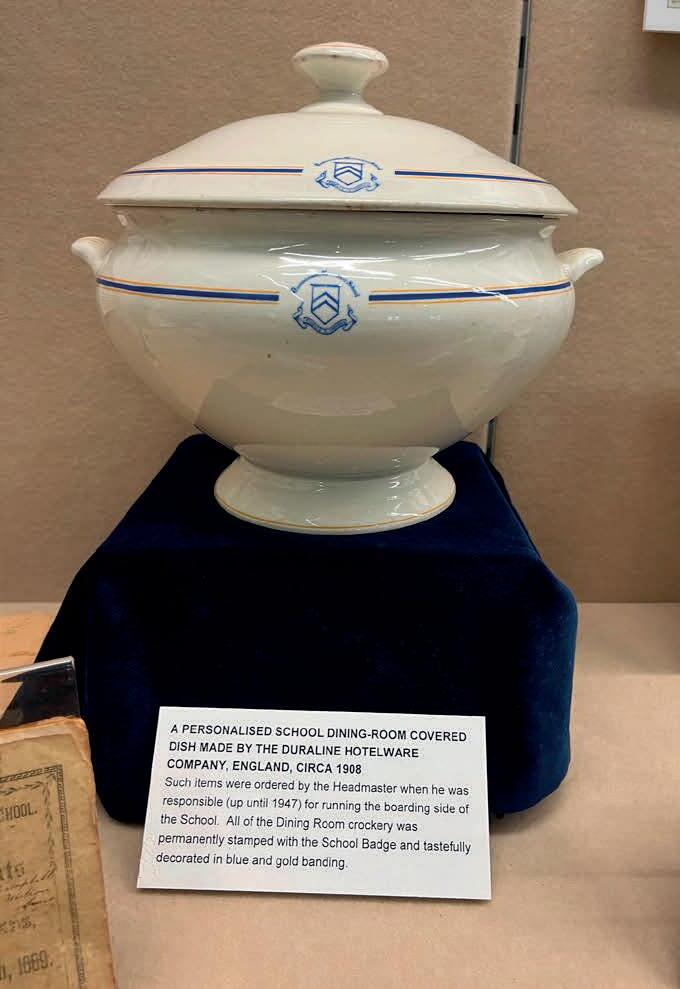



Chairman of the Board of Trustees: Mr Arnold Lavers (in his 3rd year)
Trustees: Trustee Mr H.A. Schmidt passed away in July. Mr Schmidt had been a member of the School’s Board of Trustees since October 1934.
Headmaster: Mr ‘Harry’ Roberts (in his 2nd year)
Second Master: Mr James G. Leadbeater (in his 27th year)
Senior Prefect: Alfred M. ‘Bill’ Brunckhorst (and in 1937 and 1938)
Dux of Year: John William P. Henderson (who later had three sons, two of whom were to be awarded Dux of the School: in 1966 and 1971). John Henderson, later as a qualified medical practitioner, was to be appointed as a Trustee of the School in 1965 and subsequently became Chairman of the School’s Board of Trustees (1979-1982). In 1984 Henderson House was added to the Dayboy Houses when the House System was enlarged from four Houses to eight. In 2017 the School named the former Boyce Boarding House building the J.W.P. Henderson Art and Drama building.
Total School Enrolment: 192
Number of Dayboys: 126
Number of Boarders: 66, jumping to 140 in 1940 in the war year of 1940 and beyond
Staffing:
• Mr Harry Thomsett, a former Old Boy (1927 -1932) and Senior Prefect and Dux of the School, joined the teaching staff and taught at the School for two years.
• There were only eight teachers on staff, including the Headmaster. The teaching staff comprised Messrs H.E. Roberts (Headmaster); J.G. Leadbeater (Second Master); L.T. Heenan; H.K. Thomsett; H.Hassler; W. Hatherell; L.W.A. Scott; and T.V. Martin.
Students:
• The School Prefects were Alfred ‘Bill’ Brunckhorst, George Corones, R odney Dent, Reginald Hamlyn, John Henderson and Kenneth Lavers. A photograph of the 1936 School Prefects is significant in that it features some later highly influential Old Boys who a re acknowledged in this year’s entry: (Standing) R. Hamlyn, R. Dent, G .Corones (Sitting) J. Henderson, A. Brunckhorst, Headmaster Roberts, K. Lavers.
• Prefect and Dux of the Year, John W.P. Henderson , was in later years honoured by the School by the naming of a House and building (see above).
• Three Open Scholarships to the University were won out of the eighteen offered in Queensland. Alan G. Bennett came 2 nd in the State in the Open Scholarship, John W. Henderson came 8 th and
R.M. Jones 16th (who declined due to his relatively young age). Three of the twelve boys in ‘Senior’ entered University in 1937 to study Medicine – George Corones, John Henderson and Kenneth Lavers.
• Victor B.D. Skerman (1935 -1936) was later to become the Head of the Department of Microbiology at the University of Queensland from 1962 -1981 having been appointed Foundation Chair of Microbiology in 1961. Victor Skerman was one of the six Skerman brothers who attended the School (see the ‘Students’ section in the 1925-year entry).
• The Senior Prefect, Alfred ‘Bill’ Brunckhorst, was the Captain of Cricket, Rugby, Swimming, Tennis and the 1936 Senior Athletic Champion. He also held these leadership positions in the following year.
• Prefect George Corones (1932-1936) was a member of the GPS Premiership 1 st XI cricket team this year and the 1st XV in 1935 and 1936. He was the Belford Prize winner this year. In April of 2018 the School contacted Dr Corones on the occasion of his 100 th year birthday. Dr Corones’ four sons also attended Toowoomba Grammar School – Harry Ormond (1961-1964), Mark Alexander (1964-1966), Peter Andrew (1963 -1965) and Stephen George (1964-1966). Dr Corones retired from his medical career at the age of 80 . The highlight of Dr Corones’ sporting life came in 2018 at the Australian Swimming Trials to select the team for the Commonwealth Games. He was officially inducted into the 2018 Australian Commonwealth Games team as the oldest member ever. Dr Corones passed away in 2020, just a fortnight short of his 102nd birthday Photographs of Dr Corones and his TGS colour blazer pocket are included in this yea r’s entry.
• Ian Hutchison (1934-1936) celebrated his 100th birthday in August 2019 His son, David, attended the School from 1968-1972.
• Hector L. Dunn (1932 -1936) was made a member in the Civil Division of the Order of the British Empire (MBE) for service to religion and the community in the Queen’s Bir thday list of 1981. Hector gained the highest marks in the State for English in his senior year at TGS and entered the University of Queensland in 1938 where he began his Bachelor of Arts and Divinity. In 1943 he undertook his theological training at Emmanuel College, University of Queensland, before moving to Sydney to complete his degree in Divinity. The Right Reverend Hector Dunn held numerous senior positions within the Presbyterian Church benefiting parishes across Australia and the United Kingdom.
• Herbert ‘Bert’ Stevens (1936) was appointed Principal of Essendon Grammar School, Melbourne, in 1963 and Penleigh and Essendon Grammar when both schools amalgamated. He retired after 25 years as Principal in 1987.
• Ivan S. Brinkworth (1935-1936) became a teacher and taught History at Toowoomba State High School, retiring from the Education Department in 1981.
• Gordon M. Allen (1934-1936) was chosen in the 1 st XI cricket team in his first year at TGS as a 14year-old and played in the 1st XI for three years. He also played in the 1 st XV in his second year. The then Headmaster, G.P. Barbour, presented Gordon on leaving school with a memento which had an image of Don Bradman on it and with a hand-written inscription on the back which said “To the Bradman of the Downs”. Gordon’s two brothers also attended the School, Tom (19271929) and Doug (1932 -1933). Gordon’s two sons Peter (1963 -1966) and Malcolm (1964 -1968) also attended TGS.
• ‘Blue’ Long and ‘Merv’ Barnes (1935-1936) were fighter pilots in World War Two and are pictured in a photograph in this year’s entry.
• Roy H. Evans (1934 -1936) was the recipient of a Medal of the Order (OAM) from The Order of Australia awards.
Events:
• Member for the Darling Downs in the House of Representatives, Old Boy Sir Littleton Groom, passed away this year On the afternoon of Tuesday, 10th November, a Memorial Service to the late Sir Littleton Groom was conducted in the School Assembly Hall by the Rev. R. Warner Shand, Rector of St. Luke's Church. The whole school attended. A Tribute to the Hon Sir Littleton Groom was included in the School Magazine of November 1936.
• In early August the Governor General, His Excellency Lord Gowrie and Lady Gowrie , visited the City of Toowoomba for two days. Many students from various schools assembled at the Show Grounds to meet His Excellency and the function was a great success.
• A new bore and windmill were installed.
• The School Magazine of November 1936 refers to a wireless set being presented by the Old Boys. In the ‘House Notes’ the Magazine records t he sentence: “The Diablo craze has caught on, but like Minny (sic) Golf and YoYo it will probably soon be a memory.”
• The School Magazines of this year adopted a slightly revised format in the early pages with a list of all staff and Trustees.
• The Headmaster observed that the School was badly in need of a good library.
• The boarders displayed some musical talent this year. Mouth organs had an over-ruling majority in a worthy collection of musical instruments comprising also violins, a cornet, a banjo and last, but by no means least, a flagelet.
• The Brisbane Boys’ College Old Collegians’ Association presented a fine cup for a cricket competition against Old Boys of the GPS. Toowoomba Grammar School Old Boys won this cup and also in the following year.
• Sadly and disappointingly, for many years in the School’s history there had been times of rigorous initiations. In John Keeble Winn’s book on the History of Toowoomba Grammar School 1875 -2000 Still Playing The Game he documented several practices particularly directed to the youngest boarders (or ‘squirts’). On page 188 of Still Playing The Game, it records the following:
- Fagging: whereby a new or younger boy was required to undertake tasks for a senior or older boy (eg. cleaning showers, bed-making, washing clothing etc).
- Pig galloping: forming a tunnel around the room were the older boys, each with his own beater. The new boys had to gallop through on their hands and knees while their backsides took a thrashing.
- Head dunking: the old horse-trough half-way up the drive was reserved for the treatment of boys who had “let the School down”
- New ‘squirts’ were publicly embarrassed when invited to perform in informal concerts in front of older boys
• Old Boy Ernest A. Walker (1897 -1898) visited the School this year. He had served on the staff of Sydney Grammar School with a former TGS Headmaster, Mr Barbour, and also on that of Scots College, Sydney, with the current TGS Headmaster, Mr Roberts. Mr Walker was on the staff of Scots College for 30 years and passed away in Sydney in 1945.
Co-curricular Activities:
• The School enjoyed a very favourable sporting competition securing a GPS Premiership in Cricket, second in Shooting, and third placings in Rugby, Swimming and Tennis.
• In Cricket, the School’s 1 st XI Cricket team won the GPS Cricket Premiership, captained by Senior Prefect, Alfred M. ‘Bill’ Brunckhorst (but initially by Hiram J. ‘Phil’ Philp who left during the year)
The team’s encouraging winning statistics included: GT (251 -116), IGS (142-88 with Bill Brunckhorst taking 7 wickets for 36), BBC (130 -23 with six BBC batsmen scoring a ‘duck’), TSS (189-177), BGS (146-95 with Brunckhorst taking 5 for 22), NC (145-83) and BSHS (240-38 with TGS bowler Rodney Dent taking 6 for 24 and batsman Ray Halford (commonly called ‘Roy’ at TGS) making 107 runs - run out).
• The 1st XI suffered one loss this season, to CEGS (‘Churchie’) with the score CEGS (127) defeating TGS (94). Despite the loss, TGS won the GPS Cricket Premiership because CEGS had been defeated during the season by NC and BGS. The coach of the Premiership team was Old Boy, Harold ‘Harry’ K. Thomsett who captained the GPS Premiership team in 1932.
• The 1936 Cricket Premiers Pennant is displayed in the School’s Museum. The School was not to win another GPS Cricket Premiership for fifty years – 1986, apart from “inform al” GPS Premierships during the War years in an incomplete competition.
• The initial Captain of the 1st XI cricket team was Phil Philp. Fifty years later, Phil attended, as guest of honour, a dinner held to celebrate the GPS Premiership of the 1st XI in 1986.
• In Rugby, the 1st XV team came 3 rd in the GPS Rugby competition (to NC and BGS). The two topplace getters both defeated TGS – NC (6-14) and BGS (0-3). The 1st XV defeated each of the remaining six GPS schools with the largest winning margins being IGS (38-0) and BBC (20-0).
• In Swimming, the School’s team came 3rd in the GPS Swimming Championships (to BGS and CEGS). About 2,000 spectators attended the event. In the intra -school’s swimming competition Erich Muller shared the championship with William ‘Bill’ Stuart. This was the fourth Muller (all brothers) to win the School Swimming Championship. This was John Rivett's first year at school and he won the 50 metres under 14 convincingly.
• In Tennis, the 1st IV came 3rd in the GPS Tennis competition. The team defeated BGS, BSHS, IGS and BBC and lost to the eventual Premiers, NC (by two games only) and to TSS (3 rubbers to 5).
• In Music/Drama, a School Concert was held in the Town Hall on Friday, 4th September. The programme included performances from several visiting musicians, choruses and, after interval, ‘The Man in the Bowler Hat’ was performed.
College Competition:
On Labour Day, the School fielded six rugby teams against Downlands College. The School’s 1st XV Rugby team defeated Downlands College, 28–nil. The 2nd XV won 8-3 whilst the 3rd XV suffered a loss, 6-16.
President of the Old Boys’ Association: Mr Mervyn W. Baynes (for three years) and also in 1945
Guest Speaker at the Speech Day & Prize -Giving Ceremony: The Honourable Frank A. Cooper – QLD Minister for Public Instruction
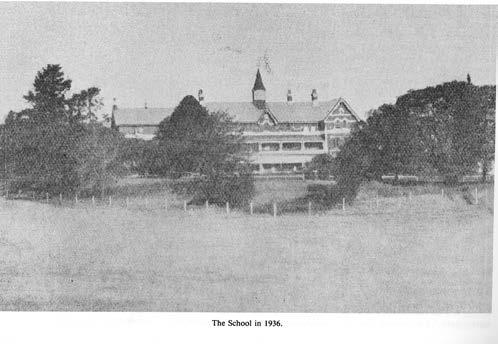
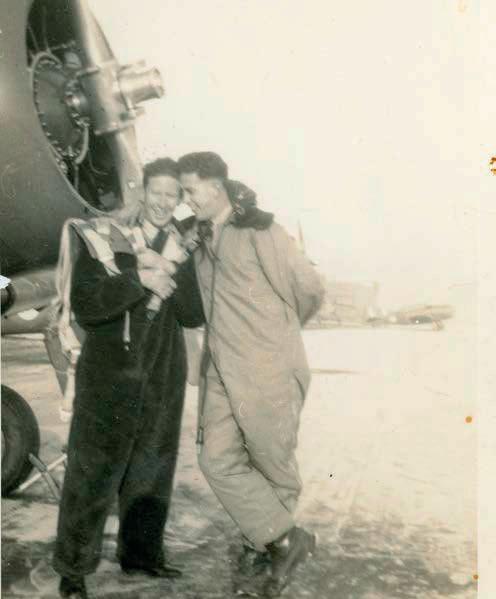


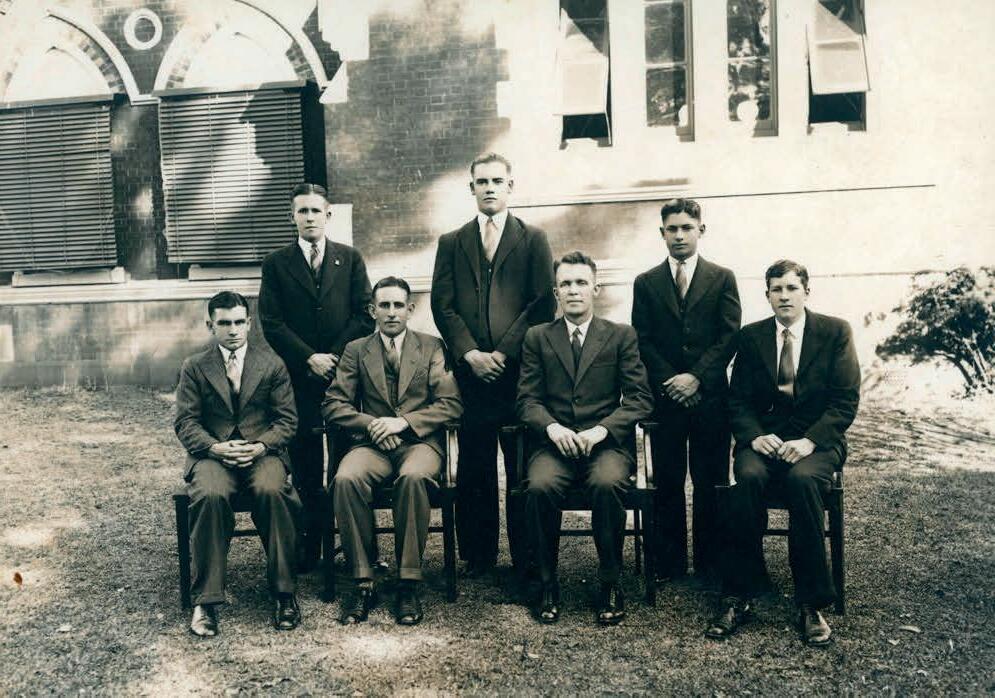


Chairman of the Board of Trustees: Mr Arnold Lavers (in his 4th year)
Headmaster: Mr ‘Harry’ Roberts (in his 3rd year)
Second Master: Mr Leadbeater retired as Second Master having held this position since 1910.
Senior Prefect: Alfred (‘Bill’) M. Brunckhorst (for the second successive year)
Dux of Year: Ronald M. Jones (4 th in the State in the Open Scholarship, having been 16 th in the State in the previous year)
Total School Enrolment: 182
Number of Dayboys: 107
Number of Boarders: 75
Staffing:
• Mr James G. Leadbeater retired after 34 years of unbroken service (commencing on staff with Headmaster Purves in 1903) Mr Leadbeater, originally from Victoria, held degrees in Arts and Law from the University of Melbourne. His first teaching appointment was Scotch College in Melbourne and later he went to Townsville Grammar School as Second Master. He held this position until 1903 when he left to accept a similar position at Toowoomba Grammar Scho ol. He continued in this position at TGS until the present year and his term of 34 years constituted a record for the School. At Toowoomba Grammar School Mr Leadbeater served under three Headmasters, Mr W.A. Purves, Mr G.P. Barbour, and Mr H.E. Roberts. It was during Mr Purves’s term as Headmaster that Mr Leadbeater trained a Grammar School Choir. Mr Leadbeater was a sound mathematician and a French scholar. He also contributed to the London ‘Mathematical Gazette’. At Mr Leadbeater’s final assembly Headmaster Roberts presented him with a travelling rug and a clock.
• Mr Cecil Garton Pearce taught at the School from 1937 to 1940. From 1950 to 1971 Mr Pearce was the Headmaster of The Southport School, Queensland. Of interest, Mr Pearce married Jessie Littleton Groom, the eldest daughter of Sir Littleton and Lady Groom (Groom House of Toowoomba Grammar School). The connection to Toowoomba Grammar School continued in that Jessie’s cousin was Mervyn Baynes (the Chairman of the School’s Board of Trustees, 19571973).
• The Headmaster, Mr Roberts, taught 31 periods per week.
Students:
• The School Prefects were Alfred ‘Bill’ Brunckhorst, H. Chisholm Bernays, Edwin Esler, Ronald Jones, Lynne ‘Darryl’ Schleehauf and Gillespie ‘Neil’ Orr.
• It was a time of outstanding academic success for the School. John C. ‘Bob’ Rivett won the T.J. Byrnes Medal for the top pass in the Junior Examination in the State He was the third TGS student to win this top of the State medal since its inception in 191 1. The other T.J. Byrnes Medallists for Toowoomba Grammar School were J.A.A. Pollock (1922) and L.H. Hopkins (1925). In 1944 G.R. Watson was also a T.J. Byrnes Medal recipient (see 1922). A photograph of J.C. ‘Bob’ Rivett is included in the 1939-year entry.
• Four Open Scholarships went to Toowoomba Grammar School boys in this year out of the 18 awarded for all schools in Queensland (Angus H.G. McIntyre was 3 rd in the State, Ronald M. Jones was 4th in the State, Douglas G. Garde 11th Open Scholarship and Ian D. Fowler won the 16th Open Scholarship).
• A.M. ‘Bill’ Brunckhorst was the Senior Prefect this year and in the preceding year. He was also Captain of four sports, namely Athletics, Cricket, Football ( Rugby) and Tennis (see ‘Students’ section in the 1938-year entry). ‘Bill’ was also selected for the GPS Combined XI Cricket team and the GPS Combined XV Rugby team (as Captain). Several photographs of ‘Bill’ Brunckhorst as captain of various sporting teams appear in this year’s entry
• John McGill (1935-1937) visited the School in 1992. At that time he recalled events of 1937. These included enjoying tea and biscuits and singsongs with the Headmaster’s wife, Mrs Barbour, on Sunday evenings before the boys went home. As a boarder, John McGill lived for three years in School House, which then held classrooms, Headmaster’s accommodation, boarding rooms and a Masters’ Common Room. The showers were cold; in winter the younger boys would get the ice out of the pipes before the older boys showered. Mr McGill said: “Where the science blocks are, there was a big shed which was used by the dayboys for their lunches. They would have to shift the cows out of the shed before they could eat.” Mr McGill also recalled the boys, particularly the boarders, visiting Mrs Fleming’s tuckshop at the corner of Margaret and Mary Street. The Masters kept an exercise book in the Common Room to write the names of boys who were in trouble. “If your name went into the book once, you had to come back and work. The job would be like picking rocks off the new bank above Barbour Oval. If it went into the book twice, you would have to work and get four cuts. If your name went into the book on three times, you would get four cuts on stage at Assembly. People would say that it was barbaric, but we lived tough and it was part of life.” Playing in the 1st XV rugby team, John McGill would “get out of school” on the days the team travelled to Brisbane by train for GPS fixtures. “We would leave at 2:30pm on Friday afternoon on the train to Brisbane, play in Brisbane on Saturday morning and catch the train on Saturday afternoon to be very late home.” In 1939, with the start of World War II, Mr McGill enlisted with the Army and served in Papua New Guinea. “ During the war I came across many Old Boys in different units and also a lot of fellows from other schools who I met on the football field.” Mr McGill was later to be a President of the Toowoomba Grammar School Old Boys’ A ssociation (in 1969-1970).
• Rev. H.R. ‘Bert’ Stevens (1936-1937) was to become the Headmaster of Penleigh and Essendon Grammar School in Melbourne from 1963 -1987. After his service with the RA AF in World War Two, he taught at Brisbane Boys’ College (BBC) and Albury Grammar School. Later he graduated with a Bachelor of Arts (Honours) from The University of Melbourne and a first class Honours Course in Theology at the Ormond Theological Hall. In 2012 Revd. Stevens attended a TGS Old Boys’ reunion in Melbourne and he was most impressive in leading the School war cry.
• Henry Day (1936-1937) in his correspondence to the Secretary of the TG S Old Boys’ Association in 2000 recalled: “I’ll never forget my first day at school. I had never worn shoes regularly and had no idea what they taught here. There were cold showers the first year and the weekly dose of Epsom salts. The swimming baths, as they were known then, were cleaned and filled once a year. They quickly became very dark green. I once milked the cows at school for a few days because the yardman was off sick. At the end of 1937 my schooldays were over and I was very sorry to be leaving school. Later, I took the third job I was offered (the magic words, when asking for a job, were that I went to TGS for two years).”
• Douglas Moreton (1935 -1937) was apprenticed for three years to become a pharmaceutical chemist. He passed his final examinations in 1941 and achieved the highest pass in Queensland. During this time, he lived in Brisbane and often used to ride his pushbike back and forth to Toowoomba to visit family and friends. After joining the RAAF in 1942 and training in Australia as a navigator and bomb aimer he was posted overseas to Great Britain and flew many missions for the RAF. In 1955 Doug bought a block of land at the corner of Margaret and Mary Streets (opposite the School grounds) and opened his own business, Moreton’s Pharmacy.
• This year, of the enrolment of 182 boys, 60 studied Latin, 91 studied French, while 82 studied no language other than English, and 72 studied Bookkeeping. Eight students studied German at three different standards and these German classes were offered by the Chemistry teacher (Mr Hans Hassler) before school.
Buildings:
• In May, the A.G. Stephens Memorial Library was opened (in ‘the big school room’, now known as Old Hall). The room commonly known as the "B" room was adorned with neat shelves on which were some eight hundred volumes of all descriptions. After the opening ceremony a bridge party was held. It was a great success.
• The old stables, grey and dusty with age and very decrepit, were demolished to create space for a modern recreation room for the boarders, including a billiard table and two table tennis tables.
Events:
• A hot-water system was installed in the Boarding House for the first time at a cost of 185 pounds
• The Headmaster, Mr Roberts, and Mrs Roberts celebrated the birth of their first child, a son named John (see 1941).
• Due to water restrictions in Toowoomba, it was necessary to carry water for the two match cricket wickets and the practice wickets. This was so irksome and inconvenient that it was decided to sink a bore. Boring operations yielded an excellent supply of water to be availa ble, but the erection of the windmill and plant were delayed until arrangements for its financing were complete.
• The School acknowledged the 25 year service of Mrs M. Fleming who kept the School "tuck shop" from the corner store (Margaret and Mary Streets) from the early 1910s until 1943. Old Boy and Past President of the OBA, Brisbane Branch, Ken Carmichael (1920 -1921), called to see Mrs Fleming during the Old Boys’ Weekend of 1959. He stated: “Though she is 82, she seems not to have grown old, and was ver y interested in receiving and giving news of Old Boys. I found Mrs Fleming very much the same in appearance as she had been 30 years ago when she used to dish out chester cakes and cider to me at the tuckshop (more often than not, I’m ashamed to admit, on credit).”
• Regarding Mrs Fleming, Old Boy ‘Llew’ Jenkin (1931) writing of her long after he had left the School said: I was counselled on her credit system. You could help yourself to a glass of cider from the keg, take a chester cake and then book it up (2d or 3d) in an old exercise book. In later years Mrs Fleming told me she had never been let down by a TGS boy. One even paid her after he came back from the War. Early in 1943 Mrs Fleming was forced to relinquish her shop due to ill-health (see 1943 in the ‘Events’ section)
• The School Museum holds various documents prepared by the Department of Public Instruction (Queensland) signed by the District Inspector. The Inspection of the School was made using the following criteria – Records, Government, Organisation, Methods, Proficiency and Progress of Pupils, Care of Grounds, School Games and Physical Exercises, General Condition and General Remarks. The District Inspector’s Report for 1937 included the comment: “There is a good tone in the school and the boys are manly and courteous in bearing, both in class and in the playground, and one is impressed with the earnest concentration and diligent application of pupils to their class work. Though discipline is firm, there is no unnecessary constraint, and pupils are fairly alert, friendly and reasonably responsive. Necessary class movements are performed with reasonable quietness and expedition. The school atmosphere and the dignified bearing and demeanour of the various masters, together with the influence of the Headmaster, are evidently developing quietly but surely the essential qualities of good citizenship.”
• The District Inspector acting for the Director of Education, Department of Public Instruction also commented in detail on the academic progress of the boys. The report stated, in part: “The standard of work is good in (form) VIb, very fair in VIa and Va, fair to very fair in IVa and barely fair in Vb and IVc.” The Inspection Report also reviewed the academic progress of students in each subject in the curriculum.
• Included in various annual School Magazines around this time were advertisements promoting the services or products of different companies. Pictured in this year’s entry is an advertisement for the City Taxi Cab Company which appeared in the School Magazine of this year. Of interest, note the telephone number of the business.
Co-curricular Activities:
• This was another very successful year for the School in the GPS sporting competition – first in Shooting, second place in Rugby, second in Swimming, second in Tennis and third in Athletics.
• In Athletics, the School’s team came 3 rd in the GPS competition, the first time since 1924. First place went to BGS and second was NC. Toowoomba Grammar School missed second place by only two points (see 1942). Further success in Athletics for the School was in the years 1942 (3 rd), 1943 (3rd), 1944 (2nd) and 1945 (1st).
• A.M. ’Bill’ Brunckhorst (Captain of Athletics in 1936 and 1937) won the Open 100 yards event at the GPS Track and Field Championships and later won the Open 440 yards event in which he broke the GPS Record with a run of 51.6 seconds (a record remaining for eight years). The Open 220 yards event was won comfortably by H. Chisholm Bernays (1935 -1938). The next TGS athlete to win the GPS Open 400 metre event was to be in 1965.
• In Cricket, the 1st XI achieved 3 wins, with 4 losses and one draw.
• TGS all-rounder, Ray ‘Roy’ Halford, scored 194 against Brisbane State High School. This score remains the second highest individual score by a 1 st XI TGS cricketer in GPS cricket history (the highest score was made by Jim Maddern, 219 not out in 1932). This was ‘Roy’ Halford’s second
successive century scored against BSHS (1936 and 1937). A photograph of Roy Halford in the 1 st XI Cricket team is included in this year’s entry (Roy is seated at left, next to Bill Brunckhorst –Senior Prefect for three years and Captain of four sports).
• Ray ‘Roy’ Halford also took five wickets in the losing 1 st XI game against Nudgee College (5 for 80) (see 1938) and had a remarkable bowling performance against CEGS (‘Churchie’) taking 7 wickets for 22 runs to win the game outright.
• Two other five wicket hauls in the GPS cricket season went to the Captain ‘Bill’ Brunckhorst (5 for 38) against TSS and John ‘Jack’ MacKay (5 for 30) against CEGS. TGS lost both these matches.
• In the GPS cricket match against IGS, ‘Roy’ Halford and G. James Stuart set a record fifth wicket partnership of 177 runs for the School. This record was to stand until 85 years later (see 2022).
• In Rugby, this year there had been a great incr ease in the numbers playing football (rugby). Last year there were only six teams playing football, while this year eight teams played regularly.
• The 1st XV finished 2nd in the GPS Rugby competition. The team lost to the eventual Premiers, Nudgee College (11-25), but defeated all other sides including convincing wins against IGS (35-3) and BBC (30-0). In the 1st XV games against both IGS and BBC, the TGS winger Lawrence Naumann scored four tries. A picture of Lawrence Naumann is included in the 1st XV Rugby team photograph in this year’s entry.
• ‘Bill’ Brunckhorst was appointed Captain of the 1st XV team and also the GPS Combined XV team which also included the TGS players Clement Stuart, Lawrence Naumann and Alexander Long.
• For the first time since 1930, when the Rugby Union game was revived in Toowoomba, Past Grammars Football Club won the Toowoomba Senior Premiership. Most of the credit for the Premiership victory was due to their Captain, Old Boy ‘Dooney’ Hayes, who played for the Australian XV against the Springboks in Brisbane and captained Queensland in its matches against the South Africans and NSW.
• In Swimming, the School’s team was placed 2nd in the GPS competition, only one and a half points from the Premiers, CEGS. The Captain of TGS Swimming in 1937 and 1938, H. Chisholm Bernays, won the Open 50 metre breast-stroke event, despite just recovering from illness only two days before the carnival. Another Open swimmer winning a GPS event was Douglas Moreton in the 400 metres freestyle.
• Kenneth Moreton broke the Junior Breaststroke record twice in the same afternoon. J ohn ‘Bob’ Rivett won the under 15 50 metres and Clement ‘Jack’ Stuart the under 16 200.
• CEGS won the carnival with 61½ points, TGS being second with 60. Most of the team returned in 1938 and the School’s hopes ran high, but an outbreak of polio cancelled the carnival
• The School’s 33rd annual Swimming Carnival was held at the City Baths in March.
• In Tennis, the 1st IV won all matches in the se ason except for Ipswich Grammar School, losing three rubbers to five. IGS was the eventual winner of the Tennis Premiership and TGS was placed second in the competition. The talented TGS team consisted of A.M. ‘Bill’ Brunckhorst as Captain, and Roy C. Halford, Harry Stark, and Ronald Jones and Trevor Strohfeldt dividing the fourth place.
• In Cadets, the shooting team had a very successful year, winning the Stephenson Cup and a photograph of the team is included in this year’s entry.
The TGS 1st XV defeated Downlands College, 14-5. The 2nd XV was defeated but the 3rd XV enjoyed a win.
Guest Speaker at the Speech Day & Prize -Giving Ceremony: The Honourable William Forgan Smith –Premier of Queensland
In The Toowoomba Chronicle newspaper a description of the Speech Day event was given: “In the shadows of the old School and its lovely trees, the 1937 Speech Day ceremony took place. There was a large gathering of parents and friends of the School on the lawn in front of the building, mellow with age, glorious in tradition. Following the ceremony, the gathering was afforded an opportunity of inspecting the School, its airy, well-equipped dormitories, its time-honoured hall, its library, its excellent science laboratories, its fine playing fields, and swimming baths.”
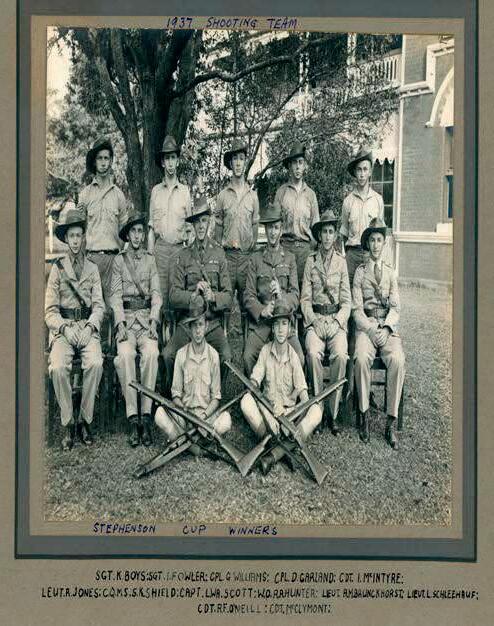



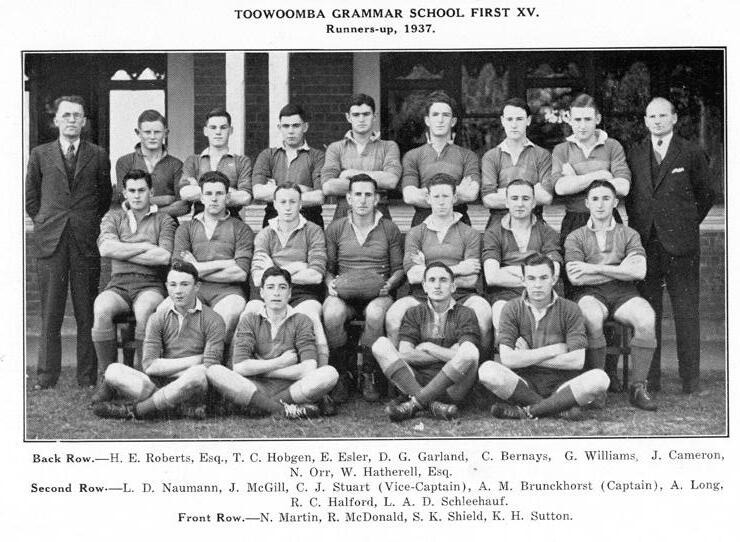
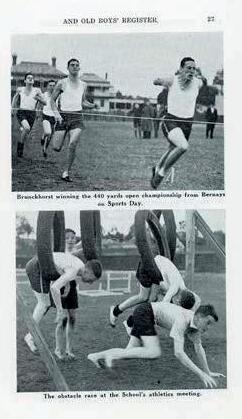

Chairman of the Board of Trustees: Mr Arnold Lavers (in his 5th year)
Headmaster: Mr ‘Harry’ Roberts (in his 4th year)
Second Master: Mr Leonard ‘Len’ Heenan was appointed as Second Master (1937-1955) and later to be Headmaster (1956-1961)
Senior Prefect: Alfred (‘Bill’) M. Brunckhorst (for the third successive year – see below)
Dux of Year: James D. Turnbull
Total School Enrolment: 183
Number of Dayboys: 96
Number of Boarders: 87
Staff:
• Teacher Mr W. Hatherell wrote to the Trustees requesting that they formally confer on him the title “Mathematical Master”. After discussion, the Trustees decided to write to Mr Hatherell advising him: “That the Board is unable to accede to his request but they understood the Headmaster had already recognised him as ‘Maths. A. Master’.”
Students:
• The School Prefects were Alfred ‘Bill’ Brunckhorst, Murray Cooke, Edwin Esler, Harry Stark, James Turnbull and George Williams. A photograph of the School Prefects is included in this year’s entry.
• Five Open Scholarships to the University of Queensland were won – George H. Copeman (fifth in the State), Harry L. Stark (7th in the State), James D. Turnbull (8th in the State), James ‘Jim’ R. Bailey (9th in the State) and Alex W.J. Dick (13th in the State).
• With the five Open University Scholarships won this year and the four in 1937 and three in 1936, Toowoomba Grammar School had won twelve out of the fifty -four University Scholarships awarded to the whole of the State.
• The Senior Prefect for a record period of three years, 1936, 1937 and 1938, Alfred M. (‘Bill’) Brunckhorst, was a legendary sportsman for the School. In 1936, with still another two years to spend at the School, he was already Captain of four sports (including the 1936 GPS Cricket Premiership team and also the 1st XI team in 1937). ‘Bill’ also captained the 1st Rugby XV in 19361937, the 1st Tennis IV in 1936-1937 and the 1936-1937 Athletics team ‘Bill’ later studied Medicine and became an eye specialist based in Toowoomba. According to Old Bo y John Thompson, at the School at this time (1937-1939), Bill Brunckhorst had left school and then came back to do ‘Senior’ and he was 20 years of age. When he turned 21 he could not play in the GPS competition because he was classed as a man.
• James ‘Jim’ D. Turnbull was Dux of the School. He entered the University of Queensland in 1939 to commence his engineering studies. War interrupted his university studies when he entered the Air Force to serve as a navigator on light bombers in New Guinea. After returning from the war he resumed his studies and graduated as a Civil Engineer. Jim was substantially involved in many Queensland dam projects, particularly the Hinze Dam, Wivenhoe Dam and the Fitzroy Barrage at Rockhampton.
• H. Chisholm Bernays (1934-1938) was Captain of the School’s Swimming team in 1937 and also in this year and won a GPS record for the Open breaststroke. In the intra-school swimming sports he swam very well indeed, beating records in the 100 yards freestyle, backstroke, and breaststroke. He was also a member of the Athletics team (Senior GPS Champion for the 220 yards), a member of the 1st XV for two years and a School Prefect in 1937 and 1938.
• Edwin John ‘Ted’ Esler (1934 -1938) was one of the School’s most accomplished Old Boys. This year ‘Ted’ won the Stumm Prize for Languages and topped the State in Fren ch. He was also Captain of Rugby and Athletics. He enlisted in the Army in 1940 and was taken prisoner with the fall of Singapore in 1942. He used his gift for languages to learn J apanese during the war. After the war, he returned to Australia and studied medicine, and from 1972 until he retired in 1986 he was Medical Superintendent at the Mater Mothers’ Hospital (see 1945).
• ‘Doug’ C. Hurst (1937-1938) with the rank of Squadron Leader led the fly-past over Sydney for the Royal Visit in 1954 and later received the Distinguished Flying Cross from The Queen at a Government House investiture.
Buildings:
• The Board of Trustees considered the matter of the old Gymnasium not being used. Some Trustees thought that it might be suitable for a garage for the Masters’ cars.
• The recently constructed Recreation Room was converted into a dormitory.
Events:
• The School Magazine of June 1938 expressed serious gloom regarding world events. “With militant nations ranged on each other's borders like seething masses of pernicious poison, ready to boil over on each other, the first half of 1938 seems to have been enshrouded in gloom, and ANZAC Day was just a scene in the drama. The most disturbing utterance seems to have been the oft repeated suggestion that the Great War to end war has failed in its object.”
• The only entrance to the School was at the corner of Herries and Mary Streets. The dayboys rode their bikes and hung them up on hooks in a shed near the loca tion of the current Headmaster’s residence (which was not built at this time).
• The Headmaster requested the Board of Trustees to purchase and erect a new windmill, storage tank and reticulating water for the cricket oval. This was approved.
• The official turning on of the water supply to the oval was performed on Saturday , October 8th by Alderman A. A. Griffiths - himself an Old Boy; and President of the Old Boys’ Association in 1923. At this ceremony Mr. A. E. Lavers (Chairman), on behalf of the Trustees, t hanked the Old Boys, the Toowoomba Foundry, the Toowoomba Rugby Union, and all others who had cooperated in bringing about the very fine improvement to the grounds of the School.
• The School undertook both newspaper and radio advertising to promote enrolme nts. A one-half page advertisement in The Queensland Country Life cost the School fourteen pounds.
• The Trustees decided to ask Headmaster Roberts what was considered necessary in the matter of improvements to the milking yard and shed.
• In February as a precautionary measure against the spread of infantile paralysis (‘polio’) the Queensland Government stated that children who had visited southern States or children from those States who had come to Queensland would not be allowed to attend Queensland schools for three weeks.
• Owing to infantile paralysis in Queensland, the boarders had only one picture outing this year.
• An interesting cricket game was held during the year with the Past Grammar Football Club competing against the Past Gramm ar Cricketers Club. It was unexpected that the footballers defeated the cricketers, 189-187 runs.
• Old Boys distinguished themselves as leaders in interstate sport in 1937 -1938. Tom Allen (19271929) captained the Queensland Cricket Sheffield Shield team; E dwin ‘Dooney’ S. Hayes (19251928) captained the Queensland Rugby Union XV; and Mick Madsen (1914-1916) led the Queensland Rugby League XIII.
Co-curricular Activities:
• In Athletics, every member of the School’s athletics team was affected by influenza p rior to the GPS Combined School Sports and many were unable to compete.
• In Cricket, the 1st XI finished with 3 wins, 4 losses and an unknown result.
• The 1st XI was defeated by BBC (75-90). In this cricket match, TGS bowler John Mackay took five wickets for 41. In the match against Gregory Terrace (TGS 95 d GT 47) he took six wickets for 25 runs.
• The Senior Prefect, Alfred (‘Bill’) Brunckhorst, made a century (102 retired) in the cricket match against the Old Boys.
• In the School Magazine of this year (and others around the time) there was a section titled ‘Criticism of Team’. In very direct expression, totally unacceptable in today’s times, were comments such as (student named withheld here) -” ... His batting has not improved, I fancy, to his adopting a negative attitude to the playable ball, and also to his habit of not moving up to the ball. He does not put into his bowling and fielding the sting of which he is capable.”
• In Cross Country, the School’s Cross Country race was introduced over a course designed at this time and continued for at least three decades. The boys ran down the school drive, turned left into Herries Street, ran up across Mackenzie and Cohoe Streets into Tourist Road and up to Picnic Point to the first checkpoint. From there they ran into the bush and down towards the Log Cabin Service Station (which has long since gone but which was a haven for motorists as a venue to allow their vehicles’ motors to cool off on the long haul up the Range) before heading up the old disused Toll Bar Road. This led into James Street which the runners followed into Cohoe Street. They ran north into Margaret Street and then down to what is now Barbour Oval for the check -in at the finish (see 1967). A photograph of the cross country runners is included in this year’s entry.
• In Rugby, the School fielded eight Rugby teams. This season the School was 4th in the GPS premiership list; Church of England Grammar School, Nudgee and Southport defeated the TGS 1 st XV.
• In a curtain-raiser to the All Blacks v. Australia Test match, The Southport School defeated TGS , 29 points to 13. Apparently, the game was not very exciting to watch.
• In Shooting, the School’s shooting team came second in the GPS Shooting Competition, competing for the Stephenson’s Cup. The team was only two points behind the winning team representing Brisbane Grammar School.
• In Swimming, the GPS Swimming Championships were cancelled this year due to an outbreak of infantile paralysis (‘polio’).
• In Tennis, the School’s 1st IV won the GPS Tennis Premiership (captained by Harry Stark and coached by Mr L.T. Heenan). Also, in the team were the Strohfeldt brothers, Brian and Trevor, and Ian Parker. Brian Strohfeldt (1937-1940) was Captain of Tennis in 1939 and 1940. He went on to become Open Champion of Queensland and in 1950 defeated two members of the Davis Cup squad in the Australian Hardcourt Championships (Ken McGregor and George Worthington) prior to their departure for the Davis Cup. It was a remarkable time of success in the School’s Tennis with GPS Premierships also being won in 1939, 1940, 1947, 1949, 1952 and ties in 1948 and 1957.
• The 1st IV remained undefeated during the season and their winning scores were: IGS (5 rubbers to 3); BGS (6 rubbers to 2); TSS (7 rubbers to 1); CEGS (6 rubbers to 2); BBC (5 rubbers to 3); NC (5 rubbers to 3) and BSHS (won on a forfeit).
• The TGS Tennis Premiership winning team was a young one – the eldest of the four players was 16 and the remaining three were aged 15. A photograph of the team is included in this year’s entry.
• The School fielded five tennis teams this year.
• In Cadets, towards the end of the year an instructional camp for Officers and N COs was held at Enoggera. Four of the officers and six NCOs from the TGS Cadet Corps were present and, during the ten days' camp, were instructed in military tactics of all kinds. Colonel Harvey inspected the Cadets at the ANZAC Day Parade and a photograph of this occasion is included in this year’s entry.
• In Debating, the Old Boys’ Debating team performed with considerable success in the Downs Debating Union’s fixtures.
Downlands College was successful in defeating the Toowoomba Grammar School 1 st XV, 6-12. The 2nd XV defeated Downlands 8-3.
Guest Speaker at the Speech Day & Prize -Giving Ceremony: The Honourable Frank A. Cooper – QLD Minister for Public Instruction




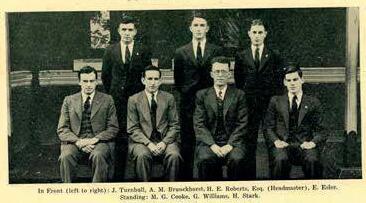
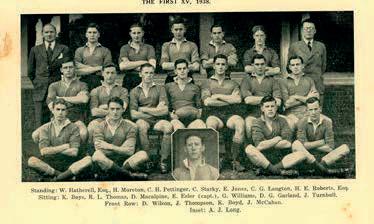
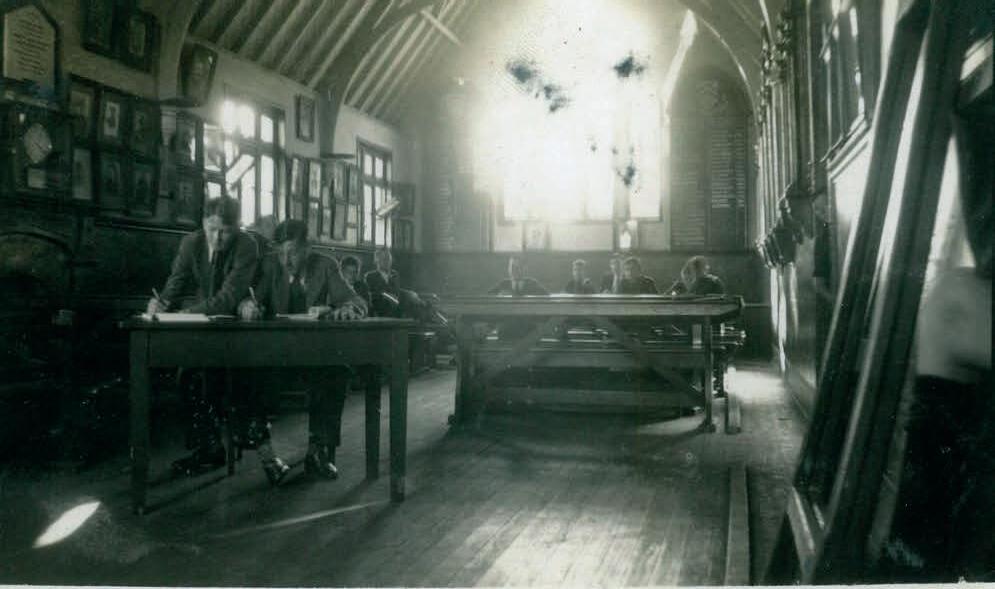


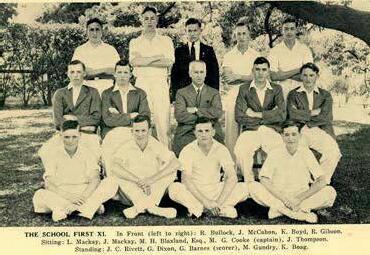
Chairman of the Board of Trustees: Mr Arnold Lavers (in his 6th year)
Headmaster: Mr ‘Harry’ Roberts (in his 5th year)
Second Master: Mr ‘Len’ T. Heenan (in his 2nd year)
Senior Prefect: George S. Williams (and in 1940)
Dux of Year: John C. ‘Bob’ Rivett (achieving 1st place in the State in the Senior Examination) , a School Prefect and with Colours in Cricket, Tennis (GPS Premiership team) and Athletics
Total School Enrolment: 210 (an overall record enrolment to this time)
Number of Dayboys: 99
Number of Boarders: 111 (it was only at this time in the School’s history that the School saw boarders exceeding dayboys which generally continued until 1995). Exceptions were noted in 1942, 1944, 1945 and 1946 for example.
Staffing:
Mr Edgar G. ’Blue’ White joined the teaching staff in May to take the position of Senior English Master and he resigned in November 1958. He gave tremendous service for almost twenty years, coaching football and cricket and organising activities such as debating, public speaking, library, magazine and the Dramatic Society which he made very prominent for eleven years (from 1948 -1958) with annual public performances. He also commanded the School’s Cadet Unit for a number of years (from 1945-1958) and coached the shooting team with pronounced success.
Mr White was on active service in 1940, fighting at the Battle of Milne Bay with the 25 th Battalion and returned to the School in 1945. In 1956 he was appointed Senior Master (Deputy Headmaster) and acted as Headmaster for the first term of that year due to Headmaster Heenan’s absence through illness. Mr White resigned in November 1958 to accept the Headmastership of Toowoomba Church of England Boys’ School, later to be known as ‘Toowoomba Prep’ and still later Toowoomba Anglican College and Prep School (TACAPS) and Toowoomba Anglican School (TAS). This vacancy emerged due to the retirement of Mr Norman ‘Boss’ Connal. It was a position he was to fill with distinction from 1959 until his retirement in 1974.
Mr White had two sons, David Gerald White (not a TGS Old Boy) and Brian Peter White (TGS, 1955 -1958). David Gerald White died under tragic circumstances and a subject prize, the David Gerald White Memorial Prize for Year 11 French, was introduced in 1995.
Students:
• The School Prefects were George Williams, Noel Gundry, Eric Jones, John Mackay, Robert Miller, and John ‘Bob’ Rivett.
• Two students won Open Scholarships to the University of Queensland, including the School’s Dux, John C. ’Bob’ Rivett being placed first in the State’s Senior Public Examination The other Open University Scholarship winner was Eric A. Jones (6th in Queensland)
• ‘Bob’ Rivett, (1936-1939 and Dux of the Year) in his later career was elected Chairman of the Brisbane Division of the Institution of Engineers. ‘Bob’ was Dux of his form each year and won the T.J. Byrnes Memorial Medal for the best pass in the State in Junior in 1937. A photograph of J.C. ‘Bob’ Rivett is included in this year’s entry. ‘Bob’ Rivett’s father, Ronald Rupert Rivett, was also an Old Boy of the School, (1909-1911).
• Clive Gesling (1938-1939) attended a TGS Old Boys’ reunion in Canberra in September 2012. In June of 2012 he was one of 31 Veterans who were official Australian delegates to the unveiling by Queen Elizabeth II of the Bomber Command Memorial in London. Mr Gesling was a barrister and then joined the Commonwealth Public Service and moved to Canberra. He was awarded the Medal of the Order of Australia (OAM) in 1979.
• Of the 111 boarders were new boys - two from Fiji, two from Thursday Island, one from Papua, four from north of Townsville, three from Mackay, three from west of Rockhampton, two from Gladstone, while there was the usual healthy representation from Brisbane and the Downs, west to Longreach and Tambo and south to Goondiwindi.
• Mr Bill B. Robinson (1937-1939) joined the School’s Board of Trustees in 1973.
• Robert ‘Bob’ A. Miller (1935 -1939) was later appointed as President of the Australian Medical Association (AMA) Queensland Branch from 1965-1966.
• John D. Thompson (1937 -1939) was a building contractor after leaving school and in 2006 he received an Order of Australia (OAM) Medal for his contribution to veterans’ golf. For John’s 90 th birthday he received a green jacket signed personally by ‘Tiger’ Woods from his grandson Cameron (at TGS 1990-1992), son of Old Boy Peter Thompson (1965 -1966), who had an international career in the construction of golf courses and tournament preparation (see the ‘Students’ section in the 1992-year entry). John Thompson’s account of his school days is described in the ‘General’ section of this year’s entry below.
Events:
• The outbreak of World War Two (1939 -45). On 3 September 1939 Prime Minister Robert Gordon Menzies announced the beginning of Australia's involvement in the Second World War on every national and commercial radio station in Australia. Almost a million Australians, both men and women, served in the Second World War.
• Old Boy Dr Herbert Copeman (1937 -1941) recounted the occasion when the Headmaster , ‘Boss’ Roberts, announced to the boys that Britain was at war: “I remember Boss Roberts coming into Big Dorm at 9:30am on 3 September to tell us that Britain h ad declared war on Nazi Germany, and thinking ‘Damn! It will be over before I am old en ough to be in it’. Little did I realise at the time that I would spend nearly four years in it and that several of my classmates would be killed.”
• 125 Old Boys lost their lives in World War Two. Statistics relating to the involvement of the Old Boys in World War Two are documented in the 1945-year entry in the ‘Events’ section.
• The boarders went to ‘the pictures’ twice during Term One: once to see "Pygmalion" and the second time to see "Kate Plus Ten” and “Crackerjack”.
• A Bell and Howell talking picture apparatus, the gift of an anonymous Old Boy, was officially handed over to the School in the presence of a large gathering of friends, parents and boys at the School on Saturday night, October 14th. The function took place in the Big Schoolroom (now Old Hall) and a photograph of the occasion is included in this year’s entry. A programme of ‘talkies’ was shown. The machine was regarded as a great asset to the School, educatio nally and as a means of entertainment. (See ‘Events’ 1943).
• The boys attended two dances with The Glennie School girls. First, shortly before midwinter Glennie were guests of TGS, and the School Magazine reported: “we had a delightful party at the School” . Later in the year, Glennie entertained the boys at a dance at Glennie,” and we enjoyed ourselves immensely”.
• The Old Boys' Day was seen as a landmark in the cricket history of the School as the Old Boys fielded seven teams and the event required the old gully wicket to be in use.
• The Old Boys’ Association’s annual dinner was regarded as the best so far. Over 120 guests attended the dinner at the Court House Hotel.
• The Old Boys’ Association's Old Boys' XI took part in the Great Public Schools' Old Boys Association's cricket premiership (knock -out) competition for the Brisbane Boys' College Old Collegians' Association's Cup. This cup and the premiership had been held by the Toowoomba Grammar School for two successive seasons but this year TGS was defeated by Brisbane Grammar School’s Old Boys in the final.
• In swimming, the Old Boys competed in the Great Public Schools' (GPS) Old Boys' carnival, sponsored by the C.E.G.S Old Boys’ Association. TGS won handsomely and held the Foster Cup for the first time.
• Interest was taken in the Grammar Old Boys' debating team which competed in the Downs Debating Union's series for the "Chronicle" Cup.
• The Past Grammar Football (Rugby) Club experienced its most successful season in its history.
Co-curricular Activities:
• There were only four sports played at the School during the year – athletics, cricket, rugby (football) and tennis.
• In Athletics, the School Magazine wrote that the 1939 athletics team was the best in the history of the School to date. The Championship was won by BBC and TGS was placed 4 th .
• In the internal School Sports competition, in the obstacle race the athletes encountered difficulties with a tank as illustrated in a photograph included in this year’s entry.
• In Cricket, the 1st XI team was placed 3rd in the GPS competition with five wins and three losses to BBC, NC and BGS.
• The Captain of the 1st XI Cricket team, John A. (‘Jack’) Mackay, took 5 or more wickets on five occasions in the GPS cricket season - 6 wickets for 24 runs against The Southport School, 5 for 24 against CEGS, 5 for 43 against BBC, 6 for 45 against BGS, and 7 for 28 against BSHS. He was one of the few bowlers to take more than 40 wickets in a GPS season on two occasions (see 1946). ‘Jack’ Mackay was a right arm fast bowler and captained the TGS 1st XI side in 1939 and 1940.
• Another Mackay (unrelated) in the same cricket team, Lewis ‘Lew’ Mackay, scored 148 runs (runout) against The Southport School at the Exhibition Grounds in 1939. In the same match against Southport, ‘Bob’ Rivett scored 113 (in a match-winning 251 runs second-wicket partnership with ‘Lew’ Mackay). In this memorable cricket match against TSS, TGS made 411 runs and declared the innings at seven wickets down. TSS replied in the first innings with a score of 72 runs.
• The score of 411 runs against TSS represented the highest ever 1 st XI innings total for TGS in the School’s history.
• The 1st XI suffered a major defeat by NC with their team declaring at 8 for 286 and winning by145 runs.
• In Cross Country, 170 boys participated in the School’s Cross Country event in April. The School Magazine recorded: “It was a grand field, and the spirit was fine. too, particularly as the main goal seemed to be the Headmaster's Shield for the Teams Championship. Down the drive the field thundered; up the difficult Herries Street hill the thundering faded considerably, some having already thundered almost their last! The field had spread out considerably along the Tourist Road, Copeman and Fraser being well ahead. The rugged descent to Goulding's was far more difficult this year, owing to recent heavy rains, which had caused the lantana to flourish and even obscure certain tracks. This gave the touch of glorious uncertainty to the race; so uncertain and maze-like were the tracks that positions changed considerably downhill. Although the "walk" up the Toll Bar was not very pleasant, no lorries passed to distract our peace, and good pace was made down Margaret Street to the Oval. Fraser won comfortably from Copeman.”
• In Rugby (then known as Football) there were 150 boys who regularly played the game and the School fielded nine teams. The football (rugby) season opened with mist and rain and regular practice was impossible for some time.
• The School’s XV met Sydney Grammar School XV in the curtain raiser to the Toowoomba v. New South Wales match in May.
• The 1st XV was placed 4th in the GPS Rugby competition enjoying some fine wins. The team was defeated by CEGS 47 to nil (the CEGS team was to win the Premiership ), NC (0-16) and TSS (3-6).
• When John Thompson (1937 -1939) was 92 years old he was interviewed by the then School’s Director of Rugby, Mr ‘Jono’ Farrell, about his experience playing 1 st XV Rugby. Mr Thompson recalled that there were only two ovals at the School at that time – the one facing Margaret and Mary Street (now known as Barbour Oval) and the one by St Vincent’s Hospital. He also described the trips to Brisbane playing GPS sport. “We used to catch a train on Friday afternoon, stay at the YMCA in Edward Street for the night and play the game on Saturday and return by train late Saturday afternoon. I think it took six hours each way by train from Toowoomba to Brisbane.” (see the ‘Events’ section below in this year’s entry about Mr Thompson’s addition al comments about his schooldays at TGS in 1937-1939).
• In Swimming, the School’s Swimming team was placed 2nd in the GPS competition. CEGS won the Swimming Premiership and its team broke seven records.
• In Tennis, the 1st IV won the GPS Tennis Premiership for the second year in succession . A photograph of the premiership winning team is included in this year’s entry. The team was captained by Brian Strohfeldt this year (and again in 1940). Two members of the 1 st XI cricket team were also in the team, ‘Lew’ Mackay and ‘Bob’ Rivett. Also in the team was Ian Parker. The Premiership winning team was coached by Mr L.T. Heenan.
• The Captain of the 1st IV, Brian Strohfeldt, was arguably the best tennis player for his age in Queensland at the time. Certainly he was regarded as one of the finest tennis players to have ever attended Toowoomba Grammar School. This year he won 97 games with the loss of only seven.
• The GPS Premiership Tennis team was undefeated during the year. The winning results were: IGS (TGS 5 rubbers to 3), BBC (6 rubbers to 2), NC (5 rubbers to 3), GT (8 rubbers to nil), BSHS (8 rubbers to nil), TSS (6 rubbers to 2), BGS (7 rubbers to 1), and CEGS (4 rubbers all, 11 sets to 9).
• The School lost only one tennis match in the past three years.
• In Cadets, owing to the large number of new cadets, the parades for first term consisted mainly of marching and drill, with and without arms, in preparation for the ANZAC Day Parade. On April 25th the Corps appeared in its new uniform. A khaki shirt and tie replaced the blue shirt previously worn, and the members of the first two platoons were now to wear long khaki trousers. On the morning of ANZAC Day the Corps marched to the Mothers' Memorial and took part in the service of remembrance. In the afternoo n the Corps attended the service at the Show Grounds, and favourable comments were made by many of the visitors present about the discipline and the performance of the Corps.
• There was no Cadet Officers and NCOs camp at Enoggera in December.
Downlands Competition:
TGS won only one of the nine football (rugby) games played against Downlands College. The 1 st XV was defeated 0-12.
General:
In the School Museum is an audio recording of an interview between the former Master Mr John K. Winn (as School Historian) and Old Boy John D. Thompson (at school 1937 -1939). Mr Thompson was 85 years of age when he was interviewed by Mr Winn and his anecdotes were highly amusing. A sample follows:
“I was Thompson 1 (that is Thompson number one) as my brothers also came here. We had our Assemblies in the big old classroom (now Old Hall). We had Assemblies here every Friday and they would read out ‘Thompson 1, Saturday; Thompson 1, Saturday’. I would have to come back and work on Saturday for detention.
When I first arrived, the Headmaster was ‘Boss’ Roberts. We played up but he was fair. Once I made a stink bomb (rotten egg gas) out of iron filings and sulphuric acid and put it in an ink well. The Master, Tibby Martin, said who was responsible for this outrage? I owned up and he sent me to the Headmaster Boss Roberts. ‘Bend over Thompson, 8 wacks on the backside’. Mr Winn then asked Mr Thompson did this do him any harm? Mr Thompson replied: ‘ Hell no; I finished here as a bloody gentleman’. My word I’ve got happy memories of my time here.’
I got my colours in my first year as a squirt in cricket and football (which was almost unheard of at the time), all due to the sportsman Duncan Thompson who was my uncle who taught me to play sport.
In those days we used to get the train to Brisbane, stay at the YMCA in Edward Street and there were only about four or five schools in the GPS competition – I remember Nudgee, BBC, State High and Southport. Mr ‘Lou’ Bill Hatherell was my rugby coach. He would say to me: ‘Thompson, go off home and see my wife and see if you can borrow two pound from her and my coat and tell her that I have a meeting this afternoon down at the Post Office Hotel. So he and old ‘Pud’ Heenan would then get into their old car and drive to Margaret Street and drink rum. Next day ‘Lou’ would be back at the School in the classroom and his face
would be red and he would say to the boys: ‘You may revise, there will be no screaming, I want complete quietness in the class’. He was a great fella, old Lou.
I wasn’t a scholar, I was more interested in playing cricket and football. I was more interested in playing sport than learning bloody sums and Algebra.
When I did senior I was only doing four subjects so I didn’t come to school until 10:30 or 11:00 o’clock. I had a sweet heart in my Uncle Duncan’s shop and I used to go and see her before school.
My algebra teacher ‘Lou’ (Hatherell) would say to me: ‘Thompson, out here, and he would give me an envelope to go to the bank to find out his balance. So I would ride my bike down to the National Bank and present the envelope to the teller and the teller would say – oh not again. As I was coming back up the driveway from the bank one day, the Boss (the Headmaster) was standing outside so I hid behind the tree so ‘Harry’ couldn’t see me. And ‘Lou’ would say to me: ‘Why have you been so long?’ and I replied: ‘Well Sir, I was hiding from the Headmaster’. And Sir said back to me: ‘Good boy’.
At Mrs Fleming’s tuckshop on the corner of Margaret and Mary Streets you could kee p an account. In those days we used to buy a donut for three pennies, the next day they were a day old so you could buy them for one penny and she would put how much we owed in the book and we would pay every Friday.
Mr Thompson referred to the classrooms in the main heritage building (School House). He recalled: Mr Tibby Martin had his classroom here. Next door was Lou Hatherell for Algebra; Joe Scott was opposite, teaching Geography and Bookkeeping; the ‘Boss’ was upstairs. He taught Latin and other langu ages. The Chemistry Lab was out the back with Mr Hassler. Pud Heenan had the Physics lab. And the baths (school outdoor swimming pool) was out the back. There was no gymnasium and upstairs in the main building was the dormitory for the boarders. Above the main entrance was the Boss’s Office and his quarters. The sick bay was run by ‘the Hawk’ (the Matron). There were only two sports ovals then, the Main Oval (corner of Margaret and Mary Streets) and the other oval along St. Vincent’s hospital.”
President of the Old Boys’ Association: Lt-Col. Charles Fortescue (for one year) and also in 1922, 1930 and 1934
Guest Speaker at the Speech Day & Prize -Giving Ceremony: The Honourable F.W. Bulcock – QLD Minister for Agriculture and Stock
Speech Day was held under the shade of the stout old camphor laurel tree that had given protection to so many similar gatherings throughout the years. About 500 people, including parents and students, attended the Speech Day Ceremony.
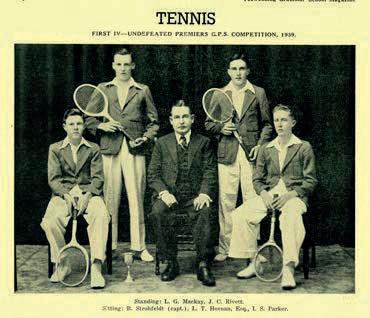

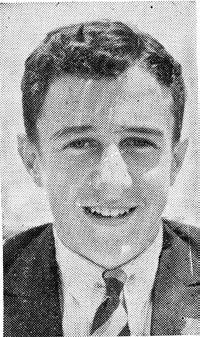
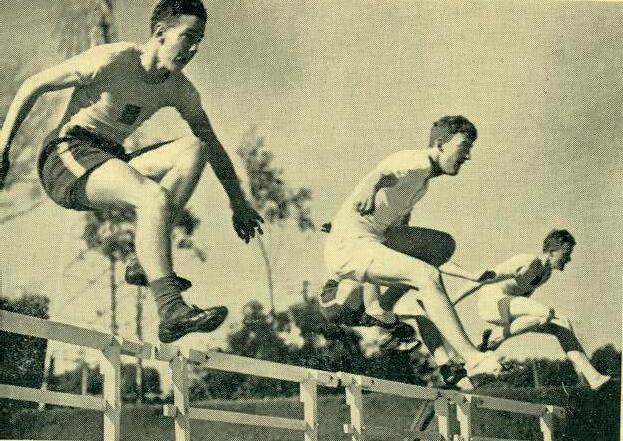

Chairman of the Board of Trustees: Mr A. Lavers (in his 7th year)
Trustees: Arnold E. Lavers (Chairman). Brig.-Gen. James C. Robertson. Stanley Hammond, Edwin C. Bernays, Hector G. Jones, Frank E. Lenihan, Cliff E. J. Richards. Secretary: Thomas H. Ludgate. Mr Lenihan resigned from the Board this year due to ill-health.
Headmaster: Mr ‘Harry’ Roberts (in his 6th year)
Second Master: Mr ‘Len’ T. Heenan (in his 3rd year)
Senior Prefect: George S. Williams (for the 2nd year)
Dux of Year: Donald A.C. Lang
Total School Enrolment: 248
Number of Dayboys: 108
Number of Boarders: 140
Staffing:
• The teaching staff this year comprised the Headmaster, M. Blaxland, H. Hassler, W. Hatherell, L. Heenan, T. Martin, C. Pearce, E. Wetherell and E. White.
• During the war years the Headmaster experienced great difficulty in maintaining an appropriate teaching staff. At one stage three of his most experienced teachers were on Military Leave – Pilot Officer ‘Len’ Heenan, Major L.W.A. Scott and Captain E.G. White. To fill the vacancies, older retired teachers and a number of qualified women were employed.
• Teacher Mr. L. W. A. Scott left the School at this time to take up a captaincy in the Garrison Battalion, of which Lieutenant Colone l C. Fortescue, D.S.O., M.C., until recently the President of the Old Boys' Association, was in command.
• A long-serving teacher and Senior Chemistry Master, Mr Hans Hassler, on staff since 1918, died suddenly during the mid-winter holidays of 1940. Perhaps somewhat fittingly, the vacancy on the staff caused by Mr Hassler’s sudden death was filled for a short period by his son, Hans (‘Pete’) Hassler Jnr., an Old Boy of the School (1925 -1926). A Science graduate from the University of Queensland, ‘Pete’ Hassler Jnr was awarded the DFC during World War Two as a Pilot -Officer. Hans Hassler Snr was instrumental in the development and design of the Jubilee Chemical Laboratory which was built in 1925 and which is now the School Museum. Mr Hans Hassler was born in Hamburg, Germany, in 1871. He came to Australia in 1890 and attended Adelaide University. He was the author of ‘Text Book in Junior Chemistry’. In addition to Chemistry he was in charge of German and Junior French; he was well informed in the literature of three languages. At the commencement of Term Three a memorial service was conducted at the School.
Students:
• The School Prefects were George Williams, Douglas Chapman, James ‘Jack’ Hornsby, John Mackay, Ian Parker, Brian Strohfeldt and Russell Taylor.
• Three students were awarded the University Scholarship. They were Donald A.C. Lang (7 th in the State), Jack R.C. Hornsby (9th in the State), and Donald J. Tuffley (11th in the State).
• David H. Rowbotham (1939 -1940) became a celebrated literary figure, journalist, poet, author and lecturer. He was a senior tutor in English at the University of Queensland from 1965 -1969 but then returned to full-time journalism. David Rowbotham was a respected journalist with the Brisbane Courier Mail for 38 years, including being the newspaper’s literary editor, and had an extraordinary number of books published. He was the guest speaker at the Old Boys’ Dinner (Brisbane Branch) in 1971. David Rowbotham visited the School in 2003 and presented the W.M. Dent Library with a complete set of his works. A copy of his poem, The School, which he wrote in 1995, is reproduced on the dedication page of J.K. Winn’s book on the history of the School, Still Playing the Game – the School’s History 1875-2000. David Rowbotham is acknowledged on the Old Boys’ Wall of Achievement and again visited the School in 1995 and 2003 He was also honoured on the Australia Day Honours List as a Member of the Order of Australia (AM) and was awarded the 1991 American Biographical Institute Commemorative Medal of Honour.
• Ian S. Parker (1937-1940) was a Squadron Leader, Flight Lieutenant and Wing Commander with the Royal Australian Airforce and served in Korea. He became a Royal Australian Air Force Air Vice-Marshal in 1976-1979. On promotion to Air Vice -Marshal, he was appointed Chief of Air Force Personnel and is acknowledged on the Old Boys’ Wall of Achievement.
• John ‘Jack’ Mackay (1935-1940) captained the School’s 1 st XI cricket team for the second successive year. He was a member of the 1st XI for four years (1937-1940) and Old Boy Ivan Board in his authorship of the history of Cricket at the School has acknowledged Mackay as the finest opening bowler to have ever represented the School. He took 42 wickets in 1938 and 43 in 1939. He holds the record for the greatest haul of wickets in TGS cricket history. For some time Jack Mackay coached fast bowling at what was then known as ‘Boys’ Prep School’ (‘Toowoomba Prep’ later to be known as the Toowoomba Anglican Church and Preparatory School, TACAPS and, later still, Toowoomba Anglican School).
• The Captain of Tennis (in both 1939 and 1940), Brian Strohfeldt, won his eight singles matches in the GPS competition by 96 games to six. His tennis career would have been exceptional had not the war intervened (see below in the ‘Co-Curricular’ (Tennis) section of this year’s entry).
• Donald A.C. Lang (1936-1940) and Dux of the School this year studied Medicine but the outbreak of the war interrupted his studies and he joined the Australian Navy. After returning to finish his degree, he worked in Brisbane, the United Kingdom and then Canada where he completed further training in anaesthetics. After moving back to Australia he settled in Cessnock, NSW where, as a dedicated country doctor, he served the community for 54 years.
• Donald ‘Don’ J. Tuffley (1939 -1940) won a University of Queensland Open Scholarship to the University of Queensland, having come 11 th in the State. After completing his Medical Degree, Don departed from Australia in 1950 and worked his passage to England as a Ship’s Doctor. Following further study and examinations, he was granted his Fellowship of the Royal College of Surgeons of England and Fellowship of the Royal Australasian College of Surgeons. After further study in the USA he returned to Australia and became a highly respected Orthopaedic Surge on.
Buildings:
• A number of Army huts (initially surrounded by barbed-wire) were erected on the School grounds fronting Margaret Street, where the tennis courts are now located, to accommodate an Australian Women’s Army Service (AWAS) camp. The AWAS was a non-medical women’s service established during the Second World War to provide personnel to fill various roles including administration, driving, catering, signals and intelligence. After the war, and following prolonged negotiations, two of these three huts were eventually purchased by the School.
• During the war, the boarding accommodation and all other facilities of the School were being taxed to the absolute limit. In order to accommodate the large boarder numbers, boys were housed in converted private homes such as Mr and Mrs Hatherell’s home and ‘ Somerset’ in Herries Street and ‘Beresford’, a property Mr Roberts had secured in Margaret Street.
Events:
• Boys from the School dug, under staff supervision, slit trenches in the vicinity of today’s Pavilion. Air-raid shelters also paralleled Margaret Street. Regular air-raid drills were held, blackouts were enforced and safety equipment such as buckets of sand, water and stirrup -pumps became part of School life. Shortages existed in the most common products, whilst rationing became a way of life.
• In July the Headmaster established a fund-raising committee comprising representatives from the Old Boys’ Association, the teaching staff and a Ladies’ Committee (presided over by the Headmaster’s wife, Hilda). The goal was to raise sufficient money to purchase and donate two Red Cross Military Ambulance Units. This was achieved with one donation being made at the School’s Speech Day of 1940 and the second donation presented on the athletics sports day 1941. Fund-raising activities included a series of entertainments using the School’s “talking picture” apparatus, chain afternoon teas, school plays, a “jitterbug” competition, numerous sporting events and a monster fete and barbecue.
• The fete and barbecue (involving the roasting of a 600 lb. bullock) was held in October. One thousand people attended the official opening of the fete and barbe cue. Photographs of these events are included in this year’s entry.
• In the School Magazine of June 1940, it was written: “As we know the past, so shall we build the future. Let us look for the sunshine beyond the clouds. The storm will pass. While Britain holds the sea no invading force can seriously threaten her; the arsenals of the world are open to her. The efforts of the Allies will overcome the first rushes of the infuriated beasts.”
• The School’s ANZAC Day Service held in the Assembly Hall (now Old Hall) was even more significant this year as many Old Boys were again fighting overseas.
• In Cricket, the School’s 1 st XI won four games (BSHS, GT, BGS and TSS) and was defeated by NC CEGS, and IGS. The BBC game was a draw. A photograph of the 1st XI is included in this year’s entry. In the 1st XI match against TSS (played at the GT oval) the School won by one run on the first innings. TGS fast bowler William ‘Bill’ Broadfoot took 5 wickets for 5 runs against GT and 6 for 34 against NC. In the 1st XI match against BGS, TGS bowler John ‘Jack’ Mackay took 6 for 23.
• In the 1st XI game against BSHS, the initial TGS Captain, Brian Strohfeldt, (later Jack Mackay), scored 94 not out.
• In the 1st XI match against CEGS (‘Churchie’), TGS bowler Doug Hurst took a ‘hat trick’. This was the first ‘hat-trick’ recorded by a TGS 1st XI bowler in the School’s history (see 1950).
• In Cricket see John (Jack) Mackay in the ‘Students’ section of this year’s entry.
• The decade of the 1940’s was to record that the School won 54.4% of 1 st XI GPS Cricket games played (see 1930, 1950 and 1960).
• In Rugby, the School’s 1st XV Rugby team (captained by George S. Williams in 1939 and 1940 and Captain of Athletics, 1940) was one of the best for some considerable time and was placed 3 rd in the GPS Rugby competition. The team won six matches and lost two, being beaten by Nudgee College (the eventual Premiers, 10 -16) and Brisbane Grammar School (8 -11). The team scored a total of 207 points in the season (with 56 points against) – the only 1st XV TGS team ever to score more than 200 points in a GPS season until 2015 (243 points – see 2015). The extremely impressive winning scores of the 1 st XV in the GPS competition included: BBC (46 -3), and in the game the TGS Captain, George Williams, scored 5 tries, GT (24 -0), IGS (50-3), TSS (30-0), CEGS (‘Churchie’) (28-18) and BSHS (11-5).
• In the annual match between the Old Boys and the current students, the Old Boys could field only two teams due to many involved in the War. The Old Boys won both games; 1 st XV (Old Boys 15current 14) and 2nd XV (Old Boys 8 - current 5).
• In Swimming, the School’s team came 4 th in the GPS swimming competition.
• In Tennis, the GPS Tennis Premiership was won by the School for the third successive year. In that three-year period the School’s record stood thus: 23 matches played, 23 matches won; while it lost only one match in the last four years.
• This year’s undefeated Premiership winning Tennis team was captained once again by Brian Strohfeldt and coached by Mr L.T. Heenan. The other members of the team were Ian Parker, Douglas Hurst and Alan Harris.
• Brian Strohfeldt was regarded as the School’s most successful tennis player to date. After leaving school he went on to play open tennis for Queensland before the war years intervened, thus preventing him from leaving his mark on Australian tennis (see Brian Strohfeldt in the ‘Students’ section of this year’s entry and also 1941).
• The 1st IV winning results for the tennis season were: IGS (TGS 8 rubbers to nil), NC (5 -3), BBC (71), CEGS (6-2), GT (8-nil), BSHS (7-1), TSS (7-1) and BGS (7-1).
• In Cadets, the Cadet Corps attended the usual services and parades on ANZAC Day. Lieutenant E.G. White replaced Captain L.W.A. Scott (involved in the war effort) as Officer Commanding the Cadet Corps.
• During the year the School Cadets marched in several patriotic processions through the streets of Toowoomba. As most of the processions took place at night, only about half the company was able to participate. In September the whole corps marched in the Rotary Clubs’ drive for patriotic funds.
• The School’s Cadets’ small arms and light machine gun training came to a sudden end when the School’s service rifles and machine guns were commandeered by the Army. The usual GPS shooting competition and the Cadets’ range rifle practice were suspended for the duration of the War.
• In Music, the Choir gained second place in their event at the Toowoomba Eisteddfod.
Downlands Competition:
• In Cricket, the School’s 1st XI defeated Downlands College. TGS declared at 224 runs (with B rian Strohfeldt scoring 108 n.o.) and DC scored 142.
• In Football (Rugby), the 1st XV TGS (12) defeated DC (6). Of the ten games of rugby played, TGS won four.
President of the Old Boys’ Association: Mr J.A. Tait (for one year)
Guest Speaker at the Speech Day & Prize-Giving Ceremony: His Excellency The Governor, Sir Leslie Orme Wilson
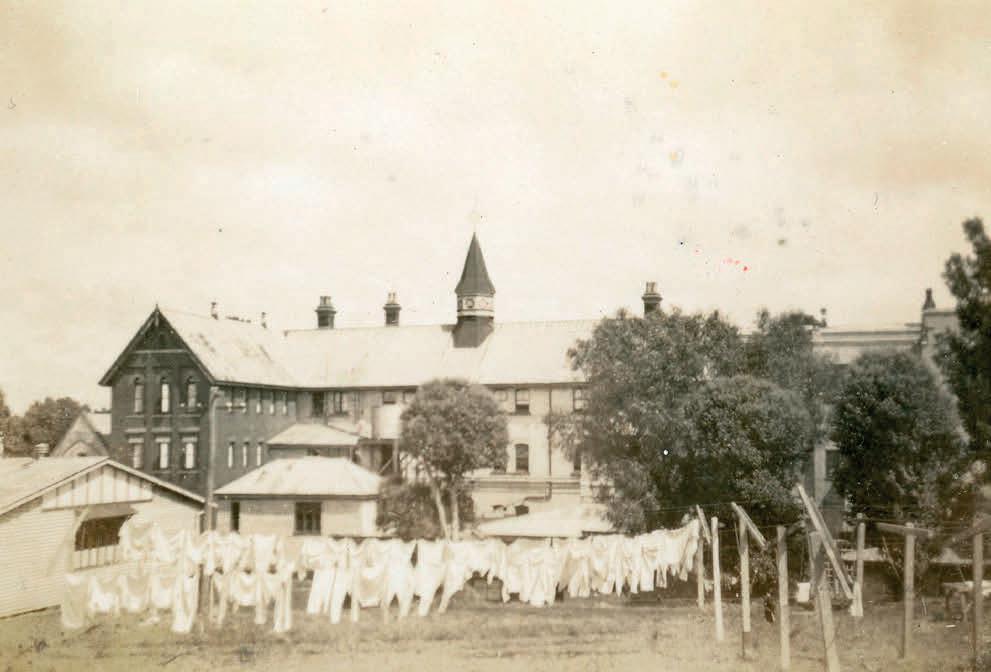
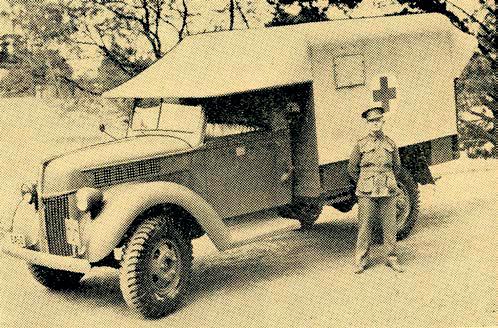
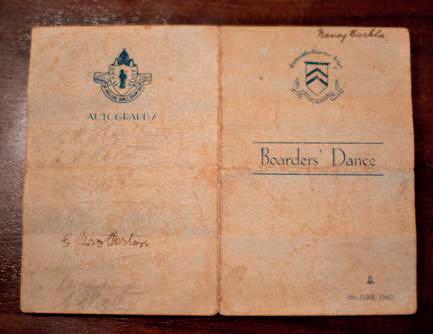
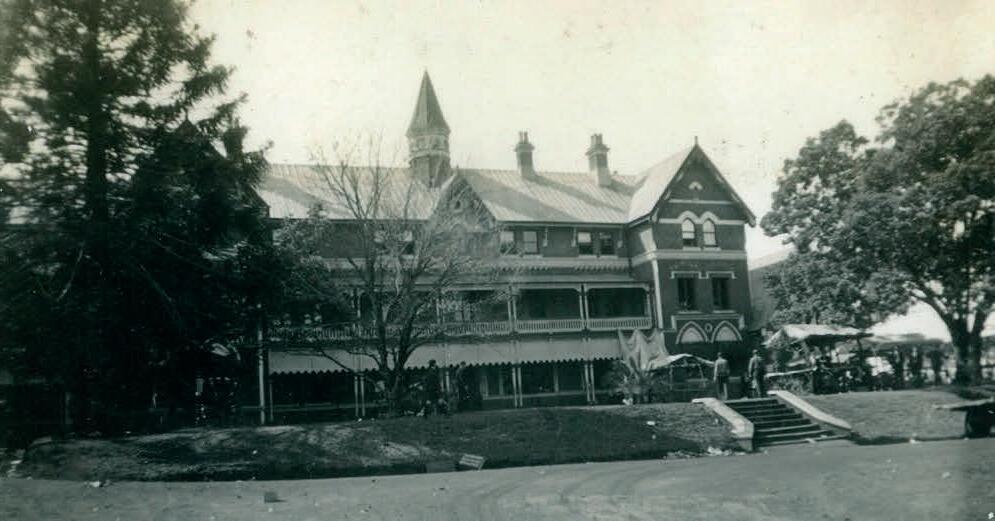
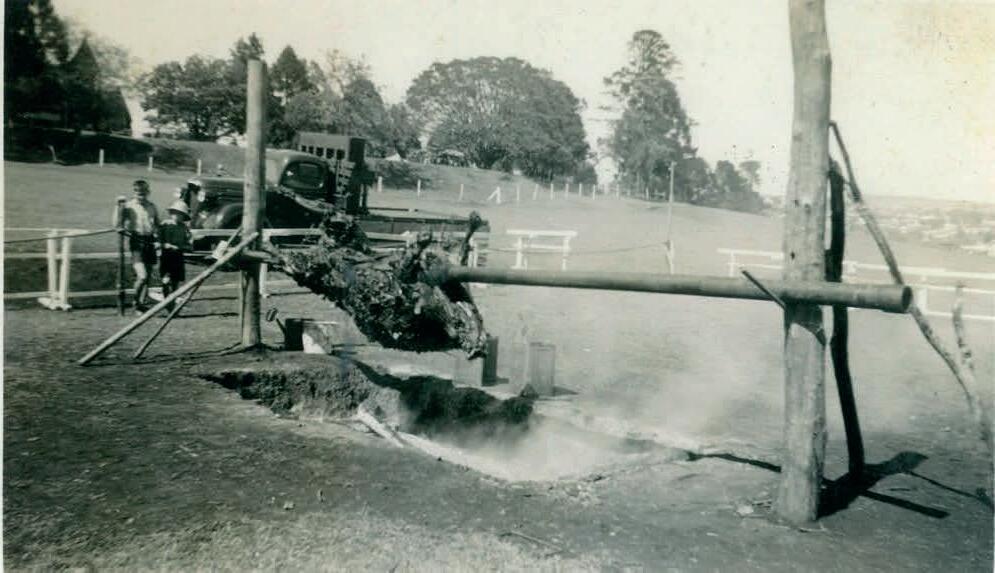
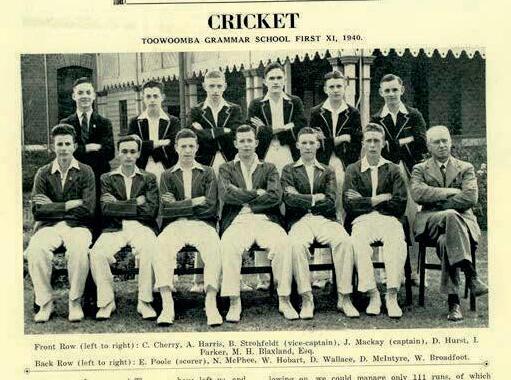
Chairman of the Board of Trustees: Mr A. Lavers (in his 8th year)
Trustees: Mr Jack Demaine replaced Mr Frank Lenihan as a Trustee.
Headmaster: Mr ‘Harry’ Roberts (in his 7th year).
Second Master: Mr ‘Len’ T. Heenan (in his 4th year)
Senior Prefect: Donald J. Wallace (see ‘Students’ below and ‘Events’ 1945) and Brian Strohfeldt
Dux of Year: Herbert A. Copeman, who was invited to teach at the School in the following year on a shortterm contract (see below).
Total School Enrolment: 279
Number of Dayboys: 129
Number of Boarders: 150
Staffing:
• Mr Wilton Lennon (‘Len’) Poulsen commenced as a Master and retired 34 years later in 1974 . In his years at the School, Mr Poulsen taught mainly Mathematics and Physics. The boys’ perception of his ‘wizardry’ with Mathematics gave rise to his nickname of ‘Yogi’, a person who practised mystical eastern rites. Mr Poulsen’s recollections of the 1940s at TGS follow in the ‘Events’ section of this year’s entry.
• Dux of the year ‘Herb’ Copeman (1937-1941) recalled in 1989 some of the qualities of his teachers at the time… “H.E. Roberts was a magnificent Headmaster and athletics coach and later became a good friend and correspondent until weeks before his death. ‘Pud’ Heenan was an excellent teacher of Maths II, Physics and French – though rumour had it that he learnt his pronunciati on from French sailors in the pubs near the Brisbane wharves (which were mostly near the University and the Gardens in the city in those pre-Story bridge and pre-St Lucia days). I suspect this was true because I had difficulty making myself understood in France during the Second Front invasion of Europe, even though I could think in French! Len Heenan taught me to understand another culture which was and is still vibrant. Mr Roberts with his excellent Latin teaching gave me a deep interest in the ancient history of Greece and Rome as well as in the foundations of our legal system and the English and French languages. Mr Scott had given me a junior grounding in French. He learned his pronunciation in France during the First World War and was an able Cadet Corps Commander until he managed to get to the Second World War. Lou Hatherell was an excellent Maths I teacher with a definite streak of humanity and an appreciation of the fear that some boys may have of getting hurt in football. He had a particularly fine way of turning a prank against him into one against the perpetrator…. ‘Jick’ Hassler wi th his heavy German accent was the man who
influenced my future career most by giving me a love for all things chemical (and hence physiological) and starting me on the road to endocrinology and research into arterial disease. …But the man I liked most was ‘Bluey’ (E.G.) White. He taught me to love the English language and literature would change throughout my lifetime – and indeed he was right. In mid-January 1942 I had a phone call from Mr Roberts asking me to take Mr Heenan’s classes in French, Physics and Maths II for the first six weeks of the year because ‘Pud’ had been very il l and would be recuperating. Thus I had free board and five pounds per we ek for my first job and decided I liked teaching.” (Source – letter to the Editor of Balliwanga, TGS, written by Herbert Copeman dated 02/05/89).
• Herbert Copeman (above), as a pilot during World War II, survived six crash landings. He saw 47 pilots get killed during the war whilst he continued to survive. Dr Copeman later was a consultant physician with a special interest in endocrinology and metabolic disease at the Royal Brisbane Hospital. He then moved to Western Australia to become post-graduate co-ordinator in the University of Western Australia at the Royal Perth Hospital. Dr Copeman wrote in his correspondence to the School: “I was lucky to have a good education at a fine school and then lucky to survive a ghastly war”
• In 2003 Herbert Copeman (above) was one of only 27 Australian veterans and war widows invited to travel to England to attend the official commemorative ceremony for the dedication of the Australian War Memorial in London on Remembrance Day. The Mission Party was led by the Minister for Veterans’ Affairs. Another of the 27 VIPs was TGS Old Boy, Mr Jack Doyle (1932 -1934: see ‘Students’ 1934).
Students:
• The School Prefects were Donald Wallace, Herbert Copeman, Clive Cherry, Ronald Culliford, Alan Harris, Donald McIntyre, Edward Smith and Thomas Vallis. The Senior Prefect, Donald Wallace (1938-1941), was also Captain of the 1st XI cricket team, Captain of the 1st XV rugby team, member of the 1941 1st IV tennis team and swimming team and a Lieutenant in the Cadet Unit. Donald enlisted in the Royal Australian Air (RAAF) straight after leaving school and his plane was shot down and he was killed in World War Two. The war medals of Donald Wallace ar e displayed in the School Museum and a photograph of him, and his medals, are included in this year’s entry.
• Ronald Culliford, another School Prefect, also lost his life in active service in 1945 during the War.
• Two Open Scholarships were achieved: Herbert A. Copeman (placed 5th in the State) and D ‘Don’ S. McIntyre (placed 18th in the State).
• There was a small primary segment in the School.
• Edward R. Smith (1939-1941) was a Royal Military College, Duntroon, graduate and served in World War II and later in Japan with the British Commonwealth Occupation Force from 1947 to 1949. After various overseas and domestic postings he was appointed Deputy Commander HQ ANZUK Support Group Singapore in 1973. Brigadier Smith is acknowledged on the Old Boys’ Wall of Achievement.
• Brian Strohfeldt (1937-1941) initially was appointed Senior Prefect for this year but unfortunately for the School “he left to take up a position in town”. Brian Strohfeldt went on to defeat two Davis Cup tennis players in the Australian Hardcourt Championships in 1950, ranking him in the top eight in Australia. Brian’s successor as the School’s Senior Prefect was Donald Wallace (see above).
• Alan Harris (1939-1941) won the Junior Tennis Championship of the State. This year he was undefeated in all GPS 1 st IV singles games.
• Thomas ‘Tom’ Vallis (1938-1941) became a great stalwart of the Brisbane Branch of the TGS Old Boys’ Association (OBA) and was its President from 1985 -1989. He donated much of his schooldays’ memorabilia to the School’s Archives and each year the School presents the ‘Tom Vallis Prize for Mathematics’ at the Speech Day and Prize Giving Ceremony. Tom was made a TGS Old Boys’ Association Honorary Life Member in 1997.
• W.’Bill’ Barrell (1940-1941) was a meteor jet fighter instructor in the RAF and received the Air Force Medal from the Queen Mother at Buckingham Palace in 1954.
• Don Weir (1941) was honoured with the award of an MBE for services in Korea. After school, Don went as a cadet to Duntroon Military College and was later posted to the Army of Occupation in Japan.
• By rearranging several rooms at his house, teacher Mr Hatherell was able to take four or five more boarders in residence. Written correspondence by a member of the public to the School in April 1941 indicated that Mr and Mrs Hatherell were renting two houses adjoining each other and in these two houses approximately forty boarders were housed. The letter referred to the bathroom accommodation being limited to a number of cold showers, all being outside. The letter continued: “It must be admitted that in the Toowoomba Grammar School itself, conditions were much the same until a very few years ago.” The letter concluded by stating: “We urge the Trustees to press on with speed in enlarging the school in order to have all the boarders under the immediate care and supervision of the Headmaster.”
Buildings:
• At this time the whole School was enclosed by a paling fence. There was only one vehicle entrance, at the Mary and Herries Street corner. Later, the removal of the fence created a more pleasing appearance of the school grounds.
• A new dormitory wing was added on the eastern side of the main School building. Mr John Keeble Winn, former long-serving teacher and School Historian, in his book on t he history of the School 1875-2000 Still Playing The Game rather directly described this addition as “an architectural disaster” (page 218). The middle floor became the Headmaster’s residence; the ground floor was essentially an extension of the dining room; and the top floor included several dormitories and a bathroom.
• The swimming pool was described as being green and slimy due to a lack of filtration and was enclosed by a corrugated iron fence.
• Water was obtained from two windmills on the School’s property which were still present in the mid 1950s.
• Barbour Oval (but not yet named Barbour Oval) was the main oval. Kent Oval (or the ‘top oval’ as it was known), was the only other oval on the School’s grounds.
Events:
• The Headmaster, Mr Roberts, and Mrs Roberts celebrated the birth of their second son, Peter. The Headmaster acceded to the Senior Prefect’s request to grant a half -day holiday to celebrate the occasion.
• The School now had a piano standing on the dais of the Big School Room (now Old Hall).
• At the end of the first term, two boys contracted mumps which spread rapidly through the boarding house and those suffering included members of the 1 st XV football (rugby) team. Four TGS players were unable to play in the 1 st XV match against Gregory Terrace and this number grew to six players missing the next week’s 1 st XV encounter against Nudgee.
• A School Concert was held in the Town Hall in September to raise money for a war equipment fund. The programme opened with an overture by the School Orchestra and the Cho ir sang ‘On the Road to Mandalay’. A play ‘The Man in the Bowler Hat’ was also performed together with various soloists and duets.
• Great interest was shown when sailors of the detachment of the American Fleet visited Toowoomba.
• A Dramatic Society was once again established.
• The School Fete (a Military Carnival held in aid of the War Equipment Fund) was held in October. Thousands of people attended the event which included stalls, side shows, displays, the Municipal Band, a Cadet Guard of Honour, vaudeville entertainers, a shooting gallery, boxing and wrestling marquees, and a pet parade. A highlight of the Military Carnival was a mock battle under military supervision which included bren gun carriers and smoke bombs. The fete was described as a lively, colourful and happy scene. Such fund-raising by the School assisted in the School being able to present to military authorities a second military ambulance.
• A blackout test took place on Sunday night, September 28th. From the top oval the whole town could be seen, and the boys detected several very feeble lights. The blackout served as an excuse for no homework to some boys.
• In the School Magazine a list was recorded of Old Boys who had so far made the supreme sacrifice in the war. Also listed were the names of Old Boys under various categories – ‘Missing’, ‘Wounded’, ‘Prisoner of War’ and ‘War Honour’.
• The June edition of the School Magazine of this year reported that: “ We had the holidays for the Show, as usual, and the School seemed to patronise it rather well. Grammar School boys seemed to be almost as numerous as American soldiers.”
• The School heard of military honours being awarded to Old Boy J.E.G. Martin (1917 -1921) - the first Old Boy to be decorated in the Second World War. Lieutenant -Colonel Martin received the order of the British Empire (Military Division). He was the Commander of an Australian Imperial Force (AIF) Battalion which took part in the attack on Bardia. Bardia was the site of the first battle fought by the Australian troops during World War Two. It was a fortress -village on the Libyan Coast, at the time held by about 40,000 Italian soldiers.
• Mr W. ‘Len’ Poulsen commenced teaching at TGS this year and retired in 1974 after 34 years’ service. He remembers his first year at TGS (1941) wit h the School being enclosed by a paling fence, its later removal providing a more pleasing appearance of the grounds. There was only one vehicle entrance to the School, at the Mary and Herries Streets corner but there were several pedestrian entrances via tracks appearing from gaps in the paling fence. Water was obtained from two windmills. Kent Oval was initially known as the Top Oval. Further recollections by Mr Poulsen included that in 1941 the Big Schoo l Room (now known as Old Hall) had the only heating in the School and that there was no office and hence no office staff. At that time all clerical and accounting work was done by chartered accountants in the town.
Co-curricular Activities:
• In 1941, the School’s involvement in the GPS Association sporting competition was restricted to the 1st XI, 1st XV, 1st IV, Athletics and Swimming teams. Other Cricket and Football teams participated in local fixtures. The main reason for this was the slow rail transport and this required overnight stays at opponent schools.
• On the local scene, it was common practice for the coaches to play with, and captain, their cricket teams. The Headmaster, Mr Roberts, captained a team.
• In Athletics, the School came 5th in Brisbane, but were only seven points behind the second placed team.
• In Cricket, in his written report to the School’s Board of Trustees, Headmaster Roberts wrote about a cricket fixture against Downlands College. The Headmaster wrote: “The first four cricket teams had a feast of runs against Downlands today, scoring almost a thousand runs for twentysix wickets in two and a half hours play” (see below)
• The 1st XI Cricket team had a mixed season. In a losing game against Brisbane Grammar School, TGS Cricket Captain (and Senior Prefect and also Captain of Rugby) , Donald J. Wallace took 5 wickets for 39 runs. In a winning game against The Southport School (played at BGS), TGS batsman William T. Broadfoot, who made an erratic 75, at one stage had hit 12 fours in a score of 50.
• The overall cricket season results for the 1st XI were 4 wins and 4 losses.
• In Cross Country, in the annual intra-School Cross Country run, last year’s champion, Herbert A. Copeman, once again won the event.
• In Rugby (Football) the 1st XV came fourth in the GPS competition. The rugby games won were against Gregory Terrace (35-9), BGS (11-10), BSHS (19-4) and BBC (22-11) and the team drew with IGS (3-3).
• In Swimming, the annual carnival was held in the City Baths in February.
• In Tennis, see Brian Strohfeldt and Alan Harris in the ‘Students’ section of this year’s entry.
• In Cadets, the enrolment this year was 203. The Commanding Officer, Lieutenant E.G. White, received a commission in the 25 th Battalion and had to relinquish his office with the School Cadet Unit. Captain Hatherell, who some years ago commanded the corps, consented to resume his former command.
• Cadet training for the half year was made more interesting by lecture periods on such topics as tank hunting and general anti-tank methods, platoon in defence, concealment and camouflage.
• A photograph of the School’s cadet corps marching in the ANZAC Day Parade is included in this year’s entry.
• The School’s Cadet Corps performed creditably in the welcoming procession to the Toowoomba Show and, on ANZAC Day, both in the mo rning at the Mothers’ Memorial and in the afternoon at the Show Grounds.
• The Attack on Pearl Harbor was a surprise military strike by the Imperial Japanese Navy Air Service upon the United States against the naval base at Pearl Harbor in Honolulu, Territory of Hawaii, on Sunday morning, December 7, 1941. Following the Declaration of War on Japan by the U.S.A. on December 8, 1941, the other Axis nations of Germany and Italy declared war on the United States. Congress responded, formally declaring a state of war with Germany in this Joint Resolution on December 11, 1941.
• In Drama, a Dramatic Society was formed. The productions in September included The Man in the Bowler Hat and The Invisible Duke. The next dramatic productions were in 1946.
• In Cricket, the School’s 1st XI was defeated but the School won the three other matches. In the 1st XI game, the Downlands College batsmen had to make two runs to win with a few balls to go –and did. The TGS 2nd XI scored 7 for 267 and defeated DC, 66. The TGS 3 rd XI scored 4 for 255 and defeated DC, 68. Similarly the TGS 4 th XI had a comfortable win, 9 for 246, defeating DC, 62 (see the ‘Co-Curricular’ section above).
• In Rugby, ten games were played and TGS won 8, drew 1 and lost 1. The games were played on Monday afternoon, 4th August, and the 1st XV won in a close game. Boarders were allowed to go to the pictures that night as a reward for the team’s victory, and there were many cases of neglected homework next morning.
• In Rugby (Football), the School Magazine of June 1941 (pages 47-52) contained a series of articles on ‘Getting Fit for Rugby Football’ or ‘Take It and Like It’ written by legendary TGS Coach, W.J. (‘King’) Renwick. In the foreword to these articles, Mr Alan Dunn, President of the Toowoomba Rugby Union, wrote:
“I have no hesitation in commending to the close attention of all footballers and all would -be footballers these very fine football articles by Mr. W. J. Renwick. I do not suppose there is a man in Australia better qualified to write of training footballers than "King," whose prowess as a coach and whose acid tongue are known to generations of Queensland footballers and generations of Toowoomba Grammar School boys. As a matter of fact he is now coaching at the School boys whose fathers he put through their football paces 30 and more years ago. "King" Renwick had a remarkable football career. The details will serve to emphasise that he has the best possible knowledge of his subject. He first played for Toowoomba in 1902 and kept his place in a very strong team until 1906 in which year he went to New Zealand. In 1904 he represented Queensland as stand-off half. In New Zealand, at Hawke's Bay, he played for the Province in 1907 and 1908in the former year as full-back and in the latter as half-back. The famous 1905 All Blacks had then just returned from their triumphant tour of Britain, and "King" encountered most of them on New Zealand Rugby fields. He captained the Napier and Hastings fifteens, among the most powerful teams in the Dominion. He returned to Toowoomba in 1909 and resumed his place in the Toowoomba representative team. In 1915 he was still playing r epresentative football. In Toowoomba and New Zealand he took part in over 100 first-class representative matches.”
General:
In the Editorial of the School Magazine, November 1941 it was written:
“Out of the wilderness of a world gone mad, comes the voice of Hope with that immortal phrase. that cry, that shout on her divine lips, "V . . . - for Victory ". From beneath the grinding, torturing heel of a Nazi giant it rings out still, faint, but yet defiant. A thousand Nazi curses have failed to sti fle it, and a million more will do no better; it is the battle-cry of free nations, the slogan of oppressed countries, the ideal of neutral empires: all are embodied in that one phrase, ‘V .. - for Victory.' Never before has any slogan been so widespread; starting in Europe, it flashes, across to America per medium of mysterious short -wave stations, which transmitted the now famous three dots and a dash night and day - and once there, its forcefulness. its simplicity, its very fervour was conveyed from the heart-broken people of Europe to those ever-sympathetic people of America.”
President of the Old Boys’ Association: Mr Alexander Provan (for four years)
Guest Speaker at the Speech Day & Prize -Giving Ceremony: The Honourable Frank A. Cooper – QLD State Treasurer
At the Speech Day and Prize-Giving Ceremony, the Headmaster (Mr. H. E. Roberts, M.A.) handed over to Brigadier J. Craven, D.C.M., V.D. representing the military authorities, a Wiles mobile cooker, valued at £500. The cooker was bought with portion of the money in the Toowoomba Grammar School War Equipment Fund. Brigadier Craven expressed pleasure at being present, representing Northern Command, to receive the fine presentation. He wanted to express their gratitude to the Toowoomba Grammar School War Equipment Committee and the parents and friends of the boys who had made the presentation possible. They realised that this was their third gift, as they had previously given two Military Ambulances. The Brigadier said that the mobile cooker would feed 500 to 600 men and would eliminate a lot of their administrative difficulties. They would be able to feed men more quickly and more easily.
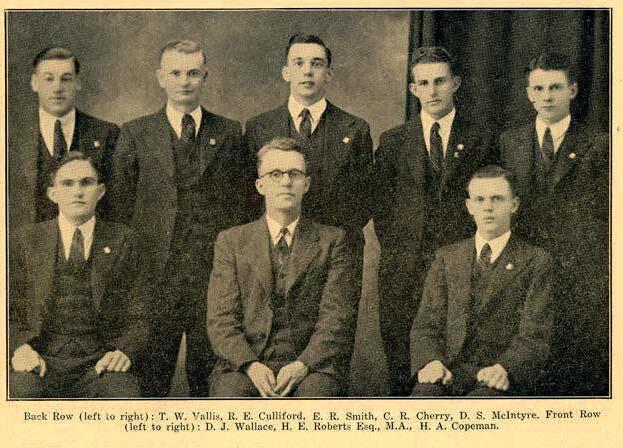
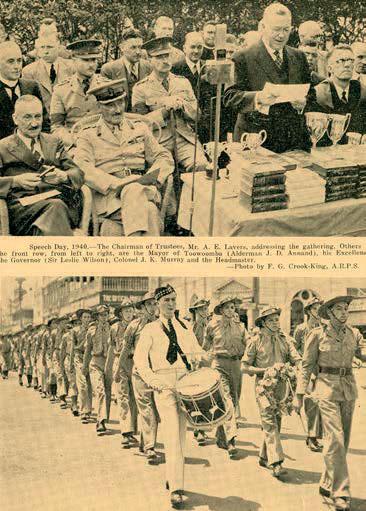


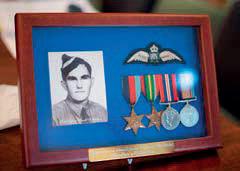
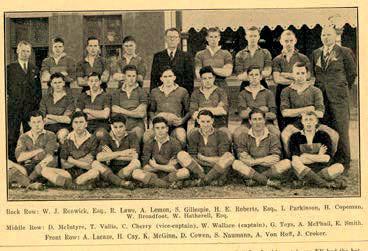
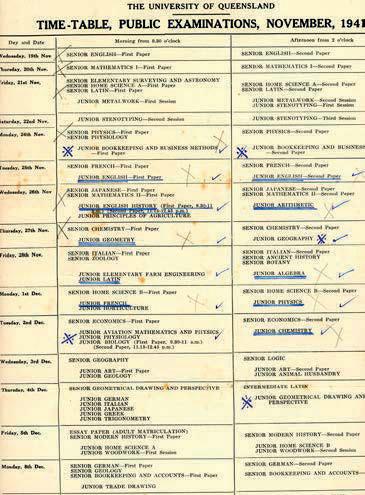
Timetable for

Chairman of the Board of Trustees: Mr A. Lavers (in his 9th year)
Headmaster: Mr ‘Harry’ Roberts (in his 8th year)
Deputy Headmaster: Mr ‘Len’ T. Heenan (in his 5th year)
Senior Prefect: Clive R. Cherry
Dux of Year: Keith A. Stevens
Total School Enrolment: 347
Number of Dayboys: 187
Number of Boarders: 160
Staffing:
• There was a total of seven teachers in the School.
• Mr Heenan was unable to return for the first six weeks of Term One and his place was taken by Herbert A. Copeman, last year’s Dux. Then, after a few weeks at the School, Mr Heenan left to join the teaching staff of the RAAF.
Students:
• The School Prefects were Clive Cherry, William Broadfoot, Rex Jones, Richard Laws, Bryan Lynn, Keith McGinn, Keith Stevens and Gordon Teys. A photograph of the School Prefects is included in this year’s entry.
• There were no Open Scholarships awarded in this year.
• A primary school class was in operation from 1942-45.
• Wellington Lee (1940-1942) became acknowledged on the Old Boys’ Wall of Achievement for his noteworthy services to Australia, particularly to the Chinese community. He served with the RAAF from 1943 to 1946 and again on the Active Reserve of Officers from 1953 to 1983. He lived most of his life in Melbourne and at one time was Melbourne’s Deputy Lord Mayor. Mr Lee was a proud attendee at various TGS Reunions held in Melbourne including those in 2005, 2006 and 2012. He spoke with great fondness regarding his old school.
• Gordon D.E. Teys (1938-1942) was also acknowledged on the Old Boys’ Wall of Achievement as a Rugby League International. He was a member of the School’s 1st XV for three years from 1940 to 1942, being vice-captain for the latter two. In 1942 he scored five individual tries when playing against Brisbane Grammar School on 25 July. Gordon played for Queensland in 1950 but was injured in the state trials in 1951. Even so, his form had been good enough to secure him a spot in the Australian test side against the touring Frenchmen.
• Keith A. Stevens (1938-1942), Dux of the Year, was later a radiation physicist with the State Health Department. A tragic light plane accident in 1978 claimed the lives of Keith Stevens and his wife.
• Rowan B. Sterling (1939-1942) died in service during World War Two aged 19 years. He was a member of the RAAF and each year the School presents a subject prize at the Speech Day and Prize Giving Ceremony, the Rowan Sterling Memorial Prize for Physics (since 1995). The Prize was originally named the Rowan Sterling Memorial Prize for Science in Year 10 from 1945-1994.
• Albert Von Hoff won the Belford Prize this year.
• Burnett ‘Ian’ Parkinson (1938-1942) was appointed as a Trustee on the School’s Board of Trustees in 1972.
• Neville C. Miles (1942) proceeded to graduate from the Royal Military Academy, Duntroon.
• Fred Ainsworth (1941-1942) was honoured to receive an Order of Australia Medal (OAM) on Australia Day 2015. He served the communities in which he lived through Rotary, Apex, Lions and the RSL, and was one of the founding members of the Chinchilla Melon Festival.
• Thomas E. Hannay (1939-1942) was awarded a Medal of the Order of Australia in the General Division (OAM) for services to archery.
• At around this time, one or more girls from Fairholme College attended Latin classes held at our School, taught by the Headmaster.
Buildings:
• With the overflow of boarders, the Trustees decided to negotiate a loan and build a wing on the eastern side of the main building (now School House). This was completed for the commencement of the School at the end of January. The building housed thirty bo ys and provided more comfortable quarters for the Headmaster and the domestic staff. The old Drawing Room (later the Board Room and later still, in 2023, the Deputy Headmaster’s Office) served as a second dining room.
Events:
• The Headmaster established the “House system”. He divided the whole School into four Sporting Houses – Groom, Mackintosh, Stephens and Taylor. The four Houses each had a House Master and a House Captain. The Housemasters were: Groom – Mr T.V. Martin; Mackintosh – Mr W. Hatherell; Stephens - Mr A.M. Thomson; and Taylor – Mr G.T. Donohue. In later years, with the advent of new boarding houses that were named Taylor House (1958) and Groom House (1964) , it was decided to change similarly named sporting houses to Barbour and Chauvel (see 1974).
• A stop-gap arrangement was in place with Mr Hatherell by which some boarders were housed in converted private homes, ‘Beresford’ in Margaret Street and ‘Somerset’ in Herries Street. ‘Beresford’ was used as a Boarding House from 1942 -1949. In 1942 there were twenty-six boarders residing in ‘Beresford’. In 1946 ‘Beresford’ was occupied by approximately thirty Third Formers (Year 9) plus four Fifth Form (Year 11) House Prefects and a Housemaster (Mr John ‘Jack’ Reath) and his family. The home has since been relocated and the Grammar View Motel is now situated in this location (directly opposite the Margaret Street entrance to Toowoomba Grammar School). As a private home, ‘Beresford’ might have housed up to eight people. In its role as a school dormitory, it was packed beyond capacity. The Housemaster and his family lived in an apartment on the eastern side while student dormitories occupied five rooms at the fro nt and western side. A large room in the centre was used as the ‘prep’ room. Access for the students was via a back door near the locker room/shower/ toilet area. Student amenities were basic but at least, thankfully, included a gas-fired water heater in the shower room . During the day the
house was out of bounds. An article on the Beresford Boarding House 1942-1949 appeared in the Omnibus publication Vol 16, No.2, August 2006, pp.19 -20. A photograph of ‘Beresford’ house is included in this year’s entry and a photograph of the boarders residing in ‘Beresford’ in 1944 is included in the 1944-year entry.
• Slit trenches were dug about the School and some air raid drills were held. Old Boy Alan J. Lemon (TGS 1940-1943) and father of a future member of the School’s Board of Trustees, Mrs Lee Mylne, remembered this day well for he was the boy who harnessed the School horse for the task and this involved turning the sod so that the boys, under staff direction, could dig the zig-zag trenches manually using army trenching shovels. The School’s two trench complexes to act as air raid shelters were located in front of the main building (School House) close to the bunya pines in the vicinity of today’s existing sports Pavilion. A photograph of the slit trenches being dug by the boys is included in this year’s entry.
• Blackouts were enforced and Army huts appeared on the School grounds where the tennis courts are now located. These Army huts constituted an Australian Women’s Army Service (AWAS) camp which was surrounded by a barbed-wire entanglement.
• Downlands College was commandeered by the Australian Army as a military hospital. Alternative accommodation was arranged for the Downlands students at Dalby in two hotels, a boarding house and a former maternity hospital. The Downlands College staff moved back to Toowoomba in December 1943.
• Thursday, September 3rd represented the third anniversary of the outbreak of the present war. As the date was a day of national prayer, a short service war conducted during break by the Rev. N. H. Joughin. At this short, simple service Rev. Joughin extolled the gallantry of those Old Boys who had already made the supreme sacrifice in the three years of this war. Then, while all stood in silence, the names of the Old Boys who had been killed on active service were read by the Senior Prefect. After a minute's silence, in honour of the dead, the service concluded with prayers.
• Early this year a Flight of the Air Training Corps (ATC) had been established at the School to provide facilities and opportunities for preliminary specialist training for those boys between the ages of 16 and 18 years who desired to later join the Royal Australian Air Force (RAAF). Parades were held twice weekly as well as on Saturday evenings and instruction was given in mathematics and science, Air Force drill, service knowledge, Morse Code, aircraft recognition and theory of engine. By 1943 the TGS Flight boasted a membership of 25 boys and in that year Cadet Eugene ‘Gus’ G. Galea set an Australian record of 98% in his Stage 1 proficiency examinations. (Eugene Galea was to be awarded Dux of the School in the following year ) Although all formal training was provided by RAAF personnel, staff member Mr W.L. ‘Len’ Poulsen was heavily involved in this dimension, for it was he who provided the exacting formal instruction required in the Mathematics and Science disciplines. After the War, having served its immediate purpo se, the School Flight of the Air Training Corps was disbanded.
• For a graphic account of the horrors of warfare and an illustration of the heroic efforts of so many of the TGS Old Boys, refer to the 1926-year entry (‘Students’ section), James ‘Jim’ Yeates. Similarly, an illustration of the tragic loss of life in World War One is to be found in the 1916-year entry (‘Students’ section), Frank Mason.
• From the outset of the establishment of the School and into the decades of the 20s, 30s and 40s the staff and boys referred to the spring holidays as the “Michaelmas” holidays. This term originated in the United Kingdom in which the first academic term of their Northern Hemisphere academic year (e.g. in England around September to December) is known as the Michaelmas term and is used in a number of English-speaking universities and schools. It is also a term used as the name of the first of the four terms into which the legal year is divided by the Courts of England. Many schools and universities in the United Kingdom such as The University of Oxford and Cambridge University still use this term.
Co-curricular Activities:
• From 1942–45 there were no formal GPS competitions due to World War Two . The only matches against other GPS schools were ‘invitational’ games.
• Owing to the non-opening of the Brisbane schools after Christmas there were no G PS matches.
• In Athletics, the School’s team was placed 3 rd in an unofficial and incomplete GPS competition as it did in the following year.
• In Cricket the boys played in the town competitions, except for an Air Force team and one GPS match against Nudgee. NC made the trip to Toowoomba and w as defeated by TGS by eight wickets. A photograph of the 1st XI is included in this year’s entry.
• In Rugby, the School’s 1st XV Rugby team defeated the team from Nudgee College (19-10), a rare achievement in the history of TGS Rugby . This game was played at Nudgee and the victory represented only the second occasion that TGS had defeated Nudgee on their home ground (the first win against NC at NC was in 1930).
• It was considered that the School had, at least, four strong rugby teams, namely the firsts, seconds, thirds, and under 7st. 71b. side.
• Since the Great Public Schools' (GPS) fixtures had been more or less abandoned this year, the 1 st XV was not able to obtain its usual GPS matches. However, on July 26th the TGS 1 st XV journeyed to Brisbane to play Brisbane Grammar School and defeated this side by 49 points to nil. The only other match the 1st XV had was against an Army team. It was an evenly contested game, the final scores being School, 13; Army, 8.
• In Rugby, see Gordon Teys in the ‘Students’ section of this year’s entry. In the 1st XV Rugby match against BGS, Gordon Teys scored 5 tries and William Broadfoot 4 tries.
• In Swimming, there was no GPS Swimming Championships held this year.
• In Tennis, no GPS matches were held this year owing to war conditions, but there were six teams entered in the town competitions. Unfortunately, the gradings were too high for the boys available, and most teams were hopelessly outclassed.
• In Cadets, the number of Companies increased from two to three, with eight Platoons.
• During the year the Cadets participated in several route marches near the top of the range and carried out exercises in separate companies in the rough bush country down the range, making full use of methods of camouflage.
• During Headmaster Roberts’ time at the School it was compulsory for all boys to be members of the Cadet Unit unless, between 1942 and 1945, they had elected to join the School’s Flight of the Air Training Corps (see above).
• Rifle Range Shooting - In this year permission was granted for the School to build a miniature rifle range within its grounds. The site chosen was below the bank of the top oval (in today’s terms, near the P.B. Hauser Aquatic Centre). Parties of "volunteer" workers toiled for several afternoons, and an excellent 25 yards range was soon completed, at very low cost. The rifle range was situated at the School until 1996 when, for safety and other logistical reasons , it was demolished to make way for the development of the new Junior School site.
• In 1942-43 there were no Rugby contests against Downlands College. Downlands was used for the war effort and students were transferred to Dalby.
• In Cricket, the TGS 2nd XI (128) was defeated by Downlands College (139). The match was played at Middle Park. The Headmaster, Mr Roberts, played in this match and his bowling figures were 5 wickets for 17 runs.
General:
• The School’s previous Headmaster, Mr G.P. Barbour, who retired as Headmaster in June 1935 , was still well enough to be coaching the Sydney Grammar School 1 st XI cricket team this year.
Guest Speaker at the Speech Day & Prize -Giving Ceremony: The Honourable D.A. Gledson – QLD State Attorney-General
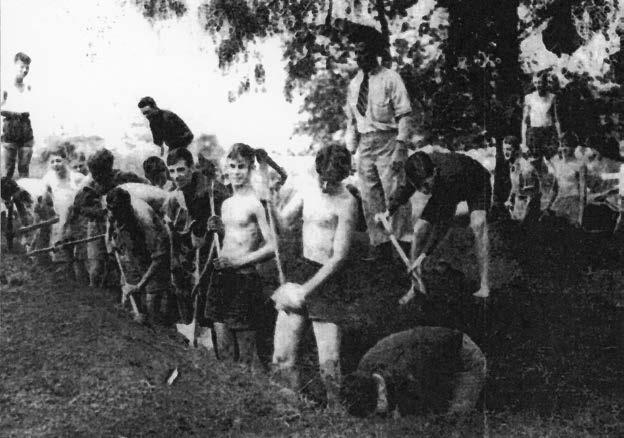
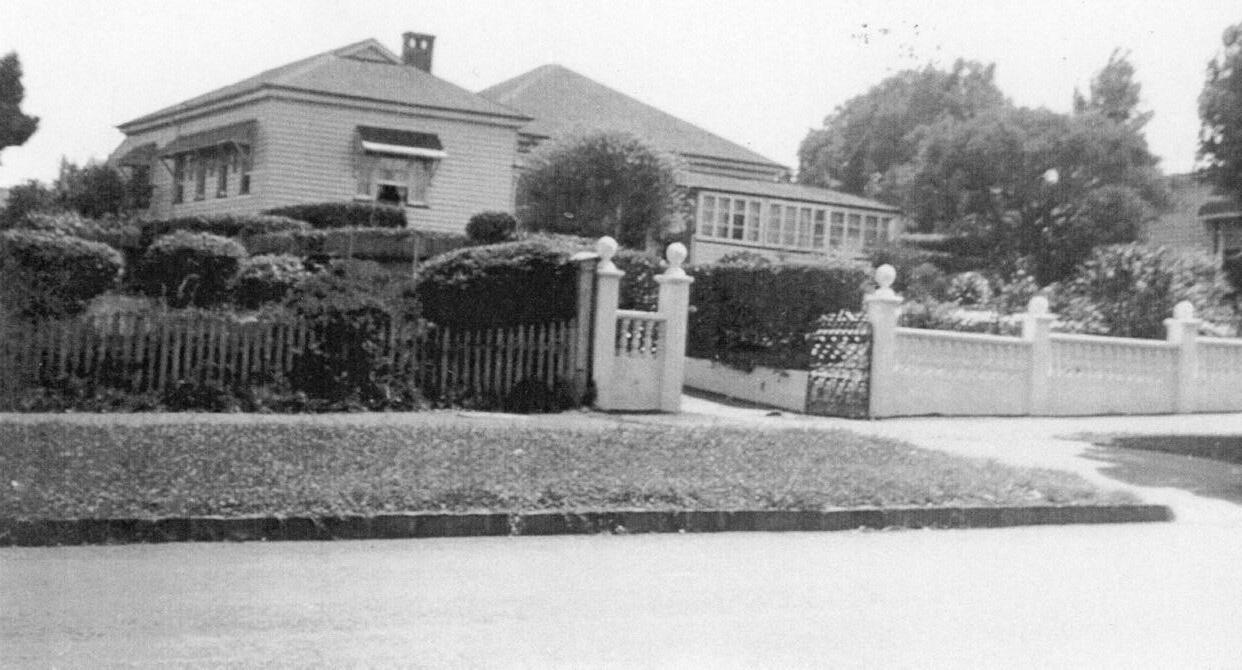
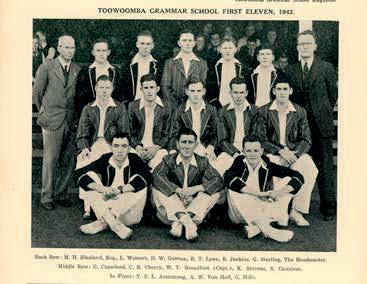

Chairman of the Board of Trustees:
• Old Boy (1893-1894) Brig-General James C. Robertson succeeded Mr Arnold Lavers as Chairman of the Board Brig-General Robertson previously was Chairman of the Board of Trustees from 1929-1933. (see 1894 and 1929).
• Outgoing Chairman, Mr Lavers, was appointed as Chairman of Trustees in October 1934 in place of Mr A.W. Hale who retired from the position.
Trustees: An Old Boy of the School, Mr Leslie A. Boyce (1911 -1914), was appointed a Trustee on the Board. He was appointed Chairman two years later. Also on the Board were: Brig-General Robertson; Messrs Stanley Hammond; Cliff E.J. Richards; Edwin C. Bernays; Jack Demaine and Dr Hector Jones. Mr Thomas Ludgate was Secretary to the Board.
Headmaster: Mr ‘Harry’ Roberts (in his 9th year)
Deputy Headmaster: Mr ‘Len’ T. Heenan (in his 6th year – this year on military leave)
Senior Prefect: Richard Laws (see below)
Dux of Year: Eugene G. Galea
Total School Enrolment: 338
Number of Dayboys: 166
Number of Boarders: 172
Staffing:
• In the 1940s there was no Accounts Office at the School and hence no office staff. All book work was done by chartered accountants in the town (Ludgate and Ludgate Accountants in Ruthven Street).
Students:
• The School Prefects were Richard Laws, William Campbell, Alan Lemon, John McWilliam, Allan Perina, Alexander Preece, John Williamson and William Wright.
• Five Open University Scholarships were won by the Form VI students (from only 18 offered in Queensland) – William H. Tait (6th in State), Eugene ‘Gus’ Galea (7th in State), George ‘Bill’ W. Belford (10th in State), Ian L. Chapple (11th in State), Richard ‘Dick’ Laws (18 th) and a further two boys were awarded Scholarships not taken up by the original awardees (Allan G. Perina and John D. Clark).
• Of this year’s Sixth Form, only seven attended University in the following year, while twenty were in the Forces.
• Senior Prefect, Richard (‘Dick’) Laws (1939 -1943), was to teach at the School very briefly for five months in 1944 before being called up for Navy duties. He was an Open Scholarship recipient being placed 18th in the 1943 Senior Public Examination to the University of Queensland. He was also Captain of the 1st XI, a champion GPS sprinter (see below) and a member of the 1st XV in 1941 and 1942. ‘Dick’ was quoted in the School’s Newsletter Blue and Gold in 1962 as recalling: “…air raid practices in the slit trenches that decorated the drive and the hill in front of the School… the war-time shortage of male teachers and the efficient reign of Misses Thomas, Baker and Holiday… the great football season in 1942 when, with six or seven teams in regular competition, the School did not lose a single game… the 13 dropped catches in the ’43 Nudgee game… Clive Cherry scoring over 50 in the last 15 minutes of a Mackintosh -Stephens House game.” Dick Laws also taught briefly at the School after World War II in 1946 following his discharge and before commencing a degree in Engineering at the University of Queensland. He was also the President of the TGS Old Boys’ Association (Brisbane Branch) from 1964-1966.
• Robert (Bob) B. Partridge (at school 1942-1943) was later to be employed on the Senior Administrative Staff of the School as Secretary to the Board of Trustees. (1947-1984). A day-boy House was named after Mr Partridge (see ‘Staffing’ entry, 1947) and he was also honoured with his selection as an Honorary Life Member of the Toowoomba Grammar School Old Boys’ Association in 1972. An Obituary for ‘Bob’ Partridge, written by Judy Gillies and John Winn, appeared in the School Magazine 1987, pg.194.
• Honoured on the Old Boys’ Wall of Achievement is Brian E. Bell, later Sir Brian Bell (1942 -1943). He became a prominent businessman in Papua New Guinea and was Honorary Papua New Guinea Consul for Sweden and Norway.
• Also acknowledged on the Old Boys’ Wall of Achievement from this year group is Alan J. Le mon (1940-1943) who captained the 1st XV in this year. Mr Lemon became a leader in the Australian agricultural sunflower industry and acknowledged with an MBE.
• A further inclusion on the Old Boys’ Wall of Achievement is Alexander V. Preece (1940 -1943). A graduate of the Royal Military College, Duntroon, he commanded the 1st Battalion Royal Australian Regiment in Vietnam in 1965. He received a decoration for gallantry in Vietnam – the DSO for “setting, by personal example, the very highest standards of courage, leadership and personal skill” From 1966 to 1969 Lieut-Colonel Preece was an instructor at the British Army Staff College and later, from 1970 to 1974, he filled various Canberra -based staff appointments such as Director of Infantry, Director of Army Training and Honorary ADC to the Governor-General, Sir Paul Hasluck.
• John I. Williamson (1940 -1943) was an Under Officer in the School’s Cadet Unit in 1943. He later graduated from the Royal Military College, Duntroon, in 1946. After service in the Britis h Commonwealth Occupation Forces, Japan, he returned to Australia in 1948 to complete studies at the University of Queensland. Later he graduated from the Australian Staff College and held a number of command and staff appointments including service on the staff of the Australian Military Attache in Washington DC. In 1972 he was appointed to Brigadier and appointed Commander, Puckapunyal Area. In 1975 he was promoted to Major-General in which rank he held appointments as Chief of Operations, Deputy Chief of the General Staff and General Officer Commanding Field Force Command. Major-General Williamson is acknowledged on the Old Boys’ Wall of Achievement.
• John W. Slater (1940-1943) was decorated with the Distinguished Flying Cross by The Queen with an investiture in Canberra in 1954. The Medal was for his gallant and distinguished service, flying 133 missions in Korea.
• Charles Anthony ‘Tony’ Lacaze (1941 -1943) later was awarded an Order of Australia Medal for service to Junior Rugby Union Football.
• Leslie W. Trout (1942-1943) proceeded to graduate from the Royal Military College, Duntroon.
• Graham S Burstow (1940-1943) became an internationally renowned photographer, President of the Australian Photographic Society, first Australian Associate of the American Photographic Society, Fellow of the Royal Phot ographic Society of Great Britain and honoured with The Order of Australia (OAM). When aged 93 Graham returned to the School and spoke with the Year 12 Art students about his passion for photography, especially his ‘social documentary photography’. A photograph of his visit is included in this year’s entry. Also, when aged 93, Graham launched a book titled Closer which covered more than seventy years of his photography. Graham Burstow is acknowledged on the Old Boys’ Wall of Achievement.
• Garnet R. Hills (1939-1943) was to later teach Economics and Book-Keeping at the School for three years (1951-1953)
• Peter S. Armstrong (1942-1943) was a Queensland grazier and bushman and a founding member of the Queensland Branch of the Isolated Children’s Parents’ Association (ICPA). Peter’s three sons also attended TGS – Simon (1968-1969), David (1968-1971) and Andrew (1970-1973).
• Brian Thomason (1940-1943) won the Belford Prize this year.
• William ‘Bill’ A. Palmer (1943) was appointed General Manager for Queensland’s Westpac Banking Corporation in 1982. He retired from the Bank in 1989. Bill Palmer was awarded a Doctor of Philosophy degree honoris causa from the University of Queensland due to his work on the University Senate and Chairman of the Finance Committee and the UQ Foundation.
Events:
• Trustee Dr Jones reported that he understood the Talkie Machine donated to the School by Mr Boyce had been taken over by the Military Authorities. The Headmaster, Mr Roberts, said that the Military had requested the loan of the machine for a short time.
• The Headmaster reported to the School’s Board of Trustees that he had some students at the School learning German and it was necessary that, for the time being, this subject be taught. It was decided that Mr Roberts be requested to make arrangement with Pastor Gutekunst to take five periods of German per week. It was later reported that Pastor Gutekunst had left the city and Mr Roberts had appointed Mr Froehlich who was a graduate of Vienna University and lived near the School.
• It was decided at the beginning of the year to construct an outdoors Gym. behind "Rec." dorm. Through lack of material the School was unable to have equipment installed until the middle of the second term. The equipment, thus far, consisted of two horizontal bars and two pairs of parallels. It was hoped that in the near future the boys would be able to have rings.
• Since mid-winter five movie programmes were shown to the boarders in the School Hall. Fulllength pictures were featured, and these were regarded as a welcome change from the usual "shorts".
• Groom House won the House Sports this year, the competition comprising events in swimming, cross country, cricket, football, athletics and a combined event incorporating shooting, tennis and an 800 yards swim.
• The School Magazine continued to record a ‘Casualty List’ using the sub -headings ‘Killed’, ‘Wounded’, ‘Missing’ and ‘Prisoner of War’.
• Two new subject prizes were introduced this year – the Alan Dunn Memorial Prize (for English) and the Graeme Pace Memorial Prize (for Mathematics). See 1923 for Alan Dunn and 1931 for Graeme Pace.
• Mrs Fleming’s corner store ‘tuck shop’ (corner of Mary and Margaret Streets), in operation from the early 1910s to early this year ceased due to Mrs Fleming’s ill -health. In keeping with all that she and her son and daughter had meant to the School over such a long period of time, on the afternoon of 3 April 1943 during the Headmastership of ‘Harry’ Roberts, the boys, at an informal assembly on the front lawn of the School, made her a small presentation to acknowledge her and her family’s contribution to the School’s history. Mrs Fleming’s articulate and passionate reply is to be found on page 23 of the 1943 School Magazine. In part she said: Mr Roberts, Staff and Boys – I cannot express just how I feel on this occasion, which will always remain as a most pleasant memory and as a happy termination of my long association with your school and scholars, many of whom I have watched grow into manhood, and many of whom I number as friends; in fact, I have grown to love quite a lot as though they were my own, and my thoughts will always dwell on those attachments, wondering how this boy is progressing, and how that boy is upholding the traditions of his School. To me you resemble one large family, may I say my family, and my heart is overflowing at your magnificent gesture. I would like to say a lot more, but in wishing you all farewell I do so with a keen sense of loss, and my greatest joy will be to see you and your School prosper, and may it serve as a great institution for those following on. God bless you all. (For further information about Mrs Fleming see the ‘Events’ section of 1967).
• One of Mrs Fleming’s TGS customers, Douglas ‘Doug’ M oreton (1935-1937) was later to study pharmacy and to establish a chemist shop in one of the two new shops which were built on the corner of Margaret and Mary Streets, originally the site of Mrs Fleming’s Range store.
Co-curricular Activities:
• From 1942–45 there were no formal GPS competitions due to World War Two
• In Athletics, the School’s team was placed 3 rd in an unofficial and incomplete GPS competition and with further success in the following year. Dick Laws won both the 100 and 2 20 yards Open sprint events at the unofficial GPS Track and Field Championships in this year.
• In Cricket, the School played only two GPS schools – Brisbane Grammar School and St Joseph’s Nudgee College and was beaten soundly by both schools – BGS (8/287) d TGS (182) and NC (386) d TGS (170). The 386 runs scored by NC remains to this day as the highest total ever put on by an opposing GPS school 1st XI cricket team. In the match against Nudgee, TGS Charles ‘Tony’ Lacaze took 5 for 84.
• In Football (Rugby) the School played four other GPS Schools with wins against IGS (29 -3), BBC (46-3) and BGS (17-3) but was defeated by Nudgee College in a very close game (11-13).
• In Swimming, the team was placed 3 rd in an incomplete competition. Towards the end of the swimming season, life-saving was introduced to the boys.
• In Tennis, the School’s 1st IV won an unofficial Premiership in an incomplete GPS competition. There was practically no organised tennis in the second half of the year, owing to a shortage of tennis balls throughout Australia. The School’s 1 st IV defeated BBC (5 rubbers to 3) and also
defeated Nudgee College (even on rubbers but TGS won 11 sets to NC 8). NC was credited as having the best tennis side in the schools before its defeat against TGS.
• In Cadets, due to the compulsory nature of Cadets and the increasing strength of the Unit (287 cadets in this year), the Department of Army allocated the services of a full -time instructor, Sergeant Dayas, to the School.
• In Cadets, during Midwinter more than half the Corps went into camp at Southport. The camp was under the auspices of the Army, which had placed at the Cadets’ disposal instructors, cooks, accommodation and rations.
• For the first time in many years, the School’s Cadet Corps was not in attendanc e at the Mothers’ Memorial Service.
• No annual Rugby or Cricket matches against Downlands College occurred due to the war. The Downlands College students were schooled in Dalby as Downlands College was used for the war effort.
• The School Museum holds a swimming baton recording the results of an annual swimming competition between Toowoomba Grammar School and Downlands College. This competition commenced this year and the title of the baton reads: “Three Cornered Carnival – Downlands, TGS and Centre”. The word ‘Centre’ was to describe swimmers from the town of Toowoomba. The competition continued each year, with the exception of 1950 and possibly 1952, until it was discontinued in 2005 (see 2005). There was only one occasion in which ‘Centre’ was listed on the swimming baton and this was in 1945. One could assume that the competition then involved only the two schools – TGS and Downlands. In this inaugural year of the swimming competition between the two schools, the event was won by TGS A photograph of the swimming baton is included in this year’s entry.
Guest Speaker at the Speech Day & Prize-Giving Ceremony: His Excellency The Governor, Sir Leslie Orme Wilson
The Governor spoke to about 300 people who assembled on the lawn in fron t of the School. The text of The Governor’s address to the School was printed in the newspaper. It read, in part:
“The work of your school means much to your country and to your State. It is the formation of character as well as the lessons learned in leadership that are so important. Leadership is a most important thing in this world. Leadership can mean the greatest thing for a country or be just the opposite. We have seen that in this present war. We have seen it in the history of our own Empire. Had it not been for the leadership of one man, I do not know where we would have been today. The tradition of a school also inculcates cooperation and friendship, and these can last for all time. There is an urgent need for leadership after boys leave school.”
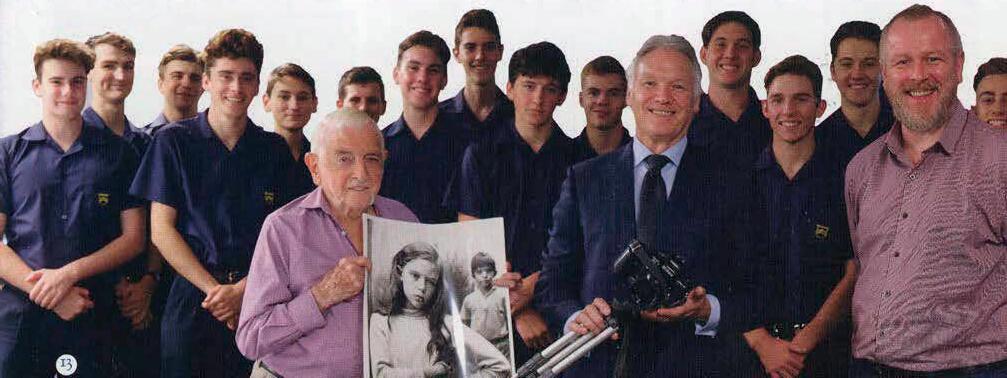


Chairman of the Board of Trustees: Brig-General J.C. Robertson (in his 2nd year)
Trustees: Messrs Hammond and Bernays resigned from the Board. Mr John E. Duggan was appointed as a Government representative on the Board “in the room of Stanley Hammond whose resignation has been accepted”. Mr Edwin Bernays’ position was filled by Mr Mervyn Baynes.
Headmaster: Mr ‘Harry’ Roberts (in his 10th year)
Deputy Headmaster: Mr ‘Len’ T. Heenan (in his 7th year)
Senior Prefect: John A. McWilliam
Dux of Year: John L. Jameson
Total School Enrolment: 362
Number of Dayboys: 185
Number of Boarders: 177
Staff:
• In May it was announced that Mr W. Hatherell had been appointed as the Acting Second Master of the School whilst Mr Hennan was on military leave.
• The number of teachers on staff had increased to fourteen due to increased enrolments over recent years.
Students:
• The School Prefects were John McWilliam, William Hatton, William Pitt, Maurice Sainsbury, William Simpson, Rodney Trousdell and Leslie Weiniert. A photograph of the School Prefects is included in this year’s entry.
• Eleven students from this year’s Sixth Form were to be in military uniform in the following year.
• Three students won the University Scholarship – Robert J. Scott (6th in the State), John P. Malos (7th) and Colin K. Lamb (17th).
• Robert J. Scott (1941-1944) matriculated from the School sixth in the State on the Open Scholarship list and studied medicine at the University of Queensland, graduating in 1950. He was also a Queensland backstroke champion (and Captain of TGS Swimming in this year) . Dr Scott became a senior advisor to the Commonwealth on occupational medicine and is acknowledged on the Old Boys’ Wall of Achievement. In this year Robert was awarded the Belford Prize.
• A further inclusion on the Old Boys’ Wall of Achievement from this year was Ralph W. Skoien (1942-1944) who invented the first modern house insulation material for Australian weather
conditions, the Ri. Silver Batt. He won numerous awards for Design and his silver batts have been exported to Fiji, Papua New Guinea, Malaysia, Hong Kong, Israel, Japan and New Zealand.
• Kevin D. Whiting (1943 -1944) joined the Citizen Military Forces (CMF) in Brisbane in 1948, later reaching the rank of Brigadier. He did not experience any active war service but he was heavily involved in Civil Defence. He later became Director of the Stat e Emergency Service. Brigadier Whiting is acknowledged on the Old Boys’ Wall of Achievement.
• Duncan ‘Ian’ Thompson won the Open 880 yards event at the GPS Track and Field Championships (and in the following year).
• Geoffrey R. Watson won the T.J. Byrnes Memorial Medal (awarded to those placed first in Queensland in the Junior Public Examination – 1912-1971). In the School’s history to date there had only been four TGS students who had been awarded this most prestigious medal. They were J.J.A. Pollock (1922), L.H. Hopkins (1925), J.C. Rivett (1937), and G.R. Watson (1944). No further TGS students were awarded this medal which ceased being presented in 1971 (see 1922).
• Three students from this year proceeded to graduate from the Royal Military College, Duntroon . Donald D. Weir (1941-1944) was an Under Officer in the School’s Cadet Unit in 1944. He graduated from the Royal Military College, Duntroon, in 1947. As a member of the Australian Regular Army he served with distinction in the Korean War and he was the Deputy Commander of the 1st Australian Task Force in Vietnam from November 1970 to November 1971. Brigadier Weir OAM is acknowledged on the Old Boys’ Wall of Achievement and was the Guest Speaker at the School’s Speech Day and Prize Giving Ceremony in 1977.
• Keith P ‘Paddy’ Outridge (1942 -1944) graduated from the Royal Military College , Duntroon, in 1947. He served with distinction in the Korean War. Brigadier Outridge is acknowledged on the Old Boys’ Wall of Achievement.
• William ‘Bill’ Hatton (1940-1944) was later to be the Reviewing Officer at the 1970 TGS Cadet Passing Out Parade in his capacity as Lt.Colonel and the newly appointed Commanding Officer of Cadets in Queensland. He was a graduate of the Royal Military College, Duntroon.
• John G. Lloyd (1942-1944) was elected an Honorary Life Member of the TGS Old Boys’ Association in 1976. As at 2020 his initials could still be seen on the concrete pathway outside School House. John Lloyd was President of the Old Boys’ Association from 1977 -1982 and Chairman of several successful building funds for the School. A subject prize, ‘Mrs J.G. Lloyd’s Prize for Geometrical Drawing’ was first presented in 1979. This prize was later changed to John Grainger Lloyd Memorial Prize for Manufacturing in 2010 and then for Graphics and then for Year 11 Specialist Mathematics and is presented at the School’s annual Speech Day and Prize Giving Ceremony.
• Graham Wyatt (1941-1944) was later elected as President of the Brisbane Branch of the TGS Old Boys’ Association (from 1973-1976).
• Leslie Andrew ‘Andy’ Muller (1943-1944) was a passionate Old Boy who contributed much to the School in many voluntary ways. He served as a member of the Old Boys’ Council for 19 years, from 1968 to 1986, being Vice-President of the Association twice. It was an interest his sons, Old Boys Peter (TGS 1965-1969), Keith (1966-1970 and President of the OBA in 1996-1998) and Ross (1981-1985) were to inherit from their father, as were his grandsons.
• William S. Simpson (1941-1944) was later to be appointed a Judge in the Queensland Supreme Court.
• Roderick P. Stirling (1943-1944) attended to ‘Junior’ and then left the School as his father needed urgent help on the farming property and subsequent relocation. In 2023, then aged 94 years , ‘Rod’ Stirling donated to the School his father’s TGS leather bound and embossed Prize Book dated December 1907 (see 1907). Mr Stirling clearly recalled his days at TGS during the war years and described his schooling as “a happy time”. He referred to the food rationing during the war
and petrol rationing which limited the frequency of his parents’ visits to the School to see him. Mr Stirling remembered catching the ‘rail motor’ from Toowoomba to his home in Pittsworth. The rail motor consisted of two carriages with a diesel engine at the front. During aid raid practices at the School, Mr Stirling recounted that the boys were instructed to bring with them an eraser (rubber) from their school desk to place in their mouths between their teeth in the event of a bomb exploding and the shock waves damaging their teeth. In 2001 Rod was appointed a Member of the Order of Australia (AM) in recognition of his “service to agriculture in the Darling Downs district, particularly through the introduction of progressive farming technology and innovative irrigation techniques and to the community” Rod was the President of the Royal Agricultural Society of Queensland (Toowoomba) from 1979 -1986. His Presidency years involved the Royal Agricultural Society moving its show grounds from Campbell Street (opposite Queens Park near the corner of Lindsay Street, near the current Cobb & Co. Museum) to its current location of 245 acres and over 10 pavilions in Glenvale. The first Toowoomba Show was held in July 1862 and the Darling Downs Royal Agricultural Society was the first to be established in Queensland, fifteen years before the Brisbane Roy al Agricultural Society. The first Royal Toowoomba Show at the Glenvale Showgrounds site was held in 1986.
• Student enrolments had almost doubled since1938: 183 in 1938 and 354 in 1944.
Buildings:
• Two new classrooms were identified as being required. The Trustees noted that the Boarders’ Change Room was at present being used as a classroom as was the main hall (now known as Old Hall). The Trustees Report of 21 January, 1944 stated: “It should be pointed out that this School Hall is really the only living space that the Boarders have. That is to say, they leave their Dormitories when they get up, they do their lessons during School time in their respective Classrooms, but at other times the School Hall is really their Living Room.”
• The old gymnasium was taken down and used in extending the old "rec.dorm. ” into a larger dormitory and three classrooms.
Events:
• An inter-House rifle shooting competition was held during September and October on the School’s miniature shooting range.
• The annual public-speaking competition was held in the School Hall (now Old Hall) in October.
• Groom House won the inter-House sports for the second successive year.
• In the School Magazine, the Military Casualty List made extremely distressing reading.
• The competitors of the School’s athletic sports unanimously decided to forego all Prizes and donate the amount thus saved to Patriotic Funds. In lieu of the Prizes, the successful athletes received a Sports Certificate and a copy of such a Certificate is included in this year’s entry.
Co-curricular Activities:
• From 1942 – 45 there were no formal GPS competitions due to World War Two.
• In Athletics the School came 2 nd in Athletics in an unofficial and incomplete GPS competition, placing second to CEGS by only 4 and a half points.
• The Captain of Athletics was Roderick ‘John’ Trousdell (1941 -1945) who was an exceptional athlete. In addition to being the winner of the GPS Open 100 and 220 yard sprint events, John
also won the Open high jump and was part of the winning Open Relay with Thomas P. Campbell, William O. Binzer and Vernon F. Larsen. ‘John’ Trousdell also broke a school high jump record at the House Sports which had been previously held for 33 years ( see 1945). ‘John’ Trousdell’s first place in the GPS Open high jump was the first occasion for a TGS athlete in this event since the inception of the competition in 1918. The next time was a tied first place in the Open high jump in 1948.
• In Athletics, see Duncan ‘Ian’ Thompson in the ‘Students’ section of this year’s entry.
• In Cricket, owing to war conditions there was no formal GPS competition. The School won comfortably against BBC (151-55) but lost to Scots College, Warwick (89-105). The TGS 1st XI also defeated Brisbane Grammar School (199 -179) and Nudgee College (136 -117) and in this latter game TGS spin bowler Donald Marles took 5 for 38 (and also a ‘hat -trick’ in a local competition game). The 1st XI Cricket team held an unofficial Premiership this year but not all member schools competed due to the war. Other TGS cricket teams played several matches in local competition and in the inter-house competition.
• Gymnastics emerged as an individual sport in its own right. In this year Senior and Junior Gymnastics Championships and a House Competition were conducted in an outdoor setting. The boys themselves dug the pits for the rings and also collected the wood shavings to fill them. In the following year the School officially entered Senior and Junior teams in the GPS G ymnastics Competition.
• The Dickinson Cup, a new sporting trophy, was first awarded this year to the Senior Gymnastics Champion at the School. The Cup ceased being presented in 1999 and presently the Cup is housed in Old Hall.
• In Rugby, the School Magazine referred to the players having a few days of stiff training before the 1st XV team was selected.
• The 1st XV opened the season with an easy victory against the Old Boys (33 -3) and then won against Gatton College (11-5). In the smaller number of games played due to the war, the team was defeated only by Nudgee College (9-11) and Brisbane Grammar School (11 -19). Against BBC in Brisbane, the 1st XV won the game 24-3. In this game Duncan ‘Ian’ Thompson scored 4 tries for TGS. ‘Ian’ Thompson was to captain three sports next year – Swimming, Athletics and Tennis –and was a member of the 1st XI Cricket and 1st XV Rugby teams.
• In matches played by the Firsts during the third term, the team was significantly weakened by the loss of a very good back, namely Les Weiniert, when he joined the RAAF.
• Allen Thomas and Colin Lamb were selected in the GPS Combined XV.
• A rugby match between the Sixth and Fifth form took place during the year. The School Magazine, in a somewhat biased report, commented: “The Sixth Form has once more utterly defeated the quailing Fifth on the football field. Even the aid which the ref., Mr. Greenha lgh, gave the vanquished side could not spare them from the merciless and daring onslaughts of the Sixth. Tries were scored by many from the victorious side and by one or two from the vanquished; in fact, the Sixth won by a lot of points to not so many.”
• In Swimming, the team was placed equal 3rd (with BBC) in an unofficial and incomplete GPS swimming carnival held in March. The carnival was won by ‘Churchie’. A photograph of the swimming team is included in this year’s entry.
• At the GPS Swimming Championships, Gordon Card swimming for TGS broke the GPS backstroke record but was nevertheless beaten.
• A new swimming program, established last year, continued this year and involved a triangular contest held at the City Baths between TGS, Downlands College and ‘Town’. At interval there were several ladies' events (won by Glennie over ‘Town’).
• In Tennis, the 1st IV did not play a full programme due to the war conditions but won both their GPS matches played. The 1st IV defeated BGS (7 rubbers to one) and NC (6 rubbers to 2). Four teams entered in a local tennis competition. It was claimed that the School’s Tennis IV won the Premiership in an unofficial and incomplete GPS competition.
• The Captain of the 1st IV Tennis team was Duncan ‘Ian’ Thompson who also captained the team in the following year.
• In Cadets, the enrolment at the beginning of the year totalled 235 boys. Parades were held on Monday afternoons, and an interesting syllabus had been arranged including, apart from routine drill and rifle exercises, tactics, Bren gun and shooting practices. A signals section was also formed.
• The entire Cadet Corps was fitted out with uniforms for the ceremonial parades on ANZAC Day. Les Weis (1944-1948) recalled the march on ANZAC Day this year and how the cadets were issued with their boots and uniforms only on the previous day. The socks had no feet in them so it was skin against leather as the boys marched down Margaret Street.
• All cadets attended the morning service at the Mothers’ Memorial and the Fade Away Ceremony on the Show Grounds in the afternoon of A NZAC Day. There were 20 boys in the Air Training Corps.
• In the mid-winter vacation, most of the Cadets attended a five -day camp at Coolangatta. The whole Corps paraded on Remembrance Day and once again TGS had provided the Guard of Honour for the ceremony.
• The Camera Club returned to operation and 65 boys expressed interest in this activity.
• In Music, the Brisbane Light Symphony Orchestra gave a symphony concert in the Town Hall on April 1st. The orchestra, which came for a Victory Loan rally, gave this concert especially for school children. The School was allotted about eighty seats, and those who were able to attend thoroughly enjoyed the show.
• This was the first Downlands Day in Rugby for three years and six sides played for both schools. TGS won five of the six matches. The 1st XV competed for the Mayne Cup and defeated DC 20-8. The Mayne Cup had been presented for the annual contests between the TGS and Downlands 1 st XV. For some reason the Mayne Cup faltered, the competition only to be resurrected with the initiation of The O’Callaghan Cup in 1950.
• The annual swimming competition between the two schools continued this year and the event was won by TGS. (See above in the Swimming section.)
General:
• In the School Museum is an audio recording made in July 2008. It is a record of a conversation that took place between the School’s then Director of Development and Enrolments, Mr Rob Mitchell, and an Old Boy, Bruce Conochie, who attended the School during the years 1940-1944. Mr Conochie had visited the School from New Zealand and his recollection of the 1940 -1944 years was most interesting. In part it follows:
“The first thing we ran into was the ‘fag system’ which was still operating slightly but heavily discouraged by ‘Pooh-Bar’. Our beloved Headmaster Mr Roberts was known as Pooh -Bar because Pooh-Bar was the famous character in Gilbert and Sullivan’s Mikado – who was the ‘Lord High
Everything Else’. Under the ‘fag’ system, the new boys were expected to do odd jobs for the Senior boys such as run down to the tuck shop and get a packet of Minties or polish their shoes.
It was my class that dug the air raid trenches. We lived with taped windows and black-out curtains and precious little social life. The new wing to School House was built during this time.
During the war years at school some of our esteemed teachers departed to become instructors in the Army or Air Force. By 1942 we had four women teachers in the School and this was a departure for Grammar at this stage. This is not to say that they were not good teachers; it was just different for us.
I lived in Brisbane but I boarded at TGS. I was sent here for the perceived increasing excellence of the Toowoomba Grammar School education system.
At school during the war there was food rationing. The best episode to giggle about was the day we had a soup strike. We had been through a couple of weeks where we had soup far too frequently –one carrot to a tank of water – and the Prefects decided we couldn’t carry on like this so they organised a soup strike. In those days we sat at tables of 18 in the dining room with a Prefect at one end. When the soup was prepared the Prefect would dish the soup out and the plates would be passed down the table. On this particular day nobody did anything. When nothing happened the maids came and took the soup away. The Prefects were spoken to the next day about this being no way to sort out a problem in the kitchen. One Prefect refused to be involved in the strike and he was given steak for breakfast the following morning. The watery soup ceased for a while; the message got through.
I repeated Senior in 1944 to work harder to try to get a University Scholarship. It was quite common to repeat. In those days there were only 20 Scholarships offered for Queensland. It was a big battle to get on that list.”
The interview with Mr Conochie was conducted in an office on the ground floor of School House. Mr Conochie explained that in his time this office was a classroom for Mathematics teaching and learning. He continued: “I enjoyed Maths and Mr Hatherell was my teacher. I walked away in my final year with the Senior Maths Prize. Apart from the main building there were a number of outbuildings of wooden construction which were classrooms, a dormitory and the laundr y building next door to the Old Chem lab was Pud Heenan’s Physics lab. The centre part was at some time Cracker McDonald’s stationery store and the other room at the end was Bluey White’s English classes. Beyond the armoury you had Rec Dorm which was the only dorm outside School House. In about 1943 they added more classrooms to Rec Dorm.
Another interesting pastime was whilst waiting to go to Church on a Sunday morning. Someone always managed to break into the armoury and we would arm ourselves with some of the bayonets and chase the rats out by the bike shed. We would pour water down the holes and a d renched rat would come out and you would be after him.
As boarders we had two hours of organised ‘Prep’ in Old Hall each night from 7:00 to 9:00 pm with a five-minute break at 8:00 o’clock. I saw nothing wrong with that as we did a lot of written work.
I remember we also had one or two boys climb up to the bell tower to carve their initials.”
• It was interesting to note that the Headmaster, Mr Roberts, in his written reports to the Board of Trustees referred to ‘Quarters’ rather than school ‘Terms’ e g. “I feel that the first Quarter has been quite satisfactory.”
Guest Speaker at the Speech Day & Prize -Giving Ceremony: The Honourable Frank A. Cooper, Premier of Queensland
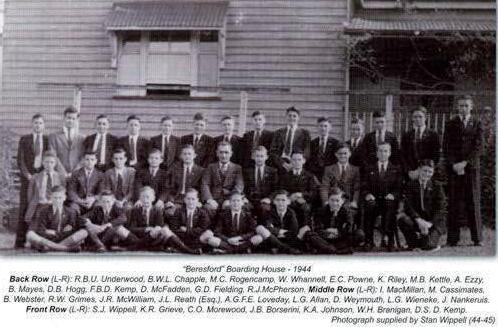
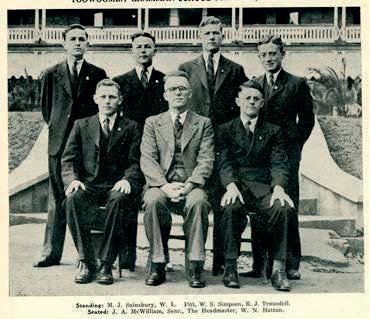

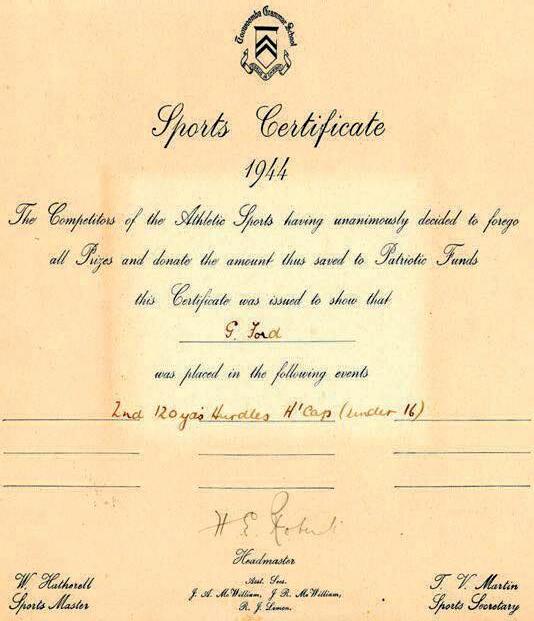
Chairman of the Board of Trustees: Brig-General J.C. Robertson was succeeded by Mr Leslie A.G. Boyce (Old Boy 1911-1914) as Chairman, a position he held until 1957.
Headmaster: Mr ‘Harry’ Roberts (in his 11th year)
Deputy Headmaster: Mr ‘Len’ Heenan (in his 8th year)
Senior Prefect: Maurice J. Sainsbury (and also Captain of the 1st XI Cricket team, 1944 and 1945) was later to be elected as President of the TGS Old Boys’ Sydney Branch in the 1960s and Director of the New South Wales Institute of Psychiatry. Dr Sainsbury was later to be invited as Guest Speaker at the School’s Speech Day and Prize Giving Ceremony in 1975 (see below).
Dux of Year: Bryan Laws
Total School Enrolment: 376
Number of Dayboys: 198
Number of Boarders: 178
Students:
• This year the School was extremely saddened by the deaths of many Old Boys including three very young Old Boys who were at School with all of the present Seniors – Donald J. Wallace (Senior Prefect in 1941), Ronald C. Culliford (a Prefect in 1941) and Rowan B. Sterling.
• The School Prefects were Maurice Sainsbury, Keith Clements, Neville Denning, Bryan Laws, Reginald Lemon, Austen Loveday, James McWilliam and Ido Seganfreddo. A photograph of the School Prefects is included in this year’s entry.
• Two students were University Scholarship Winners in the Senior Public Examination – Bryan Laws and Bruce H. Weston
• James R. McWilliam (1942-1945) became a Senior Scientist with the Commonwealth Scientific and Industrial Research Organisation (CSIRO), the Director of the Australian Centre for International Agricultural Research and an Emeritus Professor at the University of New England. His professional awards included the Donald Medal, two Fulbright Fellowships and the Schlich Gold Medal. Dr McWilliam is acknowledged on t he Old Boys’ Wall of Achievement.
• Also on the Old Boys’ Wall of Achievement is Bruce D. Watson (1942-1945). Sir Bruce Watson was knighted in 1985 during the time he was the Chairman of MIM Holdings Ltd (1983 -1991). At various times Sir Bruce was also the President of the Australian Mining Industry Council (19851987), the Australasian Institute of Mining and Metallurgy (1992) and the Australian Institute of Company Directors (1992 -1995). He received an Honorary Doctorate of Engineering from the University of Queensland in 1988. Sir Bruce died in November 2008 and was acknowledged in the School publication Omnibus in the November 2008 edition. A photograph of Bruce Watson is included in this year’s entry.
• Form VI (Year 12) student Reginald J. Lemon (1942 -1945) was to pass away in the next year as a result of a melanoma. A Cup, the R.J. Lemon Memorial Cup, is presented each year to the winner of the Open Cross-Country running event. ‘Reg’ was placed 30th in the State in the Senior Public Examination to the University of Queensland, was a School Prefect, won colours for rugby and athletics and was a Lieutenant in the Cadet Corps.
• Duncan E. (Ian) Thompson (1941 -1945) was a Prefect and captained three sports – Swimming, Athletics and Tennis (for Tennis in both 1944 and 1945) – and was a member of the 1 st Cricket and 1st XV Rugby teams. He won the GPS Open 880 yards event at the GPS Track and Field Championships both this year and in the previous year. ‘Ian’ was also selected as a member of the combined GPS Rugby XV. He later studied Law, becoming a solicitor and was awarded a MBE in 1960.
• Rodney J. Trousdell (1941-1945) was a champion athlete at school (including breaking a GPS record for the Under 16 years 110 yards hurdles in 1942, a record which stood until 1957). In 1944 Rodney won the 100 yards Open, 220 yards Open, was 1st in the Open Relay and was Captain of Athletics. In 1945, despite only a few weeks training when he returned to school after a brief stint in the RAAF, he performed well and came first in the Open Relay.
• Garnet R. Hills (1939-1945) was later to teach History, Economics and Book-Keeping at the School from 1951 to 1953. He then moved to Adelaide to join the staff of King’s College and later he was to become a well-respected teacher at Brisbane Boys’ College. At some stage in his career he also taught at Newington College in Sydney.
• Harry J.A. Muir won the GPS Open hurdles and went on to become Queensland Hurdles champion. He captained the TGS Athletics team in the following year.
• Donald Marles and Brian Sockhill were equal winners of the Belford Prize.
• Donald Marles (1941-1945) was the seventh Headmaster of Trinity Grammar School, Melbourne, from 1979-1992. Prior to his Headship of Trinity Grammar School, Donald Marles was Deputy Headmaster and Head of the Corio Campus of Geelong Grammar School in Victoria.
• Patrick ‘Pat’ J. Byrne (1944-1945) was later to be appointed as a member of the School’s Board of Trustees in 1971.
• Keith W. Clements (1942-1945) wrote to Headmaster Hauser in 2020 describi ng the parallels he saw between his schooling during World War Two and the isolation and home schooling which occurred in Term Two of 2020 with the coronavirus COVID-19 pandemic. Mr Clements spoke of the restrictions on inter-school activities, particularly in sport. There were no excursions planned or undertaken. Rosters for washing-up, sweeping, making toast and more left everyone with some duty. He also referred to the relief, excitement and rejoicing at the declaration of peace in the Pacific. Mr Clements said that he would never forget the housekeeper, Miss Barncastle, a sedate lady, continuously ringing the school bell until her arms ached.
• Alan R. Lloyd (1945 -1948) wrote to the School in 2019 and included in his correspondence were extracts from his autobiography. In the chapter on his years at TGS Mr Lloyd referred to the declaration of peace in Europe. Mr Lloyd wrote: “On May 8th 1945 we were having a history lesson in an old wooden building with Miss Coulter when we heard that peace had been declared in Europe. We all went berserk and stamped on the floor and cheered. She tried to control us and when she realised it was useless to continue the lesson she let us go. There were years o f dirt in the cracks between the planks in the wooden floor and the room soon filled with dust. There was no more school that day.” Mr Lloyd continued by recalling his teachers: “During my first two years my teachers included Mr Miles (Moto) for English; Miss Baker (Bonney) for French; Miss Coulter (Ma) for History; Mr Len Poulsen (Yogi) for Physics; Mr Reith (Juffa) for Chemistry; Mr Scott for Bookkeeping; and Mr Martin (Tibby) for Algebra and Trigonometry. For the senior years I had Mr White (Bluey) for English; Mr Bill Hatherell (Lou) for Mathematics I; and Mr Len Heenan (Pud) for Physics and Maths 2. The equipment for the demonstration of Physics and Chemistry was rather basic.”
Buildings:
• Three Air Force huts were bought from the Oakey Air Base after the war.
Events:
• The editorial in the School Magazine of June 1945 referred to Germany’s surrender. An extract from the editorial follows: “We remember always that day, early in May when, even before second bell, the words, "It's all over at last!" were passed round the School. What a crowd of us there was in the common-room to hear the news before breakfast that morning! It is barely a month ago now since we saw the huge headlines in the newspapers, when we hurried home from the pictures to hear Mr. Churchill's brief announcement of the German surrender, and to ring the School bell. Then we went to the public service at the Show Grounds to thank God that part of the Second Great War was won. Yet there was nothing in Australia like the sheer joy of the English people, of the Londoners especially at the knowledge that no longer was their homeland part of the front line. In Brisbane, in Sydney, the streets were not thronged all day with joyful crowds waving flags, singing and cheering. We shall I know, celebrate victory over Japan with more outward show of happiness, both because the war with Japan is nearer, more real to us and because the end of fighting in Asia will mark the complete victory we have fought for since 1939.”
• VE Day is ‘Victory in Europe’ Day commemorating the formal acceptance by the Allies of World War II of Germany’s unconditional surrender of its armed forces on 8 May, 1945. On VE Day the School assembled on the bottom oval (now known as Barbour Oval) and marched to the Show Grounds (then situated opposite Queen’s Park in Lindsay Street), via Neil Street.
• During World War II some 1,364 Old Boys volunteered for active service. Of these, 472 Old Boys were enlisted with the Royal Australian Air Force (RAAF) ; 798 Old Boys enlisted with the Australian Army (2nd Australian Imperial Force - 2 AIF including the Volunteer Defence CorpsVDC) and 85 Old Boys enlisted with the Royal Australian Navy, Royal Navy or Merchant Navy. 125 (9%) of the 1,364 Old Boys paid the supreme sacrifice. Of the Old Boys enlisted, 42 were Prisoners of War (POW) and 32 of these men survived this experience Of those killed in action, almost 60% were killed in a flying battle or flying accident; 17% were killed as part of the land forces; 2% in the navy and approximately 15% died through general illness. (Various sources including the Department of Veteran Affairs military records, Australian War Memorial Honour Roll, and National Archives of Australia with statistics prepared by School Museum Volunteer, Mrs Ann Hallam.)
• George Fielding (later Dr George Fielding), to be appointed the School’s Senior Prefect in both 1947 and 1948, clearly recalled the day the news came through of the death of one of the young Old Boys during the war years at the School. He spoke of the death of Pilot Officer Donald James Wallace, whose plane had been hit by anti-aircraft fire at Babo, in Dutch New Guinea: “How well I remember the morning, as though it was this morning, when the late Mr ‘Harry’ Roberts, with tears rolling down his cheeks said to Bryce Sturtridge and me, ‘Oh! Sturtridge, Fielding, fly the flag at half mast, Wallace has been shot down and killed.” (‘Still Playing The Game’, page 238). Donald Wallace was 21 when he died and one of Toowoomba Grammar’s finest. He was Captain of the School (Senior Prefect) in 1941, as well as being Captain of the 1st XI Cricket and 1st XV Rugby. In 2015 the School received the World War II medals of Donald Wallace. They were donated to the School for the Museum by his surviving sisters on behalf of their parents, Dr J.T. and Mrs. S. Wallace. A photograph of Donald J. Wallace and his war medals is included in the 1941-year entry.
• The first TGS Old Boy Prisoner of War (POW) to return to Australia, Lt. (Dr.) Edwin J. Esler (19341938) visited the School on Saturday evening, 27 October. He spoke to the boys about some of his experiences in the Japanese camps, where he spent three and a half years.
• News of the Japanese surrender – The School Magazine of November 1945 described it thus: ” The news that Japan was asking for peace came suddenly to the School. Two dayboys (whom we thank) brought the news up to the School about one o'clock on the Friday night before the surrender. The boarders at once went down Margaret Street in pyjamas and paraded round town for two hours or so. Then the official news came through during first period the following Wednesday. School ended and we spent the morning downtown. The Cadet Corps took part in the thanksgiving service and the procession next day. The two days' celebrations ended very well with a Glennie dance on the Thursday night.”
On the same topic of the Japanese surrender, another paragraph in the School Magazine read: “The Boarding House was violently aroused on the night of August 10th by the excit ed tolling of our School Bell, and, after hastily listening to the striking news of peace offerings, we streamed to town like so many migrating somnambulists to parade the streets and join generally in the premature peace celebrations."
• As a tribute to the late Sir Harry Chauvel, a memorial parade was held at the School flagpole by the Cadets. Lieutenant-Colonel Fortescue, DSO, MC, VD recalled the achievements and character of Sir Harry, an Old Boy of the School.
• The boys were fortunate enough to have three dances in the second half of the year. The School hosted The Glennie School girls on one occasion. The boys could then attend a combined Glennie, Fairholme, and Tech. dance in the St. James' Hall, and the third event was hosted by Fairholme College.
• At around this time the grass on the ovals was cut by a horse -drawn mower, or eaten down by horses kept for various reasons. The Groundsman was nicknamed ‘Ben Hur’ because of the chariot-like cart which was used for carrying the mown grass. The horse-drawn mower was still being used at the School in 1959 and a photograph of the mower is included in the 1959 -year entry.
• George Fielding (1944-1948) remembered all new boarders had to sing a song in front of the other boarders. George sang “Waltzing Matilda” and all the boys joined in. Then Maurice Sainsbury, the Senior Prefect, sang “Love Divine, All Love Excelling” and George recalled it was beautiful singing and had a wonderful, happy effect on the entire boarding house. In previous years it was a practice for senior boys to “crow peck” the younger boys, especially the small new boys. As Senior Prefect, Maurice Sainsbury declared that this would be no longer tolerated, that all boys must be treated with kindness. George Fielding recalled that this had a great influence on the feeling in the boarding house, that the younger boys would not be hurt.
• The Trustees’ Report of March referred to the fact that there was no hot water in the School ‘Hospital’ and it was decided to obtain prices for a two-gallon electric urn and also a gas urn.
• Since the conclusion of the war, tennis balls were now becoming more plentiful. Particularly in 1942, 1943 and 1944 tennis balls were extremely scarce due to the shortage of rubber in the war effort.
• Stephens House won the inter-House sporting competition.
Co-curricular Activities:
• From 1942–1945 there were no formal GPS competitions due to World War Two.
• In Athletics, at the annual Great Public Schools' Athletic Championship Carnival, held at the Exhibition Grounds, Brisbane, Toowoomba Grammar School won the Sir John Goodwin Cup for the first time. A photograph of the athletes is included in this year’s entry. The School’s early lead was gradually increased and the TGS athletes secured the GPS Athletics Championship with a final score of 93 points. Nearest rivals were Brisbane State High School in second place with 63 ½ points, which was closely followed by Church of England Grammar School (now ‘Churchie’). The School was unlucky to lose the service of Hugo Von Alpen, who badly spiked his foot in his second broad jump (and still came second). The team captain, Duncan (Ian) Thompson (1941 -1945) and son of the Australian rugby league half-back (also named Duncan Thompson), won the Open 880 yards. Also gaining a first place in an Open GPS event was Brian D. Sockhill who won the high jump and Harry J.A. Muir who won the 120 yards hurdles. In the School's first GPS Athletics win this year, it is significant that the team won all relays, the three high jumps and the hurdles. The coaches of this unofficial GPS Premiership winning team were Mr Turner and Mr Jones. No further top three placings in the GPS Track and Field Championships were to be recorded until 1965.
• In Athletics, see Duncan ‘Ian’ Thompson, Rodney Trousdell and Harry Muir in the ‘Students’ section of this year’s entry.
• Following Duncan ‘Ian’ Thompson’s success in the GPS Open 880 yards event both this year and in the previous year, the next time a TGS athlete was to win this event was in 1978.
• In Cricket, the 1st XI had a mixed season. In the game against BBC, the TGS side was unsuccessful (115-217) and another defeat was to Brisbane Grammar School (154-181).
• In the winning cricket match against BSHS (47-40) TGS bowler Ray ‘Kit’ Carlson took 8 wickets for 26 runs. He was one of only ten TGS boys in the history of the School who took eight wickets in a 1st XI cricket innings in a GPS match (see 1946).
• In the winning match against Nudgee College (265 -101) TGS bowler Maurice Sainsbury (Captain of the 1st XI in both 1944 and 1945) took 7 for 30. A photograph of Maurice Sainsbury, Ray ‘Kit’ Carlson (above) and other members of the 1 st XI team is included in this year’s entry.
• In Gymnastics, the School, for the first time in its history, entered a team in the GPS Gymnastics competition. Four boys were in the senior team and three boys in the junior team (which came 2nd in the competition).
• In Rugby, the 1st XV Rugby team was undefeated in the season but played one draw (with Nudgee) in an incomplete and unofficial competition. The winning results were against: - Gatton College (22-6); Downlands College (32-17); Gregory Terrace (22 -6); Combined Warwick (12 -3); Ipswich Grammar School (64-3, with Duncan ‘Ian’ Thompson on the wing scoring six tries); Brisbane Boys’ College (43-3) with Vice-Captain, Phillip Lacaze, breakaway (and to be the 1946 Senior Prefect) scoring seven tries; Brisbane Grammar School (22 -8, BGS had previously defeated Nudgee); and Brisbane State High School (30-3). The rugby game against St Joseph’s Nudgee College resulted in a draw (11 all). The Captain of this unofficial GPS Rugby Premiership team was Neville Denning and the Coaches were Mr. W.J. Renwick and Mr. W. Hatherell. A photograph of the 1 st XV team is included in this year’s entry.
• The 1945 1st XV team scored the third highest number of points in a GPS season this year in the School’s history (192 points) with only 34 points against. The 1 st XV teams surpassing this 192point total were the 1940 (207 points) and the 2015 (243 points) teams.
• In Swimming, Gordon M. Card (1942-1945) won both the Open 50 yards freestyle and backstroke events this year. The last time a TGS swimmer won the Open 50 freestyle was T ommy Muller in 1934 and 1935. Since Gordon Card’s success this year, no TGS swimmer won the GPS Open 50 metres freestyle event again until 2016 (Benjamin Clarke) and then in 2020 (Isaac Cooper, a later Olympian).
• The School’s swimmers were placed in an unofficial 3 rd place in the GPS competition.
• The inter-House swimming carnival was held in the School’s baths.
• In Tennis, the School’s 1st IV won the Premiership in an unofficial and incomplete GPS competition.
• In Cadets, the Corps paraded for Armistice Day and mounted the guard at the Mothers' Memorial. There was also a Guard of Honour for the Governor's visit to the School on Speech Day. In addition, the Cadets participated in a memorial parade in honour of the late Sir Harry Chauvel (see Events above).
• The unit strength of the Cadets this year was 301 with three companies, each of four pla toons. Captain Edgar G. White, who was released from military duties this year, returned to the School Staff and was Officer Commanding the Unit. The Cadet Camp was held at Warwick at mid-winter with 100 cadets in attendance.
• Major (AAC) Edgar White (staff) was Officer Commanding of the TGS Army Cadet Unit from 19451958.
General:
• Headmaster Hauser in 2018 noted that his perusal of the Board of Trustees minutes from 19391945, including the Headmaster’s Report to the Board, contained very limited reference to the war. Comments were made about fund-raising efforts for the war and shortages of staff and supplies but little else. Most of the Board’s written documentation related to operational matters – salaries, debtors, upkeep of facilities etc. Headmaster Roberts in August 1945 referred to the War in his written report to the Board by stating: “I hope that, now that the war is over, we shall be able to get on with our scheme for reconstruction. We need it, particularly in such places as the Kitchen, Laundry and Bathroom and in many parts of the Grounds which lend themselves to improvement so well. I am hoping for this positive direct action. There is so much to be done. But inside the School, activities go forward as well as can be expected.” The Headmaster, Mr Roberts, referred to the war years in the annual School Magazines such as stating in the 1945 edition: “The war is ever present these days in schools. Boys leave to join the Forces… And, sad to say, young men are killed on service… Remembrance Day, indeed, was a sad one in the School this year. The profound silence in the Hall – their Hall – as the Senior Prefect read the names of the 66 Old Boys who have died on service was our simple tribute to their memory and the unspoken message of sympathy to their sorrowing relatives.”
• On Downlands Day, twelve rugby matches were arranged in which the School was successful in winning nine. Three hundred and sixty boys took part in these matches, all of which were played at Downlands. The 1st XV won its game with the score TGS 32 d DC 17.
• In Cricket, the TGS 1st XI played Downlands 2nd XI with a winning score to TGS 115 d DC 49. Father Mooney played with the Downlands College team against TGS and took 8 wickets for 61 runs. Despite his excellent performance, TGS won the match.
• The Triangular Swimming Contest between City, Downlands College and Toowoomba Grammar School was held at the City Baths on a Saturday night in March. The contest finished excitingly with a tie between City and TGS (both scoring 41 points) followed by DC with 16 points.
President of the Old Boys’ Association: Mr M.W. Baynes (and also in 1936-38)
Guest Speaker at the Speech Day & Prize-Giving Ceremony: His Excellency The Governor, Sir Leslie Orme Wilson

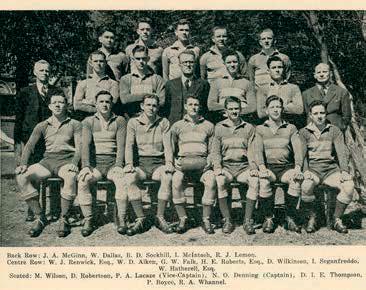
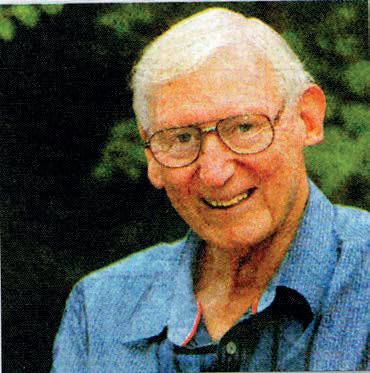
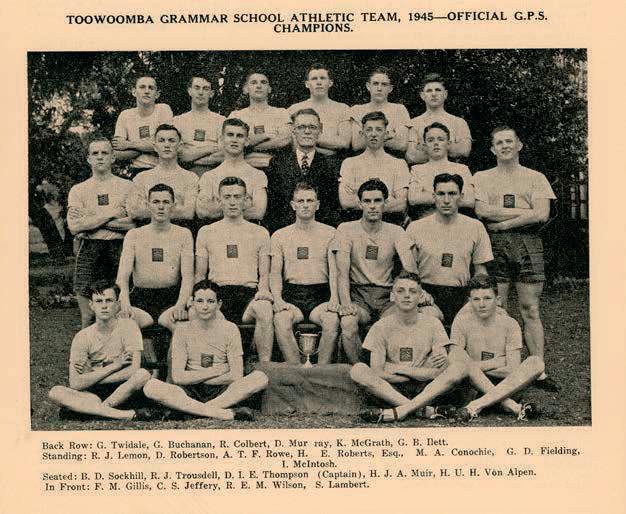

Chairman of the Board of Trustees: Mr Leslie A.G. Boyce (in his 2 nd year)
Trustees: Mr Jack Demaine advised the Chairman of the Board that he tendered his resignation as Government Representative of the Trustees to the Director General of Education owing to his transfer away from Toowoomba. He was succeeded by Mr James Smart whose son was an Old Boy of the School (James A.J. Smart, 1940-1943).
Headmaster: Mr Roberts (later Dr Roberts) resigned in March to take up the appointment of Headmaster at the Brisbane Church of England School (‘Churchie’) at the beginning of the next year. Mr Roberts was the last of the Headmasters of Toowoomba Grammar School who, with his wife, ran the boarding house as a private undertaking. Dr Roberts was Headmaster of ‘Churchie’ from 1947 until his retirement in 1969. An Obituary for Dr H.E. Roberts appeared in the 1984 TGS School Magazine, page 144.
At the March meeting of the Board of Trustees it was decided to advertise the position of Headmaster in the Brisbane Courier Mail, Sydney Morning Herald, The Melbourne Age and other papers if thought necessary, the wording of the advertisement to be left in the hands of The Chairman and Messrs Jones and Duggan. It was also decided that the salary grade be from 750 pounds to 900 pounds with lodging but not board. At a subsequent Board meeting it was reported that 35 applications were received for the position of Headmaster.
Deputy Headmaster: Mr ‘Len’ T. Heenan (in his 9th year)
Senior Prefect: Phillip A. Lacaze
Dux of Year: Norman ‘Alan’ Walker (who won 1st place in the Open Scholarship to The University of Queensland, the School’s fourth boy to win this honour). In later years as a Professor, Norman Walker became Director, Centre of Plant Membrane Biology at The University of Adelaide and Flinders University, South Australia. Later still he was Professor of Biology at Sydney University.
Total School Enrolment: 364
Number of Dayboys: 184
Number of Boarders: 180
Staff:
• In May 1944 Mr Hatherell had been appointed as Second Master during Mr Heenan’s absence on Military duties with the RAAF. In February 1946 the Board of Trustees decided that Mr Heenan be reinstated in his previous position as Second Master.
Students:
• The School Prefects were Phillip Lacaze, Peter Boyce, Ronald Clough, Geoffrey Ilett, Thomas Mulherin, Duncan Robertson and Blain Todd.
• There were three Open Scholarship winners to The University of Queensland – Norman A. Walker (1st in State), Geoffrey R. Watson (8th in State) and Charles ‘Steele’ Haughton. The next year in which a TGS student was to be awarded top of the State in the Senior Public Examination was in 1954 (David G. McAdam).
• Of the 180 boarders this year, 42 of these came from Brisbane itself, 44 from north or west of Rockhampton and 33 from the north or south coast or its immediate hinterland.
• James M. Croker (1942-1946) went on to have a distinguished career as a Dental Surgeon. He was the President of the 24 th Australian Dental Association Congress, President of the Australian Council of Professions (1982 -1983) and World Consultant of the Federation Dentaire Internationale (1978-1984). Dr Croker is acknowledged on the Old Boys’ Wall of Achievement and he received an Australia Day Honour for service to the Dental profession. An Obituary on James ‘Jim’ Croker, AM appeared in the School’s Omnibus publication, Vol.30, No.2, August 2019, pg.22.
• Reginald R.R. Pascoe (1943-1946) became an internationally renowned equine specialist. He was appointed Adjunct Professor in the School of Veterinary Science and Animal Production at the University of Queensland in 1998 and is acknowledged on the Old Boys’ Wall of Achievement.
• A further inclusion on the Old Boys’ Wall of Achievement from this year group is Peter N.F. Porter (1943-1946). In 1951 Peter moved to England, where he had published 15 collections of poetry as well as a number of collaborations with the noted Australian artist Arthur Boyd. Peter Porter’s reputation and achievements in poetry were substantiated in 2002 when he won the prestigious Queen’s Medallion. In 1999, whilst being interviewed for an article which later appeared in the Sunday Times, he described his boarding years at the School as “not very far from Auschwitz. In fact, I’m sure some people did not survive it. They are probably buried in the grounds.” Despite this comment, Peter Porter felt sufficiently loyal to the School to return in 2003 and spoke to the boys about life, poetry, art and schooling. He also attended an Old Boys’ Reunion in London in 2008 and his photograph, together with Brian Carne (1942 -1945) and Headmaster Hauser, is included in this year’s entry.
• Gordon Pryor (1945 -1946) was a member of the Queensland Gymnastics Squad in 1954 which won the Inter-State championship. Also, part of the team was Colin Morwood (see 1947).
• Peter C.R. Boyce (1943-1946) was a School Prefect and was awarded Colours for four major sports – Swimming, Rugby, Cricket and Tennis.
• Ronald Moller won the Belford Prize in this year.
• Norman Thomson (1946) was the youngest son of Francis Lewis von S tieglitz (TGS 1899-1902). Francis changed his name to Thomson when he was a member of the AI F. Details of the link of a total of 12 Old Boys through the von Stieglitz family are found on pages 162 -163 of John Winn’s book Still Playing the Game – A History of Toowoomba Grammar School 1875 -2000. Norman Thomson attended the School for only one year before a family relocation to Lake Macquarie. He obtained his Masters degree in Agricultural Science from the University of Western Australia in 1964 and a Doctor of Philosophy (Ph.D ) from the University of New England in 1972. In that year, ‘Norm’ was appointed as Officer in Charge of the CSIRO Cotton Research Station in Narrabri, retaining that position until he retired in 1994. Dr Thomson was made a Member of the Order of Australia (AM) in the Australia Day Honours, for services to Primary Indust ry, particularly in the growing of cotton.
• John Zupp (1945-1946) in 2007 sold his chain of 32 car dealership franchises to Automotive Holdings Group for $117 million. At one stage the franchises were employing almost 800 staff.
• Murray Prior (1944 -1946) attended a Toowoomba Grammar School Old Boys’ Reunion held at Bond University on the Gold Coast in May 2017. He was 87 years of age and the oldest Old Boy at the function. He recalled Headmaster Roberts announcing to the School in an Assembly in Old Hall in 1945 that War had ended. The boys had the rest of the day off school.
• Tom Hoey (1945-1946) and his wife were, in 2014, continuing their missionary work in Mougulu, New Guinea, with the Bedamuni people.
• Keith R. Barnes (1943-1946) was an Obstetrician and Gynaecologist. He was appointed a Member in the General Division of the Order of Australia in recognition of his work with the local and federal Australian Medical Association.
• N. ‘Alan’ Walker (1943 -1946) retired in 1993 as Challis Professor in Biology at th e University of Sydney after making significant contributions to the understanding of plant biophysics.
• Joe Ironside (1944-1946) was in the first Gymnastics team that the School entered in the GPS competition this year. At this time the School had no indoor gymnasium and some very primitive gymnastic equipment was erected outdoors. A photograph of Joe jumping off the roman rings and ‘Col’ Morwood (1944-1947) standing in the foreground is included in this year’s entry.
• In the Headmaster’s Annual Report, Mr Roberts was rather direct in stating: “The results this year will not be so good, either in the Senior or the Junior, possibly because ability seems to come in cycles. The Sixth Form was very ably led but contained quite a few without much academic ability.”
Events:
• Unveiled in November was the academic honours board in Old Hall, presented by Mr and Mrs Dowse in memory of their son, Sergeant -Observer Ralph K. Dowse (1929 -1930) RAAF who was killed in action in Egypt in May 1941, aged 25 years The Ralph Kell Dowse Memorial Honour Board was to contain the name of University Scholars, Rhodes Scholars and Byrnes Medallists (see 1941).
• The Board of Trustees decided that the air raid shelters in the front of the School needed filling in.
• In May a small fire damaged a locker room, its ceiling and some personal items belonging to students.
• The Chairman, Mr Boyce, referred to the necessity for structural improvements and development of the school buildings and work to be done in the grounds. He acknowledged the impact of the war and the shortage of building materials preventing doing much of this work for a long time. During the year the Board of Trustees commissioned Dr K.A. Langer from Brisbane to prepare a long-term plan for the eventual development both of the school buildings and school grounds. A complete contour survey of the grounds and architectural plans of the existing buildings had also been obtained. In the following year the new Headmaster, Mr Griffiths, calculated the number of trees needed to carry out part of Dr Langer’s plan to be 306, of which 93 would be mainly for wind-breaking, and 213 for ornamental purposes (see 1947).
• An advertisement featured in the annual School Magazine of this year promoting the delivery of fresh milk twice daily to all parts of Toowoomba (see photograph of this advertisement in this year’s entry).
• At the Old Boys’ Association (OBA) annual dinner, which Headmaster Roberts attended, various tributes were paid to his outstanding work throughout the years. The President of the OBA, Mr Albert Brinkworth, proposed the toast ‘The School, the Headmaster and Trustees’. Mr Brinkworth said: “When I was at school, Mr Barbour had been Headmaster, and I thought then that the School would never get a Master to equal him. He had set a high standard. Now I can say the School has had a Headmaster who has lived up to that standard – Mr Harry Roberts.”
Co-curricular Activities:
• In Athletics, the School Magazine stated: “It was obvious on Sports Day that, though the keenness for Athletics was marked, the absence of outstanding performers gave us no prospect of retaining the GPS Championship which we won last year. And so it was.” The TGS Athletics team was placed 7th in the competition and BSHS won its first GPS Championship in Athletics. The Captain of the Athletics team was A.G. ‘Tony’ Booth.
• In the School’s annual Sports Day was an innovative event called the chariot race. Six boys took part in each team. Three boys in front were the horses and two boys behind made the chariot, while perched on the rear boys' shoulders, and gripping the front boys with his hands, was the charioteer.
• In Cricket, the School’s 1 st XI team was placed 3rd in the GPS competition.
• Ray ‘Kit’ S. Carlson took 55 wickets in the GPS year, the greatest haul by any TGS 1 st XI bowler in one GPS season in the history of the School. This year he took 6 wickets for 36 runs against IGS; 7 for 45 against BGS; 6 for 23 against TSS; and 6 for 52 against CEGS (‘Churchie’).
• The 1st XI won five matches this year – against NC (by 67 runs on the first innings); GT (by 58 runs); IGS (35 runs); BSHS (8 runs) and TSS (outright win by 117 runs). BBC won by one run and BGS won by 23 runs.
• Downlands College defeated TGS in a cricket match this year.
• In Cross Country, when the Headmaster suggested that the students should have a cross country race involving a hazardous descent from ‘the Point’ and a speedy ascent of the old Toll Bar, almost the whole school – over 300 this year - decided to try it. The Headmaster in his Annual Report referred to this event and added: “… and only once, to my knowledge, did a group come home on the back of a truck!”
• In Gymnastics, the School entered a team, for the first time, in the GPS competition this year (see Joe Ironside and ‘Col’ Morwood in the ‘Students’ section of this year’s entry).
• In Rugby, the School’s football season, though not as successful as last year's, was a credit to the team. The 1st XV won five and lost three of thei r eight GPS matches and were placed 4th in the final competition. Some winning games included BBC (30 -8), BSHS (11-3), and, playing on the BGS oval, TSS (27-5). In the Southport match, William Aiken scored four tries. Brisbane Grammar School defeated TGS, 6-3.
• Four of the 1st XV represented the GPS side against the University – Michael Barnes, Garth Falk, Peter Boyce and William Aiken.
• In Swimming, this was the School’s first post-war swimming season. The team achieved 2nd place in the GPS Swimming championship. CEGS (‘Churchie’) won easily with 119 points and the TGS team swam very well to gain second place with 53 points from BGS finishing one point behind. William Aitken was Captain of TGS Swimming and he performed well in the open events Significant assistance to the School’s points total came from splendid performances in the Under 15 years age-group by Raymond Colbert and Martin Trenerry.
• In Tennis, the School’s 1st IV team won the GPS Tennis Premiership and maintained an undefeated record. The team comprised Percy (‘Perc’) Gaydon as Captain, ‘Charlie’ Moore (who captained the 1947-1948 teams), Alfred ‘Bryce’ Sturtridge and Peter Colin Rodney Boyce. ‘Perc’ Gaydon also won a Telegraph Blue for tennis, awarded due to his recognition of be ing the top tennis player in the entire GPS Association of Schools in this year. ‘Perc’ later represented the State in tennis and became a professional tennis coach for the School. ‘Perc’ Gaydon was the first of three Gaydons to be selected as Captain of Tennis, an honour also filled by brothers Mervyn in 1951 and 1952 and Graham in 1954.
• ‘Perc’ Gaydon’s award of a Telegraph Blue was a rare event. Only a handful of other Toowoomba Grammarians were to become recipients of a Telegraph Blue until the discontinuation of the award in the 1980s (see 1952).
• In Drama, two one-act plays were performed in the School Hall (Old Hall) in September – A Night at an Inn and Rory Aforesaid. Several private dramatic performances were held at the School this year and the next.
Downlands Competition:
• In the annual swimming competition between TGS and Downlands College the result was a tie.
• The Downlands College 1st XI cricket team defeated the TGS 1 st XI.
President of the Old Boys’ Association: Mr Albert E. Brinkworth (for two years) and also in 1949-1951
Guest Speaker at the Speech Day & Prize-Giving Ceremony: Mr John W. McCracken – QLD Public Service Commissioner
As was the custom of the day, the Chairman’s Address and Headmaster’s Report were reprinted in full in the Toowoomba Chronicle and Darling Downs (DD) Gazette (Saturday, November 30, 1946). In the Chairman’s Address, Mr Boyce acknowledged the influence of the outgoing Headmaster, Mr Roberts. He stated:
“Toowoomba Grammar School has been very fortunate in its Headmasters, and Mr Roberts’ name stands high among them. He came to the School at a time when its material fortunes were at a pretty low ebb. Like all the rest of Australia, the School was only just beginning to feel its way out of the great financial depression of the early ‘thirties. Under his hand the School has grown in numbers amazingly, and both scholastically and in the field of sport, has piled up a tremendous r ecord of successes, but I feel that the greatest achievement of Mr Roberts’s term is the way in which the spirit of the School has responded to his influence.”
In the Headmaster’s final Speech Day Report, he concluded his Address using the analogy of the School to that of a sailing vessel:
“And now I think, the old ship is safely in port after her seventieth voyage. She is a very noble ship, good in all weathers. She needs some material repairs; some of these I had hoped to see effected, but I know you will lend a willing hand when the time is ripe for these repairs. I know too that you will welcome her new captain and make him proud to be in charge of such a fine ship. There is a lot of good sailing in her yet. If you set out to make his voyage as happy as mine has been I shall be very grateful. He will have good officers and a good crew to help him sail her. And may fair weather ever be her lot! Thank you once again. Goodbye and good luck to you all.”
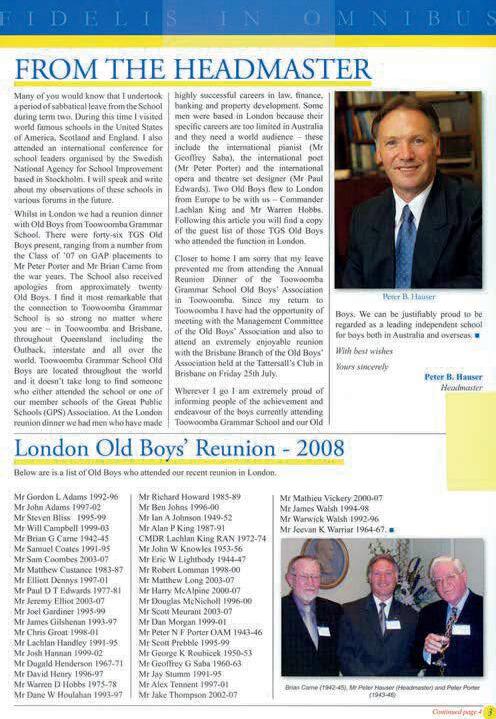
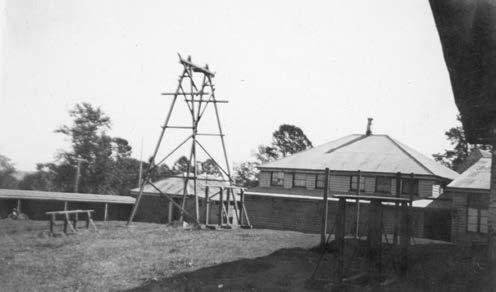
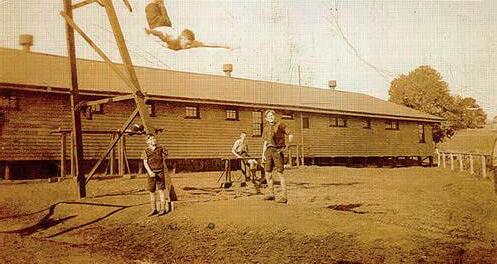

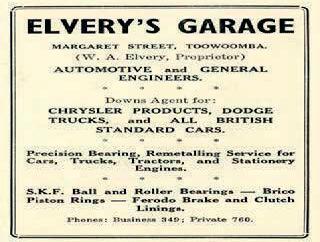
Chairman of the Board of Trustees: Mr Leslie A.G. Boyce (in his 3rd year)
Trustees: Messrs Leslie A.G. Boyce; Cliff E.J. Richards; Mervyn W. Baynes; James T.S. Smart; Jack E. Duggan, MLA; Dr Hector G. Jones; and Brigadier-General James C. Robertson. The Secretary to the Board was Thomas H. Ludgate.
Headmaster:
• Mr David Griffiths (the ninth Headmaster) commenced in January (aged 43 years). He had been First Assistant Master (Deputy Headmaster) of the Scots College, Bellevue Hill, Sydney. He was an academic and held wide cultural interests, sporting activities, pu blications and was also a Major in the Armed Services. Mr Griffiths left the School at the end of the year and returned to Sydney to lecture at the Sydney Teachers’ College. Mr Griffiths was the second Headmaster of Toowoomba Grammar School to have previously been Deputy Headmaster of the Scots College, Sydney, following Mr ‘Harry’ Roberts previous professional background. Interestingly, as Mr Griffiths departed Sydney Scots, he was replaced by TGS Old Boy William G. (‘Bill’) Rankin (19181922). Another connection with Scots College, Sydney, occurred when Mr Anthony (Tony) J. Rae transferred from Scots to become the Senior Master (Deputy Headmaster) of Toowoomba Grammar School in 1959. Other links between TGS and Scots College included Old Boy John Maltman (1927-1928) and former TGS staff member between 1929 -1933, Mr Rhys Jones, teaching at Scots. In addition, a TGS Old Boy, Ernest A. Walker (1897 -1898) was on the Scots College staff for more than thirty years.
• In October of this year a special meeting of the School’s Board of Trustees was held. The Chairman stated that the meeting was called to “ discuss various complaints which had been made to the Trustees, or have come to their knowledge from various sources, about the conduct of the School” . After a very long discussion, it was resolved that the Chairman acquaint the Headmaster of the various complaints which had come to the knowledge of the Trustees, and that he, Mr Griffiths, be requested to meet the Trustees after the close of the ordinary business of the monthly meeting on Friday, 31 October 1947.
• Upon Mr Griffiths’ departure from the School he was presen ted with a beautiful silver tea-set with the TGS crest on each item. In a touch of serendipity, nearly seventy years to this day, in 2017 the tea-set was in an antique shop in NSW (see 1961 and 2017) and returned to the School where it is housed in the School Museum (see 2017).
Deputy Headmaster: Mr ‘Len’ T. Heenan (in his 10 th year)
Senior Prefect: Brian W.L. Chapple and then George D. Fielding
Dux of Year: Allanby G. Woolley
Total School Enrolment: Enrolments dropped to 311
Number of Dayboys: 145
Number of Boarders: 166
Staffing:
• Mr Robert ‘Bob’ Partridge joined the School initially as a Junior Clerk. He had been working at the accounting firm Ludgate and Ludgate which had been attending to the School’s accounts. In 1950 he was appointed as the Board of Trustees’ Secretary. At that time he was only the sixth Secretary to the Board in the then 110 years of the Board’s existence. Mr Partridge was an Old Boy of the School (1942-1943) and later, in 1972, was honoured with Honorary Life Membership of the Old Boys’ Association. His significance to the School was such that when the sporting Houses were reorganised, one of the new Houses created was then named for him. Mr Partridge held the position as Secretary to the Board of Trustees until his retirement in 1984.
Students:
• The School Prefects were Brian Chapple, George Fielding, Glen Buchanan, Eric Lightbody, Beverley ‘Bev’ Mayes, Charles Moore, Douglas Murray and Alfred Sturtridge. A photograph of the School Prefects is included in this year’s entry.
• Colin H. Morwood (1944-1947) is acknowledged on the Old Boys’ Wall of Achievement. He was the sole University Open Scholarship winner for the School in this year, a member of the School’s senior gymnastics team and from 1953 to 1955 inclusive represented Queensland at the national gymnastics titles. Later he was to represent Australia and the sport as a judge at two Olympic Games – Melbourne in 1956 and Rome in 1960. Colin Morwood also contributed significantly to the work of the Old Boys’ Association and to the coaching of the School’s students in gymnastics in the 1950s. He was later, in 2016, honoured with Life Membership of the Old Boys’ Association. (see 1952). In the early 1960s Colin was describing to his old school contemporaries how his use of the electronic computer assisted his own calculations relating to the spacing of transmission poles. In his professional career as an electrical engineer ‘Col’ oversaw the Statewide electricity transmission for the Queensland State Electricity Commission. Col was awarded an Order of Australia (OAM) medal for service to gymnastics and the community. He was the guest speaker at the TGS OBA annual dinner in 1987 and an article summarising Col’s life featured in the newspaper lift-out magazine Q Weekend, August 28-29, 2021, page 13 when Col was aged 91 years. He passed away in 2023.
• Barry G. Downs (1946 -1947) rose to international status in pistol shooting and represented Australia in the Mexico City Olympic Games in 1968. Dr Downs is also acknowledged on the Old Boys’ Wall of Achievement.
• A Cadet Under Officer in the School’s Cadet Unit this year was Glen Buchanan (1944-1947). Later, two of his sons (Duncan and Peter) were appointed Cadet Under Officers , and a grandson and granddaughter followed as Senior CUO’s in the Cadet Unit (see 1978 and 2007) . An Award presented each year at the School’s Speech Day and Prize Giving Ceremony is known as the ‘Glen Buchanan Prize For Overcoming Adversity With Courage and Dignity ’ as initiated by Dr Glen Buchanan.
• Captain of the Athletics team, Antony G. Booth (1943-1947) went on to win the State 100 yards Championship in 1949 and again in 1950 when he clocked the excellent time of 9.9 seconds. Later, in 1955 and 1957, he won the State 440 yards titles. His service to track and field athletics as an athlete, coach, manager and administrator at state, national and international level is acknowledged on the Toowoomba Grammar School’s Wall of Achievement. Mr Booth went on to teach Physical Education at ‘Churchie’ from 1 956-1979 and coach athletics at Brisbane Grammar School from 1990-2002. ‘Tony’ Booth was awarded OAM, the Medal of the Order of Australia, in 1994 recognising his service.
• James K. Armitage (1944-1947) was later to lecture in Law at the University of Queensland.
• Peter G.W. Ford (1943-1947) was one of Queensland’s longest practising Dentists, with 52 years' service, firstly at Charleville and then for the last 31 years at Oakey. He also spent 2 0 years as Honorary Dentist with the Royal Flying Doctor Service. In Peter’s boarding days (1943-1947) he had early ‘escapes’ from the School to ride trackwork at the Clifford Park racecourse. His son, Ross Ford (1972-1977) also attended the School.
• The Third Form in this year displayed a remarkable level of solidarity and commitment to retaining their Old School ties post leaving school. Led predominantly by Sydney John Gardner (1947 -1950) this group held reunion dinners to celebrate their 50 th, 60th and 70th year reunions (see 1950 and 2017), together with annual get-togethers. A photograph of the gentlemen attending their 60 th anniversary dinner in 2007 is included in the 1950-entry. A photograph of their 70th year reunion taken in the School’s Old Hall in 2017 is included in this year’s entry.
• Gary Cleveland (1943-1947) was awarded an AM (Member in the General Division of the Order of Australia) in the Australia Day Awards 2011. Gary is the Founder and Director of the Tasmanian Wood Design Collection 1991 -2002 and Founder of the Design Centre Tasmania since 1976. He was also the inaugural Secretary of the Australian Academy of Design in 1989.
• E.C. ‘Bunny’ Powne (1944-1947) was elected as the Isolated Children’s Parents’ Association (ICPA) Queensland Branch Foundation President in 1971. He attende d the ICPA State Conference held at Toowoomba Grammar School in October 2013. ‘Bunny’ Powne was awarded an MBE in the Australia Day honours in 1977.
• Senior Prefect, Brian Chapple, was replaced during the year and another Prefect, George Fielding, was given the responsibility of Senior Prefect. George Fielding continued in this role as Senior Prefect in the following year (having repeated Sixth Form, as was often the case in those years) (See ‘Students’ 1948).
Buildings:
• The Trustees installed (with Department of Army financial assistance) a resident caretaker, Mr J Woodford, in the military building which faced Margaret Street. His duties involved general patrols in the grounds, including being responsible for the security of buildings such as the army huts. When the army huts were removed later in this year, Mr Woodford shifted into a rough corrugated iron shed which was built and furnished for him by the School (and later demolished in 1963). It occupied the site which now houses the Woodford Changing R ooms which were built in 1974.
Events:
• From the beginning of this year the School’s Board of Trustees assumed responsibility for the finances and management of the Boarding House. Up until this time it was the Headmaster who was responsible for the total financing and management of the boarding house (see 1935).
• In October, the Board of Trustees agreed that the School launch an appeal for the 75 th Anniversary and War Memorial Fund.
• A two-horse mower and a one-horse rake were purchased at a total cost of 29 pounds. The groundsman enlarged the old hay -shed to shelter the mower. The Headmaster reported: “The top paddock, at the corner of Herries and McKenzie Streets, is planted with Rho des grass, and in excellent condition for use as a grazing paddock, except that it has no water. I should like to find out whether it would be practicable to move the now disused horse -trough from the lower paddock, by the drive, to this upper paddock. At present the horse has to be kept in the only paddock which has water in it; and this is too close to where boys go in and out of gates during the weekend.” In July the Headmaster commented that: “Mowing at the School has been held up because the additional horse which Mr McPhie got for the School died two days after delivery.”
• A new washing machine for the Laundry was ordered and “is on its way from Brisbane”.
• The Headmaster introduced public speaking as an activity for the boys and stated: “I should like to develop this side of the school activities, partly as practice in public speaking, partly to improve the standard of spoken English, which in my opinion is very low in the School.”
• Regarding homework, the Headmaster wrote to the Board in July stating: “Dayboys do less well than boarders, on the whole. I have come to the conclusion that the difference is largely due to neglect of Home Work. At the end of last quarter I circulated with the reports a Home Work timetable, giving two hours properly apportioned between subjects, as the minimum for a night’s work, and asking parents to co-operate with us in this respect.”
• On one occasion the Headmaster brought to the Assembly the ‘bird’s-eye-view' of the new school layout as seen by the Architect, Dr Karl Langer (described in the previous year’s entry). The plan created much interest.
• The Headmaster reported that during the year the School was using a lot of boy labour in serving and washing up, and he would like to get some labour -saving devices if possible to help in this matter such as a dish-washing machine and drying racks. He also had in mind an electric warmer for keeping meals hot and stated that he would like to get a potato-skinning machine.
• Twenty-three Old Boys in Northern Queensland attended a Townsville Branch of the OBA reunion function in August.
Co-curricular Activities:
• In Athletics, see Antony ‘Tony’ Booth in the ‘Students’ section of this year’s entry. At the GPS Athletics Carnival the School’s senior team which was fairly strong met very good opposition. BSHS won the GPS Athletics Championships and TGS was placed seventh.
• In Boxing - In addition to the more traditional sports, boxing was re-introduced which had possibly not have been previously available for 25 years. A Toowoomba All -Schools’ Boxing Tournament took place in September organised by Mr Duncan Thompson and twenty -five boys from the School took part.
• In Cricket, the 1st XI Cricket team experienced only one defeat (by CEGS – ‘Churchie’) in the official GPS fixtures which were spread over the traditional split season in Terms I and IV.
• The team was the runners-up in the GPS cricket competition (to BBC). This was du e to a drawn game against BBC due to a delay caused by overnight rain and missing an outright win against GT when play commenced late because of a delay encountered by the GT bus.
• In the 1st XI match against TSS, TGS bowler Ray Colbert took 5 wickets for 16 runs (see 1948).
• In August the Headmaster stated that he would like to get another concrete cricket pitch in the hollow near the remains of the old asphalt pitch, as he would like more boys to play cricket.
• In Rugby, the 1st XV team was placed 4th on the GPS rugby ladder. During the season the team was defeated by BSHS (the eventual Premiers) 18-11 and ‘Churchie’ (9-6). Winning games included IGS (12-0), BGS (9-5) and TSS (35-0) in which Robert Capper scored three runaway tries. Also during the season the team defeated a visiting team from Sydney, The King’s School (Parramatta) 8-6.
• In the 1st XV, William ‘Ian’ Hatherell and Brian Chapple gained selection in the combined GPS team that was narrowly beaten by University.
• A photograph of a rugby game being played on what is now known as Barbour Oval is included in this year’s entry. In the photograph the grandstand is shown, which four years later was to be demolished (see the ‘Events’ section in the 1951-year entry).
• In Rugby, the junior teams were classified by weight, for example, the Under 7 stone, 7 pound XV and the Under 6 stone, 7 pound XV.
• In Swimming, the All-Schools Swimming Carnival was held at the Valley Baths in March. The TGS team came 7th and faced very strong competition from the Brisbane schools.
• In Tennis, the 1st IV Tennis team won the GPS Premiership for the second successive year. The team was captained by ‘Charlie’ Moore, one of the great all-round sportsmen from this era. ‘Charlie’ also captained the 1st IV Tennis team in the following year. Other team members were Thomas Ahearn, Alfred (Bryce) Sturtridge and Peter Harvey. The team went through the season undefeated, winning 61 of the 64 rubbers they played. The tennis team was coached by Mr Heenan and a photograph of the Premiership winning team is included in this year’s entry.
• The Life Saving Club was producing fine results with 30 boys gaining awards, the Camera Club was revived, the Public Speaking programme was enhanced, the Dramatic Club presented three one-act plays in Old Hall, the Music Club flourished and the Magazine Committee maintai ned a high standard of work. A dancing class was also revived after a lapse of several years, thus resulting in dance evenings at both Fairholme and Glennie on a rotational basis.
• In Cadets, almost every boy in the School was a member of the Cadet Unit.
• In Drama, the School produced its first three-act play, ‘Badger’s Green’, in the Town Hall over two nights in May. This was in aid of the TGS War Memorial Fund.
• In Music, in the new Headmaster’s first Report to the Board of Trustees, Mr Griffiths reported that the music facilities were very poor at the School and he would like to purchase a secondhand piano in good order so that the boys taking up music would be able to have some practice. Mr Griffiths wrote: “Music, apart from its great value in itself, is a subject which many boys desire to take for examination. At present there is only one piano, of very poor quality , in the Assembly Hall. Obviously, it is impossible to do anything adequate under these conditions and I have been disturbed at the attitude of contempt for fine music which appears to have grown up among some of the boys. If conditions can be improved, and music learning can be treated as an honour, this will improve.”
• The School’s Swimming team defeated Downlands College in their annual meet at the City Baths.
Guest Speaker at the Speech Day & Prize -Giving Ceremony: The Honourable Jack E. Duggan – QLD Minister for Transport. For the first time in 24 years, rain marred the outdoor 28 November Speech Da y celebrations with the large gathering quickly relocating to the Assembly Hall (now Old Hall) which was filled to capacity.
In the social column of the local newspaper, the Toowoomba Chronicle and D.D. Gazette, the attire worn by the Headmaster’s wife for the annual Speech Day was reported: “Mrs Griffiths wore a black tailored coat over her frock of aqua wool jersey, and her small black fluted hat, fashioned in aqua and black tonings, was finished with a bunch bow. Mrs Annand, who accompanied the Mayor, to pped her ice blue jacket suit with a darker hued coat, and her small hat of honey-coloured basket weave was set at the front with a stiffened bow. Mrs Duggan, who was presented with a bouquet in the school colours of blue and gold, favoured horizon blue wool sheer for her shirtmaker frock, which was worn with a navy sailor trimmed with blue bows. Mrs Gordon Chalk’s two-piece suit of Admiralty blue crepe was fashioned with a peplum, and her matching hat showed floral trimmings. Mrs L.A. Boyce, wife of the ch airman of trustees was in a mist blue suit offset with furs and a tiny black hat finished with an eye veil.”
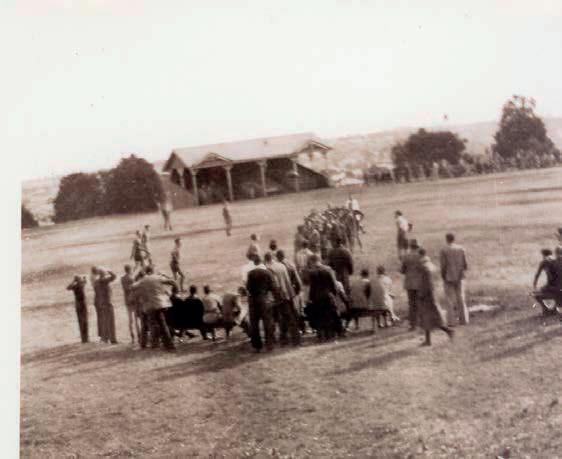
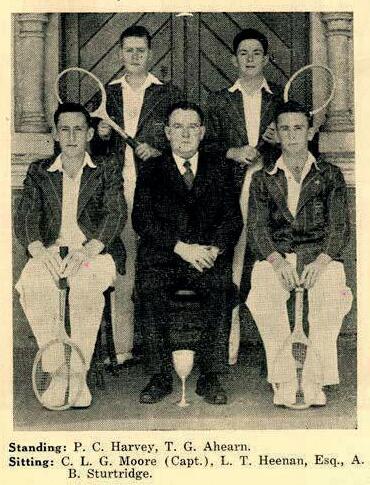

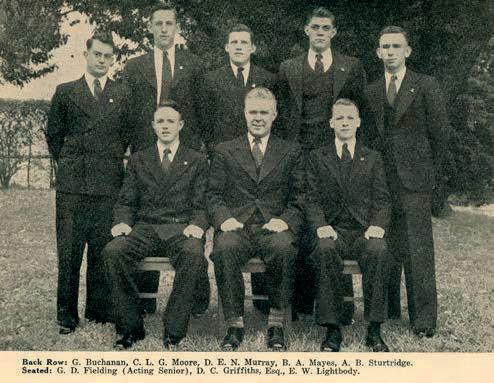
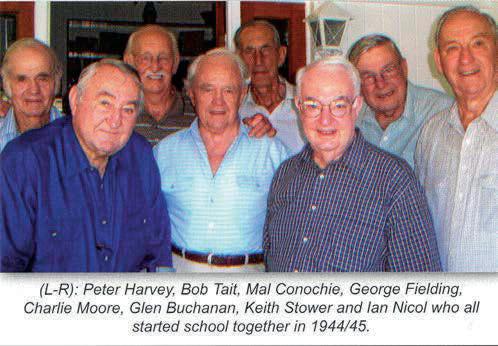
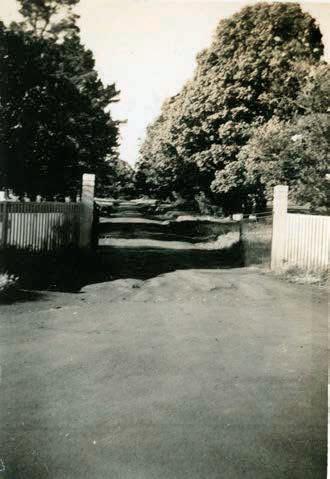
Chairman of the Board of Trustees: Mr Leslie A.G. Boyce (in his 4th year). Brig-General J.C. Robertson retired from the Trustees after 26 years’ service, including two periods as Chairman. He was succeeded by Trustee Mr Rowland J. Dunn.
Headmaster: Mr Robert L. Mills (the tenth Headmaster) commenced in January. He had previously been short-listed following Mr Roberts’ resignation. Mr Mills had been Headmaster of All Souls’ School, Charters Towers. Over the years Mr Mills was affectionately known as ‘Bidge’. Mr Mills was known to be just at all times and a firm disciplinarian; but his actions were tempered with clemency and understanding. Respect and affection merged in the minds of his pupils towards him. Mr Mills was to pass away in office from heart failure in January 1956 at 54 years of age (see the ‘Events’ section in the 1956 entry). Mills Oval is named in his honour and each year a student prize, the R.L. Mills Memorial Prize for an Exemplary Role Model, is presented at the School’s Speech Day and Prize Giving Ceremony. This Prize was originally titled the R.L. Mills Memorial Prize for Manliness in Year 12 (from 1956-2001) prior to its renaming.
Deputy Headmaster: Mr ‘Len’ Heenan (in his 11th year)
Senior Prefect: George D. Fielding (for the 2nd year) (See below and also 2017)
Dux of Year: Alan I. Battaglene
Total School Enrolment: 295
Number of Dayboys: 134
Number of Boarders: 161
Staffing:
• The death occurred of Mr T homas V. (‘Tibby’) Martin who had been a member of the teaching staff for more than 20 years and an Old Boy. Mr Martin was a Mathematics and Science teacher (see 1917).
• William ‘Bill’ Hatherell celebrated his 25th year on staff by coaching the 1st XV to a GPS Rugby Premiership (the School’s first since 1932).
• The School’s Senior Prefect in 1947 (from mid-year) and 1948, George Fielding, remembered Mr Heenan as an outstanding teacher of Physics and French. Mr Heenan’s affectionate nickname was ‘Pud’.
Students:
• The School Prefects were George Fielding, Alan Battaglene, Raymond Colbert, William ‘Ian’ Hatherell, James Laws, Malcolm Lemon, Donald ‘Ian’ Macmillan, Norman ‘Mick’ Madsen, Gordon McFadden, Charles Moore and Ian Nicol.
• Three students won Open Scholarships to The University of Queensland from only twenty then offered by the University – David E. Butters (6th in the State), Alan I. Battaglene (22nd in the State) and Malcolm S. Lemon.
• In later years William ‘Ian’ Hatherell (1944 -1948) briefly played rugby for Queensland and Australia before dental studies interrupted his representative career. Ian played two tests against Fiji in 1952 and was selected to tour South Africa in 1953 but declined because of his dentistry studies. He was the son of the Master-in-Charge of Rugby at the School ‘Bill’ Hatherell (who was on staff from 1924 to 1952) and captained the 1 st XV in this GPS Premiership year (and also captained the GPS Representative XV) ‘Ian’ also was awarded the Telegraph Blue for 1948 – the second time this trophy had been won by a member of the School. He is acknowledged on the Old Boys’ Wall of Achievement.
• Others in this year group who represented Queensland in Rugby included Ian Nicol, J ohn (‘Jack’) Seip, Treveren (‘Trev’) Liesegang and John Riley. An Obituary for Treveren Liesegang was printed in Omnibus, vol.27, no.2, August 2017, on page 29 and he is further acknowledged in the Rugby section of this year’s entry.
• Ray Colbert (1945-1948) was later to be acknowledged on the Old Boys’ Wall of Achievement as a Rugby Union International playing six tests for Australia. He represented Queensland in 1950 and 1951, New South Wales in 1952 and Australia in the 1952 tour to New Zealand. In 1953 he played in three of four test matches against South Africa, scoring 44 points on the tour. Ray Colbert was an outstanding athlete and also scored two centuries for the 1 st XI cricket team this year and took 48 wickets. Ray wrote an article which appeared in the 1953 School Magazine (pp.67-69) referring to his experience with the Australian Rugby Union team tour of South Africa (a four months’ tour in 1953). There were 500 people at Kingsford Smith Airport to farewell the thirty members of the tour. The Qantas flight stopped at Melbourne, Perth, C ocos Islands and Mauritius before touching down at Johannesburg. The Australian team’s win in the Second Test gave South Africa its first defeat since 1938 to an international team. The First Test had a record crowd of 75,000.
• Also being acknowledged on the Old Boys’ Wall of Achievement as a Rugby Union International from this year was Donald (Ian) MacMillan (1944-1948). He played two tests against the British Lions in 1950 and was only 20 years old when he first played test football.
• Another student from the Class of 1948 who has been included in the Old Boys’ Wall of Achievement is John B. Jones (1945 -1948). John Jones won a Fulbright Scholarship to Wisconsin University in the USA where he completed his Doctorate. After pursuing a Fellowship at Cambridge University in England he returned to Australia to become an Associate Professor in Mineralogy at the University of South Australia. He is acknowledged on the Old Boys’ Wall of Achievement in recognition of his Presidency of the Geological Society of Australia and as a world authority of the classification of gem opal.
• James ‘Jim’ Morris (1945-1948) took a Master of Agricultural Science degree and was offered a research scholarship to take his Ph.D. at Utah State University and he travelled to the USA on a Fulbright Scholarship in 1958. He was Professor of Animal Husbandry at the University of Southern California, USA.
• Geoffrey J. Price (1944-1948) became an Australian Diplomat and Ambassador to the Republic of Vietnam from 1974-1975. Very few Australian ambassadors have been called upon to close down their embassies as enemy forces advanced on the capital of the nation to which they were accredited. Geoffrey Price had this experience when he was Ambassador in Saigon in April 1975. After Saigon, he served as Head of Mission in Singapore, the Netherlands, Pakistan and Turkey. He also served in Washington in 1981 to 1984. Mr Price is acknowledged on the Old Boys’ Wall of Achievement.
• Peter D. Edwards (1945-1948) was later to be invited as the Guest Speaker at the School’s Speech Day and Prize Giving Ceremony in 1983 in his capacity as Professor of English at The University of Queensland. Professor Edwards in 1983 recalled to the Speech Day audience: “ TGS was a pretty rough and ready place when I first came here – overcrowded, short of staff and reduced to all sorts of makeshifts to keep its head above water. The War (1939 -1945) was still on in my first year, and boys were leaving school to join the forces as soon as they turned 18 or coming back to school after being discharged. There was a general air of restlessness, which must have made discipline difficult to maintain, and which perhaps made it harder than usual for boys fresh from the security of home to settle into the School. Enrolments were booming – partly because of parents wanting to get their children away from the coast while the threat of air -raids or attacks by midget submarines remained (or was thought to remain)…. Along with a number of other boys I spent my first term boarding with one of the Masters in his own house because all the dormitories at the School were full… The School basked in the reflected glory of the sporting and academic achievements and they helped to keep our morale in spi te of the ‘squirt’ system (now I hope a thing of the past), cold showers (ditto), and the remains of wartime ‘austerity’ (as it used to be called) especially the food rationing (including that miserable little speck of butter that we tried so desperately to make spread over two slices of bread).”
• Senior Prefect, George Fielding (1944 -1948) won the Belford Prize this year. He had a highly successful career in medicine and was awarded the Order of Australia Medal for “service to Medicine, particularly as a surgeon”. He was also President and Examiner of the Royal Australian College of Surgeons and in 1989 received a medal for his service to the College. In the School Museum is Dr Fielding’s 1948 Open Athletic Champion trophy he donated to the School. A major academic endeavour award in the School which is presented annually was named for Dr Fielding in 2017. Following his medical career as a surgeon, in retirement Dr Fielding returned to university to complete a Master of Philosophy degree, majoring in History. A copy of Dr George Fielding’s address to the Old Boys’ Association’s annual reunion dinner in 1998 appears in the ‘General’ section of this year’s entry. It is recommended as a ‘must read’ for all students of the School, both current and Old Boys. A photograph of Dr George Fielding features in this year’s entry together with the Senior Prefect of 2012, Madison Simmons.
• Malcolm A. (‘Bru’) Conochie tied for first place in the GPS Open high jump.
• Les Weis (1944-1948) wrote to Headmaster Hauser in 2020 describing that when he travels to Toowoomba from Brisbane: “The descent into the city via Margaret Stre et always gives me the opportunity of casting an eye over the School and the warm feeling comes again.” Les Weis sold his famous Weis ice-cream business to food giant Unilever in 2019. Les founded the business in 1957 when he began selling his Fruito bars in Toowoomba.
• Robert ‘Bob’ Tait (1944-1948) was awarded the Queen Elizabeth II Silver Jubilee Me dal by then Premier Joh Bjelke-Petersen in 1977 in recognition of his community work . He received an Australia Day Citizen’s Award in 1986, and an Outstanding Service Award in 1992 from the Queensland Health Department. ‘Bob’ owned a number of car dealerships in regional Queensland but made time to contribute significantly to the community. Bob’s three sons attended TGS –
David (1970-1974), John (1975) and Ross (1974 -1978). John, in turn, sent his two sons Matthew (2002-2006) and Andrew (2004-2008) to the School.
• Bruce McLay (1945-1948) was teaching at Scotch College, Perth, in the 1960s.
• Charles ‘Charlie’ Moore (1944-1948) was a School Prefect and an outstanding sportsman, Captain of the 1st IV Tennis for two years (1947 -1948), Captain of the 1 st XI Cricket for two years (19471948) and in the Swimming team. Charlie’s success in tennis is outlined in the Tennis section of this year’s entry. He was in the 1st XI Cricket team for four years and has been considered as one of the finest ever sportsmen to attend the School. Charlie Moore’s three sons all attended TGS –Graham (at TGS 1972-1976), Richard (1975-1979) and David (1978-1982) and grandsons. A photograph taken in 2015 of Mr Charlie Moore together with his wife, Mrs Elizabeth Moore, and their grandson Zach Moore (Year 12), is included in this year’s entry. An Obituary for Charles ‘Charlie’ Moore written by Ian Nicol (1945 -1948) was printed in Omnibus, vol.27, No.2, August 2017, pp.28-29. Further information on the Moore and Marwedel families is included in the ‘Events’ section of the 2011-year entry.
• A reflection on the life of Murray Symes (TGS 1944 -1948) was delivered by Senior Prefect, Dr George Fielding at Murray’s funeral in September 2004. Dr Fielding’s address is reproduced in the Omnibus school publication, vol.14, no.3, December 2004 , on page 20.
• John Saunders (1945-1948) became a Treasurer of the Brisbane Branch of the Old Boys’ Association. He retired from his position as Chief Electrical Engineer with the Department of Works in 1988 when he was responsible for over 100 electrical engineers, technicians and inspectors throughout the State.
• Mervyn R. McDonald (1945-1948) competed in many boating activities. He obtained his Grade 4 Master Mariners Certificate and, in 1994, with his son-in-law (Peter Byrne) set sail from Moreton Bay aboard a 50ft ketch in a non-stop ocean race to Osaka, Japan, which lasted 33 days.
Buildings:
• The Army huts which had been converted to classrooms were ready for occupation in January.
• A tuckshop at the School was opened.
Events:
• The School’s War Memorial Fund was symbolised by the unveiling of the Obelisk in the School Driveway with a plaque inscribed to the memory of those Old Boys who died in the Wars. The Obelisk is still present to this day. A photograph of the Obelisk is included in this year’s entry.
• This year was the last year in which the Margaret Street ‘Beresford’ boarding house was kept in operation.
• The tuition fees were seven pounds and seven shillings per quarter term. The boarding fee was seventeen pounds and seventeen shillings per quarter term.
• The Board of Trustees Report in May made reference to “the westerly wind which is said to be a trouble at the new class-rooms”.
Co-curricular Activities:
• In Athletics, the TGS squad came 7th in the GPS competition. Malcolm A. (‘Bru’) Conochie tied for first place in the GPS Open high jump at the GPS Track and Field Championships.
• In Cricket, the 1st XI team was, for the second successive year, placed 2nd in the GPS Cricket competition (to ‘Churchie’). A photograph of the 1st XI team is included in this year’s entry. This year saw the first time a TGS batsman scored three centuries since Ken Boag in 1933. Charlie Moore’s three centuries were 123 (Brisbane Grammar School), 118 not out (Nudgee College) and 116 not out (Brisbane State High School). No Toowoomba Grammar School batsman made a century in GPS cricket after 1948 until 1968. Charlie Moore’s (1944 -1948) GPS aggregate of just less than 1000 runs is second only to Ken Boag (1932 -1933). In later years Martin Love scored four centuries in a 1st XI season in both 1990 and 1991 and Ben Turner (2008) also scored three centuries.
• In addition to Charlie Moore’s three centuries in the 1948 season, Ray Colber t (1945-1948) scored two in the same season: 107 runs (not out) against Nudgee College and 107 runs against Brisbane Boys’ College (BBC). In this 1948 season, Ray scored 325 runs and took 7 for 31 against TSS; 6 for 20 against NC; and 5 for 38 against BGS. Ray was a School Prefect and represented the School in four Open 1sts teams – Rugby, Cricket, Athletics and Swimming. Ray Colbert went on to represent Australia in Rugby Union, playing six Tests for Australia (three in South Africa in 1953, two against New Zealand and one against Fiji) Raymond Colbert has been acknowledged on the Toowoomba Grammar School’s Old Boys’ Wall of Achievement.
• Bowler William (Bill) E. Lord (1947-1948) was in his second year in the 1st XI Cricket team whilst in Year 10. In just 15 GPS matches he secured 77 wickets at an average of 8.4 runs per wicket. Against Gregory Terrace he took 5 for 20; against IGS he took 7 for 18 in the second innings; against Nudgee he took 6 for 20; and against TSS he took 5 for 30
• In Gymnastics, both the School’s Senior and Junior teams came 3rd at the GPS Gymnastics titles.
• In Rugby, the School’s 1st XV Rugby team was undefeated GPS Premiers It is often argued that this team was the most successful XV in the School’s history (sc oring 173 points to 21 against in the GPS season with only one opposition try being scored during the season ). This compares to, say, the highly successful 1930 team which scored 182 points but had 27 scored against it. Only one school, Gregory Terrace, scored a try against them. A photograph of the 1st XV is included in this year’s entry.
• Seven of the 1948 1st XV team went on to State or International representation. Later the team was referred to as ‘The Invincibles’. The Captain was W. Ian Hatherell (194 4-1948) and ViceCaptain was Ian W.C. Nicol (1945-1948). The School has Mr Nicol’s GPS Premiership cap and also that belonging to Neil Schwartz in the School Museum. The 1950 75-Year Jubilee Review selected the 1930 Rugby team as the best of the 25 -year period to 1951, with 1948 an extremely close second. Others would argue that the 1948 Rugby team was the best in the School’s entire history. ‘King’ Renwick was quoted in the School’s Newsletter Blue and Gold in 1962 as recalling: “I rank the 1948 team as outstanding.” He placed Allan Kent (see 1906) and Jack Steggall (see 1925) (both Australian representatives) as the outstanding players TGS had produced and he recalled that Edwin Sautelle (‘Dooney’) Hayes captained an Australian side (see 1928), while Lyn Wood (see 1931) had the unique honour of captaining the Queensland team while he was still a pupil at TGS.
• The 173 points scored by the 1 st XV team during the GPS season represented the sixth highest points aggregate in the history of 1st XV Rugby at TGS – surpassed only by the teams of 2015 (243 points), 1940 (207 points), 1945 (192 points), 1956 (184 points) and 1930 (182 points).
• The total points scored against the 1st XV during the GPS season (21 points) was the lowest in the School’s history (followed by the 1930 team with 27 points scored against and 34 points scored against the 1945 team).
• The results of the 1st XV for the 1948 season were as follows: wins against NC (3-0), IGS (33-0), GT (18-3), BBC (48-3), TSS (31-3), BGS (11-6), BSHS (13-6) and ‘Churchie’ (16-0).
• In the 1951 School Magazine in an article titled “25 Years of Football” (at TGS) the author of the article expressed his comments on the ‘best’ TGS 1 st XV to this time. He wrote: “I am often asked as to the best TGS side since 1926. I place Lyn Wood's 1930 side ahead of Hatherell's 1948 fifteen. There was nothing between the two packs of forwards, but the 1930 team had more penetrative power in the backs. Next in order I place 1929 XV (Ian Horn), 1943 XV (Alan Lemon), 1932 XV (Bob Chester).” (see 1930).
• The 1st XV had been described as follows: “A hard-rucking team of forwards, with big, fast breakaways and a sound back line, with an excellent full-back and brilliant attacking wingers… the forwards were able to gain possession of the ball from most teams, and most of the tries were scored by the breakaways or outside backs.”
• One of the players in the GPS Rugby Premiership team was Ian Macmillan who represent ed Queensland in 1949.
• Another of the players in the GPS Rugby Premiership winning 1 st XV was Treveren ‘Trev’ Liesegang (1944-1948) In 2013 Mr Jono Farrell, in his capacity as Director of TGS Rugby, interviewed Mr Liesegang who commented on the coaches at the time: “King Renwick and Bill Hatherell coached me in 1948. They were top notch coaches who understood the game. They believed in being well prepared and knowing your role on the field. We were fortunate to be coached by King Renwick, or ‘Dingo’ as he was known. As a team we took pride in our dedication to our jobs on the field and we knew our roles. Renwick was a tough coach who instilled an appreciation for both mental and physical toughness in training sessions.” Mr Liesegang also referred to the joy of winning the Premiership. “We never really focussed on the results, we just played from week to week. Our biggest challenge was the game against BSHS; we struggled to beat them but ultimately managed to win that game. The celebrations were pretty quiet – a few donations came into the School to help us buy gear. We did receive an honour cap from the Old Boys and they also shouted a dinner in Toowoomba to celebrate the win.”
• Ater school ‘Trev’ Liesegang (above) completed a degree in Pharmacy and opened a pharmacy in Toowoomba. His son, Stephen, also attended TGS (1970-1975). Trev and his wife, Joan, purchased Gabbinbar homestead in Toowoomba, restored the building and lived there for 25 years.
• In this year’s 1st XV match against BBC, Robert Capper and Neil Schwartz scored four tries each in a winning match, 48-3.
• Thirteen members of the 1st XV Premiership winning Rugby team attended the Brisbane Branch Old Boys’ Association annual dinner in 1988. In the School Magazine of 1988 the re is an informative commentary on every player in the 1948 1st XV Rugby team (pp.184-185).
• Twenty-one members of the 1st XV and reserves travelled to Sydney during the year together with Mr Mills and Mr Hatherell. The tour group travelled by train via Warwick and Stanthorpe and at the NSW border at Wallangarra enjoyed a meal and joined the NSW train which was to be their living quarters for many hours. The boys commented that the size of Newcastle was “truly an eyeopener". Having departed Toowoomba on a Saturday, the boys arrived in Sydney on Sunday and stayed at the Y.M.C.A. in Liverpool Street. On Monday the boys trained at the Sydney Grammar School oval and on the Tuesday travelled to Paramatta to play the team representing The King’s School. This was the only Sydney-based game the boys lost during their NSW tour. The TGS 1st XV defeated Sydney Grammar School (13 -3). During the tour three key players, Colbert, Symes and Schwartz, were struck down in the ‘flu epidemic. Travelling to Canberra the boys were
transported by an army bus to the Royal Military College (RMC) where they stayed. In a game against RMC the TGS team was defeated (12-34). Following a tour of Sydney the boys returned home and an article in the School Magazine of this year concluded by referring to it as “the venture of a lifetime”.
• In Swimming, the School’s swimming carnival was held in the City Baths. During the GPS Championships many records were broken by other schools. The TGS School Magazine reported: “Each member of our team performed to the best of his ability, and only the high standard defeated us.” The TGS team was placed 7th at the competition. It appeared that the School had several good swimmers who did not receive enough support from the rest of the team.
• In Tennis, the GPS Tennis team Co-Premiers was captained once again by ‘Charlie’ Moore. In this season Charlie won all of his singles matches in the GPS competition (see ‘Students’ section in this year’s entry). In Charlie’s three years playing in the 1st IV Tennis team he played 24 games of singles, losing only one to Ian Ayre of ‘Churchie’. Ian Ayre went on to play Davis Cup for Australia. Charlie lost 5-7 and 8-10 so he gave Ayre a tough battle. In doubles Charlie only lost one game over three years to Nudgee in 1948 so he was instrumental in th e team securing outright GPS Premiers in 1946 and 1947 and sharing the Premiership with ‘Churchie’ in 1948.
• Also in the 1948 Tennis Premiership team were Evan Wright, John Francis and William Lord. Charlie Moore went on to win the Open University singles; Evan Wright won the University singles Under 19 title. A photograph of the premiership winning tennis team is included in this year’s entry.
• In Cadets, approximately 210 cadets attended the annual Cadet Camp. This represented 75 per cent of the corps and was the best representation that the School had experienced.
• The School entered two inter-school Shooting competitions and one Empire shoot, from which it gained two firsts: the Monarch Miniature Rifle Club Shoot and the GPS Competition , winning the GPS Shooting Premiership A second placing result was achieved in the southern division of Queensland in the Empire shoot. A photograph of the TGS Shooting team is included in this year’s entry.
• In Drama, the School produced its first three-act play in the Town Hall on May 28-29 in aid of the TGS War Memorial Fund. The play chosen was Badger’s Green, a comedy of English village life. The three leading characters were excellently played by Geoffrey Price (President of the TGS Dramatic Society), Syd Burstow and Lindsay Reath and very well supported by a large cast. Boys also played the female roles in this production.
Downlands Competition:
• The School won the annual swimming competition against Down lands College.
• The 1st XV rugby team defeated DC, 30 -3.
General:
Senior Prefect of the School in 1947 and 1948, George Fielding, was asked to provide the Toast to the School at the TGS Old Boys’ Association annual reunion dinner in 1998. At this function Dr Fielding recalled a luncheon he attended at the School in the previous year for students from the 1947 -1956 era. He said: “When I entered the Old Hall, after a lapse of many years, a wave of emotion came over me, for I felt that
I could reach out and touch a spirit of the past. I read the names on the Honour Boards and was filled with memories of those times past. How well I remember the morning, as though it was this morning, the late Headmaster, Mr Harry Roberts, with tears rolling down his cheeks, said to Bryce Sturtridge and me: ‘Oh Sturtridge, Fielding, fly the flag at half-mast; Wallace has been shot down and killed’. He was 21. I remembered the photos on the walls of those lost in the First World War, their faces hauntingly beautiful, as though saying ‘We also were young once’. As I drove home that afternoon, I questioned myself why I had been so affected. It was not nostalgia; it was the spirit or ethos of our school reaching out to touch me. I believe every great school has an ethos, a reason for its being. To our school, in a small, struggling country town, came boys whose fathers were building Queensland. They b rought with them a certain harshness and mixed with local Toowoomba boys whose parents also knew hard times. A boy had to act honourably, by word and deed, to realise that it was an honour to wear the blue and gold, to work hard for one’s goals and sometimes, despite trying desperately, a desired goal may not be won. Such a lesson in life was learnt early and expected to be borne in silence. As I came closer to home, on that cold October afternoon, I realised what the School had given me, its greatest legacy, the love of friendship. That, my friends, is its spirit, its ethos – friendship.”
President of the Old Boys’ Association: Dr Glen L. Buchanan (for one year)
Guest Speaker at the Speech Day & Prize-Giving Ceremony: His Excellency The Governor, Lieut. General Sir John Laverack
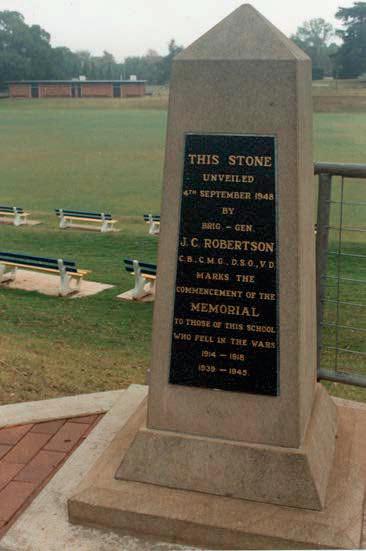

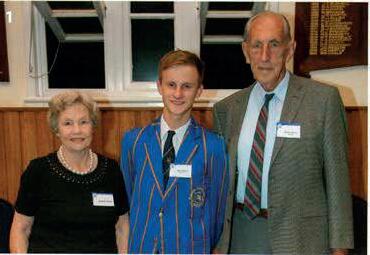
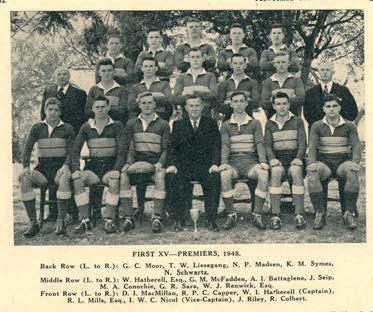
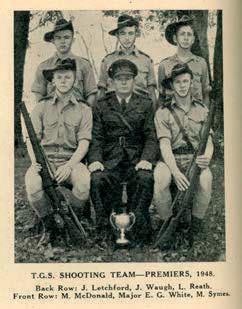

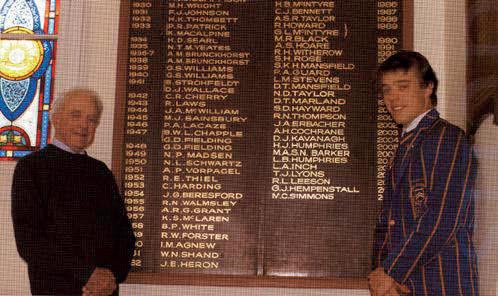
Chairman of the Board of Trustees: Mr Leslie A.G. Boyce (in his 5th year)
Trustees: Messrs Leslie A.G. Boyce; Rowland J. Dunn; Mervyn W. Baynes, Cliff E.J. Richards; James T.S. Smart; Dr Hector G. Jones and the Honourable John E. (‘Jack’) Duggan, MLA.
Headmaster: Mr Robert L. Mills (in his 2nd year)
Deputy Headmaster: Mr ‘Len’ T. Heenan (in his 12th year)
Senior Prefect: N.P. (Mick) Madsen
Dux of Year: Grahame G.C. Readshaw
Total School Enrolment: 232
Number of Dayboys: 102
Number of Boarders: 130
Students:
• The School Prefects were Norman ‘Mick’ Madsen, Jo hn Dunbar, John Hill, Barry Nielsen, Frederick ‘Martin’ Trenerry, Richard Sara, Neil Schwartz and Evan Wright.
• Three students won Open Scholarships to the University of Queensland for being in the first twenty-five in the State in the Senior Public Examination – Grahame W. Rogers (4th in the State), Grahame G. Readshaw (7th in the State), and David L. Morwood (24th in the State).
• The Senior Prefect, Norman (‘Mick’ as was his father) Madsen, was awarded the Belford Prize this year. Norman ‘Mick’ played in the GPS Rugby Premiership team of 1948 and in 1949 he captained the 1st XV and played in the 1st XI. He was the son of Old Boy Michael (‘Mick’) Peter Madsen (19141916) who was for many years a regular Australian League representative (see entry 1916). Dr Norman Madsen had a highly successful academic career after winning a Fulbright Scholarship to the USA to study at the University of Wisconsin. His career was in education as a Senior Lecturer in Biochemistry and Toxicology at Monash University in Victoria. An obituary for ‘Mick’ Madsen was printed in Omnibus vol.24, no.2, September 2014, page 27.
• Frank C.B. Haly (1948-1949) became a noted company chairman and business advis er. His commercial positions included the Chairman of the Suncorp-Metway Ltd (1995-1996) and various directorships. He was also the Queensland Chairman of the Australian Institute of Company Directors (1992) and Queensland Chairman of the Institute of Chartered Accountants (1997). Mr Haly received an Honorary Doctorate from the Queensland University of Technology as a member of Council and his service to the institution. Mr Haly was awarded a National Honour , an Officer of the Order of Australia (AO) and is acknowledged on the TGS Old Boys’ Wall of Achievement.
• Also acknowledged on the Old Boys’ Wall of Achievement is Gray ‘Buster’ P.D. McLean (19481949) as a Rugby Union International. He played for Queensland from 1957 to 1961 and in 1958 he toured with the Wallabies to New Zealand but he didn’t play in any tes ts. Two years later, in 1960, he played for the Combined Services team in Malaysia whilst stationed there in the RAAF.
• W. Vaughan Hinton (1948-1949) became the first National Secretary of the Australian Council for Overseas Aid, awarded the United Nations Media Peace Prize (twice), won the New York Festival major documentary prize and a United Nations Human Rights Award. Vaughan Hinton was an Executive Producer for the ABC and was responsible for conceiving and overseeing the program Compass. He is acknowledged on the Old Boys’ Wall of Achievement.
• Donald ‘Don’ Trenerry (1949-1952) in this year won a Telegraph Blue as the holder of the State 50 yard Under 14 swimming championship (see 1952).
• Rae S. Roberts (1946-1949) was made an Honorary Life Member of the TGS Old Boys’ Association in 2005. He had been an active member of the OBA and was a Past -President of the Brisbane Branch of the OBA.
• Grahame Readshaw (1946-1949) was later to become a Fellow of the Australian Coll ege of Ophthalmologists.
• Brian Hill (1946-1949) was a Specialist Gynaecologist and visiting Specialist to the Royal Women’s Hospital and the Royal Brisbane Hospital.
• Peter Roubicek (1946-1949) during his career was State Administration Manager and then Property Development Manager of Woolworths.
• David ‘Dave’ L. Morwood (1946 -1949) later qualified as an Engineer through his study at the University of Queensland. In 1985 he was appointed Chief Engineer and Director of Operations and Marketing with the Irrigation and Water Supply and Water Resources Commissions.
• Chris Hodgson (1946-1949) was present at the 1947 -year group’s 70 th Anniversary Year Reunion held at Gips Restaurant in 2017. At the function he donated to the School four generations of academic prizes awarded to the Hodgson family. A photograph of Chris Hodgson and his son , Richard, is included in this year’s entry.
• A photograph of Sydney ‘Syd’ Gardner (1947-1950: see 1947) taken in 2018 being presented with an Honorary Life Membership of the Old Boys’ Association, together with OBA President, Daniel Burrett (2001-2008), is included in this year’s entry.
Buildings:
• Between 1949 and 1953, the Headmaster’s residence was constructed, a new classroom block erected, a new laundry added and a memorial drive from Margaret Street laid out. New tennis courts were added, a new oval in front of the School was commenced and plans put in hand for a new Boarding House (Taylor) and a new dining room.
• A photograph of the Headmaster’s new residence on the School grounds is included in this year’s entry. Prior to the new residence, all Headmasters to this time (1877 -1950) lived in accommodation in the School House building.
Events:
• Plans were under way for Old Boys’ Memorial Oval.
• An epidemic of measles at the School occurred.
• Some trees were planted on Commemoration Day on 3 September in memory of the Old Boys who made the supreme sacrifice in the First and Second World War. Relevant to the planting of these trees, the photographs of two plaques are included in this year’s entry.
• The target for the rifle range was extended so that eight cadets could shoot simultaneously.
• Trustee Mr Richards suggested that it would be a good idea to have some drinking fountains erected in the grounds because at the time there was no place for the boys to drink.
• At a meeting of Head Masters and Head Mistresses held in Brisbane, it was decided to adopt the three term system, and the matter was awaiting the Co -ordinator General’s approval. (See 1951)
• Advertisements were placed in most of the small country papers regarding enrolments.
• At the September meeting of the School’s Board of Trustees it was noted that two typewriters in the Office were obsolete and a more up-to-date machine was badly needed. After discussion it was resolved to defer the matter until January owing to the present financial position.
• In early June the Granite Belt received slight to moderate drifting snow which was the heaviest in twenty years.
Co-curricular Activities:
• In Boxing, the main event in the boxing schedule was the Queensland Schoolboys’ Tournament, held in the Brisbane Stadium during the second term. The School’s team of eight produced four winners and a runner-up. The team finished as the Queensland Champion School in the tournament. A photograph of the boxing team is included in this year’s entry.
• In Cricket, the 1st XI achieved one win (against CEGS – ‘Churchie’) with three losses, a draw, and two matches washed out.
• The 1st XI game against TSS was played on BBC’s oval in the first fine weather Saturday in five weeks.
• TGS bowler John Wood took 6 wickets for 36 runs i n the game against CEGS played in Toowoomba.
• In Rugby, the 1st XV won three GPS matches and drew one of the seven matches played.
• The School’s 1st XV played NC in the curtain-raiser to the Queensland versus N.S.W. match in May (NC, 35 d TGS, 9) and met Brisbane Grammar School in the curtain-raiser to the Australia versus New Zealand match in June. This was again held at the Exhibition Grounds in Brisbane. In this match BGS (11) defeated TGS (6).
• The TGS 1st XV played TSS on the Brisbane Grammar School main oval and had a fine win, TGS (26) d TSS (0). The 1 st XV also enjoyed wins against IGS (35-8) and BBC (29-3), drew against CEGS (14 all) and lost to GT (8-14).
• The 1st XV rugby match against BSHS was forfeited by State High as they were unable to make travel arrangements due to a coal strike.
• In the annual match against Gatton College, the 1 st XV was defeated 3-18. The 1st XV also played Downlands College (see towards the end of this year’s entry).
• Neil Schwartz and John Seip gained representation in the combined GPS XV which played University.
• In Shooting, the School’s Shooting team was runners-up in the GPS Shooting competition for the Earl Roberts’ Trophy.
• In Swimming, the Captain of Swimming in 1948 and 1949 was Frederick ‘Martin’ Trenerry (19451949) who broke school swimming records in four Open school swimming events. In 1949 Martin’s brother Donald ‘Don’ Trenerry (1949-1952) joined the School and was also an outstanding swimmer, winning a Telegraph Blue award for his performance at the GPS Swimming Championships in this year and also in the following year. Don Trenerry broke six GPS swimming records in 1949-1950
• This year the TGS swimming team rose to 4th place in the GPS Championships, the majority of points coming from the Trenerry brothers.
• In Tennis, the 1st IV Tennis team won a consecutive GPS Tennis Premiership (captained by Evan Wright) with other team members Mervyn (‘Merv’) Gaydon, Noel Vonhoff and John Watt. The team was coached by the School’s Deputy Headmaster, Mr L.T. Heenan, and was undefeated during the season. A photograph of the Premiership winning 1 st IV Tennis team is included in this year’s entry.
• The tennis match against NC was the hardest and most exciting of the year. TGS won this match 5 rubbers to 3.
• The results of the remaining GPS matches, all won by the TGS team, were: BBC (6 rubbers to 2); GT (7-1); BSHS (8-0); BGS (7-1); IGS (7-1); ‘Churchie’ (7-1); and TSS (5-1).
• In the years 1925-1950 Toowoomba Grammar School won the GPS Te nnis Premiership nine times and tied for it once.
• In an article in the School Magazine of 1951 titled “25 Years of Tennis” the author(s) stated the following: “The best teams, we think, were those of 1940, 1938, 1947, 1932. The best player was Brian Strohfeldt. (TGS 1937-1940). In 1940 he won his eight singles matches in G.P.S. by 96 games to six, defeating the reigning Queensland champion in an exhibition match. After the war he won the Gold Cup Championship at Toowoomba, defeating two members of the Davis Cup squad and has been open champion of Queensland. His tennis career would have been exceptional had not the war intervened. Percy Gaydon (1942 -1946) also represented Queensland and has been open champion of Toowoomba. Alec Provan won his tennis blue at Sydney University. Alan Harris was Junior Champion of Queensland. Charlie Moore has been open champion of Queensland University, and Evan Wright the under 19 champion, whilst Harry Stark and Garnet Hills have represented the University in touring sides. Now there comes to mind a long list of top -notch players like Ron McDonald, Davies C. Munro, whom the war or pressure of business forced out of serious competitive tennis. Many other names could be listed, but those quoted should bring back pleasant memories to those who followed T.G.S. keenly, and for glaring omissions we crave the reader's indulgence.”
• In Drama, the school play The Late Christopher Bean raised 110 pounds for the School’s War Memorial Fund, the same amount as the previous year. The play, a three-act comedy, was performed on the last weekend of May. Mr Edgar White was the Producer and two lead performers were Graham Muller (1946 -1949) and Trevor Park (1946-1949).
Downlands Competition:
• The School Magazine reported that “Saturday, August 13th, saw the revival of the spirit of Downlands day, after being neglected for several years, and the six matches played showed the keen competition we are always sure of getting from Downlands. Although the School won five matches, nothing was achieved without a hard fight, and in the 1st XV match especially was seen interesting and at times brilliant football.” The TGS 1st XV defeated Downlands College, 16-8.
• The School won the annual swimming competition against Downlands College.
• Downlands College defeated TGS by one run in a cricket match during the year.
President of the Old Boys’ Association: Mr Albert E. Brinkworth (for three years) and also in 1946-47
Guest Speaker at the Speech Day & Prize -Giving Ceremony: The Honourable Jack E. Duggan – QLD Minister for Transport
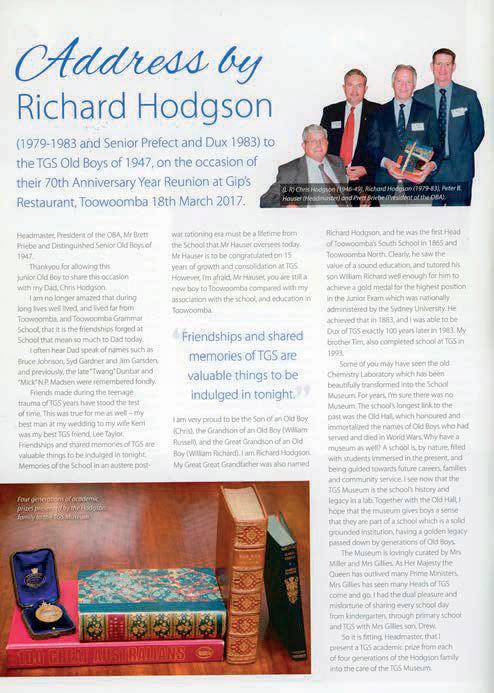
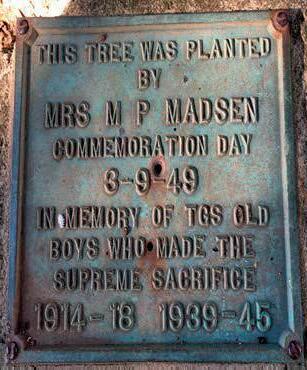

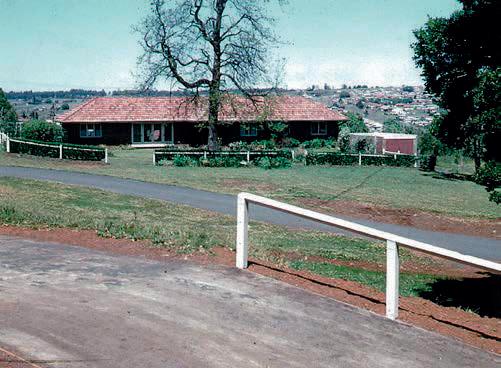
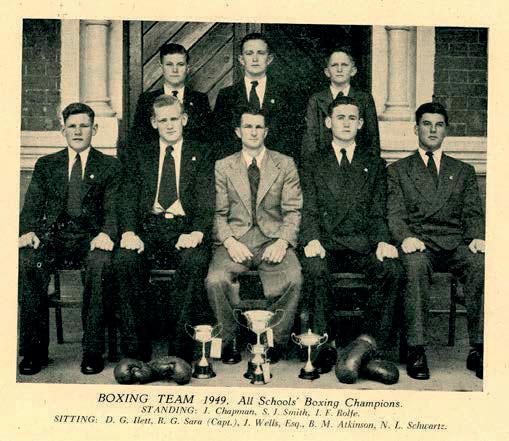

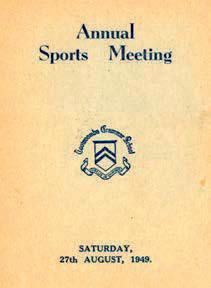
Chairman of the Board of Trustees: Mr Leslie A.G. Boyce (in his 6th year)
Trustees: Mr James T.S. Smart resigned in November due to ill -health. Old Boy Francis J. Hopkins (1919-1922) joined the Board. The other Trustees were Messrs Hector G. Jones, Cliff E.J. Richards, Mervyn W. Baynes, James T.S. Smart, Roland J. Dunn and the Hon. Jack E. Duggan.
Headmaster: Mr Robert L. Mills (in his 3rd year)
Deputy Headmaster: Mr ‘Len’ T. Heenan (in his 13th year)
Senior Prefect: Neil L. Schwartz (not only was Neil Schwartz the Senior Prefect but he was also Captain of Cricket, Rugby and Swimming in 1950 and Captain of Athletics in 1949)
Dux of Year: Evan L. Burge (see below)
Total School Enrolment: 237
Number of Dayboys: 94
Number of Boarders: 143
Staffing:
• The teaching staff this year comprised the Headmaster, W. Daunt, E. Harding-Jones, W. Hatherell, L. Heenan, W. Poulsen, N. Power, J. Reath, L. Scott, Miss D. Thomas, E. White and H. Whybird.
• Mr ‘Bob’ Partridge was promoted internally from a clerical position to be the Secretary to the School’s Board of Trustees. He held the position of Secretary to the Board of Trustees until his retirement in 1984.
Students:
• The School’s Prefects were Neil Schwartz, Gerald Bowman, Charles Coutts, John Craig, Sydney Gardner, James Garsden, Brian Gordon, Christopher ‘Russell’ Hodgson, Kevin McPhee, James McWhirter, Kerry Mulherin, Adrian Vorpagel and John Watt.
• A photograph of Senior Prefect, Neil Schwartz, and two other Prefects, John Craig and Kevin McPhee, is included in this year’s entry – in this year and at their 50-year school reunion.
• Under Headmaster Mills, a primary section in the School was formally introduced in the form of a single composite class of 16 boys from Grades 4 to 7 and a small Year 8 (see 1962 and 1963).
• Evan L. Burge won a University Scholarship based on his 14 th ranking in the State in the Senior Public Examination. Dux of the year, Evan Burge, later Reverend Dr Evan Burge, was to become a classical scholar, Oxford and Princeton graduate, educator and liturgist. He was a leading figure
in Australian Anglican liturgy and Warden of Trinity College at The University of Melbourne for a quarter of a century (from 1974-1997). He is acknowledged on the School’s Wall of Achievement.
• James N. Feros (1947 -1950) became an international consultant in corporate development, a former World Vice-Chairman of the Matchbox Toys Group and a Senior Financial Analyst for the Ford Motor Vehicle Group (USA). For many years in the 1990s Mr Feros conducted a number of seminars for the School’s senior economics classes. The School has a medal donated by Mr Feros from the New York Stock Exchange acknowledging the ori ginal listing of the Universal Matchbox Group Ltd in April 1986. During his career James Feros spoke at over 300 business seminars in a total of five countries. At the School’s annual Speech Day and Prize Giving Ceremony the James N. Feros Memorial Award ‘Annual Endeavour Prize’ is presented. This is awarded to a Year 12 boy who has consistently shown honest endeavour in his efforts during his time at school in more than one area of involvement. It can only be awarded to a boy who has not received another major Award. This was stipulated to Headmaster Hauser by Mr Feros when he explained to the Headmaster that he was not a leader at school but developed his skills with later maturity and experience. Mr Feros is acknowledged on the Old Boys’ Wall of Achieveme nt for his international career in business management.
• Also acknowledged on the Old Boys’ Wall of Achievement is John S. Watt (1949 -1950). John was a School Prefect and was awarded the Belford Prize in his final year at the School. He became a physicist and research scientist with the Australian Atomic Energy Commission (AAEC) and the Commonwealth Scientific and Industrial Research Organisation (CSIRO). He was the co -winner of the 1992 Australia Prize for Outstanding Achiev ement in Science and Technology.
• Another entry on the Old Boys’ Wall of Achievement from this year is John G. Nutt (1949 -1950) who became an engineer of international repute. After lecturing at Manchester University, Dr Nutt became a pioneer in the application of the computer to structur al engineering. Upon returning to Australia he played a leading role in the design and construction of the roof “sails” of the Sydney Opera House. He was subsequently awarded the prestigious Peter Nicol Russell Medal in 1998 and this was followed, in 2000, by the John Connell Gold Medal. Dr Nutt enjoyed his attendance at several TGS Old Boys’ reunions. He was appointed a Member of the Order of Australia (AM) honouring his outstanding achievement and service.
• In the School Museum is a Prize Book awarded to Christopher Russell Hodgson (1946 -1950) for being a Prefect and signed by Headmaster R. Mills, Visitor J. Hill and Chairman L. Boyce in November 1950 (see also reference to the Prize Books awarded to the Hodg son family in 1883, 1915 and 1983)
• Sydney Gardner (1947-1950) continued to organise Old Boy reunions up to and including 2018 (see 2018), generally for those Old Boys residing in the Sunshine Coast In 2018 he was made an Honorary Life Member of the Toowoomba Grammar School Old Boys’ Association. Attending one of the TGS reunions organised by Sydney Gardner at one time was Dr John Nutt (above). John Nutt outlined that his interests were engineering and sailing. He said that ‘Pud’ Heenan was a brilliant teacher of Science and instilled in a young mind the need to enquire and to ask why. John recalled the worst part of school was homesickness, being a long way from home and only seeing his parents twice a year. The best part of school for John was being independent, getting to know himself and one or two special people. Dr Nutt’s father was also an Old Boy of TGS – George G. Nutt (1920-1921).
• The School must have made a lasting impression on the Juniors who started in 1947 because they met regularly since they left school at the end of this year. For example, on Saturday, 17 February 2007 this group celebrated 60 years since they arrived at TGS in Form III by coming back to the School for a dinner in Old Hall – and again ten years later for the 70th year reunion. A photograph of the gentlemen attending their 60 th anniversary dinner in 2007 is included in this year’s entry and a photograph of the 70th anniversary dinner in 2017 is included in the 1947-year entry.
Buildings:
• Hut Number 244 was purchased from the RAAF Depot at Oakey and re -erected in the schoolgrounds as temporary accommodation.
Events:
• This year represented the 75 th Anniversary of the School. The Chairman, Mr Leslie Boyce, was instrumental in launching the 75 th Anniversary and War Memorial Fund to assist in a major rebuilding plan for the School. Old Boys became interested in a new Memorial Hall project. Dr Karl Langer of Brisbane prepared a new Master Plan and work progressed on planning for two new ovals in front of the School. The first of these (now Old Boys’ Memorial Oval) was pegged out in readiness for the contractor during November. A photograph of a plaque to commemorate the commencement of work on the new oval is included in this year’s entry.
• The Memorial School drive from Margaret Street was finished in this year.
• A small pine ‘forest’ of 2,275 pine trees, a pinus patula plantation, was planted along the School’s boundary at Herries Street between June and August. The planting continued in 1951 Old Boy ‘Lou’ Rogers (1917-1919) was largely responsible for the planning of the School’s pine plantation along Herries Street. He was promoted to the position of Chief Forester in the Department of Forestry in 1963. Significant plantings over the two-year period were performed by Saturday morning detention boys. Various photographs of the pine plantation along the School’s boundary on Herries Street are included in the following year entries – 1954, 1955, 1956, 1958 and 1959. The trees were progressively cut down with the construction of Groom Boarding House (1964), Stephens Boarding House (1986) and the Junior School (1997).
• Mrs Judy Gillies (nee Magarry), the longest-serving former employee in the history of the School, recalled seeing the pine trees being planted when she was a young girl. Behind the small trees she could see the School’s outdoor gymnasium equipment.
• In the Headmaster’s Report, Mr Mills stated: “I am sure we might aptly remember the year 1950 as the year in which the rains came. The large number of wet and bleak days curtailed considerably the School’s outdoor activities and many of the inter-school fixtures were marred by rain and muddy fields. However, we were most fortunate in having the new tennis courts ready for use at the start of the year. The old courts became the outlet for a natural spring which, at times, maintained a clear stream of water along the whole length of the hollow to Mary Street….”
• The Ralph Kell Dowse School Honour Board containing the names of University Scholarship winners, T.J. Byrnes Medallists and Rhodes Scholarship holders was unveiled. The Honour Board was in memory of Sgt.Observer Ralph Ke ll Dowse (1929-1930), killed in Egypt on 21 May 1941, aged 25 years (see 1930).
• Student Colin Harding in his first year at the School (1950 -1953) was selected to plant a tree to recognise the School’s 75 th anniversary. Colin was later to be appointed as Se nior Prefect (see 1953) and later taught at the School (1954-1957).
• Two new tennis courts were constructed This year the boys could see the old tennis courts being pushed up by a spring formed from the heavy rains of 1949.
• Toowoomba’s ‘Carnival of Flowers’ festival was formally launched.
• A steno-typing course was introduced into the curriculum. Ten good second -hand typewriters were purchased.
• The Past Grammar Rugby Union Football Club was still in operation (see 1969).
Co-curricular Activities:
• In Athletics, this year’s GPS Athletics Competition was held on the Cricket Ground on a Friday as the Exhibition Ground was being top dressed. The TGS athletics squad finished in 6th position.
• In Cricket, the decade of the 1950s was to record that the School won 36.5% of 1st XI GPS Cricket games played (see 1930, 1940 and 1960).
• The 1st XI won two matches in the GPS cricket season – against IGS and TSS. Three matches were lost and three matches were washed out.
• Kevin McPhee bowled superbly to take 7 wickets for 27 runs in the 1 st XI cricket match against The Southport School.
• Neville Sondergeld took a ‘hat-trick’ in the 1st XI match against IGS, taking 8 wickets for 12 runs. He was one of only ten TGS boys in the history of the School who took eight wickets in a 1 st XI cricket innings in a GPS match. This was Neville’s first game with the 1 st XI.
• In Rugby, the annual Rugby match against Downlands College was named ‘The O’Callaghan Cup’ after five O’Callaghan brothers who attended Downlands College (see below).
• Three TGS 1st XV players were selected in the GPS XV representative team which played University – Neil Schwartz (the Captain of the TGS 1 st XV), John Craig and Kevin McPhee.
• The 1st XV achieved five wins out of the eight GPS games played. The game against BGS was a curtain-raiser to the QLD-NSW game, played on the Exhibition Oval. BGS won this match, 9-6.
• For the convenience of both schools, the game against TSS wa s played on the BGS oval and the 1st XV suffered a major loss (TSS, 45 d TGS, 8).
• Some winning games for TGS included against GT (11-6), BBC (19-8), BSHS (14-9) and a massive win against IGS (55-9).
• The eventual GPS Co-Premiers CEGS defeated TGS by one poi nt, 11-10. In the final match of the season, against NC (Co-Premiers) the 1st XV suffered its worst defeat.
• Champion TGS swimmer, Don Trenerry, impressed all in the rugby game against BSHS. The School Magazine wrote: “… had it not been for the faultless game played by Don Trenerry from the full back position, the team would probably have suffered defeat.” In this match, the very talented 1st IV Tennis player and member of last year’s GPS Premiership team, Noel Vonhoff, fractured his ankle in the second half and was unable to play 1st IV tennis in the latter part of the tennis season. Noel was playing his first GPS 1st XV game for the year when the injury occurred.
• In May, the School had the pleasure of a visit from The King’s School, Sydney, in which their 1st XV team defeated TGS 13-9. In the following week, the School welcomed the 1 st XV representing Sydney Grammar School. The game was played in a Toowoomba fog which made it almost impossible to see from one side of the field to the other. Sydney Grammar School won this match, 19-8.
• In Swimming, the School’s squad slipped back to 7th place, despite an excellent performance by ‘Don’ Trenerry. He won a second Telegraph Blue for best performance at a GPS Championship for his three wins and three records in the Under 15 division at the GPS Swimming Championships. Howard Colbert performed well to win the 50 yards breaststroke under 15 in time equalling the GPS record.
• In later years Don Trenerry recalled that there was no fence around the School’s pool and he had heard stories of the School’s cattle visiting and making use of the pool. A tin fence was later created to keep the cattle out and was eventually replaced by a hedge. Don also recalled that, as there was no filtration system, he swam amongst the green slime and the many tadpoles it would produce. He said the pool was periodically emptied, painted and refilled before each House Carnival. Don also said that the students would find items at the bottom of the pool including bricks, bikes and clothing and, on one occasion, the gate from the house of the Bishop, who lived on Margaret Street at the time.
• In Tennis, the 1st IV came 4th this year. Had it not been for a draw against GT (due to rain), the team should have been equal with both BBC and CEGS for second place.
• The 1st IV was successful in its matches against BSHS, IGS, TSS, BBC and NC and was defeated by BGS and CEGS.
• Sadly, the very talented TGS 1 st IV player, Noel Vonhoff, fractured his ankle (or broke his leg depending on conflicting reports) in a 1st XV rugby game and could not play in the latter part of the season.
• In Drama, the School Magazine reported that the cynicism within the School which greeted the beginning of the TGS Dramatic Society appeared to have entirely died out this year. The founder of the Society was Mr Edgar White. The play Arsenic and Old Lace was performed over three nights in the Town Hall, 2-5 June.
• “The Toowoomba Chronicle newspaper published a detailed review of the play including that the production “… kept its audience bubbling with laughter. The play was presented to a packed house; on the whole the players showed complete confidence and easy deportment, even on the part of those playing female roles.”
• Major roles in the play were performed by Kenneth Morwood, Robin Morwood, David Tweedy, Neville Liesegang, Sydney Gardner, Barry Custance and Graham Coutts. The play was produced by Mr Edgar White and musical items were rendered by members of the Toowoomba Philharmonic Orchestra.
• Throughout the decade of the 1950s the Producer of the school plays was Mr Edgar White, the School’s Senior Master and teacher of English. The ten school plays during this dec ade were performed in the Toowoomba City Hall and even conducted touring performances in 1951 and 1952. Throughout the decade, boys performed the female roles and girls from neighbouring schools were yet to be involved. Girls representing The Glennie School joined the cast from 1964 and Fairholme College from 1989.
Downlands Competition:
• There were two rugby 1st XV games played against Downlands College this year. The first was played in June as a curtain-raiser to the Toowoomba v NSW game played on the Athleti c Oval. The school result was a 3 all draw.
• In the second game, a grand finale, the annual Rugby match against Downlands College was named ‘The O’Callaghan Cup’ after five O’Callaghan brothers who attended Downlands College. In this game, one TGS player suffered a concussion, another broke his ankle and there were further injuries. With the casualties and disorganisation, the 1st XV suffered a defeat by a strong DC team, 6-15.
• The School won the cricket and tennis competition but lost rugby and athletics.
Guest Speaker at the Speech Day & Prize -Giving Ceremony: Mr John Hill, QLD Director of Secondary Education
The Speech Days in these years were held on the front lawn under the large camphor-laurel tree until the Assembly Hall was completed in 1964. An account of the Speech Day ceremony was described in the newspaper The (Toowoomba) Chronicle. The journalists described in detail the female fashions of the day such as an earlier Guest of Honour’s wife who was wearing “ a frock of mastic blue georgette and a broad leafed head set with ostrich feathers”

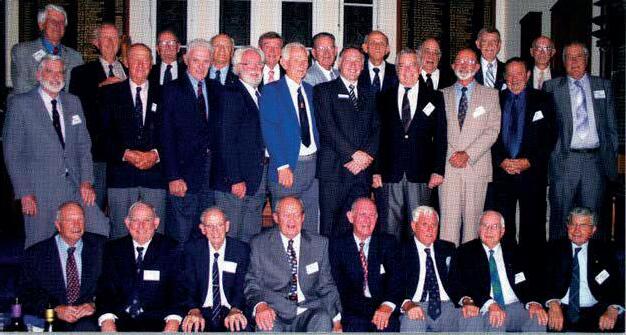


1 - John K. Winn


Appendix 2 - Trustees’ Honour Boards
Appendix 2 - Trustees’ Honour Boards

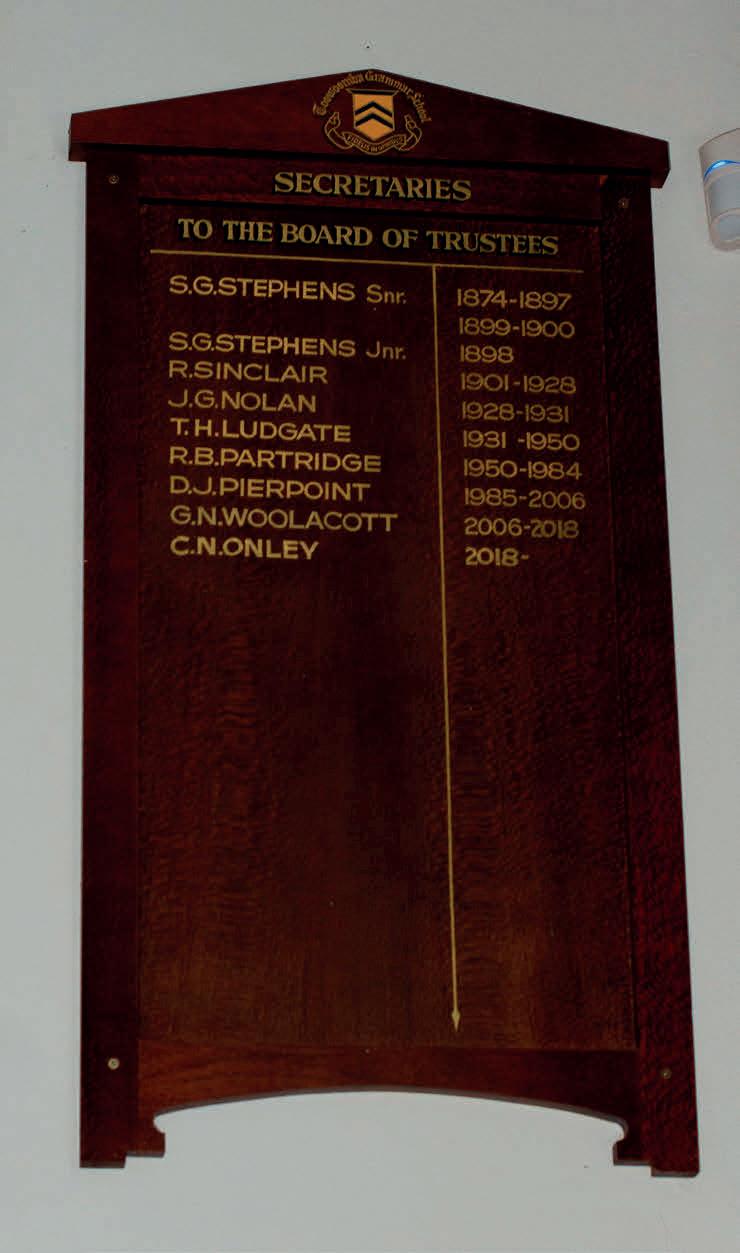

Appendix 3 - Staff Honour Boards (cont.)
Appendix 3 - Staff Honour Boards (cont.)
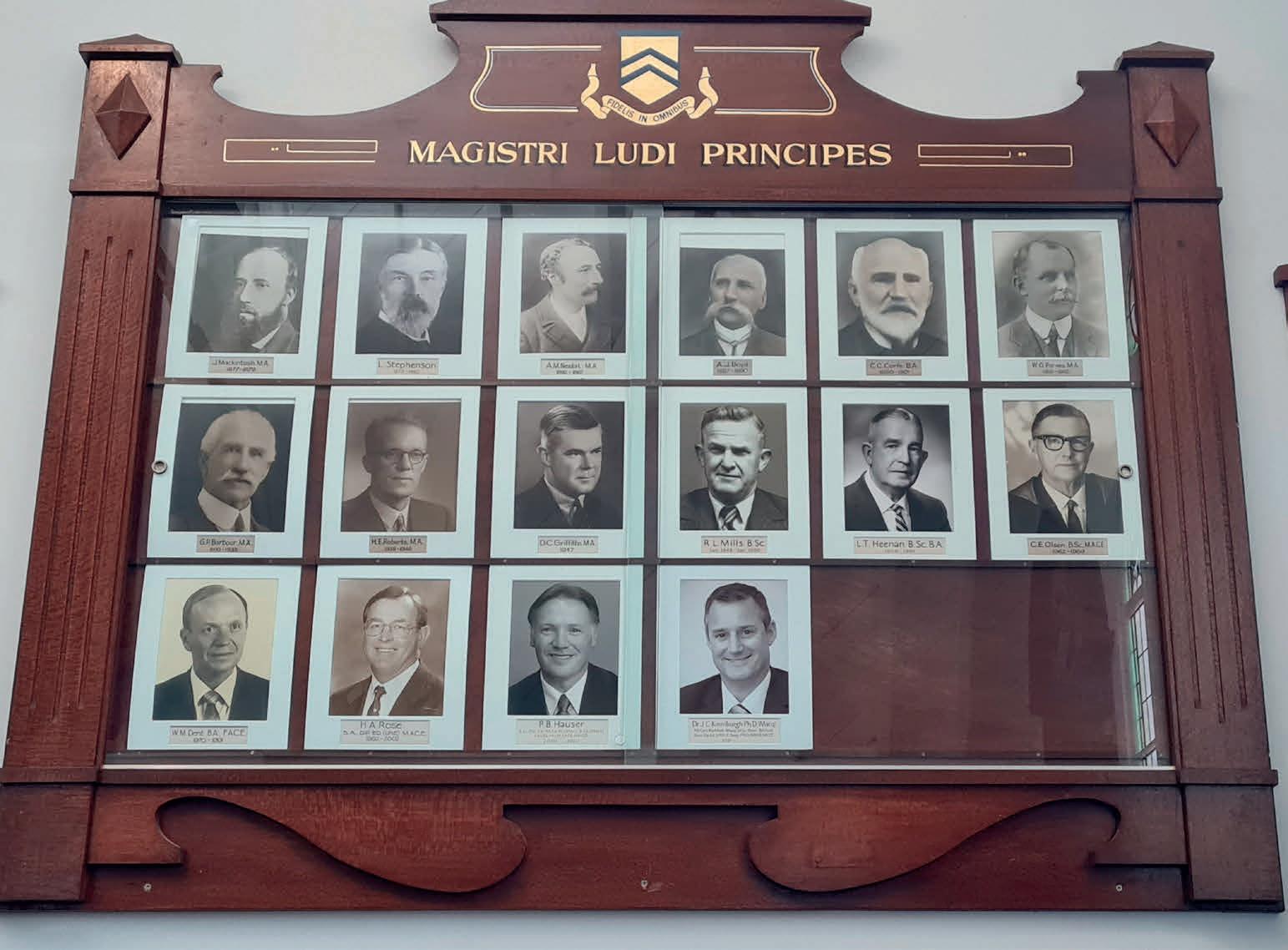
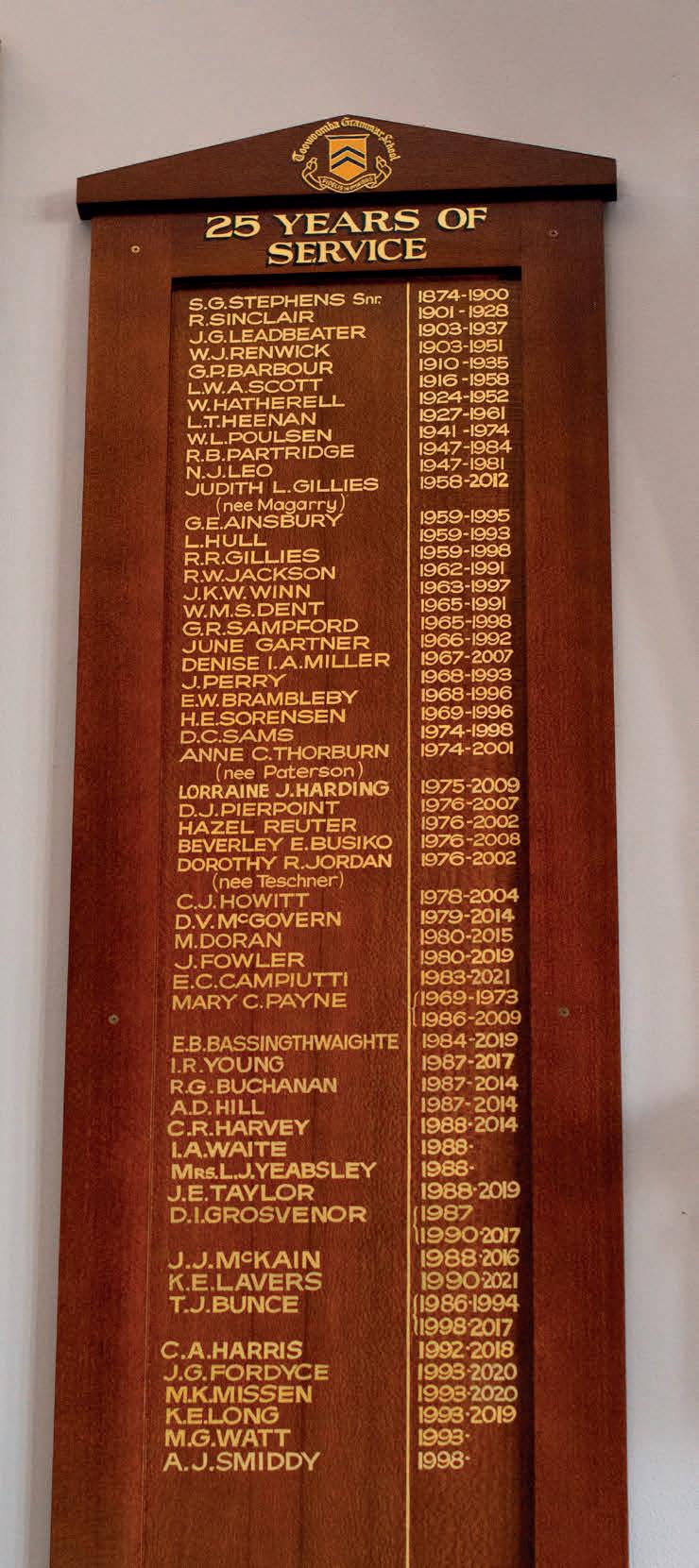
Appendix 4 - Student Honour Boards
Appendix Four: Student Honour Boards in ca Appendix 4 - Student Honour Boards
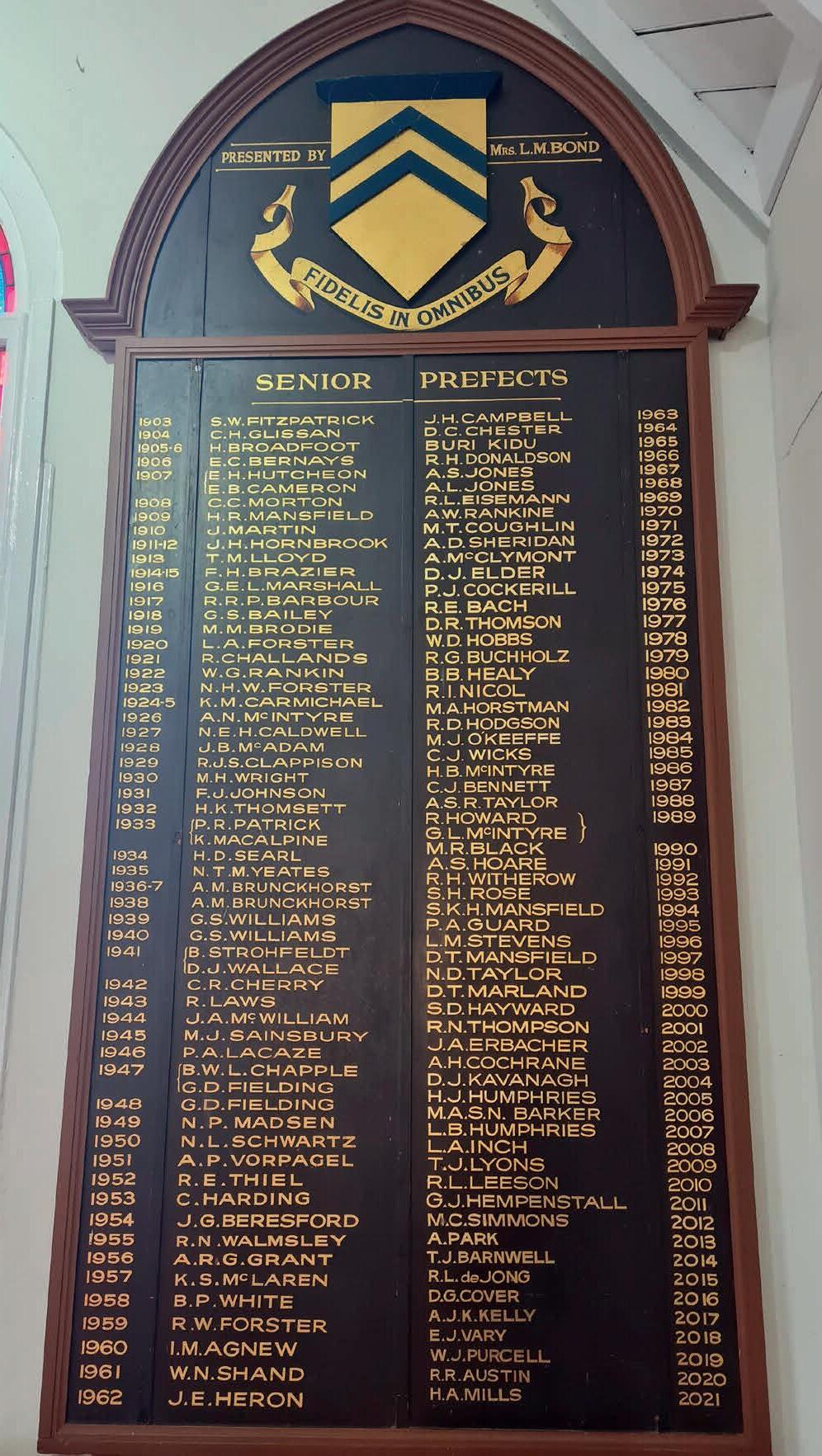

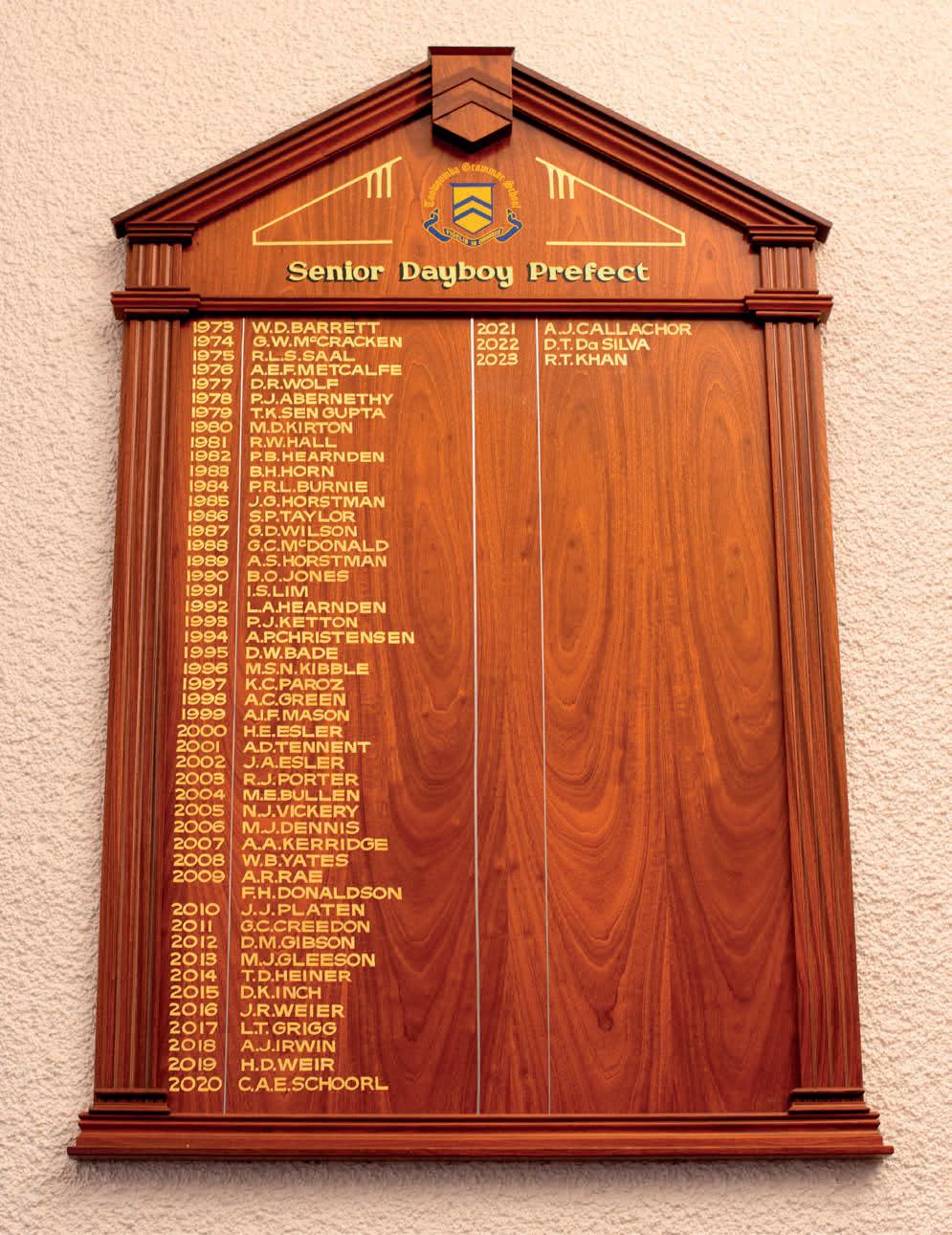
Appendix 4 - Student Honour Boards (cont.)
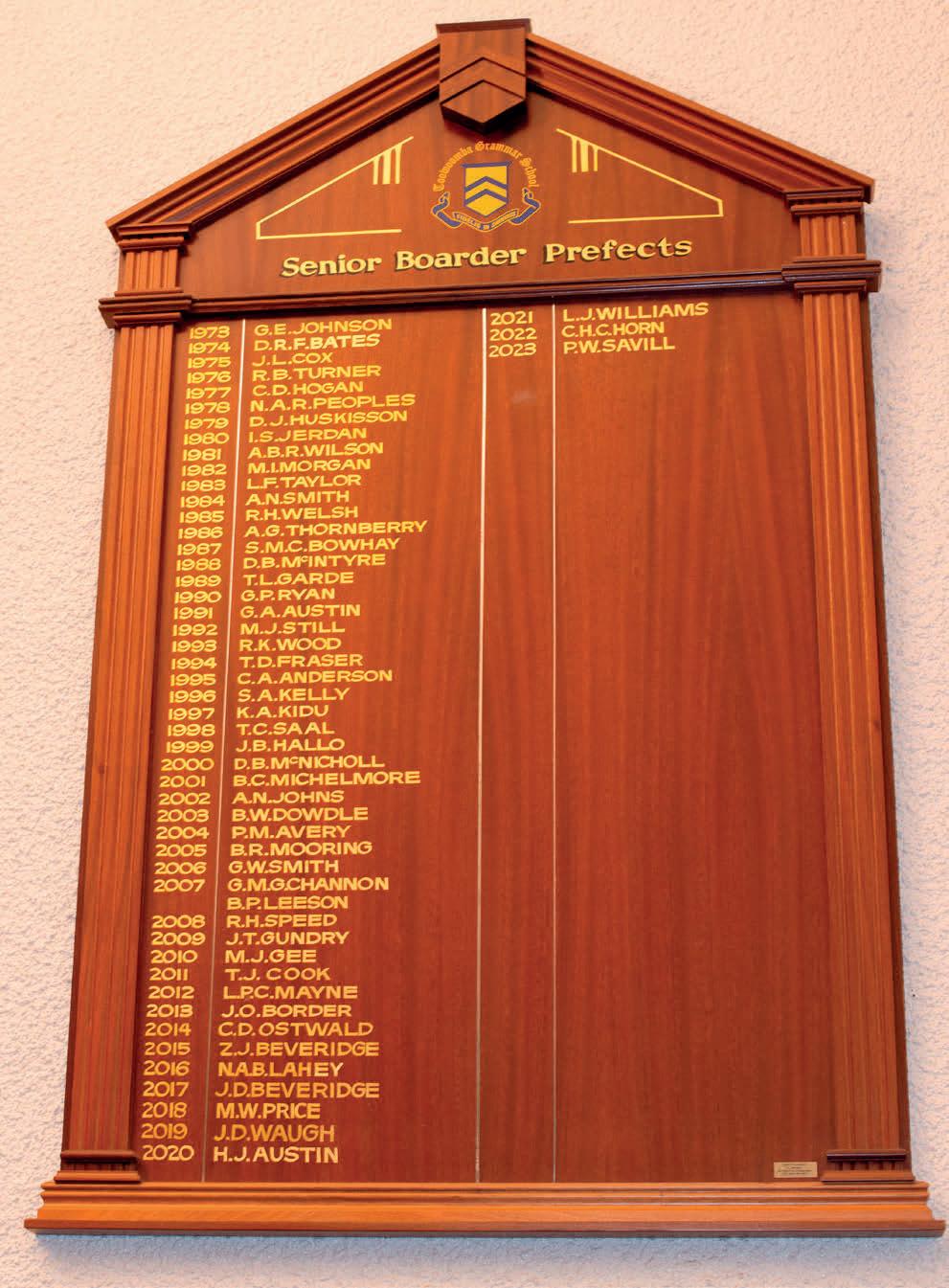
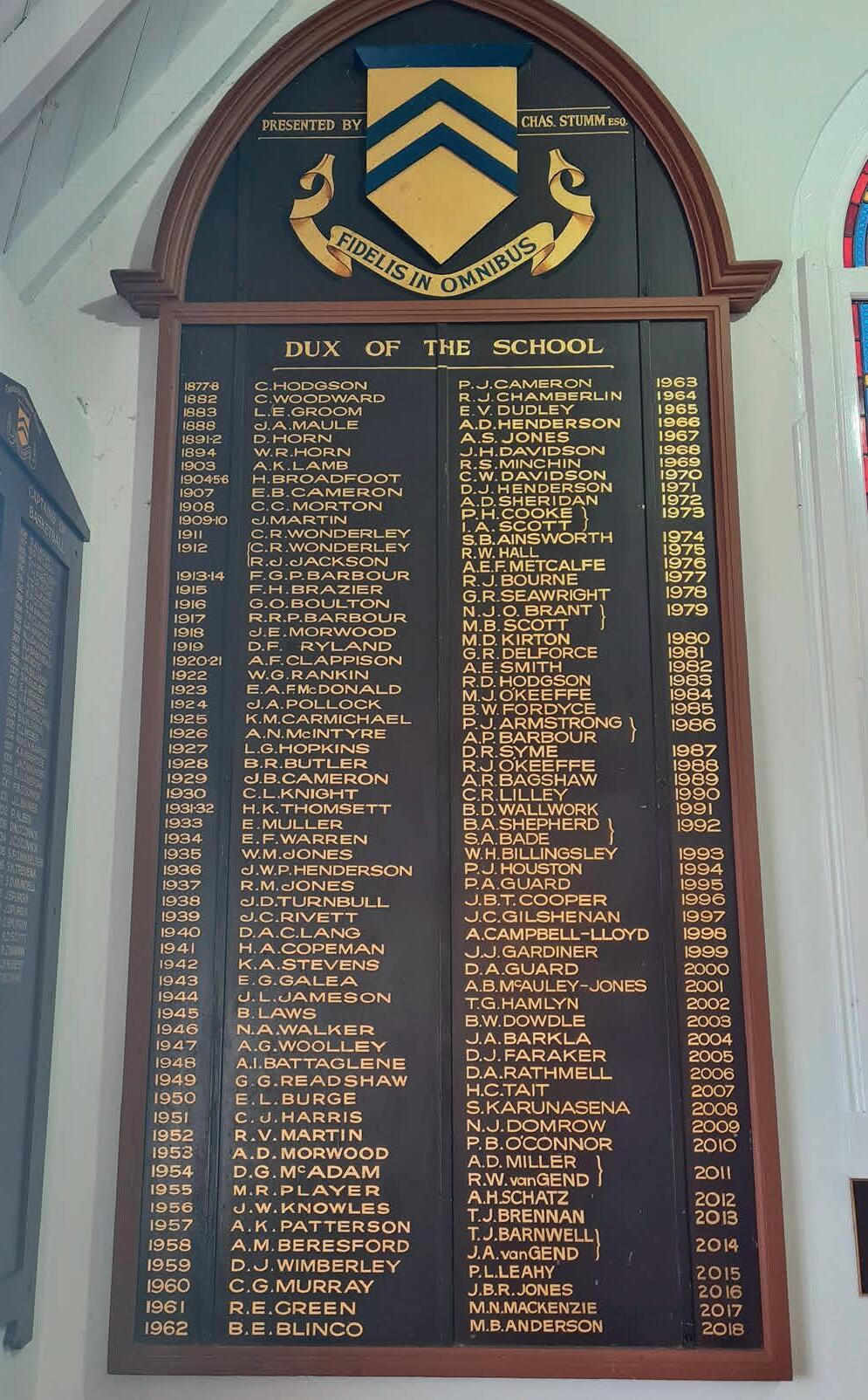

Appendix 4 - Student Honour Boards (cont.)
Appendix 4 - Student Honour Boards (cont.)
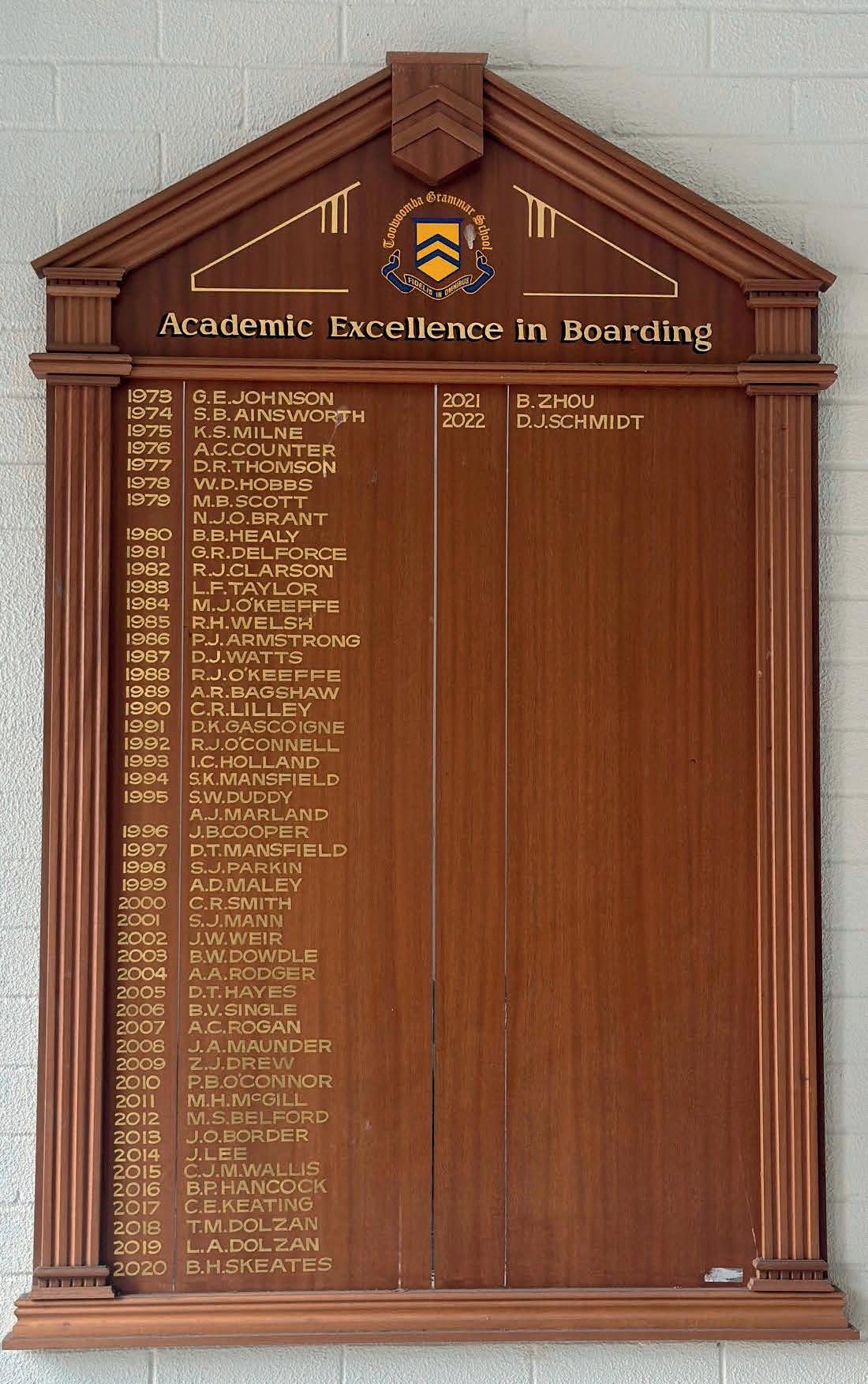
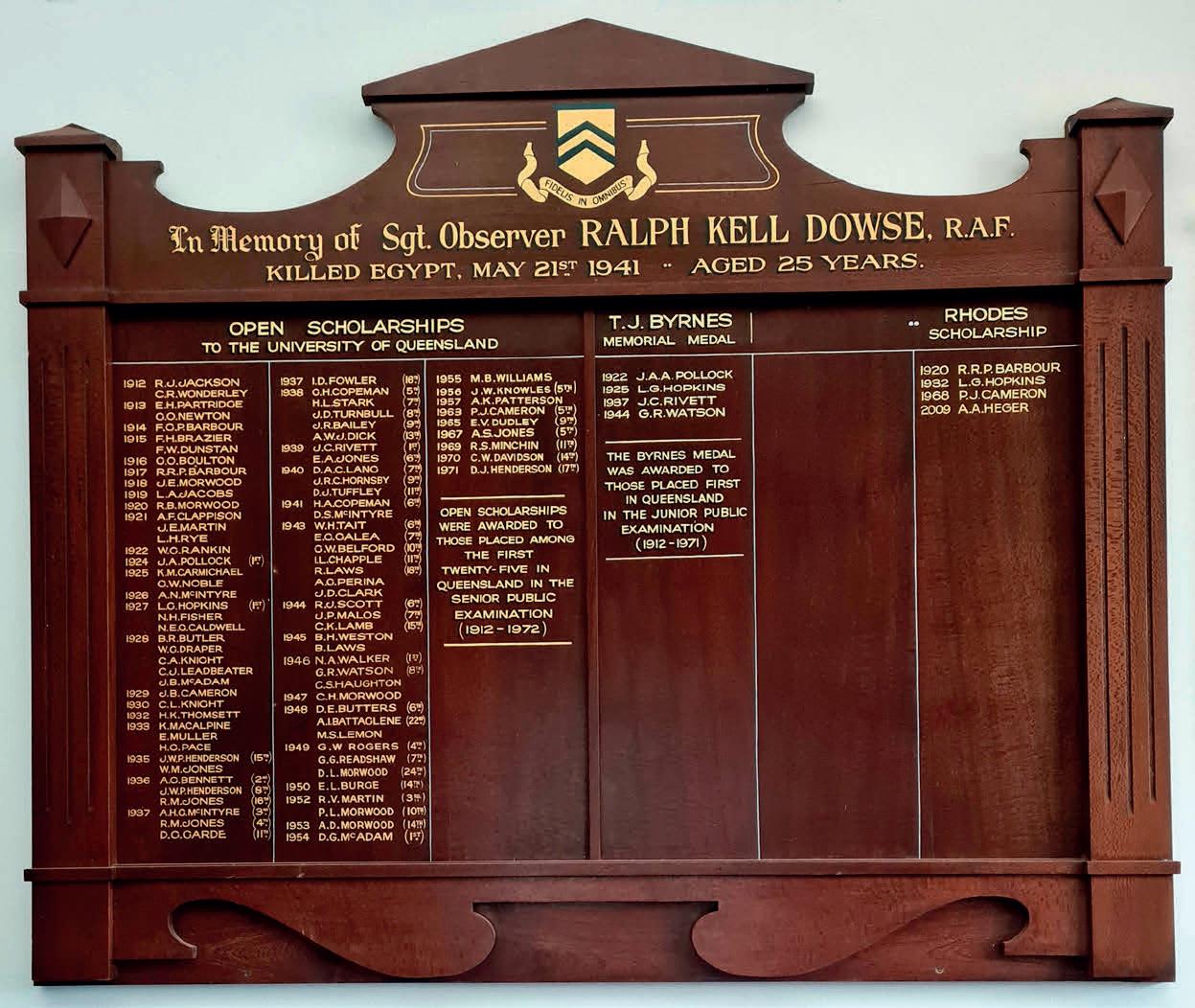
Appendix 4 - Student Honour Boards (cont.)
Appendix 4 - Student Honour Boards (cont.)
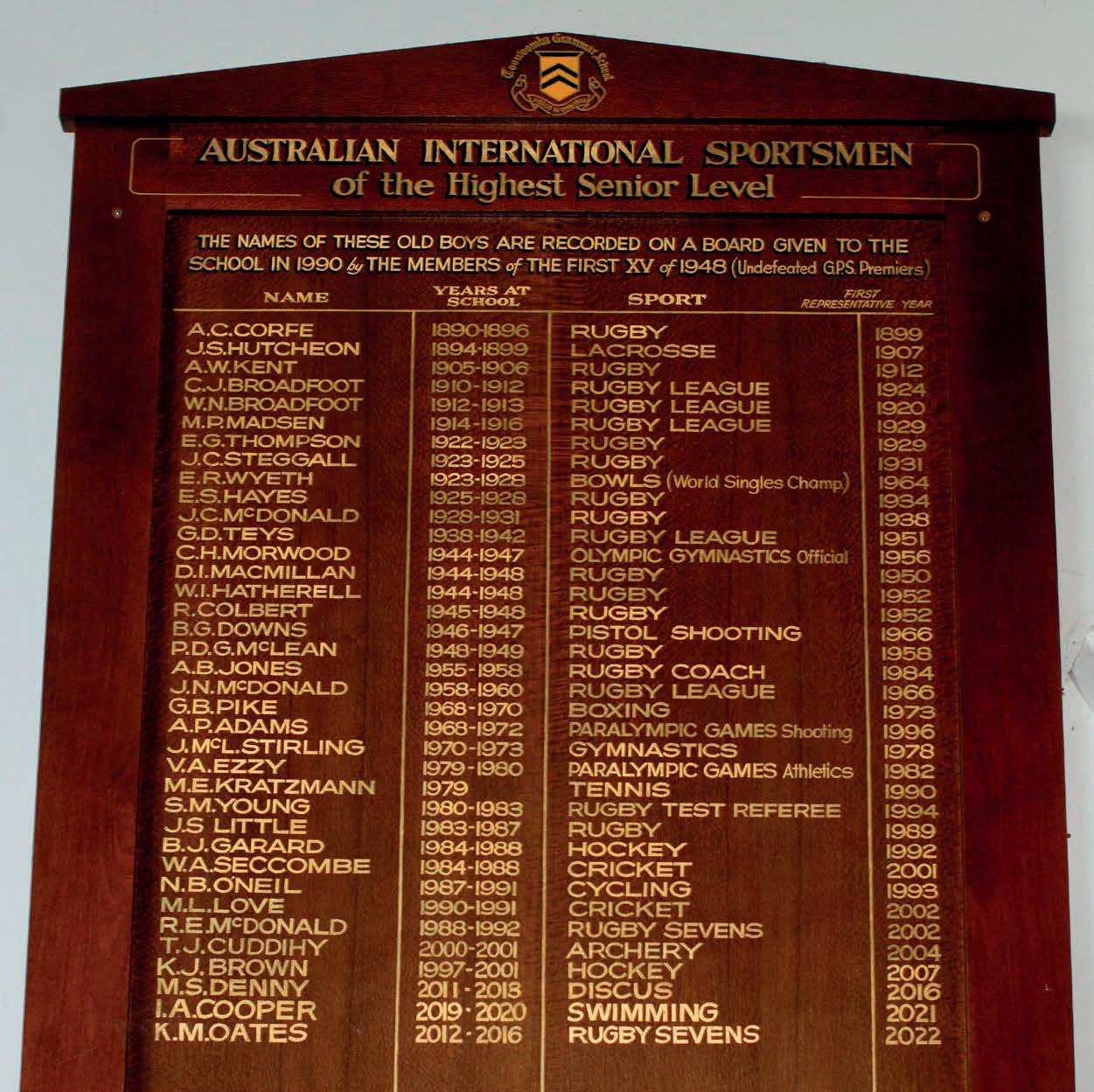
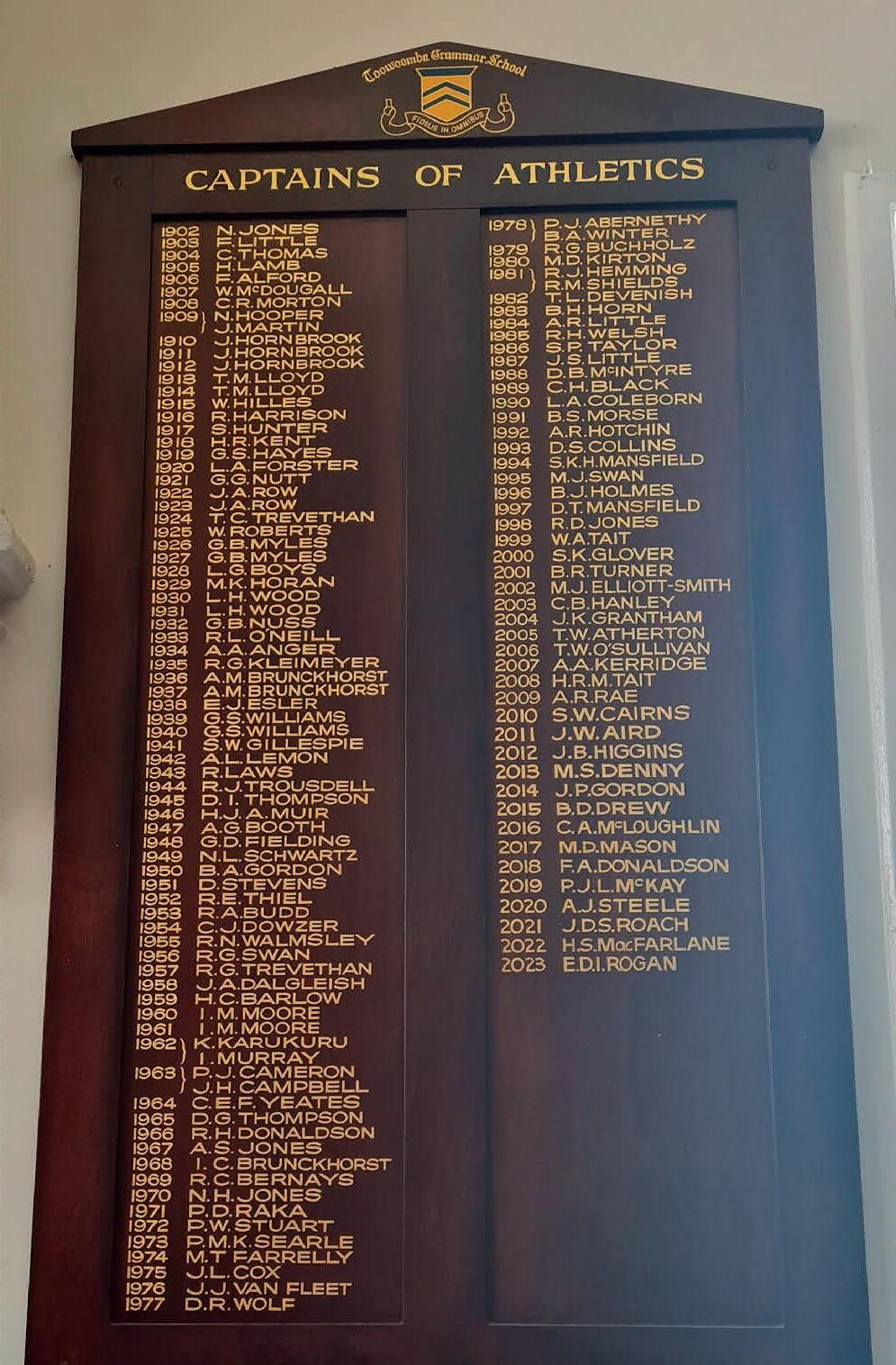

Appendix 4 - Student Honour Boards (cont.)
Appendix 4 - Student Honour Boards (cont.)

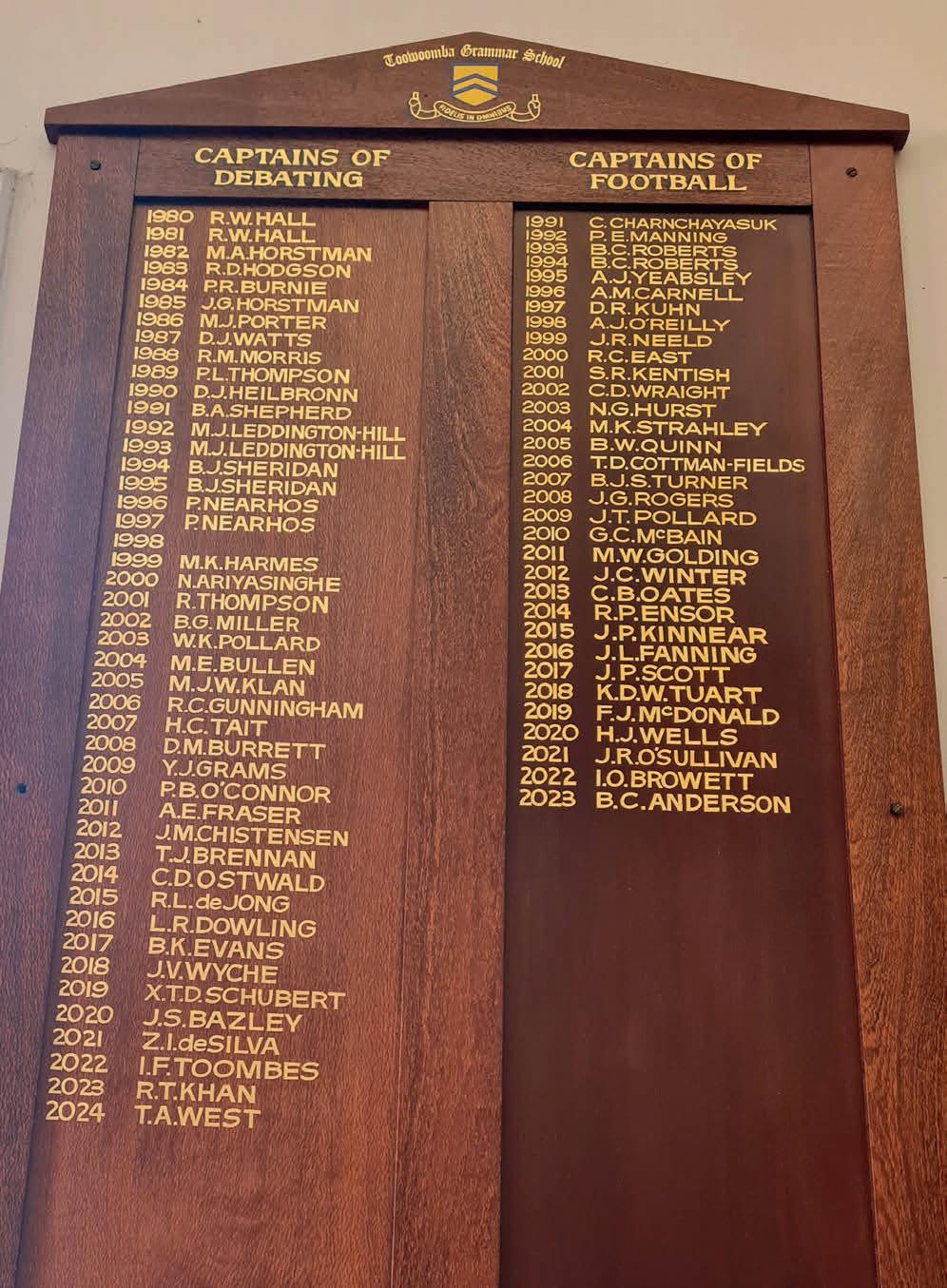

Appendix 4 - Student Honour Boards (cont.)
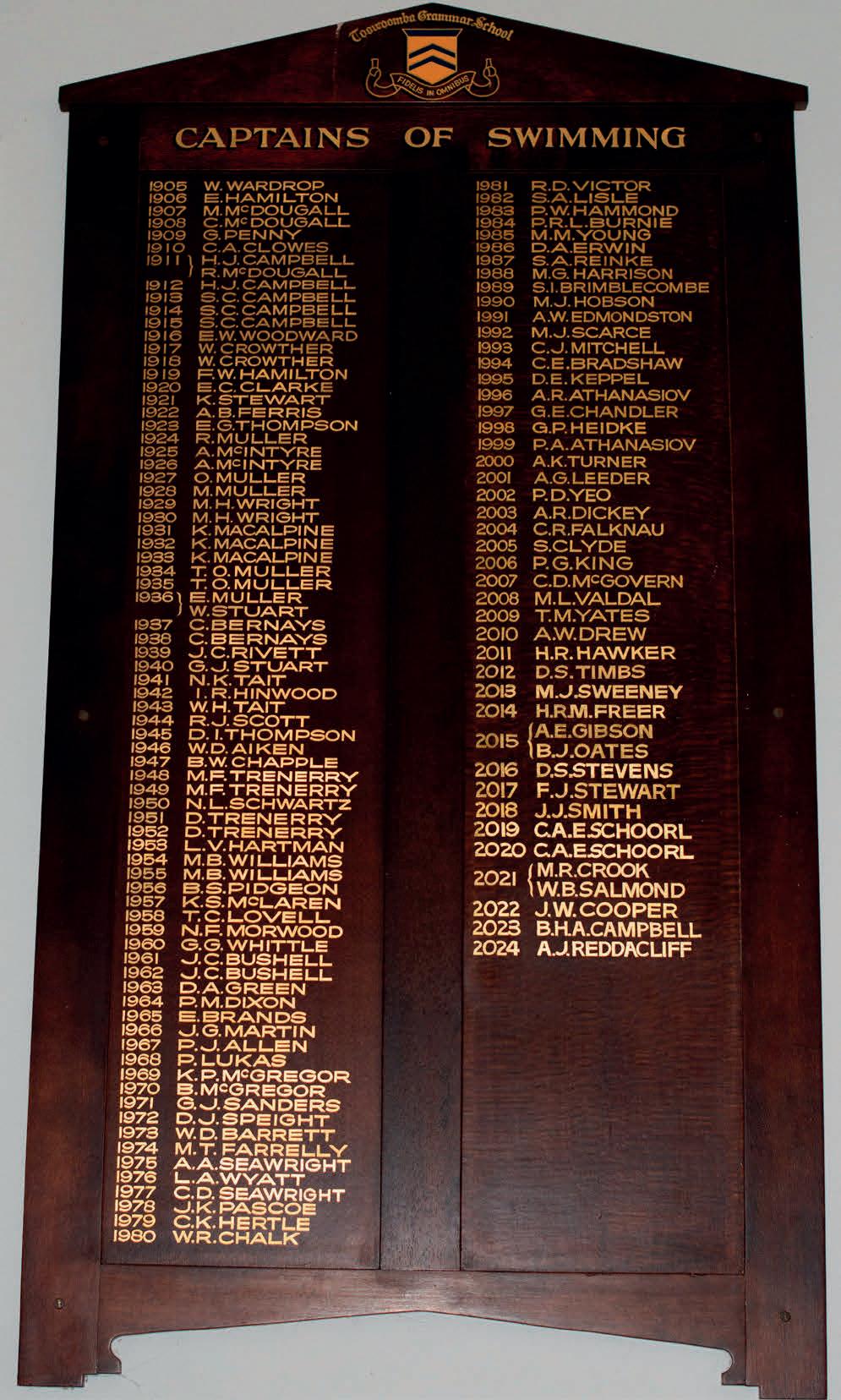
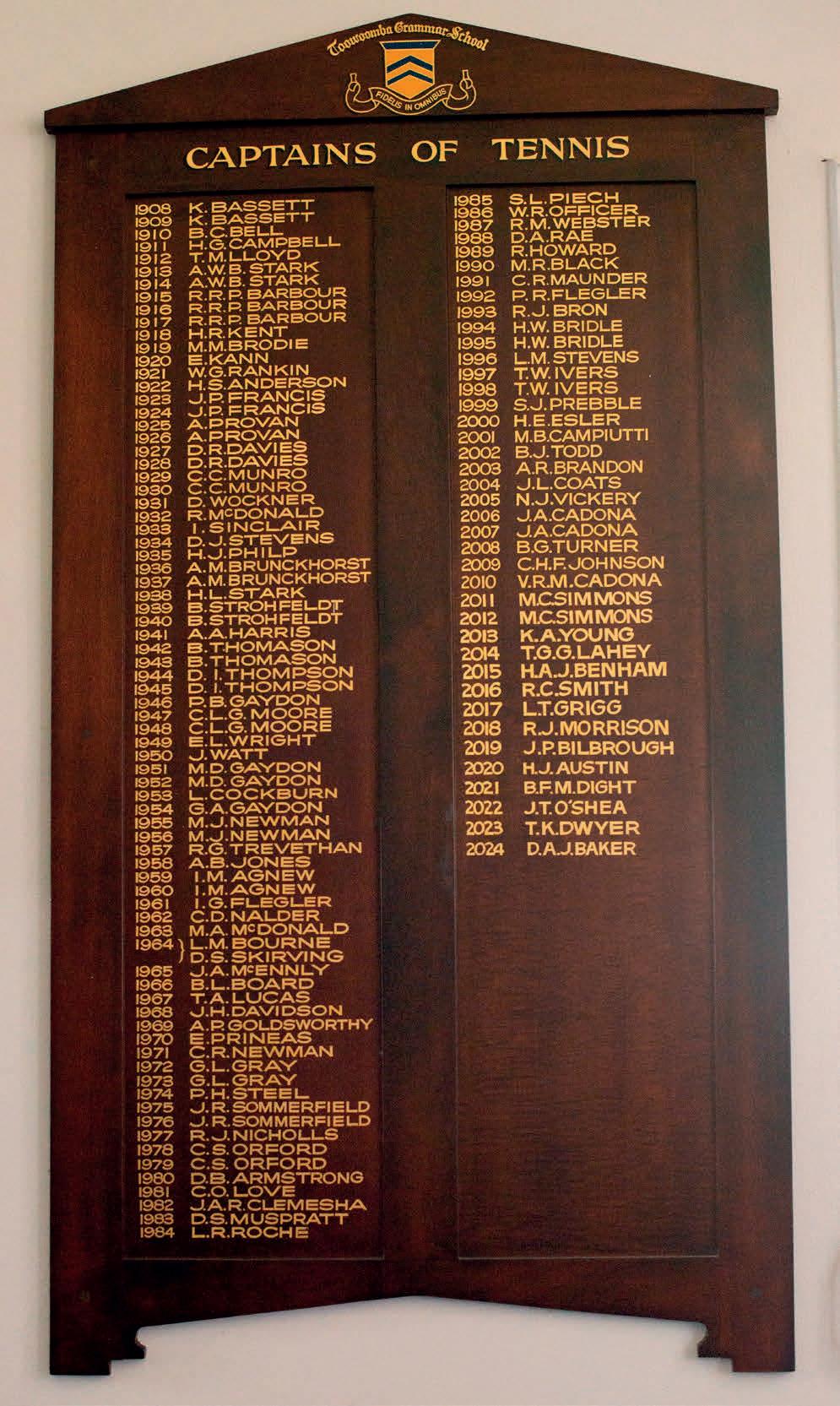

Appendix 4 - Student Honour Boards (cont.)
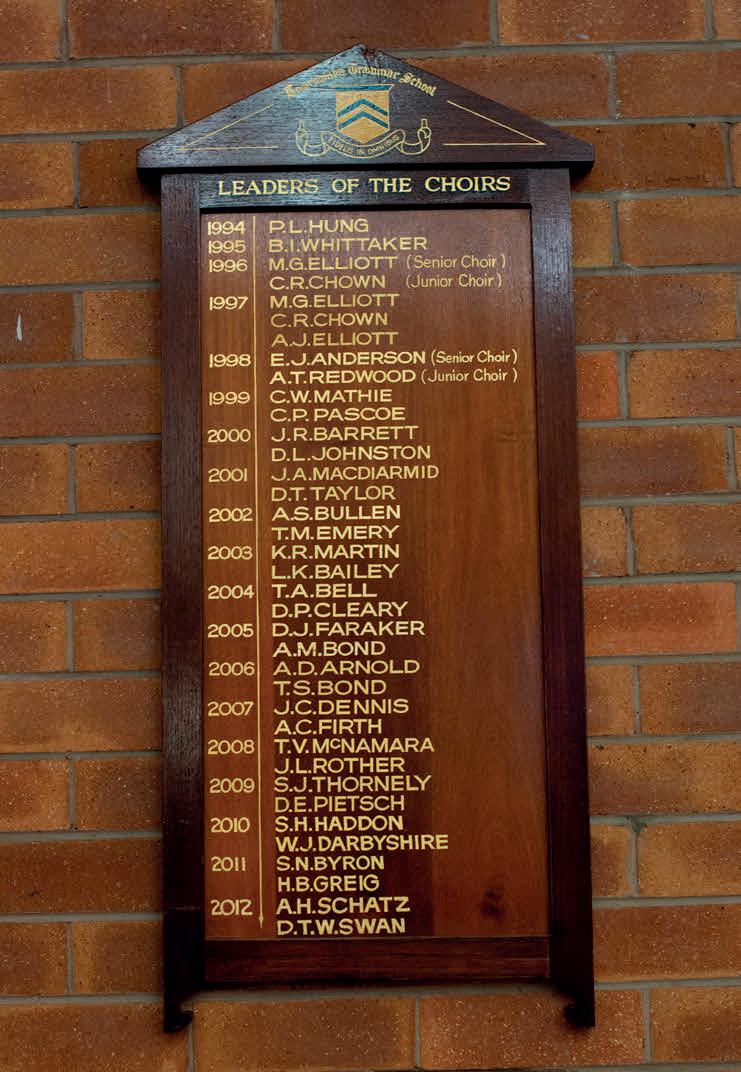
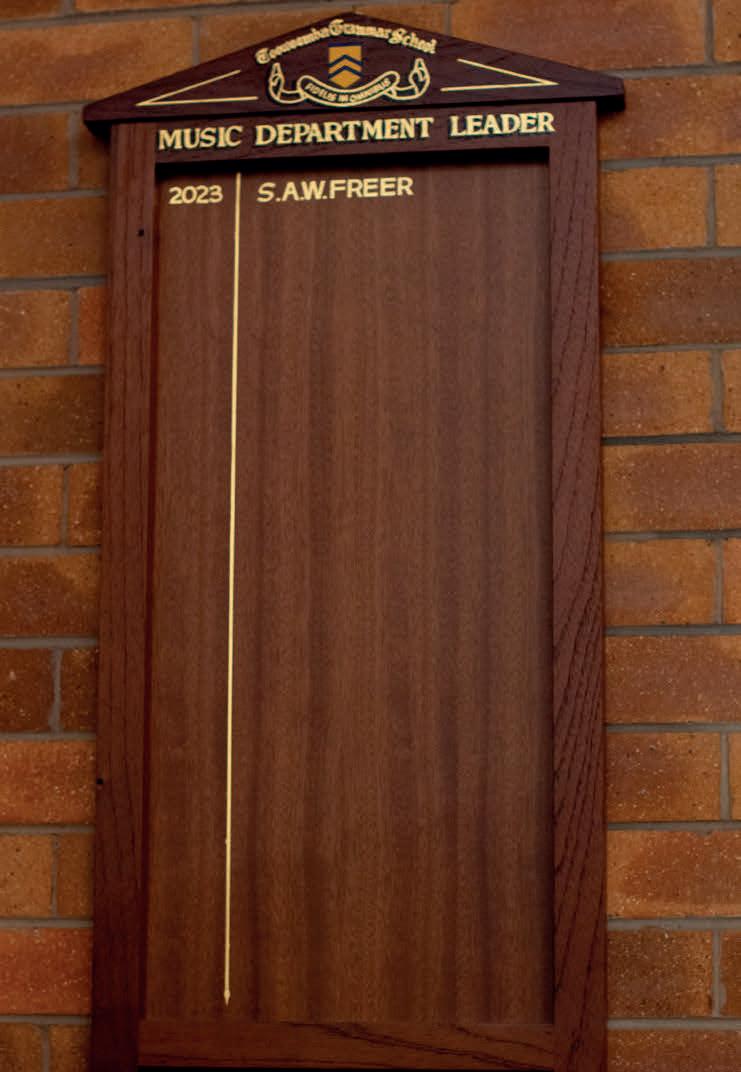


Appendix 4 - Student Honour Boards (cont.)

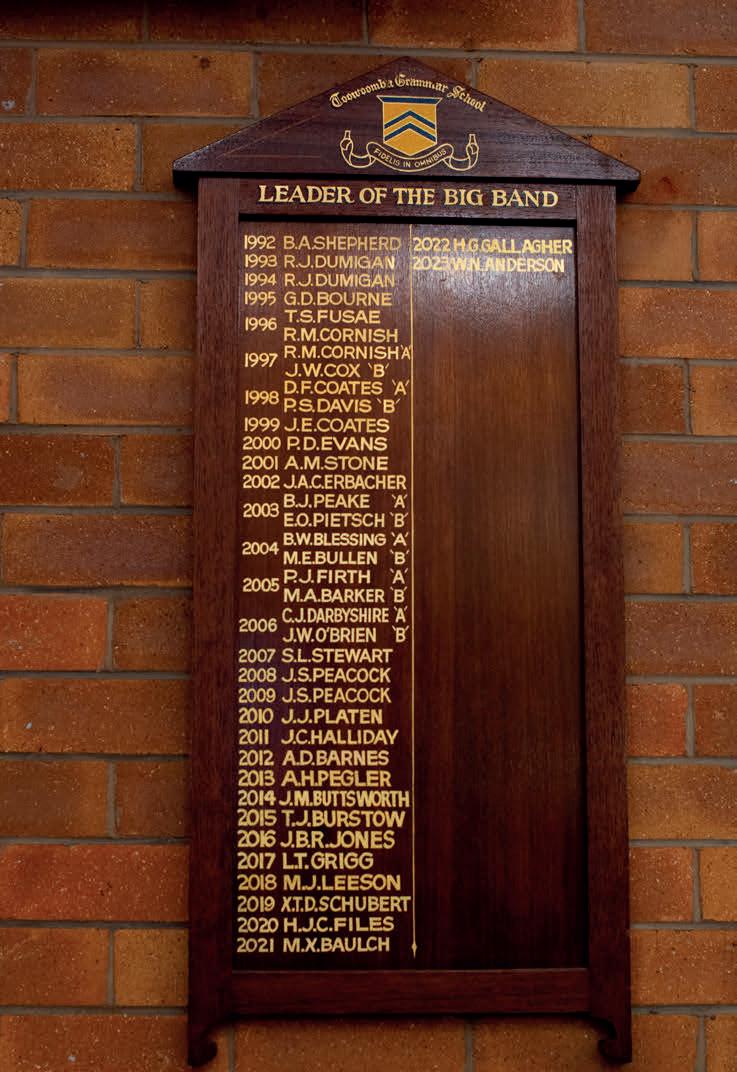

Appendix 4 - Student Honour Boards (cont.)
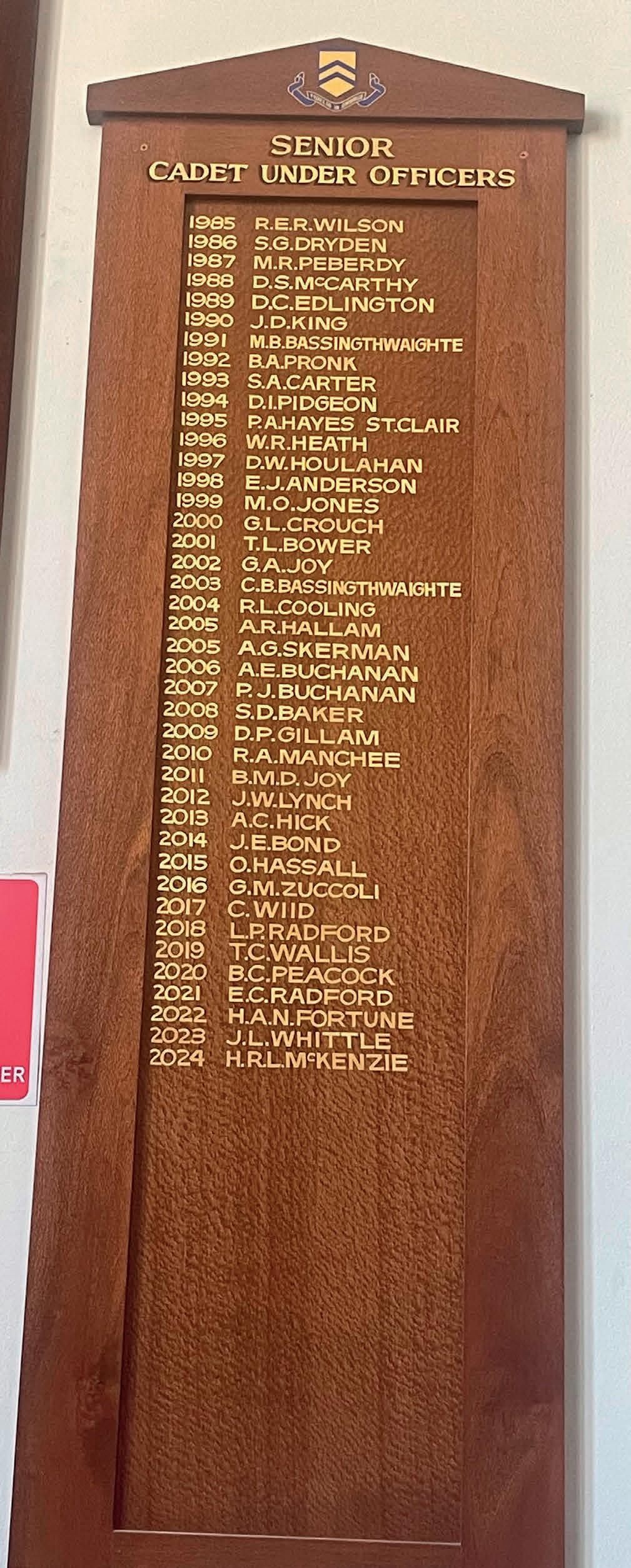
Appendix 4 - Student Honour Boards (cont.)
Appendix 4 - Student Honour Boards (cont.)
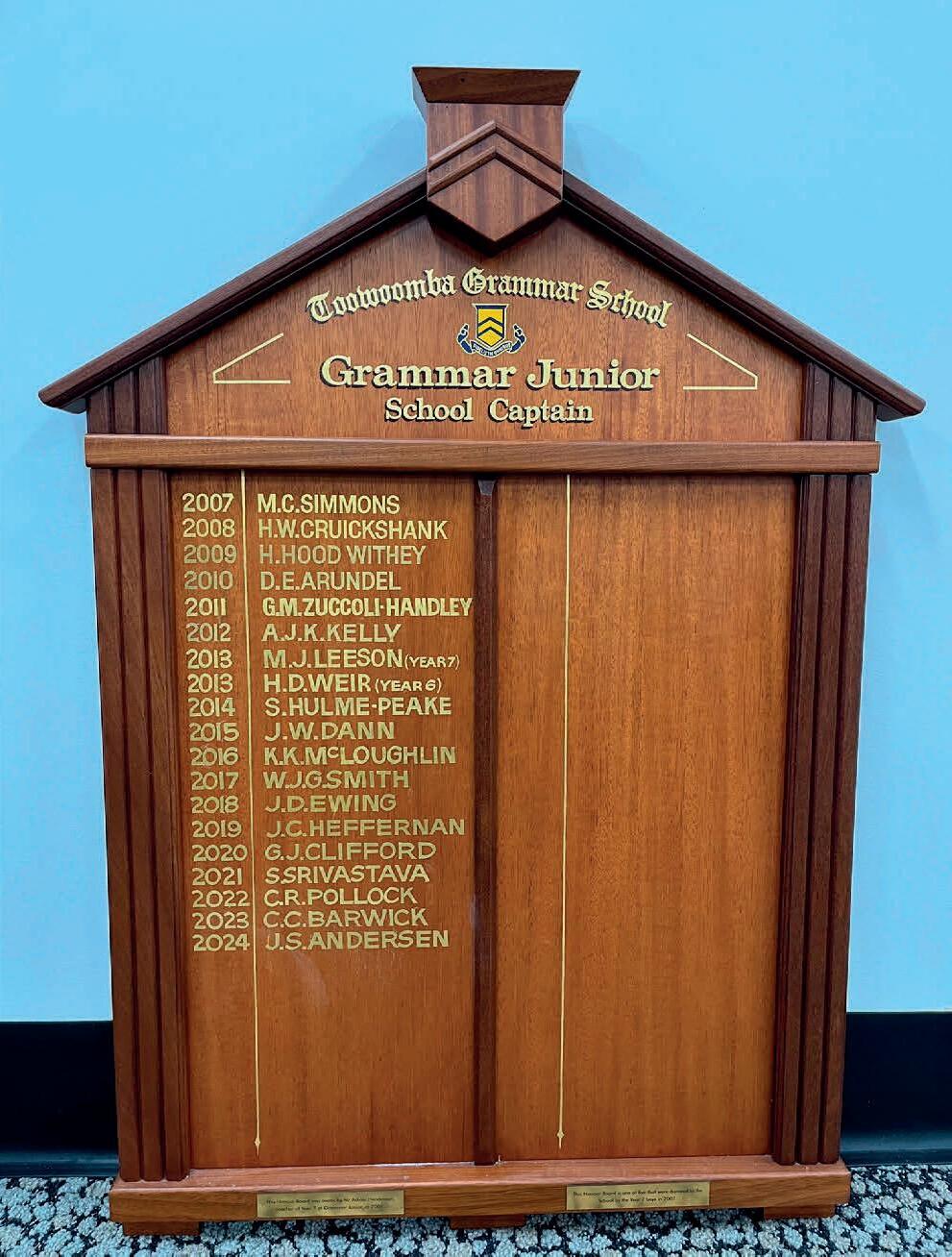


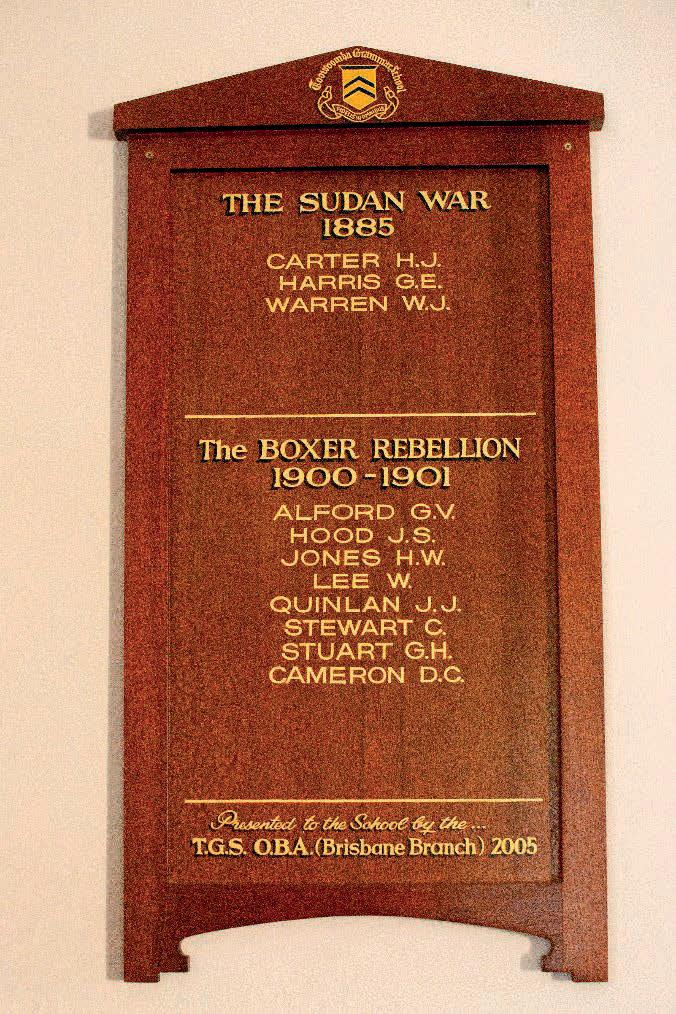
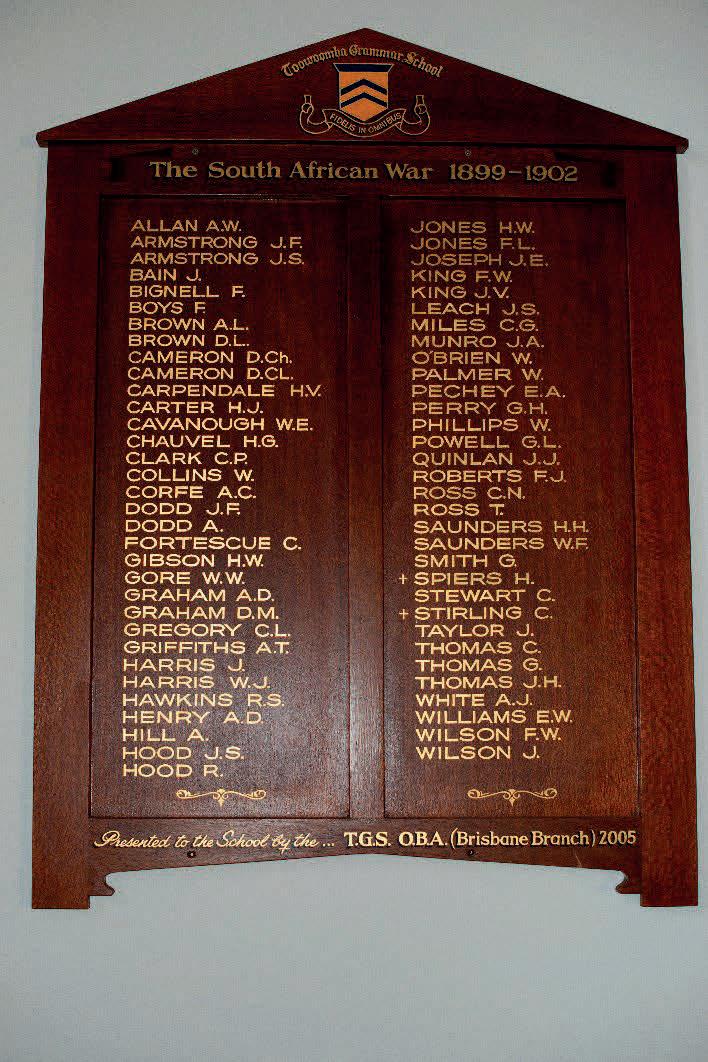

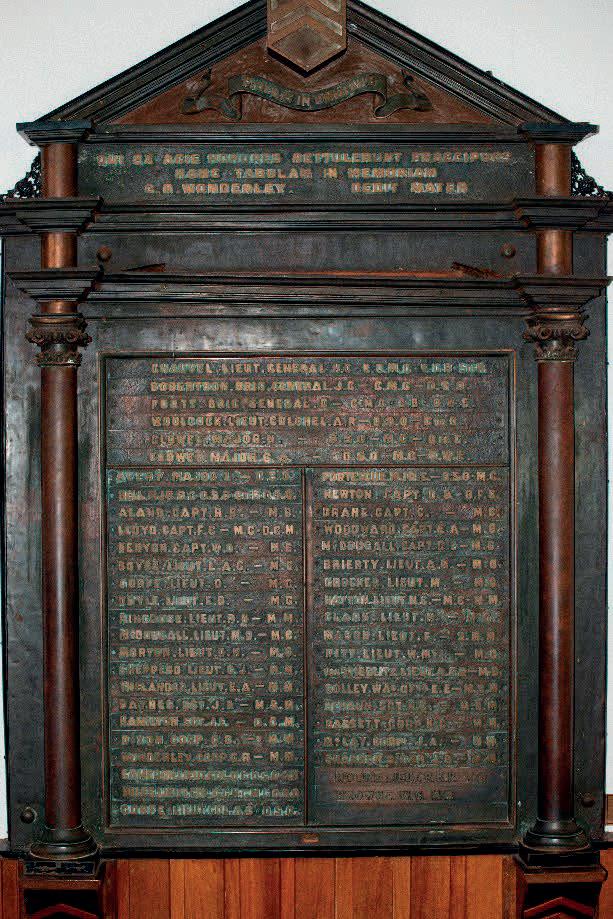
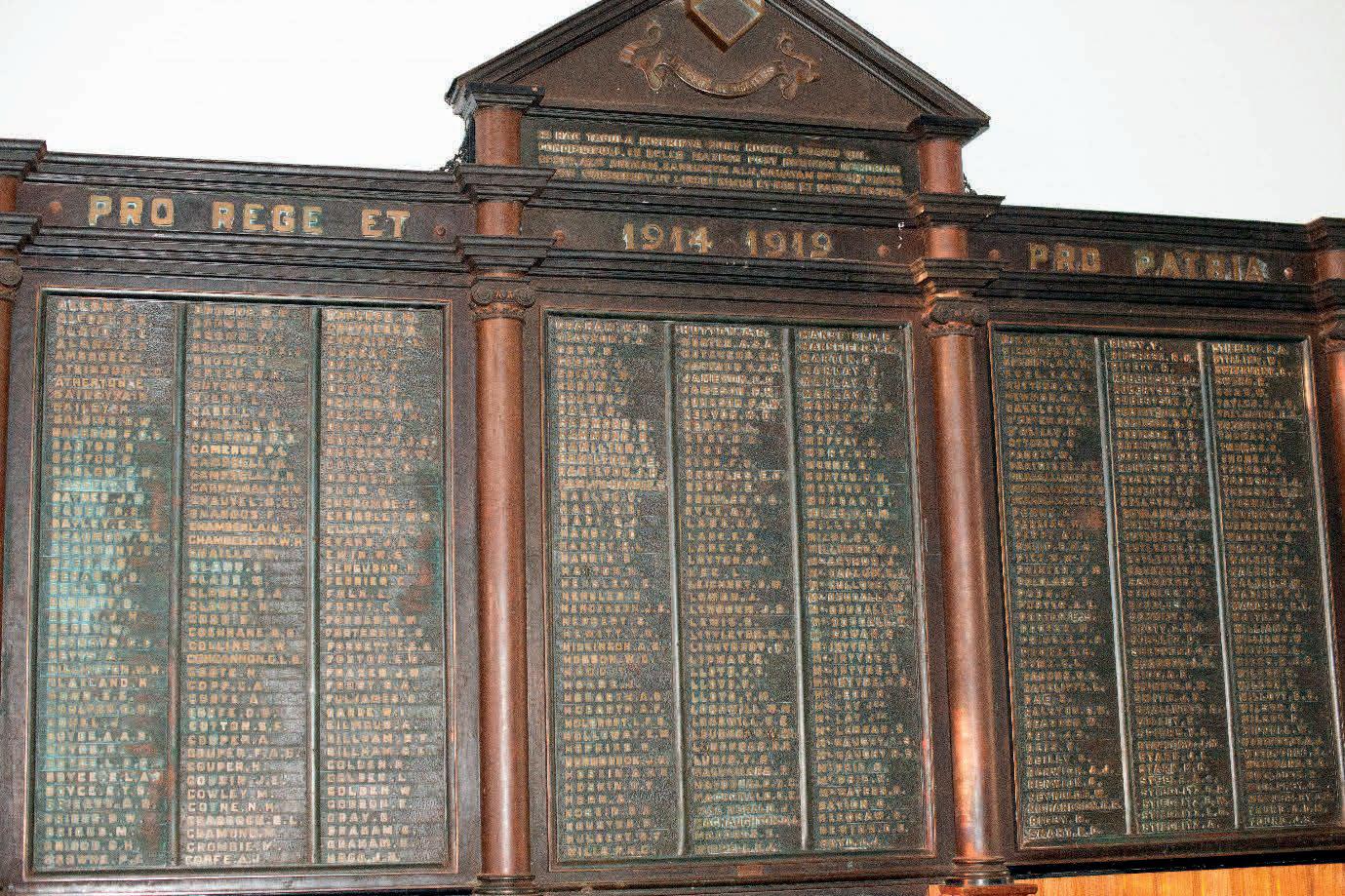
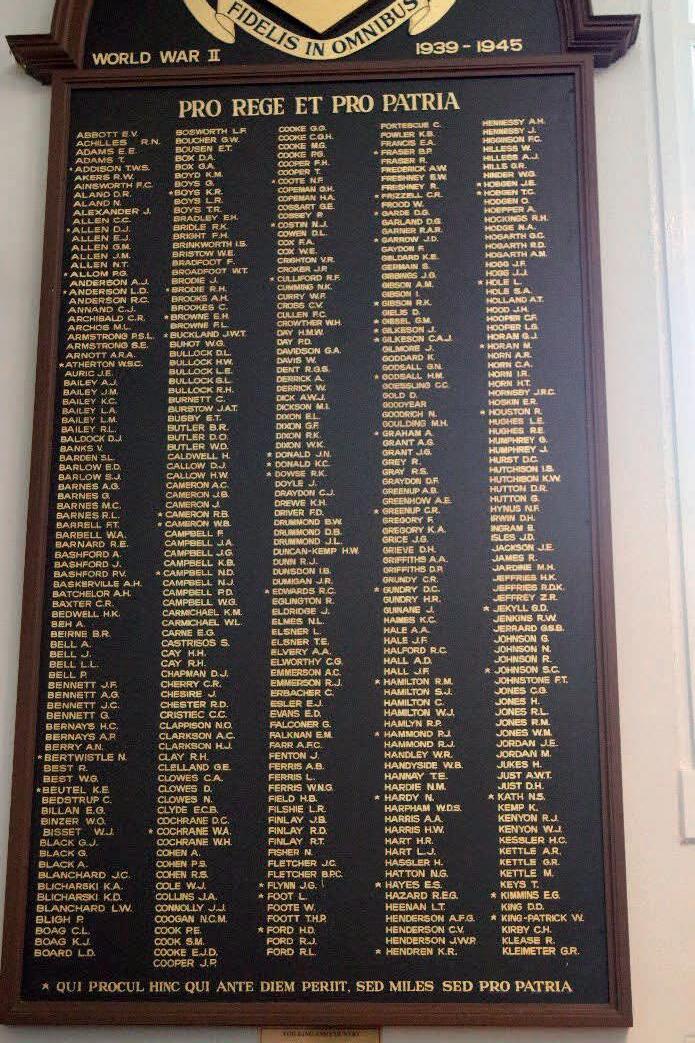
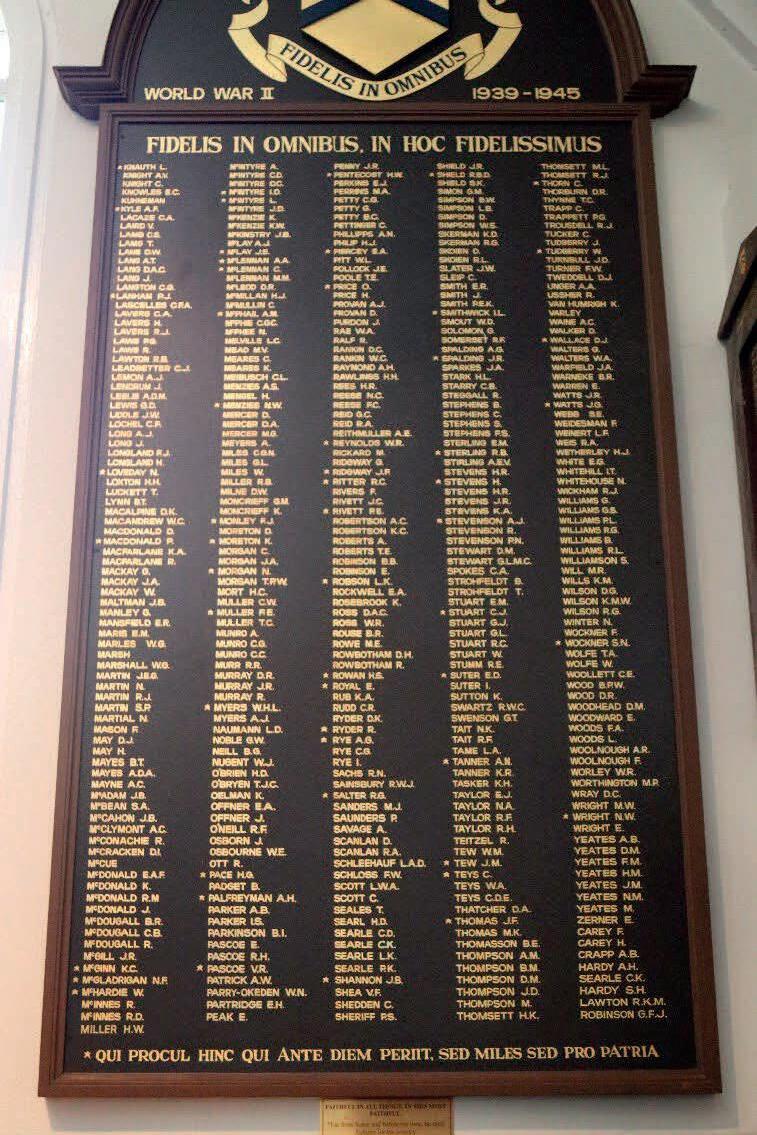
A - Z
Abingdon' Outdoor Education Property
Year
1989, 1991, 1994, 1995, 1996, 1997, 1999, 2004, 2006
Academic, First in State 1912, 1924, 1927, 1939, 1946, 1954
Academic Honours on Blazers 1997
Academic Performance, Year 12 2006, 2011, 2013, 2016, 2017
Academic Streaming of Classes 1971
Accounts Office 1943, 1947
Adventure Club 1983, 1984, 1986, 1991, 1993, 1996, 1997, 2001, 2002, 2003, 2004, 2005, 2007
Adventure Club, African and Indian Expedition 1989
Adventure Club, Laos, Cambodia, Vietnam, Thailand 2009
Adventure Club, Nepal Expedition 1987, 1998, 2004, 2007, 2009, 2011, 2013, 2016
Adventure Club, New Zealand Expedition 2006
Adventure Club 'Top End' Safari 1985, 1993, 1998
Agricultural Science 1977
Ainsbury, Graeme, (Staff) 1959, 1970, 1983, 1987, 1991, 1993, 1995
Ainsbury Prize for Geography 1995
Air-Conditioning 2008, 2010, 2015, 2016
Air Force Air Vice Marshal 1940
Air Force Hut 1945, 1950
Air Force Training 1942
Air Raid Practices and Trenches 1940, 1944
Air Training Corps 1942
Airport, Brisbane West (Wellcamp) Toowoomba 2014, 2016
Aland, Robert 1884, 1889
Alcohol Minimum Drinking Age 1957, 1974
Anglican Church Grammar School ('Churchie') 1912, 1946, 1985
Anniversary, 50 years 1925
Anniversary, 75 years 1950
Anniversary, 100 years 1975
Anniversary, 125 years 2000
ANZAC Day 1916, 1940, 2015, 2020, 2021
ANZAC 'Battlefields' Tour, Turkey, France & Belgium 2015
Appeals Board 1999
Apprentice (School-Based) of the Year 2010
Aquatic Centre 2009, 2010, 2017
Archaeologists 1974, 1981
Archives Committee 1989
Armoury 1901, 1910, 1944
Army Huts 1940, 1942, 1945, 1947, 1948
Army Brigadiers 1885, 1894, 1896, 1910, 1917, 1919, 1921, 1941, 1943, 1944, 1927, 1977, 1990
Army Lieutenant-Generals
1882, 1898, 1910, 1916, 1966
Art Exhibition, McAulay, Tom 2011
Art Exhibition, Students 1993, 2002
Art Group 1909
Art Show, Parents & Friends Association
1981, 1982, 1984, 1992, 1994, 1995, 2002, 2004, 2015, 2018, 2020
Arts Building (Art and Manual Art) 1981, 1982, 2017
Assembly Hall 1963, 1964, 2018
Athletics GPS 1918, 1996, 1998, 2017
Athletics, Australian Schools' Invitational Athletics team to USA 1987
Athletics, Australian Schoolboy Athletics Championships 2003
Athletics, Booth, Antony 1947
Athletics, Brunckhorst, Craig 1968
Athletics, Collins, Dion 1993
Athletics, Cox, John 1975
Athletics, Denny, Matthew 2013, 2016, 2021
Athletics, Glover, Steven 2000
Athletics, Gordon, Jai 2020
Athletics, Hearnden, Luke 1992
Athletics, Jones, Rhys 1998
Athletics, Landy, John, MBE 1969
Athletics, Mansfield, Scott 1994
Athletics, McIntyre, Dugald 1987, 1988
Athletics, Moore, Ian 1960, 1961
Athletics, Moss, Stephen 1987
Athletics, Myles, Graham 'Singy' 1924, 1925, 1926, 1927, 1968, 1969
Athletics, Purcell, Kevin 1994
Athletics, Robinson, Joshua 2012, 2013
Athletics, Stapleton, Brett 2002, 2003, 2004
Athletics, Taylor, Matthew 2022, 2023
Athletics, Trousdell, Rod 'John' 1944, 1945
Athletics, Winter, Brett 1978, 1979
Athletics, Father Graham Memorial Athletics Trophy 1967, 1968, 1990, 2005
Athletics, First Place in World Schools' Athletics Championships 2013
Athletics, GPS Centenary 2017
Athletics, GPS Championships, First Place Premiership 1945, 1971, 1972
Athletics, GPS Championships School Second Place 1944, 1965, 1973, 1974, 1978, 1980, 2012
Athletics, GPS Championships School Third Place 1923, 1924, 1937, 1942, 1943, 1975, 1976, 1977, 1999,
Athletics, GPS Open, Winners in 2 Events
1929, 1944, 1975, 1976, 1988, 1989, 1992, 1994, 1999, 2003, 2004, 2013, 2014, 2016, 2020
Athletics, GPS Open, Winners in 3 Events 1944, 1978, 2012, 2013
Athletics, GPS both 100 and 200 metre Champions 1927, 1943, 1944, 1975, 1992, 2013, 2020
Athletics, Guiness Book of Records 1975, 1980
Athletics, History, 1877-1926 1926
Athletics, International Representative, Matthew Denny 2013
Athletics, International Representative, Vern Ezzy 1980
Athletics, International Representative, Benny Pike
Athletics, Open sprint 100 metres winners
Athletics, Open sprint 200 metres winners
1927, 1937, 1943, 1944, 1974, 1975, 1992, 2013, 2019, 2020
1925, 1926, 1927, 1937, 1943, 1944, 1975, 1992, 2004, 2006, 2008, 2013, 2020
Athletics, Open 400 metres winners 1924, 1937, 1965, 1994, 2013
Athletics, Open sprint triple winners 2013
Athletics, Open 800 metre winners 1931, 1944, 1945, 1978, 1987, 1988, 1994
Athletics, Open 4 x 100 metres relay winners 1975, 1996, 2007, 2013, 2019
Athletics, Open 4 x 400 metres relay winners 1971, 1975, 1987, 1994, 1996
Athletics, Open 4 x 800 metres relay winners 1973, 1977, 1979, 1997
Athletics, Open 110 metres hurdles 1923, 1945, 1965, 1975, 1999, 2001
Athletics, Open 400 metres hurdles winners 1984, 1988, 1997, 1999, 2013
Athletics, Open 1500 metres winners 1978, 1988
Athletics, Open 3000 metres winners 1978, 1979, 1995, 2014
Athletics, Open discus winners 1989, 1992, 2001, 2002, 2004, 2013, 2014, 2016, 2023
Athletics, Open javelin winners 1987, 1993, 2002, 2003, 2019, 2023
Athletics, Open shot put winners 1908, 1924, 1960, 1961, 1975, 1976, 1981, 1989, 1992, 1997, 1998, 2000, 2002, 2003, 2004, 2013, 2014, 2016
Athletics, Open high jump winners 1944, 1945, 1948, 1963, 1972, 1973, 1976, 1985, 1986, 1987, 1988, 1998, 2002
Athletics, Open long jump winners 1918, 1919, 1969, 1973, 1980
Athletics, Open triple jump winners 2019
Athletics History, 1925-1950 1952
Athletics, QEII Stadium 1975, 2001
Athletics, State Representatives 1947, 1985, 2003 2014
Athletics, Televised GPS Championships 1962, 1965
Athletics, TGS World Schools' Athletics Champions 2013
Athletics Coach, Anlezark, Justin 2004
Athletics Coach, Gallagher (nee Davies), Jackie 2015, 2023
Athletics Coach, Jones, Lindesay 1965, 1970, 1971, 1981, 1982
Athletics Coach, Wells, Debbie 2002, 2014
Aubigny Cricket Club Ground 1877, 1881, 1883
Australia Bicentennial Year and QLD Expo 1988
Australia, Centenary of Federation 2001
Australian Curriculum 2012
Australian Government's 'Building the Education Revolution' (BER) 2009, 2010
Australian Government's 'Digital Education Revolution' 2010
Australian Government's Students' Prize 1991, 1992, 1993, 1995, 1998, 1999, 2001, 2003, 2004, 2005, 2006, 2007, 2008, 2010, 2011, 2013, 2014
Australian Government's Vocational Students' Prize 2005, 2007, 2010, 2011, 2012, 2014
Australian Mathematical Olympiad, Mitchell Porter 1984, 1986
Australian Mathematical Olympiad, Benjamin Macaulay 1990
Australian Mathematical Olympiad, Donald Syme 1986
Australian National Anthem 1984
Australian Rules Football
1880, 1883, 1884, 1887, 1899, 1905, 2002, 2003, 2005, 2006, 2007, 2008, 2009, 2011, 2012, 2013, 2018
Australian Rules Football, Brisbane Lions Training Camp 2003
Australian Rules Football v Downlands College 2005, 2009, 2010, 2011
Australian Rules Football, Ryan, Samson 2018
Australian Science Olympiad 2001
Australian Tertiary Admission Rank (ATAR) 2020
Australian Women's Army Service (AWAS) Camp 1940, 1941
Bain Scholarship 1962, 1969
Bali Bombing, Nathan Swain 2002
Balliwanga Student Newspaper 1968, 1984
Barber's Chair 2023
Barbour Classroom Block 1980, 1992, 2021, 2022
Barbour Oval 1900, 1911, 1912, 1913, 1915, 1951, 1954, 1955, 2000
Barbour Sporting House 1964, 1974, 1984, 1993
Barbour, George's children and family 1912, 1913, 1914, 1915, 1916, 1917, 1920, 1921, 1925, 1927, 1933, 1934, 2008, 2018
Barbour, George H. 1933, 1951, 1954, 1955
Barker College, Sydney 1956, 1967, 1988
Barrett, Bill (Old Boy and Trustee) 1997
Basketball 1963, 1976, 1978, 1979, 1984, 1985, 1986, 1988, 1990, 1991, 1993, 1997, 2015, 2018, 2022
Basketball, GPS Premiership 2022
Basketball, GPS second place 1985, 1986, 1987, 1988
Basketball, GPS third place 1989, 1990, 2023
Basketball v BGS 1990, 2015, 2020
Basketball v BBC 2005
Basketball v 'Churchie' 1991, 2013, 2021
Basketball v GT 2011, 2022
Basketball v NC 2006
Basketball v TSS 1996, 2008
Basketball Coach, Kabe Cicolini 2011, 2022
Basketball Coach, Dickerson, Clarence 'Pop' 1993
Basketball Coach, Glover, Steven 2006
Basketball Coach, Toleman, David 1997
Basketball Coaches, 1st V
1984, 1987, 1993, 1997, 2006, 2009, 2011, 2013, 2015, 2016, 2017
Basketball, Spurgin, Jason 2019
Basketball, Spurgin, Greg 2020
Basketball, Weber, Cameron 2005
Bassingthwaighte, Brodie, (Staff and Old Boy) 1976, 1984, 1997, 2019
Baulch, Brendan (Trustee and Chairman) 2017, 2020, 2023
Baynes Centre (Library then Music) 1971, 1989, 2015
Baynes, Mervyn 1919, 1976
Beauchamp, Anthony (Staff) 2002, 2007
Belford Prize 1923, 1934, 1968, 1984
Bell Prize for Best All-Round Sportsman 1971, 1976, 1981, 1987, 2000, 2003
Bell Prize for Successive Years
1975/76, 1977/79, 1980/81, 1986/87, 1999/2000, 2002/2003, Ben Hur' and Horse-Drawn Mower 1945, 1947
Beresford, Danny (Old Boy and Staff) 2004
Bernier, Brendan 2008
Bicycle Shed 1938
Bischof, Frank, Commissioner of Police 1919, 1958
Blackheath and Thornburgh College 1973, 2005, 2006
Blaikie J.M. Health Centre 1997, 1998, 2024
Bland, Greg (Staff) 2012, 2016, 2018, 2019, 2020, 2023
Blaxland Sword 1878
Blazers 1904, 1907, 1909, 1912, 1926, 1930, 1993, 1994, 1997
Blue and Gold Newsletter 1962, 2021
Boarder-Dayboy Rivalry 1913
Boarder Parent Supporters' Group 1998
Boarders' Church Attendance 1911
Boarders' Leave 1956
Boarders' Telephone 1966, 1968
Board, Ivan M. 1962, 1964, 2018, 2021
Board of Senior Secondary School Studies 1964, 1972
Boarders' Annual Dance 1907
Boarders' Camping Expeditions 1880, 1910
Boarders' Cold Showers 1902, 1908, 1920, 1924, 1935, 1937, 1941, 1948
Boarders' Dining Rooms 1973, 1974
Boarders from Papua New Guinea (see PNG students) 1992, 2023
Boarders' Leave 1956
Boarding 1969, 1981
Boarding, Academic Excellence Honour Board 2015
Boarding, Barrymount Hostel 1963, 1964
Boarding, Beresford Residence 1940, 1942, 1946, 1948
Boarding, Boyce/Taylor Boarding Houses (new) 2015, 2016
Boarding, Coey, Judith (Staff) 2003
Boarding, Corfe, Years 5-7 2015
Boarding, Director of Boarding 2011, 2015, 2022
Boarding, Early Days 1913, 1929, 1937
Boarding Enrolments 1907, 1929, 1932, 1936, 1939, 1940, 1951, 1955, 1966, 1973, 1979, 1980, 1981, 1982, 1984, 1986, 1989
Boarding Enrolments Exceeding Dayboys 1939-1995
Boarding Enrolments, Record 1986, 1989
Boarding, Female Staff 2003, 2010, 2021
Boarding, Food Rationing 1944, 1948
Boarding Full-Time Resident Masters 2009
Boarding at Mr Hatherell's 1941, 1942
Boarding, Honour Board, Academic Excellence 2015
Boarding Housemasters 1980, 1985, 1990, 2000, 2005, 2010, 2015, 2020, 2021, 2022
Boarding Houses by Vertical Grouping 1979, 1980, 1993
Boarding Houses by Year Level
1979, 1980, 1987, 1990, 1992
Boarding, Resident Supervisors (Non-Teachers) 2009
Boarding, School House renamed Mackintosh House 1993
Boarding, Senior Resident Master (see Boarding, Director of Boarding)
1970, 1972, 1973, 1974, 1976, 1978, 1979, 1994, 2005,
Boarding, Somerset Residence 1940, 1942
Boardroom, Trustees 1984, 1994
Board of Trustees and the Press 1888
Board of Trustees Minutes of Meetings 1958
Boater Hats and stiff collars 1909, 1921, 1926, 1927, 1929
Boer War 1899, 1900
Bond University 1987, 1989, 1991, 2017
Book Pool 1976, 2016
Bore Water 1937
Bourke, 'Terry' (Staff) 1988, 2010
Bourne, Ron (see Deputy Headmaster)
Bowls, International Representative, E.R. Wyeth 1928
Boxing 1947, 1949, 1951, 1953, 1954, 1955, 1956, 1957, 1958, 1959, 1961, 1976, 1986, 1987, 1989, 1990, 1993
Boxing, International Representative, Geoffrey 'Benny' Pike 1970, 1980
Boxing, Neil Geddes 1953, 1976, 1986
Boyce Boarding House 1964, 1968, 1969, 1993, 2010, 2015, 2016
Boyce Boarding House Dormitory Names 1894, 1909, 1910, 1916, 1969
Boyce Boarding Housemaster's Residence 2012
Boyce, John 'Gerard' and 5th Generation at TGS 1887
Boyce, Leslie 1914, 1945, 1957, 1988
Boys, Kelvin R. Memorial Prize 1935
Brambleby, E.W. 'Ted', (Staff) 1968, 1969, 1972, 1982, 1984, 1986, 1996, 2018, 2019
Brambleby Senior Biology Subject Prize 1996
Brigadiers 1885, 1894, 1896, 1910, 1917, 1919, 1921, 1941, 1943, 1944, 1947, 1977, 1990
Brisbane Boys' College (BBC) foundation 1902
Brisbane Grammar School foundation 1869, 1935, 2018
Brisbane State High School foundation 1913
Brunckhorst, Alfred 'Bill' 1936, 1937, 1938
Buchanan, Glen and Family 1947, 1978
Buchanan, Robin, (Staff) 2013
Buchholz, Ron 1975, 1976, 1977, 1978, 1979
Building Fund Appeal 1957, 1962, 1974, 1982, 1999
Building Names 2017
Bullying and Harassment Policy 1993
Bunce, Tim, (Staff) 2016
Burnie, Jack, (Staff) 1977, 1978, 1994
Burrett, Daniel 2008
Bus Trips to Brisbane 1962, 1968
Buttenshaw, Roger D, (Staff) 1988, 1990, 1991 2003, 2006
Byrnes Medal 1904, 1922, 1925, 1937, 1944
Cadet Light Horse 1908, 1909
Cadet Unit formation 1907, 1908, 1930
Cadets 1883, 1892, 1895, 1907, 1909, 1923, 1925, 1930, 1940, 1942, 1943, 1944, 1947, 1953, 1954, 1957, 1958, 1963, 1966, 1971, 1975, 1980, 1984, 1990, 1992, 1993, 1999, 2002, 2005, 2007, 2012, 2014, 2017, 2019
Cadets Compulsory Membership 1911, 1930, 1942, 1943, 1947, 1963
Cadets, Compulsory Military Training Legislation 1911
Cadets and girls from Fairholme College 1999
Cadets and girls from The Glennie School 2004
Cadets Anniversary Banner 2002
Cadets, Anniversary, 110 Years 2002
Cadets, Anniversary, 120 Years 2012
Cadets, Anniversary 125 Years 2017
Cadets, Buchanan family 1947, 2006, 2007
Cadets, Buchanan Swords 2008
Cadets, Centenary Year 1992
Cadets, Doyle, Jack, Commemoration Propeller 2011
Cadets, Female Senior Cadet Under Officers 2006, 2021
Cadets, Guard of Honour, Royal Tour 1954
Cadets, Hallam, Ann (Staff) 2008, 2015, 2018, 2019
Cadets, Hallam, Ann (Staff), Commemorative Website For The Fallen 2018
Cadets, History Book 1892-2010 2010
Cadets, Honour Guard 2015
Cadets, Leslie 'Graham' Peters 1954, 1955
Cadets, Mothers' Memorial Guard 1923, 1927, 1945, 1991
Cadets, Officer Commanding 1907, 1939, 1940, 1941, 1945, 1959, 1968, 1970, 1983, 1984, 1989, 1996, 1997, 2002, 2003, 2007, 2015, 2020
Cadets, Passing Out Parade 1990, 2007
Cadets, Peacock, Ben 2019
Cadets Vehicle Accident 1957
Caledonian Sports Ground 1887
Cambridge University 1890, 1898, 1987, 1992, 2011, 2017
Camera Club 1906, 1919, 1944, 1947, 1959
Cameron, Alan 1927
Cameron, Donald 1892
Cameron, Peter (Rhodes Scholar) 1968
Campbell, John H. 1963
Campbell, Scott D. (Staff) 2004, 2013, 2022
Camphor Laurel Tree by Old Hall & School House 2025
Campiutti Family 1971, 1983, 2020
Camps Week 1989, 1990, 1992
Captains of Three or More Sports 1917, 1918, 1923, 1924, 1936, 1937, 1938, 1945, 1948, 1950, 1956, 1957, 1960, 1974, 1987, 2000, 2007,
Careers Room 1979
Carmichael, K 1925
Carnival of Flowers 1950, 1982, 1999
Car Parking 1989
Carparking, Fund-Raising 1972
Cambridge University 1948, 1987,
Centenary Dining Hall 1974, 1975
Centenary Year Celebrations 1975
Central Australia Tour (see Adventure Club) 1983, 1985
Chairman of the Board of Trustees, Aland, Robert 1889-1904
Chairman of the Board of Trustees, Baulch, Brendan 2020Chairman of the Board of Trustees, Baynes, M.W. 1957-1973
Chairman of the Board of Trustees, Blaikie, J.M. 1990-1999
Chairman of the Board of Trustees, Boyce, L.A. 1945-1957
Chairman of the Board of Trustees, Freshney, Dr. Reginald 1911-1929
Chairman of the Board of Trustees, Frost, Richard 1910
Chairman of the Board of Trustees, Gibson, I. 1973-1979
Chairman of the Board of Trustees, Gregory, Francis 1883-1884
Chairman of the Board of Trustees, Hale, A.W. 1933
Chairman of the Board of Trustees, Henderson, J.W.P, 1979-1982
Chairman of the Board of Trustees, Kennard, Stanley 1906-1909
Chairman of the Board of Trustees, King, George 1884-1889
Chairman of the Board of Trustees, Lavers A. 1933-1943
Chairman of the Board of Trustees, McCracken, Glen 1999-2020
Chairman of the Board of Trustees, Nelson, Sir Hugh 1904-1906
Chairman of the Board of Trustees, O'Sullivan, Barry 2023
Chairman of the Board of Trustees, Parkinson, B.I. 1982-1990
Chairman of the Board of Trustees, Robertson, Brig.Gen. J.C. 1929-1933 and 1943-1945
Chairman of the Board of Trustees, Taylor, James 1874-1882
Chariot Races 1946
Chalk House 1984, 1990, 1993
Chalk, Gregory, Memorial Prize 1960
Charters Towers Connection 1973
Chauvel Common, Herries Street Loop 2020
Chauvel Scholarship 1955
Chauvel Sporting House 1974, 1984, 1993, 2004, 2009
Chauvel, Harry, General 1880, 1882, 1896, 1919, 1945, 1950, 1955, 1984, 2002
Chelmsford Cup
1907, 1910, 1917, 1918, 1925, 1927-1930, 1932, 1964, 1967, 1968, 1969
Chemistry Laboratory 1906, 1924, 1925, 1940
Chess 1916, 1952, 1959, 1970, 1981, 1982, 1984, 1986, 1987, 1988, 1996, 2000, 2006
Chess, GPS Premiership 2006
Chess, GPS third place 2011, 2012, 2013, 2014, 2021
Chess, Darling Downs Secondary School Chess Champions 2014
Chess, Inter-House Competition 2006
Chess, Qld Under 18 Chess Champion 2021
Chess, Toowoomba School Teams' Chess Tournament 2019, 2021
Chess, Aanan, Shafiuddin 2018, 2021
Chess, Domrow, Zack 2011
Chess, Gearing, Michael 2003, 2006, 2007
Chess, Hamawand, Allan 2021
Chess, Highest State Result 2021
Chess, Lord, Les Coach 1996, 2006
Chess, van Gend, Robert & Michael 2011
Chess, Winn, Mark 1984
Chief Financial Officer (see Secretary to the Board of Trustees)
Choir 1905, 1906, 1910, 1911, 1959, 1962, 1970, 1976, 1985 1988, 1991, 1992, 1994
Christ's Hospital School, England 1988, 1990, 2000, 2002, 2004, 2010
Church of England Grammar School (CEGS) 1912, 1985
Classrooms, Air-Conditioning 2010, 2016
Classrooms, Ceiling Fans and Data Projectors 2008
Classrooms - North, Middle, South Blocks 1958, 1960
Colours, House 1995
Colours, School 1994, 2006
Commodores, Royal Australian Navy 1953, 1956, 1986
Computer Club 1996
Computer Internet 1997
Computer Laboratories 1993, 1998
Computers 1976, 1978, 1980, 1981, 1983, 1991, 1996, 1997, 1998, 2001, 2004, 2009, 2010, 2011, 2013, 2015, 2018
Computers, Staff Laptops 2008
Computers, Student Laptops 2010, 2011, 2013, 2019
Corfe, Arthur, Brigadier-General 1890, 1896
Corfe Boarding House 1964, 2002, 2009, 2010, 2014, 2015
Corfe, Charles, Family 1890, 1894, 1896, 1957, 2023
Corfe House Sleepover 2018
Cornes, Dugald, Memorial Award 1998
Corones Family 2018
Corporal Punishment 1908, 1910, 1937, 1963, 1975
Cotton, Sidney 1908
Courier Mail Newspaper Editors 1987
COVID (See Epidemic - Pandemic)
Cow Shed and Milking Yard 1937, 1938
Coxen, Walter, General 1881
Cranbrook School, Sydney 1961, 1984
Creedon, Mark 1977, 2009, 2010, 2021
Crest, School 1888, 1895
Cricket 1st XI, bowlers taking 8 wickets or more in innings 1917, 1918, 1933, 1934, 1945, 1950, 1953, 1955, 1968, 1973, 1978
Cricket 1st XI, bowlers taking a 'hat-trick' 1940, 1950, 1962, 2024
Cricket 1st XI Caps 1912, 2020
Cricket 1st XI Century Makers
1912, 1917, 1918, 1920, 1925, 1926, 1931, 1932, 1933, 1935, 1936, 1937, 1939, 1948, 1968, 1969, 1978, 1988, 1990, 1991, 1992, 1996, 1999, 2005, 2008, 2014, 2015, 2017, 2019, 2020, 2022, 2023
Cricket 1st XI Double Centuries 1932
Cricket 1st XI Coaches 1974, 1981, 1988, 2004, 2008, 2015, 2017, 2020, 2024
Cricket 1st XI, Player Numbers 2020
Cricket, Australian Schoolboys' Cricket Championship 1996
Cricket Ball Throw 1912
Cricket By Train to Brisbane 1953
Cricket, Dansie, Neil, Cricket Festival 2009, 2011, 2012, 2016, 2017, 2018, 2020
Cricket History, 1877-1926 1926
Cricket History, 1925-1950 1952
Cricket History, 1900-1963 1963
Cricket History Book(s), Board, Ivan, 1877-2020 2021
Cricket Pitch, Old Boys' Memorial Oval 2009, 2010
Cricket Tour, Sydney, early interstate tours 1904, 1912, 1926, 1928
Cricket Tour, NSW 1979, 1980
Cricket Tour, New Zealand 2003, 2016, 2017, 2018
Cricket Tours, United Kingdom 1991, 1996, 2000, 2005, 2009, 2013
Cricket v Anglican Church Grammar School 'Churchie' 1923, 1961, 1964, 1986, 1990, 2005, 2013
Cricket v Brisbane Boys College 1924, 1933, 1957, 1973, 2005, 2010
Cricket v Brisbane Grammar School 1878, 1879, 1881, 1884, 1885, 1911, 1912, 1913, 1918, 1925, 1929, 1958, 1968, 1972, 1987, 2004, 2008
Cricket v Brisbane State High School 1930, 1986, 2001, 2008
Cricket v Downlands College 1932, 1941, 1954, 1958, 2015
Cricket v Downlands College, Tom Allen Memorial
Trophy 1954
Cricket v Ipswich Grammar School 1877, 1887, 1888, 1889, 1891, 1902, 1904, 1910, 1957, 1976, 1977, 1990
Cricket v St. Joseph's Gregory Terrace 1928, 1954
Cricket v St. Joseph's Nudgee College 1920, 1923, 1928, 1986, 1993, 2013, 2015
Cricket v The Armidale School 1904, 1917
Cricket v The Southport School 1915, 1920, 1922, 1932, 1939, 1968, 1969, 1972, 1987, 2000, 2009, 2011, 2018, 2022
Cricket, Allen, Ross 2006
Cricket, Allen, Tom 1928, 1929, 1938, 1954, 2006
Cricket, Allen, Tom Memorial Trophy 2010
Cricket, Boag, Ken 1932, 1933
Cricket, Brown, Liam 2002, 2004
Cricket, Buchholz, Ron 1978, 1979
Cricket, Carlson, Ray 1946
Cricket, Carty brothers 2011, 2012, 2013, 2016, 2017
Cricket, Colbert, Ray 1948
Cricket, Creedon brothers 2007, 2010
Cricket, Clowes Cyril 1910
Cricket, Fenwick, Jason 2003, 2005
Cricket, Halford, Ray 1937
Cricket, Healy, Ian (BSHS) 1981
Cricket, Heuschele, Matthew 1919, 1920
Cricket, Hutcheon, Ernie 1903
Cricket, Hutcheon, John 'Jack' 1894, 1900
Cricket, Jones Family 1995
Cricket, Kann, Eddie 1920, 1926
Cricket, Kelly, Scott 1996
Cricket, Kent, H. Roy 'Copper' 1917, 1918
Cricket, Love, Martin 1990, 1991
Cricket, Love, Martin Batting Trophy 2018
Cricket, Labuschagne, Marnus (BSHS) 2009, 2010, 2011
Cricket, Mackay, Jack 1939
Cricket, Maddern, Jim 1932
Cricket, Mayes, Alex 1920
Cricket, McDermott, Craig (IGS) 1981, 1982
Cricket, Moore, Charlie 1948
Cricket, Poon, Hunter 1912
Cricket, Seccombe, Wade 1987, 1988
Cricket, Smith, Don 1978
Cricket, Smythe, Graham (Coach)
1986, 1988, 1991, 1993, 1995, 1998, 2003, 2004, 2008
Cricket, Stains, Nathan (Staff) 2009
Cricket, Stevens, Lachlan 1993, 1995, 1996
Cricket, Stewart, Hamish 2015
Cricket, Turner, Ben 2008
Cricket, Watson, Shane (IGS) 1998
Cricket, Yeates brothers 1925, 1928, 1935
Cricket Bowling Machines 1986, 2008, 2018
Cricket, First Century Scored 1912
Cricket, First Game 1877
Cricket, GPS, First Place Premierships
1918, 1923, 1924, 1928, 1932, 1933, 1936, 1986, 1987, 1988, 1990, 2000, 2005
Cricket, GPS second place 1926, 1931, 1947, 1948, 1952, 1956, 1965, 1972, 1973, 1991, 1992, 1996, 1998, 1999, 2001, 2010, 2012, 2017, 2023
Cricket, GPS third place 1939, 1946, 1948, 1970, 1978, 1984, 1989, 1996, 2008, 2011, 2013, 2022
Cricket, Highest Individual Score 1932
Cricket, Second Highest Individual Score 1937
Cricket, Highest Opening Partnership 1920, 2008
Cricket, Highest 1st XI Team Scores 1932, 1933, 1939
Cricket, Mr Barbour 1910,
Cricket, Mr Leadbeater 1904
Cricket, Old Boys 1st XI v Current Boys 1st XI 1906, 1963, 1964, 1986, 2006, 2010, 2015, 2019
Cricket, time of the year when played 1929, 1968, 1973, 1975, 1983, 1988, 1990
Cricket, Limited Bowling Overs 1987, 2005, 2013
Cricket, Match at the Gabba 1935
Cricket, Match at the Sydney Cricket Ground 1912
Cricket, McDougall, Peter, Memorial Shield 1999, 2019
Cricket, Past Grammar Cricket Club 1908
Cricket, Queensland Shield Cricket Team With 3 TGS
Old Boys 2005
Cricket, State Final Winners, Coca Cola Cup 1996, 1997
Cricket, Summer Coaching Camp 1993, 2004, 2006
Cricket Supporters Group 2004
Cricketer International, Love, Martin 1990, 1991
Cricketer International, Seccombe, Wade 1988
Cricketer International, Wyeth, Ezra 'Boxer' 1927, 1928
Cricketers, State Representatives 1912, 1913, 1920, 1928, 1932, 1935
Cronin, James Memorial Prize 2007, 2009
Cross Country 1938, 1939, 1946, 1954, 1967, 1971, 1974, 1975, 1982, 1994, 1995, 2002, 2004, 2008, 2012, 2015
Cross Country (internal) Introduction 1946
Cross Country, GPS Open Division Winners 1978, 1979, 1994, 2004
Cross Country, GPS second place 1988, 1991,
Cross Country, GPS third place 1977, 1982, 1986, 1987
Cross Country, McIntyre brothers 1986, 1988, 1989
Cross Country, McVeigh Cup, Darling Downs 1995, 1997, 2003
Cross Country, Winter, Brett 1978, 1979
Curriculum 1889, 1904, 1910, 1915, 1919, 1935, 1961, 1971, 1978, 1996
Curriculum Electives 1974, 1977, 1978
Curry, Tony (Staff) 2000
Cycling, O'Neill, Nathan 1991
Cyclone Larry, North Queensland, Fund Raising 2006
Dakin, John (Staff) 1988
Dale, Denver 1982
Dancing Classes 1947, 1953, 1980, Dancers 2003, 2017
Darling Downs Campus of the Qld. Institute of Technology (see University of Southern Queensland) 1967, 1992 Day Boys Exceeding Boarder Enrolments 1946, 1995
Debating 1906, 1907, 1912, 1959, 1981, 1982, 1984, 1986, 1987, 1995, 2009, 2018, 2022, 2023
Debating, Entry Into GPS Competition 2023
Debating, State Champions 1981, 1982, 1984, 1987
Decimal Currency 1966 Defence Act 1911
Dent, W.M. Family 1979, 1980, 1983, 2013, 2017
Dent, W.M. Speech Day Addresses 1978, 1982, 1987, 1993
Deputy Headmaster, Anderson, John C. (2005), (2013), 2018 -
Deputy Headmaster, Bourne, Ron G. 1976-1987, (1981), (1982), (1987), (1994)
Deputy Headmaster, Buttenshaw, Roger D. 1988- 2006
Deputy Headmaster, Dent, William 'Bill' (1965), 1966-1969
Deputy Headmaster, Kelly, Timothy J. 2007-2017
Deputy Headmaster, Leadbeater, James 1903, 1910-1937
Deputy Headmaster, Morwood, Alan D. (1953), (1962), (1963), 1970-1975, (1975)
Deputy Headmaster, Rae , Anthony (Tony) J. 1959-1963 (1962), (1963), (1994)
Deputy Headmaster, White, Edgar 'Blue' 1958
Deputy Headmaster's Office 1961
Deputy Headmaster's Residence 1965, 1966, 1978, 1982, 2012
Diligence Award 1991
Dinner en Blanc 2018
Dining Hall, Centenary Dining Hall 1974, 1975
Dining Room 1961
Director of Advancement 2021
Director of Boarding 1994, 2011, 2015, 2022
Director, Chief Financial Officer 2006, 2018
Director of Development and Enrolments 1995, 2011
Director, Head of Junior School 1996, 2020
Director, Head of Senior School 2013, 2018
Director of Information Technology 1998, 2006
Director of Outdoor Education 1998, 2005
Director of Pastoral Care 2006, 2011, 2014
Director of People and Culture 2021
Director of Sport and Activities
1994, 2001, 2005, 2013, 2016, 2018, 2020
Director of Studies 1987, 1998, 2008, 2012, 2016, 2023
Disabled Access Ramps 2009
Diving Club (TGURAC)
1971,1972, 1973, 1979, 1980, 1982, 1983, 1984, 1986, 1988, 1989, 1990, 1996, 2018, 2019
Dog Box 1906, 1967, 1968, 2000
Doran, Margaret, (Staff) 1993, 2015
Downlands College 1931, 2009
Downlands College Co-Education 1971, 1972
Downlands College, World War Two 1942
Downlands/Grammar Rivalry 1962, 1988, 1993, 1999
Downlands College Rugby, Mayne Cup 1944
Downlands College Rugby, the O'Callaghan Cup (see Rugby v DC, O'Callaghan Cup)
Downlands, Father Graham Memorial Athletics Trophy 1967
Dowse, Ralph K, Memorial Prize 1930, 1950, 1954
Doyle, Jack C. 1934, 2002, 2011
Drama 1904, 1924, 1941, 1947, 1950, 1951, 1952, 1953, 1960, 1962, 1964, 1967, 1971, 1973, 1974, 1976, 1977, 1979, 1980, 1981, 1982, 1984, 1985, 1987, 1989, 1990-2025
Drama in Curriculum 2004
Drama, First Production in Assembly Hall 1964
Drama, First Production in Empire Theatre 2001
Drama, First Production in Toowoomba City Hall 1993
Drama, Girls from Fairholme College 1989
Drama, Girls From The Glennie School 1964
Drama, Bevan, Rupert 2016
Drama, Dashwood, Tim 2002
Drama, Foy, Edward 1995
Drama, Hopkins Brothers 1959
Drama, Johnson, Sean 2018
Drama, Mills, Harrison 2021
Drama, National Institute of Dramatic Arts (NIDA) 2021
Drama, Roubicek, George 1951, 1952, 1953
Drama, Snow, Alec 2009
Drama, Thomson, Christopher 2013, 2019, 2023
Drama, Toowoomba City Hall 1953, 1993
Drama, Toowoomba Grammar School Acting Academy (TiGAA) 2003, 2006,
Drama, TiGAA Lip Synching Competition 2010
Drama Tour 1960
Drama, Trussell, Adam 2004
Drama, War Memorial Fund 1948, 1949
Drama, Wells, Hamish 2021
Drama/Musical Producer, Mr Edgar White 1949-1959
Drama/Musical Producer, Mr Tony Rae 1960-1962
Drama/Musical Producer, Mr May 1964, 1965
Drama/Musical Producer, Mr W.M.Dent 1967-1974; 1978-1979
Drama/Musical Producer, Mr Stephen Kershaw 1979, 1980
Drama/Musical Producer, Mr Roderick McDougall 1981-1986
Drama/Musical Producer, Mr Ross Vernon 1987-1997
Drama/Musical Producer, Mr Todd Harm 1998-2011
Drama/Musical Producer, Mrs Eylece Blaikie 2012-2022
Drinking Fountains 1949
Driveway 1949, 1989, 2008
Drought 1884, 1982, 1987, 1992, 1993, 1995, 2003, 2006
Drugs 1996
Drum and Fife Band 1908
Duke of Edinburgh Award 1962, 1964, 1965, 1966, 1972, 1973, 1974, 1975, 1976, 1977, 1982, 2007, 2008, 2010, 2011, 2016, 2018
Dumigan, Ian 1965, 1998
Dumigan, Ricky 1994
Dunn, Alan Memorial Prize 1923
Duntroon, Royal Military College
Dux and Senior Prefect
1898, 1910, 1911, 1915, 1916, 1921, 1934, 1941, 1942, 1943, 1944, 1955, 1959, 2002,
1877,1878, 1905, 1906, 1907, 1908, 1910, 1915, 1917, 1922, 1925, 1926, 1932, 1967, 1972, 1983, 1984, 1995, 2014
Dux, Henderson family 1971
Dux: Brothers 1892/1894; 1914/1917, 1966/1971; 1968/1970; 1995/2000; 2011/2014
Dux: Father and Son 1918/1953; 1923/1959; 1929/1963; 1936/1966; Education compulsory 1900
Electricity 1905, 1911, 1914, 1916
Electric Toaster 1962
Election, Australian Labor Party 1972
Empire Theatre, Toowoomba 1911, 1933, 1997
E-mail 1998
E-text books 2017
Enrolments - Dayboys Exceeding Boarders 1946, 1995
Enrolments Decline 1953
Enrolments Growth 1944, 2009, 2011
Enrolments Limit 1968, 1982
Enrolments, First Time over 500 1973
Enrolments, First Time over 1,000 2011
Enrolments Student Register 1877, 2008
Epidemic (Pandemic) COVID 2020, 2021, 2022
Epidemic (Pandemic) Influenza, the 'Spanish Flu' 1918, 1919
Epidemic, Measles 1949, 1959, 1960
Epidemic, Mumps 1904, 1941, 1959
Epidemic, Poliomyelitis 1932, 1937, 1938, 1951, 1953
Epidemic, SARS 2003
Epidemic,Typhoid Fever 1888, 1889
Equestrian Team 1985, 1988, 1998, 2015
Eton Preparatory School 1888
Examinations, External, cessation 1972, 1992
Examinations, External, re-introduction 2020
Examinations, Junior Public 1970
Examinations, Sydney University 1889
Executive Staff 1993, 2021
Executive, Chief Financial Officer 2016, 2018
Facsimile Transceiver 1984
Fairley, Richard, (Staff) 1993, 1997, 1998
Farrelly, Mark 1974
Female School Executive staff 2006, 2008, 2016, 2018, 2021
Female Heads of Department 2005
Female Boarding Housemaster and Assistant Housemasters 2003, 2010, 2017, 2021
Female Day Housemasters/Heads of House 1996, 2006, 2008, 2011, 2017
Female Honorary Old Boys 1986, 2004
Female Students 1942, 1951, 1953, 1955, 1970, 1999,
Female Teaching Staff 1877, 1943, 1977
Female Trustees 1992, 1999, 2000, 2001, 2013, 2019, 2022
Feros James N., Memorial Award 1950
Fetes 1957, 1975, 1984, 1986, 1988, 1993
Fetes, Sky Divers 1991
Fielding, George Dr. 1947, 1948, 2017,
Fire, Toowoomba Range 2002
Fire-Engine, Horse-Drawn 1893
Fishing Club 1988
Fleming Corner Store 1910, 1931, 1937, 1939, 1943, 1955, 1967
Floods Disaster Appeal 2011
Floods, Toowoomba & TGS Evacuation Centre 2011
Floods of Toowoomba and Brisbane 1974, 2011
Foley, Ben (Staff) 2011, 2015, 2016, 2020
Foreign Languages (See Languages)
Football, Soccer 1910, 1912, 1917, 1958, 1985, 1991, 1994, 1995, 2007, 2010, 2012, 2015
Football, Soccer GPS Premierships 2015, 2016
Football, Soccer GPS second place 1997, 2017, 2019
Football, Soccer GPS third place 1996, 2013, 2014
Football, Soccer, Adams, Eli 2019
Football, Soccer, Australian Institute of Sport 2004
Football, Soccer, Bill Turner Cup 2012, 2017, 2018
Football, Soccer, Eccles, James 2010
Football, Soccer, European Clubs 2019
Football, Soccer, GPS Naming Football 2010
Football, Soccer, Highest TGS Score 2019
Football, Soccer, Kosloski, Thiago 2018
Football, Soccer, McKay, Matt (BGS) 2000
Football, Soccer, McLeod, Chris (Staff) 2009
Football, Soccer, Rasic, Rale 2009, 2013, 2017, 2019
Football, Soccer, Rasic, Rale Camp 2010
Football, Soccer, Smith, Nykodah 2014, 2015
Football, Soccer Tour to Brazil 2013, 2017
Football, Soccer Tour to Germany 2011
Football, Soccer, Tour to Japan 2009, 2010, 2014, 2018
Football, Soccer, Tour to Singapore & Malaysia 2011, 2012, 2013
Football, Soccer, Tour to United Kingdom 2007, 2010
Football, Soccer, Tour to USA 2019
Football, Soccer, Young, Nick 1997
Football, Soccer v BBC 1992, 1993, 2018, 2019
Football, Soccer v BGS 2010
Football, Soccer v Downlands College 1991, 1995, 2003, 2005, 2006, 2010
Football, Soccer v IGS 2014, 2016
Football, Soccer v NC 2000, 2003, 2013, 2019
Football, Soccer v TSS 2015
Football, Soccer, Past v Present 1997, 2007
Football, Soccer, Parents and Friends (P&F) Cup 2003, 2004, 2005, 2006, 2014
Football, Soccer, Played on Old Boys' Memorial Oval 2012
Football, Soccer, Supporters Group 1999
Football, Soccer, Team of the Decade 2019
Footpaths around the School 1987
Foott, Cecil, General 1885
Fordyce, Jennifer, (Staff) 1993, 2020
Formals 1959
Forster Family, Senior Prefects 1920, 1923, 1959
Fortescue Cup, Cadets 1930
Fortescue, Charles 1909, 1968
Foundation Stone Trowel 1875, 1975
Franklin, John (Staff) 1983, 1984, 1988
Fraser, Thomas 1885
French Language 1889, 1959, 1991
French Tours, New Caledonia 1978, 1981, 1983, 1985, 1990, 1991, 1994, 1995, 1997, 2001, 2002, 2003, 2005, 2007, 2011, 2015, 2017, 2019
French Tours, France 2005, 2007, 2009, 2011, 2013, 2015, 2017
Freshney R. Classrooms 2017, 2021
Freshney Dayboy House 1929, 1996, 2004, 2009
Fulbright Scholarship 1948, 1949
Futsal, Australasian Championship 2010, 2015
Futsal, State Championship 2023
Gallipoli Lone Pine Seedlings 1979
Gardner, Sydney J. and Reunions 1950, 1997, 2017
Garget, John 1875
Gatekeeper's Lodge 1876, 1889, 1901
Gazebos 2001
Geography Tour, New Zealand 1997, 1999
Geography Tour, USA 2000
Geography Tour, Vanuatu 2012
Geography, Australian Competition, First Place 2000, 2001, 2002, 2003, 2006
Geography, State Champions 2003-2006
German Language 1889, 1904, 1915, 1943, 1971, 1987
Gibson Dayboy House 1984, 1993, 2004, 2009
Gibson, Design and Technology Building 2017
Gill, Ernest, (Staff)
1904, 1907, 1908, 1909, 1910, 1911, 1912, 1913,
Gillies Connection' Book, J.K. Winn 2012
Gillies, Ian 1921
Gillies, Judy, nee Magarry, (Staff) 1950, 1958, 1962, 1986, 2008, 2012
Gillies, Judy, Prize for Loyalty and Service to TGS 2012
Gillies, Russell, (Staff)
1959, 1962, 1963, 1994, 1995, 1998, 1999, 2012, 2014
Gillies, R.R. Scoreboard 1999
Global Financial Crisis 2009
Golf 1896, 1901, 1904, 1905, 1907, 1910, 1926, 1927, 1939, 1973, 1990, 1992
Goodman, Lester, (Staff) 1978, 1990, 1992, 1993
Government Funding, Building the Education Revolution BER 2009, 2010
Government Funding For Independent Schools 1960, 1962, 1971, 1972, 1973, 1984, 2022
Government Funding of Tertiary Education 1972
Governor of New South Wales, Old Boy 1916, 1960, 1961
Governor of Victoria, Old Boy 1894, 1934, 1935
GPS (Great Public Schools') Association 1918, 1923, 1924, 2014, 2018
GPS (Great Public Schools') Association, Centenary 2018
GPS Combined Old Boys' Dinner 1959
GPS Sport During COVID Years 2020, 2021, 2022
GPS Sporting Calendar Change 2012
Grace 1878
Grammar Schools Act Background
Grandstand/Pavilion, Barbour Oval 1928, 1951, 1955
Grandparents' Day 1996
Great Depression 1929
Greek Language 1904, 1915
Gregory, Francis 1882
Grimes, Leonard 1885
Griffith University 1975
Groom Boarding House 1964, 2002
Groom, Boarding Housemaster's Residence 2002
Groom, Littleton, Sir 1879, 1883, 1890, 1915, 1917, 1926, 1937, 1964
Groom Sporting House 1964
Grosvenor, David I, (Staff) 1987, 1990, 2015 Guard Family 2014
Guide Dogs for the Blind Donation 1999
Gymnasium, Outdoors 1904, 1905, 1943, 1944, Gymnasium , McCracken Sports Centre 2017 Gymnasium, Trenerry 1982, 1983, 2001 Gymnastics 1916, 1944, 1945, 1946, 1947, 1948, 1952, 1973, 2012
Gymnastics, GPS Introduction 1946 Gymnastics, GPS first place 1993, 1994, 1999 Gymnastics, GPS second place 1975, 1976, 1977, 1984, 1995, Gymnastics, GPS third place 1948, 1952, 1971, 1972, 1978, 1981, 1982, 1983, 1986, 1987, 1988, 1989
Gymnastics, Dickinson Cup 1944, 1999
Gymnastics, International Representative, 'Mac' Stirling 1972, 1973 Gymnastics, Morwood, Colin 1947, 1952
Gymnastics, Norman, Jack 2012
Haddan, Steve 1975, 1990
Hailstorm Damage 1976
Hallam, Ann (Staff) 2019
Handley Family 1957, 1995
Handley, S. John 1957, 1996, 2004, 2005, 2017, 2018
Harding, Colin (Old Boy and Staff) 1953, 1954, 1956
Harris, Craig, (Staff) 2017, 2018
Harris, Roger (Staff) 2008, 2021
Harristown State High School, Old Boy Principal 1919
Hart, Andrew Memorial Award 2008
Harvey, 'Bob', (Staff) 1984, 1988, 2003, 2013
Hassler, Hans, (Staff) 1918, 1923, 1940, 1973
Hatherell, William 'Bill' (Staff) 1924, 1948, 1962
Hauser, P.B. Aquatic Centre (2010), 2017
Head of Senior School 2013, 2018
Headmaster Tradition, History Book, J.K. Winn 2007
Headmaster Era Dinners 1993
Headmasters, Longest Serving 1935, 1991, 2020
Headmasters' Photographs, Old Hall 1921
Headmaster Barbour 1910-1935, (1927) (1951)
Headmaster Boyd 1888-1890 (1928)
Headmaster Corfe 1890-1900 (1935, 2023)
Headmaster Dent 1970-1991, (1974), (1977), (1978), (1987), (1989), (1990), (1993), (1995)
Headmaster Griffiths 1947 (1961)
Headmaster Hauser 2003-2020 (2014, 2017)
Headmaster Heenan 1956-1961, (1927), (1933), (1958), (1960), (1980)
Headmaster Kinniburgh 2021
Headmaster Mackintosh 1876-1879 (1985)
Headmaster Mills 1948-1956 (1955)
Headmaster Nesbitt 1882-1888
Headmaster Olsen 1962-1969, (1967), (1969), (1986)
Headmaster Purves 1901-1910
Headmaster Roberts (1918), 1935-1946, (1970), (1984)
Headmaster Rose 1992-2002, (1999), (2002)
Headmaster Stephenson 1879-1882, (1921)
Headmaster's Boarding House Financial Responsibility 1935
Headmaster's Chair in Assembly Hall 1964
Headmasters' Children Born Whilst In Office 1937, 1941, 1973
Headmasters' Death Whilst On Duty 1879, 1956
Headmasters' Era Dinners 1993
Headmaster's Office-Study 1965, 1994, 2013, 2023
Headmaster's Parlour 1961
Headmaster's Residence 1878, 1949, 1970, 1972, 1992, 2020
Headmaster's Shield for Inter-House Competition 1984, 1993
Heads of Department 1975, 1980, 1985, 1990, 1995, 2000, 2005, 2010, 2015, 2020, 2022
Heads of Department, First Female 1996
Heads of Department, Female 2005
Health Centre 1904, 1997, 1998, Health Centre, Visiting Doctor, Juhasz, Richard 1994
Heating in Classrooms 1920, 1960, 1969, 2008
Heenan Science and Technology Building 1991, 1992, 1993
Heenan Tennis Trophy 1984
Heenan Sporting House 1984, 1987
Henderson Dayboy House 1984, 1993, 2004, 2009
Henderson, Art and Drama Centre 2017
Henderson Family Academic Success 1936, 1966, 1971
Henderson, Robert 1985
Herbert, Paul (Staff and Trustee) 1993, 2005, 2022
Herries Street Entrance Loop 2020
Herries Street Property Acquisition 1992
Hewitt Family 1969
Hewitt, Tom C,. 1907, 1908, 1914
Hill, Alan D, (Staff) 1987, 1992, 1998, 2004, 2007, 2008, 2012, 2014
History and Art Tour, Belgium, France, Spain 2003
History Tour, Battlefields Tour of Turkey, France and Belgium 2015
History and Commerce Tour, Central Europe 2019
History Tour, Egypt and Turkey 1999, 2001
History Tour to Turkey 2010, 2012
History Tour to USA 2014
HMAS Toowoomba 2005, 2010
Hobbs, Graham C. 1952, 1972, 1973, 2006, 2012, 2013, 2016
Hockey 1979, 1980, 1983, 1984, 1985, 1986, 1987, 1988, 1989, 1990, 1991, 1997, 2004, 2007, 2008
Hockey, Olympian 1988, 2001
Hodgson Family Prize Books
1883, 1915, 1950, 1983, 2017
Hodgson, Charles 1877
Hodgson, William 1883
Hollows 1952
Honour Boards
1912, 1917, 1919, 1921, 1946, 1950, 1975, 1988, 1990, 2000
Hopkins, Lister G. 1925, 1927, 1962, 1999, 2006
Hopson, Nicholas (Staff and Old Boy) 2011
Horn, David 1892
Horse Paddock and Stables 1937, 1962, 1975
Horses and Hunting Dogs 1903
Horstman Family Prefect Tradition 1982
Hot Water 1937
House System
1941, 1942, 1974, 1984, 1990, 1993, 1994, 2000, 2004, 2009
House System Revised 1984, 2004
Housemasters, Boarding (see Boarding)
Housemasters, Dayboy 2000, 2005, 2010, 2015, 2020
Housemaster, First Female 1996
Housemaster Title to Head of House 2020
House Variety Night 1994
Howitt, Clint, (Staff)
1978, 1984, 1987, 1993, 2003
Hull, Les, (Staff) 1993
Humphries, Harrison (Old Boy and Trustee) 2004, 2005, 2020
Hutcheon, John (Jack) 1894, 1900
Indigenous Students (also see Yalari)
1984, 2005, 2006, 2008, 2010, 2011, 2013, 2014, 2015, 2016, 2023
Indigenous Students, NAIDOC Sportsperson Of The Year 2012
Indonesian Language 1975
Information Processing and Technology Subject 1996
Initiations 1920, 1922, 1934, 1936, 1945, 1957
Ink Pens 1959
Interact Club
1966, 1968, 1974, 1976, 1977, 1980, 1981, 1982, 1995, 2012, 2016, 2017, 2019, 2023
Interact Club Marathon Record 1975, 1980
Interact Club Fund-Raising Initiatives
1968, 1974, 1975, 1976, 1977, 1978, 1979, 1980, 1981, 1982, 1983, 1984, 1985, 1986, 1988, 1991, 1992, 1997
International Youth Science Forum 2009, 2010, 2015
Internet 1997, 2000
Intranet 2001
iPads 2014, 2019
Ipswich Grammar School (see Chelmsford Cup)
Irrigation, Pop-Up Sprinklers 2006
Irrigation, Underground Tanks 2008
Isolated Children's Parents' Association (ICPA)
1992, 2013, 2020, 2021
Jackson, Roy, (Staff) 1962, 1991
Jackson, Sidney 1885
James and Rita Bain Scholarship 1962
Japanese Language Tour to Japan
1990, 1998, 2000, 2003, 2004, 2006, 2008, 2012, 2014, 2016, 2018
Japanese Language 1987, 1990, 1998, 2000
Jaycees' Youth Speaks for Australia Competition 1981
Johnson, Russ, Memorial Prize for Accounting 2017
Jones Family, Prefects 1968
Jones, Alan Belford
1957, 1958, 1985, 1986, 1995, 1998, 1999, 2000, 2007, 2010, 2011
Jones, Lindesay, (Staff) 1964, 1965, 1970, 1971, 1981, 1982
Jubilee Anniversary, 50 years 1925, 1927
Judges, Supreme & District Courts
1878, 1880, 1902, 1915, 1933, 1944, 1955
Juhasz, Dr Richard 1992
Junior School (also see 'Primary School Students' in index)
1892, 1942, 1950, 1951, 1952, 1959, 1962, 1963, 1993, 1994, 1995, 1996, 1997, 1998, 2001, 2003, 2005, 2006, 2007, 2011, 2013
Junior School Billy Cart Derby 1998, 2020
Junior School Classrooms, Air Conditioning 2008
Junior School, Deputy Head, Anthony Beauchamp 1997, 2001, 2004
Junior School, Deputy Head, Mike Sharpe 2005, 2024
Junior School Drama 2007
Junior School Enrolment Growth 2012
Junior School Entrance Gates 2007
Junior School Extensions 1998, 2010
Junior School Head, Mark Bensley 2001, 2003,
Junior School Head, Scott Campbell 2004, 2013, 2022
Junior School Head, Ken Raven 2023
Junior School Head, Paul Southwell 1995, 1996, 1997, 2000
Junior School Houses 2014, 2015
Junior School Library 2003, 2005
Junior School Music, Eisteddfod Success 2022
Junior School Music, Orchestra 2018
Junior School New Lavers Library 2010, 2011, 2017
Junior School New Parkinson Assembly Hall 2010, 2017
Junior School Preparatory Year 2005
Junior School Staff Room 2009
Junior School Supporters Group 2001
Junior School Synthetic Grass 2013
Junior School Tour to Canberra, by Plane 2005
Junior School Tour to New Zealand 2005
Junior School, Years 1-3 Entry 2003
Junior School, Year 4 Entry 2001
Junior School, Year 'Prep' Entry 2005
Kelly, Austin 2017
Kelly, Timothy (see Deputy Headmaster)
Kent Oval 1917, 1928, 1941, 1964, 1966, 1973
Kent, H. Roy, 'Copper', Trustee & Kent Oval 1914, 1917, 1918, 1958, 1971, 1973,
Kidu, Sir Buri, Chief Justice PNG 1965, 1990
King Charles III, His Royal Highness 2022
King George, His Royal Highness 1885, 1952
Klan, David (Old Boy and Staff) 1999
Knowles, George 1898
Knox Grammar School, Sydney 1956
Kuhn, Daniel (Staff and Old Boy) 1993, 1997
Lacrosse 1899, 1908, 1912
Lacrosse, International Representative, John Hutcheon 1895
Ladies Auxiliary 1966, 1974, 1976, 1983
Ladies Fashions 1947, 1950
Langer Master Plan 1946, 1950, 1968
Languages 1904, 1910, 1915, 1937, 1959, 1975
Latin 1889, 1904, 1915, 1919, 1942, 1960, 1978, 1982, 1992, 1999, 2017
Latin Grace 1993
Laundry 1949, 1993, 2009, 2015
Laurel Bank Park, Toowoomba 1897, 1932
Lavers A.E. Library (Junior School) 2010, 2017
Lavers Family 1933, 2012
Lavers, Ken, (Staff and Old Boy) 1977, 1978, 1990, 2006, 2015, 2020
Leadbeater, James G. (Staff) 1903, 1904, 1937
Learning Laboratory 2015
Lemon Family, Prefects 2007
Lemon , Reginald J. Memorial Cup 1945
Lewis, Wally (BSHS) 1977
Library, M.W. Baynes Library 1971
Library, W.M. Dent Library 1988, 1989, 2008
Library, A.G. Stephens Memorial Library 1937
Library, Old Hall 1964
Life Saving Championship Event 1908
Life Saving Club 1943, 1947
Lighting - Electricity 1914, 1916
Lighting - Gas Lamps 1911
Lions Club, Youth of the Year 1964
Little, Jason 1985, 1986, 1987, 1992, 2002
Lloyd, John G. Memorial Prize 1944
Lone Pine Trees 1979
Lord Huntingfield, Governor of Victoria 1935
Lyons, Thomas 'Tom' 2009, 2014
Lyons, Thomas, Memorial Award for Senior Prefect 2014
MacDiarmid, Barb and Family 2022
Mackay, Hugh (staff) 1959
Mackintosh Boarding House renamed from School House 1993
Mackintosh Boarding House 2012, 2013
Mackintosh Classrooms (see Barbour Classroom Block) 1980, 1981, 1992
Mackintosh Sporting House 1942, 1974
Magarry, Judith (Judy), (Staff) - see Gillies, Judy (Staff)
Maids' Quarters 1961
Maintenance Sheds 2009
Malaysian Airlines Flight MH17 2014
Manual Arts 1981, 1982
Margaret Street loop entry 2008
Marketing Officer 1992
Marks, Henry 1885
Mary Street Basalt Wall 1951
Martin, James 'Eric', Brigadier 1917, 1968
Martin, Thomas ('Tibby') (Staff and Old Boy)) 1917, 1928, 1948, 1952
Maryborough Grammar School 1881
Masters in the late 1930s, early 1940's 1941
Mathematical Olympiad, Asia -Pacific 1990, 1998
Mathematical Olympiad, Australia 1984, 1986
Mathematics Gold Medal, Benjamin Roberts 1997, 1998, 1999
Maunder, John 2008
Mayors of Toowoomba 1887, 1888, 1956, 1988, 2023
McCracken, Glen(Old Boy and Chairman of Trustees) 1974, 1990, 1997, 1999, 2018, 2019, 2020
McDonald, Geoff 1988, 2011, 2023
McGovern, Desmond, (Old Boy and Staff) 1972, 1973, 1979-2013 (1986)
McIntyre brothers 1986, 1988, 1989
McKain, John, (Staff) 1988-2016
McLeod, Chris, (Staff) 2009
McRae Family 2019
Mead, Harley, (Staff) 2012, 2014
Melbourne Cup Luncheon 1988, 1991
Memories of Wartime Exhibition 2005
Mental Health Seminar 2018
Metric System 1966
Michaelmas Holidays 1942
Middle Block 1958, 1971
Miles, Charles, General 1898
Military Training (Compulsory) 1911
Miller, David (Staff) 2014
Miller, Denise, (Staff) 1967, 1986, 2006, 2007, 2009, 2019
Mills Oval 1952, 1956, 1958, 1960, 1998, 1999, 2005, 2011, 2012, 2014
Mills Oval, White Picket Fence 1998, 1999
Mills Oval, R.R. Gillies Scoreboard 1999
Mills, Egerton 1889
Milne Bay Swimming Pool 1962
Miss Australia 1953, 1955
Missen, Maree (Staff) 2020
Mitchell, Rob (Staff) 1995, 1996, 2004, 2010
Mobile Phones 2002, 2023
Moffat, Stuart: Memorial Trophy 1987
Moon Landing 1969
Moore, Charlie 1948
Moore, Ian McK. 1961
Mooting, Bond University 1991, 1992, 2017, 2018
Morosini, Ellen (Staff) 2004
Mortar Boards 1888
Morwood, Alan D. (see Deputy Headmaster) 1953, 1963, 1970, 1975
Morwood Family Academic Success 1918, 1953
Morwood, Colin 1947, 1952, 1954
Motor Racing, Brown, Will 2015
Motor Racing, Gersekowski, Ben 2009
Motor Racing, Shields, Cameron 2018
Motor Vehicles 1888, 1902, 1910, 1920
Mountain Bike Club 2022
Mower, Horse Drawn 'Ben Hur' 1945, 1959
Muller, Nicholas, Memorial Values Award 2012
Music, Alex Steinbach grand piano 2007
Music, Atkinson, Craig 2008
Music, Australian Music Examinations Board, A.Mus.A 2007, 2009, 2012, 2013, 2015, 2016, 2017, 2019, 2020, 2021
Music, Australian Music Examinations Board, L.Mus.A 2011, 2014
Music, Australian Youth Orchestra 2014, 2017
Music, Big Band 1987, 1994, 2004, 2015, 2016, 2018, 2022
Music, Burstow, Toby 2015
Music, Buttsworth, Timothy 2012
Music, Channon, Gareth 2005, 2007
Music, Choir
1905, 1906, 1910, 1911, 1959, 1962, 1970, 1976, 1985, 1988, 1991, 1992, 1994, 2008, 2012, 2014
Music, Clarke, Lance 1972
Music, Clift, Will 2014
Music Club 1970
Music, Concert Band 1981, 1982, 1983, 1985, 1987, 1988, 1998, 2001
Music, Contempt For 1947
Music, Cornish, Rob 1997
Music, Director of Music/ Performance 1975, 1983, 2012, 2015, 2017, 2021
Music/Drama Public Concerts 1887, 1904, 1907
Music, Egerton Brothers 2015
Music, Egerton, Harry 2017
Music, Egerton, Jeremy 2017
Music Ensembles 1947, 1988, 1993, 1994, 2012
Music, GPS Day of Music Excellence 2000, 2002, 2011, 2014
Music in the Curriculum 1877, 1983
Music, Inter-House Singing Competition 2005, 2006
Music, Hansen, Hugh 2016
Music, Hansen, William 2014
Music, Jones, Jesse 2016
Music, Lachmund, Julian 2018, 2020
Music, Lawson, Ronald 1958
Music, Li, Damon 2009
Music, Miller, Alexander 2008, 2011
Music, Nuttall, Keir 1991
Music, Parent Supporters' Group 1998
Music, Peacock, Jeremy 2005
Music, RnB Band 2011
Music, Queensland Youth Orchestra 2011
Music, Saba, Geoffrey 1963, 2008
Music, Savage, Ben 1996
Music, Saxophone Ensemble 2018
Music, Schatz, Harry 2018
Music, School Orchestra 1972, 1973, 1974, 1975, 1976
Music, Schubert, Oliver 2021
Music, Schubert, Xavier 2015
Music, Singing Competition 1991
Music, Song, Gaudeamus Igitur 1885, 1903, 1959
Music, Stage Band 1987, 1988, 1995
Music, Stone, Andrew 2001
Music, String Ensemble 2006, 2009, 2011
Music, Tait, Harrison 2005
Music, TGS and Glennie Orchestra 2006, 2008, 2009, 2010, 2011, 2016
Music, The Grammarphones 1994, 1996, 1997, 2006, 2009, 2013, 2014, 2015, 2016, 2017, 2019
Music, Thornely, Steven 2005
Music Tour, Central Europe 2012
Music Tour, Sydney 1996, 2004
Music Tour, Take Note Tours
1994, 1996, 1997, 1998, 1999, 2001, 2002, 2006, 2008
Music Tour, The Grammarphones, USA 2006, 2016
Music Tour, USA 2006, 2009, 2016
Music, van Gend Brothers 2011
Music, van Gend, John 2013, 2014
Music, Watts, Mason 2016
Music, Wind Ensemble 2009, 2010
Musical At Empire Theatre 2001
Musical Instruments 1980
Musicals/Drama With Fairholme College 1989, 1992
Myles, Graham 'Singy' 1924, 1925, 1926, 1927, 1968, 1969
National Assessment Program - Literacy & Numeracy (NAPLAN) 2008, 2009
National Anthem 1984
National Science Olympic, South Africa 2014
National Youth Science Forum 2006 Navy Commodores 1953, 1956
Newington College, Sydney 1910, 1912, 1926, 1928, 1959, 1960, 1963, 1972, 1978
Newsletter, Blue and Gold 1962, 2021
Noble, James, (Staff) 1994, 2011, North American Tour 1977
North Block 1958, 1963
Nudgee College (see St Joseph's College, Nudgee)
Obelisk 1948
Old Boys' Association 1888, 1889, 1901, 1908, 1997, 2000
Old Boys' Association, Branch Brisbane 1925, 1935, 1995
Old Boys' Association, Branch Canberra 1958
Old Boys' Association, Branch Papua -New Guinea 1987
Old Boys' Association, Branch Sydney 1930, 1931, 1932, 2005,
Old Boys' Association, Branch Townsville 1925, 1934
Old Boys' Association, Honorary Life Members 1911, 1918, 1919, 1920, 1925, 1929, 1931, 1934, 1941, 1944, 1947, 1949, 1952, 1953, 1962, 1964, 1965, 1973, 1976, 1979, 1982, 1984
Old Boys' Association, Honorary Old Boys 1967, 1986, 1987, 1991, 1996, 1998, 2002, 2003, 2004, 2006, 2014, 2020
Old Boys' Association, Honorary Old Boys, Female 2020
Old Boys' Chip Van 1992
Old Boys (1956) Clock 2006
Old Boys' Christmas Party 1959
Old Boys Fifth Generation 2004, 2019
Old Boys' Memorial Oval 1932, 1949, 1950, 1952, 1953, 1962, 1976, 1990, 1991, 2005, 2009, 2011
Old Boys' Memorial Oval Inundation 1976, 2011
Old Boys' Memorial Oval Underground Irrigation 2005
Old Boys' Memorial Oval, Terracing 1990
Old Boys' Memorial Oval, Turf Wickets 2009
Old Boys' Military Commemorative Website 2018
Old Boys' GPS Premiership Caps 2016
Old Boys' Reunion Dance/Ball 1905, 1906, 1911, 1920
Old Boys' Reunion Dinner 1930, 1939, 1976, 1990, 1996, 1997
Old Boys' Reunion Dinner, Adelaide 2011
Old Boys' Reunion Dinner, Brisbane 1980
Old Boys' Reunion Dinner, Canberra 2006
Old Boys' Reunion Dinner, London 2008, 2011
Old Boys' Reunion Dinner, Melbourne 2005, 2006, 2012
Old Boys' Reunion Dinner, Papua New Guinea 1996
Old Boys' Reunion Dinner, Rockhampton 2016
Old Boys' Reunion Dinner, Sunshine Coast 2018, 2021, 2023, 2024
Old Boys' Reunion Dinner, Sydney 2005, 2006, 2012, 2019
Old Boys' Reunion Dinner Venues 1976
Old Boys' Reunion Dinners, Female Attendance 1983
Old Boys' Reunion, Class of 1947 1997, 2017
Old Boys, Operational Staff at TGS 1943, 1986, 1991, 1992, 2004, 2005, 2014, Old Boys, Six Skerman Brothers 1925
Old Boys, Teaching Staff at TGS 1926, 1941, 1944, 1953, 1973, 1976, 1978, 1985, 1991, 1992, 1997, 1999, 2000, 2010, 2013, 2023
Old Boys, Later Trustees 1894, 1900, 1909, 1914, 1918, 1919, 1922, 1929, 1935, 1936, 1939, 1942, 1945, 1952, 1957, 1973, 1974, 1975, 1985, 2005
Old Boys' Wall of Achievement (see Wall of Achievement) 2003
Old Boys' Weekend and Dinner 1959, 1976, 1987, 1990, O'Connor, Clancy (Staff and Old Boy) 2013, 2023
Old Hall 1953, 1959, 1964, 1969, 1970, 1972, 1973, 1974,
Old Hall, Honour Boards 1912, 1917, 1919, 1921, 1946, 1950, 1975, 1980, 1987, 1988, 1990, 2000
Old Hall, Refurbishment 1972, 1973
Old Hall, Stained Glass Windows (Hobbs) 2006
Old Hall, Stained Glass Windows (Woodward) 1916, 1999
Oliphant, Mark (Staff) 2005-2009, (2009), 2018Olsen era 1969
Olympian, Brown, Kiel, Hockey 2001
Olympian, Cooper, Isaac, Swimming 2020, 2021
Olympian, Cuddihy, Timothy, Archery 2001
Olympian, Denny, Matthew, Discus 2013, 2016, 2021
Olympian, Downs, Barry, Pistol Shooting 1947
Olympian, Garard, Brendan, Hockey 1988
Olympian, Hutcheon, John 'Jack', High Jump 1907
Olympian, O'Neill, Nathan, Cycling 1991
Olympian, Pike, Benny, Boxing 1970
Olympic Games, Melbourne 1956 Olympic Games, Sydney 2000
Olympic and Paralympic Games Judges/Staff 1947, 1973, 1984, 1987
Omnibus Magazine and Balliwanga 1992
Open Day 1976, 1980, Open Scholarship, University of Qld. First Place 1912, 1924, 1927, 1939, 1946, 1954
Open Scholarships, cessation 1971, 1974
Order of Australia, Student Citizenship Award 2006, 2008
Orienteering 2010, 2011, 2012, 2015
Orienteering, State Champion School 2011, 2012
Outdoor Activities Pursuits and Cultural Week 2006
Outdoor Education, Cooby Dam property, Abingdon 1985, 1989, 1991, 1994, 1995, 1996, 2006
Outdoor Pursuits and Activities Week 2018
Overall Position (OP) Student Assessment
Oxford University
1990, 1992, 2003, 2006, 2011, 2012, 2013, 2016, 2017, 2019
1905, 1915, 1917, 1920, 1950, 1963, 1968, 1982, 2001, 2007, 2021
Pace Graham Memorial Prize 1931
Papua New Guinea students
1943, 1955, 1956, 1957, 1959, 1963, 1964, 1965, 1972, 1974, 1976, 1987, 1992, 1996, 1997, 1999, 2023
Paralympian, Ashley Adams 1972
Paralympian, Vernon Ezzy 1980
Paralympian, Jeremy Peacock 2009
Parent and Teacher Interviews 1976
Parents' Cover, P & F 1987
Parents and Friends' (P & F) Association
1954, 1980, 1982, 1990, 1993, 1998, 1999, 2004, 2006, 2011, 2015, 2016
Parents and Friends' (P&F) Association, Art Show (see Art Show) 1981
Parents and Friends' (P&F) Association, Melbourne Cup 1991
Parents and Friends' (P&F) Association, Sports Centre Donation 2018
Parents and Friends' (P&F) Association, Theatre Restaurant 1980, 1981
Parents and Friends' (P&F) Ball 1993
Parents and Friends' (P&F) Oval (Formerly Taylor House Oval) 1989
Parents and Friends' (P&F) Pantomime 2001
Parents and Friends' (P&F) Uniform Shop 1993
Parkinson B.I. Assembly Hall (Junior School) 2010, 2017
Partridge Dayboy House 1983, 1984, 1993, 2004, 2009
Partridge, Eric 1910
Partridge, Robert 'Bob', (Old Boy and Staff) 1943, 1947, 1950, 1959, 1984, (1987)
Past Mothers' Group 1979, 2019
Pavilion, P & F Association 1995, 2012
Perry, John, (Staff) 1969, 1982, 1993
Photography Club 1906, 1908, 1971, 1996,
Physics Laboratory 1914
Physics International Olympiad 1987
Pierpoint, Darrell, (Staff) 1976, 1984, 1985, 2006
Pidgeon, Brian 1956
Pine Forest, Herries Street
1950, 1951, 1954, 1976, 1978, 1979, 1980, 1986, 1995
Pipe Band 1965, 1966, 1971, 1974, 1979, 1982, 1983, 1984, 1985, 1986, 1987, 1989, 1991
Piper, Qld Champion, Sheldon Becker 1984
Platen, Jake (Old Boy and Staff) 2010, 2021
Polio (see Epidemic, Poliomyelitis)
Politicians, Federal and State 1883, 1956, 1979, 1984, 1993, 2012
Polo International, Drew Slack-Smith 1994
Poulson, Len, (Staff) 1941-1974, (1965), (1970), (1974)
Powell, Willoughby 1875
Prefect System 1891, 1892, 1903, 1910
Prefects' Blazer and Tie 1962
Prefects' Oath 1910
Preparing For Bachelorhood Elective 1977, 1978
Primary School Students 1941, 1942, 1949, 1950, 1951, 1952, 1959, 1963, 1993, 1994, 1997
Prime Minister visit 1905, 1998
Prime Ministers of Australia 2013, 2015
Prince Edward, Duke of Kent, Visit 1985
Prince of Wales Visit to Toowoomba 1920
Public Building Fund 1957
Public Speaking 1944, 1947, 1957, 1959, 1980
Purves W.A. Classroom Block 1974, 1975
Queen Elizabeth II 1952, 1953, 1954, 1963, 2022
Queen's Park (old) 1877
Queensland Border Closure 1919, 2021
Queensland Certificate of Education (QCE) 2008
Queensland Certificate of Education Academic Achievement Award 2014, 2015, 2021
Queensland Youth Environmental Council 2006, 2007
Queensland's Centenary Year 1959
Rafter, Stephen (Staff) 1985
Rail Motor 1944
Rainfall Winter 1997, 2019
Rainwater Tanks 2008
Recyled Water, Toowoomba 2006
Rec Dorm 1944, 1959
Red Cross Military Ambulance Donations 1940. 1941
Red Cross Appeal Record 1991
Rees, Evan (Staff and Old Boy) 2000
Registrar 1993
Remembrance Day 1918, 1945
Renwick, 'King', Staff 1903, 1941, 1951, 1959, 1963, 1966
Rhodes Scholar, Barbour, Robert 1914, 1920
Rhodes Scholar, Cameron, Peter J. 1961, 1963, 1968
Rhodes Scholar, Heger, Andreas 2001, 2006, 2010
Rhodes Scholar, Hopkins, Lister 1925, 1927
Rifle Range 1914, 1931, 1942, 1944, 1949, 1964, 1965, 1966, 1996
Roberts Classroom Block 1971, 2020
Robertson, James, Brig-General 1894, 1929, 1943
Roche-Kelly, Neil (Staff) 1998, 2017
Rose, Hugh Centre 2000, 2001, 2013
Rose Seminar Room Refurbishment 2019
Row, John A. 1923
Rowbotham, David 1940, 2006
Rowing, Head of the River 1953
Royal Agricultural Society 1944
Royal Military College, Duntroon 1898, 1912, 1916, 1926, 1934, 1941, 1943, 1944, 1955, 1957, 1959, 1965, 2002
Rugby, Compulsory Participation 1963
Rugby, Curtain Raiser, Australia v New Zealand 1938, 1949, 1957
Rugby, Curtain Raiser, Australia v Springboks 1965
Rugby, Fractured Neck Injuries 2005, 2012, 2018
Rugby, First Game, Old Boys' Memorial Oval 1953
Rugby Fundraising Dinner 2002
Rugby GPS, Scholarships 2010
Rugby GPS, Television Transmission 1965, 1976
Rugby International Coaches 1930, 1958
Rugby International, Broadfoot, Cecil 1912
Rugby International, Broadfoot, Nev 1912
Rugby International, Challoner, Robert 1903
Rugby International, Colbert, Ray 1948
Rugby International, Corfe, Arthur C. 1890, 1896
Rugby International, Faessler, Matt 2015, 2016
Rugby International, Hatherell, Ian 1948
Rugby International, Hayes, Edwin 'Dooney' 1926, 1928, 1933, 1938
Rugby International, Kent, Allan W. 'Copper' 1906
Rugby International, Little, Jason 1987
Rugby International, MacMillan, Donald 1948
Rugby International, McDonald, John, 'Jack' C. 1929, 1931
Rugby International, McLean, Gray 'Buster' 1949
Rugby International, Steggall, Jack 1925
Rugby International, Thompson, Edward 1923
Rugby League 1920, 1927, 2012
Rugby League GPS Premierships 1923, 1924
Rugby League, Armstrong, David 2018
Rugby League International, Broadfoot, Cecil J. 1912
Rugby League International, Broadfoot, Nev. 1913
Rugby League International, Madsen, Mick 1916, 1933, 1938, 1949
Rugby League International, McDonald, John N. 1960
Rugby League International, Teys, Gordon 1942
Rugby League, Melbourne Storm Visit 2006
Rugby League, Wally Lewis (BSHS) 1977, 2016
Rugby League, Brisbane Broncos 1992, 2012
Rugby League, Wayne Bennett Visit 2006
Rugby Reds 2009, 2016, 2018
Rugby Sevens, International, McDonald, Robert 1992
Rugby Sevens, International, Oates, Kye 2016
Rugby Supporters' Group 1974, 1993
Rugby Test International Referee, Young, Scott M. 1983
Rugby Tour, Fiji 1993
Rugby Tour, Melbourne and Canberra 2000
Rugby Tour, New South Wales 1930, 1956, 1961, 1963, 1964, 1967, 1969, 1971, 1972, 1977, 1978, 1979, 1984, 1988, 2013
Rugby Tour, New Zealand 1987, 1989, 1990, 1997, 2001, 2016
Rugby Tour, South Africa 2014
Rugby Tour, South America 2012
Rugby Tour, United Kingdom 2002, 2004, 2006, 2010
Rugby Tour, USA and Canada 2008, 2018
Rugby Union, GPS Premierships 1930, 1932, 1948, 1954, 1956
Rugby Union, 1948 GPS Premiership 1948, 1988, 1993
Rugby Union, GPS Second Place 1926, 1928, 1929, 1931, 1937, 1987, 2023
Rugby Union, GPS Third Place 1934, 1936, 1939, 1940, 1962, 2015
Rugby 1st XV to Government House, Sydney 1961
Rugby, Bledisloe Cup 1992
Rugby v Brisbane Boys' College (BBC) 1933, 1961, 2012
Rugby v Brisbane Grammar School 1887, 1904, 1910, 1911, 1920, 1922, 1942, 1949, 1952, 1961, 1967, 1986, 1987, 2009, 2015
Rugby v Brisbane State High School 1933, 1961, 2021
Rugby v 'Churchie' 1961, 2006, 2012, 2015
Rugby v Downlands College before 1950 1932, 1942
Rugby v Downlands College, Framed Jersey 2001
Rugby v Downlands College, Live 'On -Line' Via Internet 2018
Rugby v Downlands College, Toowoomba Sports Ground 2020
Rugby v Downlands College, Mayne Cup 1944
Rugby v Downlands College, O'Callaghan Cup 1950, 1970, 1975, 1993, 1997, 1998, 2001, 2006, 2012, 2014, 2018, 2020
Rugby v Downlands College, O'Callaghan Cup, drawn matches 1977, 1987, 2001
Rugby O'Callaghan Cup, largest defeat 1975
Rugby O'Callaghan Cup, largest victories 2012, 2014
Rugby O'Callaghan Cup, longest winning streak 2014-2018
Rugby O'Callaghan Cup, progressive scores 2018, 2022
Rugby O'Callaghan Cup, 'streaker' 2017
Rugby v Ipswich Grammar School 1904, 1905, 1917, 1924, 1928, 1961, 2012, 2018
Rugby v Marist College, Ashgrove 2001, 2010
Rugby v St. Joseph's Gregory Terrace 1919, 1929, 1958, 1960, 1961, 1980
Rugby v St. Joseph's Nudgee College 1913, 1914, 1920, 1923, 1929, 1930, 1932, 1942, 1943, 1948, 1949, 1960, 1961, 1962, 1963, 1973, 1982, 1984, 1985, 1995, 1998, 2004, 2012, 2022
Rugby v The Armidale School 1905, 1916, 1984,
Rugby v The King's School 1912, 1953, 1955, 1958, 1960, 1961, 19 63, 1964, 1967, 1969, 1970, 1971,
Rugby v The Southport School 1911, 1912, 1922, 1938, 1949, 1952, 1957, 1961, 1962, 1965, 1968, 1997, 2015, 2019
Rugby v TSS at BGS 1950, 1964
Rugby v TSS at GT 1952, 1956
Rugby v Sydney Grammar School 1912, 1954
Rugby, 1st XV Coaches 1903, 1951, 1957, 1959, 1965, 1970, 1972, 1973, 1975, 1979, 1981, 1983, 1986, 1992, 1995, 1998, 2000, 2005, 2008, 2010, 2011, 2013, 2014, 2022
Rugby, 1st XV four or more individual tries 1937, 1940, 1942, 1944, 1945, 1946, 1948, 2015, 2023
Rugby, 1st XV over 170 points scored in season 1930, 1940, 1945, 1948, 1956, 2015
Rugby, 1st XV lowest scores against in season 1930, 1940, 1945, 1948
Rugby, Australian Schoolboys 1974, 1987, 2001, 2002, 2012, 2016
Rugby, Australian Schoolboys - 4 in one team 1987
Rugby, 3 State players and 1 International in 1st XV 1930
Rugby, Criticism of Players 1960
Rugby, Barnes, Berrick (IGS) 2002
Rugby, Cooper, Quade (Churchie) 2006
Rugby, Eales, John (Marist, Ashgrove) 2018
Rugby, Elsom, Rocky (NC) 2000
Rugby, Flatley, Elton (NC) 1994
Rugby, Genia, Will (BBC) 2005
Rugby, Horwill, James (BBC) 2002
Rugby, Ioane, Digby (GT) 2003
Rugby, Little, Jason recollections 1987
Rugby, Lynagh, Michael (GT) 1981
Rugby, Moore, Stephen (BGS) 2000
Rugby, O'Connor, James (NC) 2000
Rugby, Pocock, David (Churchie) 2005
Rugby, Simmons, Rob (TSS) 2006
Rugby, Slipper, James (TSS) 2006
Rugby, Wilson, David (IGS/ BSHS) 1984, 1985
Rugby, Discussion of 'Top' Teams 1929, 1930
Rugby, First Game 1887
Rugby, GPS Safe Rugby Framework 2019
Rugby, Hatherell Prize 1924, 1927, 1962
Rugby History 1877-1926 1926
Rugby History 1900-1961 1961
Rugby History 1925-1951 1948
Rugby History, First 100 Years 1975
Rugby, Bridgeman, Cooper 2020
Rugby, Deck, Adam 2012
Rugby, Faessler, Matt 2015, 2016
Rugby, Farrelly Brothers 1972, 1974, 1976
Rugby, Hoopert, Harry 2015, 2016
Rugby, Jurd, Liam 2013
Rugby, Kidston, Thomas 2012
Rugby, 'King' Renwick and Trophy 1903, 1941, 1951, 1959, 1963, 1966
Rugby, 1st XV Losing Streak 1993, 1994, 1995
Rugby, Oates, Kye 2016
Rugby, Old Boys XV v Current Boys XV 1905, 1906, 1907, 1911, 1965
Rugby, Pardoe, Tane 2020
Rugby, Past Grammars Rugby Union Club 1907, 1950, 1969, 1970
Rugby, Placid, Jonah 2012
Rugby, Potgieter, Philip 2012
Rugby, Queensland Reds 2015, 2018
Rugby, Smith, Ruan and J.P. 2007
Rugby, Steve Sweeney Memorial Award 1980, 2012
Rugby, Stewart, Hamish 2015, 2016
Rugby, Teams by Weight 1947, 1958
Rugby, the Mayne Cup 1944
Rugby, the O'Callaghan Cup 1950
Rugby, Vanzati, Markus 2012
Rugby, Wood, Lyn 1929, 1930, 1931
Russian Youth Aerospace Society 2007 Ryan, Jem 2022
Ryder, Robert L, Memorial Prize 1930
Saba, Geoffrey 1963, 2006
Sampford, Graham, (Staff) 1965, 1987, 1998
Sams, Colin 'Dave', (Staff) 1974, 1985, 1998
Sanderson, 'Sandy' (Staff) 1988, 2008
Schwartz, Neil L. 1950
Scholars Assembly 1999
Scholarship Examination 1962
School Anniversary, 50 Years 1926
School Anniversary, 75 Years 1950
School Anniversary, 125 Years 2000
School Anniversary, 150 Years 2025
School Ball 1980
School Barber
School Bell
1878, 1945, 1958, 1962, 1986, 2012
School Blazers 1904, 1909, 1912, 1926, 1930, 1993, 1994
School Colours, blue and white, blue and gold 1879, 1901, 1907
School Counsellor 1993
School Dance 1909, 1953, 1959
School Dining Room 1961
School Driveway-Promenade 2012
School Entrance, Herries Street 1876, 1938, 1941, 1968, 1984
School Entrance, Margaret Street 1949, 1950, 1968, 1976, 2008, 2012
School Evaluation 1986
School Fees 1877, 1889, 1913, 1923, 1934, 1948, 1958, 1965, 1967, 1975, 1976, 1977, 1978, 1985, 1989, 1992, 1999, 2000, 2010, 2020
School Fence 1921, 1941, 2012
School Footpaths 1987
School Formal Dinner 1964, 1965, 1968
School Grace 1878, 1993
School Grounds 1889, 1893, 1928, 1946, 2001
School Grounds, Aerial Photographs 1954, 1956, 1958, 1959, 1964, 1975, 2006
School History Book, Centenary 1975
School History Book, 125 Years 2000
School Honour Caps 1910
School Hospital-Sick Bay 1961
School House 1961, 1976, 1978, 1986, 1993, 2000, 2001, 2013, 2014
School House Bell Tower 1876, 1986
School House, Mackintosh Boarding 2000, 2001, 2013
School House, Boarding, Renamed Mackintosh 1993
School House Extensions 1906, 1941, 2023
School House Renovation/Refurbishment 1978, 2023
School Inspections 1937
School Kitchen 1961
School Leaving Age 1912, 1961
School Magazine 1883, 1904, 1934
School Mascot, 'Ting Tong Tiger' 1997, 2009
School Marshal 1996
School Motto and Badge Crest 1895, 1904
School Museum and Old Boys' Building 1904, 1918, 2008, 2009, 2019
School Ovals 1941, 1952, 1954, 1964
School Register, 1877-1995 1995, 2008
School Song 1910
School Terms 1944, 1949, 1951, 1981
School War-Cry 1910, 1923
Schoolies' Week 1957, 1980
Science, International Youth Science Forum 2006, 2009, 2010, 2014, 2015
Science Laboratories 1962, 1965, 1972
Science, Australia Olympiad 2001
Scoreboards, Electronic 2014
Scotch College, Melbourne 1876, 1903, 2003
Scots College, Sydney 1922, 1930, 1933, 1935, 1946, 1947, 1959, 1961, 1963, 1972
Scots College, Sydney, Association With TGS
1898, 1922, 1933, 1935, 1946, 1947, 1959
Scott, Leslie W.A., (Staff) 1916-1957, (1957)
Scott-Hunter, Peter Memorial Prize 1963, 1966
Scout Troop 1971, 1975, 1976, 1978, 1980, 1983
Seat Belts Compulsory 1972
Secretary to the Board of Trustees, Ludgate, T.H. 1931-1950
Secretary to the Board of Trustees, Nolan, J.G. 1926-1931
Secretary to the Board of Trustees (Chief Financial Officer) Onley, Christina N. 2018-2025
Secretary to the Board of Trustees, Partridge, 'Bob' (1947), 1950-1984
Secretary to the Board of Trustees, Pierpoint, Darrell J. (1976), 1984-2006
Secretary to the Board of Trustees, Sinclair, Robert 1901-1928
Secretary to the Board of Trustees, Stephens, Samuel 1874-1901
Secretary to the Board of Trustees (Chief Financial Officer) Woolacott, Graham N. 2006-2018
Senior Boarder Prefect 1966
Senior Dayboy Prefect 1966
Senior Master 1975
Senior Prefect and Dux 1877, 1878, 1905, 1906, 1907, 1908, 1910, 1915, 1917, 1922, 1925, 1926, 1932, 1967, 1972, 1983, 1984, 1995, 1983, 2014
Senior Prefect: Brothers 1920/1923; 1986/1989; 1994/1997; 2005/2007
Senior Prefect: Father and Son 1923/1959
Senior Prefect For Three Years 1936, 1937, 1938
Septic system 1919, 1932
Sharpe, Mike (staff) 2005, 2008, 2024
Shooting 1908, 1909, 1910, 1931, 1936, 1937, 1938, 1939, 1949, 1952, 1955, 1956, 1958, 1959, 1964, 1965, 1966, 1973
Shooting, International Representative, Ashley Adams 1972
Shooting, National Champions 1955, 1973
Shooting Range 1909
Shooting, the GPS Stephenson Premiership Cup 1937, 1948, 1952, 1955, 1956, 1958, 1966, 1973
Shooting, Old Boys v Current Boys 1966
Shorthand in the Curriculum 1904, 1919
Shot Put 1998, 2000, 2016
Sick Bay 1904, 1961, 1997, 2024
Simpson, Tanya (Staff) 2001, 2022
Singy' Myles most outstanding sportsman trophy 1927, 1969
Skerman, Paulina, (Staff) 2005, 2008, 2011
Skerman, Six Brothers 1925
Smallhorn, Christopher 1986
Smiddy, Allan (Staff) 1998, 2007, 2022
Smith, Geoffrey 2006, 2025
Smith, Paul 1971
Smoke Free Zones 1995
Smoking of Cigarettes 1978
Smythe, Graham (see Cricket)
Snow Skiing 1981, 1984, 1986, 1991, 1993, 1994, 2000, 2001, 2010, 2018, 2019
Soccer (see Football, Soccer)
Solar Roof Panels 2023
Sony Foundation Children's Holiday Camp 2007, 2008, 2011, 2016, 2020, 2021, 2023
Sorensen, Harry, (Staff) 1996
South Block 1958, 1959, 1963, 1981
Southwell, Paul (Staff) 1996, 2001
Speech Day and Prize Giving Ceremony 1950, 1959, 1960, 1961, 1981, 1992
Speech Day, Rain 1947
Speech Day, First Woman Guest Speaker 1985
Speech Day, Ladies Fashion 1934, 1947, 1950
Speech Day, State Premier Visitors 1929, 1937, 1944
Speech Day and State Governor Visitors 1904, 1905, 1910, 1922, 1923, 1924, 1940, 1943, 1945, 1954, 1960, 1961, 1963, 1966, 1967, 1972, 1978, 1982, 1988, 1996, 1999, 2004, 2009, 2015
Speech Day and Prize Giving Ceremony - Restricted Audience 2020
Speech Day Venue - Alexandra Hall 1905-1906
Speech Day Venue - Empire Theatre 2000-present
Speech Day Venue - Masonic Hall 1903-1904
Speech Day Venue - Old Hall 1882, 1901
Speech Day Venue - School Assembly Hall 1964-1999
Speech Day Venue - School House Front Lawn 1924-1963
Speech Day Venue - Town Hall 1909-1923
Speech Day Venue - Walhalla Hall 1908
Sports Centre, Glen McCracken 2017, 2018
Sporting Calendar GPS revision 2012
Sporting Honour Caps 1910
Sporting Scholarships 1982, 1986, 2000, 2002, 2010
Sporting Spectator Admission Charge 1886, 1891
Spring School Program 1990
Squash 1973, 2002
St Joseph's College - Gregory Terrace 1875
St Joseph's College - Nudgee 1891
St Margaret's Church of England High School for Girls 1890
St Mary's College, Toowoomba 1899
St Peter's College, Adelaide 1988
Staff Association 1971
Staff Co-Curricular Financial Allowance 1976, 1998, 2008
Staff Common Room 2013
Staff Crowding 1976
Staff Discontent 1979, 1980, 1981, 1982
Staff Heads of Department 1975
Staff History 1975
Staff, Longest Serving 1957, 1995, 1997, 1998, 2019, 2020, 2022
Staff Meetings, Venue 1992
Staff, Superannuation 1971
Staff, Total Teaching
1879, 1905, 1908, 1911, 1926, 1933, 1938, 1940, 1946, 1951, 1960, 1970, 1980,
Stained Glass Windows, Old Hall 1999, 2006, Stamp Club 1970
Stanley, Waverley 1984, 2005, 2006, 2007, 2016
State Aid (see Government Funding for Independent Schools)
Statton, Rebecca J. (Staff and Trustee) 2001, 2022
Stephens, Alfred 1877, 1880, 1932, 2022
Stephens Boarding House 1875, 1964, 1986, 1987, 2002, 2010
Stephens Memorial Library 1937
Stephens Sporting House 1942, 1974, 1984, 1987
Stephens, Samuel 1875, 1900
Sterling, Rowan, Memorial Prize 1942
Stewart, Alexander 2009
Stieglitz Brothers 1898, 1902, 1946
Still Playing The Game, School History Book 2000
Stirling, Mac 1972, 1973, 1993, 1995
Stockman's Hall of Fame, Longreach 1987
Storrs, Mick 1961, 1962, 2005,
Stower, Justin 1985, 1986, 2016
Strategic Plan, 2022-2026 2022
Student Council 1970
Student Services Centre 2013, 2023
Stumm, Charles 1878, 1917
Swain, Nathan 1995
Swan, Ray 1953, 1955, 1956, 1961
Swartz, Sir Reginald 1924
Sweeney, Steve Memorial Trophy 2012
Swimming 1907, 1910, 1958, 1968,1981, 1988, 1996, 1997, 2010, 2016, 2017
Swimming Baton, Downlands College 1943, 1945, 1954, 1968, 2005
Swimming Carnival 1906
Swimming Club 1904, 1906, 2015, 2016, 2018
Swimming, Past Grammar Swimming Club 1929
Swimming GPS Championships, cancellation 1932, 1938, 1951, 1966, 1967
Swimming, Compulsory 'Learn to Swim' Lessons 1911
Swimming History, 1925-1950 1950
Swimming, Improvement 2011
Swimming, Inter-House Competition, Venue 1996, 2005
Swimming Pool (outdoors) 1927, 1928, 1929, 1941, 1950, 1961, 1964 2009
Swimming Pool, Aquatic Centre 2009, 2010
Swimming Pool, Milne Bay 1958, 1962
Swimming v Brisbane Grammar School 1913
Swimming v Downlands College 1943, 1945, 1954, 1968, 2005
Swimming, Australian Schools' Championships 2016
Swimming, Chandler 1981
Swimming, City Baths 1907
Swimming, GPS Schools Championship 1935
Swimming, GPS Schools Second place 1930, 1934, 1937, 1939, 1946
Swimming, GPS Schools Third place 1931, 1933, 1936, 1937, 1945, 2013, 2017
Swimming, GPS Open 50m Freestyle Winners 1934, 1935, 1945, 2016, 2000, 2020
Swimming, GPS Open 100m Freestyle Winners 1931, 1935
Swimming, GPS Open 200m Freestyle Winners 2017
Swimming, GPS Open 400 m Freestyle Winners 1937
Swimming, GPS Open 50 m Breastroke Winners 1937,
Swimming, GPS Open 100m Breastroke Winners 1971, 1977, 2018,
Swimming, GPS Open 50m Backstroke Winners 1935, 1945, Swimming, GPS Open 100m Backstroke Winners 1969, 1973, 1996, 1997, 2017, 2022
Swimming, GPS Open 200m Medley Winners 2017
Swimming, Individual Swimmers Winning Two or More Open Events 1935, 1945, 2017,
Swimming, Armstrong, Duncan (BSHS) 1985
Swimming, Baildon, Andrew (TSS) 1988
Swimming, Chandler, Grant 1996, 1997
Swimming, Clarke, Ben 2016
Swimming, Cooper, Isaac, Olympian 2020
Swimming, Dickey, Ayrton 2003
Swimming, Geldenhuys, Simon 2016
Swimming, Gibson, Alan 2015
Swimming, Lawrence, Laurie (Staff) 1964, 1965
Swimming, Muller, Thomas 1935
Swimming, Nuss Baths 1890, 1893
Swimming, Oates, BJ 2015
Swimming, Orbell, Dick (IGS and TGS Coach) 1979, 2009, 2010
Swimming, Perkins, Kieran (BBC) 1991, 2011
Swimming, Plummer, Jason (IGS) 1984
Swimming, Salmond, William 2017, 2018
Swimming, Scott, Robert 1944
Swimming, Seawright Brothers 1977, 1978
Swimming, Seawright Trophy 1977, 1979, 1990
Swimming, Sieben, Jon (BSHS) 1983
Swimming, Smith, Joshua 2016, 2018
Swimming, Sprenger, Christian (GT) 2003, 2010
Swimming, Stevens, Dylan 2017
Swimming, Stewart, Fraser 2016
Swimming, Stubblety-Cook, Izaac (Churchie) 2017
Swimming, Trenerry, Don 1949, 1950
Swimming, Trenerry, 'Martin' 1949
Swimming, Toowoomba Grammar Swim Club 2015, 2018
Swimming, Toowoomba Secondary Schools Swimming Championships 2018
Swimming, Usher's Pond 1877, 1904
Sydney Grammar School 'Shore' 1910, 1912, 1922, 1926, 1928, 1939, 1950, 1954, 1969, 1971, 1977, 1979, 1980, 1992
Sydney University Gold Medal 1915
TaeKwon-Do Martial Arts Club 2008, 2014
Talkie Machine 1943
Taylor Boarding House 1875, 1958, 1959, 2015, 2016
Taylor Boarding House Annex 1967
Taylor Boarding Housemaster's Residence 1996
Taylor Sporting House 1942, 1974, 1984
Taylor, James 1875
Teaching Resources 1969, 1971, 1986
Teaching Staff, Years of Service 2022
Telegraph Blue 1946, 1948, 1949, 1950, 1952, 1954, 1956
Telephones 1901, 1958, 1966, 1968,
Television Sets Student Levy 1962
Television, black and white 1956
Television, colour 1975
Tennis Courts 1907, 1925, 1949, 1950, 1970, 1980, 1993
Tennis Courts Floodlit 2005
Tennis Courts, Resurfacing 1993
Tennis v Brisbane Grammar School 1885, 1914, 1917, 1999
Tennis v 'Churchie' 2007
Tennis v Ipswich Grammar School 1905, 1999
Tennis v NC 2009
Tennis v The Southport School 1911, 1917
Tennis, Emerson, Roy (IGS) 1951
Tennis, Gaydon brothers 1946, 1951, 1952, 1954
Tennis, Gaydon, Perc (Coach) 1992
Tennis, Harris, Alan 1941
Tennis, Jones, Alan 1956, 1957, 1958
Tennis, Moore, Charlie 1948
Tennis, Simmons, Madison 2010. 2011, 2012
Tennis, Strohfeldt, Brian 1939, 1940, 1941
Tennis, Tomic, Bernard (TSS) 2005
Tennis, Wright, Gavin (Coach) 1992, 2018
Tennis, First Game 1885
Tennis, GPS Open IV, top players 1938, 1948, 1957, 1958, 1995, 2012
Tennis, GPS Premierships 1927, 1930, 1932, 1938, 1939, 1940, 1946, 1947, 1948, 1949, 1952, 1957
Tennis, GPS second place 1926, 1928, 1937, 1958
Tennis, GPS third place 1936, 1960
Tennis, Heenan Trophy 1964, 1984, 2003
Tennis, History, 1877-1926 1926
Tennis, History, 1925-1950 1949, 1950
Tennis, International Representative, Mark Kratzman 1979
Tennis, National Representative 1941
Tennis, Queensland Secondary Schools Tennis Competition 2010, 2015, 2016
Tennis, Shelter 1997
Tennis, State Representatives 1917, 1938, 1940, 1946
Tennis Supporters' Group 1993
Tennis, Sydney Country Championship 1918
Tennis, Term Played 1984
Tertiary Education Funding 1972
Tertiary Entrance (TE) Score 1972, 1975, 1985, 1987, 1990, 1992
Text Books To E-Text Books 2017
Theatre Restaurant (Parents & Friends Association) 1980, 1982, 1983, 1984, 1985, 1987, 1990, 1992, 1998, 2004
The Armidale School 1904, 1910, 1916, 1956, 1980
The King's School, Parramatta 1911, 1912, 1913, 1926, 1928, 1930, 1947, 1950, 1953, 1955, 1961, 1992
The Southport School foundation 1901
TSS first time sporting teams travelled to TGS 1968
The Southport School, Headmaster Pearce 1937
Thompson, Duncan E. (Ian) 1945, 1959
Thornburn, Colin (Staff) 1987
Thornburn Memorial Prize for Technology Studies 1987
Time Capsule Centenary Dining Hall 1975
Timetable 2003
Ting Tong Tiger, School Mascot 1997, 2009
Toleman, David (Staff) 1997, 2004, 2012
Tom Allen Memorial Trophy 1929, 1954, 1958
Toowoomba Anglican College and Preparatory School (TACAPS) 2014
Toowoomba Anglican School (TAS) 2019
Toowoomba By-Pass 2018, 2019
Toowoomba Carnival of Flowers 1950, 1972, 1982, 1999
Toowoomba Centenary Celebration 2004
Toowoomba East State School, Old Boy Principal 1916
Toowoomba Golf Club 1896
Toowoomba Grammar Acting Academy (TiGAA) - see Drama, TiGAA
Toowoomba HMAS 2005, 2010
Toowoomba Hottest Day 2017
Toowoomba Lowest Annual Rainfall 2019
Toowoomba Population 1900, 1911, 1920, 1960, 1970, 1980, 1990, 2000
Toowoomba 'Prep' School 1904, 1911, 1920, 1939, 1958, 1972, 1973, 2014
Toowoomba 'Prep' School into Co-Education 1972
Toowoomba 'Prep' School into Secondary School 2014
Toowoomba Regional Council 2008
Toowoomba State High School, Old Boy Principal & Teachers 1893, 1912, 1919 1935, 1936
Toowoomba Water Restrictions 2006, 2010
Toowoomba Wellcamp (Brisbane West) Airport 2014, 2016
Townsville Grammar School 1888, 1930, 1953, 1970, 1975, 1997, 1998, 2017
Train to Brisbane, 10 hours 1888, 1928, 1953
Tree Planting Ceremony 1975
Trenerry Gymnasium 1983, 2001
Trenerry, Don 1949, 1952, 1973, 1974, 1976, 1980, 1983, 1988
Trenerry, Fred 1952
Trevethan, Ross 1957
Trinity Grammar School, Sydney 1967, 1968, 1969, 1971, 1979, 1980, 1984
Trip to School, Two Weeks 1913
Trustees Boardroom 1984, 1994
Trustees Oval 1976, 1977, 1979, 1980, 1983, 1984
Trustees, Press attendance at Board Meetings 1888
Trustees, Youngest 1990
Trustees, First Woman 1992
Tuck Shop (also see Fleming Corner Store) 1910, 1937, 1975
Tug of War event 1887, 1908, 1915, 1988
Turner, Graham 1966, 1997, 2003
Tutor Groups 1979
Twin Towers New York City terrorist attack 2001
Typewriter, Electric 1969
Typing in the Curriculum 1950
Typhoid Fever 1888, 1889
Typing 1919, 1949, 1950, 1965
Uniform Shop 2016
University Fees Abolished 1974
University of Queensland 1910, 1921
University Scholarships 1896, 1938
University of Southern Queensland 1967, 1992, 2022
University of Sydney 1921
University, Tertiary Entrance (TE) Score 1975
van Gend, Brothers 2011, 2013, 2014
Vallis, Tom, Prize for Mathematics 1941
Vietnam War and Conscription 1962, 1964, 1966, 1968, 2000, 2016
Vietnam War, Old Boys' Honour Board 1966, 1990
Villers-Bretonneux, France 1959, 1977, 2007, 2009, 2011, 2018
Vocational Guidance 1965
Volleyball 1984, 1985, 1988, 1992, 1994, 2004, 2007, 2013, 2019, 2020
Volleyball State Schoolboy Representatives 1985, 1987, 2002, 2004, 2005, 2006, 2007, 2011, 2012
Volleyball, GPS second place 2005, 2006, 2021, 2023
Volleyball, GPS third place 1996, 1998, 2004, 2007, 2008, 2013
Volleyball, Hood, Ben 2020, 2021
Volleyball, Yusaf, Hussein 2023
Volleyball, Past v Present Teams 2020
Volleyball v 'Churchie' 2021
Volleyball v GT 2008, 2010
Volleyball, Qld. Intermediate Schools' Cup 2021
von Stieglitz Family 1946
Waite, Ian Dr., Staff 1988, 2005, 2012, 2022, 2025
Wallace, Donald J 1945
Wall of Achievement 2003
Wall of Achievement, Adams, Ashley 1972
Wall of Achievement, Armstrong, Mark 1990
Wall of Achievement, Avery (Grimes), Leonard 1885
Wall of Achievement, Barbour, Robert 1917
Wall of Achievement, Bell, Brian 1943
Wall of Achievement, Boyce, Austin 1883
Wall of Achievement, Boyce, John 'Gerard' 1887
Wall of Achievement, Broadfoot, Cecil 1912
Wall of Achievement, Broadfoot, William, 'Neville' 1913
Wall of Achievement, Brown, Kiel 2001
Wall of Achievement, Bullock, Harold 1934
Wall of Achievement, Burge, Evan 1950
Wall of Achievement, Burstow, Graham 1943
Wall of Achievement, Cameron, Donald 1892
Wall of Achievement, Cameron, Peter 1963
Wall of Achievement, Chauvel, Harry 1882
Wall of Achievement, Cheng (Coy), Charles 1918
Wall of Achievement, Chester, David 1964
Wall of Achievement, Clowes, Cyril 1910
Wall of Achievement, Clowes, Norman 'Nim' 1949
Wall of Achievement, Colbert, Ray 1948
Wall of Achievement, Common, Ian 1937
Wall of Achievement, Corfe, Arthur 'Anstey' 1896
Wall of Achievement, Cooper, Isaac 2020
Wall of Achievement, Cotton, Frederick 'Sidney' 1908
Wall of Achievement, Coxen, Walter 1881
Wall of Achievement, Croker, James 1946
Wall of Achievement, Cuddihy, Tim 2001
Wall of Achievement, Dale, Denver 1982
Wall of Achievement, Denny, Matthew 2013
Wall of Achievement, Downs, Barry 1947
Wall of Achievement, Doyle, Jack 1934
Wall of Achievement, Ezzy, Vernon 1980
Wall of Achievement, Feros, James 'Jim' 1950
Wall of Achievement, Fisher, Norman 1927
Wall of Achievement, Foott, Cecil 1885
Wall of Achievement, Fortescue, Charles 1909
Wall of Achievement, Garard, Brendan 1988
Wall of Achievement, Gartner, Joseph 'Joe' 1956
Wall of Achievement, Gore, Richard 1970
Wall of Achievement, Groom, Littleton 1883
Wall of Achievement, Haly, Frank 1949
Wall of Achievement, Hamilton, Christopher 1977
Wall of Achievement, Hatherell,William 'Lew' 1948
Wall of Achievement, Hatton, Neville 1910
Wall of Achievement, Hauritz, William 1969
Wall of Achievement, Hayes, Edwin 'Dooney' 1928
Wall of Achievement, Heger, Andreas 2001
Wall of Achievement, Hinton, William 'Vaughan' 1949
Wall of Achievement, Hopkins, Lister 1927
Wall of Achievement, Hume, Bertram 1888
Wall of Achievement, Hunter, Barry 1943
Wall of Achievement, Hutcheon, John 'Jack' 1900
Wall of Achievement, Jackson, Sidney 1885
Wall of Achievement, Jones, Alan 1958
Wall of Achievement, Jones, John 1948
Wall of Achievement, Jorgensen, Graham 1952
Wall of Achievement, Kent, Allan 'Copper' 1906
Wall of Achievement, Kidu, Buri 1965
Wall of Achievement, Knowles, George 1898
Wall of Achievement, Kratzmann, Mark 1979
Wall of Achievement, Lee, Wellington 1942
Wall of Achievement, Lemon, Alan 1943
Wall of Achievement, Little, Jason 1987
Wall of Achievement, Littleproud, David 1993
Wall of Achievement, Littleton, Colin 1932
Wall of Achievement, Livermore, Ross 1959
Wall of Achievement, Lomas, Geoff 1966
Wall of Achievement, Love, Martin 1991
Wall of Achievement, Macdonnell, James 'Jamie' 1948
Wall of Achievement, MacMillan, Ian 'Donald' 1948
Wall of Achievement, Madsen, Michael 'Mick' 1916
Wall of Achievement, Marks, Henry 'Harry' 1885
Wall of Achievement, Martin, J. Eric 1921
Wall of Achievement, Mayes, Bruce 1921
Wall of Achievement, McAlpine, Colin 1947
Wall of Achievement, McChlery, Keith 1988
Wall of Achievement, McDonald, John 'Jack' 1931
Wall of Achievement, McDonald, John 'Cracker' 1960
Wall of Achievement, McDonald, Robert 'Rob' 1992
Wall of Achievement, McKay, Peter 1953
Wall of Achievement, McLean, Gray 'Buster' 1949
Wall of Achievement, McLeod, Alan 1920
Wall of Achievement, McNeilly, Ronald 'Ron' 1961
Wall of Achievement, McWilliam, James 'Jim' 1945
Wall of Achievement, Metcalfe, Andrew 1976
Wall of Achievement, Miles, Charles 1898
Wall of Achievement, Miller, Howard 1934
Wall of Achievement, Morwood, Colin 1947
Wall of Achievement, Moss, Stephen 1987
Wall of Achievement, Nutt, John 1950
Wall of Achievement, O'Neill, Nathan 1991
Wall of Achievement, Outridge, K. 'Paddy' 1944
Wall of Achievement, Parker, Ian 1940
Wall of Achievement, Parkinson, Roy 1917
Wall of Achievement, Partridge, Eric 1910
Wall of Achievement, Pascoe, Reginald 'Reg' 1946
Wall of Achievement, Pike, Geoffrey 'Benny' 1970
Wall of Achievement, Porter, Peter 1946
Wall of Achievement, Powne, Eric 'Bunny' 1947
Wall of Achievement, Preece, Alexander 1943
Wall of Achievement, Price, Geoff 1948
Wall of Achievement, Raymond, Neville 1921
Wall of Achievement, Robertson, James 1894
Wall of Achievement, Roubicek, George 1953
Wall of Achievement, Row, John 1923
Wall of Achievement, Rowbotham, David 1940
Wall of Achievement, Rudolf, Terence 1990
Wall of Achievement, Saba, Geoffrey 1963
Wall of Achievement, Sainsbury, Maurice 1945
Wall of Achievement, Scott, Robert 'Bob' 1944
Wall of Achievement, Seccombe, Wade 1988
Wall of Achievement, Sheahan, Charles 1933
Wall of Achievement, Skerman, Keith 'Doug' 1938
Wall of Achievement, Skerman, Percival 'Percy' 1926
Wall of Achievement, Skoien, Ralph 1944
Wall of Achievement, Smith, E. Raymond 1941
Wall of Achievement, Stanley, Waverley 1984
Wall of Achievement, Steggall, John 'Jack' 1925
Wall of Achievement, Stephens, Alfred 1880
Wall of Achievement, Stevens, Donald 1935
Wall of Achievement, Stirling, John 'Mac' 1973
Wall of Achievement, Swartz, Reginald 1924
Wall of Achievement, Syme, Donald 1987
Wall of Achievement, Taylor, William 'Bill' 1956
Wall of Achievement, Teys, Gordon 1942
Wall of Achievement, Thompson, Edward 'Ted' 1923
Wall of Achievement, Turner, Graham 'Skroo' 1966
Wall of Achievement, Vanneck, William 1894
Wall of Achievement, Watson, Bruce 1945
Wall of Achievement, Watt, John 1950
Wall of Achievement, Watts, Duncan 1987
Wall of Achievement, Weir, Don 1944
Wall of Achievement, Whiting, Kevin 1944
Wall of Achievement, Williamson, John 1943
Wall of Achievement, Woodward, Eric 1916
Wall of Achievement, Wright, Malcolm 1947
Wall of Achievement, Wyeth, Ezra 'Boxer' 1928
Wall of Achievement, Yeates, Neil 1935
Wall of Achievement, Young, Scott 1983
War-Cry 1910, 1923, 1955, 1965
Wartime, Memories of Wartime Exhibition 2005
Water Polo 1987, 1988, 1989, 1990, 1995, 2003
Water Recycling in Toowoomba, Referendum 2006
Water Restrictions 1937, 2006
Water Springs to Mary Street 1956, 1976
Water Storage Tanks 1907, 2008
Water Supply, Toowoomba 2010
Watering, Underground System 2005, 2007
Watt, Morag (Staff) 1993, 2022
Weber, Cameron (Old Boy and Staff) 2004, 2005, 2023 Webpage 2001
White, Edgar G (Staff) 1939, 1958, 1973
White Ribbon committee 2017
Wicks, Christopher 1985, 2007, 2011, 2021
Wildermuth, David, Young Australian of the Year (Environment Category) 1987
Windmills 1906, 1907, 1936, 1938, 1941
Winn J.K. Medal for Academic Excellence 1997, 2001
Winn, John Keeble, (Staff) teacher and School Historian 1963, 1973, 1982, 1989, 1990, 1996, 1997, 1998, 1999, 2000, 2006, 2011, 2015
Winn, J.K., School History Books 1997, 2000
Wireless Club 1927
Women Educators in All Boys' Schools Conference 2007
Wonderley, Charles R 1912
Woodford's Shed 1947, 1974
Woodward Eric, Governor of NSW 1916, 1960, 1963, 1966, 1999
Woolacott, Benjamin (Staff and Old Boy) 2004
Work Experience 1982, 2008 Workshop 1983, 2009
World War One Remembrance Day 1918
World War One and Two, Brigadier Neville Hatton 1910
World War One Enlistments 1914, 1916, 1918, 1921
World War One Honour Board, Old Hall 1916, 1917, 1919
World War One Generals 1914
World War One, Charles Fortescue 1909
World War One, Charles Wonderley 1912
World War One, Frank Swinburne 1916
World War One, Fred Barbour 1914, 1915, 1917
World War One, Hunter Poon 1910
World War One, Loss of Life 1914
World War One, Sydney Bond 1911
World War One, TGS Battlefields Tour, 2015
World War One, Mr Tom Hewitt, (Staff) 1907, 1908, 1914, 1916
World War One, Villers-Bretonneux, France 1959, 2007, 2009, 2011
World War Two 1939-1945
World War Two, Brigadier Edward Smith 1941
World War Two, Brigadier James Martin 1921
World War Two, Ian Parker 1940
World War Two, Jack Doyle 1934, 2002, 2011
World War Two, Lt.Gen. Cyril Clowes 1910
World War Two, Norman Clowes 1910
World War Two, Sir Alan McLeod 1920
World War Two Honour Boards 1975
World War Two, Loss of Life 1945
World War Two, Pearl Harbour Attack 1941
World War Two, Roll of Honour, E. Habben's Book 2014, 2015, 2019
World War Two, Military Ambulances Donation 1940, 1941
World War Two, Slit Trenches and Air-Raid Drills 1940, 1942, 1943, 1944, 1946
Writers' Circle
2006
Yalari Indigenous Education Scholarship Program 2005, 2006, 2008, 2010, 2016
Yalari, National Schools' Seminar at TGS 2016
Yeabsley, Lynnette, (Staff)
1988, 1995, 1996, 2001, 2006, 2010, 2012, 2021, 2022, 2024, 2025
Yeabsley, L.J. Prize for French 2021
Years 5-7 in GPS Sport 2014
Year 7s to Secondary School 2013, 2014
Year 8s to Secondary School 1963, 1964
Yeates, Brothers 1920, 1924, 1925, 1926, 1928, 1935
Young, Alison Dr., (Staff) 2016
Young Creator of the Year Competition 2010
Young, Ian R, (Staff) 1984, 2016, 2017